Chapter 6 | Uniform Rules of the Road¶
CHAPTER 6 Uniform Rules of the Road¶
-
[Article 1 General Provisions ]

Walton Goggins gracefully dances with vibrant, flowing fabric in a dramatic display of strength and elegance, embodying the spirit of Frida Kahlo's artistry amidst a lush garden setting in Brunswick. -@waltongoggins -
Article 2 Traffic Signs, Signals, and Markings
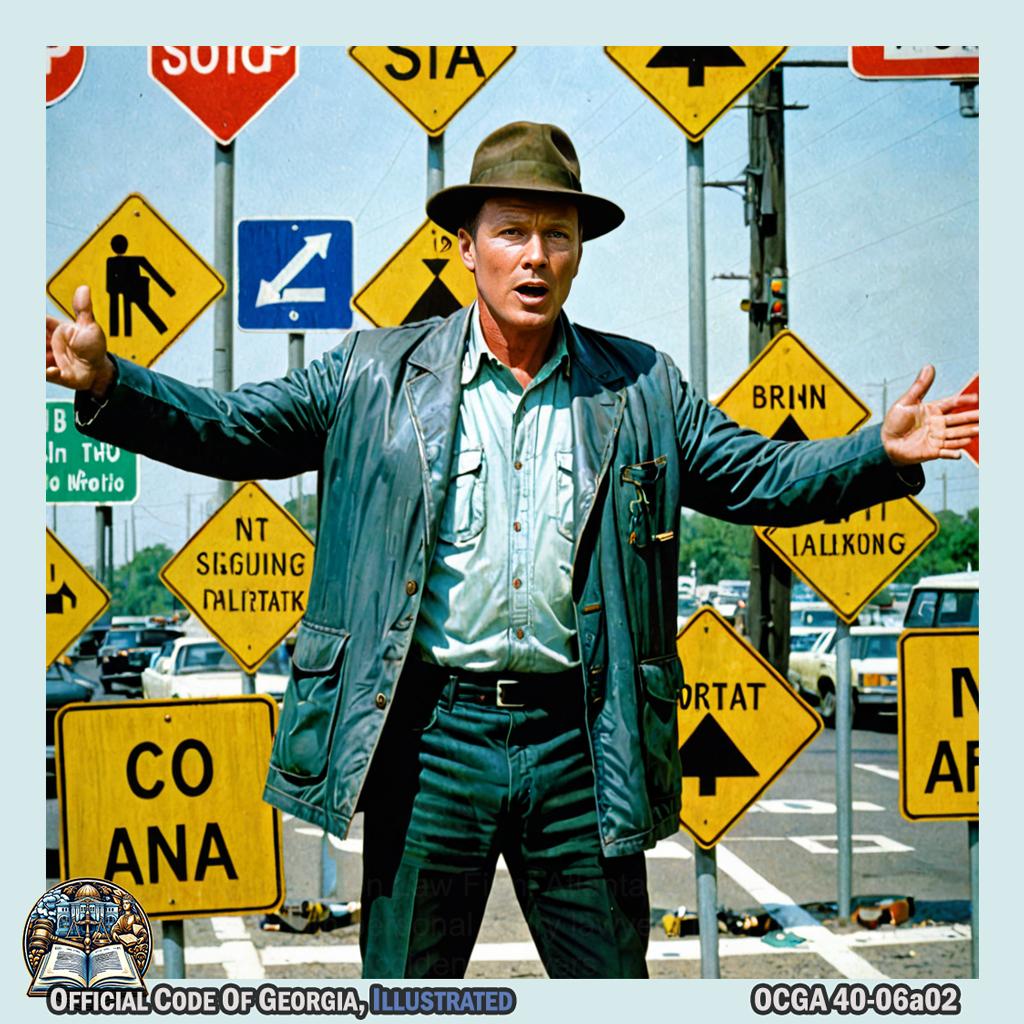
Robert Patrick stands in the middle of a room covered in traffic signs, signals, and markings. He moves with deliberate and exaggerated gestures, arranging and rearranging the signs to create an ever-shifting visual landscape that challenges the viewer's perception of order and control. -@robertpatrickT2 -
Article 3 Driving on Right Side of Roadway, Overtaking and Passing, Following too Closely
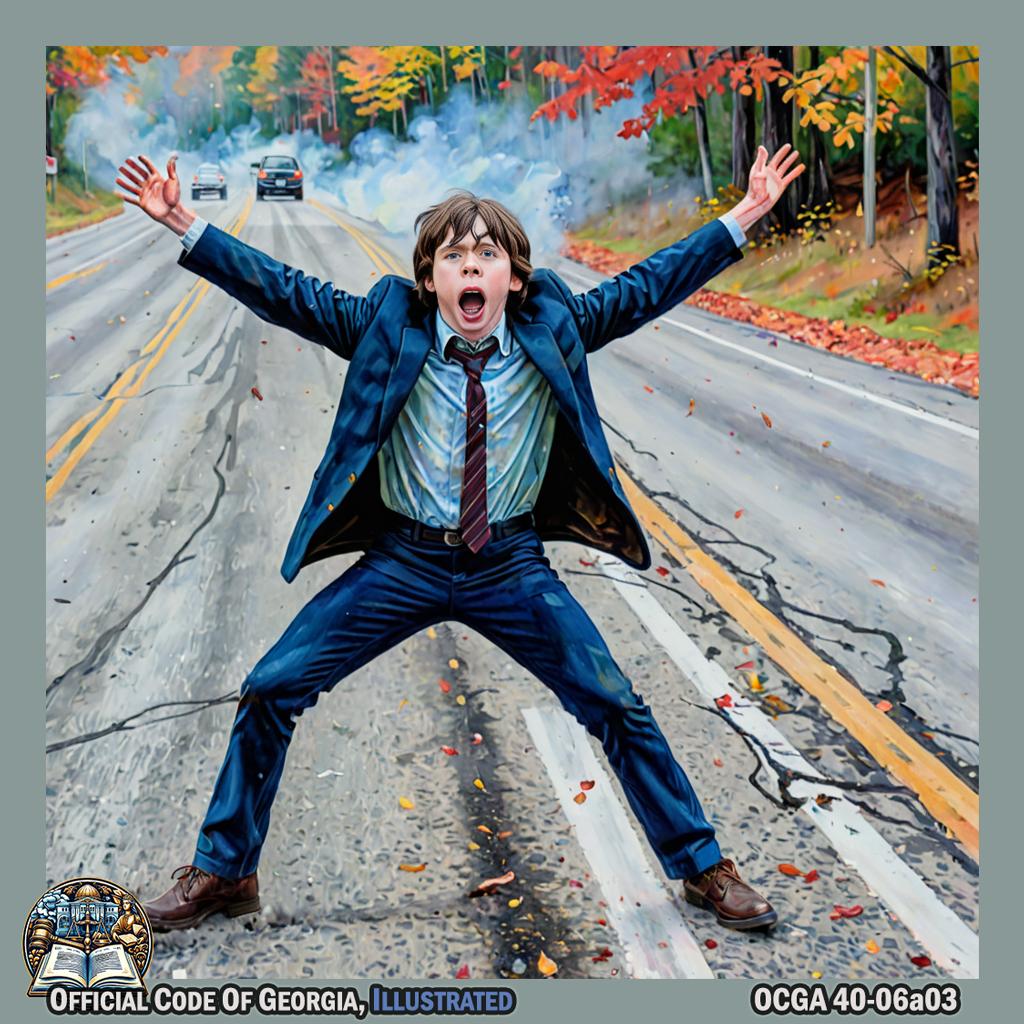
Chandler Riggs dramatically lunges forward with arms outstretched, his face contorted in anguish as he drives a car on the right side of the roadway, overtaking and passing while following too closely, set against a backdrop of vibrant autumn foliage in Powder Springs. -@chandlerriggs -
Article 4 Right of Way

James Brown, in a dynamic pose reminiscent of Anish Kapoor's reflective sculptures, parts a crowd at Northside Tavern with smooth dance moves, symbolically showing that he has the 'right of way,' as onlookers mirror his movements creating an interactive educational experience about personal space and movement. -
Article 5 Rights and Duties of Pedestrians

Kevin Gillespie joyfully dancing and skipping through the cemetery, embodying the rights and duties of pedestrians, surrounded by vibrant, larger-than-life sculptures inspired by Takashi Murakami's style. -@topchefkevin -
Article 6 Turning, Starting, Signaling
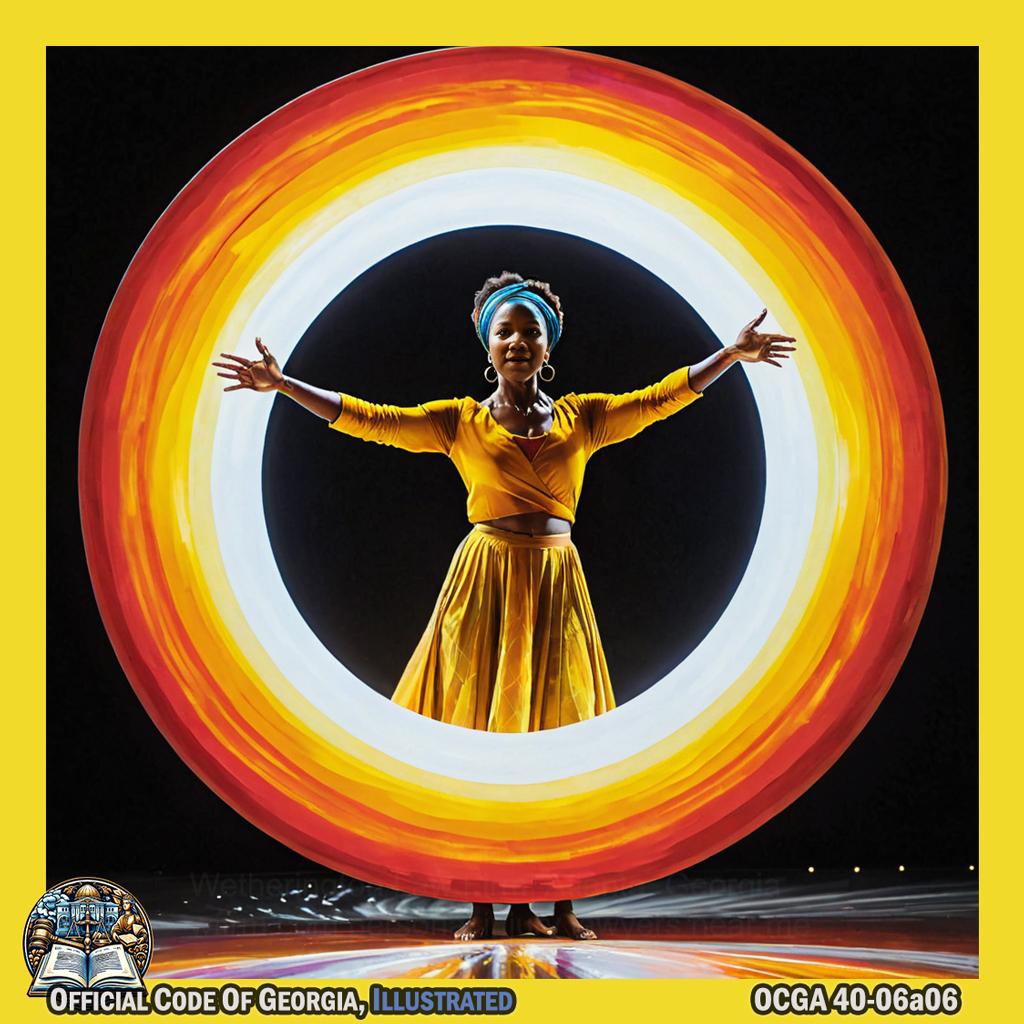
India.Arie gracefully spins a large, reflective disc while using her hands to create flowing movements, all illuminated by vibrant and shifting light sources. -@indiaarie -
Article 7 Negotiating Railroad Crossings, Entering Highways from Private Driveways

The Gwinnett County Board of Education, in the style of Le Corbusier, performs a choreographed sequence resembling the negotiation of railroad crossings and entering highways from private driveways against the backdrop of Expedition Bigfoot (The Sasquatch Museum). -@GwinnettSchools - Article 9 Speed Restrictions
- Article 10 Stopping, Standing, and Parking
- Article 11 Miscellaneous Provisions
- Article 12 Accidents
-
Article 13 Special Provisions for Certain Vehicles

Newt Gingrich dramatically twirls a vibrant neon tube in the midst of an artfully illuminated Atlanta Beltline, embodying the essence of "Article Special Provisions for Certain Vehicles" in the style of Dan Flavin's iconic light installations. -@newtgingrich - Article 15 Serious Traffic Offenses
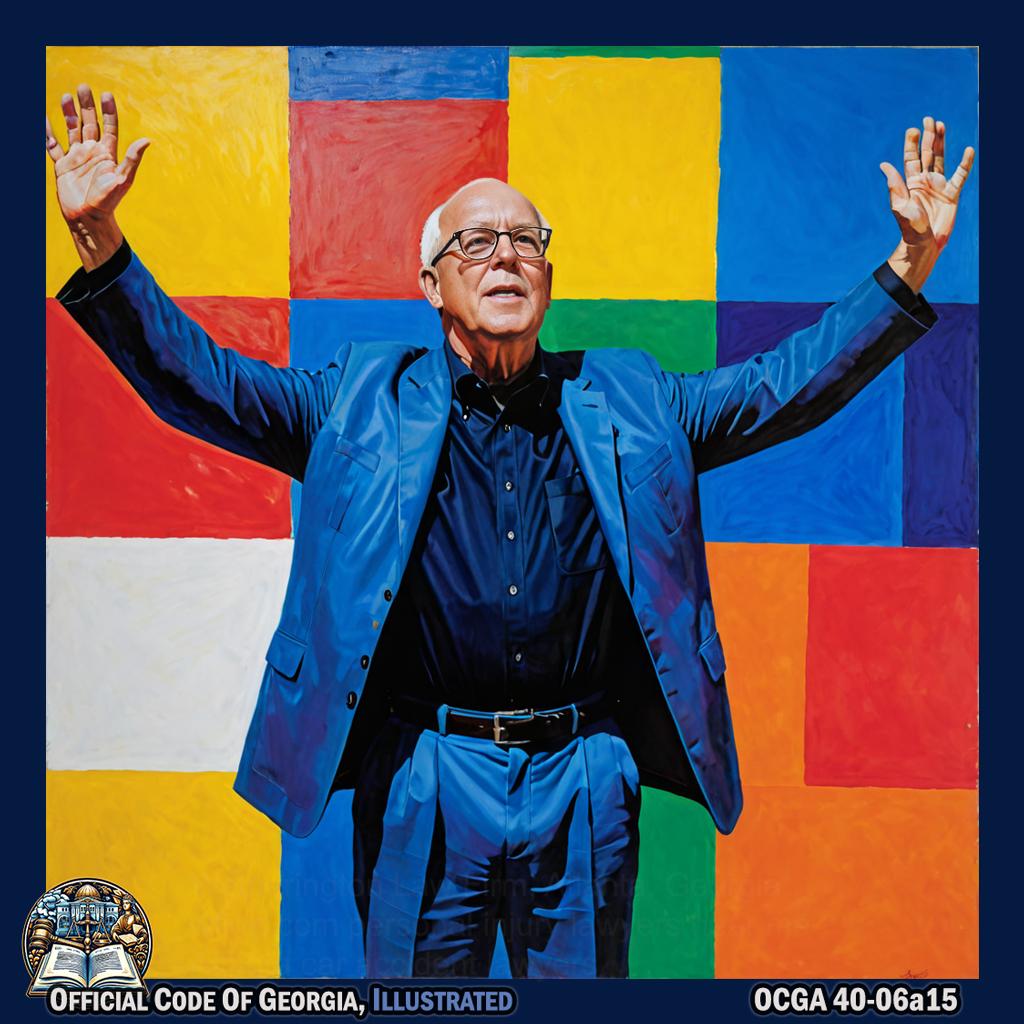
William Tapley Bennett Jr. standing in a pose of authority, with arms outstretched and head held high, surrounded by vibrant blocks of color reminiscent of Ellsworth Kelly's art piece, symbolizing the seriousness of traffic offenses as the ambassador to the Dominican Republic in a rich scene based in St. Marys.
Article 1 General Provisions¶
- 40-6-1. Violations of chapter a misdemeanor unless otherwise stated; maximum fines for speed limit violations.
- 40-6-2. Obedience to authorized persons directing traffic.
-
40-6-3. Chapter refers to operation of vehicles on highways; exceptions; vehicle accident reports and private property.

Sugar Ray Robinson, in a rich scene in Union City, Georgia, simultaneously holds a toy car while pretending to steer with one hand and forms an "X" sign with the other hand to symbolize exceptions, then mimics writing on a notepad to depict accident reporting, all while standing on a drawn square to represent private property. -
40-6-4. Persons riding animals or driving animal drawn vehicles.
- 40-6-5. Persons working on highways.
- 40-6-6. Authorized emergency vehicles; pursuit of fleeing suspects.
- 40-6-7. Operation of motor vehicles in parades.
-
40-6-8. Rights of owners of real property.

Poet Elizabeth Otis Dannelly gracefully recites her verses, embodying a regal presence as she stands on a vast expanse of land, holding a royal decree like a queen in an art piece from Mosaics. -
40-6-10. Insurance requirements for operation of motor vehicles generally.
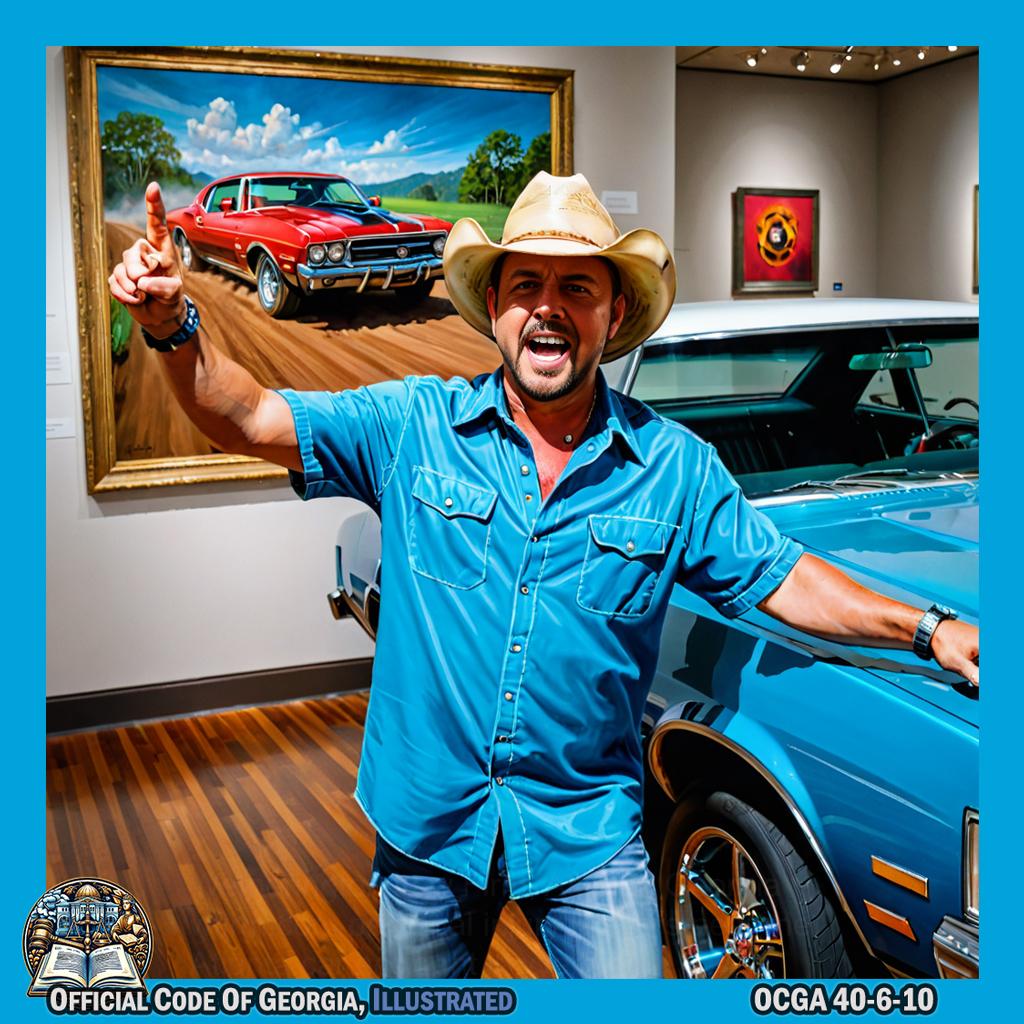
Musician Jason Aldean revs up an imaginary car at the Martha Berry Museum Art Collection in Georgia, playfully holding up an imaginary insurance policy and making "vroom vroom" sounds. -@Jason_Aldean -
40-6-10.1. Financial responsibility requirements of the Federal Motor Carrier Safety Administration.
- 40-6-11. Insurance requirements for operation of motorcycles.
-
40-6-12. Subsequent violation; proof of financial responsibility.
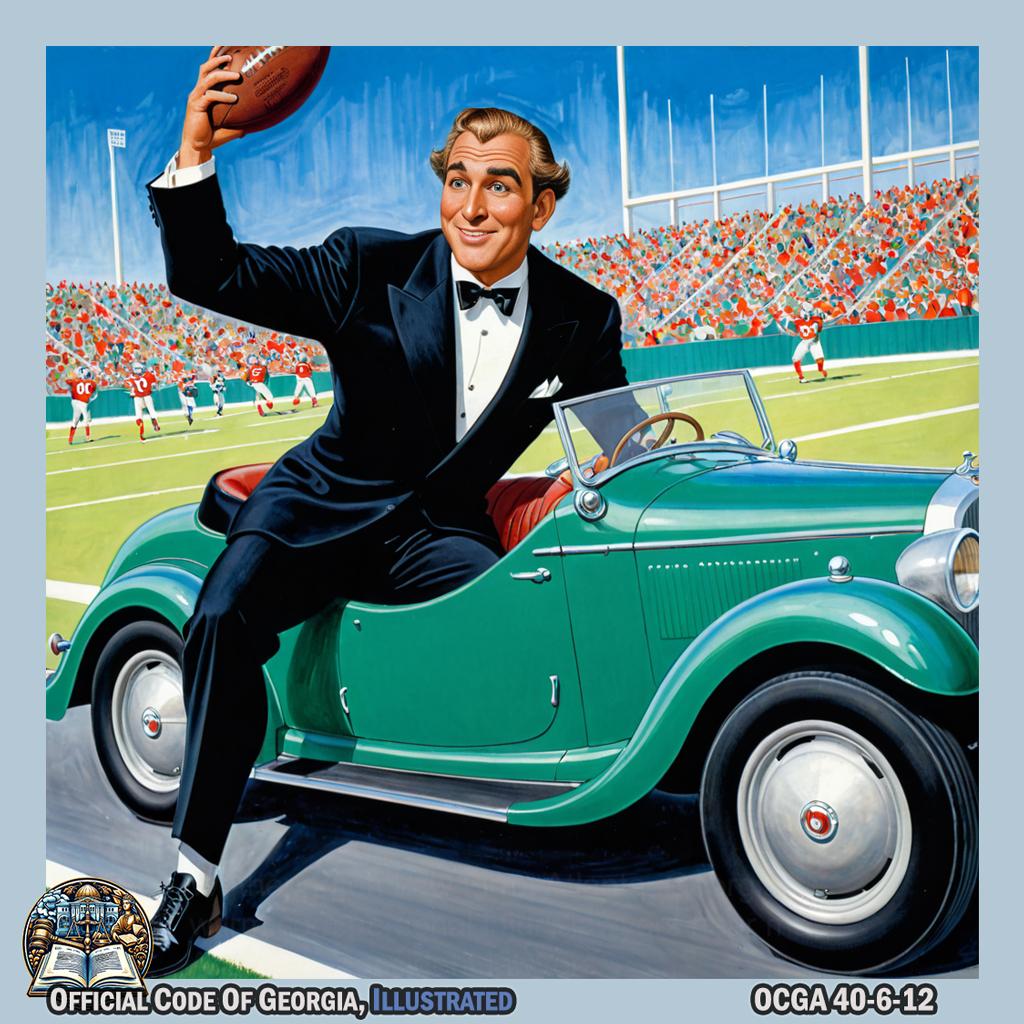
Football player James Carpenter, rendered in the iconic style of Al Hirschfeld, depicts the artful scene of mimicking driving a car and then presenting a make-believe insurance card. -@JEcarpenter77 - 40-6-14. Sound volume limitations from within the motor vehicle.
- 40-6-15. Knowingly driving motor vehicle on suspended, canceled, or revoked registration.
- 40-6-16. Procedure for passing certain stationary vehicles.
- 40-6-16.1. Procedure for passing vehicle with active sanitation workers.
- 40-6-17. Prohibited use of traffic-control device preemption emitter; penalty.
40-6-1.Violations of chapter a misdemeanor unless otherwise stated; maximum fines for speed limit violations.¶
- It is unlawful and, unless otherwise declared in this chapter with respect to particular offenses, it is a misdemeanor for any person to do any act forbidden or fail to perform any act required in this chapter.
-
Unless a different maximum fine or greater minimum fine is specifically provided in this chapter for a particular violation, the maximum fine which may be imposed as punishment for a first offense of violating any lawful speed limit established by or pursuant to the provisions of Article 9 of this chapter by exceeding a maximum lawful speed limit:
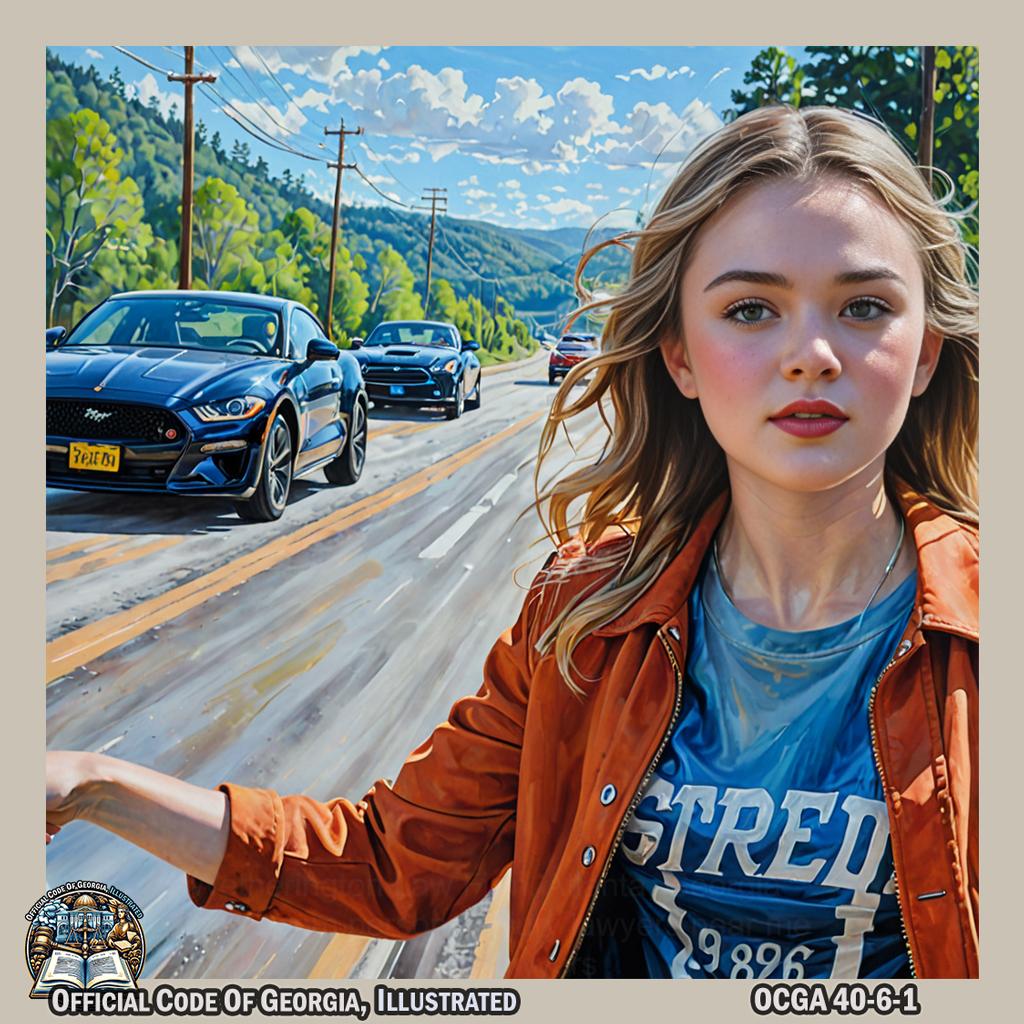
Actress Morgan Saylor gracefully mimics the motion of driving a car, subtly emphasizing the concept of exceeding a speed limit through her fluid and dramatic movements, set against the picturesque backdrop of Covington. -@MorganSaylor -
By five miles per hour or less shall be no dollars;

Luke Bryan standing in a field, slowly pedaling a vintage bicycle with a speedometer reading 5 mph or less, while holding out an empty wallet. -@LukeBryanOnline -
By more than five but not more than ten miles per hour shall not exceed $25.00;

Will Heller gracefully glides across the stage, his body moving in fluid motion as if being captured in a timeless art piece by David Bailey. His movements convey the concept of speed, restriction, and calculation - as he carefully maintains a pace between five and ten miles per hour without exceeding it. The scene is set richly in Cedartown, Georgia, with vibrant colors and textures evoking an atmosphere of creativity and exploration. -
By more than ten but not more than 14 miles per hour shall not exceed $100.00;
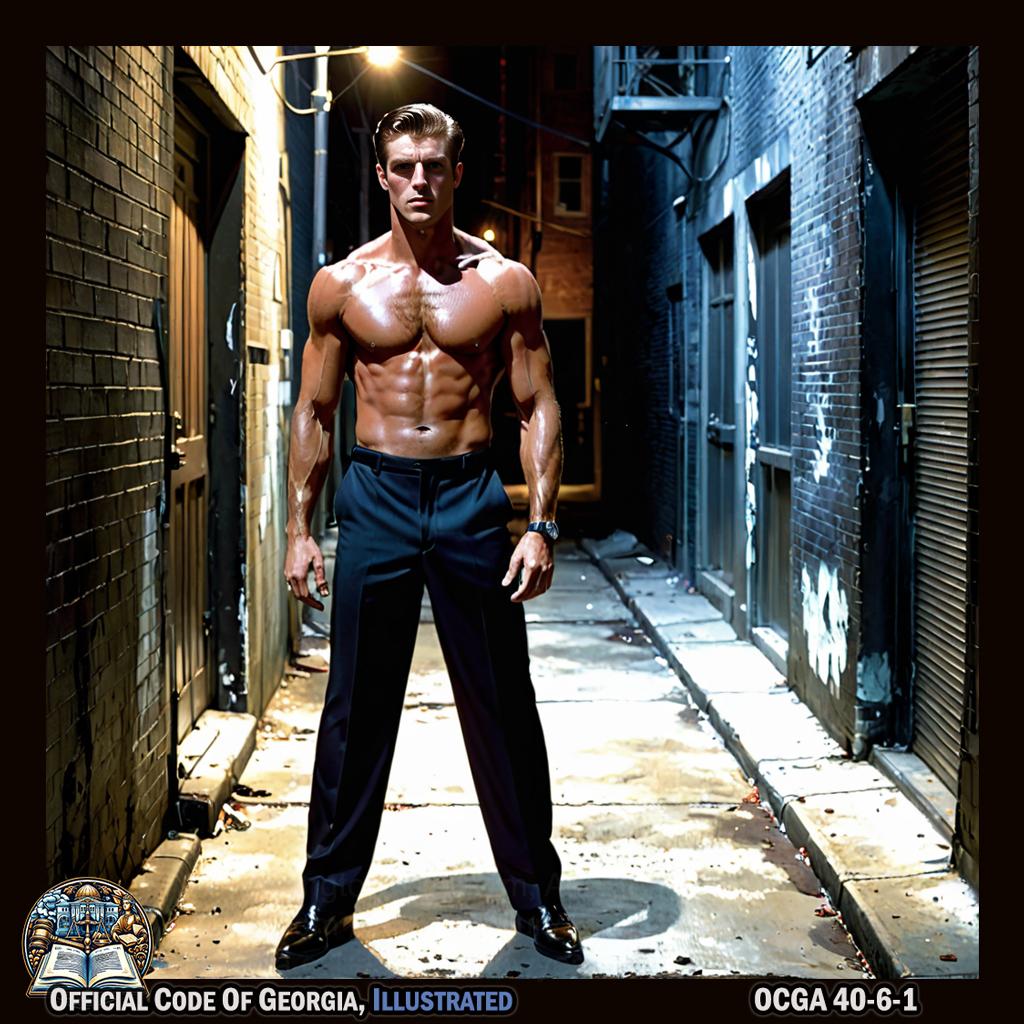
In a dimly lit Atlanta alley, Nick Jones slowly glides forward with an intense gaze, his body poised in a sleek and powerful stance. With deliberate movements, he accelerates to just over 10 miles per hour, then abruptly halts and strikes a dramatic pose as if frozen in time. The play of light and shadow accentuates the contours of his athletic form, capturing the essence of Helmut Newton's iconic style. -
By more than 14 but less than 19 miles per hour shall not exceed $125.00;
-
By 19 or more but less than 24 miles per hour shall not exceed $150.00; or

Peter Tompkins, dressed in a 1940s trench coat and fedora, stealthily tiptoes along a Kingsland railroad track, glancing at an invisible watch then speeding up as if trying to match the speed of an unseen train, while Vivian Maier-style black-and-white photographs capture this moment from different angles and children standing at a safe distance with toy binoculars mimic his sleuthing actions. -
By 24 or more but less than 34 miles per hour shall not exceed $500.00.
-
40-6-2.Obedience to authorized persons directing traffic.¶
No person shall fail or refuse to comply with any lawful order or direction of any law enforcement officer or firefighter, nonsworn employee or volunteer authorized under Code Section 35-1-11, or individual designated under Code Section 20-2-1131 with the authority to direct, control, or regulate traffic.

40-6-3.Chapter refers to operation of vehicles on highways; exceptions; vehicle accident reports and private property.¶
-
The provisions of this chapter relating to the operation of vehicles refer to the operation of vehicles upon highways except:
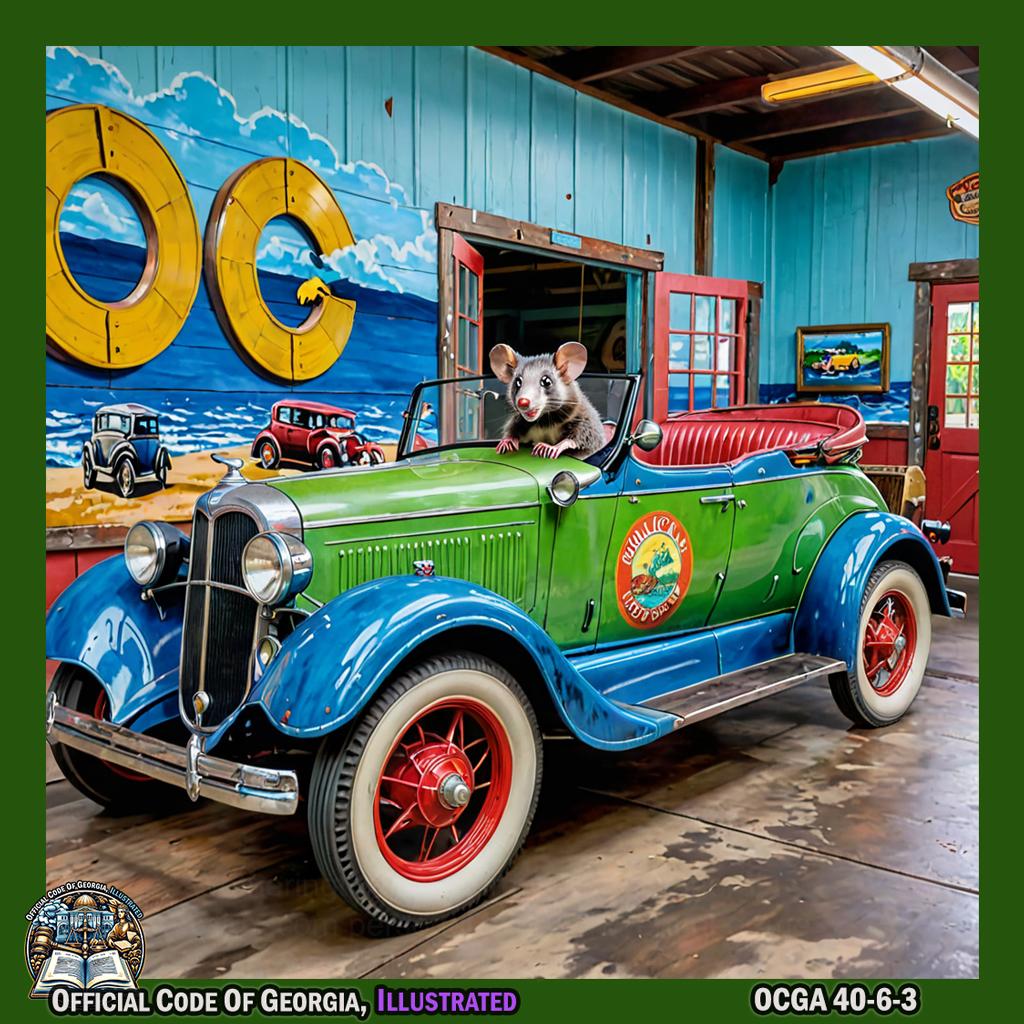
Pogo Possum joyfully driving a vintage car through the museum, with vibrant Gullah-Geechee artwork adorning the walls and old oyster cannery machinery in the background. - Where a different place is specifically referred to in a given Code section;
- The provisions of this chapter shall apply to a vehicle operated at shopping centers or parking lots or similar areas which although privately owned are customarily used by the public as through streets or connector streets;
- The provisions of this chapter relating to reckless driving, driving in violation of Code Section 40-6-391, and homicide by vehicle shall apply to vehicles operated upon highways and elsewhere throughout the state;
- The provisions of Code Sections 40-6-270, 40-6-271, and 40-6-272 shall apply upon the highways of this state, in all parking areas, and in all areas which are customarily open to the public and within 200 feet of all such highways, parking areas, and areas customarily open to the public;
-
-
The provisions of this chapter shall apply to a vehicle operated on any private property of this state which fronts on coastal marshlands or estuarine area as defined in Code Section 12-5-282, provided the owner of the private property files with the local law enforcement agency having primary jurisdiction to enforce the uniform rules of the road in such area: 1. A petition requesting such local law enforcement agency to enforce the uniform rules of the road on such private property; and
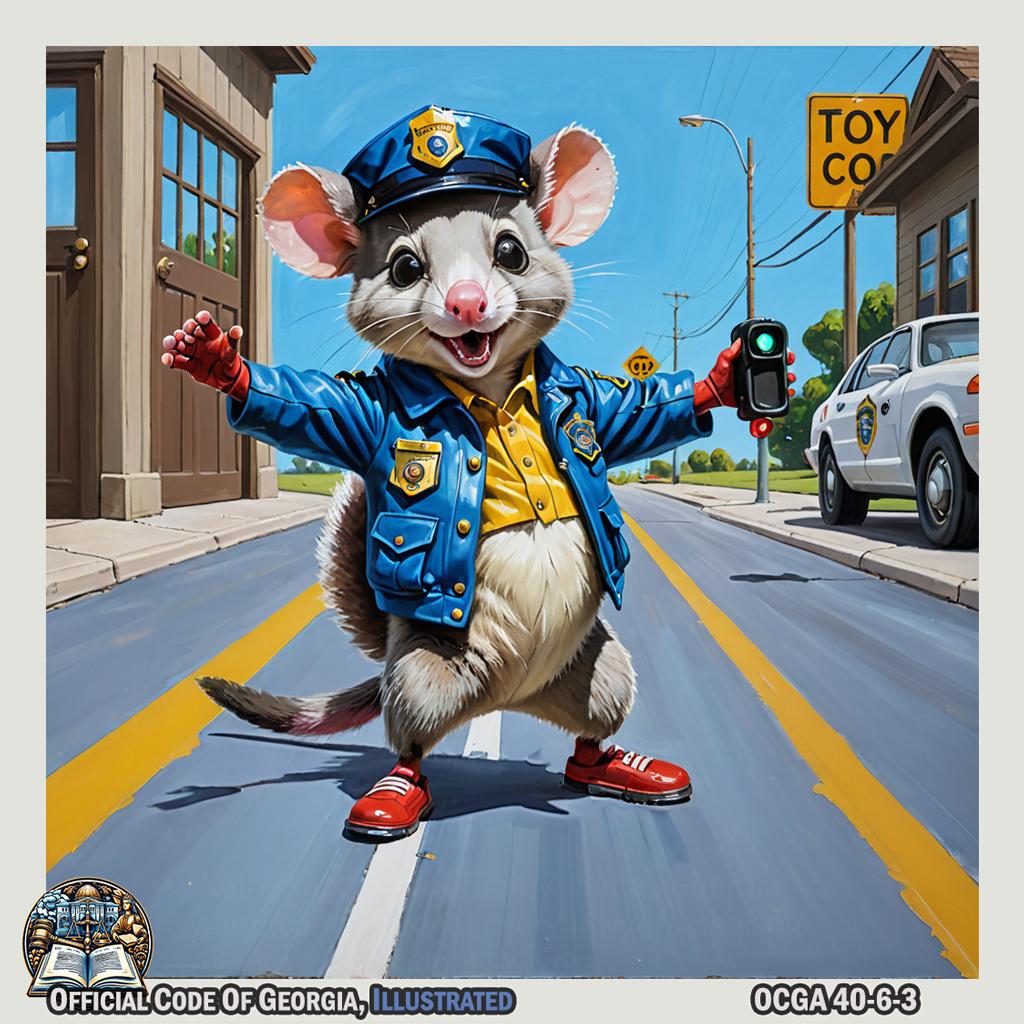
Pogo Possum, a fictional character, mimics a traffic cop directing toy cars on an imaginary road in a playroom, reminiscent of an art piece by Fred Wilson. - Simultaneously files a plat with the petition delineating the location of the roads, streets, and common areas on such private property.
2. The local law enforcement agency having primary jurisdiction to enforce the uniform rules of the road in such area shall enforce the uniform rules of the road on said private property at no cost to the owner of the private property or enter into a contractual agreement with the owner of the private property whereby the owner of the private property consents to pay part or all of the law enforcement expenses to such law enforcement agency.

Albert Parker, dressed in a colorful costume, enthusiastically gestures towards a larger-than-life canvas depicting the local law enforcement agency and the owner of private property engaged in an animated discussion. The vibrant colors and dynamic movements of the figures capture the essence of their negotiations, portraying a visually captivating interpretation of the legal process through artistic expression.
- Simultaneously files a plat with the petition delineating the location of the roads, streets, and common areas on such private property.
2. The local law enforcement agency having primary jurisdiction to enforce the uniform rules of the road in such area shall enforce the uniform rules of the road on said private property at no cost to the owner of the private property or enter into a contractual agreement with the owner of the private property whereby the owner of the private property consents to pay part or all of the law enforcement expenses to such law enforcement agency.
-
All persons operating vehicles on said roads, streets, and common areas shall be subject to all state and local traffic laws and regulations the same as if said private roads and streets were public roads and streets.
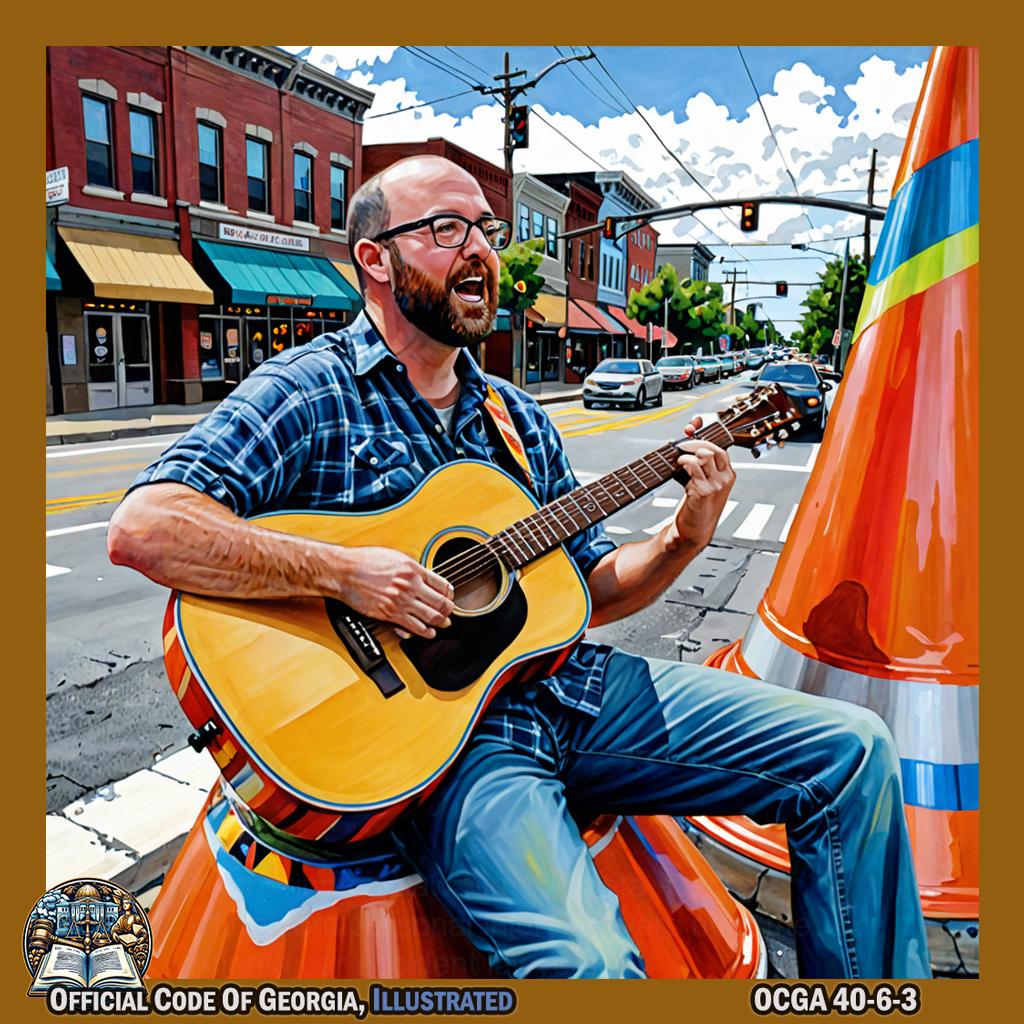
Corey Smith is depicted in a vibrant, detailed painting by Larry Dell Alexander, strumming his guitar while seated atop an oversized traffic cone placed in the center of a bustling Bainbridge intersection, with colorful lines and patterns swirling around him to represent the flow of traffic obeying the laws. -@coreysmithmusic -
Any state or local law enforcement agency empowered to enforce the uniform rules of the road in such area shall have concurrent jurisdiction with the primary local law enforcement agency to enforce the rules of the road on said private property.
- At least 30 days’ prior notice shall be given to users of said private roads, streets, and common areas by publication in the newspapers of general circulation in the area and by posting signs along the private roads and streets specifying that state and local law enforcement agencies will be enforcing the uniform rules of the road on said private roads, streets, and common areas; and
-
- Subject to the approval of the governing authority of the county or municipality, the provisions of this chapter shall apply to a vehicle operated within a privately owned residential area located within the corporate boundaries of a municipality or located within the boundaries of a county, provided the owner of the privately owned residential area files with the governing authority of such county or municipality:
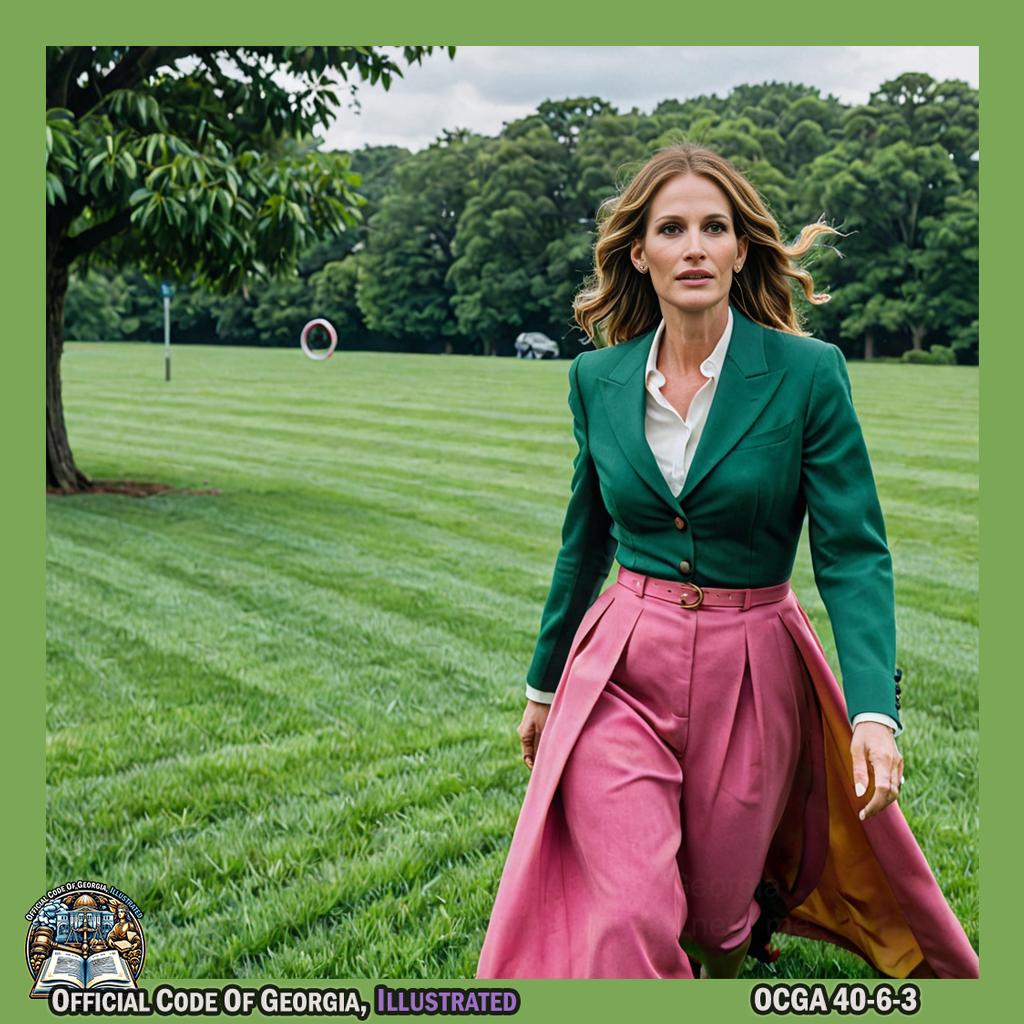
Julia Roberts, elegantly dressed as a concerned citizen, strides across a lush green lawn in Dalton towards an oversized symbolic steering wheel. She grasps it with determination and then theatrically presents a large mock key to a character representing the governing authority. All around them, vividly colored fabrics flutter from trees symbolizing the boundaries of the municipality, creating an artful tableau reminiscent of Wolfgang Tillmans' dynamic composition and use of color.
- Subject to the approval of the governing authority of the county or municipality, the provisions of this chapter shall apply to a vehicle operated within a privately owned residential area located within the corporate boundaries of a municipality or located within the boundaries of a county, provided the owner of the privately owned residential area files with the governing authority of such county or municipality:
- A petition signed by 50 percent of the property owners located in said subdivision requesting the law enforcement agency of the county or municipality to enforce the uniform rules of the road within such privately owned residential area; and
- A plat delineating the location of roads, streets, and common areas within the privately owned residential area.
-
- Upon approval by the governing authority of the county or municipality, the law enforcement agency of such county or municipality shall enforce the uniform rules of the road within said privately owned residential area.
- All persons operating vehicles on the roads, streets, and common areas of said privately owned residential property shall be subject to all state and local traffic laws and regulations the same as if such private roads, streets, and common areas were public roads and streets.
- At least 30 days’ prior notice shall be given to users of said private roads, streets, and common areas by publication in a newspaper of general circulation in the area and by posting signs along the private road, streets, and common areas specifying that the county law enforcement agency or municipal law enforcement agency will be enforcing the uniform rules of the roads on said private roads, streets, and common areas.

Pastor Troy, in a vibrant Derain-inspired scene, theatrically plants colorful abstract signs along the winding paths of the Millenium Mural Project, Colquitt landscape, while mimicking reading a newspaper with exaggerated expressions to inform an audience of imaginary onlookers about upcoming law enforcement activities. -@PastorTroyDSGB
-
-
Notwithstanding the provisions of subsection (a) of this Code section, any law enforcement officer shall be authorized to write an accident report regarding any motor vehicle accident occurring on private property.

Grady Jarrett, dressed in a vibrant jungle-themed costume, carefully writes on a large canvas with oversized brush strokes, mimicking the act of writing an accident report as if it were a choreographed dance. The lush greenery and wild animals surrounding him add to the whimsical yet symbolic representation of the legal provision in Valdosta. -@GradyJarrett
40-6-4.Persons riding animals or driving animal drawn vehicles.¶
Every person riding an animal or driving an

animal drawn vehicle upon a roadway shall be granted all of the rights and shall be subject to all of the duties applicable to the driver of a vehicle by this chapter, except those provisions of this chapter which by their very nature can have no application.
40-6-5.Persons working on highways.¶
Unless specifically made applicable, the provisions of this chapter, except those contained in Article 15 of this chapter, shall not apply to authorized persons, teams, motor vehicles, and other equipment while actually engaged in work upon a highway but shall apply to such persons and vehicles when traveling to or from such work.
40-6-6.Authorized emergency vehicles; pursuit of fleeing suspects.¶
-
The driver of an authorized emergency vehicle or law enforcement vehicle, when responding to an emergency call, when in the pursuit of an actual or suspected violator of the law, or when responding to but not upon returning from a fire alarm, may exercise the privileges set forth in this Code section.
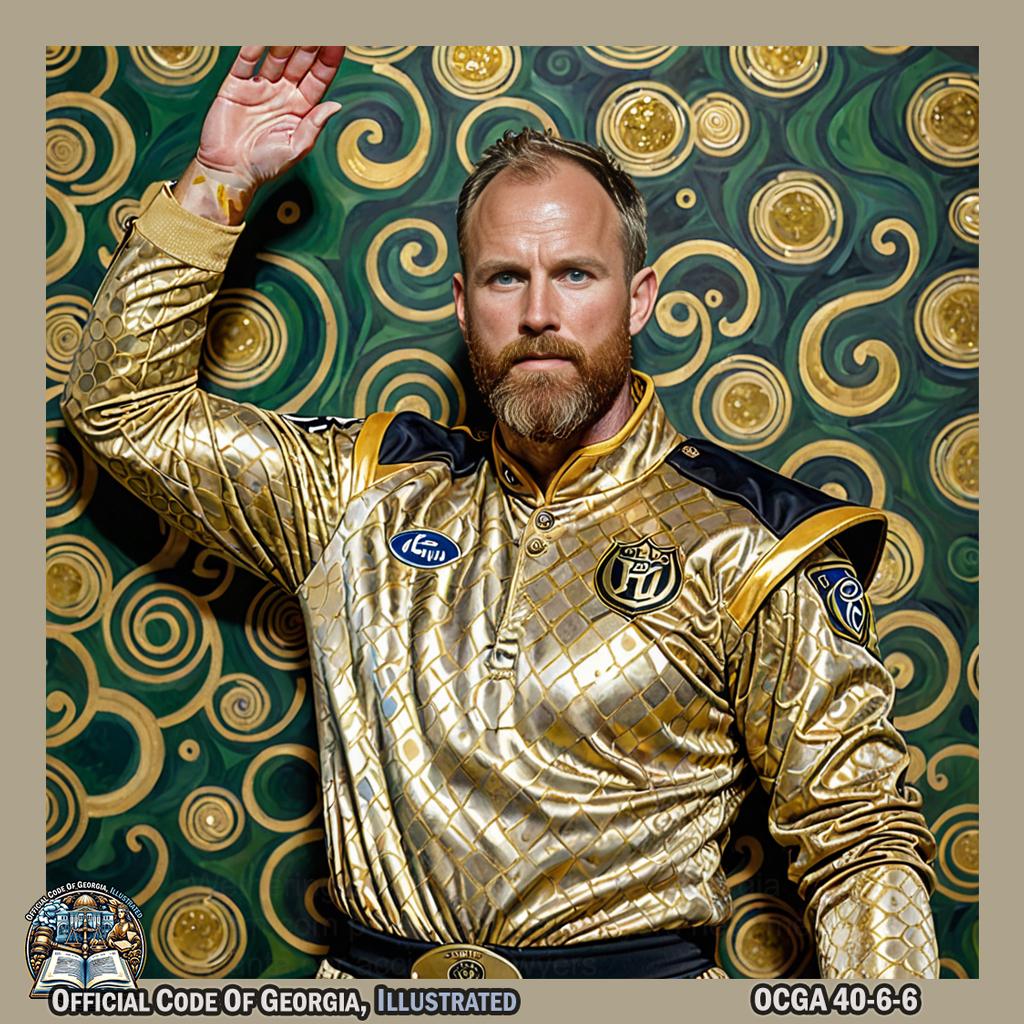
Jeff Backus, dressed in a golden football uniform, dramatically raises his arm and gestures forward with determination as if leading the charge of an army of players, surrounded by swirling patterns reminiscent of Klimt's artwork. -
The driver of an authorized emergency vehicle or law enforcement vehicle may:

Anna Benson, dressed as a first responder, uses exaggerated hand signals to direct traffic around an abstractly painted toy emergency vehicle on a canvas map of Chamblee, while Gloria Petyarre-style dot painting swirls symbolize the motion and urgency typical in emergency responses. -
Park or stand, irrespective of the provisions of this chapter;

Lauren Alaina, dressed in vibrant colors, stands motionless with a confident pose beside an old oak tree at Thomasville Heights while different colored fabrics flow from her arms to the ground, symbolizing both standing and parking against a backdrop of street art murals. -@Lauren_Alaina -
Proceed past a red or stop signal or stop sign, but only after slowing down as may be necessary for safe operation;
-
Exceed the maximum speed limits so long as he or she does not endanger life or property; and
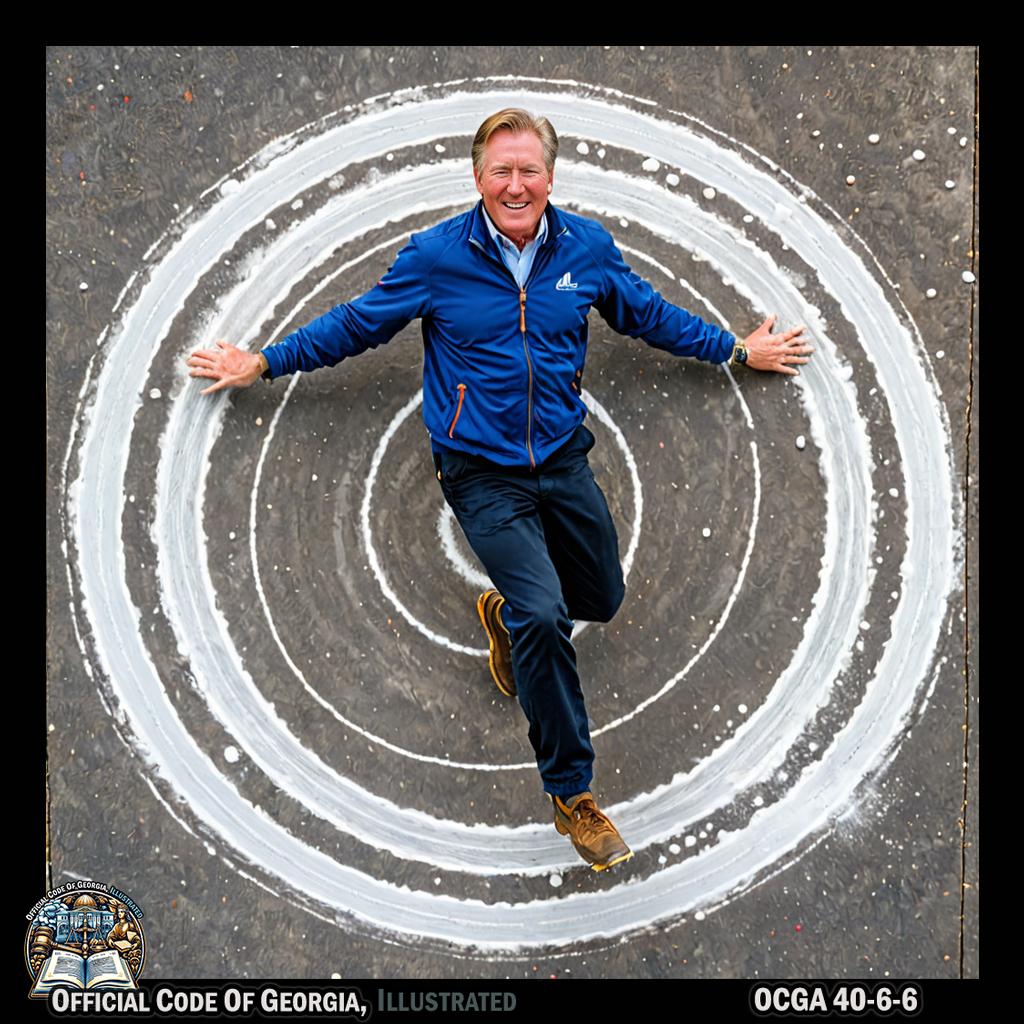
Eli Whitney spins and sprints around a circle, leaving temporary marks on the ground with his feet as he pushes the boundaries of speed limits in a graceful and fluid motion, embodying the spirit of movement and innovation in Powder Springs. -
Disregard regulations governing direction of movement or turning in specified directions.
-
-
The exceptions granted by this Code section to an authorized emergency vehicle shall apply only when such vehicle is making use of an audible signal and use of a flashing or revolving red light visible under normal atmospheric conditions from a distance of 500 feet to the front of such vehicle, except that a vehicle belonging to a federal, state, or local law enforcement agency and operated as such shall be making use of an audible signal and a flashing or revolving blue light with the same visibility to the front of the vehicle.
-
- The foregoing provisions shall not relieve the driver of an authorized emergency vehicle from the duty to drive with due regard for the safety of all persons.
- When a law enforcement officer in a law enforcement vehicle is pursuing a fleeing suspect in another vehicle and the fleeing suspect damages any property or injures or kills any person during the pursuit, the law enforcement officer’s pursuit shall not be the proximate cause or a contributing proximate cause of the damage, injury, or death caused by the fleeing suspect unless the law enforcement officer acted with reckless disregard for proper law enforcement procedures in the officer’s decision to initiate or continue the pursuit. Where such reckless disregard exists, the pursuit may be found to constitute a proximate cause of the damage, injury, or death caused by the fleeing suspect, but the existence of such reckless disregard shall not in and of itself establish causation.
- The provisions of this subsection shall apply only to issues of causation and duty and shall not affect the existence or absence of immunity which shall be determined as otherwise provided by law.
- Claims arising out of this subsection which are brought against local government entities, their officers, agents, servants, attorneys, and employees shall be subject to the procedures and limitations contained in Chapter 92 of Title 36.
-
It shall be unlawful for any person to operate an authorized emergency vehicle with flashing lights other than as authorized by subsection (c) of this Code section.
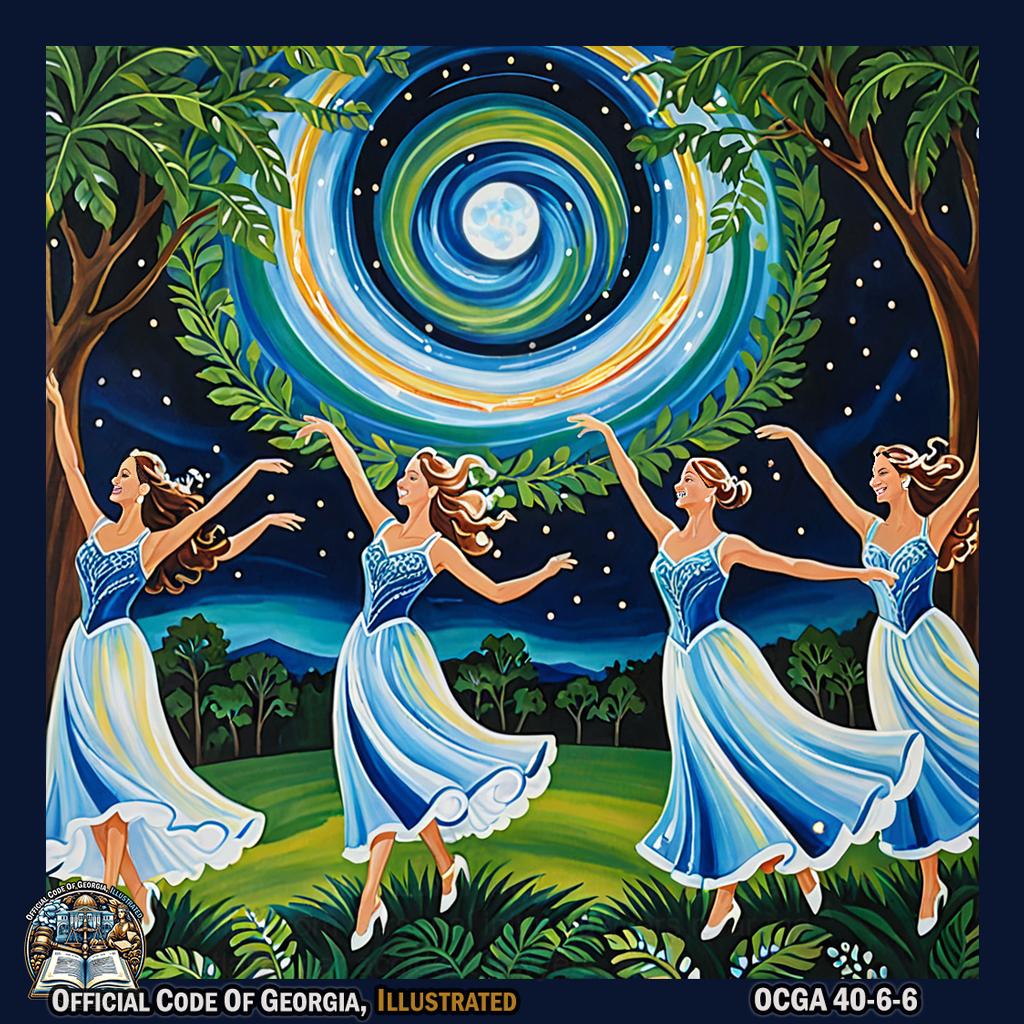
Six Continents Hotels, Inc. swirling and twirling with flashing lights in a mesmerizing dance, creating an art piece in the style of Judith Braun against a backdrop of Griffin's lush greenery.
40-6-7.Operation of motor vehicles in parades.¶
Notwithstanding any other provisions of law, it shall be lawful to operate motor vehicles and motorcycles in parades although such motor vehicles and motorcycles and their operators and passengers do not meet the necessary requirements of law, especially with respect to flashing lights, sirens, and safety equipment. This Code section shall be applicable only in the event that the local authority which has the power to issue parade permits, at its discretion, authorizes the operation of such motor vehicles and motorcycles after it has been determined that the operation of such motor vehicles and motorcycles will not endanger the lives, safety, or property of other participants in the parade, bystanders, or other persons. The authorization for vehicles to be operated in parades as exceptions to otherwise required provisions of law shall extend to only such time as the vehicles are actually engaged in the parade and in the return to the marshaling area. At all times, such vehicles shall be operated by a person properly licensed to operate such vehicles. Such motor vehicles and motorcycles covered under this Code section shall be operated in accordance with all provisions of law when traveling to and from a parade site and at all other times when not directly participating in a parade.
40-6-8.Rights of owners of real property.¶
Nothing in this chapter shall be construed to prevent the owner of real property used by the public for purposes of vehicular travel by permission of the owner, and not as matter of right, from prohibiting such use, or from requiring other or different or additional conditions than those specified in this chapter, or from otherwise regulating such use as may seem best to such owner.
40-6-9.Challenges to speed limits and other traffic regulations established or enforced by local governing authorities.¶
-
As used in this Code section, the term “speed limits” shall be construed to refer to and include stop lights, stop signs, slow signs, yield signs, and any and every other light, device, or sign which may be used to impede, slow, stop, or regulate the speed of motor vehicles on the public highways.

Chesley V. Morton gracefully poses amidst a collection of traffic signs, embodying the complex interplay between regulation and movement against a backdrop of urban art at Atlanta Contemporary Art Center. -
Any provisions of this chapter to the contrary notwithstanding, whenever any complaint is made to the Governor that any speed limit established by any county or municipal authority is arbitrary or unreasonable, or upon any complaint being made to the Governor that any speed limit established by the state or by any county or municipal governing authority is being enforced primarily for the collection of revenue rather than for purposes of public safety, the Governor may, in his discretion, direct that an investigation and any necessary studies be commenced by the commissioner of public safety or his delegate who shall make a report thereon together with his recommendations as to whether the state should suspend the authority of the applicable local county or municipal governing authorities to enforce speed limits upon any state and federal highways lying within the jurisdiction of such authorities. Upon receipt of a report accompanied by recommendations that the power to enforce speed limits be restricted, the Governor shall furnish a copy of such report to the local authorities affected thereby, together with notice of hearing on the allegations of the report made by the commissioner of public safety or his delegate. Such hearing may be held at such time and such place as may be determined by the Governor but shall not be held less than ten days after notice to the local governing authorities. Such hearing shall be conducted before a board to be composed of the Governor, the Secretary of State, and an appointee of the Governor who is not the Attorney General who shall be reimbursed for the actual and necessary expenses pertaining to their services on the board but who shall receive no other additional compensation for their services thereon. Upon determination by the board that the speed limits established by the county or municipal governing authorities against whom complaint has been brought are either unreasonable or that speed limits are being primarily enforced for the collection of revenue rather than for purposes of public safety, the Governor shall issue his executive order suspending the power of such local governing authority to enforce speed limits on state or federal highways lying within its jurisdiction or on any particular such highway. In the event that this power is suspended, the Governor shall direct the commissioner of public safety to enforce the speed limits on such highways.

George Adams, dressed as a governor, theatrically examines a large map of Lookout Mountain Incline Railway with an oversized magnifying glass, then pretends to drive at varying speeds along the railway tracks marked on the ground. He stops periodically to jot notes onto an invisible notepad and gestures dramatically towards imaginary cars, indicating speed limits. Meanwhile, Susan Weil-inspired painted panels surround him showing abstracted forms of cars and traffic signs in motion to convey the investigation into speed limits. -
At intervals of not less than six months, any governing authority affected by subsection (b) of this Code section and by an executive order issued in accordance with subsection (b) of this Code section may, upon a change of circumstances being shown to the Governor, petition the Governor for reconsideration, whereupon the Governor, in his discretion, may direct the commissioner of public safety or his delegate to inquire into such change of circumstances and report the same to him together with any recommendations for modification of the Governor’s previous order; and the Governor, in his discretion, may order a new hearing on the matter before the board or may, without hearing, modify or revoke his previous executive order.
- Any provisions of this chapter to the contrary notwithstanding, when any complaint is made to the Governor that any traffic law, ordinance, or regulation, other than speed regulations for which provision has been made in subsection (b) of this Code section, established by any county or municipal authority is arbitrary or unreasonable, or upon any complaint being made to the Governor that any traffic law, ordinance, or regulation established by the state or by any county or municipal governing authority, other than speed regulations for which provision has been made in subsection (b) of this Code section, is being enforced primarily for the collection of revenue rather than for purposes of public safety, the Governor may, in his discretion, direct that an investigation and any necessary studies be commenced by the commissioner of public safety or his delegate who shall make a report thereon together with his recommendations as to whether the state should suspend the authority of the applicable local county or municipal governing authorities to enforce traffic laws, ordinances, or regulations upon any state and federal highways lying within the jurisdiction of such authorities. Upon receipt of a report accompanied by recommendations that the power to enforce traffic laws, ordinances, and regulations be restricted, the Governor shall furnish a copy of such report to the local authorities affected thereby, together with notice of a hearing on the allegations of the report made by the commissioner of public safety or his delegate. Such hearing may be held at such time and at such place as may be determined by the Governor but shall not be less than ten days after notice to the local governing authorities. This hearing shall be conducted before a board to be composed of the Governor, the Secretary of State, and an appointee of the Governor who is not the Attorney General who shall be reimbursed for the actual and necessary expenses pertaining to their services on the board but who shall receive no other additional compensation for their services thereon. Upon the determination by the board either that traffic laws, ordinances, or regulations, other than speed regulations for which provision has been made in subsection (b) of this Code section, established by the county or municipal governing authority against whom complaint has been brought are unreasonable or that traffic laws, ordinances, or regulations established by the state or by any county or municipal governing authority are being primarily enforced for the collection of revenue rather than for purposes of public safety, the Governor shall issue his executive order suspending the power of such local governing authority to enforce traffic laws, ordinances, and regulations on state or federal highways lying within its jurisdiction or on any particular such highway. In the event that this power is suspended, the Governor shall direct the commissioner of public safety to enforce the traffic laws and regulations on such highways.
- At intervals of not less than six months, any governing authority affected by subsection (d) of this Code section and by an executive order issued in accordance with subsection (d) of this Code section may, upon a change of circumstances being shown to the Governor, petition the Governor for reconsideration, whereupon the Governor, in his discretion, may direct the commissioner of public safety or his delegate to inquire into such change of circumstances and report the same to him together with any recommendations for modification of the Governor’s previous executive order; and the Governor, in his discretion, may order a new hearing on the matter before the board or may, without hearing, modify or revoke his previous executive order.

Otis Redding is depicted strumming a guitar with exaggerated, emotive body language inspired by Schiele's style, pausing thoughtfully at intervals to mimic reading a large, ornate scroll representing the Code section, then turning and striking a pose as if speaking earnestly to an unseen governor. The backdrop is the Albany Civil Rights Movement Museum and Institute with vibrant colors and angular lines characteristic of Schiele's work, capturing the essence of advocacy and review in government actions.
40-6-10.Insurance requirements for operation of motor vehicles generally.¶
-
-
As used in this Code section, the term “mobile electronic device” means a portable computing and communication device that has a display screen with touch input or a miniature keyboard.
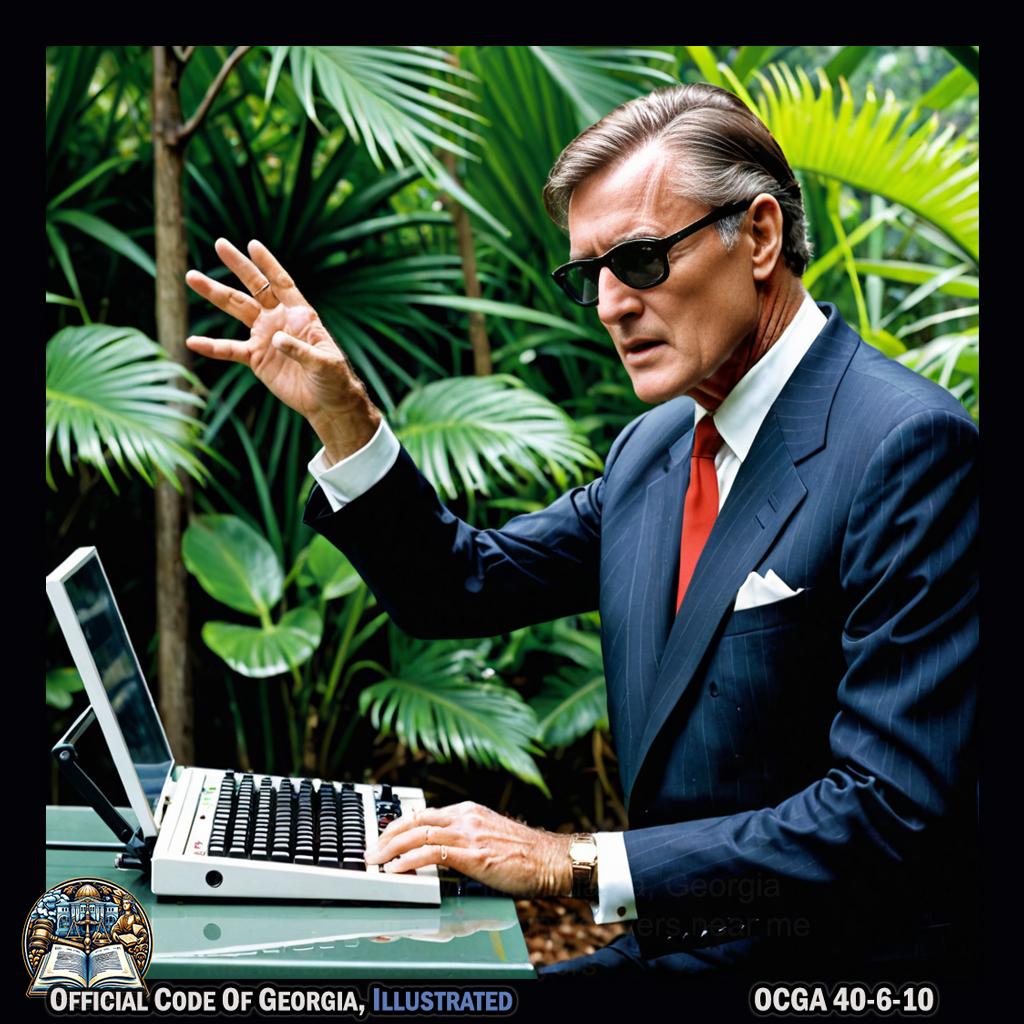
Andrew Gardner gracefully gestures towards a sleek, modern device with a touch-sensitive screen and miniature keyboard, embodying the definition of "mobile electronic device" as stated in the Georgia Code section. This art piece captures his fluid movements amidst the lush surroundings of Birmingham Zoo, evoking the style of Helmut Newton's iconic visual storytelling. (1.1)Upon the request of the insured, an insurer may issue a verification as to the existence of minimum motor vehicle liability insurance coverage as required under Chapter 34 of Title 33 in an electronic format to a mobile electronic device to the extent available. This paragraph shall not require an insurer to provide such verification of coverage in real time.
(1.2)The owner or operator of a motor vehicle for which minimum motor vehicle liability insurance coverage is required under Chapter 34 of Title 33 shall keep proof or evidence of required minimum insurance coverage in the vehicle at all times during the operation of the vehicle. The owner of a motor vehicle shall provide to any operator of such vehicle proof or evidence of required minimum insurance coverage for the purposes of compliance with this subsection. The proof or evidence of required minimum insurance coverage required by this subsection may be produced in either paper or electronic format. Acceptable electronic formats include a display of electronic images on a mobile electronic device.
-
The following shall be acceptable proof of insurance on a temporary basis:

Eli Whitney, dressed in period attire amidst the rustic interior of Horton House, theatrically pulls out a large golden key from his coat and holds it aloft as if unlocking a massive invisible vault in the air, symbolizing access to proof of insurance; all depicted with Michael Page's vibrant swirls of color and dreamlike surrealism. - If the policy providing such coverage was applied for within the last 30 days, a current written binder for such coverage for a period not exceeding 30 days from the date such binder was issued shall be considered satisfactory proof or evidence of required minimum insurance coverage;
- If the vehicle is operated under a rental agreement, a duly executed vehicle rental agreement shall be considered satisfactory proof or evidence of required minimum insurance coverage; and
- If the owner acquired ownership of the vehicle within the past 30 days, if the type of proof described in subparagraph (A) of this paragraph is not applicable but the vehicle is currently effectively provided with required minimum insurance coverage under the terms of a policy providing required minimum insurance coverage for another motor vehicle, then a copy of the insurer’s declaration of coverage under the policy providing such required minimum insurance coverage for such other vehicle shall be considered satisfactory proof or evidence of required minimum insurance coverage for the vehicle, but only if accompanied by proof or evidence that the owner acquired ownership of the vehicle within the past 30 days.
(2.1)If the vehicle is insured under a fleet policy as defined in Code Section 40-2-137 providing the required minimum insurance coverage or if the vehicle is engaged in interstate commerce and registered under the provisions of Article 3A of Chapter 2 of this title, the insurance information card issued by the insurer shall be considered satisfactory proof of required minimum insurance coverage for the vehicle.
(2.2)If the vehicle is insured under a certificate of self-insurance issued by the Commissioner of Insurance providing the required minimum insurance coverage under which the vehicle owner did not report the vehicle identification number to the Commissioner of Insurance, the insurance information card issued by the Commissioner of Insurance shall be considered satisfactory proof of required minimum insurance coverage for the vehicle, but only if accompanied by a copy of the certificate issued by the Commissioner of Insurance.
-
The requirement under this Code section that proof or evidence of minimum liability insurance be maintained in a motor vehicle at all times during the operation of the vehicle or produced in electronic format shall not apply to the owner or operator of any vehicle for which the records or data base of the Department of Revenue indicates that required minimum insurance coverage is currently effective.
- Except as otherwise provided in paragraph (7) of this subsection, any person who fails to comply with the requirements of this subsection shall be guilty of a misdemeanor and, upon conviction thereof, shall be subject to a fine of not less than $200.00 nor more than $1,000.00 or imprisonment for not more than 12 months, or both.
- Every law enforcement officer in this state shall determine if the operator of a motor vehicle subject to the provisions of this Code section has the required minimum insurance coverage every time the law enforcement officer stops the vehicle or requests the presentation of the driver’s license of the operator of the vehicle.
- If a law enforcement officer of this state determines that the owner or operator of a motor vehicle subject to the provisions of this Code section does not have proof or evidence of required minimum insurance coverage, the arresting officer shall issue a uniform traffic citation for operating a motor vehicle without proof of insurance. If the court or arresting officer determines that the operator is not the owner, then a uniform traffic citation may be issued to the owner for authorizing the operation of a motor vehicle without proof of insurance.
- If the person receiving a citation under this subsection shows to the court having jurisdiction of the case that required minimum insurance coverage was in effect at the time the citation was issued, the court may impose a fine not to exceed $25.00. The court shall not in this case forward a record of the disposition of the case to the Department of Driver Services, and the driver’s license of such person shall not be suspended.
-
- For purposes of this Code section, a valid insurance card or verification in electronic format on a mobile electronic device shall be sufficient proof of insurance only for any vehicle covered under a fleet policy as defined in Code Section 40-2-137. The insurance card or verification in electronic format on a mobile electronic device for a fleet policy shall contain at least the name of the insurer, policy number, policy issue or effective date, policy expiration date, and the name of the insured and may, but shall not be required to, include the year, make, model, and vehicle identification number of the vehicle insured. If the operator of any vehicle covered under a fleet policy as defined in Code Section 40-2-137 presents a valid insurance card or verification in electronic format on a mobile electronic device for a fleet policy to any law enforcement officer or agency, and the officer or agency does not recognize the insurance card or verification in electronic format on a mobile electronic device as valid proof of insurance and impounds or tows such vehicle for lack of proof of insurance, the law enforcement agency or political subdivision shall be liable for and limited to the fees of the wrongful impoundment or towing of the vehicle, which in no way waives or diminishes any sovereign immunity of such governmental entity. If a person displays verification in electronic format on a mobile electronic device pursuant to this subparagraph, such person shall not be deemed as consenting to law enforcement to access other contents of such mobile electronic device.
- For any vehicle covered under a policy of motor vehicle liability insurance that is not a fleet policy as defined in Code Section 40-2-137, the insurer shall issue a policy information card which shall contain, or may make available in an electronic format on a mobile electronic device, at least the name of the insurer, policy number, policy issue or effective date, policy expiration date, name of the insured, and year, make, model, and vehicle identification number of each vehicle insured; the owner or operator of the motor vehicle shall keep such policy information card in the vehicle at all times during operation of the vehicle for purposes of Code Section 40-6-273.1, but any such policy information card or policy information in an electronic format on a mobile electronic device shall not be sufficient proof of insurance for any purposes of this Code section except as otherwise provided in this Code section. If a person displays policy information in an electronic format on a mobile electronic device pursuant to this subparagraph, such person shall not be deemed as consenting to law enforcement to access other contents of such mobile electronic device.
-
-
An owner or any other person who knowingly operates or knowingly authorizes another to operate a motor vehicle without effective insurance on such vehicle or without an approved plan of self-insurance shall be guilty of a misdemeanor and, upon conviction thereof, shall be subject to a fine of not less than $200.00 nor more than $1,000.00 or imprisonment for not more than 12 months, or both. An operator of a motor vehicle shall not be guilty of a violation of this Code section if such operator maintains a policy of motor vehicle insurance which extends coverage to any vehicle the operator may drive. An owner or operator of a motor vehicle shall not be issued a citation by a law enforcement officer for a violation of this Code section if the sole basis for issuance of such a citation is that the law enforcement officer is unable to obtain insurance coverage information from the records of the Department of Revenue.
-
Any person who knowingly makes a false statement or certification under Code Section 40-5-71 or this Code section shall be guilty of a misdemeanor and, upon conviction thereof, shall be subject to a fine of not less than $200.00 nor more than $1,000.00 or imprisonment for not more than 12 months, or both.
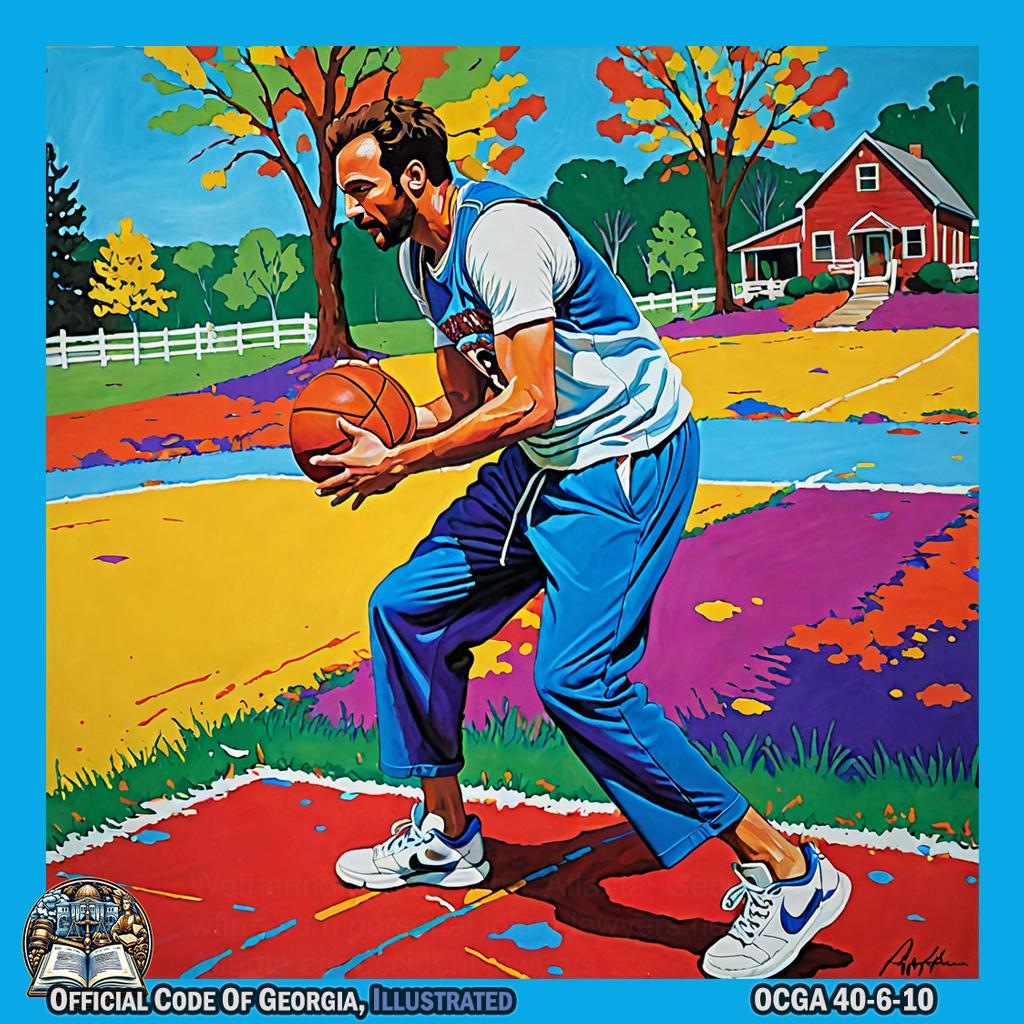
Anthony Fisher dribbles a basketball through a vibrant, color-splashed Woodstock landscape, pausing to mime reading and signing a large, abstractly shaped document before shaking his head and stepping away from it, symbolizing the importance of honesty and the consequences of falsehood in an energetic Landfield-esque tableau. -
Except for vehicles insured under a fleet policy as defined in Code Section 40-2-137 or under a plan of self-insurance approved by the Commissioner of Insurance, insurance coverage information from records of the Department of Revenue shall be prima-facie evidence of the facts stated therein and shall be admissible as evidence in accordance with Code Section 24-9-924 for the purposes of this Code section.

FRI Holding Company LLC splattering paint in a wild, chaotic manner on a large canvas at the Atlanta Jazz Festival.
40-6-10.1.Financial responsibility requirements of the Federal Motor Carrier Safety Administration.¶
No motor carrier subject to the financial responsibility requirements of the Federal Motor Carrier Safety Administration, or any successor agency, as contained in 49 C.F.R. Part 387, shall operate any motor vehicle upon the highways of this state until such motor carrier has obtained and has in effect the minimum levels of financial responsibility prescribed by such federal regulations.
40-6-11.Insurance requirements for operation of motorcycles.¶
- For the purposes of this Code section, “motorcycle” means any motor vehicle traveling on public streets or highways having a seat or saddle for the use of the rider and designed to travel on not more than three wheels in contact with the ground but excluding a tractor and a moped.
- No owner of a motorcycle or any other person, other than a self-insurer as defined in Chapter 34 of Title 33, shall operate or authorize any other person to operate the motorcycle unless the owner has liability insurance on the motorcycle equivalent to that required as evidence of security for bodily injury and property damage liability under Code Section 40-9-37. Any person who violates this subsection shall be guilty of a misdemeanor.
- The operator of a motorcycle shall keep proof or evidence of the minimum insurance coverage required by this Code section in his or her immediate possession or on the motorcycle at all times when such person is operating the motorcycle but only under the same circumstances and of the same type as prescribed for operators of other motor vehicles in Code Section 40-6-10. Any person who violates this subsection shall be subject to a fine not to exceed $25.00; however, there shall be no suspension of the person’s operator’s license or motor vehicle license tag for a violation of this subsection.
-
-
Insurance coverage information from records of the Department of Revenue shall be prima-facie evidence of the facts stated therein and shall be admissible as evidence in accordance with Code Section 24-9-924 for the purposes of this Code section.

Bill Terry dramatically unfurls a scroll, gesturing towards it with one hand as he points to the sky with the other, surrounded by larger-than-life paper cutouts of insurance documents and court records in Charlotte Mann's signature style. -
Every law enforcement officer in this state shall request the operator of a motorcycle subject to the provisions of subsection (c) of this Code section to produce proof or evidence of minimum insurance coverage required by this Code section at any time the law enforcement officer stops the motorcycle or requests the presentation of the driver’s license of such operator.
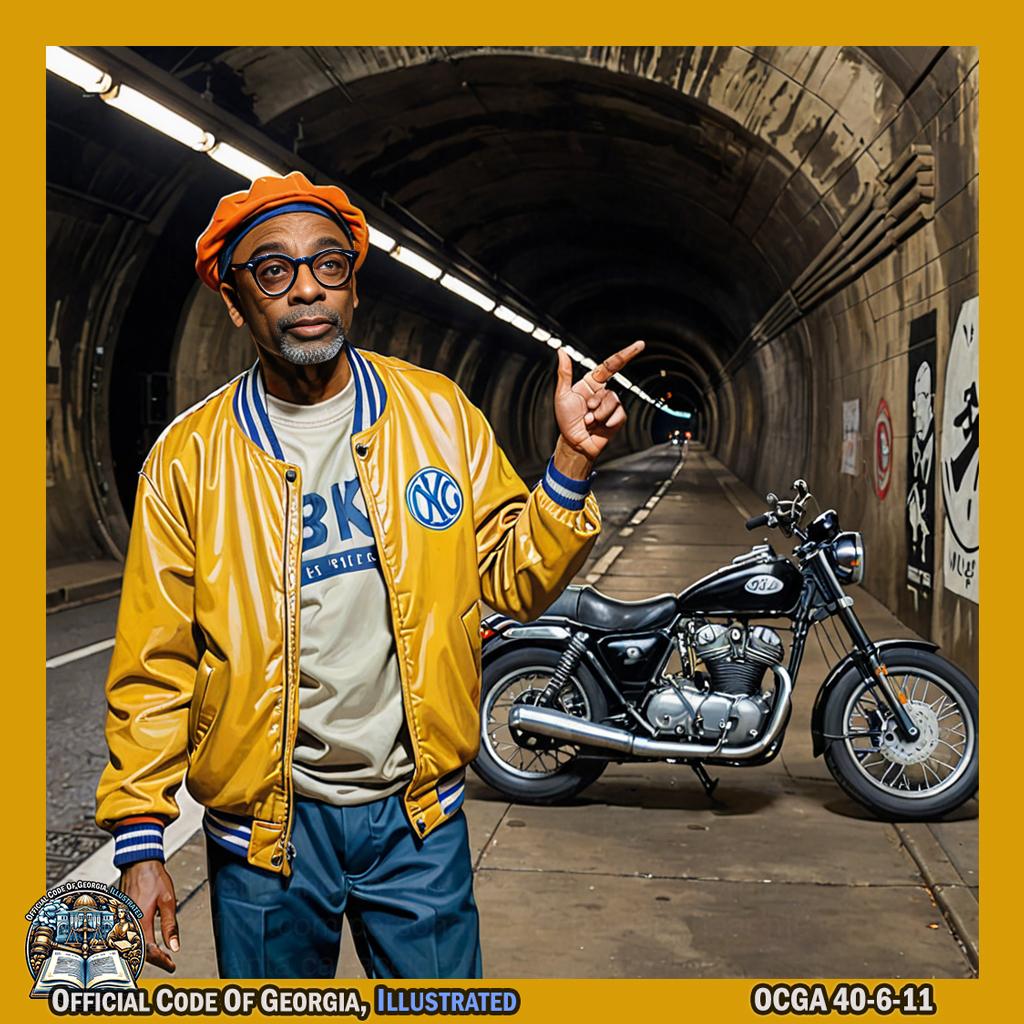
Spike Lee, in the style of John Brack, stands in Krog Street Tunnel and extends his arm towards a motorcycle operator, gesturing for proof of insurance coverage while maintaining a stoic and contemplative expression. -@SpikeLee
-
-
An owner or operator of a motorcycle shall not be issued a citation by a law enforcement officer for a violation of this Code section if the sole basis for issuance of such a citation is that the law enforcement officer is unable to obtain insurance coverage information from the records of the Department of Revenue.
40-6-12.Subsequent violation; proof of financial responsibility.¶
- Any person convicted of a second or subsequent violation of Code Section 40-6-10 within a five-year period, as measured from date of arrest to date of arrest, shall be required to file with the Department of Driver Services and maintain for a period of three years from the date of conviction proof of financial responsibility, as such term is defined in paragraph (5) of Code Section 40-9-2, in addition to any other punishment.
- If the proof of financial responsibility filed in accordance with subsection (a) of this Code section is based upon a policy issued by an insurance company, such insurer may not cancel the policy until the Department of Driver Services is given at least 30 days’ prior written notice of such cancellation.
40-6-13.Courts having jurisdiction to try offenses.¶
Any court having jurisdiction to try and dispose of traffic offenses shall have jurisdiction to try and dispose of the misdemeanor offenses provided for in Code Sections 40-6-10 and 40-6-11. Such jurisdiction shall be concurrent with the jurisdiction of any other court within the county having jurisdiction to try and dispose of such offenses.
40-6-14.Sound volume limitations from within the motor vehicle.¶
- It is unlawful for any person operating or occupying a motor vehicle on a street or highway to operate or amplify the sound produced by a radio, tape player, or other mechanical sound-making device or instrument from within the motor vehicle so that the sound is plainly audible at a distance of 100 feet or more from the motor vehicle.
-
The provisions of this Code section shall not apply to any law enforcement motor vehicle equipped with any communication device necessary in the performance of law enforcement duties or to any emergency vehicle equipped with any communication device necessary in the performance of any emergency procedures.
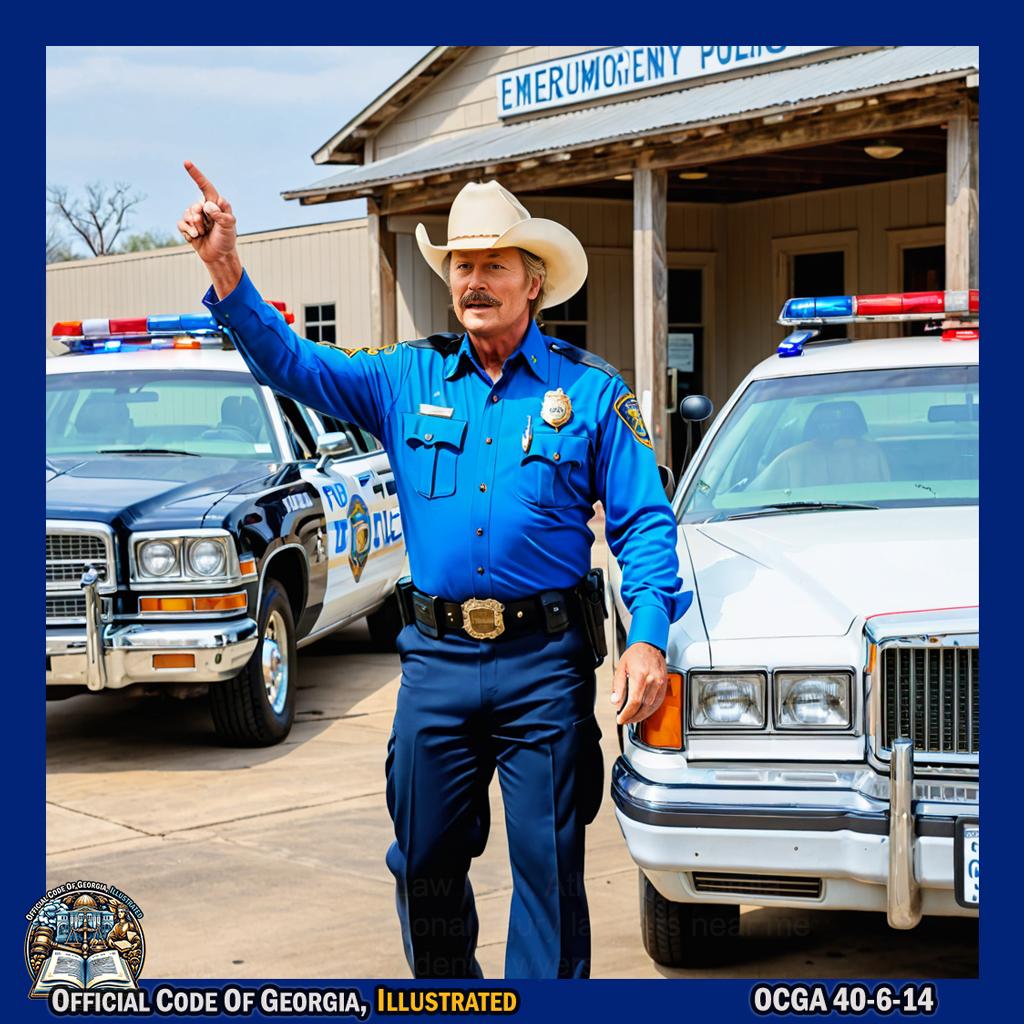
Alan Jackson, dressed in a law enforcement uniform, gesturing to a vintage police car equipped with communication devices, while surrounded by emergency vehicles also equipped with communication devices, all set against the backdrop of Martha Berry Museum's art collection. -@OfficialJackson -
The provisions of this Code section do not apply to motor vehicles used for business or political purposes, which in the normal course of conducting such business use sound-making devices. The provisions of this subsection shall not be deemed to prevent local authorities, with respect to streets and highways under their jurisdiction and within the reasonable exercise of the police power, from regulating the time and manner in which such business may be operated.
- The provisions of this Code section do not apply to the noise made by a horn or other warning device required or permitted by Code Section 40-8-70. The Department of Public Safety shall promulgate rules defining “plainly audible” and establish standards regarding the measurement of sound by law enforcement personnel.
- A violation of this Code section shall be a misdemeanor.

Football player Jonathan Massaquoi, captured in a John Balossi-esque art piece, portrays the act of pretending to be handcuffed while frowning with a sad face. -@JohnnyMass94
40-6-15.Knowingly driving motor vehicle on suspended, canceled, or revoked registration.¶
-
Any person who knowingly drives a motor vehicle on any public road or highway of this state at a time when the vehicle registration of such vehicle is suspended, canceled, or revoked shall be guilty of a misdemeanor.

Rubi Rose, in the style of Ronnie Cutrone, dramatically reenacts driving a suspended vehicle through Forest Park, Georgia. -@RubixxRose -
Upon a first conviction thereof or a plea of nolo contendere, such person shall be punished by imprisonment for not more than 12 months and there may be imposed in addition thereto a fine of not less than $500.00 nor more than $1,000.00, at the discretion of the court.
- For a second or subsequent conviction within five years as measured from the dates of previous arrests for which convictions were obtained or pleas of nolo contendere were accepted to the date of the current arrest for which a conviction is obtained or a plea of nolo contendere accepted, such person shall be guilty of a high and aggravated misdemeanor and shall be punished by imprisonment for not less than ten days nor more than 12 months and there may be imposed in addition thereto a fine of not less than $1,000.00 nor more than $2,500.00.
- The Department of Revenue, upon receiving a record of the conviction of any person under this Code section upon a charge of driving a vehicle while the registration of such vehicle was suspended or revoked, shall extend the period of suspension or revocation for six months. The Department of Revenue may reinstate the suspended or revoked vehicle registration following the expiration of the original suspension or revocation period, the additional six-month suspension imposed pursuant to this subsection, and upon payment of a restoration fee of $210.00, or $200.00 when such reinstatement is processed by mail.
-
For purposes of pleading nolo contendere, only one nolo contendere plea shall be accepted to a charge of driving a motor vehicle with a suspended, canceled, or revoked vehicle registration within a five-year period of time as measured from the date of the previous arrest for which a conviction was obtained or plea of nolo contendere was accepted to the date of the current arrest. All other nolo contendere pleas within such period of time shall be considered convictions.

Benn Jordan stands on a vintage car, holding a suspended vehicle registration while wearing an old-fashioned driving cap, as he dramatically pleads "nolo contendere" in the style of Weegee's art piece. -
Notwithstanding the limits set forth in Article 14 of this chapter and in any municipal charter, any municipal court of any municipality in this state shall be authorized to impose the punishment provided for in this Code section upon a conviction of violating this Code section or upon conviction of violating any ordinance adopting the provisions of this Code section.
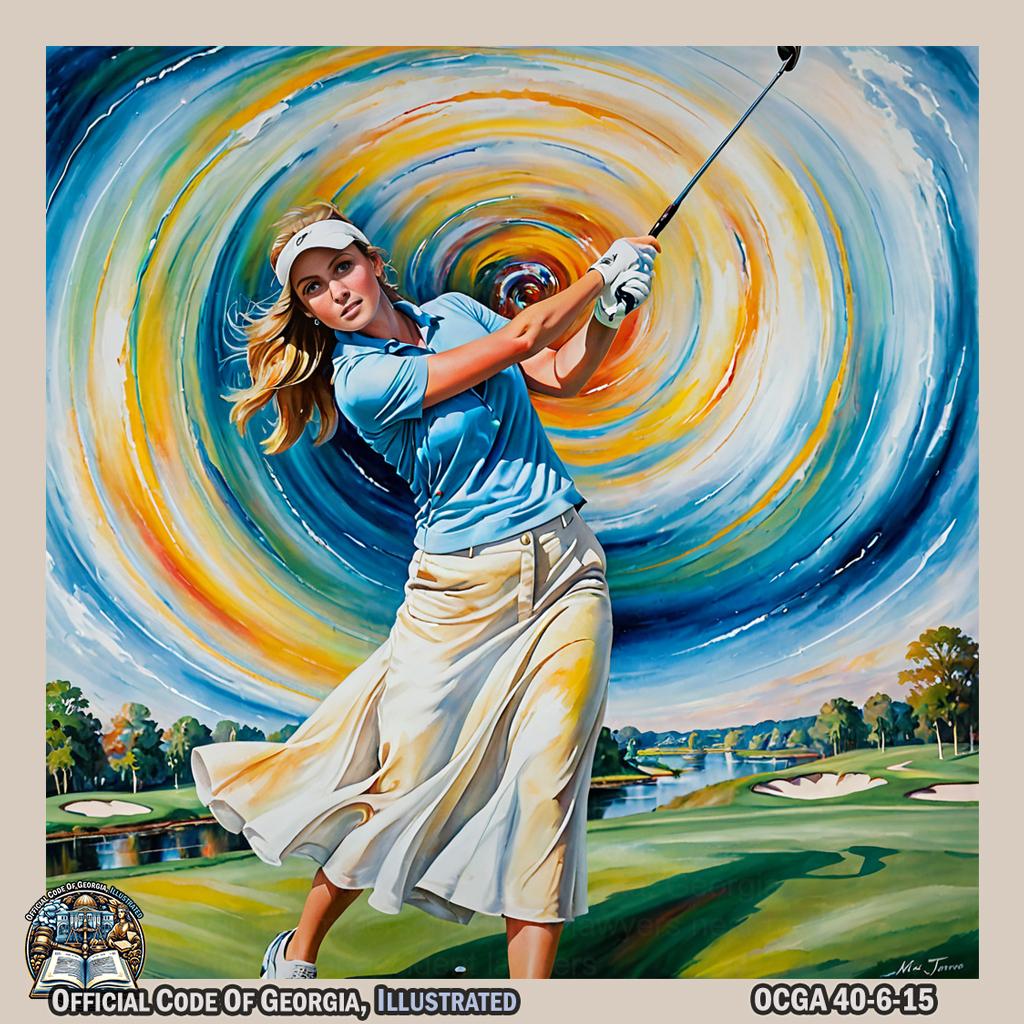
Hollis Stacy gracefully swings her golf club, the movement captured in a swirling vortex of color and light reminiscent of J.M.W. Turner's style.
40-6-16.Procedure for passing certain stationary vehicles.¶
- This Code section shall be known and may be cited as the “Spencer Pass Law.”
-
The operator of a motor vehicle approaching a stationary authorized emergency vehicle that is displaying flashing yellow, amber, white, red, or blue lights shall approach the authorized emergency vehicle with due caution and shall, absent any other direction by a peace officer, proceed as follows:
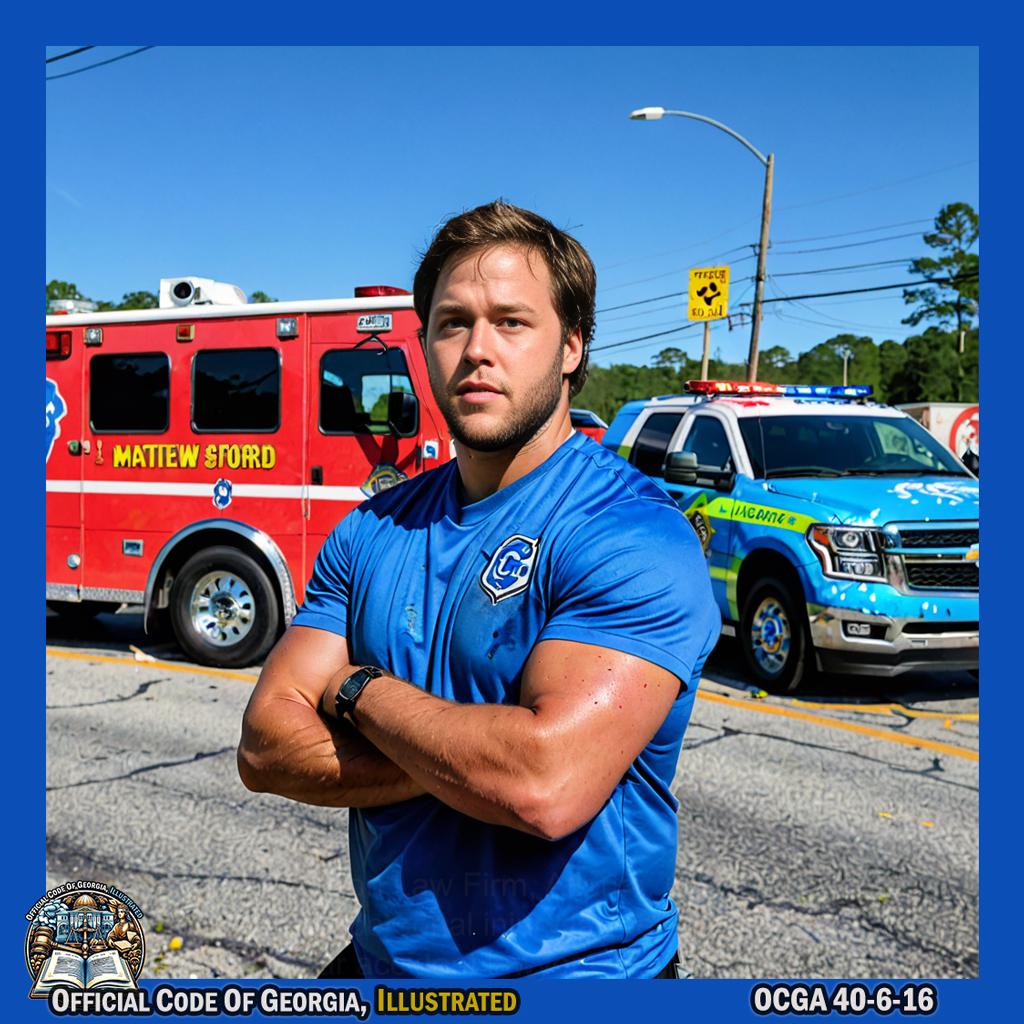
Matthew Stafford carefully and slowly approaches a stationary emergency vehicle with flashing lights, using exaggerated caution and hand gestures to indicate his careful approach, while surrounded by vibrant murals depicting the Georgia landscape in Kingsland. -@Staff_9 -
Make a lane change into a lane not adjacent to the authorized emergency vehicle if possible in the existing safety and traffic conditions; or
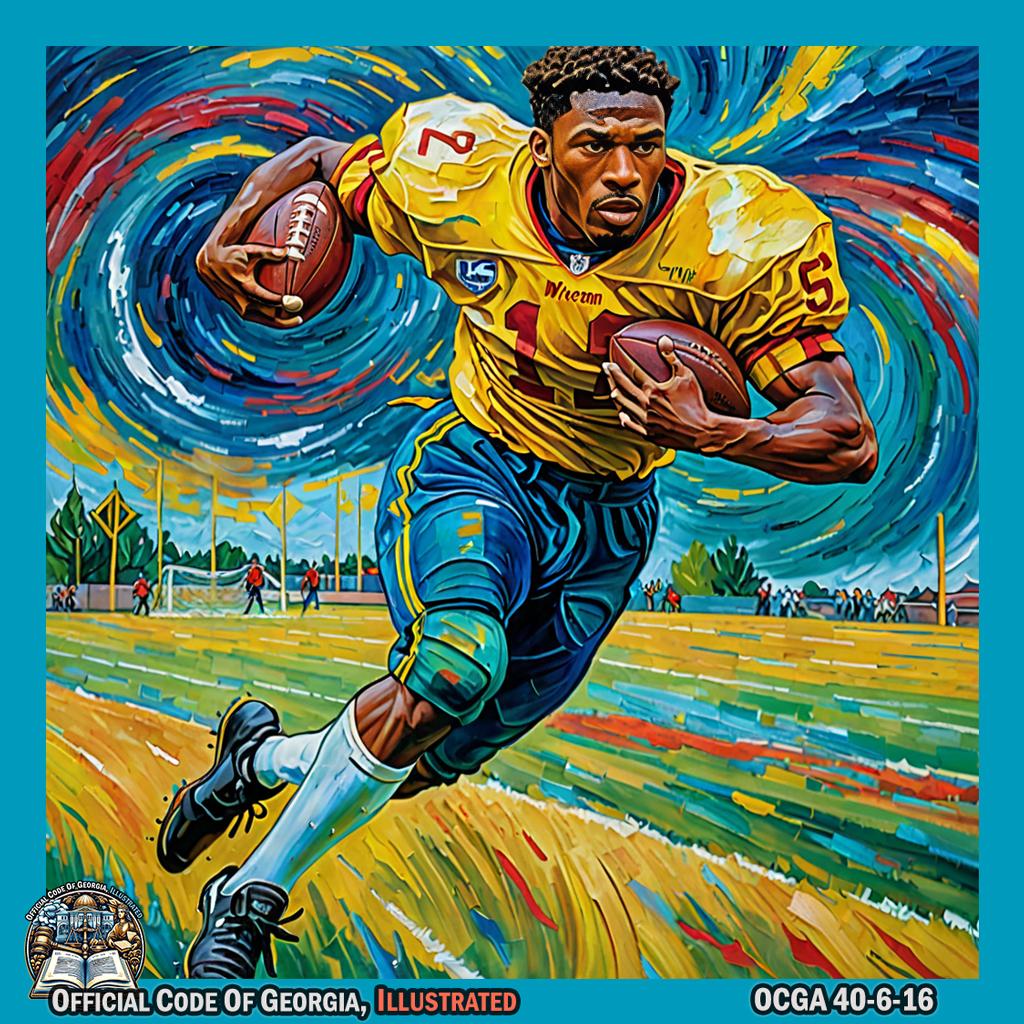
Football player Myron Guyton gracefully pivots and glides across the field, weaving through traffic while surrounded by a whirlwind of vibrant colors and swirling motion, capturing the essence of Vincent van Gogh's art in a dramatic lane change performance. -
If a lane change under paragraph (1) of this subsection would be impossible, prohibited by law, or unsafe, reduce the speed of the motor vehicle to a reasonable and proper speed for the existing road and traffic conditions, which speed shall be less than the posted speed limit, and be prepared to stop.
-
-
The operator of a motor vehicle approaching a stationary towing or recovery vehicle, a stationary highway maintenance vehicle, or a stationary utility service vehicle that is utilizing traffic cones or displaying flashing yellow, amber, white, or red lights shall approach the vehicle with due caution and shall, absent any other direction by a peace officer, proceed as follows:
-
Make a lane change into a lane not adjacent to the towing, recovery, highway maintenance, or utility service vehicle if possible in the existing safety and traffic conditions; or

Basketball player Randolph Morris gracefully glides across a vibrant, lush Atlanta Summer Beef Fest landscape, using exaggerated and elegant movements to depict the act of making a lane change into a lane not adjacent to the towing recovery highway maintenance or utility service vehicle. His movements are reminiscent of Henri Rousseau's art, blending athleticism with artistic expression in an entertaining and imaginative manner. -
If a lane change under paragraph (1) of this subsection would be impossible, prohibited by law, or unsafe, reduce the speed of the motor vehicle to a reasonable and proper speed for the existing road and traffic conditions, which speed shall be less than the posted speed limit, and be prepared to stop.
-
-
- Violation of subsection (b) of this Code section shall be punished by a fine of not more than $500.00.
- Violation of subsection (c) of this Code section shall be punished by a fine of not more than $250.00.
-
As used in this Code section, the term:
-
“Utility service vehicle” means any vehicle being used by an employee or contractor of any entity, including, but not limited to, a political subdivision of this state or a local authority or commission related thereto, an electric cooperative, or a public or private corporation, in connection with the provision of utility services.
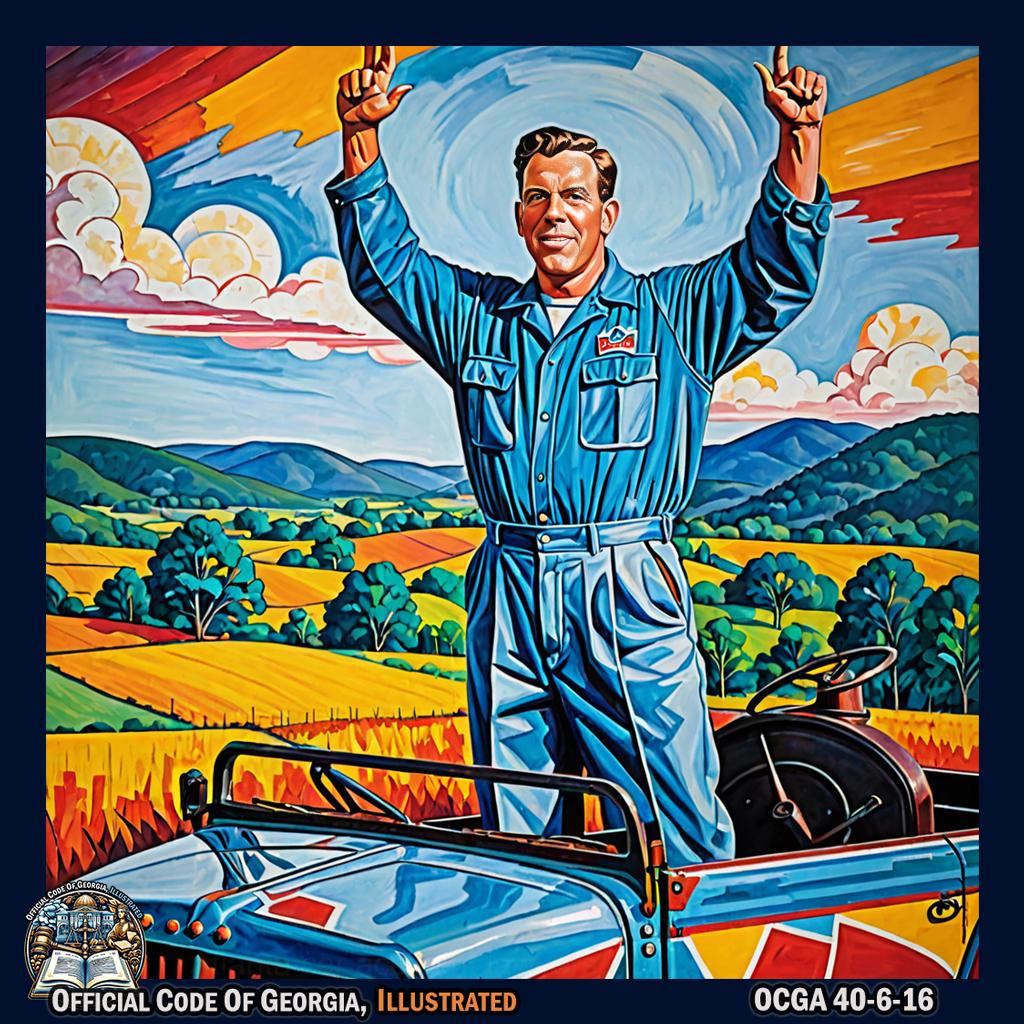
William Tapley Bennett Jr. standing on a vintage utility service vehicle, raising his arms in dramatic fashion as he gestures towards the surrounding landscape, with vibrant colors and bold lines reminiscent of Picasso's cubist style, all set against the picturesque backdrop of Winder, Georgia. -
“Utility services” means and includes electric, natural gas, water, waste-water, cable, telephone, or telecommunication services or the repair, location, relocation, improvement, or maintenance of utility poles, transmission structures, pipes, wires, fibers, cables, easements, rights of way, and associated infrastructure.
-
40-6-16.1.Procedure for passing vehicle with active sanitation workers.¶
-
As used in this Code section, the term “sanitation worker” means an individual engaged in the collection and transport of residential or commercial solid waste and recyclables as authorized by a county or municipal governing authority.

Porsha Williams gracefully mimics the act of collecting and transporting residential or commercial solid waste and recyclables, embodying the essence of a sanitation worker with elegance and poise in a mesmerizing art piece at The Performing Arts Center at GSU. -@Porsha4real -
The operator of a motor vehicle approaching a vehicle with active sanitation workers that is displaying flashing yellow, amber, white, or red lights shall approach the vehicle with due caution and shall, absent any other direction by a peace officer, proceed as follows:
-
Make a lane change into a lane not adjacent to the vehicle if possible in the existing safety and traffic conditions; or

Bucky Dent gracefully glides across the room, mirroring Cézanne's style, as he smoothly shifts from one exhibit to another at St. Marys Submarine Museum in Georgia. -
If a lane change under paragraph (1) of this subsection would be impossible, prohibited by law, or unsafe, reduce the speed of the motor vehicle to a reasonable and proper speed for the existing road and traffic conditions, which speed shall be at least ten miles per hour less than the posted speed limit or 25 miles per hour, whichever is more, and be prepared to stop.
-
-
Violation of subsection (b) of this Code section shall be punished by a fine of not more than $250.00.

Matt Beaty, in an Atlanta Symphony Orchestra setting, stands on a podium conducting musicians with exaggerated, fluid motions, pausing to mime handing out fines to players hitting wrong notes, all depicted in the vibrant and dynamic style of a Picasso cubist painting. -@matt_beatybu
40-6-17.Prohibited use of traffic-control device preemption emitter; penalty.¶
- As used in this Code section, the term “traffic-control device preemption emitter” means a mobile infrared transmitter or any other similar device which transmits an infrared beam, radio wave, or other signal used for the purpose of changing, altering, disabling, or disrupting the normal signal sequence of a traffic-control device.
- It shall be unlawful for any person other than law enforcement, fire department, or emergency personnel to use, possess with the ability to use, sell, or purchase a traffic-control device preemption emitter.
- Any person who violates subsection (b) of this Code section shall be guilty of a misdemeanor.
Article 2 Traffic Signs, Signals, and Markings¶
- 40-6-20. Obedience to traffic-control devices required; presumptions; red light cameras.
- 40-6-21. Meaning of traffic signals.
-
40-6-22. Pedestrian-control signals.
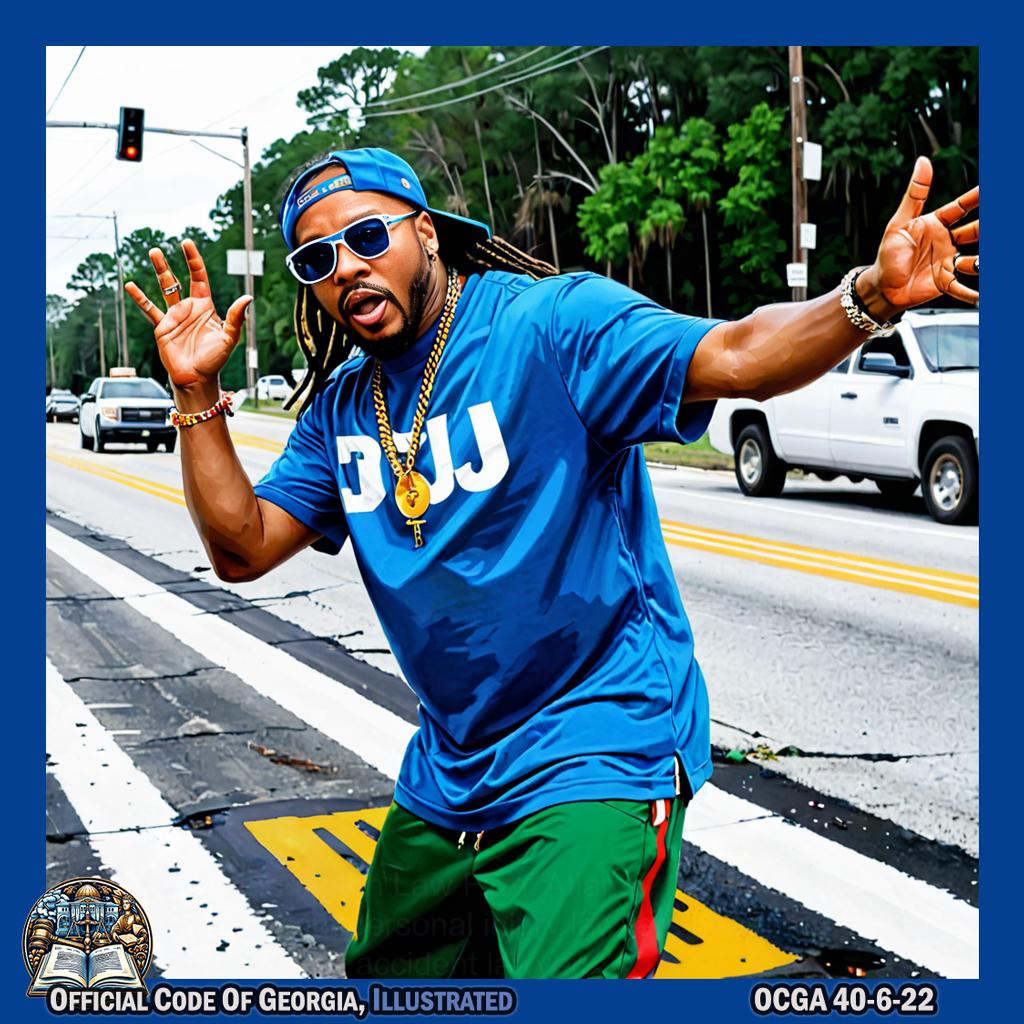
DJ; rapper; record producer, Lil Jon performing exaggerated arm movements at an intersection in Jesup, Georgia to mimic the changing pedestrian crossing signals. -@LilJon - 40-6-24. Lane direction control signals.
- 40-6-25. Display of unauthorized signs, signals, or markings.
-
40-6-26. Interference with official traffic-control devices or certain signs; travel on closed highway prohibited.

Arby’s is playing the role of a traffic officer at Splash Island Waterpark in Georgia, directing cars with a stop sign and construction hat. -@Arbys -
40-6-27. Installation of blue retroreflective raised pavement markers.

Musician Jennifer Nettles places blue retroreflective raised pavement markers on a colorful, oversized road map in the vibrant Piedmont Heights neighborhood of Atlanta, Georgia, while donning a construction hat and vest. -@JenniferNettles
40-6-20.Obedience to traffic-control devices required; presumptions; red light cameras.¶
- The driver of any vehicle shall obey the instructions of an official traffic-control device applicable thereto, placed in accordance with this chapter, unless otherwise directed by a police officer, subject to the exceptions granted the driver of an authorized emergency vehicle in this chapter. A violation of this subsection shall be a misdemeanor, except as otherwise provided by subsection (f) of this Code section.
- No provisions of this chapter which require official traffic-control devices shall be enforced against an alleged violator if at the time and place of the alleged violation an official device was not in proper position and sufficiently legible to be seen by an ordinarily observant person. Whenever a particular Code section does not state that official traffic-control devices are required, such Code section shall be effective even though no devices are erected or in place.
- Whenever official traffic-control devices are placed in position approximately conforming to the requirements of this chapter, such devices shall be presumed to have been so placed by the official act or direction of lawful authority, unless the contrary shall be established by competent evidence.
- Any official traffic-control device placed pursuant to this chapter and purporting to conform to the lawful requirements pertaining to such devices shall be presumed to comply with the requirements of this chapter, unless the contrary shall be established by competent evidence.
- The disregard or disobedience of the instructions of any official traffic-control device or signal placed in accordance with the provisions of this chapter by the driver of a vehicle shall be deemed prima-facie evidence of a violation of law, without requiring proof of who and by what authority such sign or device has been erected.
-
-
As used in this subsection, the term: 1. “Owner” means the registrant of a motor vehicle, except that such term shall not include a motor vehicle rental company when a motor vehicle registered by such company is being operated by another person under a rental agreement with such company.
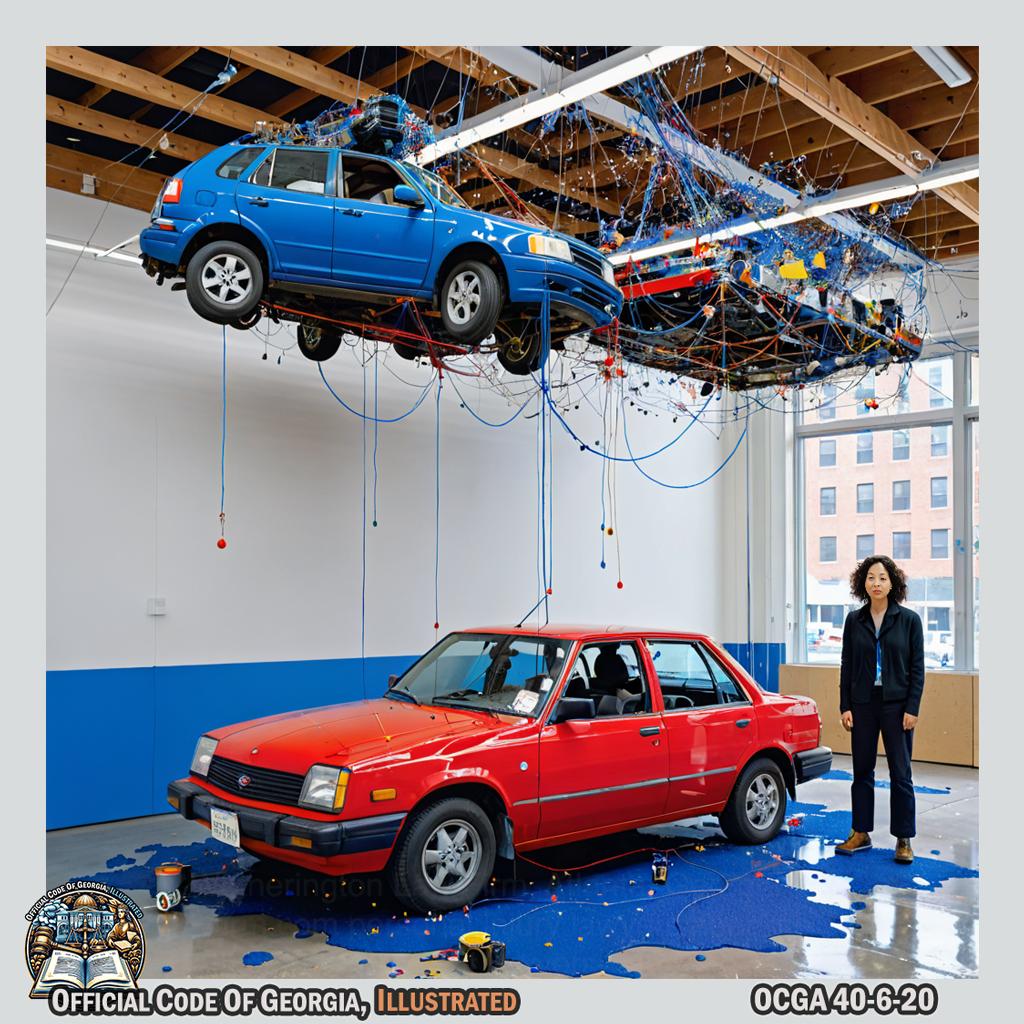
Curley Weaver stands in a vibrant scene, using intricate movements to symbolize the transfer of a motor vehicle from its owner to a rental company and then to another person under an agreement. The space is filled with suspended objects, mobiles, and colorful elements that represent the complexity of this legal concept, all created in Sarah Sze's signature style. - “Recorded images” means images recorded by a traffic-control signal monitoring device:
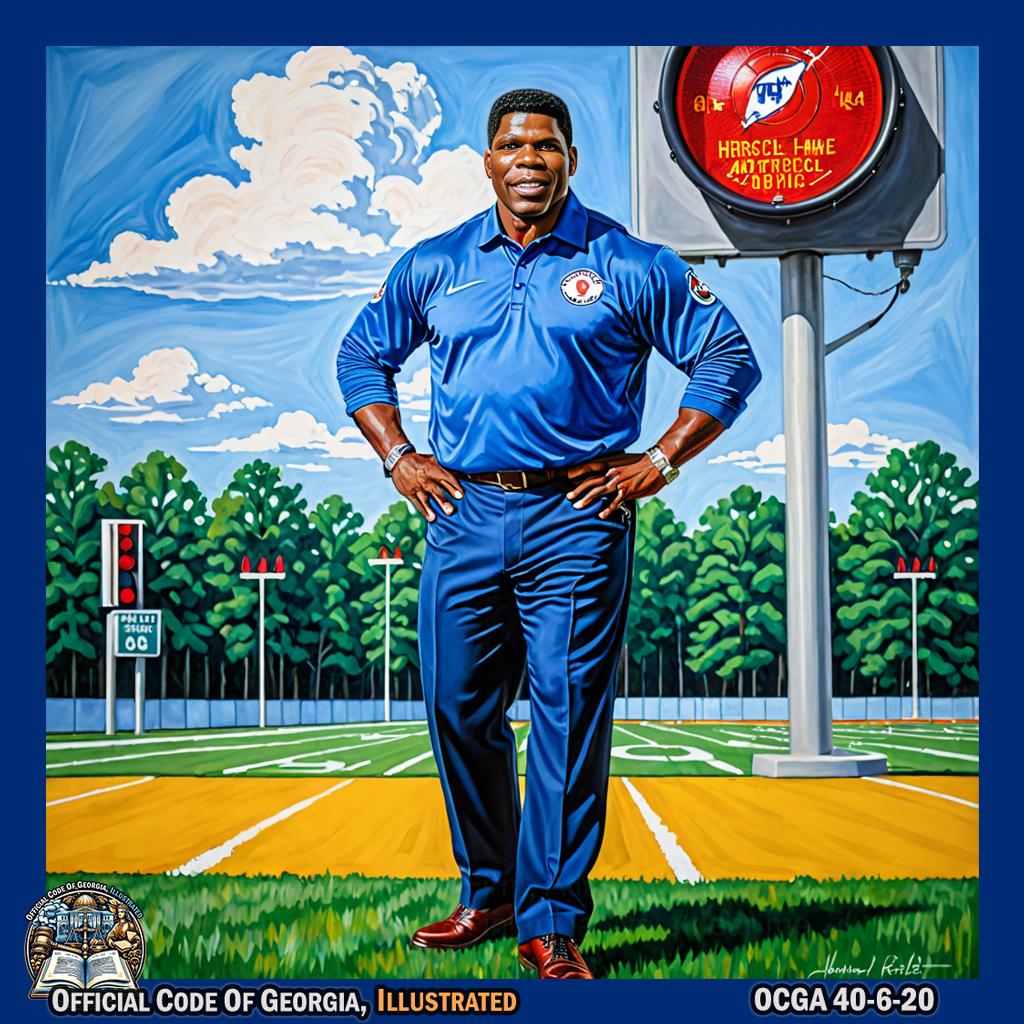
Herschel Walker gracefully mimics the movements of a traffic-control signal monitoring device, captured in the artistic style of Julie Blyfield, within the vibrant setting of the College Football Hall of Fame. -@HerschelWalker -
On:

Singer Chris Robinson could pose in a dramatic, expressive manner while holding a microphone and gesturing towards an invisible audience, with dramatic lighting casting strong shadows on his face and body, mirroring the intense style of Lucian Freud's art. - Two or more photographs;
-
Two or more microphotographs;

Migos arranging and examining multiple microscopic photographs, captured in a dynamic art piece resembling the work of Salvador Dali, set amidst the lush landscapes of Grovetown. -@Migos -
Two or more electronic images; or
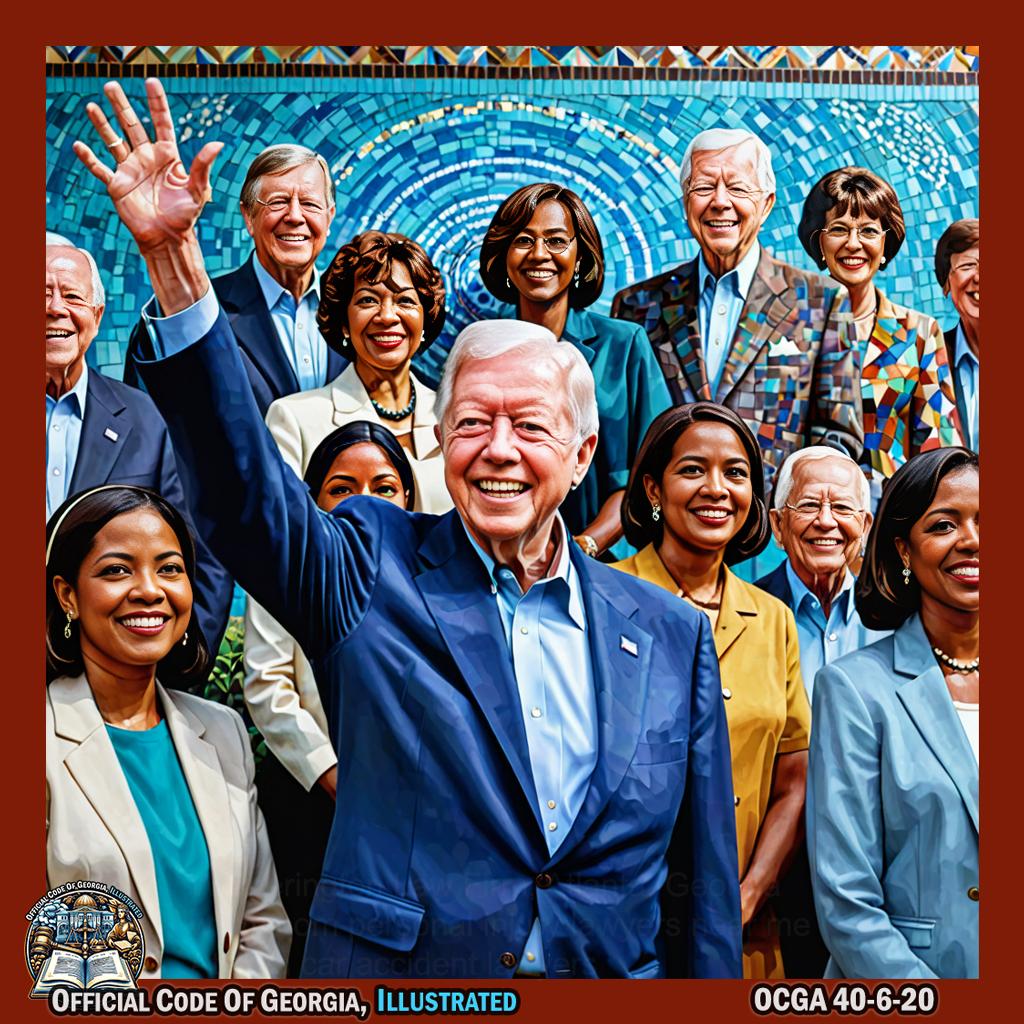
Former U.S. President Jimmy Carter standing with a group of diverse people, each holding electronic images and gesturing toward each other in an interactive and engaging manner, all depicted in the style of a colorful mosaic art piece reminiscent of ancient civilizations. -
Videotape; and 2. Showing a traffic-control signal displaying a CIRCULAR RED or RED ARROW signal along with the rear of a motor vehicle apparently operated in disregard or disobedience of such signal and, on at least one image or portion of tape, clearly revealing the number or other identifying designation of the license plate displayed on the motor vehicle. 3. “Traffic-control signal monitoring device” means a device with one or more motor vehicle sensors working in conjunction with a traffic-control signal to produce recorded images of motor vehicles being operated in disregard or disobedience of a CIRCULAR RED or RED ARROW signal.
- Subsection (a) of this Code section may be enforced as provided in this subsection pursuant to the use of traffic-control signal monitoring devices in accordance with Article 3 of Chapter 14 of this title.
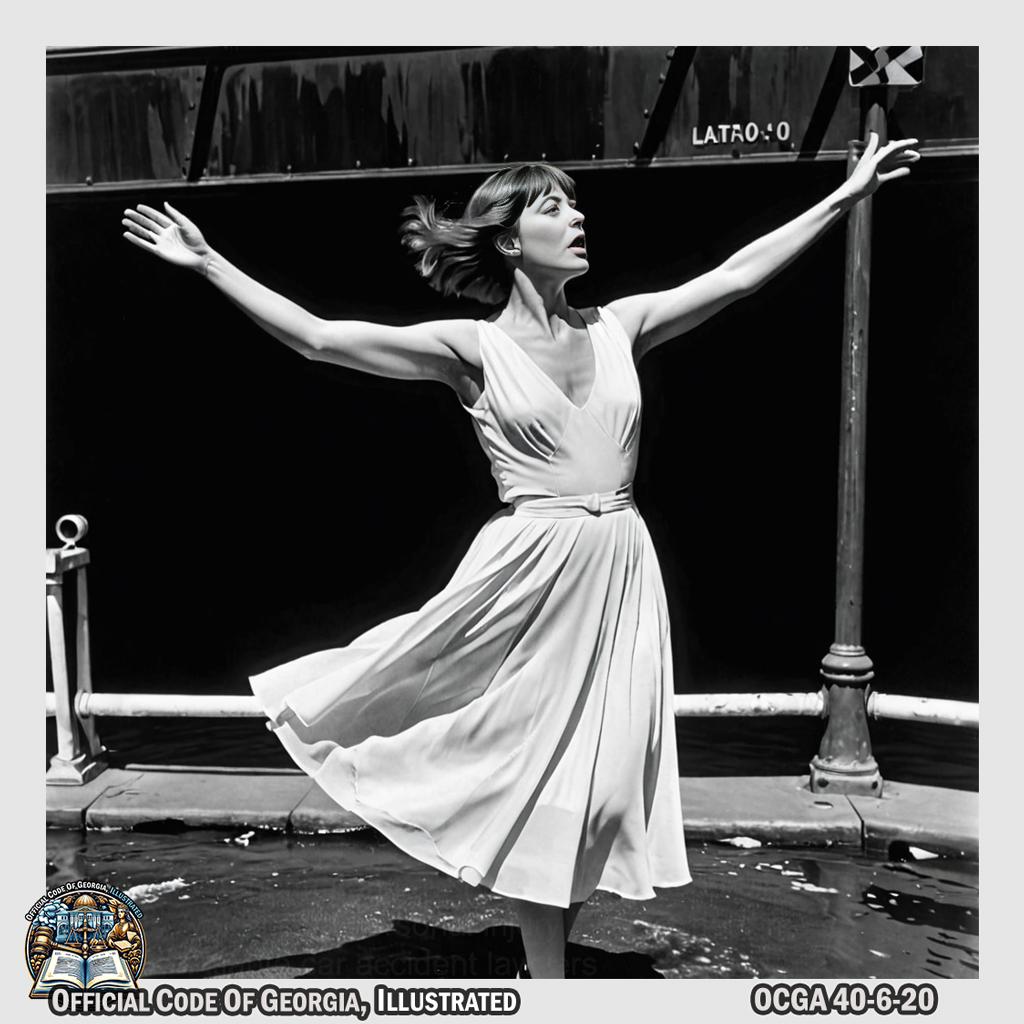
Latto gracefully moves her arms and body in a flowing, interpretive dance, mimicking the use of traffic-control signal monitoring devices as described in the Code section. The movements are captured in striking black and white photography reminiscent of Berenice Abbott's iconic style, set against the backdrop of Newport Aquarium’s mesmerizing underwater world. -@Latto
- Subsection (a) of this Code section may be enforced as provided in this subsection pursuant to the use of traffic-control signal monitoring devices in accordance with Article 3 of Chapter 14 of this title.
-
- “Recorded images” means images recorded by a traffic-control signal monitoring device:
-
For the purpose of enforcement pursuant to this subsection:
- The driver of a motor vehicle shall be liable for a civil monetary penalty of not more than $70.00 if such vehicle is found, as evidenced by recorded images produced by a traffic-control signal monitoring device, to have been operated in disregard or disobedience of a CIRCULAR RED or RED ARROW signal in violation of subsection (a) of this Code section and such disregard or disobedience was not otherwise authorized by law;
-
The law enforcement agency authorized to enforce the provisions of this Code section shall send by regular mail addressed to the owner of the motor vehicle postmarked not later than ten days after the date of the alleged violation:
- A citation for the alleged violation, which shall include the date and time of the violation, the location of the intersection, the amount of the civil monetary penalty imposed, and the date by which the civil monetary penalty shall be paid;
- A copy of the recorded image;
- A copy of a certificate sworn to or affirmed by a certified peace officer employed by a law enforcement agency authorized to enforce this Code section and stating that, based upon inspection of recorded images, the owner’s motor vehicle was operated in disregard or disobedience of a CIRCULAR RED or RED ARROW signal in violation of subsection (a) of this Code section and that such disregard or disobedience was not otherwise authorized by law;
- A statement of the inference provided by subparagraph (D) of this paragraph and of the means specified therein by which such inference may be rebutted;
-
Information advising the owner of the motor vehicle of the manner and time in which liability as alleged in the citation may be contested in court; and
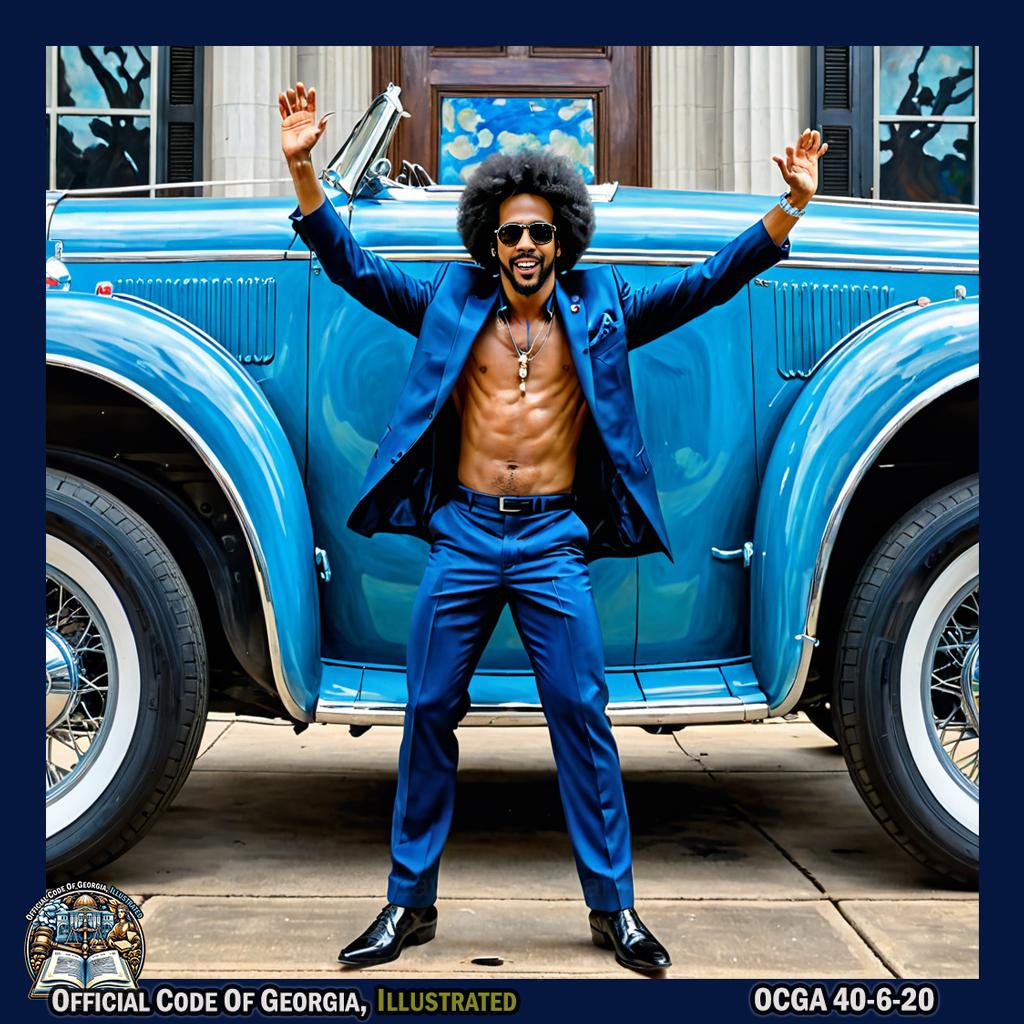
William DuVall gracefully dances with a vintage car, using expressive gestures to convey receiving and contesting a citation while incorporating elements of art from Blu in the background at Georgia State Capitol. -@WilliamDuvall -
Warning that failure to pay the civil monetary penalty or to contest liability in a timely manner shall waive any right to contest liability and result in a civil monetary penalty;
provided, however, that only warning notices and not citations for violations shall be sent during the 30 day period commencing with the installation of a traffic-control signal monitoring device at such location;
-
Proof that a motor vehicle was operated in disregard or disobedience of a CIRCULAR RED or RED ARROW signal in violation of subsection (a) of this Code section shall be evidenced by recorded images produced by a traffic-control signal monitoring device authorized pursuant to Article 3 of Chapter 14 of this title. A copy of a certificate sworn to or affirmed by a certified peace officer employed by a law enforcement agency and stating that, based upon inspection of recorded images, a motor vehicle was operated in disregard or disobedience of a CIRCULAR RED or RED ARROW signal in violation of subsection (a) of this Code section and that such disregard or disobedience was not otherwise authorized by law shall be prima-facie evidence of the facts contained therein; and

James Oglethorpe, dressed in period attire, theatrically peers through an ornate brass telescope at a large canvas where vibrant and intricate Ernst Haeckel-style illustrations depict various cars frozen in time as they pass through a red traffic light; one vehicle is highlighted by a bright red circle. Surrounding flora and fauna, reminiscent of Haeckel’s work, teem with life, emphasizing the chaos and natural consequences of disregarding rules. Oglethorpe gestures dramatically towards the scene with one hand while holding up a magnifying glass with the other, symbolizing scrutiny and enforcement of traffic laws amidst the serene Sugar Hill landscape. -
Liability under this subsection shall be determined based upon preponderance of the evidence. Prima-facie evidence that the vehicle described in the citation issued pursuant to this subsection was operated in violation of subsection (a) of this Code section, together with proof that the defendant was at the time of such violation the registered owner of the vehicle, shall permit the trier of fact in its discretion to infer that such owner of the vehicle was the driver of the vehicle at the time of the alleged violation. Such an inference may be rebutted if the owner of the vehicle:
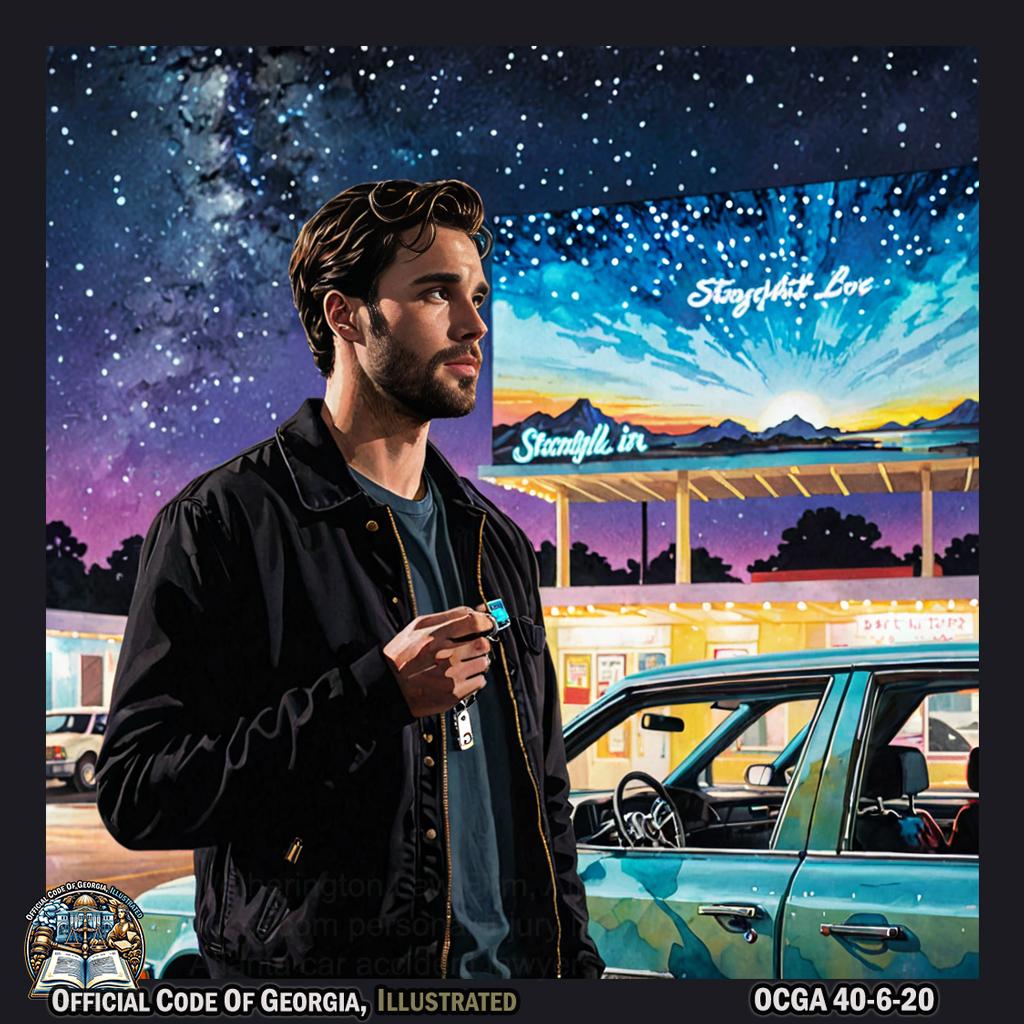
Kyle Love stands at the entrance of Starlight Drive-In Theatre, dramatically holding a set of car keys while gazing at a car projected on the screen; he then passes the keys to another person, indicating a transfer of responsibility. The scene is captured in Simon Prades' intricate line work and moody watercolors, with surreal elements blending the legal concept with the nostalgic atmosphere of the drive-in. -
Testifies under oath in open court or submits to the court a sworn notarized statement that he or she was not the operator of the vehicle at the time of the alleged violation;
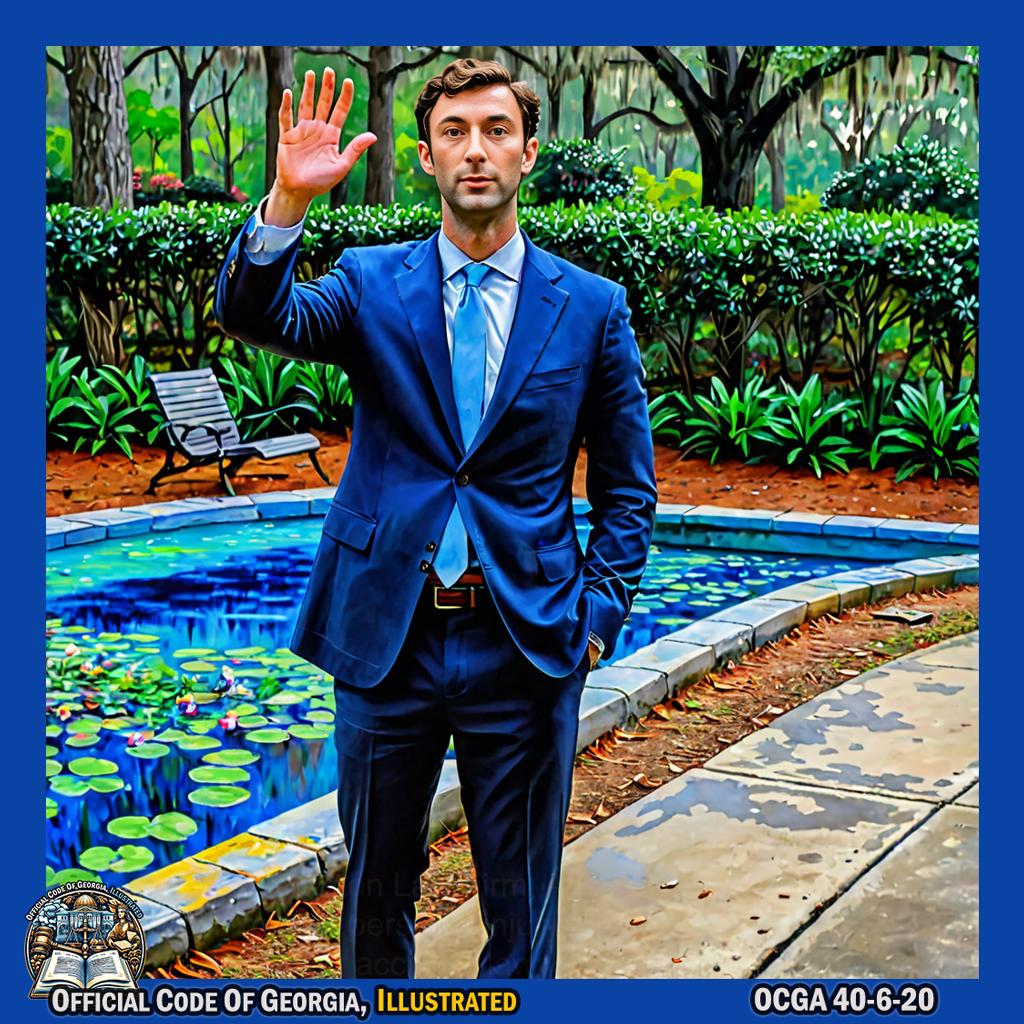
Senator Jon Ossoff gracefully raises his right hand with a dramatic flourish, while gazing solemnly towards the sky, as if to swear under oath in an open court that he was not the operator of the vehicle at the time of the alleged violation. This art piece captures his ethereal presence amidst the haunting beauty of Grave of Corinne Elliot Lawton in Savannah, Georgia, reminiscent of Claude Monet's enchanting style. -@ossoff -
Presents to the court a certified copy of a police report showing that the vehicle had been reported to the police as stolen prior to the time of the alleged violation; or
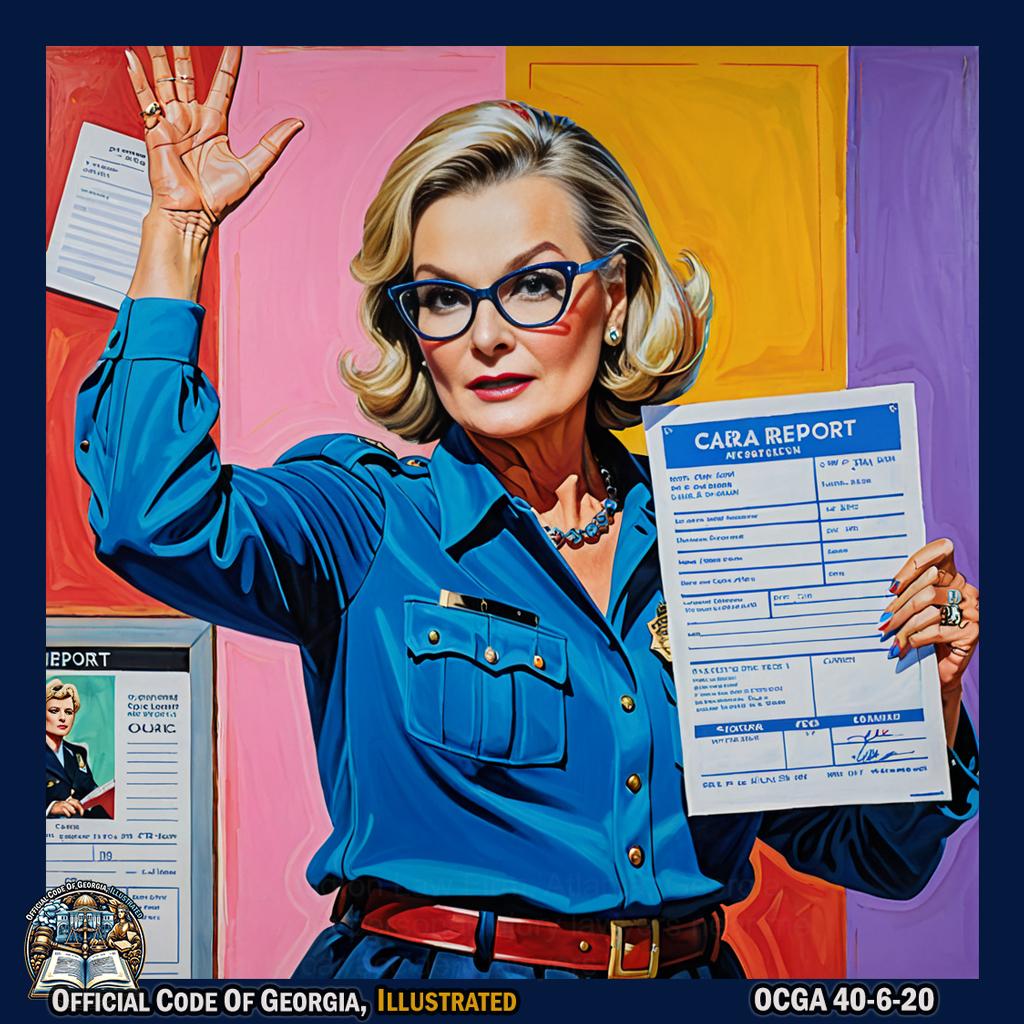
Actress Joanne Woodward dramatically presents a framed, oversized police report to an imaginary court, gesturing with grand and exaggerated movements in the style of Carla Sonheim's art, while surrounded by vibrant colors and whimsical shapes in Lilburn. -
Submits to the court a sworn notarized statement identifying the name of the operator of the vehicle at the time of the alleged violation.
- A violation for which a civil penalty is imposed pursuant to this subsection shall not be considered a moving traffic violation, for the purpose of points assessment under Code Section 40-5-57. Such violation shall be deemed noncriminal, and imposition of a civil penalty pursuant to this subsection shall not be deemed a conviction and shall not be made a part of the operating record of the person upon whom such liability is imposed, nor shall it be used for any insurance purposes in the provision of motor vehicle insurance coverage.
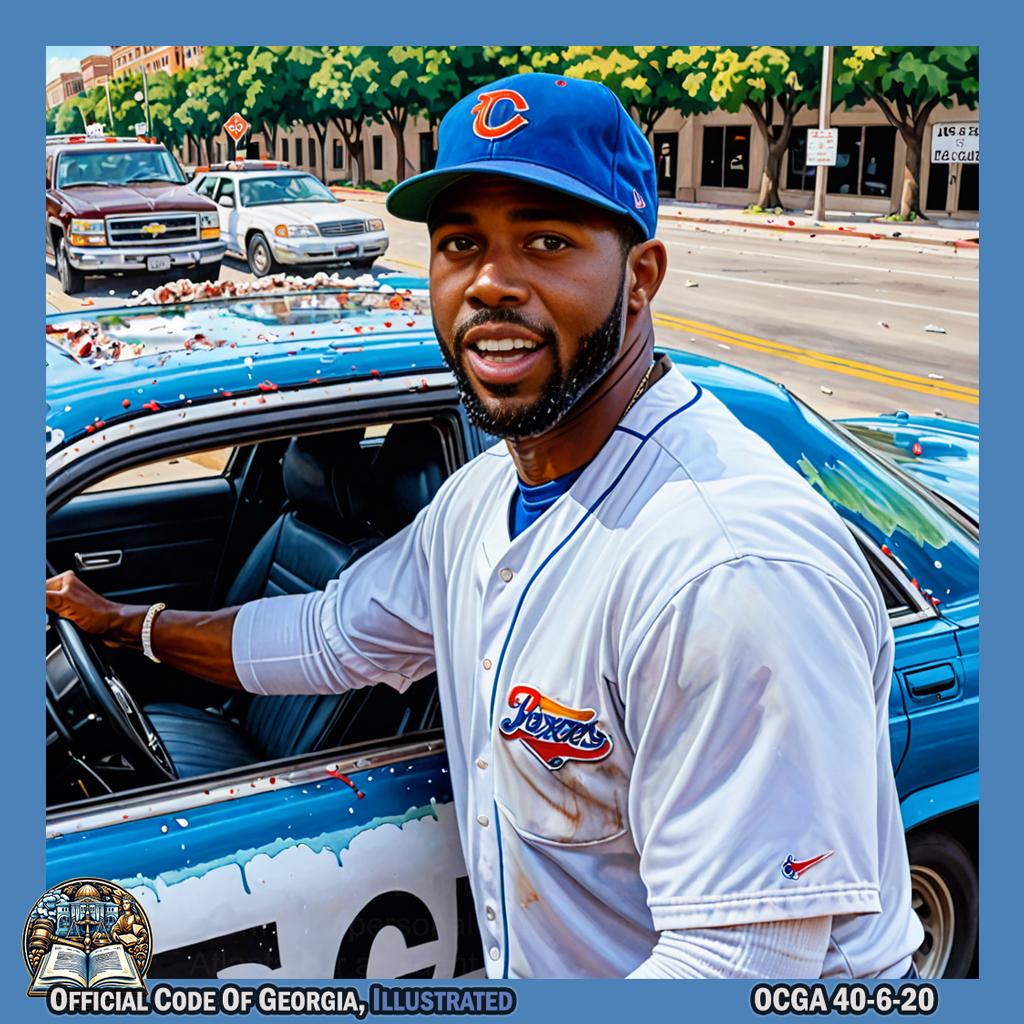
In Joe Zucker's art piece, Dexter Fowler elegantly pretends to drive a car before dramatically tearing up an imaginary traffic ticket into pieces. -@DexterFowler
- A violation for which a civil penalty is imposed pursuant to this subsection shall not be considered a moving traffic violation, for the purpose of points assessment under Code Section 40-5-57. Such violation shall be deemed noncriminal, and imposition of a civil penalty pursuant to this subsection shall not be deemed a conviction and shall not be made a part of the operating record of the person upon whom such liability is imposed, nor shall it be used for any insurance purposes in the provision of motor vehicle insurance coverage.
-
-
If a person summoned by regular mail fails to appear on the date of return set out in the citation and has not paid the penalty for the violation or filed a police report or notarized statement pursuant to subparagraph (D) of paragraph (3) of this subsection, the person shall then be summoned a second time by certified mail with a return receipt requested. The second summons shall include all information required in subparagraph (B) of paragraph (3) of this subsection for the initial summons and shall include a new date of return. If a person summoned by certified mail again fails to appear on the date of return set out in the second citation and has failed to pay the penalty or file an appropriate document for rebuttal, the person summoned shall have waived the right to contest the violation and shall be liable for a civil monetary penalty of not more than $70.00.
-
Any court having jurisdiction over violations of subsection (a) of this Code section or any ordinance adopting the provisions of said subsection pursuant to Code Section 40-6-372 shall have jurisdiction over cases arising under this subsection and shall be authorized to impose the civil monetary penalty provided by this subsection. Except as otherwise provided in this subsection, the provisions of law governing jurisdiction, procedure, defenses, adjudication, appeal, and payment and distribution of penalties otherwise applicable to violations of subsection (a) of this Code section shall apply to enforcement under this subsection; provided, however, that any appeal from superior or state court shall be by application in the same manner as that provided by Code Section 5-6-35.

Quavo, wearing a judge's robe and wielding a gavel, theatrically strides around a pottery studio filled with Giana Eden's intricate ceramic creations. He pauses to examine pots and vases that symbolize different legal jurisdictions, lifts and balances scales of justice adorned in clay, then pretends to read from an unfired clay tablet as if it were the Code section. He mimics writing on a large vase with a quill for adjudication while striking the gavel on pedestals to impose penalties. Occasionally he steps up onto a potter's wheel platform as if taking an appeal to a higher court, spinning slowly with arms outstretched balancing various pieces of pottery symbolic of law and order. -@QuavoStuntin -
Recorded images made for purposes of this subsection shall not be a public record for purposes of Article 4 of Chapter 18 of Title 50.
- A governing authority shall not impose a civil penalty under this subsection on the owner of a motor vehicle if the operator of the vehicle was arrested or issued a citation and notice to appear by a peace officer for the same violation that is recorded by a traffic-control signal monitoring device.
-
40-6-21.Meaning of traffic signals.¶
-
The following meanings shall be given to highway traffic signal indications, except those on pedestrian signals:

Mary J. Blige stands at a highway intersection, interpreting the traffic signal indications through fluid and expressive dance movements, while surrounded by vibrant and swirling patterns of light and color reminiscent of Matt Wisniewski's art style. -@maryjblige -
Green indications shall have the following meanings:

Alan Jackson, dressed as a traffic conductor with oversized green gloves, orchestrates a group of children through a whimsical Tanguy-esque landscape of towering abstract shapes, guiding them to plant trees and flowers that bloom into vibrant green hues in Cabbagetown's eclectic surroundings. -@OfficialJackson -
Traffic, except pedestrians, facing a CIRCULAR GREEN signal may proceed straight through or turn right or left unless a sign at such place prohibits either such turn. Vehicular traffic turning shall yield the right of way to approaching vehicles. Vehicular traffic must stop and remain stopped to allow a pedestrian to cross the roadway within a crosswalk when the pedestrian lawfully within the intersection or an adjacent crosswalk at the time such signal is exhibited is upon the half of the roadway upon which the vehicle is traveling, or when the pedestrian is approaching and is within one lane of the half of the roadway on which the vehicle is traveling or onto which it is turning. For the purposes of this subparagraph, “half of the roadway” means all traffic lanes carrying traffic in one direction of travel;

James Brown dances in a circular motion, smoothly transitioning into right and left turns while yielding to imaginary vehicles before coming to a dramatic halt and gesturing for an imaginary pedestrian to cross the intersection, all set against a vibrant backdrop of Bainbridge's natural beauty. -
Traffic, except pedestrians, facing a GREEN ARROW signal, shown alone or in combination with another indication, may cautiously enter the intersection only to make the movement indicated by such arrow or such other movement as is permitted by other indications shown at the same time. Such vehicular traffic shall stop and remain stopped to allow a pedestrian lawfully within an adjacent crosswalk to cross the roadway within a crosswalk when the pedestrian is upon the half of the roadway upon which the vehicle is traveling, or when the pedestrian is approaching and is within one lane of the half of the roadway on which the vehicle is traveling or onto which it is turning. For the purposes of this subparagraph, “half of the roadway” means all traffic lanes carrying traffic in one direction of travel. Vehicular traffic shall yield the right of way to other traffic lawfully using the intersection; and
- Unless otherwise directed by a pedestrian signal, pedestrians facing any green indication, except when the sole green indication is a turn arrow, may proceed across the roadway within any marked or unmarked crosswalk;
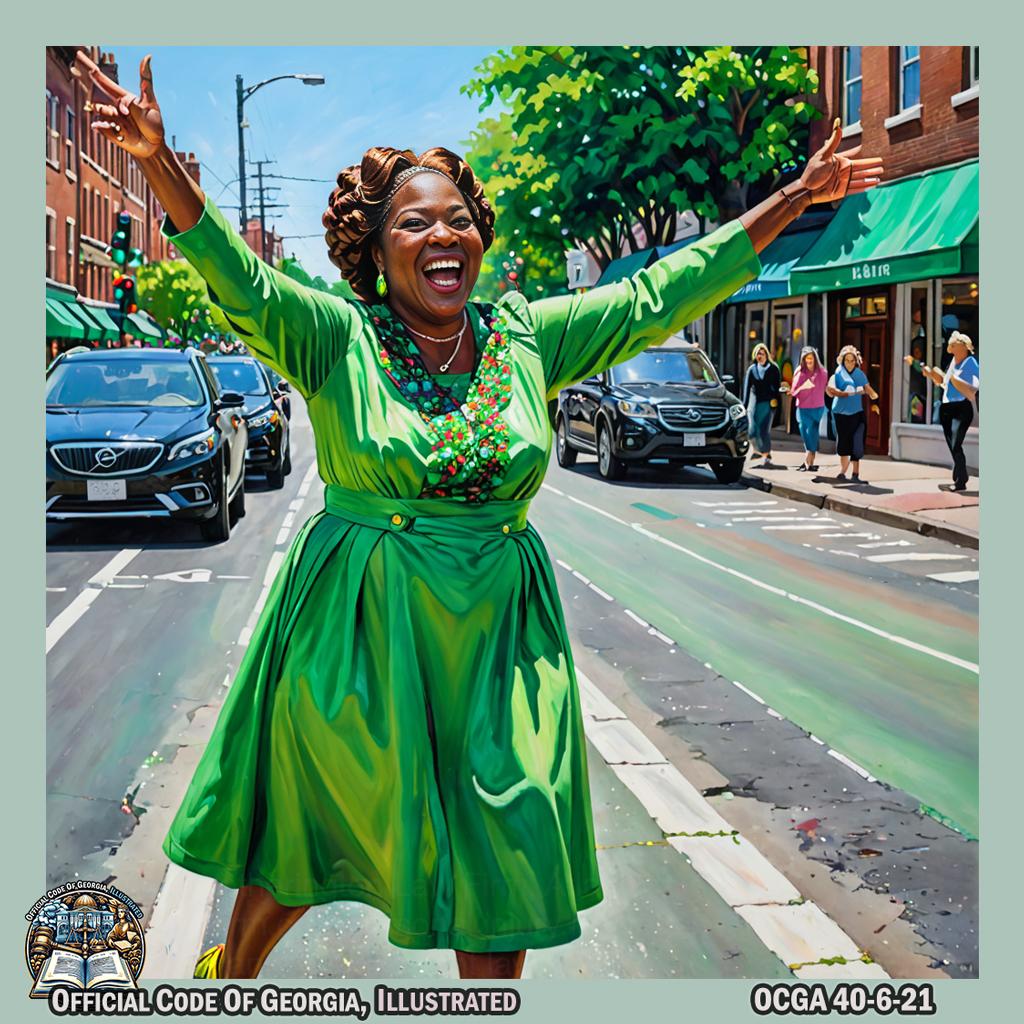
Mammy Kate gracefully gestures to the green light, leading a group of pedestrians across the road with a joyful and determined expression, embodying freedom and progress in a vibrant, dynamic art piece.
-
-
Yellow indications shall have the following meanings:

Raven-Symoné gracefully raises her arms and twirls them in the air, symbolizing the color yellow and its meaning as a signal. -@ravensymone -
Traffic, except pedestrians, facing a steady CIRCULAR YELLOW or YELLOW ARROW signal is thereby warned that the related green movement is being terminated or that a red indication will be exhibited immediately thereafter when vehicular traffic shall not enter the intersection;

Governor Kemp standing on one leg, with arms outstretched and spinning in circles with a dramatic expression, surrounded by colorful geometric shapes and patterns reminiscent of Chuck Close's artwork. -@GovKemp -
Pedestrians facing a steady CIRCULAR YELLOW or YELLOW ARROW signal, unless otherwise directed by a pedestrian signal, are thereby advised that there is insufficient time to cross the roadway before a red indication is shown, and no pedestrian shall then start to cross the roadway; and
- Traffic, except pedestrians, facing a flashing YELLOW ARROW signal may proceed in the direction of the arrow. Vehicular traffic turning shall yield the right of way to approaching vehicles. Vehicular traffic shall stop and remain stopped to allow a pedestrian to cross the roadway within a crosswalk when the pedestrian is lawfully within the intersection or an adjacent crosswalk at the time such signal is exhibited, when the pedestrian is upon the half of the roadway upon which the vehicle is traveling, or when the pedestrian is approaching and is within one lane of the half of the roadway on which the vehicle is traveling or onto which it is turning. For the purposes of this subparagraph, “half of the roadway” means all traffic lanes carrying traffic in one direction of travel; and
- Red indications shall have the following meanings:
- Traffic, except pedestrians, facing a steady CIRCULAR RED signal alone shall stop at a clearly marked stop line or, if there is no stop line, before entering the crosswalk on the near side of the intersection or, if there is no crosswalk, before entering the intersection, and shall remain standing until an indication to proceed is shown, except as provided in subparagraphs (B), (C), and (D) of this paragraph;
- Vehicular traffic facing a steady CIRCULAR RED signal may cautiously enter the intersection to make a right turn after stopping as provided in subparagraph (A) of this paragraph. Such vehicular traffic shall stop and remain stopped to allow a pedestrian to cross the roadway within a crosswalk when the pedestrian is upon the half of the roadway upon which the vehicle is traveling, or when the pedestrian is approaching and is within one lane of the half of the roadway on which the vehicle is traveling or onto which it is turning. For the purposes of this subparagraph, “half of the roadway” means all traffic lanes carrying traffic in one direction of travel. Vehicular traffic shall yield the right of way to other traffic lawfully using the intersection;
- Traffic, except pedestrians, facing a steady CIRCULAR RED signal, after stopping as provided in subparagraph (A) of this paragraph, may make a right turn but shall stop and remain stopped for pedestrians and yield the right of way to other traffic proceeding as directed by the signal at such intersection. Such vehicular traffic shall not make a right turn against a steady CIRCULAR RED signal at any intersection where a sign is erected prohibiting such right turn;
- Traffic, except pedestrians, facing a steady CIRCULAR RED signal, after stopping as provided in subparagraph (A) of this paragraph, may make a left turn from the left-hand lane of a one-way street onto a one-way street on which the traffic moves toward the driver’s left but shall stop and remain stopped for pedestrians and yield the right of way to other traffic proceeding as directed by the signal at such intersection. Such vehicular traffic shall not make a left turn against a steady CIRCULAR RED signal at any intersection where a sign is erected prohibiting such left turn;
- Unless otherwise directed by a pedestrian signal, pedestrians facing a steady CIRCULAR RED signal alone shall not enter the roadway;
- Traffic, except pedestrians, facing a steady RED ARROW signal may not enter the intersection to make the movement indicated by such arrow and, unless entering the intersection to make such other movement as is permitted by other indications shown at the same time, shall stop at a clearly marked stop line or, if there is no stop line, before entering the crosswalk on the near side of the intersection or, if there is no crosswalk, before entering the intersection, and shall remain standing until an indication to make the movement indicated by such arrow is shown;
- Unless otherwise directed by a pedestrian signal, pedestrians facing a steady RED ARROW signal shall not enter the roadway; and
- Traffic, except pedestrians, facing a flashing RED ARROW signal, after stopping as provided in subparagraph (A) of this paragraph, may make a right turn but shall stop and remain stopped for pedestrians and yield the right of way to other traffic proceeding as directed by the signal at such intersection.
-
-
-
In the event an official traffic-control device signal is erected and maintained at a place other than an intersection, the provisions of this Code section shall be applicable except as to those provisions which by their nature can have no application. Any stop required shall be made at a sign or marking on the pavement indicating where the stop shall be made, but, in the absence of any such sign or marking, the stop shall be made at the signal.
40-6-22.Pedestrian-control signals.¶
Whenever special pedestrian-control signals exhibiting the words WALK or DON’T WALK or symbols so directing a pedestrian are in place, such signals shall indicate as follows:

-
Word or symbol message WALK. Pedestrians facing such signal may proceed across the roadway in the direction of the signal. Every driver of a vehicle shall stop and remain stopped for such pedestrians; and
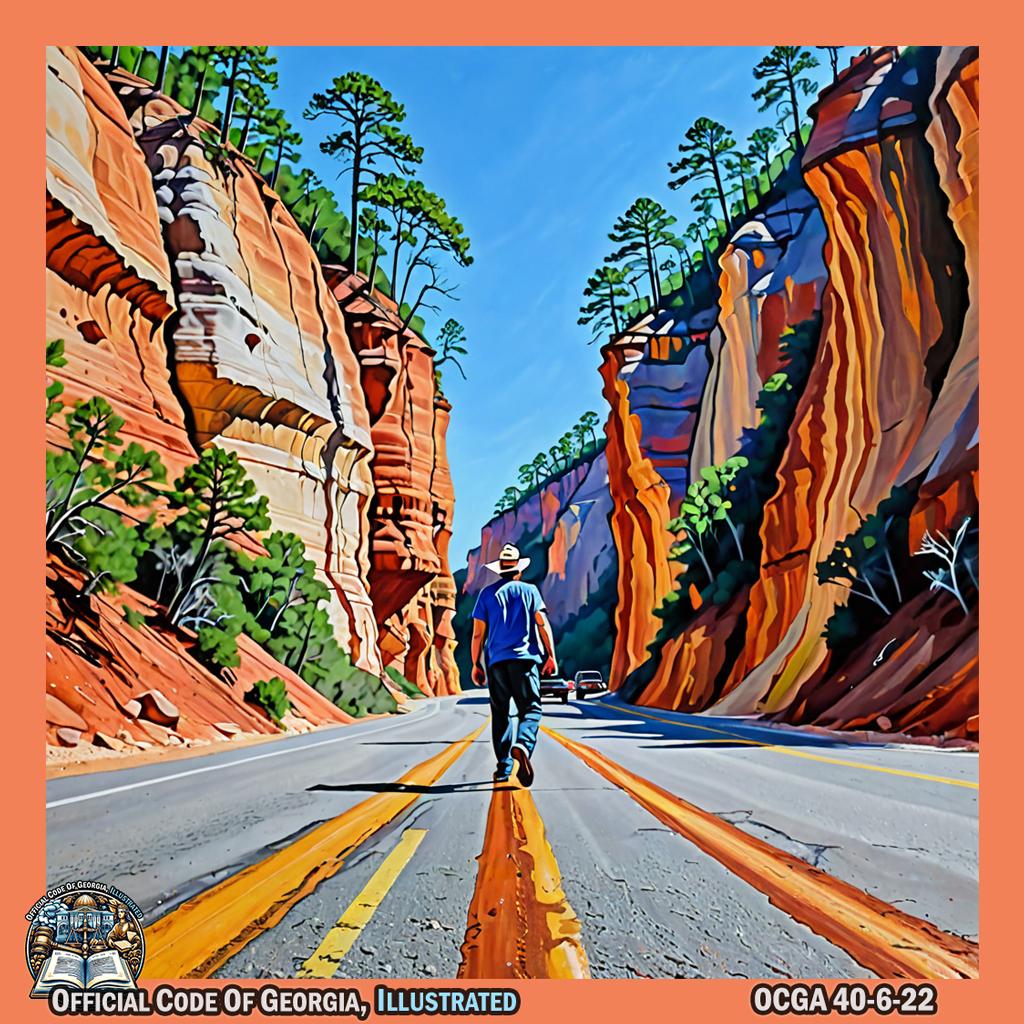
Corey Smith gracefully walks across the roadway in the direction of the signal, while drivers of vehicles stop and remain stopped for him, all depicted in a vibrant and dynamic art piece at Providence Canyon State Outdoor Recreation Area in Lumpkin, Georgia. -
Flashing or steady DON’T WALK. No pedestrian shall start to cross the roadway in the direction of such signal, but any pedestrian who has partially completed his crossing on the WALK signal shall proceed to sidewalk or safety island while the DON’T WALK signal is showing.
40-6-23.Flashing circular red or yellow signals.¶
Flashing signal indications shall have the following meanings:
- Flashing circular red (stop signal) — When a red lens is illuminated with rapid intermittent flashes, drivers of vehicles shall stop at a clearly marked stop line or, if there is no stop line, before entering the crosswalk on the near side of the intersection or, if there is no crosswalk, at the point nearest the intersecting roadway where the driver has a view of approaching traffic on the intersecting roadway before entering the intersection, and the right to proceed shall be subject to the rules applicable after making a stop at a stop sign;
- Flashing circular yellow (caution signal) — When a yellow lens is illuminated with rapid intermittent flashes, drivers of vehicles may proceed through the intersection or past such signal only with caution.
40-6-24.Lane direction control signals.¶
When lane direction control signals are placed over the individual lanes of a street or road, vehicular traffic may travel in any lane over which a green signal is shown but shall not enter or travel in any lane over which a red signal is shown, provided that a vehicle may enter a lane over which a yellow or amber signal is shown for purposes of making a left turn only.

40-6-25.Display of unauthorized signs, signals, or markings.¶
- No person shall place, maintain, or display upon or in view of any highway any sign, signal, marking, or device which purports to be or is an imitation of or resembles an official traffic-control device or railroad sign or signal or which attempts to direct the movement of traffic or which hides from view or interferes with the effectiveness of an official traffic-control device or any railroad sign or signal.
-
No person shall maintain or place nor shall any public authority permit upon any highway any traffic sign or signal bearing thereon any commercial advertising.

Luke Appling playfully swats away a towering traffic sign with an outstretched bat, while surrounded by lush greenery and the vibrant colors of autumn in Forest Park, as captured by Gustave Courbet's masterful brushstrokes. -
This Code section shall not be deemed to prohibit the erection upon private property adjacent to highways of signs giving useful directional information and of a type that cannot be mistaken for official signs.
- Every such prohibited sign, signal, or marking is declared to be a public nuisance, and the authority having jurisdiction over the highway is empowered to remove it or cause it to be removed without notice.
40-6-26.Interference with official traffic-control devices or certain signs; travel on closed highway prohibited.¶
-
No person shall, without lawful authority, attempt to or in fact alter, deface, injure, knock down, or remove any official traffic-control device or any railroad sign or signal or any inscription, shield, or insignia thereon or any other part thereof.

Emily Sonnett gracefully twirls and gestures, mimicking the act of altering, defacing, injuring, knocking down, and removing traffic control devices or railroad signs with dramatic flair against a backdrop of vibrant colors and textures, reminiscent of Robert Rauschenberg's style. -@emilysonnett -
No person shall, without lawful authority, drive around or through or ignore any official traffic-control device so as to go onto an officially closed highway or road or onto a section of highway or road before it has been officially opened to the public. This Code section shall not apply to police officers in the performance of their duties, to individuals domiciled or making their livelihood within the affected area, or to any person authorized to be in the affected area by the appropriate municipal, county, or state officer.

Jeri Ellsworth, dressed in vibrant colors and with exaggerated movements, dances around a traffic control device at The Pirates House in Savannah, Georgia, creating an art piece reminiscent of Andy Warhol's style. -@jeriellsworth
40-6-27.Installation of blue retroreflective raised pavement markers.¶
It shall be unlawful for any person to place or install any blue retroreflective raised pavement marker on any public highway, road, or street, provided that such marker may be placed or installed by the state or any county, municipality, fire department, or employee or agent thereof solely for the purpose of marking the location of fire hydrants.
40-6-28.Restricted access/managed lanes.¶
- The Department of Transportation may install gates, signs, or barriers, or any combination thereof, to restrict access to managed lanes.
- No person shall drive any vehicle through, around, or under any barrier or closed or moving gate of a managed lane.
- No vehicle shall enter or exit a managed lane at any point other than designated entry or exit points unless directed by authorized emergency personnel.
Article 3 Driving on Right Side of Roadway, Overtaking and Passing, Following too Closely {#t40c06a03}

- 40-6-40. Vehicles to drive on right side of roadway; exceptions; impeding traffic.
- 40-6-41. Passing vehicles proceeding in opposite directions.
- 40-6-42. Overtaking and passing generally.
-
40-6-43. When overtaking and passing on the right permitted.
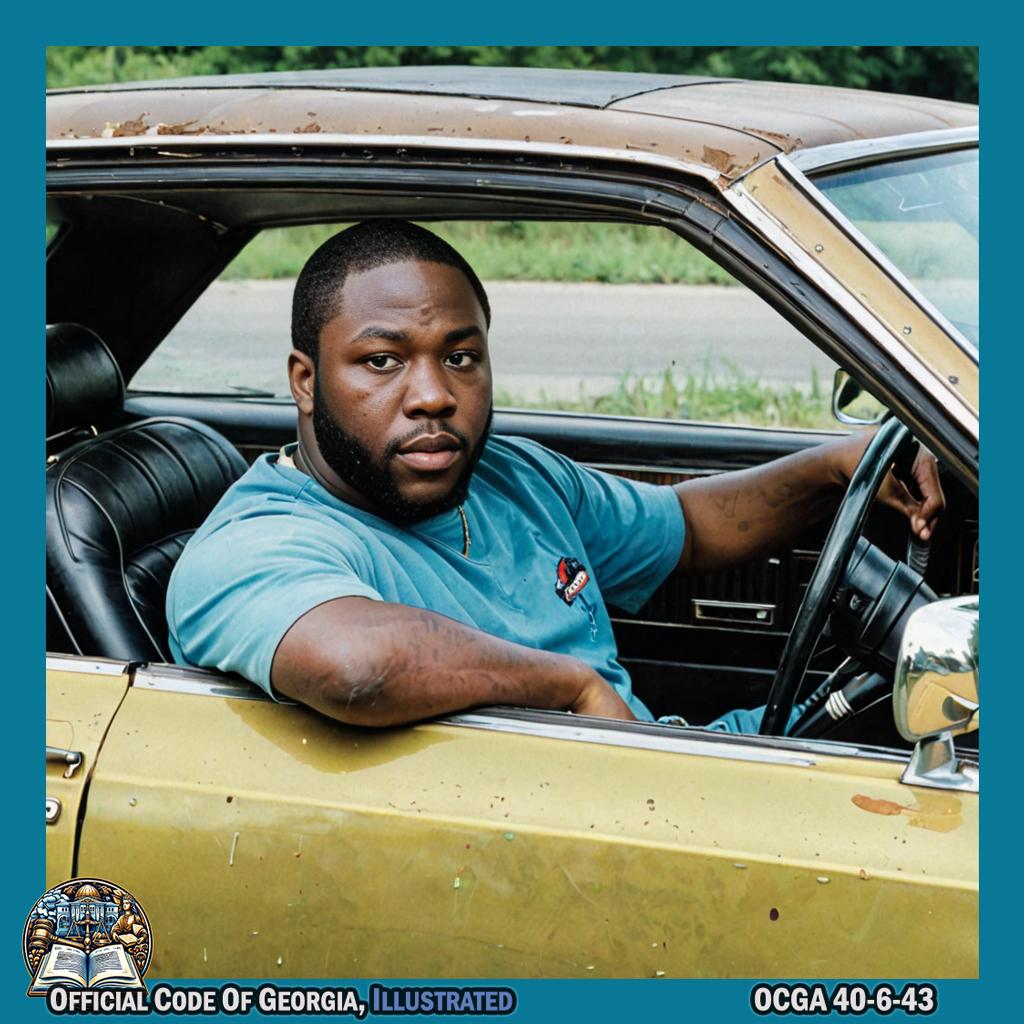
In a scene reminiscent of an art piece from Born 1970–1979, Killer Mike sits in a car pretending to drive and passes on the right. -
40-6-45. Further limitations on driving on left of center of roadway.

Blind Willie McTell strumming his guitar amidst the rich scene of Plant Riverside in Savannah, Georgia. -
40-6-47. One-way roadways and rotary traffic islands.
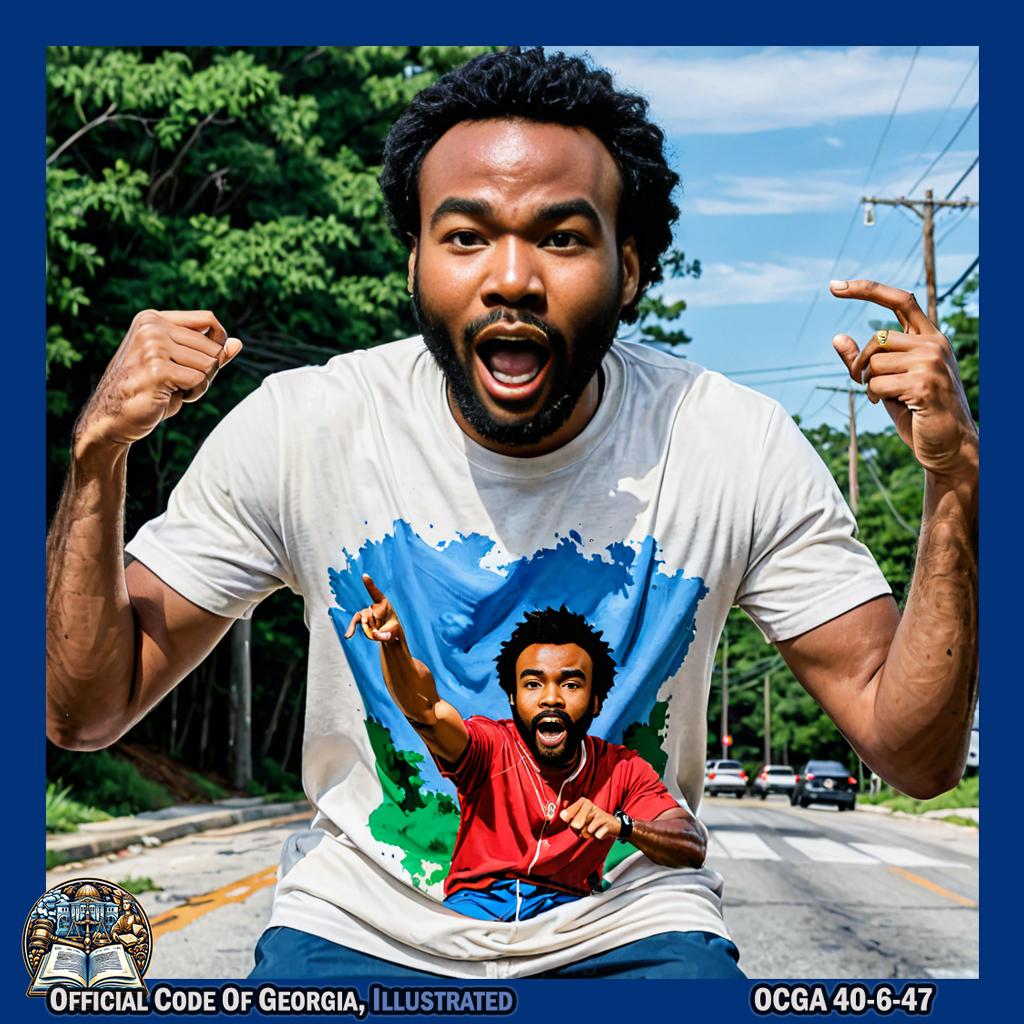
Actor and rapper, Donald Glover, born in California, performs the action in a rich scene in the Georgia location, Niskey Cove neighborhood in Atlanta: using his arms to indicate one-way roadways and making circular motions with his body to represent rotary traffic islands. -@donaldglover -
40-6-49. Following too closely.
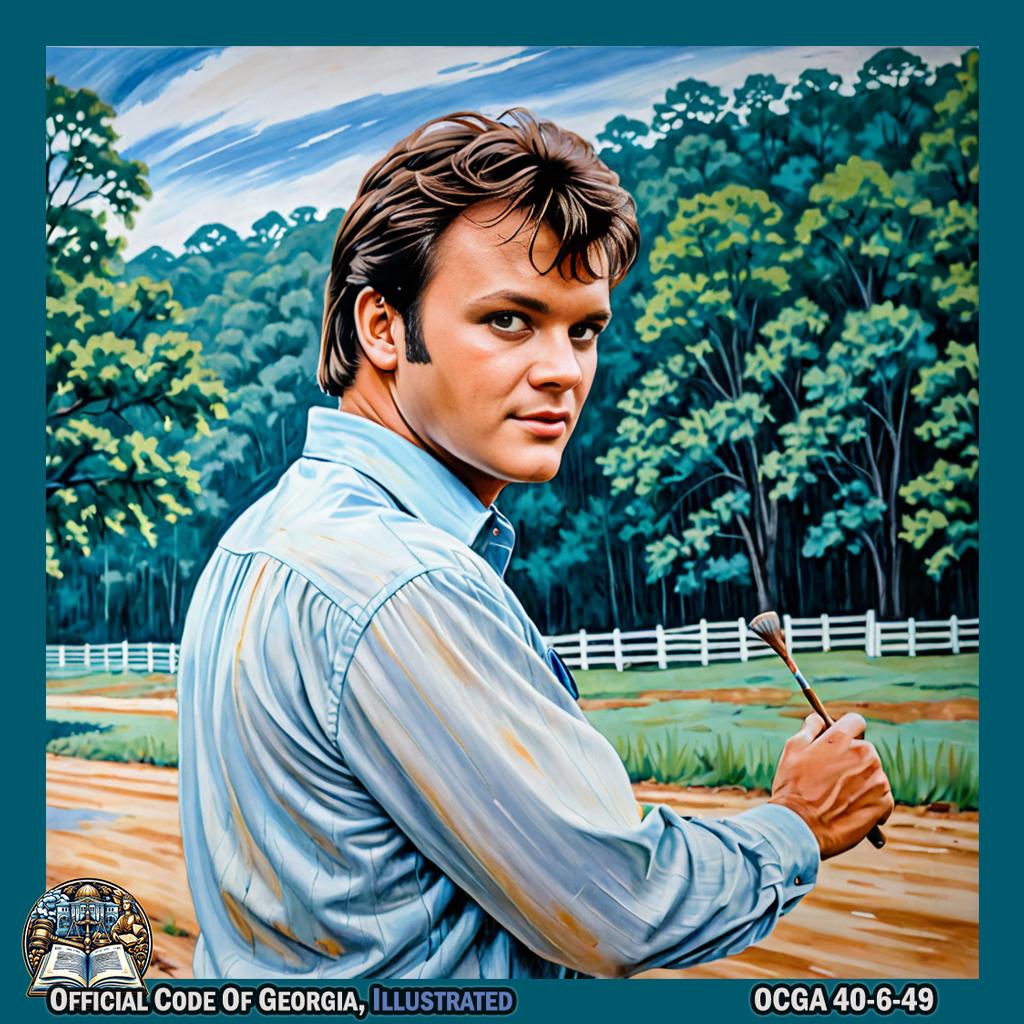
Tommy Roe stood very close behind someone, almost touching their back, in a rich scene in Riverdale, Georgia. -@TommyRoeMusic -
40-6-50. Driving on divided highway, controlled-access roadways, and emergency lanes.
- 40-6-51. Restrictions on type of vehicle that may travel on certain major interstates and highways inside the Interstate 285 perimeter.
-
40-6-52. Prohibited lane usage by trucks using multilane highways.
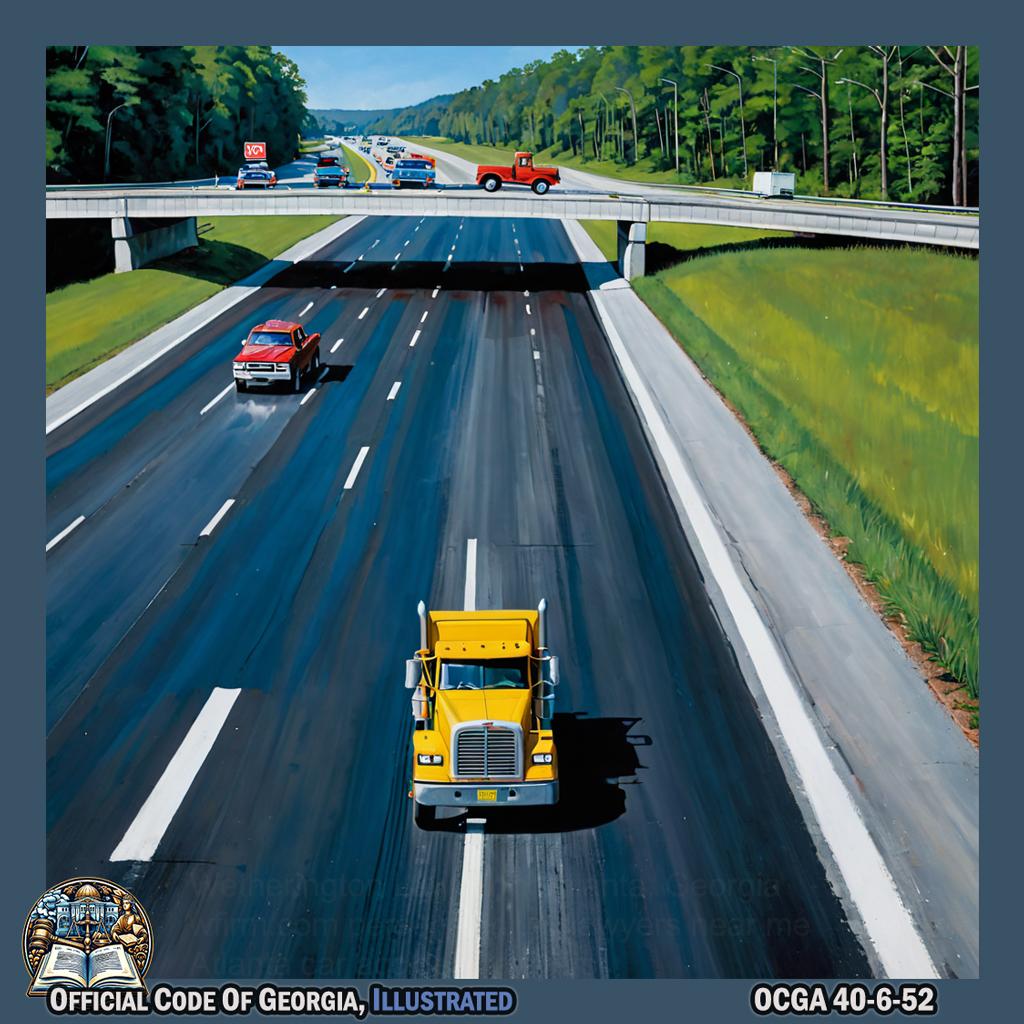
Baseball player Matt Olson is seen pretending to drive a toy truck on a multilane highway in the rich scene of Stockbridge, Georgia, before having a big "X" drawn over the truck. -@mattolson21 -
40-6-54. Designation of travel lanes for exclusive use of certain vehicles; penalty; presumption; establishment of high occupancy toll (HOT)lanes.
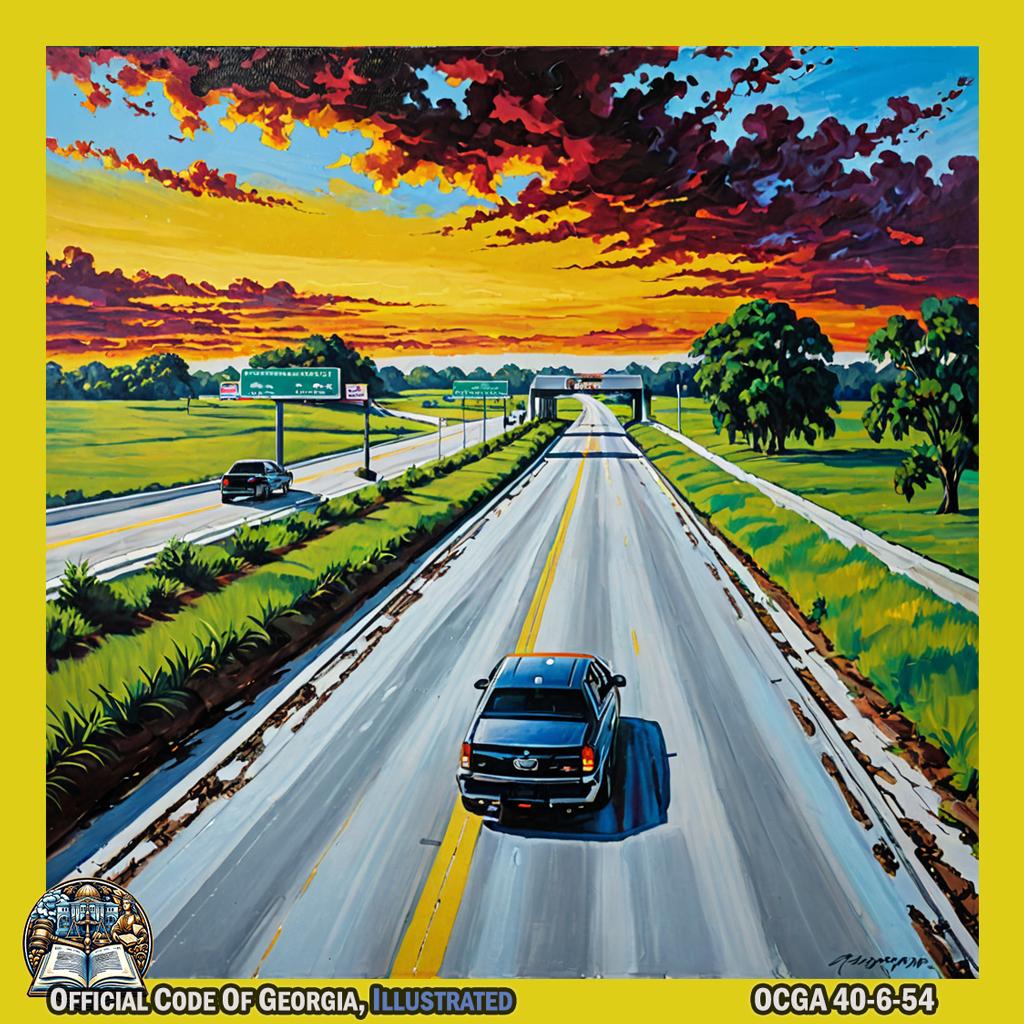
Lil Scrappy laid down a custom road in the opulent setting of Loanville, Georgia, with exclusive lanes for specific vehicles and a swanky toll booth marking the entrance to the high occupancy toll (HOT) lane. -@reallilscrappy -
40-6-55. Obligation of drivers to yield to bicyclist in a bicycle lane.
- 40-6-56. Procedure for passing a bicyclist.
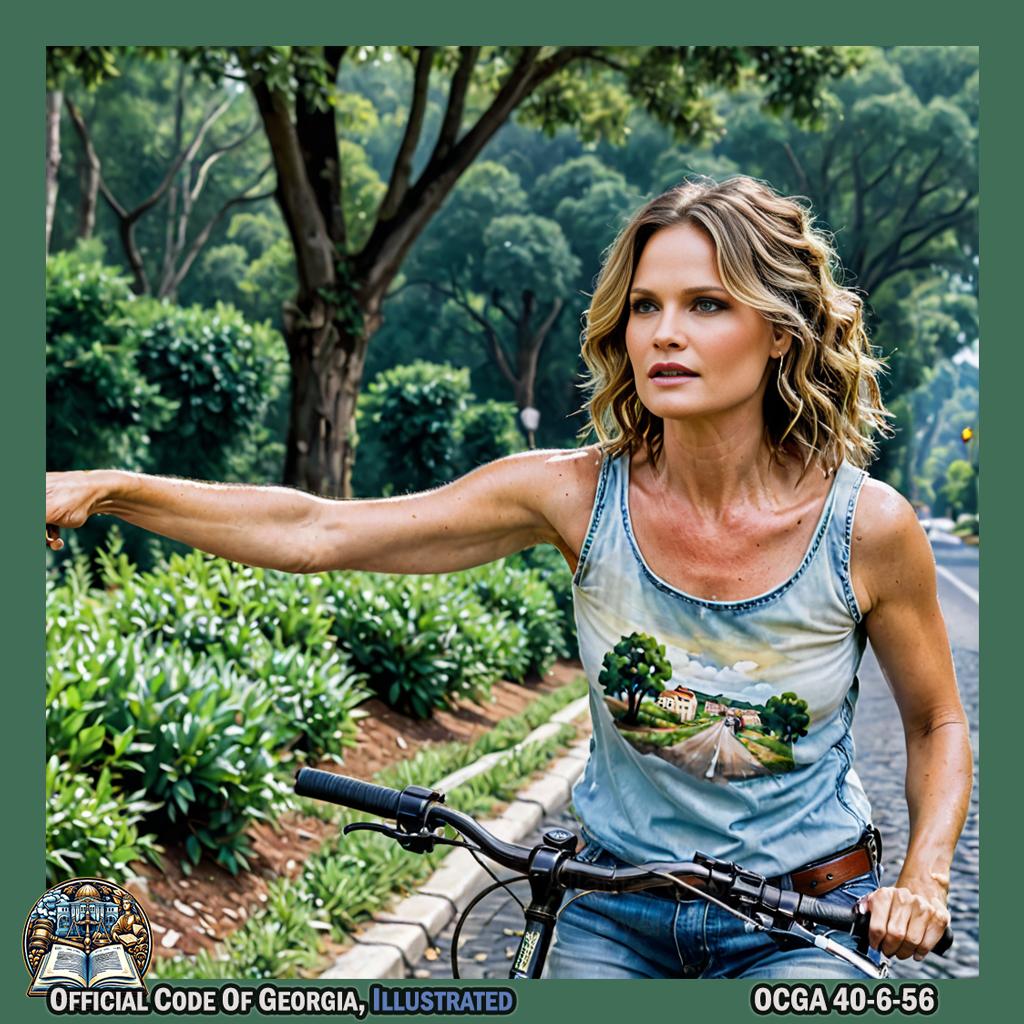
Jennifer Nettles extends her arm and points to the left, then gracefully passes the bicyclist on their right side in a picturesque scene in Rome, Georgia. -@JenniferNettles
40-6-40.Vehicles to drive on right side of roadway; exceptions; impeding traffic.¶
-
Upon all roadways of sufficient width, a vehicle shall be driven upon the right half of the roadway, except as follows:
- When overtaking and passing another vehicle proceeding in the same direction under the rules governing such movement;
- When an obstruction exists making it necessary to drive to the left of the center of the highway, provided that any person so doing shall yield the right of way to all vehicles traveling in the proper direction upon the unobstructed portion of the highway within such a distance as to constitute an immediate hazard;
- Upon a roadway divided into three marked lanes for traffic under the rules applicable thereon; or
- Upon a roadway restricted to one-way traffic.
-
Upon all roadways, any vehicle proceeding at less than the normal speed of traffic at the time and place and under the conditions then existing shall be driven in the right-hand lane then available for traffic, or as close as practicable to the right-hand curb or edge of the roadway, except when overtaking and passing another vehicle proceeding in the same direction or when preparing for a left turn at an intersection or into a private road or driveway.
- Upon any roadway having four or more lanes for moving traffic and providing for two-way movement of traffic, no vehicle shall be driven to the left of the center of the roadway except when authorized by official traffic-control devices designating certain lanes to the left of the center of the roadway for use by traffic not otherwise permitted to use such lanes or except as permitted under paragraph (2) of subsection (a) of this Code section. However, this subsection shall not be construed as prohibiting the crossing of the center of the roadway in making a left turn into or from an alley, private road, or driveway.
- No two vehicles shall impede the normal flow of traffic by traveling side by side at the same time while in adjacent lanes, provided that this Code section shall not be construed to prevent vehicles traveling side by side in adjacent lanes because of congested traffic conditions.

Cam Newton, wearing vibrant and colorful attire, spins in a dynamic dance while seamlessly maneuvering two remote-controlled toy vehicles to avoid each other on adjacent lanes, all within a whimsical and lively art installation by Takashi Murakami set against the picturesque backdrop of Griffin. -@CameronNewton
40-6-41.Passing vehicles proceeding in opposite directions.¶
Drivers of vehicles proceeding in opposite directions shall pass each other to the right, and, upon roadways having width for not more than one
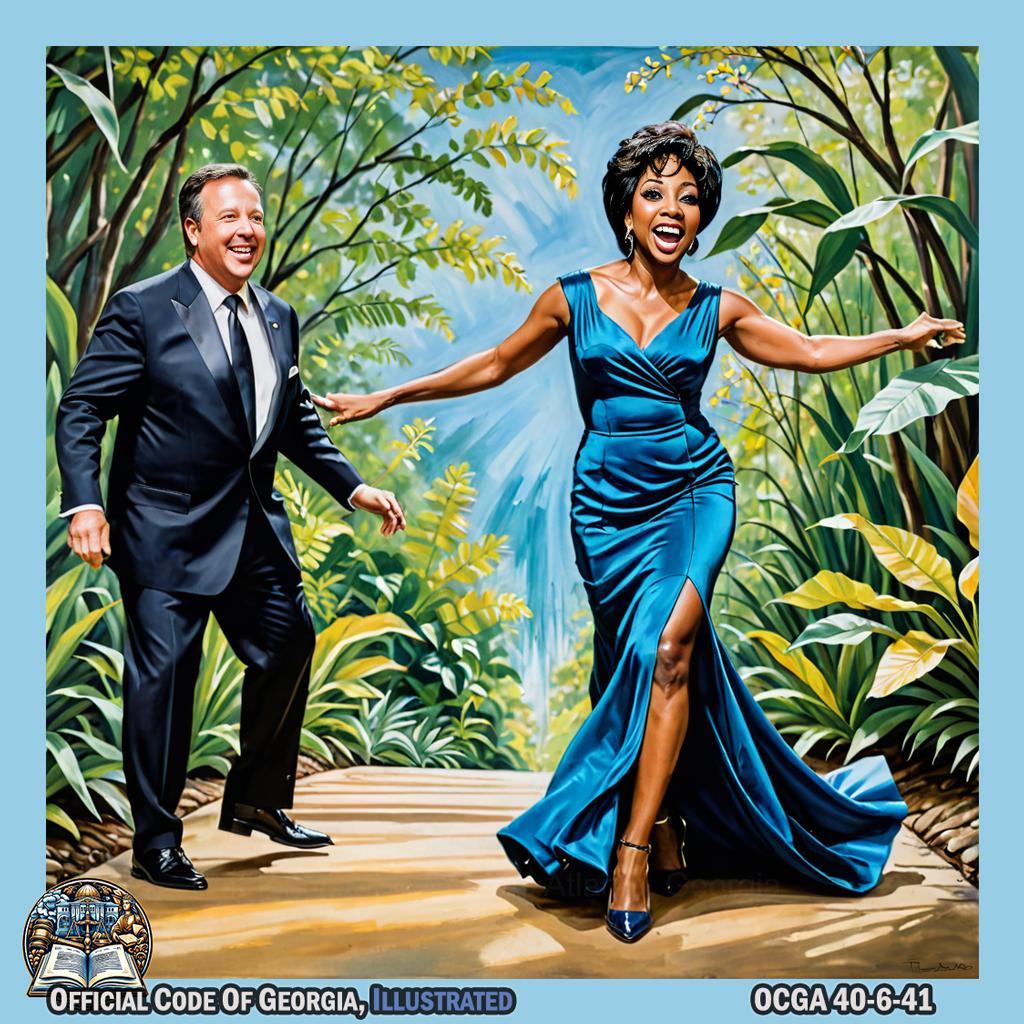
lane of traffic in each direction, each driver shall give to the other at least one-half of the main traveled portion of the roadway or as nearly one-half as possible.
40-6-42.Overtaking and passing generally.¶
The following rules shall govern the overtaking and passing of vehicles proceeding in the same direction, subject to those limitations, exceptions, and special rules stated in this article:
-
The driver of a vehicle overtaking another vehicle proceeding in the same direction shall pass to the left thereof at a safe distance and shall not again drive to the right side of the roadway until safely clear of the overtaken vehicle; and

Quavo, dressed in vibrant colors and a flowing skirt, gracefully dances around two cars in the Atlanta streets, moving to the left side of each vehicle at a safe distance before swirling back to the right. The scene is captured with bold strokes and vivid hues reminiscent of Frida Kahlo's style. -@QuavoStuntin -
Except when overtaking and passing on the right is permitted, the driver of an overtaken vehicle shall give way to the right in favor of the overtaking vehicle and shall not increase the speed of his vehicle until completely passed by the overtaking vehicle.

Jason Aldean, in the style of Jean-Michel Basquiat, dramatically yielding to an overtaking vehicle while performing a dynamic guitar solo amidst a vibrant and expressive street art backdrop in Fayetteville. -@Jason_Aldean
40-6-43.When overtaking and passing on the right permitted.¶
-
The driver of a vehicle may overtake and pass upon the right of another vehicle only under the following conditions:

Matthias Ward, in the style of a Fred Williams landscape, theatrically steps to his right around an old-fashioned car on the 1895 Exposition Steps while holding an invisible steering wheel high, as if overtaking another vehicle; his exaggerated tiptoe stance and focused gaze provide a clear educational mime of safe passing, set against the vibrant backdrop of Atlanta's historical exposition remnants. - When the vehicle overtaken is making or about to make a left turn; or
- Upon a street or highway with unobstructed pavement of sufficient width for two or more lanes of moving vehicles in the direction being traveled by the overtaking vehicle.
-
If otherwise authorized, the driver of a vehicle may overtake and pass another vehicle upon the right only under conditions permitting such movement in safety. Such movement shall not be made by driving off the roadway.

Monroe Owsley, in the style of Claude Monet, gracefully and elegantly weaves his way through a beautiful garden at Thomasville Center for the Arts, overtaking and passing another actor in a vehicle upon the right with fluid movements that embody safety and artistry.
40-6-44.Limitations on overtaking and passing on the left.¶
No vehicle shall be driven to the left side of the center of the roadway in overtaking and passing another vehicle proceeding in the same direction unless such left side is clearly visible and is free of oncoming traffic for a sufficient distance ahead to permit such overtaking and passing to be completely made without interfering with the operation of any vehicle approaching from the opposite direction or any vehicle overtaken. In every event, the overtaking vehicle shall return to an authorized lane of travel as soon as practicable and, in the event the passing movement involves the use of a lane authorized for vehicles approaching from the opposite direction, before coming within 200 feet of any approaching vehicle.
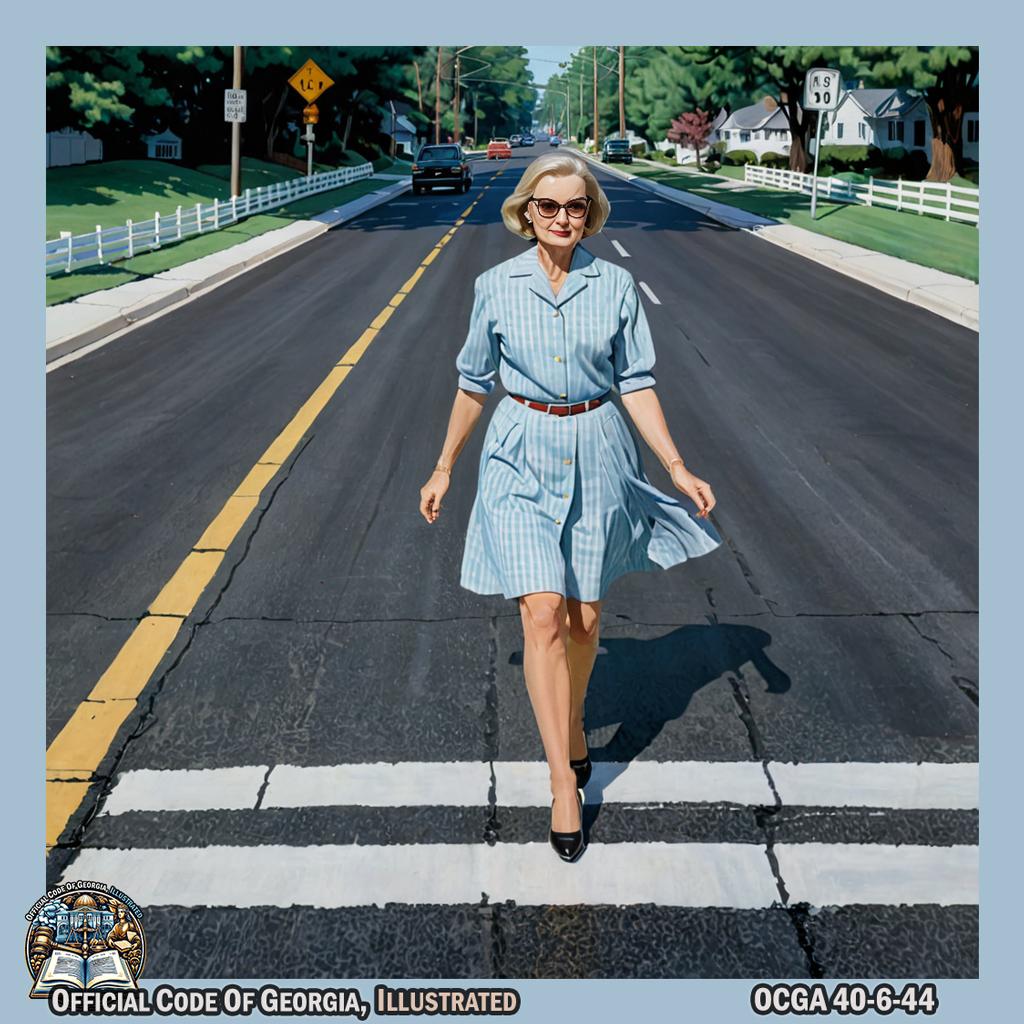
40-6-45.Further limitations on driving on left of center of roadway.¶
-
No vehicle shall be driven on the left side of a roadway designed and authorized for traffic traveling in opposite directions under the following conditions:
-
When approaching or upon the crest of a grade or a curve in the highway where the driver’s view is obstructed within such distance as to create a hazard in the event another vehicle might approach from the opposite direction;
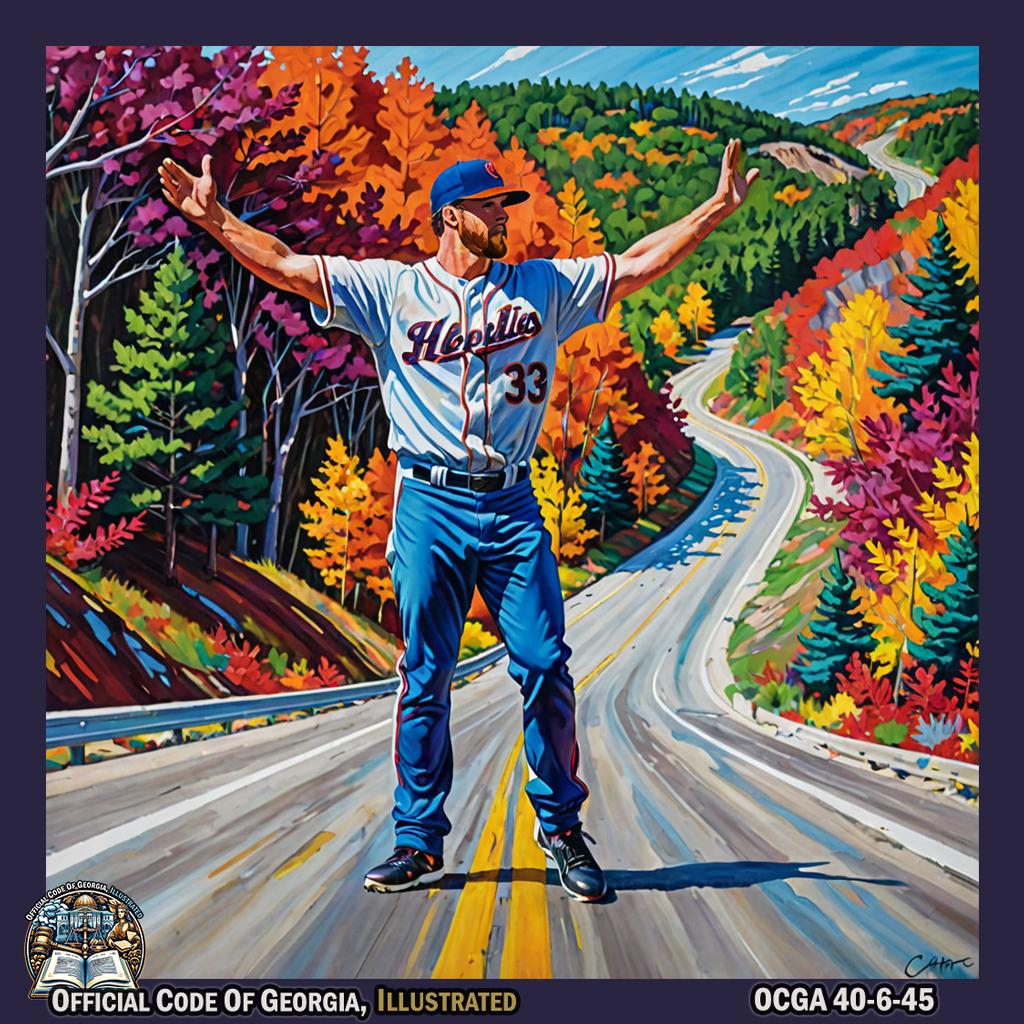
A baseball player, Matt Capps, gesturing with outstretched arms as if approaching a crest or curve in the highway, while surrounded by vibrant colored foliage and twisting roads in a vivid artistic portrayal. -@MattCapps55 -
When traversing any:

William Few, in colonial attire, strides across a vibrant Georgia peach orchard balancing a large basket of peaches atop his head, while children in period clothing follow him, learning to carry their own baskets with poise and balance. -
Intersection which is clearly marked by a solid barrier line placed on the right-hand element of a combination stripe along the center or lane line or by a solid double yellow line; or

Pat Swilling gracefully dances along a curved path, weaving around large fabric barriers in vibrant hues of yellow and white, evoking the spirit of Christo and Jeanne Claude's iconic art installations. -
Railroad grade crossing; or
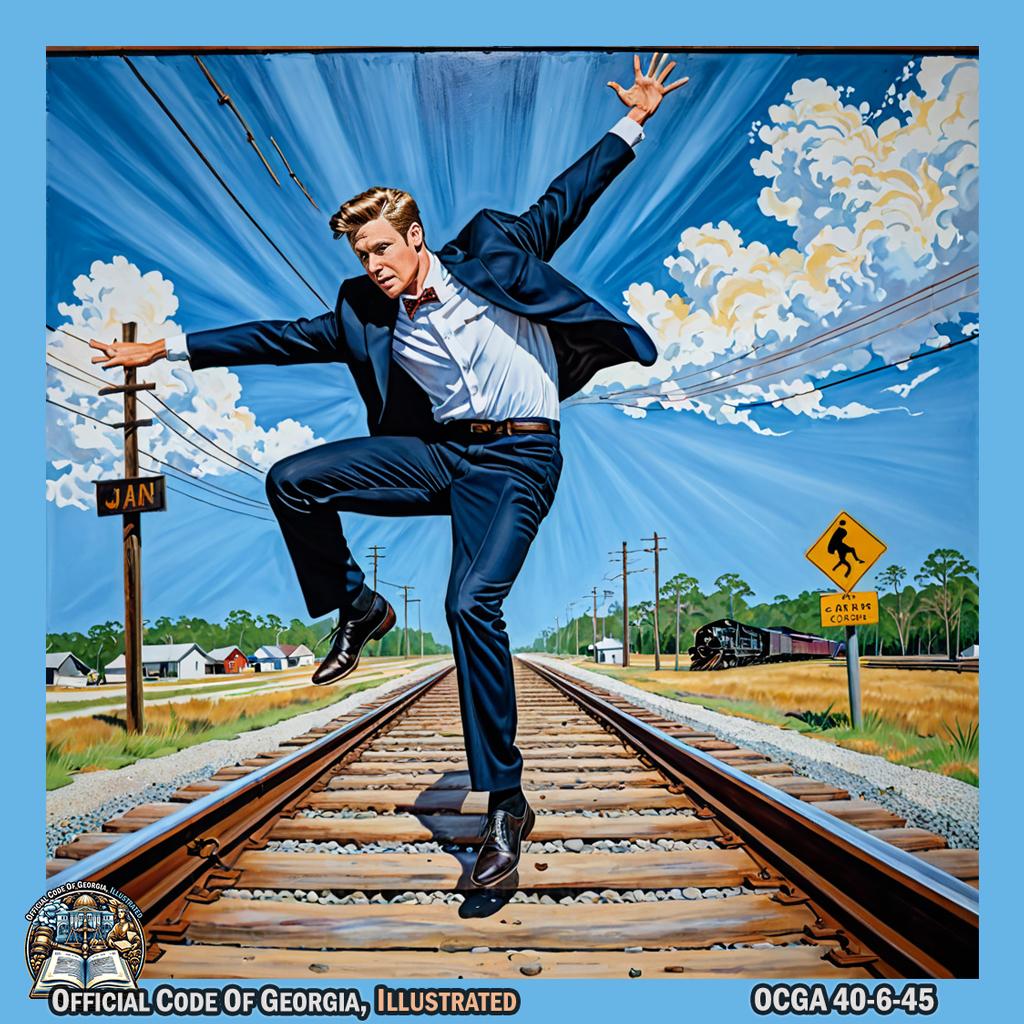
Grant Haley gracefully leaps over a railroad grade crossing in slow motion, his body contorted into an elegant arc as if he were a fluid line in Jasmine Jan's art piece, set against the backdrop of Douglas, Georgia. -@haleyboy10
-
-
When the view is obstructed upon approaching within 100 feet of any bridge, viaduct, or tunnel.
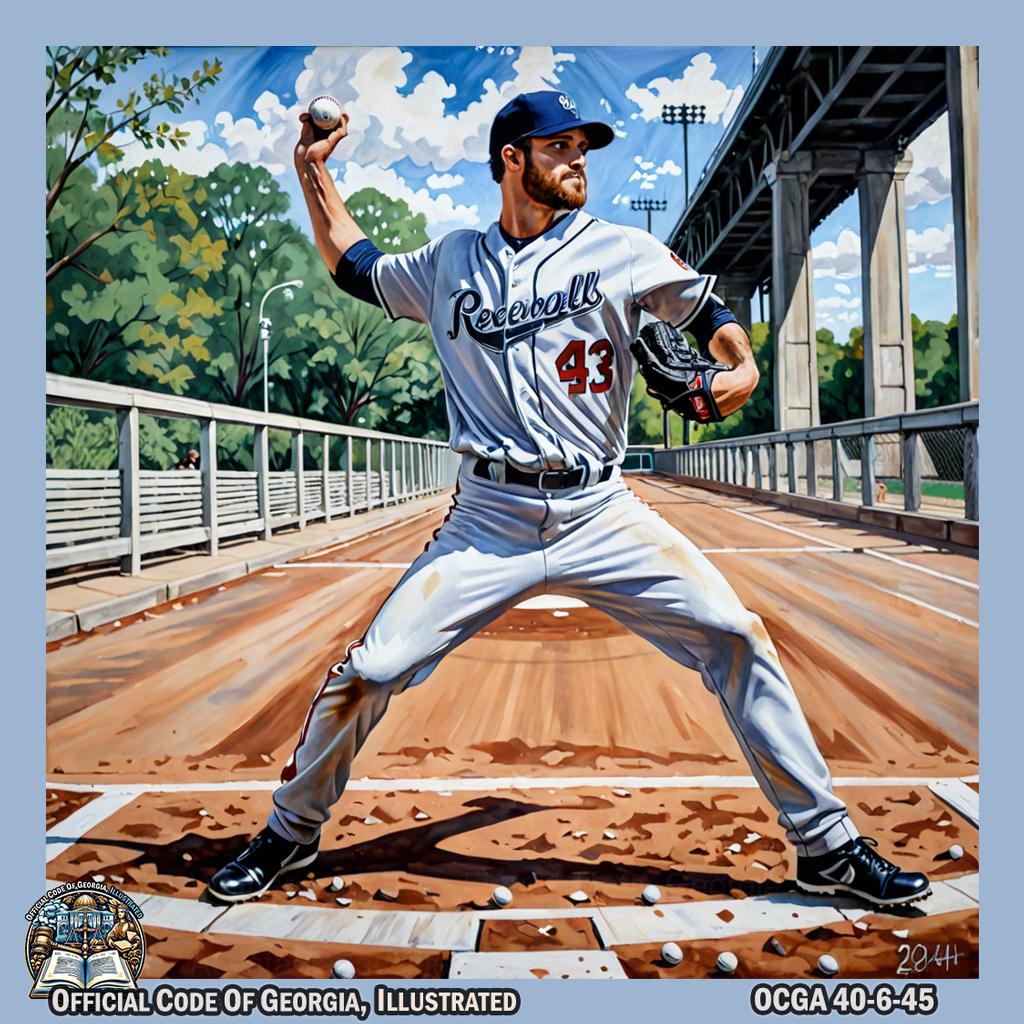
David Hale, dressed in a baseball uniform, mimics the motion of a pitcher winding up to throw a ball while standing within feet of a bridge viaduct in Centennial Olympic Park. -@david_hale15
-
-
The foregoing limitations shall not apply upon a one-way roadway nor under the conditions described in paragraph (2) of subsection (a) of Code Section 40-6-40 nor to the driver of a vehicle turning left into or from an alley, private road, driveway, or roadway.

2 Chainz gracefully stepping onto a mosaic pathway representing a one-way road, gesturing left and right to symbolize the conditions described in the legal text, as he turns into an alley with vibrant mosaic designs depicting Georgia's rich history, all set against the backdrop of Westhaven neighborhood's artistic charm. -@2chainz
40-6-46.No-passing zones.¶
-
The Department of Transportation and local authorities are authorized to determine those portions of any highway under their respective jurisdictions where overtaking and passing or driving to the left side of the roadway would be especially hazardous and may, by appropriate signs or markings on the roadway, indicate the beginning and end of such zones and, when such signs or markings are in place and clearly visible to an ordinarily observant person, every driver of a vehicle shall obey the directions thereof. Such no-passing zones shall be clearly marked by a solid barrier line placed on the right-hand element of a combination stripe along the center or lane line or by a solid double yellow line.

Drive-By Truckers gracefully and skillfully embody the complex traffic laws with fluid, choreographed movements at Georgia Aquarium, evoking a sense of wonder and awe in an art piece reminiscent of Irving Penn's style. -@drivebytruckers -
Where signs or markings are in place to define a no-passing zone as set forth in subsection (a) of this Code section, no driver shall at any time drive on the left side of the roadway within such no-passing zone or on the left side of any pavement striping designed to mark such no-passing zone throughout its length.
- This Code section does not apply under the conditions described in paragraph (2) of subsection (a) of Code Section 40-6-40 nor to the driver of a vehicle turning left into or from an alley, private road, or driveway.
40-6-47.One-way roadways and rotary traffic islands.¶
- The Department of Transportation and local authorities with respect to highways under their respective jurisdictions may designate any highway, roadway, part of a roadway, or specific lanes upon which vehicular traffic shall proceed in one direction at all of such times as shall be indicated by official traffic-control devices.
- Upon a roadway so designated for one-way traffic, a vehicle shall be driven only in the direction designated at all or such times as shall be indicated by official traffic-control devices.
- A vehicle passing around a rotary traffic island shall be driven only to the right of such island.
40-6-48.Driving on roadways laned for traffic.¶
Whenever any roadway has been divided into two or more clearly marked lanes for traffic, the following rules, in addition to all others consistent with this Code section, shall apply:

-
A vehicle shall be driven as nearly as practicable entirely within a single lane and shall not be moved from such lane until the driver has first ascertained that such movement can be made with safety;
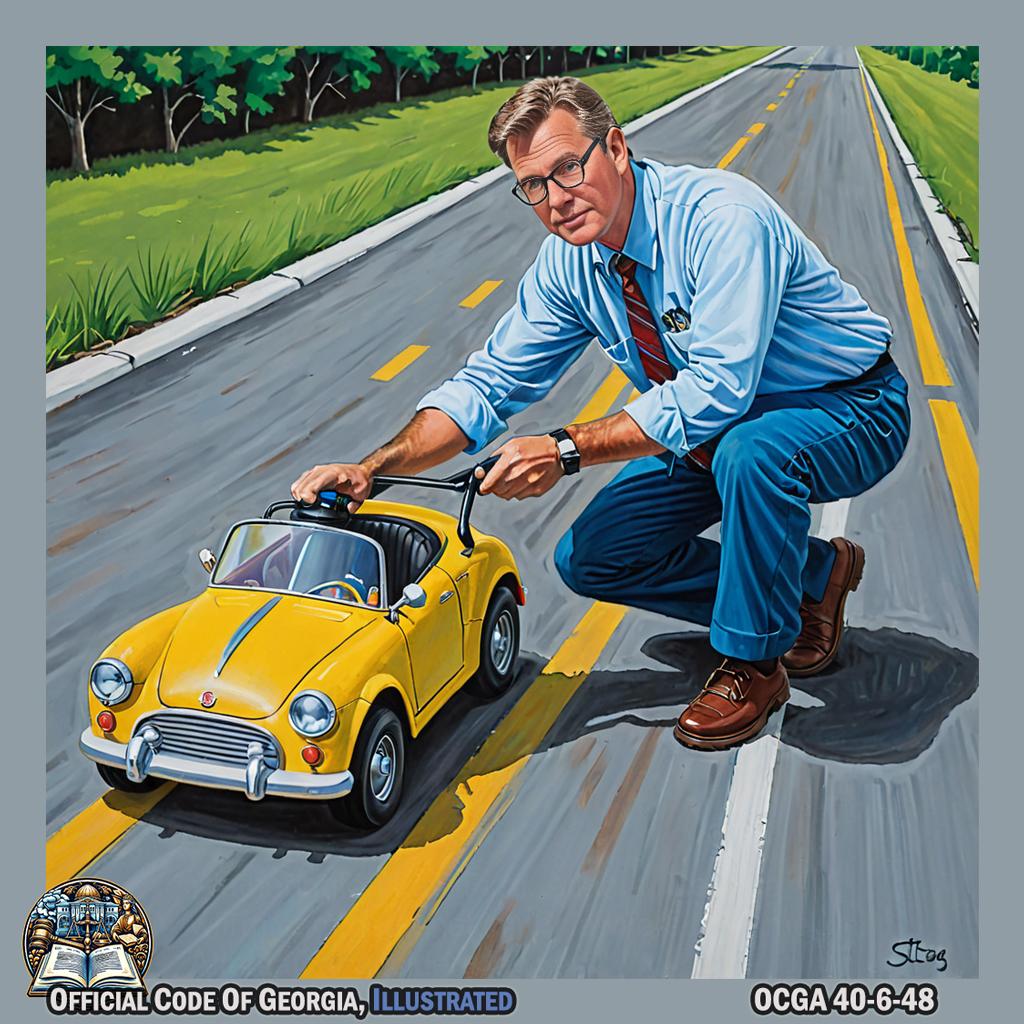
Scientist Kevin Greenaugh, as if in an art piece by Jim Steg, pretends to drive a toy car within the boundaries of a drawn lane, ensuring not to move it until he checks for safety. -
Upon a roadway which is divided into three lanes, and provides for two-way movement of traffic, with two lanes in one direction, a vehicle being driven in a continuous or center lane shall have the right of way when overtaking and passing another vehicle traveling in the same direction;

Teddy McRae gracefully glides down the center lane of a three-lane road, overtaking and passing another vehicle with a flourish reminiscent of an art piece from the Renaissance era, set in the charming surroundings of Peachtree Corners. -
Upon a roadway which is divided into three lanes and provides for two-way movement of traffic, a vehicle shall not be driven in the center lane except when overtaking and passing another vehicle traveling in the same direction when such center lane is clear of traffic within a safe distance, or in preparation for making a left turn, or where such center lane is at the time allocated exclusively to traffic moving in the same direction that the vehicle is proceeding and such allocation is designated by official traffic-control devices or road striping;
-
Official traffic-control devices may be erected directing specified traffic, including but not limited to buses or trucks, to use a designated lane or designating those lanes to be used by traffic moving in a particular direction regardless of the center of the roadway, and drivers of vehicles shall obey the directions of every such device; and

Grant Haley stands in the middle of Downtown Blue Ridge, gesturing dramatically with outstretched arms as he directs buses and trucks to use a designated lane or move in a particular direction. His movements are exaggerated and bold, capturing the essence of Andy Warhol's pop art style. -@haleyboy10 -
Official traffic-control devices may be installed prohibiting the changing of lanes on sections of roadway, and drivers of vehicles shall obey the directions of every such device.

Tea Party Patriots dramatically act out obeying traffic control devices, with exaggerated gestures and expressions, against the backdrop of the abandoned Grumman G-159 plane in Cartersville, Georgia. -@TPPatriots
40-6-49.Following too closely.¶
-
The driver of a motor vehicle shall not follow another vehicle more closely than is reasonable and prudent, having due regard for the speed of such vehicles and the traffic upon and the condition of the highway.
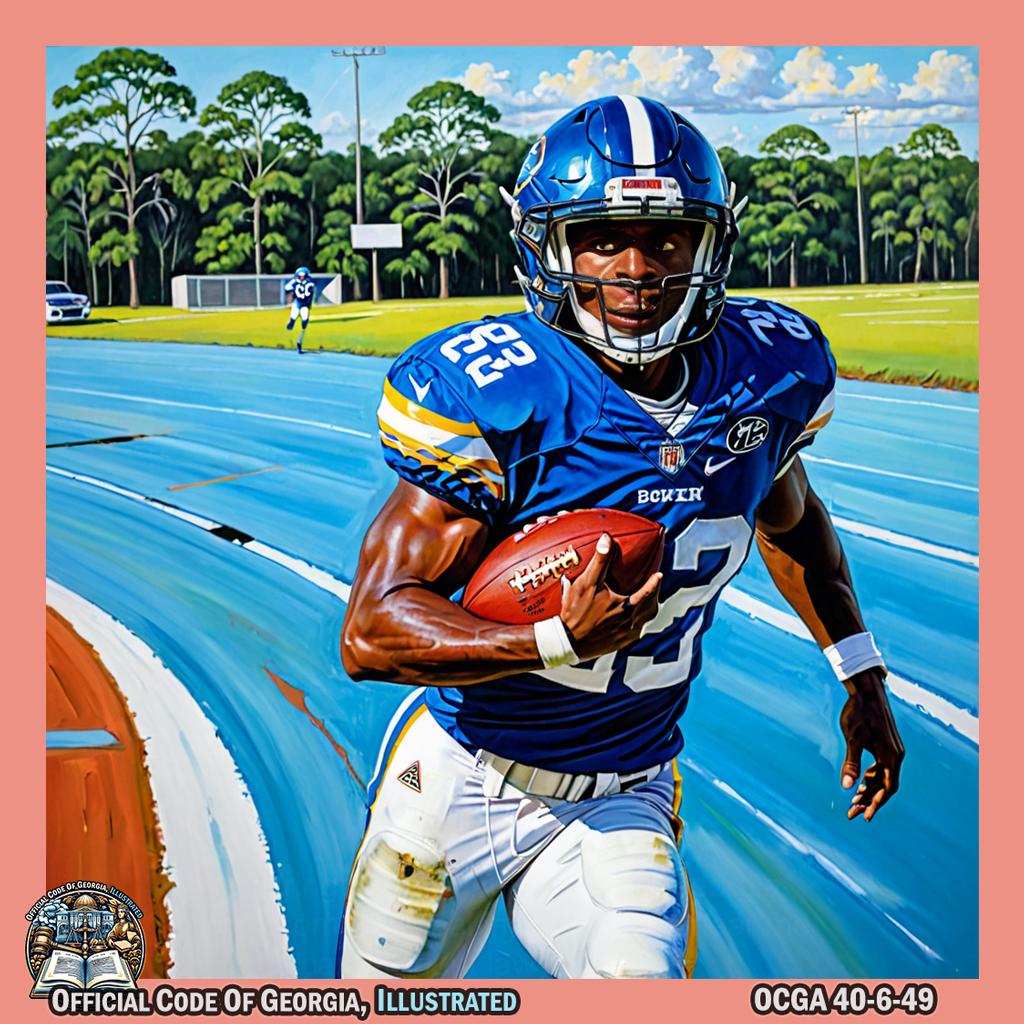
Brandon Boykin, donning a football uniform, mimics driving a car while maintaining a safe distance from another player, embodying the artistry of Enrique Chagoya in Moultrie's vivid landscape. -@BrandonBoykin2 -
The driver of any motor vehicle which is drawing another vehicle when traveling upon a roadway outside of a business or residential district and which is following another motor truck or motor vehicle drawing another vehicle shall, whenever conditions permit, leave sufficient space so that an overtaking vehicle may enter and occupy such space without danger, except that this shall not prevent a motor truck or motor vehicle drawing another vehicle from overtaking and passing any like vehicle or other vehicle.
- Motor vehicles being driven upon any roadway outside of a business or residential district in a caravan or motorcade whether or not towing other vehicles shall be so operated as to allow sufficient space between each such vehicle or combination of vehicles so as to enable any other vehicle to enter and occupy such space without danger. This subsection shall not apply to funeral processions, parades, or other groups of vehicles if such groups of vehicles are under the supervision and control of a law enforcement agency.
-
Vehicles which approach from the rear any other vehicle or vehicles stopped or slowed to make a lawful turn shall be deemed to be following for purposes of this Code section.
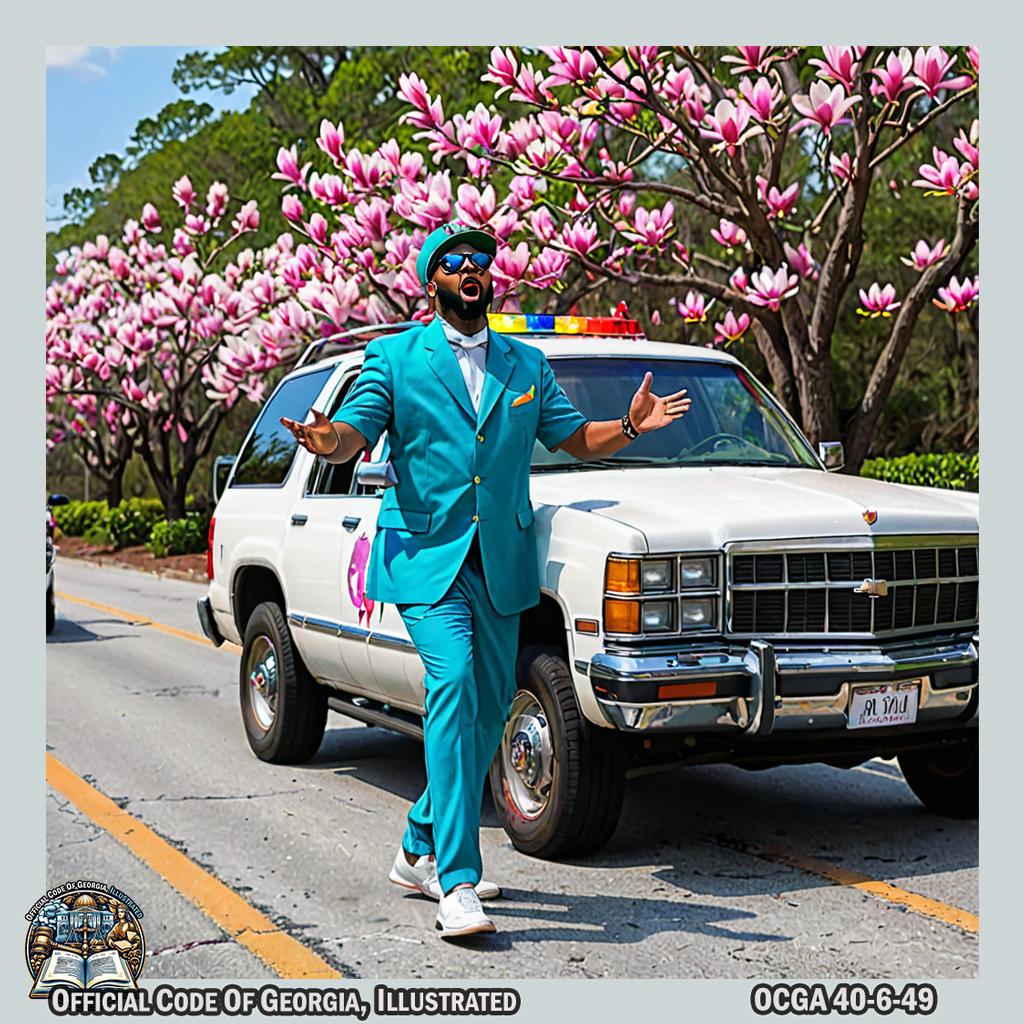
Sean P stands behind a slowly turning vehicle, miming driving and then suddenly stopping as another vehicle approaches from the rear, using exaggerated gestures and expressions to convey the concept of being followed according to the Georgia Code section. This art piece is set in a vibrant Magnolia Music and Medicine Show, with lively music and colorful costumes adding an entertaining flair to the scene. -
This Code section shall not apply to the operator of any non-leading vehicle traveling in a coordinated platoon. For purposes of this subsection, the term “coordinated platoon” means a group of motor vehicles traveling in the same lane utilizing vehicle-to-vehicle communication technology to automatically coordinate the movement of such vehicles.
40-6-50.Driving on divided highway, controlled-access roadways, and emergency lanes.¶
- As used in this Code section, the term “gore” means the area of convergence between two lanes of traffic.
- Every vehicle driven on a divided highway shall be driven only upon the right-hand roadway unless directed or permitted to use another roadway by official traffic-control devices or police officers. No vehicle shall be driven over, across, or within any dividing space, barrier, gore, paved shoulder, or section separating the roadways of a divided highway; except that a vehicle may be driven through an opening in such physical barrier or dividing space or at an established crossover or intersection unless specifically prohibited by an official sign, signal, or control device. No person shall drive a vehicle onto or from any controlled-access roadway except at such entrances and exits as are established by public authority. Except as provided for in subsection (c) of this Code section, no vehicle shall be driven in an emergency lane except in the event of an actual emergency.
- For purposes of this subsection, “transit bus” means a bus used for the transportation of passengers within a system which is operated by or under contract to the state, a public agency or authority, or a county or municipality of this state. If the commissioner of transportation permits the use of emergency lanes of a controlled-access roadway by transit buses in the metropolitan Atlanta nonattainment area, the commissioner shall designate on which controlled-access roadways the use of emergency lanes by transit buses may be allowed and upon such designation the commissioner shall only permit the use on that emergency lane of a transit bus with a seating capacity of 33 passengers or more. Transit buses authorized to use the emergency lanes under this subsection may be operated on the emergency lane only when main lane traffic speeds are less than 35 miles per hour. Drivers of transit buses being operated on the emergency lanes may not exceed the speed of the main lane traffic by more than 15 miles per hour and may never exceed 35 miles per hour. Drivers of transit buses being operated on the emergency lanes must yield to merging, entering, and exiting traffic and must yield to other vehicles on the emergency lanes. Transit buses operating on the emergency lanes must be registered with the Department of Transportation.
- Nothing in this Code section shall prohibit the use of a FlexAuto lane in the manner permitted under Code Section 32-9-4.1.
40-6-51.Restrictions on type of vehicle that may travel on certain major interstates and highways inside the Interstate 285 perimeter.¶
-
-
Any motor vehicle with more than six wheels and commercial motor vehicles as defined by Code Section 40-1-1 shall not travel on any portions of Interstates 20, 75, 85 or Georgia Highway 400 that are located within the arc of Interstate 285 unless the driver of such motor vehicle is: 1. Engaging in a pick up or delivery to or from a shipper located inside the arc of Interstate 285; 2. Traveling to or from such motor vehicle’s terminal facility located inside the arc of Interstate 285;
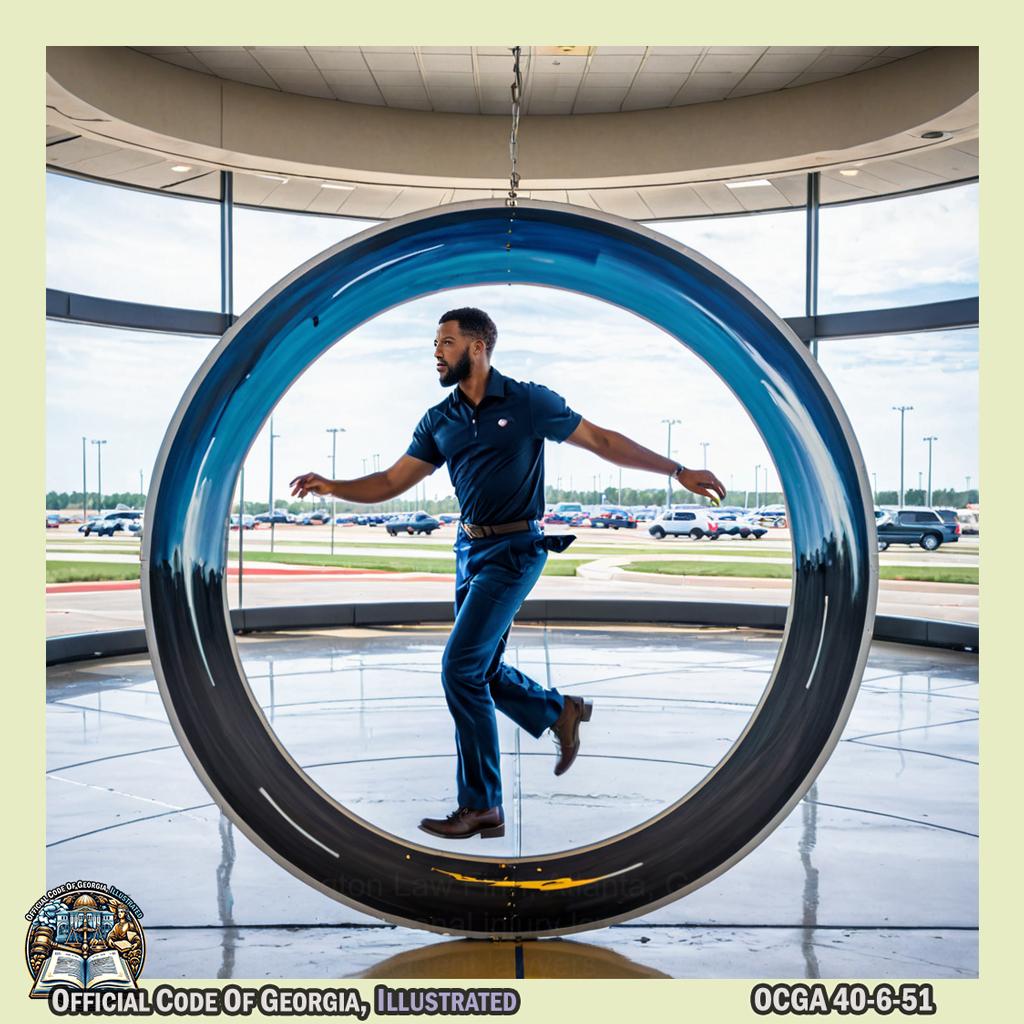
Sam Edwards walks in a circular motion, mimicking the movement of a motor vehicle traveling along an arc, while incorporating elements of dance and performance art to embody the journey to or from a terminal facility located inside the arc of Interstate. - Traveling to or from a repair facility located inside the arc of Interstate 285 for service; or
- Traveling to or from his or her residence which is located inside the arc of Interstate 285.
- The Department of Transportation by order and local authorities by ordinance may regulate or prohibit the use of any controlled-access roadway within their respective jurisdictions by any class of vehicle or kind of traffic which is found to be incompatible with the normal and safe movement of traffic.

Pettis Norman, dressed in a vibrant football uniform, vigorously motions with his arms to direct traffic around him on a controlled-access roadway as if he were conducting an orchestra, all while maintaining a lighthearted and playful expression, capturing the essence of Garry Winogrand's art style.
- The Department of Transportation by order and local authorities by ordinance may regulate or prohibit the use of any controlled-access roadway within their respective jurisdictions by any class of vehicle or kind of traffic which is found to be incompatible with the normal and safe movement of traffic.
-
-
The Department of Transportation or the local authority adopting any such prohibition shall erect and maintain official traffic-control devices on the controlled-access highway on which such prohibitions are applicable, and when such devices are in place no person shall disobey the restrictions stated thereon.
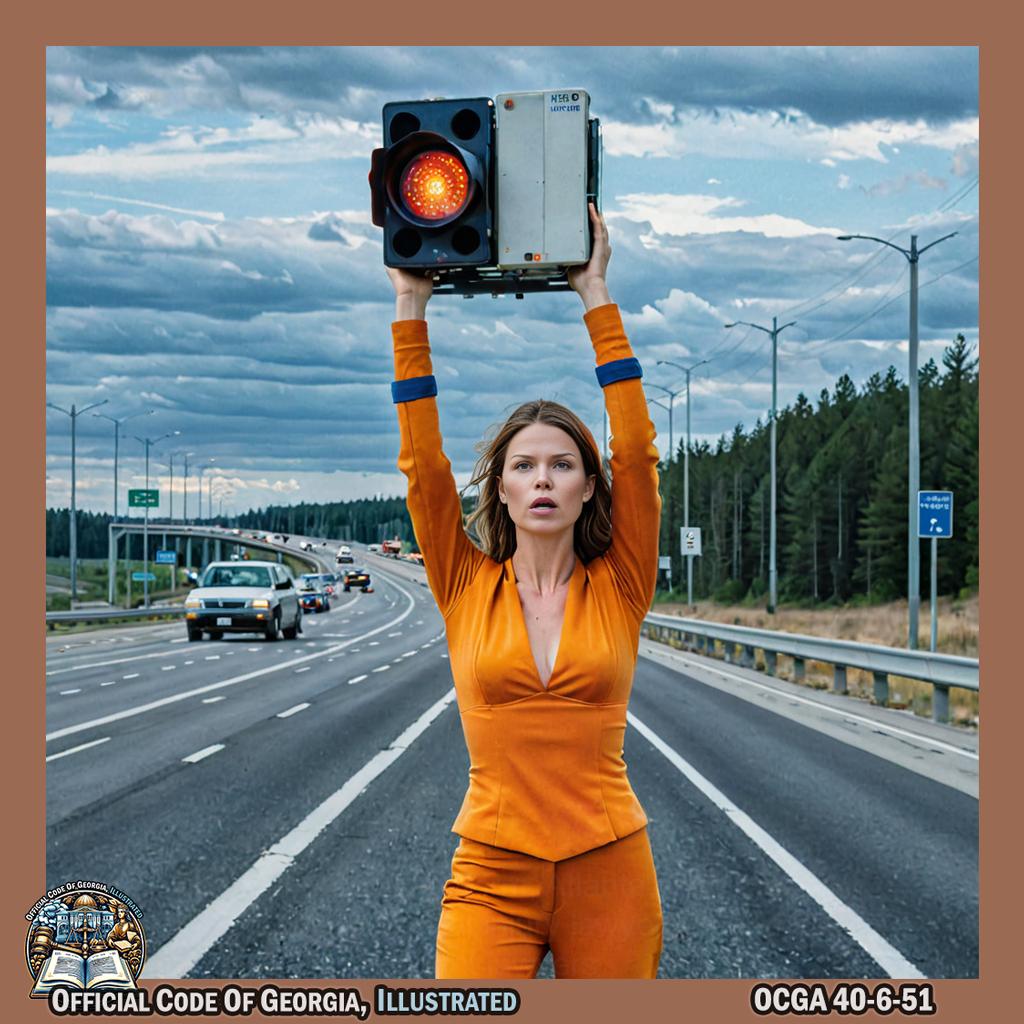
Jennifer Ferrin stands erect, holding a traffic-control device high above her head as she moves gracefully along the controlled-access highway. Her movements are deliberate and fluid, embodying the authority of the Department of Transportation. The scene is captured in the dramatic style of Rineke Dijkstra, with striking lighting that emphasizes both strength and vulnerability. -@JenniferFerrin -
For purposes of this Code section, roadways within the jurisdiction of the Department of Transportation and roadways within the jurisdiction of local authorities shall be as set forth in Code Section 32-4-1.
- A driver of a motor vehicle failing to comply with the requirements of subsection (a) of this Code section shall be fined $150.00. A driver of a motor vehicle failing to comply with subsection (a) of this Code section during a declared state of emergency for inclement weather conditions shall be fined $1,000.00.

In the style of Christo, Devonte Upson, a basketball player in the Israeli Basketball Premier League, performs the action of pretending to drive a car and then shaking his finger in disapproval while making a "tsk tsk" sound.
40-6-52.Prohibited lane usage by trucks using multilane highways.¶
- As used in this Code section, the term “truck” means any vehicle equipped with more than six wheels, except buses and motorcoaches.
- On roads, streets, or highways with three or more lanes allowing for movement in the same direction, it shall be unlawful for any truck to operate in any lanes other than the two most right-hand lanes, except when the truck is preparing for a left turn or as otherwise provided by subsection (d) of this Code section.
- On roads, streets, or highways with two lanes allowing for movement in the same direction, it shall be unlawful for any truck to operate in the left-hand lane, except when the truck is actually overtaking and passing another vehicle, preparing for a left turn, or as otherwise provided by subsection (d) of this Code section.
- On interstate highways with four or more lanes allowing for movement in the same direction, the Department of Transportation may designate specific lanes that either prohibit or allow trucks. Where truck usage has been so designated and indicated as such by signs erected by the Department of Transportation, it shall be unlawful for any truck to operate in any lanes other than as designated.
40-6-53.Prohibited lane usage by buses and motorcoaches using multilane highways; HOV lane usage by a bus or motorcoach.¶
-
On roads, streets, or highways with three or more lanes allowing for movement in the same direction, it shall be unlawful for any bus or motorcoach to operate in any lanes other than the two most right-hand lanes, except when the bus or motorcoach is preparing for a left turn, is moving to or from an HOV lane, or as otherwise provided by subsection (c) of this Code section.
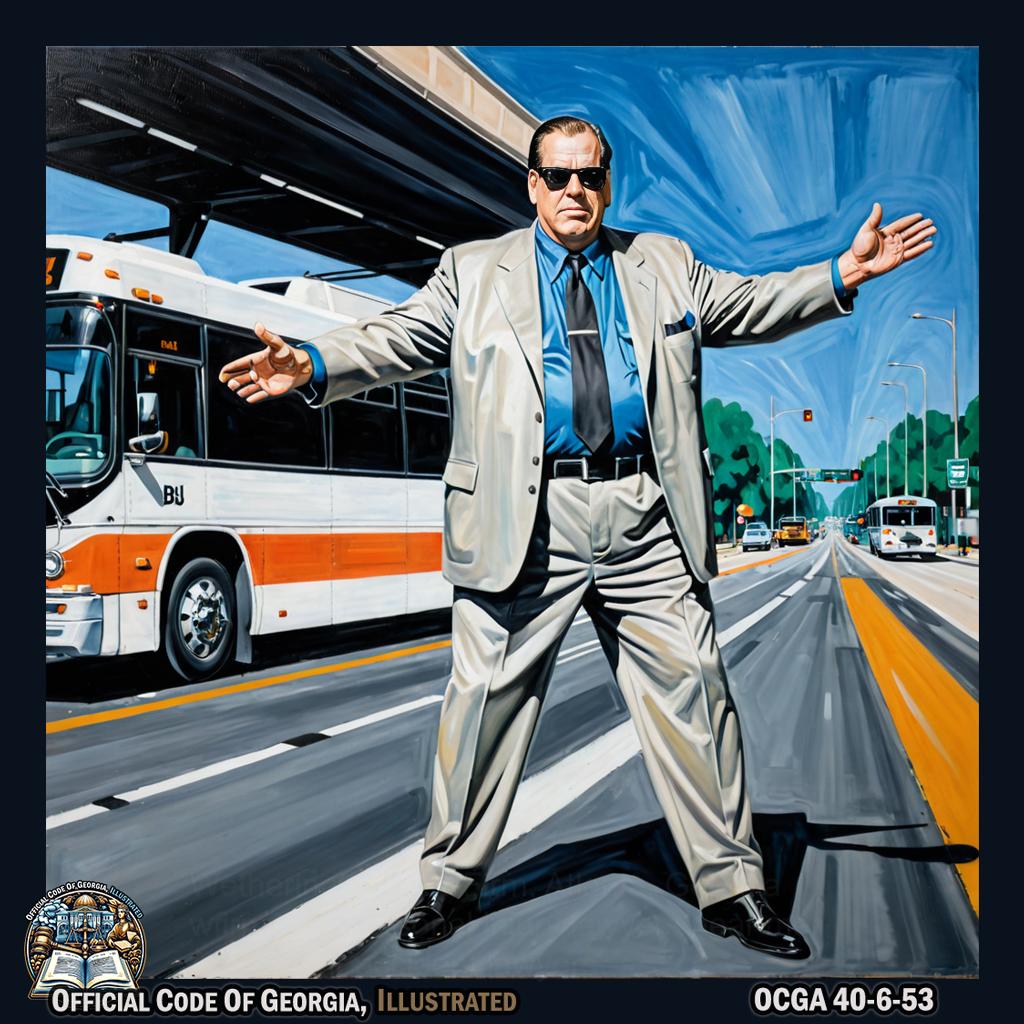
Big Bossman, in the style of Walter Gropius, elegantly and dramatically gestures with his arms to signify the movement of a bus or motorcoach in the two most righthand lanes on a multi-lane road, creating a dynamic and visually captivating art piece set against the backdrop of Acworth's picturesque streets. -
On roads, streets, or highways with two lanes allowing for movement in the same direction, it shall be unlawful for any bus or motorcoach to operate in the left-hand lane, except when the bus or motorcoach is actually overtaking and passing another vehicle, preparing for a left turn, or as otherwise provided by subsection (c) of this Code section.
- On interstate highways with four or more lanes allowing for movement in the same direction, the Department of Transportation may designate specific lanes that either prohibit or allow buses or motorcoaches. Where such usage has been so designated and indicated by signs erected by the Department of Transportation, it shall be unlawful for any bus or motorcoach to operate in any lanes other than those designated for its use except when moving to or from an HOV lane.
- When moving to or from an HOV lane, a bus or motorcoach shall move to the proper lanes of travel expeditiously and in the shortest distance possible under the circumstances.
40-6-54.Designation of travel lanes for exclusive use of certain vehicles; penalty; presumption; establishment of high occupancy toll (HOT)lanes.¶
- The Department of Transportation may designate travel lanes on any road in the state highway system for the exclusive use of certain vehicles, as provided in Code Section 32-9-4; provided, however, that where such designation has been made, the road shall be appropriately marked with signs or other roadway markers or markings to inform the traveling public of the restrictions imposed.
-
Any person who violates subsection (b) of Code Section 32-9-4 shall be guilty of a misdemeanor and, upon conviction thereof, shall be punished by a fine:
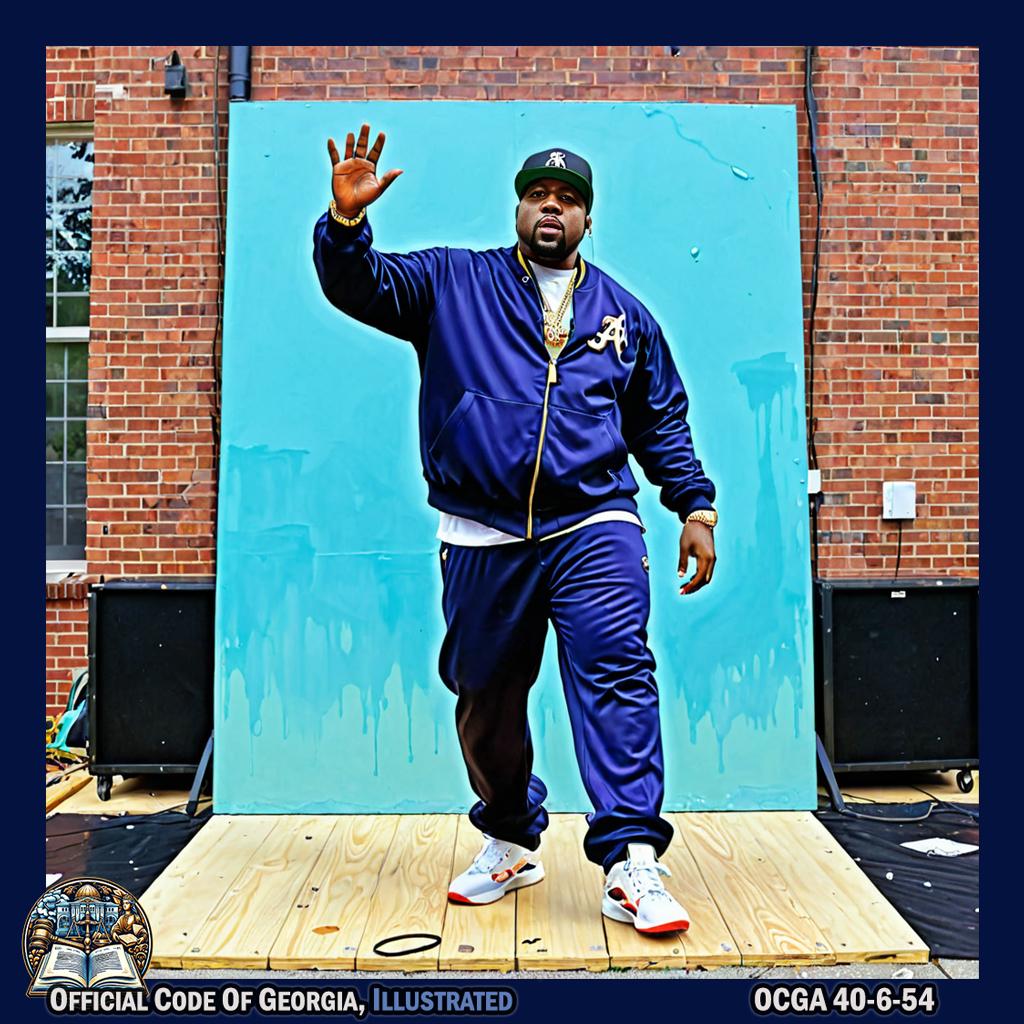
Big Boi walks onto a stage in the Randall Mill neighborhood of Atlanta, gracefully reaching out his hand to pluck an invisible item from the air. With fluid movements, he shapes and sculpts the air around him as if creating an intangible art piece, embodying the essence of Sean Raspet's style while visually interpreting the legal code through dance and movement. -@BigBoi - Not to exceed $75.00 for the first such offense;
- Not to exceed $100.00 for the second such offense;
- Not to exceed $150.00 for the third such offense; and
- Not to exceed $150.00 plus one point on such person’s driver’s license as provided for under Code Section 40-5-57 for the fourth or subsequent offense.
-
In the prosecution of an offense committed in the presence of or witnessed by a law enforcement officer whether by direct observation or as recorded through means of video surveillance, either by magnetic imaging or photographic copy, of failure to obey a road sign restricting a highway or portion thereof to the use of high occupancy vehicles (HOV), proof that the vehicle described in the HOV violation summons was operated in violation of this Code section, together with proof that the defendant was at the time of such violation the registered owner of the vehicle, shall constitute evidence as a rebuttable presumption that such registered owner of the vehicle was the person committing the violation. Notwithstanding any other provision of this subsection to the contrary, said rebuttable presumption shall be overcome if the owner of said vehicle states, under oath, in open court, that he or she was not the operator of the vehicle at the time the alleged offense occurred.
- The General Assembly finds and declares that the development, improvement, and use of exclusive or preferential high occupancy vehicle lanes, emergency vehicle lanes, and truck lanes or routes should be undertaken in order to relieve congestion and increase the efficiency of the federal-aid highway system. The Department of Transportation in cooperation with the State Road and Tollway Authority is hereby authorized to implement high occupancy toll (HOT) lanes where appropriate in qualifying HOV lanes. A “HOT lane” is a designated lane which allows single occupancy vehicles to gain access to HOV lanes by paying a toll set by the State Road and Tollway Authority. The department may design and develop a system of HOT lanes which uses value pricing and lane management. “Value pricing” recognizes the need to vary the road user charge according to the levels of congestion and time of day; and “lane management” restricts access to the designated HOT lanes based on occupancy, vehicle type, or other objective which would maximize the efficiency of the federal-aid highway system.
40-6-55.Obligation of drivers to yield to bicyclist in a bicycle lane.¶
Notwithstanding other provisions of this chapter relating to operating a vehicle on a roadway, where a bicycle lane is provided on the roadway, the operator of a motor vehicle shall yield to a person operating a bicycle in a bicycle lane.
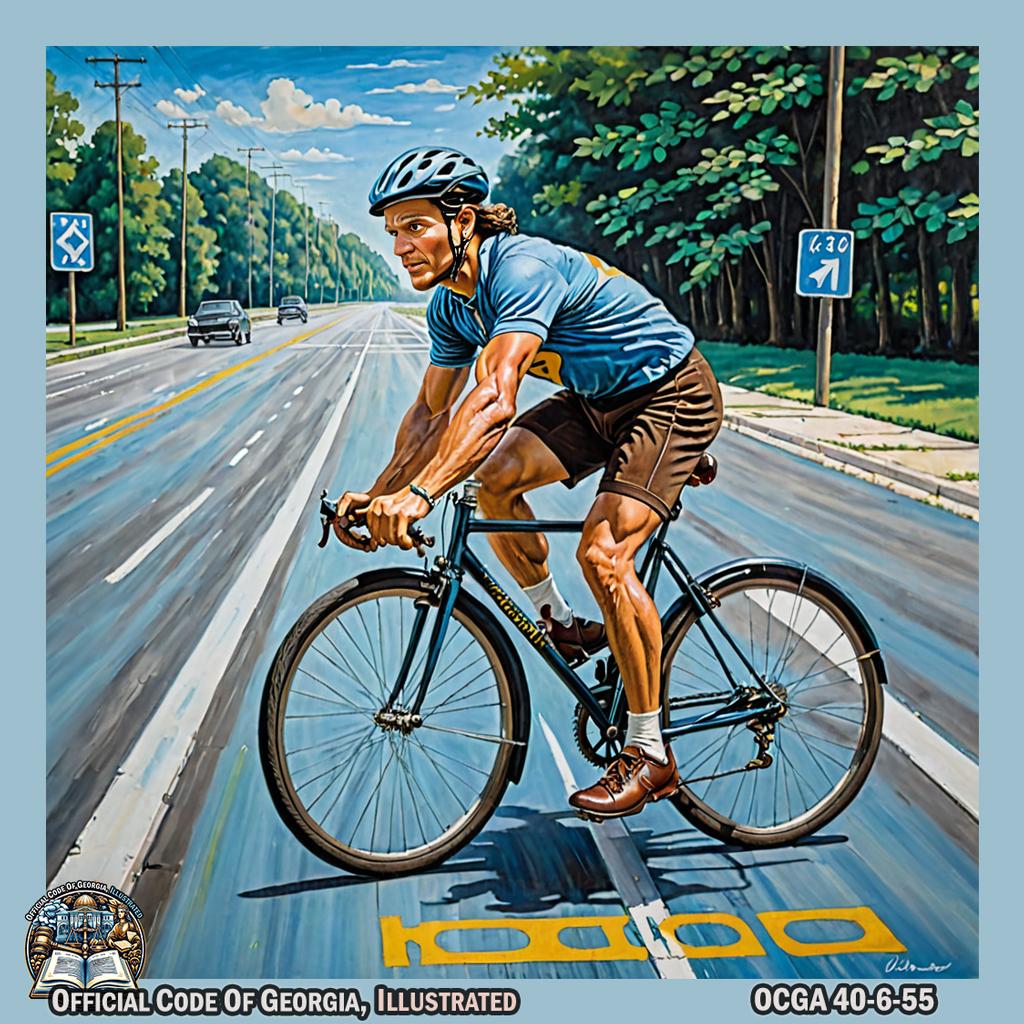
40-6-56.Procedure for passing a bicyclist.¶
-
The operator of a motor vehicle approaching a bicycle shall approach the bicycle with due caution and shall proceed as follows:

Ellison Barber gracefully pedals a vintage bicycle through the vibrant streets of Cordele, Georgia. As she approaches an intersection, she elegantly slows down and signals with her hand before proceeding with graceful caution, symbolizing the operator of a motor vehicle approaching a bicycle as outlined in Georgia state law. -@ellisonbarber -
Make a lane change into a lane not adjacent to the bicycle if possible in the existing road and traffic conditions; or
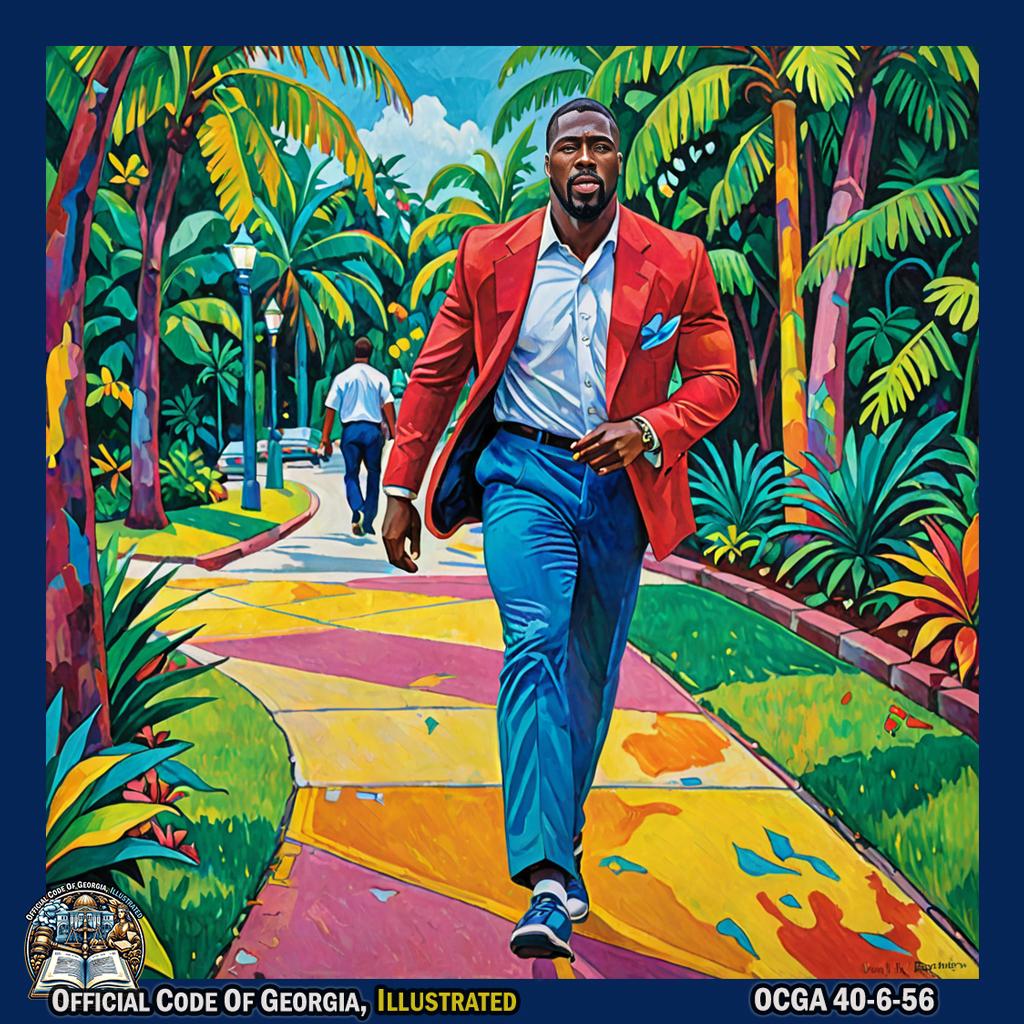
Justin Houston, in vibrant Gauguin-style colors and bold outlines, is depicted theatrically performing a sidestep on a lush College Park street, exaggeratedly checking over his shoulder for traffic (represented by abstract shapes), then gracefully stepping wide into an unoccupied lane symbolized by a clear path amidst the tropical flora. -@JHouston50 -
If a lane change under paragraph (1) of this subsection would be impossible, prohibited by law, or unsafe, reduce the speed of the motor vehicle to a reasonable and proper speed for the existing road and traffic conditions, which speed shall be at least ten miles per hour less than the posted speed limit or 25 miles per hour, whichever is more, and proceed around the bicycle with at least three feet between such vehicle and the bicycle at all times.
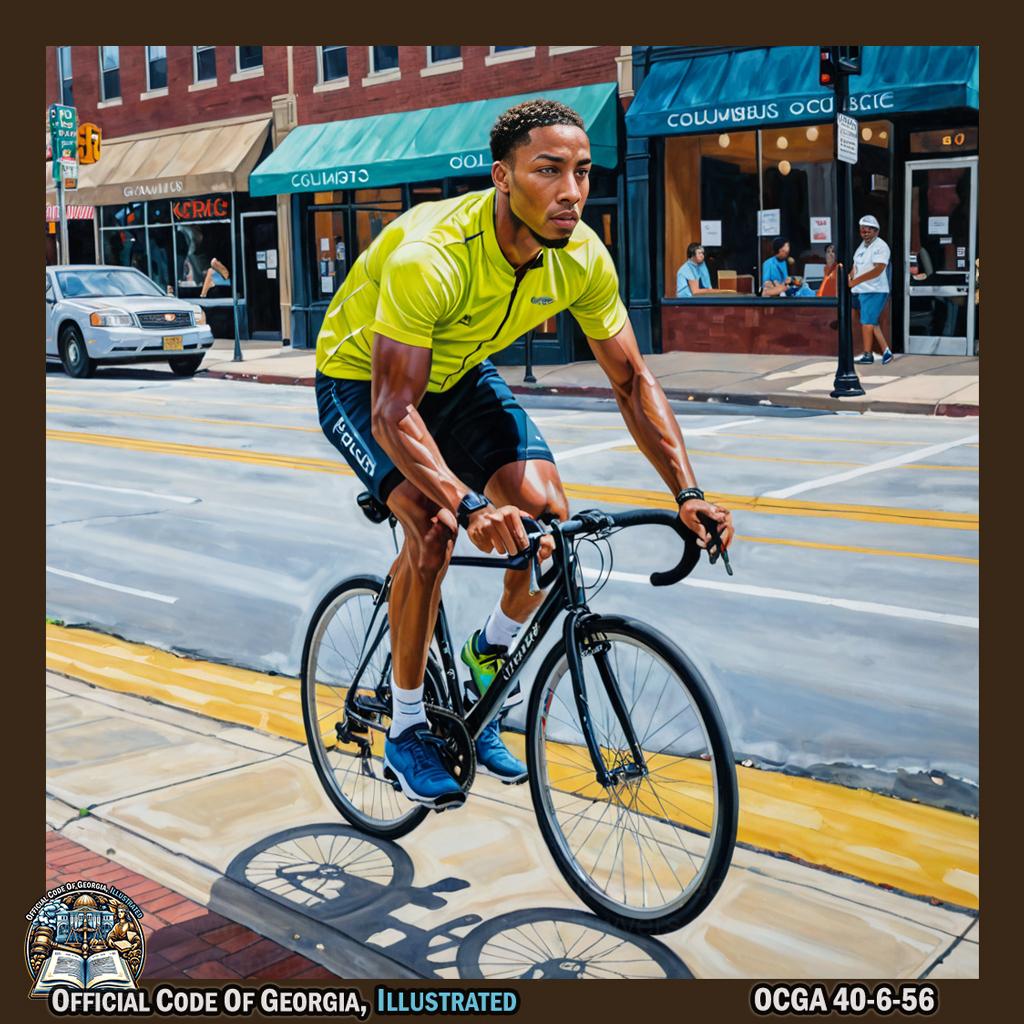
Kedric Golston gracefully slows down his pace, maintaining a distance of at least three feet from the bicycle in front of him, embodying the spirit of caution and awareness on a bustling Columbus street. -@Golston64
-
-
Any violation of this Code section shall be a misdemeanor punished by a fine of not more than $250.00.

Millie Jackson, dressed in a vibrant and eye-catching costume, stands on a platform at the CDC Museum. She dramatically gestures with her hands to mimic writing out the code section while maintaining an expressive facial expression. As she does this, Warren Eugene Brandon's art style comes to life around her, creating a dynamic and visually striking representation of the legal consequences for violating the code.
Article 4 Right of Way¶
-
40-6-70. Right of way rule for vehicles approaching or entering intersection.

Football player David Andrews stands at the intersection, his hand waving to halt vehicles while holding up a "right of way" sign, creating a striking art piece reminiscent of Maurizio Anzeri's work. -@dandrews61 -
40-6-71. Yield when turning left.
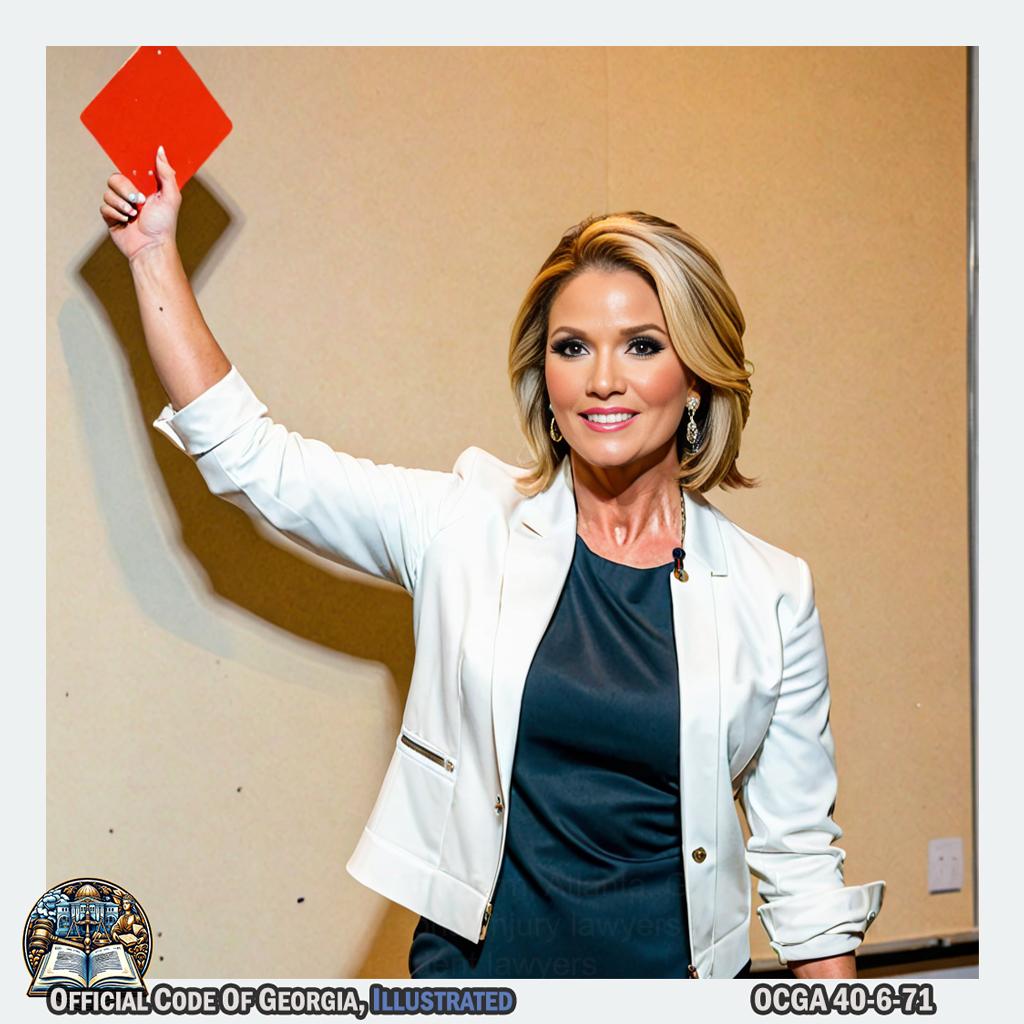
In the style of Brian O'Doherty's "Extend left arm out and down, making a yield sign shape with your hand," Melanie Thornton is performing the action as if it were an art piece. -
40-6-72. Stopping and yielding.

Akon gracefully holds up a stop sign with one hand and waves the other hand to signal yielding, creating a compelling art piece reminiscent of Agnes Martin's work. -@Akon -
40-6-74. Operation of vehicles on approach of authorized emergency vehicles.

Long jumper, Dwight Phillips gracefully leaps through the vibrant streets of Atlanta's Chattahoochee neighborhood, pausing as if he spotted an emergency vehicle while playfully pretending to drive a toy car. -@Dwightdagreat -
40-6-75. Highway construction and maintenance personnel and vehicles.
- 40-6-76. Funeral processions.
- 40-6-77. Penalties for collision which causes serious injury to motorcyclist, pedestrian, bicyclist, or farmer transporting certain items.
40-6-70.Right of way rule for vehicles approaching or entering intersection.¶
-
When two vehicles approach or enter an intersection from different highways at approximately the same time, the driver of the vehicle on the left shall yield the right of way to the vehicle on the right, provided that when a vehicle approaches or enters an intersection with no stop signs or other traffic-control devices from a highway that terminates at the intersection, the driver of that vehicle shall yield the right of way to the other vehicle, whether the latter vehicle be on such driver’s right or left. When two vehicles approach or enter an intersection with a traffic light in unactivated dark mode, the driver of each vehicle shall be required to stop in the same manner as if a stop sign were facing in each direction at the intersection. Drivers shall not be required to stop if the traffic signal is properly signed as a pedestrian hybrid beacon or ramp meter and operating in the unactivated dark mode. When a flashing indication is given, the driver shall stop for the flashing red signal and exhibit caution while passing through a flashing yellow indication.
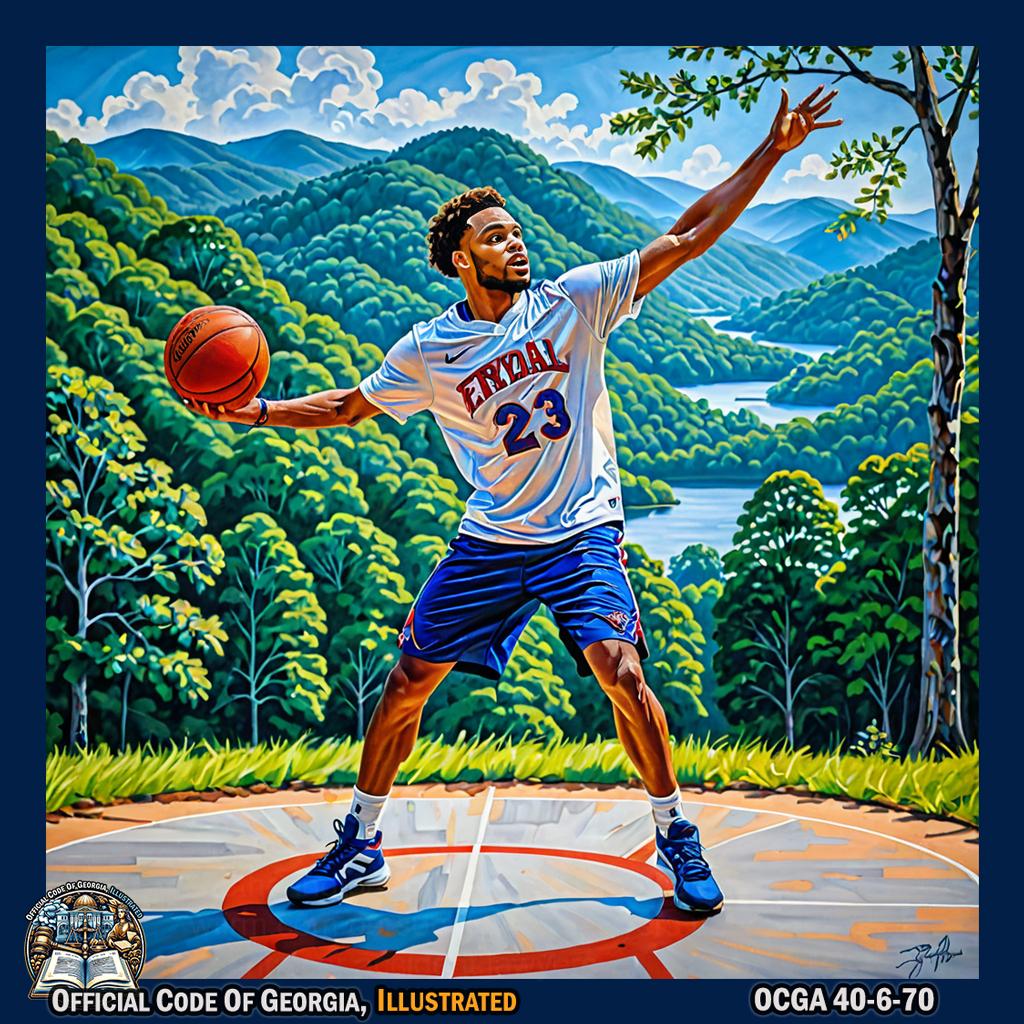
Basketball player Elijah Bryant gracefully acts out the intersection rules in a dramatic interpretive dance, featuring intricate movements and vivid expressions, set against the picturesque backdrop of Rydal, Georgia. -@Elijah_Bryant3 -
The right of way rule declared in subsection (a) of this Code section is modified at through highways and otherwise as stated in this chapter.
40-6-71.Yield when turning left.¶
The driver of a vehicle intending to turn to the left within an intersection or into an alley, private road, or driveway shall yield the right of way to any vehicle approaching from the opposite direction which is within the intersection or so close thereto as to constitute an immediate hazard.
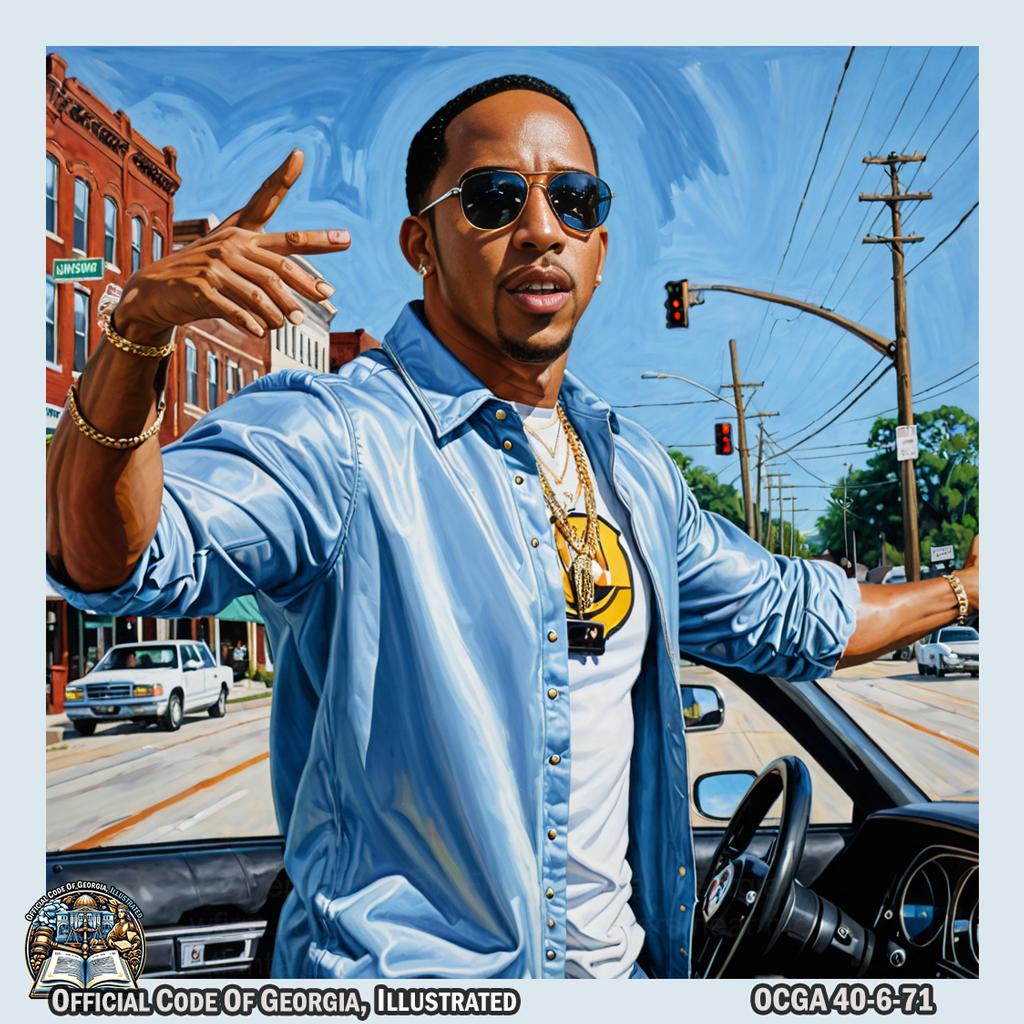
40-6-72.Stopping and yielding.¶
-
Preferential right of way may be indicated by stop signs or yield signs as authorized in Code Section 32-6-50.
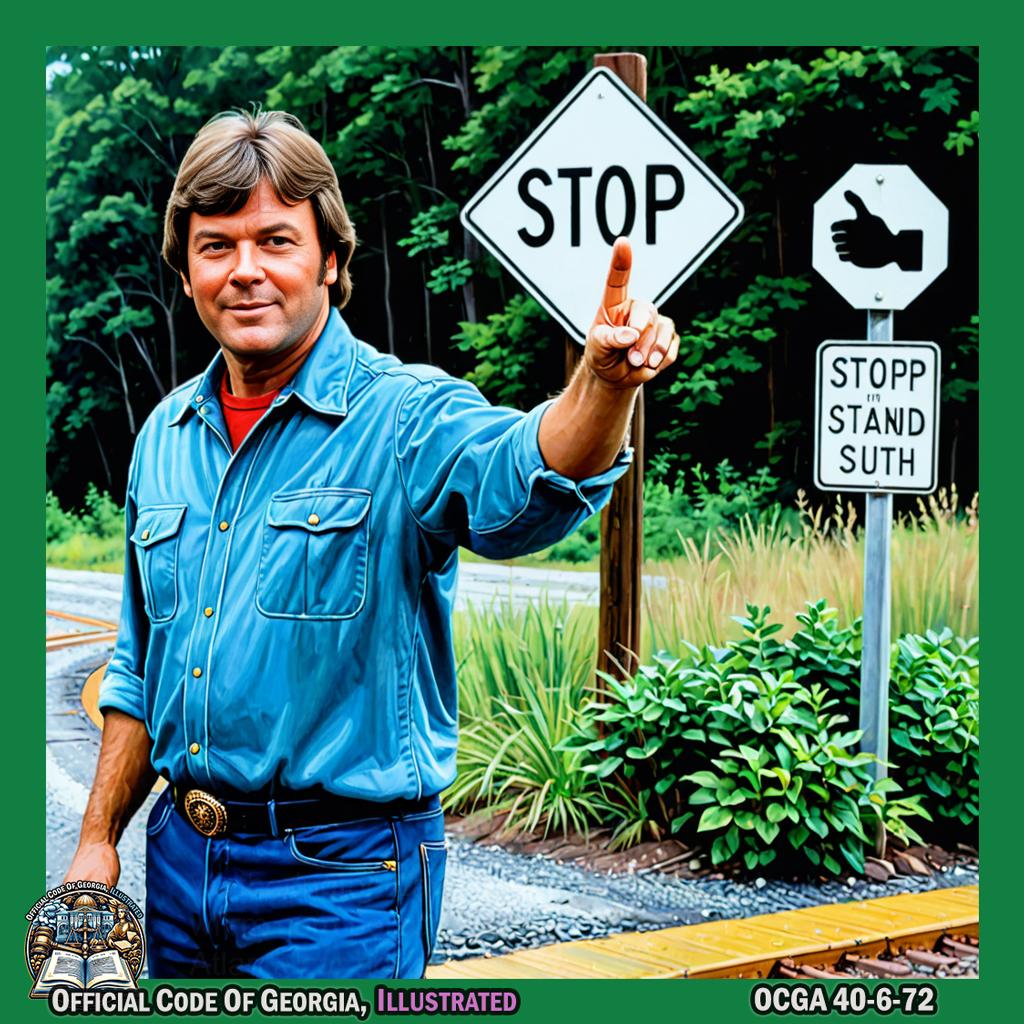
Joe South extends his hand, gesturing to the right of way, as he stands next to a stop sign in the style of Brian Robinson's art piece, within the lively setting of Tweetsie Railroad. -
Except when directed to proceed by a police officer, every driver of a vehicle approaching a stop sign shall stop at a clearly marked stop line or, if there is no stop line, before entering the crosswalk on the near side of the intersection or, if there is no crosswalk, at the point nearest the intersecting roadway where the driver has a view of approaching traffic on the intersecting roadway before entering it. After stopping, the driver shall yield the right of way to any vehicle in the intersection or approaching on another roadway so closely as to constitute an immediate hazard during the time when such driver is moving across or within the intersection or junction of roadways.
- The driver of a vehicle approaching a yield sign shall, in obedience to such sign, slow down to a speed reasonable for the existing conditions and, if required for safety to stop, shall stop at a clearly marked stop line or, if there is no stop line, before entering the crosswalk on the near side of the intersection or, if there is no crosswalk, at the point nearest the intersecting roadway where the driver has a view of approaching traffic on the intersecting roadway before entering it. After slowing or stopping, the driver shall yield the right of way to any vehicle in the intersection or approaching on another roadway so closely as to constitute an immediate hazard during the time such driver is moving across or within the intersection or junction of roadways. If such a driver is involved in a collision with a vehicle in the intersection after driving past a yield sign without stopping, such collision shall be deemed prima-facie evidence of his failure to yield the right of way.
40-6-73.Entering or crossing roadway.¶
The driver of a vehicle about to enter or cross a roadway from any place other than another roadway shall yield the right of way to all vehicles approaching on the roadway to be entered or crossed.
40-6-74.Operation of vehicles on approach of authorized emergency vehicles.¶
-
Upon the immediate approach of an authorized emergency vehicle or a vehicle belonging to a federal, state, or local law enforcement agency making use of an audible signal and visual signals meeting the requirements of Code Section 40-6-6, the driver of every other vehicle shall yield the right of way and shall immediately drive to a position parallel to, and as close as possible to, the right-hand edge or curb of the roadway clear of any intersection and shall stop and remain in such position until the authorized emergency vehicle or law enforcement vehicle has passed, except when otherwise directed by a police officer.

Offset, dressed as a driver in a vibrant and abstract Vidalia onion field, dramatically steers an oversized, brightly-colored cardboard car to the side of a road made from fabric strips while colorful papier-mâché emergency vehicles with spinning lights pass by; he then freezes in a pose with his hand on his forehead looking for the next instruction, all portrayed in the bold and exaggerated style of pop art. -@OffsetYRN -
This Code section shall not operate to relieve the driver of any authorized emergency vehicle from the duty to drive with due regard for the safety of all persons using the highway.

Chas Henry, dressed in a vibrant football uniform, gracefully dances across the street with elegant footwork and dynamic movements, symbolizing the duty of an emergency vehicle driver to drive with due regard for highway safety.
40-6-75.Highway construction and maintenance personnel and vehicles.¶
-
The driver of a vehicle shall yield the right of way to any authorized vehicle or pedestrian actually engaged in work upon a highway within any highway construction or maintenance area indicated by official traffic-control devices.
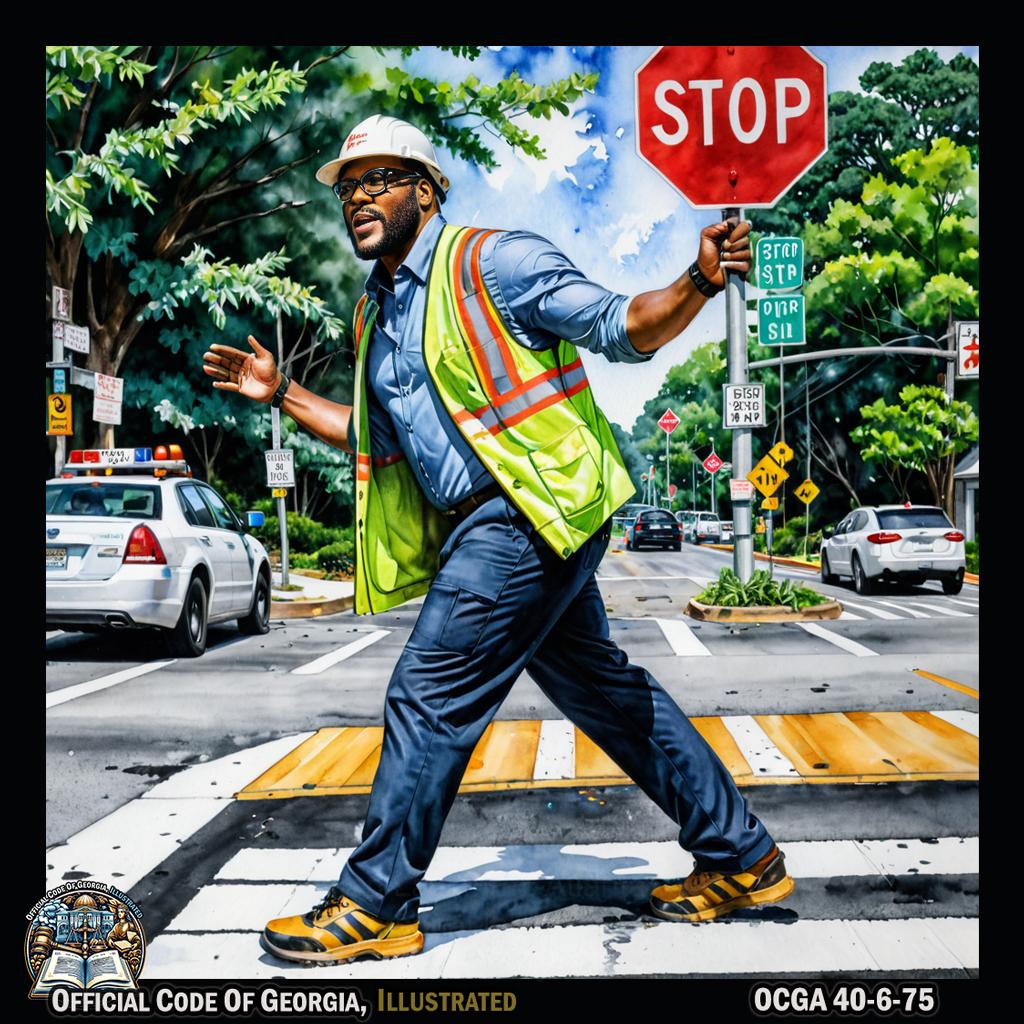
Tyler Perry, dressed as a construction worker, theatrically steps into a crosswalk with a stop sign in hand, halting an oncoming vehicle with exaggerated caution; Moreno's style is reflected as vibrant ink lines and watercolor hues capture the dynamic scene of Lilburn's lush greenery and historic buildings in the background. -@tylerperry -
The driver of a vehicle shall yield the right of way to an authorized vehicle actually engaged in work upon a highway whenever such vehicle displays flashing or revolving amber lights and has a permit to use such amber lights.

Brenda Lee, dressed in a flowing gown, gracefully yields the right of way to an authorized vehicle displaying flashing amber lights while moving through a forest park, capturing the scene in a dramatic and captivating art piece reminiscent of Frederick Ruysch's style. -@BrendaL33287831
40-6-76.Funeral processions.¶
- As used in this Code section, a “funeral procession” means an array of motor vehicles in which the lead vehicle displays a sign, pennant, flag, or other insignia furnished by a funeral home indicating a funeral procession unless led by a state or local law enforcement vehicle and each vehicle participating in the funeral procession is operating its headlights.
-
Funeral processions shall have the right of way at intersections subject to the following conditions and exceptions:
- Operators of vehicles in a funeral procession shall yield the right of way upon the approach of an authorized emergency vehicle or law enforcement vehicle giving an audible and visual signal; and
- Operators of vehicles in a funeral procession shall yield the right of way when directed to do so by a traffic officer.
-
Funeral processions escorted by the police, a sheriff, or a sheriff’s deputy shall have the right of way in any street or highway through which they may pass. Local governments may, by ordinance, provide for such escort service and provide for the imposition of reasonable fees to defray the cost of such service.
- The operator of a vehicle not in a funeral procession shall not interrupt a funeral procession except when authorized to do so by a traffic officer or when such vehicle is an authorized emergency vehicle or law enforcement vehicle giving an audible and visual signal.
-
Operators of vehicles not a part of a funeral procession shall not join a funeral procession by operating their headlights for the purpose of securing the right of way granted by this Code section to funeral processions.

Larry Holmes standing in a dimly lit room, slowly turning the headlights of a vintage car on and off while wearing an exaggerated expression of determination and focus, all captured from multiple angles with dramatic lighting reminiscent of Bruce Nauman's art pieces. -@LarryHolmes75 -
The operator of a vehicle not in a funeral procession shall not attempt to pass vehicles in a funeral procession on a two-lane highway.
- Any person violating subsection (d), (e), or (f) of this Code section shall be guilty of a misdemeanor and, upon conviction thereof, shall be punished by a fine not to exceed $100.00.
- Any law enforcement officer who is directing or escorting a funeral procession in this state, whether such service is provided while on duty or not, shall enjoy the same immunities from liability as the officer possesses while in the performance of other official duties.

John Gant, in a flowing uniform blending with the energetic brushstrokes characteristic of Nita Engle's watercolor style, stands at the cobblestone streets of Rome, dramatically raising his arm to halt traffic with one hand while gracefully guiding a procession of silhouetted figures through the ancient city with a bat held aloft as an unlikely staff under a burst of Italian sunlight. -@JohnCGant
40-6-77.Penalties for collision which causes serious injury to motorcyclist, pedestrian, bicyclist, or farmer transporting certain items.¶
- For purposes of this Code section, “serious injury” shall include, but shall not be limited to, causing bodily harm to another by depriving him or her of a member of his or her body, by rendering a member of his or her body useless, by seriously disfiguring his or her head or body or a member thereof, or by causing organic brain damage which renders the body or any member thereof useless.
- Any person who causes a serious injury to another person as a result of a collision with a motorcyclist, bicyclist, pedestrian, or farmer operating any vehicle used to transport agricultural products, livestock, farm machinery, or farm supplies by committing any right of way violation under this chapter when such motorcyclist, bicyclist, pedestrian, or farmer operating any vehicle used to transport agricultural products, livestock, farm machinery, or farm supplies is abiding by the provisions of this title shall be guilty of a misdemeanor and shall be punished:
- For a first offense, by a fine of not less than $250.00 in addition to any other penalties stipulated by law and the court shall report such conviction to the Department of Driver Services; and
- For a second or subsequent offense within a five-year period of time, as measured from the dates of previous arrests for which convictions were obtained or pleas of nolo contendere were accepted to the date of the current arrest for which a conviction is obtained or a plea of nolo contendere is accepted, by a fine of not less than $500.00 nor more than $1,000.00 and imprisonment for not less than ten days nor more than 12 months. Any fine imposed under this paragraph shall be mandatory and shall not be suspended or waived or conditioned upon the completion of any course or sentence. The court imposing punishment under this subsection shall forward a record of the disposition of the case to the Department of Driver Services.
Article 5 Rights and Duties of Pedestrians¶
- 40-6-90. Pedestrians to obey traffic-control devices and traffic regulations.
-
40-6-91. Right of way in crosswalks.
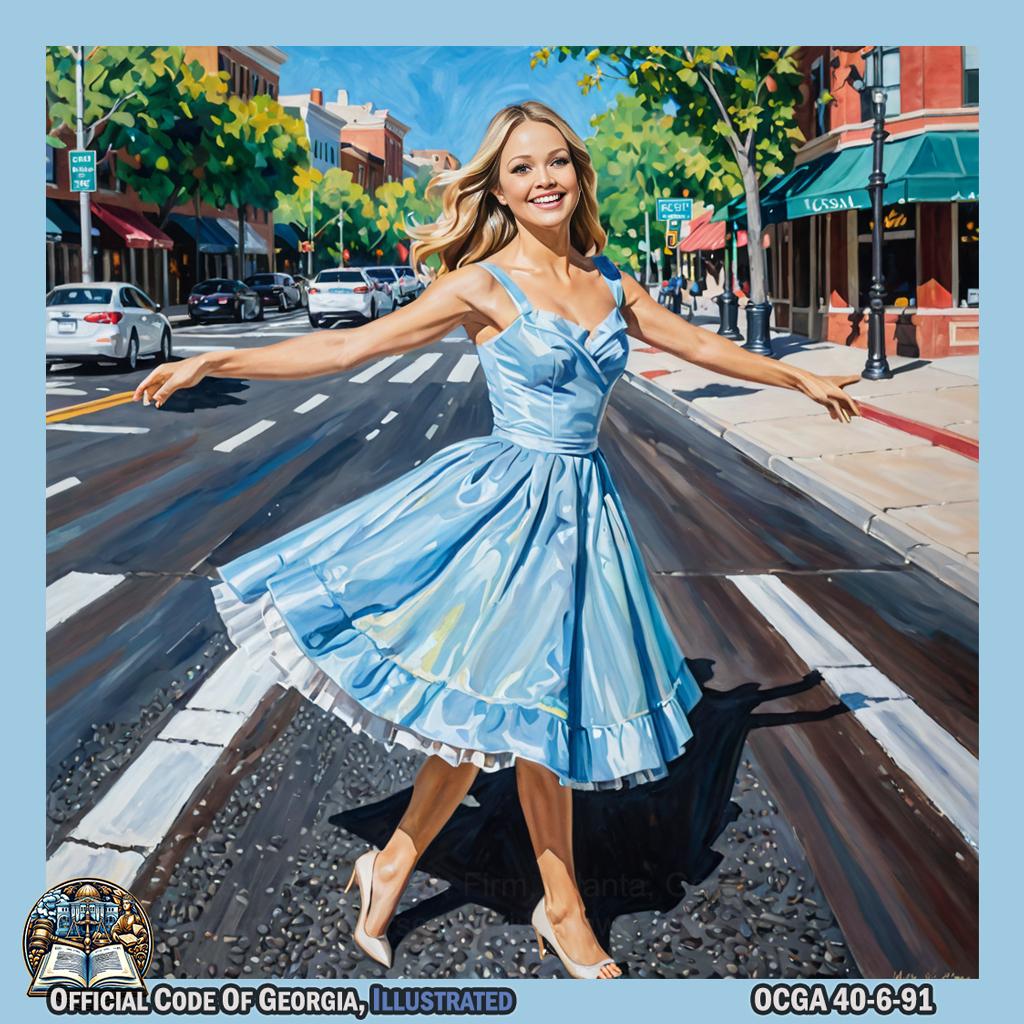
Actress Melissa Ordway, embodying the scene of a Mary Cassat art piece, confidently struts across the crosswalk with a beaming smile and an outstretched arm pointing forward to assert her right of way. -@MelissaOrdway - 40-6-93. Drivers to exercise due care in relation to pedestrians.
- 40-6-94. Right of way of blind pedestrian.
-
40-6-95. Pedestrian under influence of alcohol or drug.
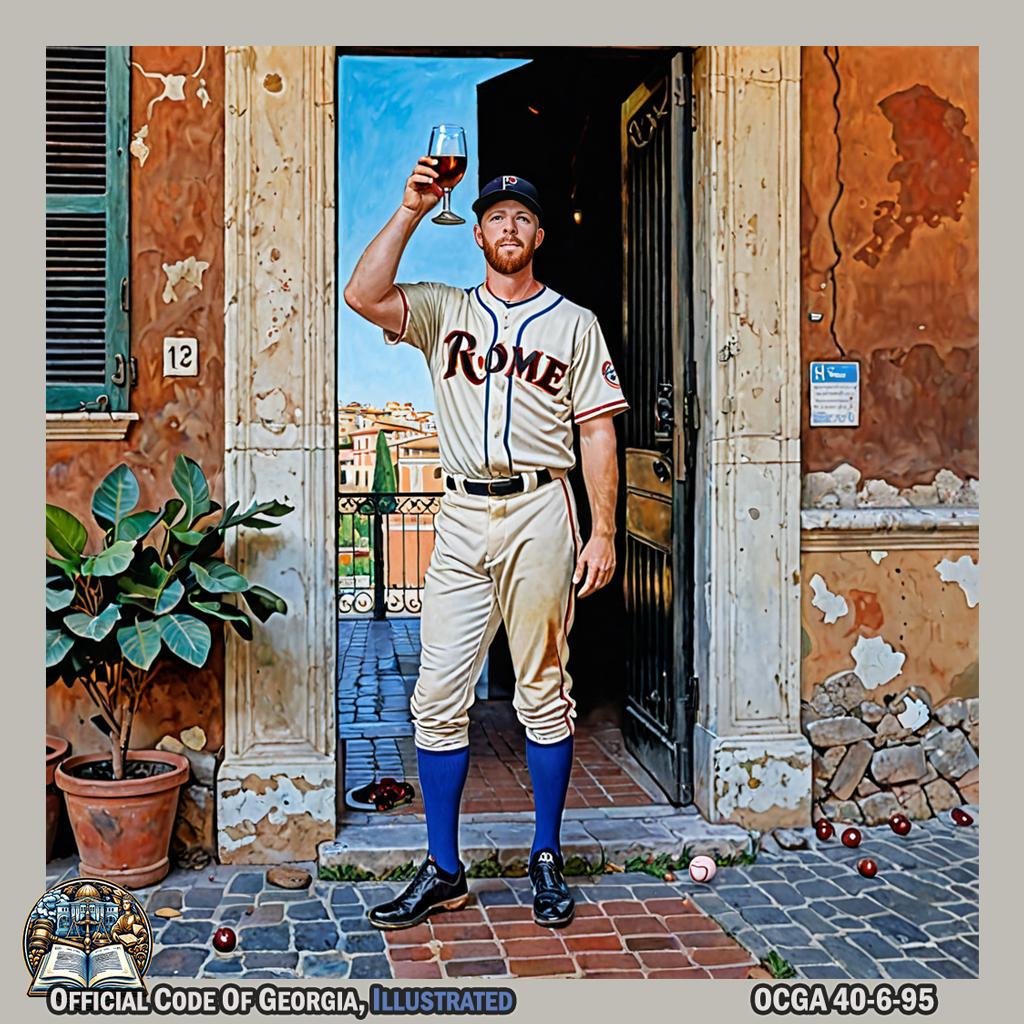
Baseball player Hunter Strickland stumbled and swayed while holding a bottle or glass in the rich scene of Rome, Georgia. -@hstrickland60 -
40-6-96. Pedestrians on or along roadway.
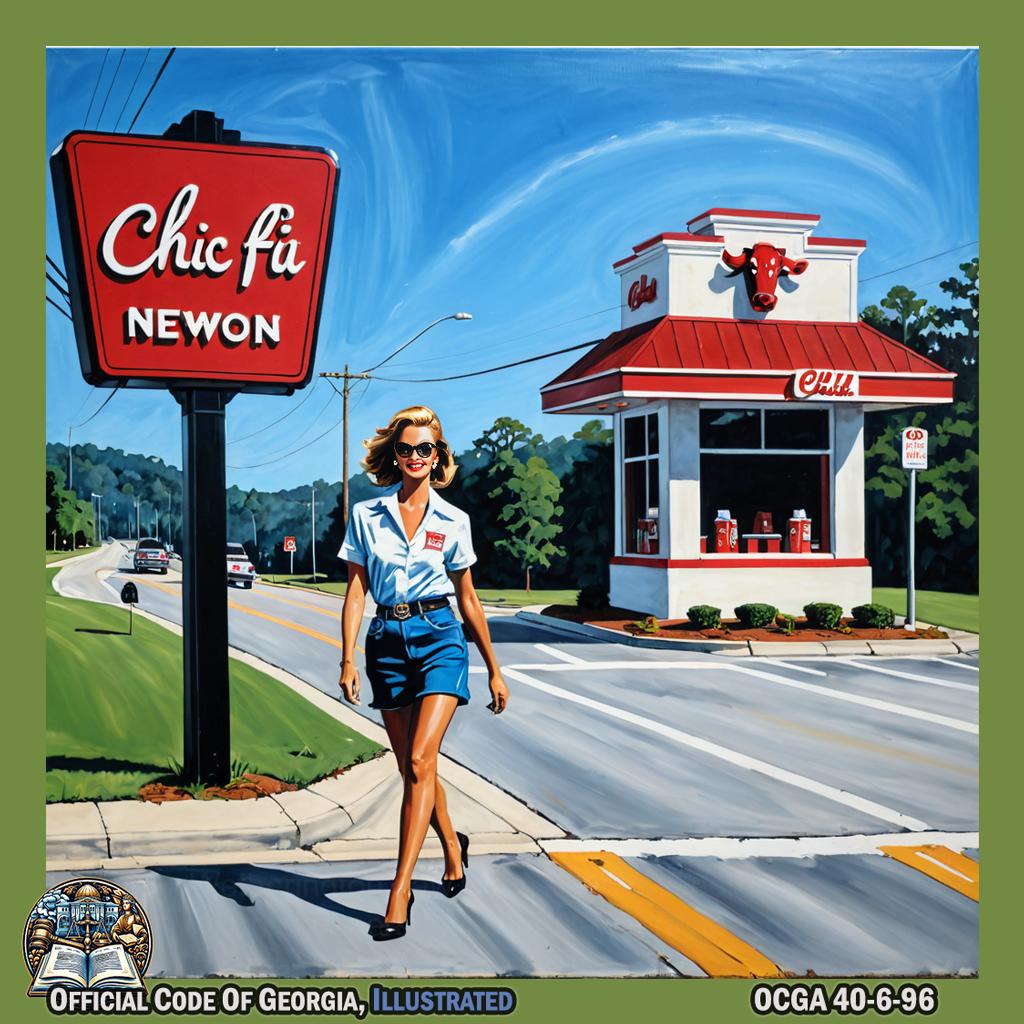
Chick-fil-A in Villa Rica, Georgia, strolls along a scenic road, waving to passing cars that only exist in their imagination. -@ChickfilA - 40-6-97.1. Solicitation permits for charitable organizations.
- 40-6-98. Driving through safety zone prohibited.
-
40-6-99. Pedestrians to yield to authorized emergency vehicles.

Football player Sam Martin gracefully moves to the side in Vidalia, Georgia, pretending to be a pedestrian and making siren sounds for an emergency vehicle. -@SamMartin_6 - 40-6-101. Redesignated.
40-6-90.Pedestrians to obey traffic-control devices and traffic regulations.¶
-
A pedestrian shall obey the instructions of any official traffic-control device specifically applicable to him, unless otherwise directed by a police officer.

Wrestler and actor Hulk Hogan, as depicted in an art piece from Ed Paschke, convincingly stops at a traffic light, mimics looking both ways before crossing the street, all while following the instructions of the traffic control device. -@HulkHogan -
Pedestrians shall be subject to traffic and pedestrian control signals as provided in Code Sections 40-6-21 and 40-6-22.
- At all other places, pedestrians shall be accorded the privileges and shall be subject to the restrictions stated in this chapter.

Marianne Gordon gracefully gestures as she dances through a golden garden, embodying the fluidity of pedestrian rights and restrictions in this chapter, against a backdrop of swirling patterns reminiscent of Klimt's art.
40-6-91.Right of way in crosswalks.¶
- The driver of a vehicle shall stop and remain stopped to allow a pedestrian to cross the roadway within a crosswalk when the pedestrian is upon the half of the roadway upon which the vehicle is traveling, or when the pedestrian is approaching and is within one lane of the half of the roadway on which the vehicle is traveling or onto which it is turning. For the purposes of this subsection, “half of the roadway” means all traffic lanes carrying traffic in one direction of travel.
-
No pedestrian shall suddenly leave a curb or other place of safety and walk or run into the path of a vehicle which is so close that it is impractical for the driver to yield.

Graceful person in flowing gown stops traffic as myEcon ~ Financial Success confidently strides forward. -
Subsection (a) of this Code section shall not apply under the conditions stated in subsection (b) of Code Section 40-6-92.
- Whenever any vehicle is stopped at a marked crosswalk or at any unmarked crosswalk at an intersection to permit a pedestrian to cross the roadway, the driver of any other vehicle approaching from the rear shall not overtake and pass such stopped vehicle.
40-6-92.Crossing roadway elsewhere than at crosswalk.¶
- Every pedestrian crossing a roadway at any point other than within a marked crosswalk or within an unmarked crosswalk at an intersection shall yield the right of way to all vehicles upon the roadway unless he has already, and under safe conditions, entered the roadway.
- Any pedestrian crossing a roadway at a point where a pedestrian tunnel or overhead pedestrian crossing has been provided shall yield the right of way to all vehicles upon the roadway if he uses the roadway instead of such tunnel or crossing.
- Between adjacent intersections at which traffic-control signals are in operation, pedestrians shall not cross at any place except in a marked crosswalk.
- No pedestrian shall cross a roadway intersection diagonally unless authorized by official traffic-control devices. When authorized to cross diagonally, pedestrians shall cross only in accordance with the official traffic-control devices pertaining to such crossing movements.
40-6-93.Drivers to exercise due care in relation to pedestrians.¶
Notwithstanding other provisions of this chapter, every driver of a vehicle shall exercise due care to avoid colliding with any pedestrian upon any roadway, shall give warning by sounding his horn when necessary, and shall exercise proper precautions upon observing any child or any obviously confused, incapacitated, or intoxicated person.
40-6-94.Right of way of blind pedestrian.¶
The driver of every vehicle shall yield the right of way to any blind pedestrian who is carrying a walking cane or stick white in color or white tipped with red or who is accompanied by a guide dog.
40-6-95.Pedestrian under influence of alcohol or drug.¶
A person who is under the influence of intoxicating liquor or any drug to a degree which renders him a hazard shall not walk or be upon any roadway or the shoulder of any roadway. Violation of this Code section is a misdemeanor and is punishable upon conviction by a fine not to exceed $500.00.
40-6-96.Pedestrians on or along roadway.¶
- As used in this Code section, the term “pedestrian” means any person afoot and shall include, without limitation, persons standing, walking, jogging, running, or otherwise on foot.
-
Where a sidewalk is provided, it shall be unlawful for any pedestrian to stand or stride along and upon an adjacent roadway unless there is no motor vehicle traveling within 1,000 feet of such pedestrian on such roadway or the available sidewalk presents an imminent threat of bodily injury to such pedestrian.

Chuck Leavell gracefully tiptoes along the roadside, carefully avoiding any nearby vehicles while showcasing a dramatic performance of interpretive dance, all set within a captivating outdoor art exhibit in Jesup. -@ChuckLeavell -
Where a sidewalk is not provided but a shoulder is available, any pedestrian standing or striding along and upon a highway shall stand or stride only on the shoulder, as far as practicable from the edge of the roadway.
-
Where neither a sidewalk nor a shoulder is available, any pedestrian standing or striding along and upon a highway shall stand or stride as near as practicable to an outside edge of the roadway, and, if on a two-lane roadway, shall stand or stride only on the left side of the roadway.

Myron Guyton gracefully glides along the winding roadway, embodying the law with a powerful stride to the left side of the road, his movements evoking an artful expression of pedestrian safety for all in Carrollton. -
Except as otherwise provided in this chapter, any pedestrian upon a roadway shall yield the right of way to all vehicles upon the roadway.
- No pedestrian shall enter or remain upon any bridge or approach thereto beyond the bridge signal, gate, or barrier after a bridge operation signal indication has been given.
- No pedestrian shall pass through, around, over, or under any crossing gate or barrier at a railroad grade crossing or bridge while such gate or barrier is closed or is being opened or closed.
40-6-97.Pedestrians soliciting.¶
- No person shall stand in a roadway for the purpose of soliciting a ride.
- Except as provided in Code Section 40-6-97.1, no person shall stand on a highway for the purpose of soliciting employment, business, or contributions from the occupant of any vehicle.
- No person shall stand on or in proximity to a street or highway for the purpose of soliciting the watching or guarding of any vehicle while parked or about to be parked on a street or highway.
40-6-97.1.Solicitation permits for charitable organizations.¶
Municipal or county governments are authorized to adopt ordinances for the issuance of permits for the solicitation of contributions on streets and highways within the geographic jurisdiction of such governments to charitable organizations registered in accordance with Code Section 43-17-5 and to charitable organizations exempt from such registration in accordance with Code Section 43-17-9.

40-6-98.Driving through safety zone prohibited.¶
No vehicle shall at any time be driven through or within a safety zone.
40-6-99.Pedestrians to yield to authorized emergency vehicles.¶
-
Upon the immediate approach of an authorized emergency vehicle making use of an audible signal meeting the requirements of Code Section 40-8-94, and visual and audible signals meeting the requirements of Code Section 40-6-6 or a vehicle belonging to a federal, state, or local law enforcement agency making use of visual and audible signals meeting the requirements of Code Section 40-6-6, every pedestrian shall yield the right of way to the authorized emergency vehicle or law enforcement vehicle.

Jennifer Nettles gracefully raises her arms and steps aside as an imaginary authorized emergency vehicle with flashing lights and blaring sirens rushes past, embodying the spirit of yielding to emergency vehicles in a colorful, dynamic art piece reminiscent of a lively parade. -@JenniferNettles -
This Code section shall not operate to relieve the driver of an authorized emergency vehicle from the duty to drive with due regard for the safety of all persons using the highway nor from the duty to exercise due care to avoid colliding with any pedestrian.
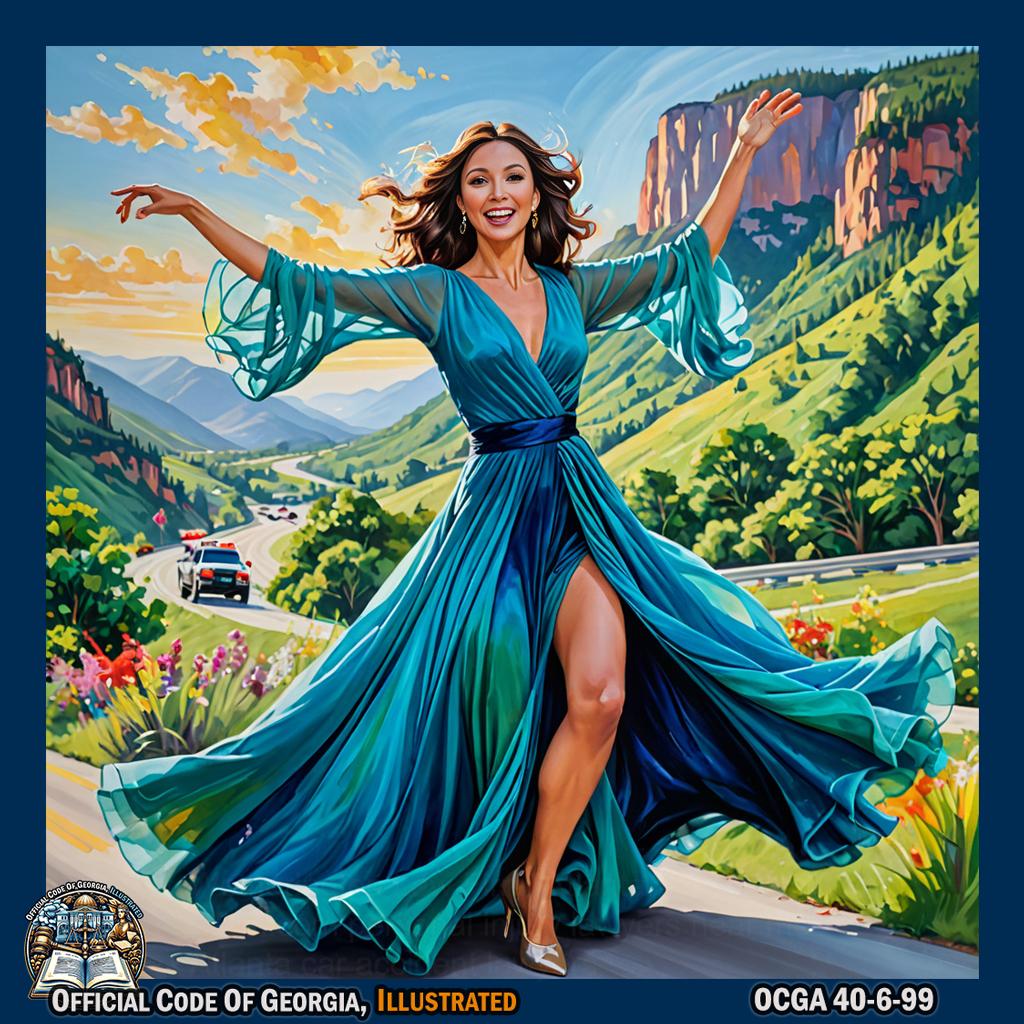
Monica gracefully dances in a flowing gown, extending her arms and legs to symbolize the duty of an authorized emergency vehicle driver to drive with due regard for safety and exercise care to avoid colliding with pedestrians, all set against a backdrop of lush landscapes and vibrant colors. -@MonicaDenise
40-6-100.[Repealed] Right of way on sidewalks.¶
40-6-101.Redesignated.¶
Editor’s notes.
Ga. L. 1990, p. 2048, § 5, redesignated former Code Section 40-6-101 as present Code Section 40-6-99.

Article 6 Turning, Starting, Signaling {#t40c06a06}
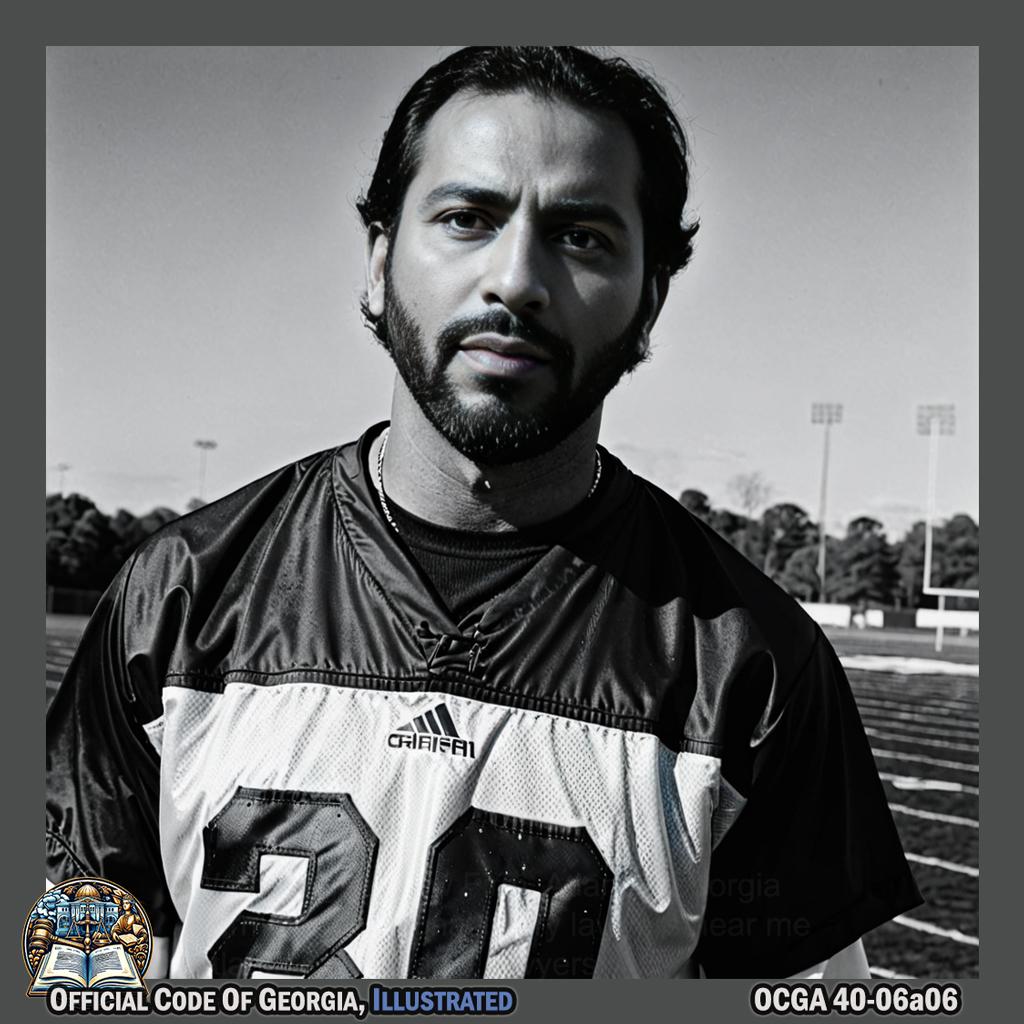
-
40-6-120. Methods of turning at intersections.
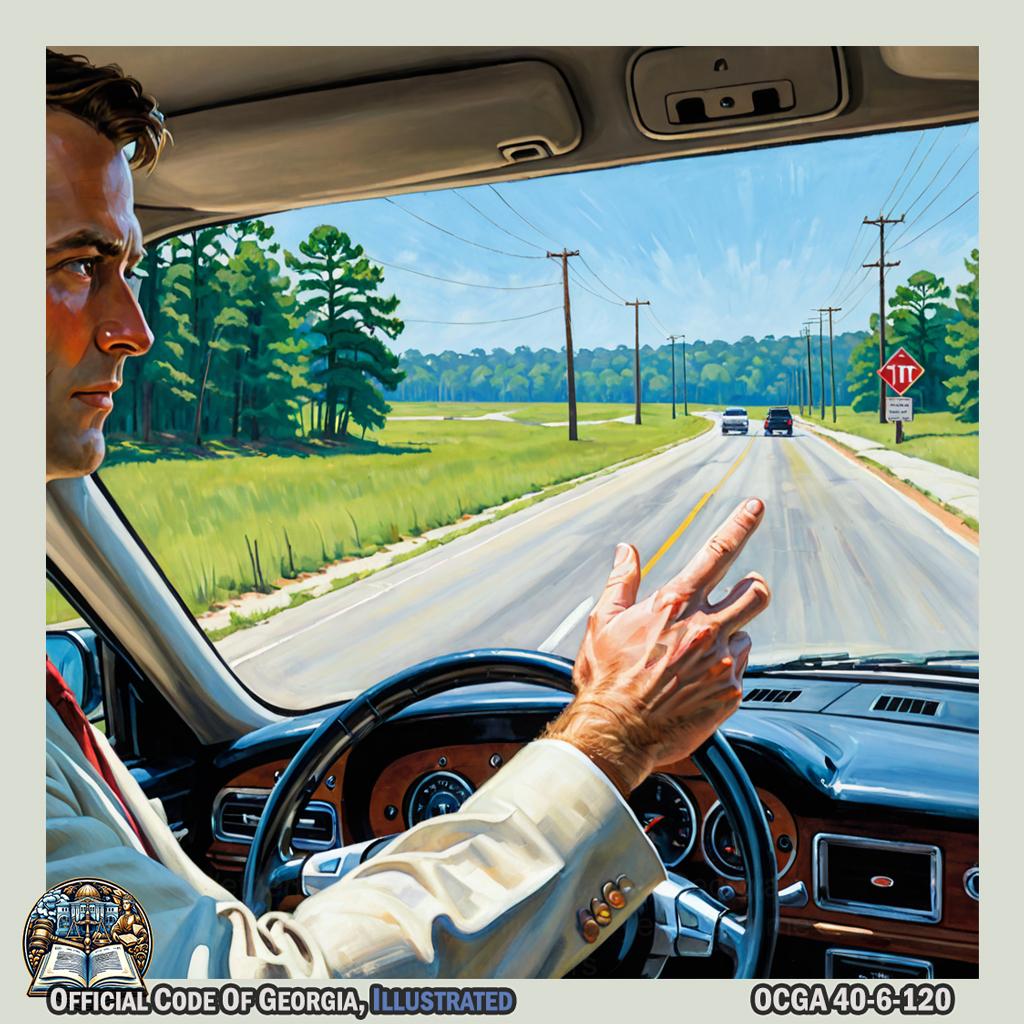
Triarc Acquisition LLC is simulating driving a car, carefully checking the surroundings, and gesturing with their hand to indicate a turn in the picturesque setting of Cusseta, Georgia. -
40-6-121. U-turns.

Simone Griffeth, as portrayed by actress Simone Griffeth, gracefully enacts the artful gesture of mimicking a U-turn while seated in an imaginary car in Ben Aronson's evocative scene. -
40-6-123. Turning movements; signals required on turning, changing lanes, slowing, or stopping.

Football player Bacarri Rambo gracefully simulates driving a car, gesturing to signal turns and lane changes before elegantly indicating slowing or stopping, akin to an art piece from Anthony McCall. -@brambo18 -
40-6-124. Signals by hand and arm or signal lights.

In the style of Sesshu Toyo, Brian McCann, a baseball player, creates a series of exaggerated and playful hand gestures while also mimicking the act of turning on and off imaginary signal lights. - 40-6-126. Central lane for turning.
40-6-120.Methods of turning at intersections.¶
The driver of a vehicle intending to turn at an intersection shall do so as follows:
- Right turn. Both the approach for a right turn and a right turn shall be made as close as practicable to the right-hand curb or edge of the roadway;
- Left turn. (A) As used in this paragraph, the term “extreme left-hand lane” means the lane furthest to the left that is lawfully available to traffic moving in the same direction as the turning vehicle. In the event of multiple lanes, the second extreme left-hand lane shall be the lane to the right of the extreme left-hand lane that is lawfully available to traffic moving in the same direction as the turning vehicle. The third extreme left-hand lane shall be the lane to the right of the second extreme left-hand lane and so forth.
(B)The driver of a vehicle intending to turn left shall approach the turn in the extreme left-hand lane lawfully available to traffic moving in the direction of travel of the turning vehicle. Whenever practicable, the left turn shall be made to the left of the center of the intersection and so as to exit the intersection or other location in the extreme left-hand lane lawfully available to traffic moving in the same direction as the turning vehicle on the roadway being entered.
(C)In the event of multiple left turn lanes, the driver of a vehicle turning left shall exit the intersection in the same relative travel lane as the vehicle entered the intersection. If the vehicle is in the second extreme left-hand lane entering the intersection, the vehicle shall exit the intersection in the second extreme left-hand lane. Where there are multiple lanes of travel in the same direction safe for travel, a vehicle shall not be permitted to make a lane change once the intersection has been entered.
40-6-121.U-turns.¶
No vehicle shall be turned so as to proceed in the opposite direction:

-
Upon any curve;

John Berry gracefully twists his body into a flowing curve, inspired by the art piece in Abe's on Lincoln, Savannah, Georgia. -
Upon the approach to or near the crest of a grade where such vehicle cannot be seen by the driver of another vehicle approaching from either direction;

Jackie Cochran, in the style of an art piece from Elberton Granite Museum, could perform a slow, dramatic reenactment of driving a car up a steep incline while gesturing with exaggerated surprise and confusion as another vehicle approaches unseen. -
Where such turn cannot be made in safety and without interfering with other traffic; or
- Where a prohibition is posted.

Martha Berry, born in Alabama, gracefully stands beneath a sign with a red circle and diagonal line, as she solemnly points to it with one hand while the other hand rests on her heart. Her expression conveys a mix of determination and empathy, capturing the tension between prohibition and education in Dalton's rich history.
40-6-122.Starting parked vehicle.¶
No person shall start a vehicle which is stopped, standing, or parked unless and until such movement can be made with reasonable safety.

40-6-123.Turning movements; signals required on turning, changing lanes, slowing, or stopping.¶
- No person shall turn a vehicle at an intersection unless the vehicle is in proper position upon the roadway as required in Code Section 40-6-120 or turn a vehicle to enter a private road or driveway or otherwise turn a vehicle from a direct course or change lanes or move right or left upon a roadway unless and until such movement can be made with reasonable safety. No person shall so turn any vehicle without giving an appropriate and timely signal in the manner provided in this Code section.
-
A signal of intention to turn right or left or change lanes when required shall be given continuously for a time sufficient to alert the driver of a vehicle proceeding from the rear in the same direction or a driver of a vehicle approaching from the opposite direction.
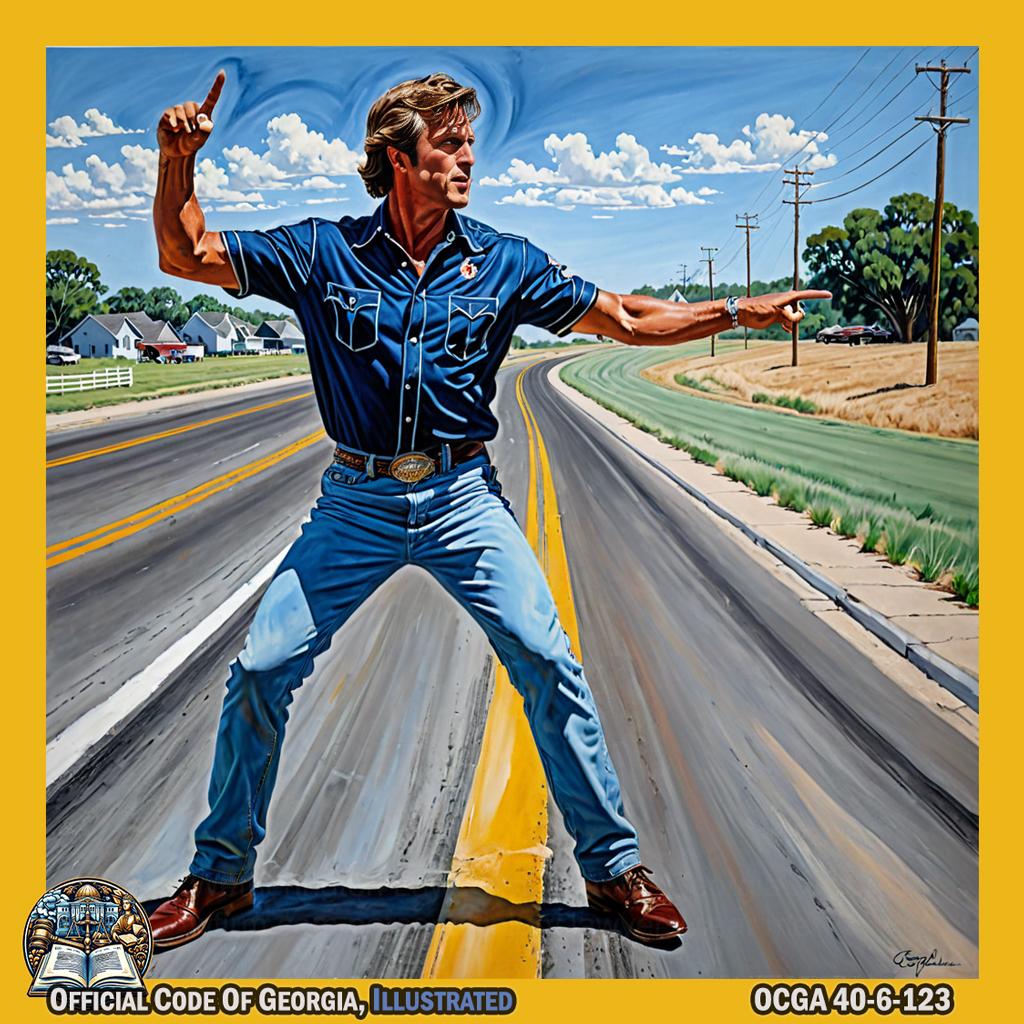
Billy Joe Royal extends his arm and points in the direction of intended turn or lane change, while making a dramatic swirling motion with his hand, creating a captivating scene reminiscent of an art piece from Gregory Gillespie. -
No person shall stop or suddenly decrease the speed of a vehicle without first giving an appropriate signal in the manner provided in this Code section to the driver of any vehicle immediately to the rear when there is an opportunity to give such signal.

Delino DeShields Jr. swings a baseball bat with frenetic energy, creating splashes of color and movement in the style of Jackson Pollock's art, set against the stunning backdrop of Brasstown Bald in Blairsville, Georgia. -@LinoDeShields -
The signals provided for in subsection (b) of Code Section 40-6-124 shall be used to indicate an intention to turn, change lanes, or start from a parked position and shall not be flashed on one side only on a parked or disabled vehicle or flashed as a courtesy or “do pass” signal to operators of other vehicles approaching from the rear.

Usher gracefully extends his arm and hand in a sweeping motion, signaling to change lanes or start from a parked position, while surrounded by vibrant colors and flowing fabrics, creating an art piece reminiscent of the Carolinas. -@Usher
40-6-124.Signals by hand and arm or signal lights.¶
-
Any stop or turn signal when required in this chapter shall be given either by means of the hand and arm or by signal lights, except as otherwise provided in subsection (b) of this Code section.
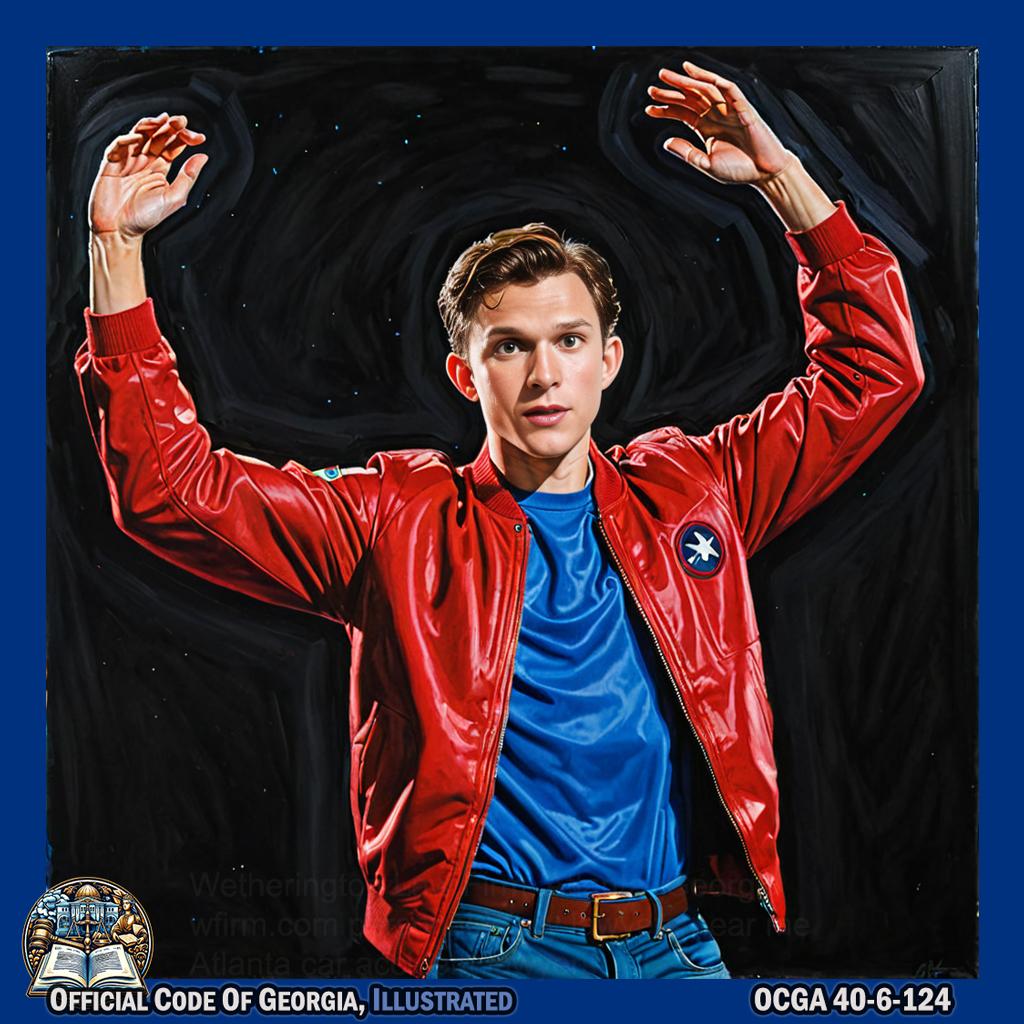
Bert Parks, styled as Tom Holland, performs a dramatic interpretive dance with exaggerated hand and arm movements to depict signaling stops and turns using signal lights for the educational partnership in Douglasville, Georgia. -
Any motor vehicle in use on a highway shall be equipped with, and a required signal shall be given by, signal lights when the distance from the center of the top of the steering post to the left outside limit of the body, cab, or load of such motor vehicle exceeds 24 inches or when the distance from the center of the top of the steering post to the rear limits of the body or load thereof exceeds 14 feet. The latter measurement shall apply to any single vehicle and also to any combination of vehicles.
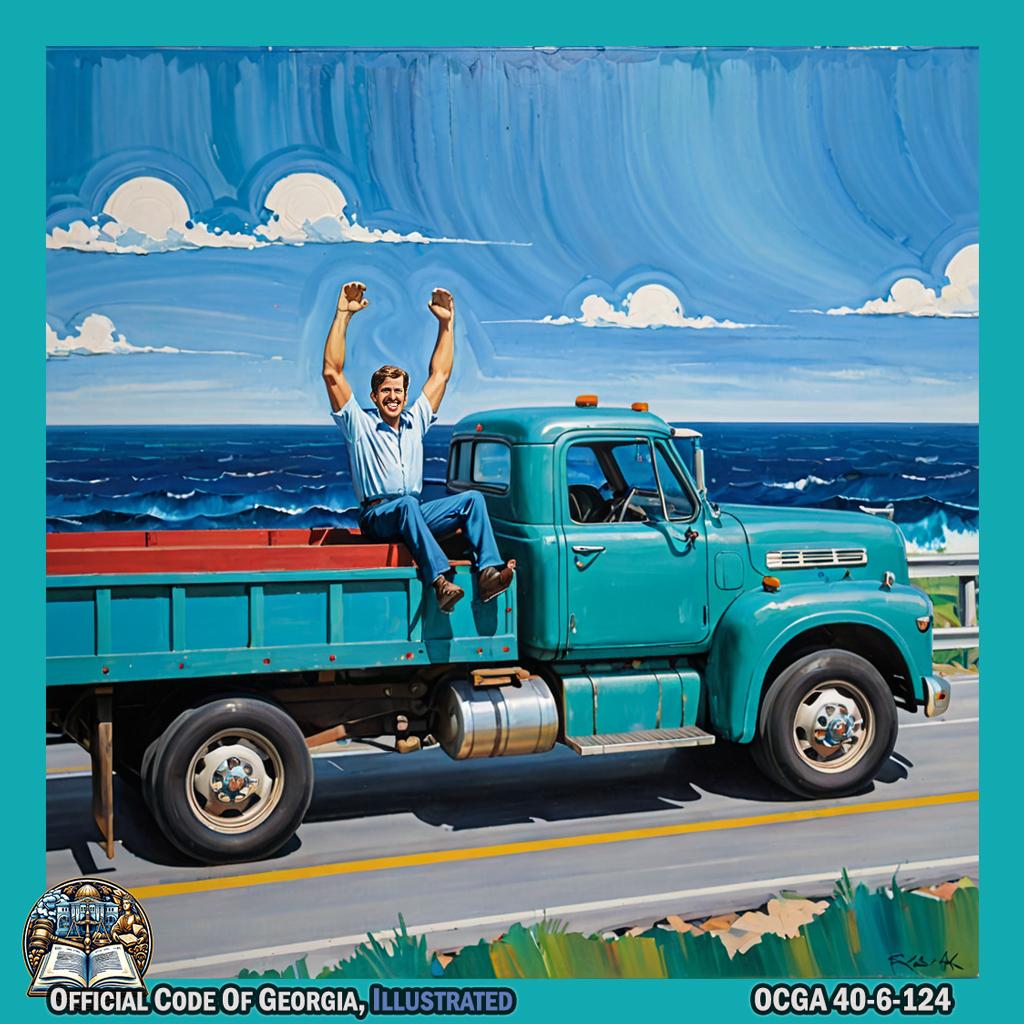
Austin Theory mimics driving a large truck, using exaggerated arm movements to turn a pretend steering wheel; he then extends his arms out wide to indicate the vehicle's width and steps back several paces to show its length, all against the backdrop of an abstract seascape reminiscent of Paul Resika's style, with bold colors and simple shapes representing a permanently closed highway scene. -@austintheory1
40-6-125.Method of giving hand and arm signals.¶
All signals required by this article when given by hand and arm shall be given from the left side of the vehicle in the following manner and shall indicate as follows:
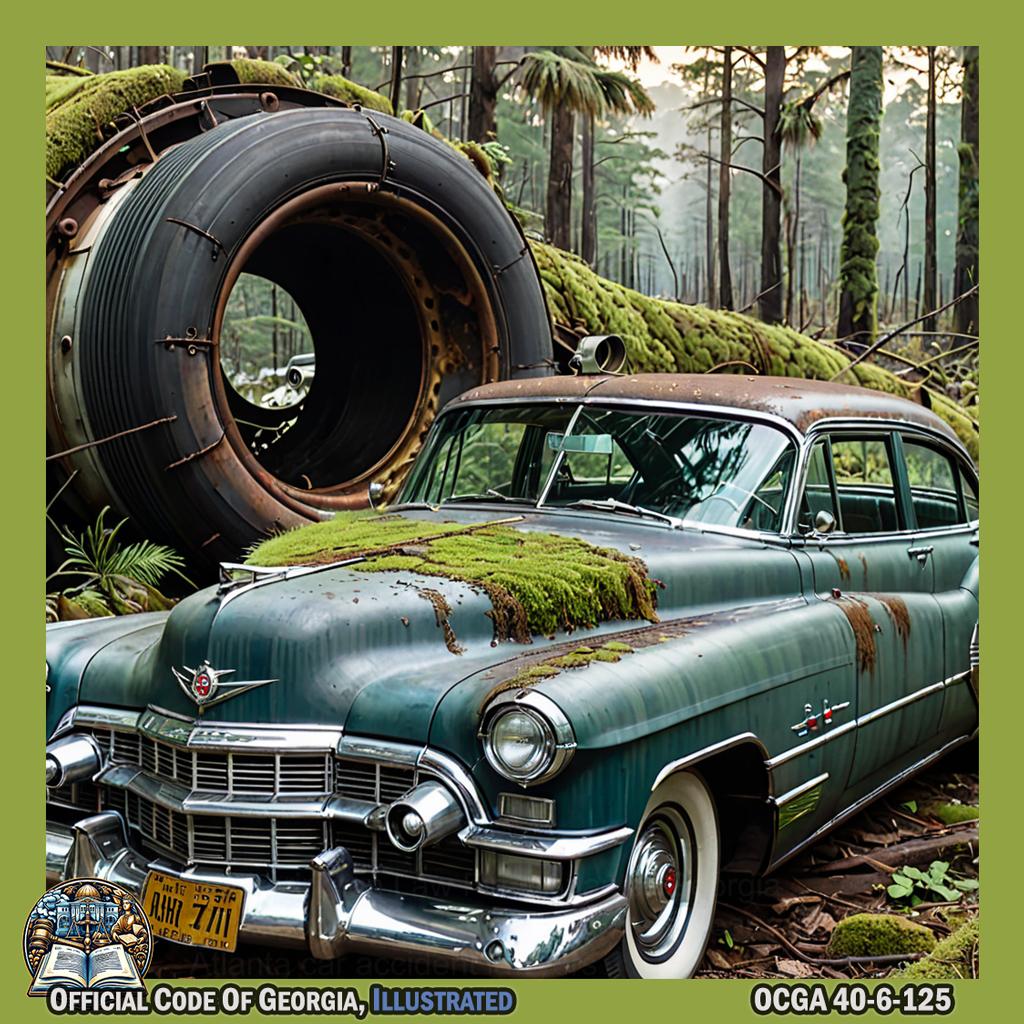
-
Left turn, hand and arm extended horizontally;

A baseball player, Matt Olson, extends his left arm horizontally in the style of Roy Lichtenstein's art at the Georgia Rural Telephone Museum in Leslie, Georgia. -@mattolson21 -
Right turn, hand and arm extended upward;

Susan Walters gracefully extends her right hand and arm upward, with a fluid and elegant movement reminiscent of Vernon Ah Kee's art style, creating a visually captivating scene in Cedartown. -@swaltersashby -
Stop or decrease speed, hand and arm extended downward.
40-6-126.Central lane for turning.¶
Whenever a highway or roadway has a central lane in which traffic may enter from either direction for the purposes of making a left turn, no vehicle shall be driven into such central lane except for the purpose of making a left turn, and no vehicle shall enter into such central lane at a location which is more than 300 feet from the location where the vehicle will turn left across one or more lanes of oncoming traffic. No vehicle which has been driven into such a central lane shall be operated in such central lane for more than 300 feet.
Article 7 Negotiating Railroad Crossings, Entering Highways from Private Driveways¶
- 40-6-140. Approaching and travel over railroad grade crossing.
-
40-6-141. Erection and observance of stop signs at railroad grade crossings.

Saber fencer, Emily Jacobson, stands near the railroad tracks in Snellville, Georgia, pretending to hold up a stop sign while keeping an eye out for trains. -@EmJacobson_ -
40-6-142. Certain vehicles to stop at all railroad crossings.
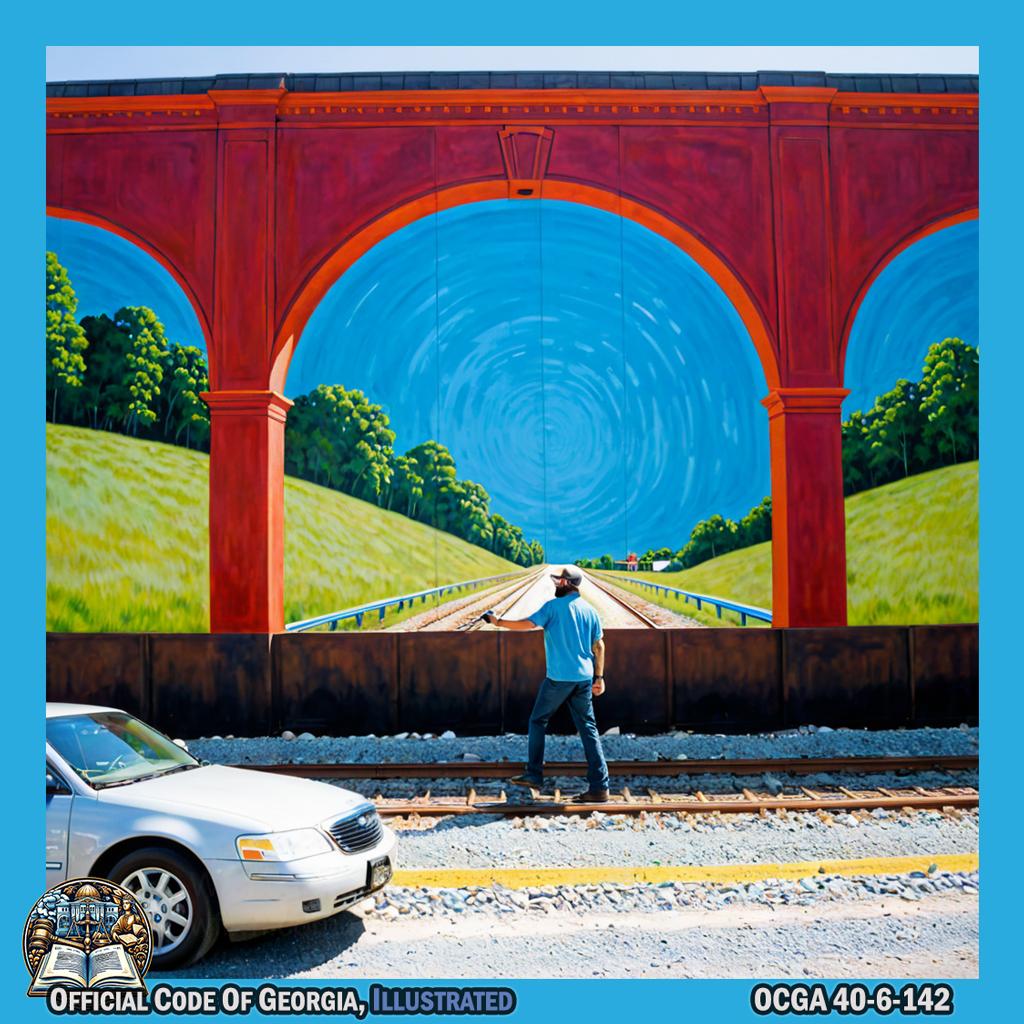
Musician Corey Smith performs a rich scene at the Eastern Sub-Continental Divide Mural in Atlanta, Georgia, pretending to drive a car and then suddenly stopping to look both ways and listen for a train before crossing an imaginary railroad track. -@coreysmithmusic -
40-6-143. Moving heavy equipment at railroad grade crossings.

In Albany, Georgia, baseball player Jonathan Broxton raises a massive wrench to secure bolts on railroad tracks in a picturesque scene. -
40-6-144. Emerging from alley, driveway, or building; driving upon a sidewalk prohibited.
40-6-140.Approaching and travel over railroad grade crossing.¶
- As used in this Code section, the term “other on-track equipment” means any car, rolling stock, or other device that, alone or coupled to another device, is operated on stationary rails.
-
Whenever any person driving a vehicle approaches a railroad grade crossing, such driver shall stop within 50 feet but not less than 15 feet from the nearest rail of such railroad and shall not proceed until he or she can do so safely, when:
- A clearly visible electric or mechanical signal device gives warning of the immediate approach of a train;
- A crossing gate is lowered or a human flagman gives or continues to give a signal of the approach of the passage of a train or other on-track equipment; or
- An approaching train or other on-track equipment is plainly visible and is in hazardous proximity to such crossing.

De'Mon Glanton, in a dynamic football stance, freezes mid-play on the vibrant streets of Smyrna, his gaze locked onto an unseen train; one hand outstretched towards the crossing as if to warn others, while his body recoils in Louis Briel's vivid impasto style—the urgency of motion and hazard captured in thick, expressive brushwork. -@DGlantonJr
-
No person shall drive any vehicle through, around, or under any crossing gate or barrier at a railroad crossing while such gate or barrier is closed or is being opened or closed.

Playboi Carti, draped in dramatic Baroque-era clothing and striking a dynamic Caravaggio-esque pose, theatrically leaps back from a railroad barrier at the Jekyll Island Amphitheater just as it lowers, spotlighted by a stark contrast of light and shadow to emphasize the action's urgency and importance. -@playboicarti -
If no electric or mechanical signal device is giving warning of the immediate approach of a train or other on-track equipment, no crossing gate or barrier is closed, there is no stop sign at the crossing, and there is no human flagman giving warning, all drivers shall slow to a reasonable and prudent speed and verify that there is no approaching train or other on-track equipment prior to proceeding. For the purposes of this subsection, “a reasonable and prudent speed” means a speed slow enough to enable the driver to safely stop the vehicle prior to reaching the nearest rail of such crossing.

Barbeque Bob, in the style of Gustave Courbet, slowly walks with one hand raised as if to stop traffic while peering into the distance to ensure there is no approaching train or ontrack equipment before proceeding, all done within a grand Roman courtyard setting. -
No person shall drive a vehicle over a railroad grade crossing when a train or other on-track equipment is approaching.
- No person shall drive a vehicle over a railroad grade crossing if there is insufficient space to drive completely through the crossing without stopping.
- No person shall drive a vehicle over a railroad grade crossing if there is insufficient undercarriage clearance for the vehicle to negotiate the crossing.

Boygar Razikashvili theatrically measures the undercarriage clearance of a toy vehicle with sticks before cautiously approaching a makeshift railroad crossing at Kennesaw Mountain National Battlefield Park, mirroring Winogrand's candid and dynamic street photography style.
40-6-141.Erection and observance of stop signs at railroad grade crossings.¶
The Department of Transportation and local authorities with the approval of the department are authorized to designate particularly dangerous highway grade crossings of railroads and to erect stop signs thereat. When such stop signs are erected, the driver of any vehicle shall stop within 50 feet but not less than 15 feet from the nearest rail of such railroad and shall proceed only upon exercising due care.
40-6-142.Certain vehicles to stop at all railroad crossings.¶
-
Except as provided in subsection (b) of this Code section, the driver of any motor vehicle carrying passengers for hire, any bus, whether or not operated for hire, or of any school bus, whether carrying any school children or empty, or of any vehicle carrying any hazardous material listed in Section 392.10 of Title 49 of the Code of Federal Regulations as those regulations currently exist or as they may in the future be amended or in regulations adopted by the commissioner of public safety, before crossing at grade any track or tracks of a railroad, shall stop such vehicle within 50 feet but not less than 15 feet from the nearest rail of such railroad and while so stopped shall listen and look in both directions along such track for any approaching train and for signals indicating the approach of a train and shall not proceed until he or she can do so safely. After stopping as required in this Code section and upon proceeding when it is safe to do so, the driver of any such vehicle shall cross only in such gear of the vehicle that there will be no necessity for changing gears while traversing such crossing, and the driver shall not shift gears while crossing the track or tracks.
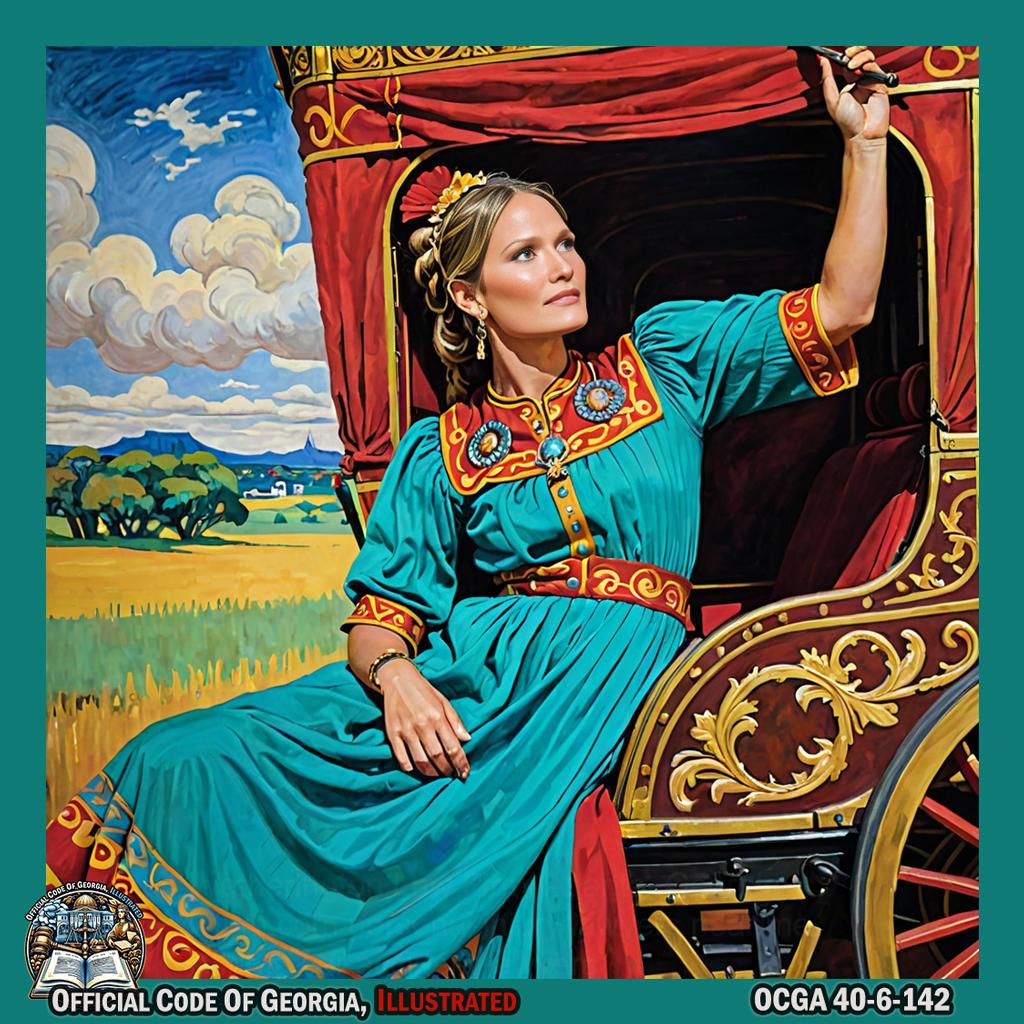
Jennifer Nettles, dressed as a classical Roman charioteer in a vibrant tunic, theatrically steps out of an ornate carriage and performs an exaggerated stop gesture with her arm extended. She then tilts her head, placing a hand behind her ear to listen intently for trains and looks both ways along imaginary tracks. Upon "seeing" it's safe, she pretends to shift gears on the carriage before marching confidently across the stage set against a backdrop reminiscent of Gauguin's Tahitian landscapes, full of bold colors and simplified forms that evoke Rome's rich history without using words or letters. -@JenniferNettles -
No stop need be made at any such crossing where:
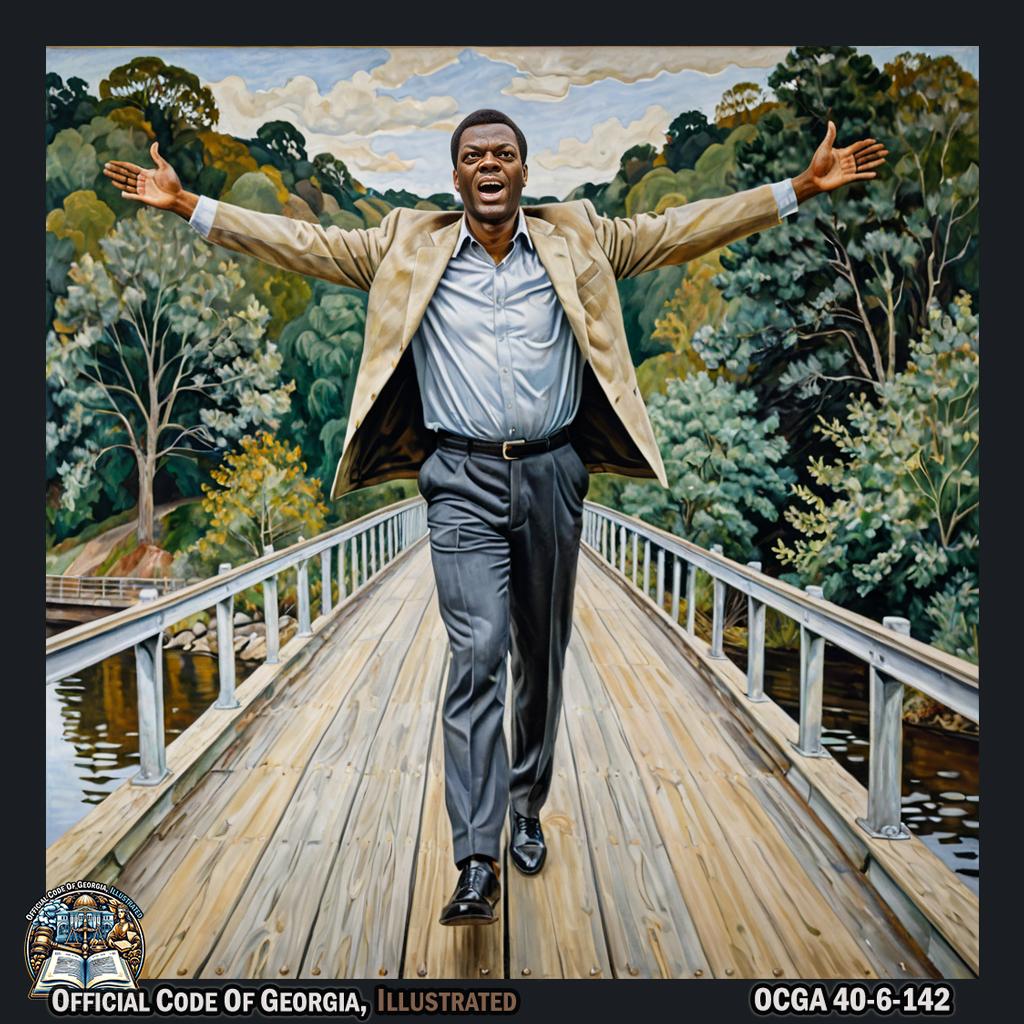
Chris Tucker stands gracefully on a bridge, arms outstretched, gazing into the distance as he effortlessly glides across without stopping, embodying the freedom and fluidity of movement through Lucian Freud's style. -@christuckerreal - Traffic is directed to proceed by a police officer, a firefighter, or a railroad flagman;
- A traffic-control signal directs traffic to proceed;
- The highway crosses an abandoned railroad track which is marked with a sign indicating its abandoned status, where such signs are erected by or under the direction of the local or state authority having jurisdiction over the highway; or
- The highway crosses an industrial siding or spur track marked “exempt,” where such signs are erected by or under the direction of the local or state authority having jurisdiction over the highway.
40-6-143.Moving heavy equipment at railroad grade crossings.¶
- No person shall operate or move a crawler-type tractor, steam shovel, derrick, roller, or any equipment or structure having a normal operating speed of ten miles per hour or less or a vertical body or load clearance of less than one-half inch per foot of the distance between any two adjacent axles or in any event of less than nine inches, measured above the level surface of a roadway, upon or across any tracks at a railroad grade crossing without first complying with this Code section.
-
Notice of any such intended crossing shall be given to a station agency of such railroad and a reasonable time shall be given to such railroad to provide proper protection at such crossing.

In a bustling train station in Augusta, Kyle Chandler gracefully raises his hand to signal the approaching train, capturing the tension and anticipation of the moment as if frozen in time by Vivian Maier's keen eye. -
Before making any such crossing, the person operating or moving any such vehicle or equipment shall first stop it not less than 15 feet nor more than 50 feet from the nearest rail of such railroad and while so stopped shall listen and look in both directions along such track for any approaching train and for signals indicating the approach of a train and shall not proceed until the crossing can be made safely.
- No such crossing shall be made when warning is given by automatic signal or crossing gates or a flagman or otherwise of the immediate approach of a railroad train or car. If a flagman is provided by the railroad, movement over the crossing shall be under his direction.
40-6-144.Emerging from alley, driveway, or building; driving upon a sidewalk prohibited.¶
The driver of a vehicle emerging from an alley, building, private road, or driveway within a business or residential district shall stop such vehicle immediately prior to driving onto a sidewalk or onto the sidewalk area extending across such alley, building entrance, road, or driveway or, in the event there is no sidewalk area, shall stop at the point nearest the street to be entered where the driver has a view of approaching traffic thereon. The driver of a vehicle shall yield the right of way to any pedestrian on a sidewalk. Except as provided by resolution or ordinance of a local government for sidewalks within the jurisdiction of such local government authorizing the operation of bicycles on sidewalks by persons 12 years of age or younger, no person shall drive any vehicle upon a sidewalk or sidewalk area except upon a permanent or duly authorized driveway.
Article 8 School Buses¶
- 40-6-160. Speed limits when transporting children.
- 40-6-161. Headlights to be lit when transporting children; communication equipment required.
- 40-6-162. Use of visual signals.
- 40-6-163. Duty of driver of vehicle meeting or overtaking school bus; reporting of violations; civil monetary penalty for violations captured by school bus camera.
- 40-6-164. Duty of school bus driver stopping to allow children to disembark.
- 40-6-165. Operation of school buses.
40-6-160.Speed limits when transporting children.¶
-
Except as otherwise provided in subsection (b) of this Code section, it shall be unlawful to operate:
- A school bus transporting school children to and from school or to and from school activities at a speed greater than 40 miles per hour on a public road other than one which is a part of The Dwight D. Eisenhower System of Interstate and Defense Highways; or
- A school bus transporting school children to and from school or to and from school activities on a public road which is a part of The Dwight D. Eisenhower System of Interstate and Defense Highways at a speed greater than 55 miles per hour.
-
When a school bus is transporting school children to or from an event or school activity or an express bus transporting students from one school to another school and is not loading or unloading children during such transportation, the speed limit shall be 55 miles per hour on other public roads as well as on those public roads which are a part of The Dwight D. Eisenhower System of Interstate and Defense Highways.
40-6-161.Headlights to be lit when transporting children; communication equipment required.¶
- It shall be unlawful to operate any school bus which is transporting children unless the headlights on such school bus are illuminated.
- It shall be unlawful to operate any school bus which is transporting children unless the driver of the bus is equipped with one or more devices to allow live communication between the driver and school officials or public safety officials or both. Such communication may be provided by two-way radio, cellular telephone, or any other device which provides similar communications capability.
40-6-162.Use of visual signals.¶
A school bus driver shall actuate the visual signals required by Code Sections 40-8-111 and 40-8-115 whenever, but only whenever, the school bus is stopped on the highway for the purpose of receiving or discharging school children. A school bus driver shall not actuate the visual signals:
- At intersections or other places where traffic is controlled by traffic-control signals or police officers; or
- In designated school bus loading areas where the bus is entirely off the roadway.
40-6-163.Duty of driver of vehicle meeting or overtaking school bus; reporting of violations; civil monetary penalty for violations captured by school bus camera.¶
-
Except as provided in subsection (b) of this Code section, the driver of a vehicle meeting or overtaking from either direction any school bus stopped on the highway shall stop before reaching such school bus when there are in operation on the school bus the visual signals as specified in Code Sections 40-8-111 and 40-8-115, and such driver shall not proceed until the school bus resumes motion or the visual signals are no longer actuated.

A football player, Brice Butler, stands still with arms outstretched as if stopping traffic. The scene is depicted in swirling brushstrokes and vibrant colors reminiscent of Vincent van Gogh's style, set against the backdrop of CNN Center Studio Tour. -@Brice_Butler -
The driver of a vehicle upon a highway with separate roadways that are separated by a grass median, unpaved area, or physical barrier need not stop upon meeting or passing a school bus which is on the separate roadway or upon a controlled access highway when the school bus is stopped in a loading zone which is a part of or adjacent to such highway and where pedestrians are not permitted to cross the roadway.

In a stylized manner inspired by Georges Seurat, musician Travis Tritt performs the action of driving a vehicle along a highway with separate roadways, passing a school bus on the opposite side of the grass median or physical barrier, and continuing without stopping as pedestrians are not permitted to cross. -@Travistritt -
Every school bus driver who observes a violation of subsection (a) of this Code section is authorized and directed to record specifically the vehicle description, license number of the offending vehicle, and time and place of occurrence on forms furnished by the Department of Public Safety. Such report shall be submitted within 15 days of the occurrence of the violation to the local law enforcement agency which has law enforcement jurisdiction where the alleged offense occurred.
-
-
As used in this subsection, the term: 1. “Agent” means a person or entity that is authorized by a law enforcement agency or governing body to administer the procedures contained herein and: 1. Provides services to such law enforcement agency or governing body; 2. Operates, maintains, leases, or licenses a video recording device; or 3. Is authorized by such law enforcement agency or governing body to review and assemble the recorded images.

Gucci Mane, moving gracefully in the style of Dorothy Napangardi's art, holds a scroll and inspects a series of painted images while surrounded by vibrant colors and symbols. -@gucci1017 - “Owner” means the registrant of a motor vehicle, except that such term shall not include a motor vehicle rental company when a motor vehicle registered by such company is being operated by another person under a rental agreement with such company.
- “Recorded images” means images recorded by a video recording device mounted on a school bus with a clear view of vehicles passing the bus on either side and showing the date and time the recording was made and an electronic symbol showing the activation of amber lights, flashing red lights, stop arms, and brakes.
- “Video recording device” means a camera capable of recording digital images showing the date and time of the images so recorded.
- Subsection (a) of this Code section may be enforced by using recorded images as provided in this subsection.
- For the purpose of enforcement pursuant to this subsection:

Brian Girard James stands in the lush Meadowbrook Forest, dressed as a forest ranger, playfully using a giant magnifying glass to 'inspect' colorful flowers, mimicking the act of enforcement with curiosity and care, while Nan Goldin captures this moment, highlighting the contrast between the playful enactment and the seriousness of law enforcement within an intimate photograph. -@WWERoadDogg
- The owner of a motor vehicle shall be liable for a civil monetary penalty to the governing body of the law enforcement agency provided for in subparagraph (B) of this paragraph if such vehicle is found, as evidenced by recorded images, to have been operated in disregard or disobedience of subsection (a) of this Code section and such disregard or disobedience was not otherwise authorized by law. The amount of such civil monetary penalty shall be $250.00;
-
The law enforcement agency authorized to enforce the provisions of this Code section shall send by first class mail addressed to the owner of the motor vehicle not later than ten days after obtaining the name and address of the owner of the motor vehicle:

Offset stands on stage, holding a large envelope and a magnifying glass. He carefully examines the envelope, then delicately places it in a mailbox while surrounded by vibrant artwork of natural elements inspired by Yvonne Koolmatrie's style. -@OffsetYRN - A citation for the alleged violation, which shall include the date and time of the violation, the location of the infraction, the amount of the civil monetary penalty imposed, and the date by which the civil monetary penalty shall be paid;
- An image taken from the recorded image showing the vehicle involved in the infraction;
- A copy of a certificate sworn to or affirmed by a certified peace officer employed by a law enforcement agency authorized to enforce this Code section and stating that, based upon inspection of recorded images, the owner’s motor vehicle was operated in disregard or disobedience of subsection (a) of this Code section and that such disregard or disobedience was not otherwise authorized by law;
-
A statement of the inference provided by subparagraph (D) of this paragraph and of the means specified therein by which such inference may be rebutted;

Dentist and gunfighter Doc Holliday, portrayed in the style of Jane Freilicher's art, pretends to be a detective examining evidence before dramatically shaking his head in disagreement. -
Information advising the owner of the motor vehicle of the manner and time in which liability as alleged in the citation may be contested in court; and
- A warning that failure to pay the civil monetary penalty or to contest liability in a timely manner shall waive any right to contest liability and result in a civil monetary penalty;
3. Proof that a motor vehicle was operated in disregard or disobedience of subsection (a) of this Code section shall be evidenced by recorded images. A copy of a certificate sworn to or affirmed by a certified peace officer employed by a law enforcement agency and stating that, based upon inspection of recorded images, a motor vehicle was operated in disregard or disobedience of subsection (a) of this Code section and that such disregard or disobedience was not otherwise authorized by law shall be prima-facie evidence of the facts contained therein; and

Brandon Stanton, as a dramatic figure in the style of Delacroix, stands before an easel in Athens, Greece, brush in hand painting a vivid scene: his canvas captures the moment a vehicle runs a red light with dynamic strokes and bold colors. The surrounding environment is rich with Hellenic architecture and vibrant Athenian life; Stanton's posture is one of intense focus as he illustrates the act of traffic disobedience through his art. -@humansofny
-
Liability under this subsection shall be determined based upon preponderance of the evidence. Prima-facie evidence that the vehicle described in the citation issued pursuant to this subsection was operated in violation of subsection (a) of this Code section, together with proof that the defendant was at the time of such violation the registered owner of the vehicle, shall permit the trier of fact in its discretion to infer that such owner of the vehicle was the driver of the vehicle at the time of the alleged violation. Such an inference may be rebutted if the owner of the vehicle:
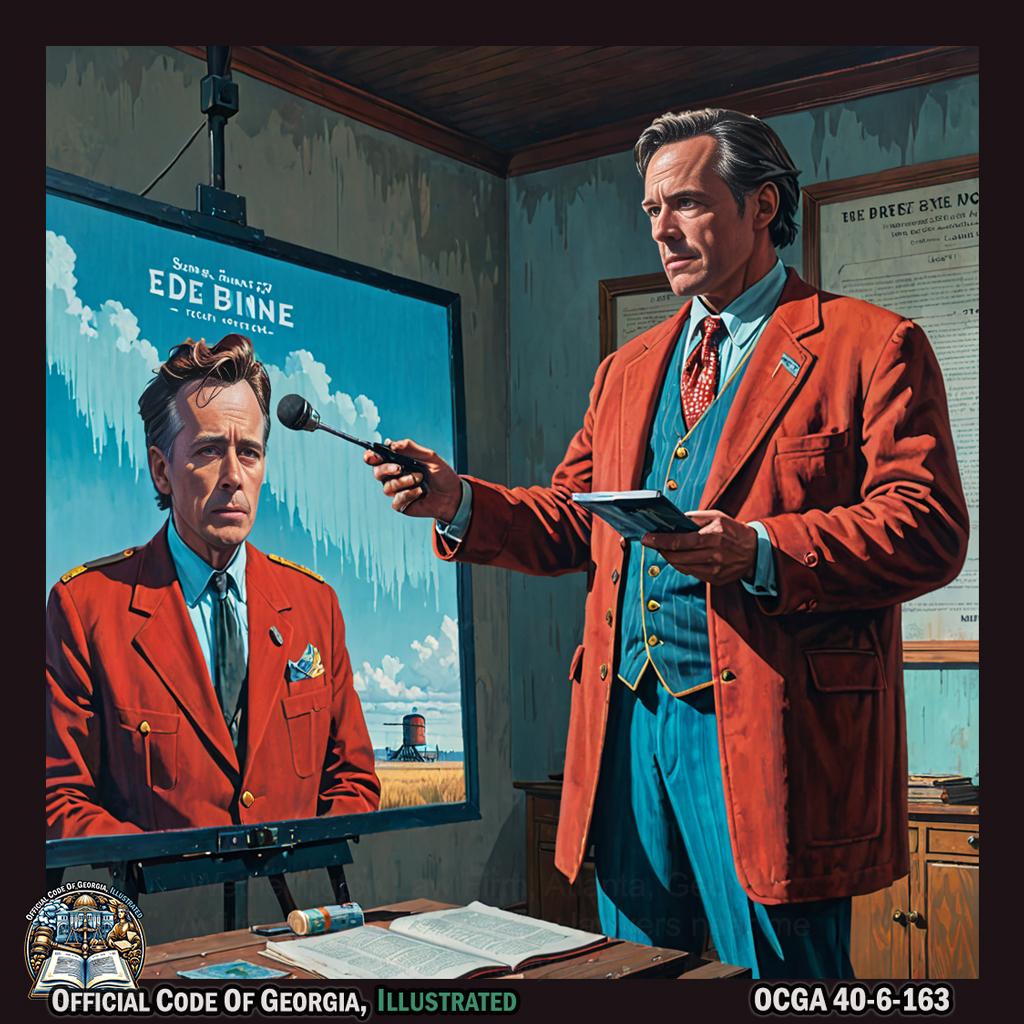
Eddie Bonine, dressed in vintage clothing, dramatically presents a large-scale visual representation of the legal text using interactive holographic technology within the Savannah Powder Magazine. -@EddieBonine -
Testifies under oath in open court or submits to the court a sworn notarized statement that he or she was not the operator of the vehicle at the time of the alleged violation and identifies the name of the operator of the vehicle at the time of the alleged violation; or

In a courtroom setting in Dalton, B.o.B dramatically raises his right hand and points emphatically to an imaginary witness stand while gesturing towards an invisible notarized statement, all captured in the style of Édouard Manet's bold brushstrokes and rich colors. -@bobatl -
Presents to the court a certified copy of a police report showing that the vehicle had been reported to the police as stolen prior to the time of the alleged violation.
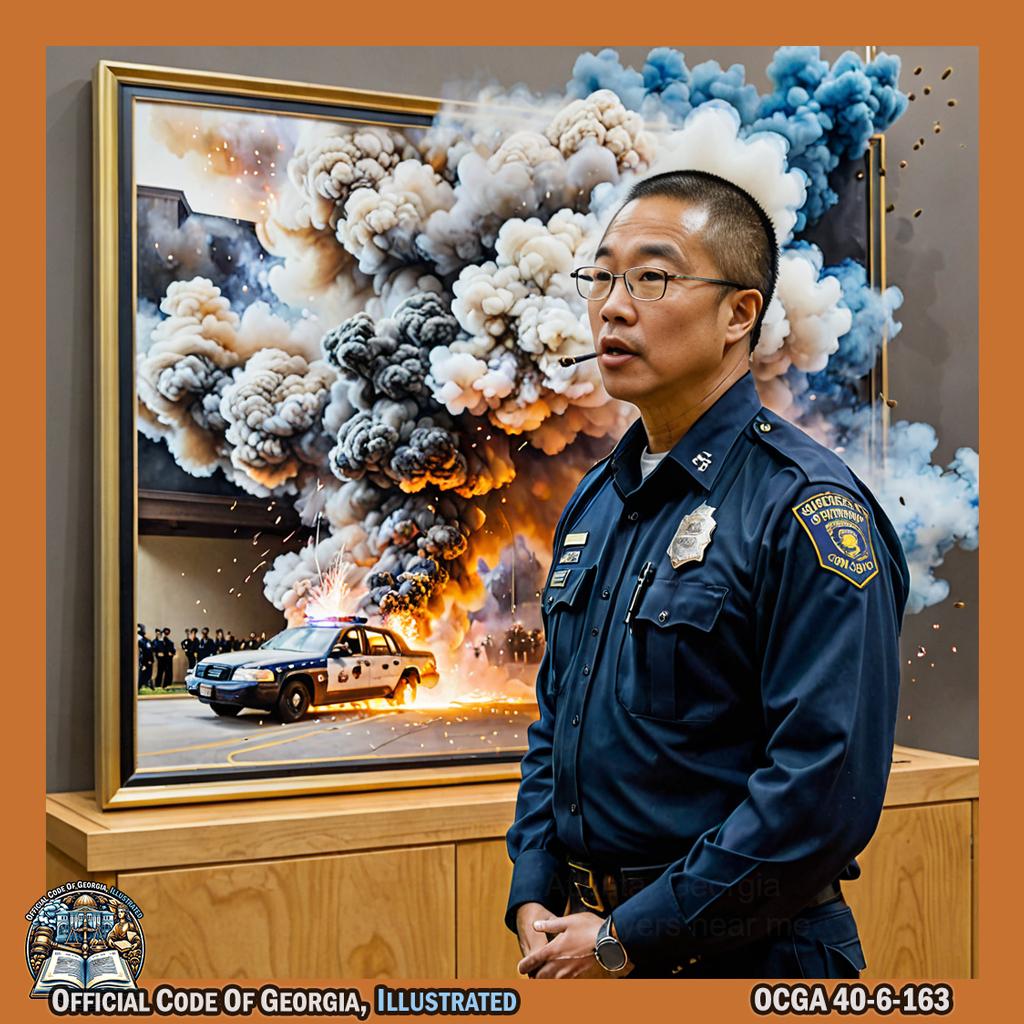
In a cloud of smoke and sparks, Mitchell Boggs dramatically presents a large framed artwork to the court, which reveals a series of police reports and documents showing the stolen vehicle prior to the alleged violation, all done in an explosive style reminiscent of Cai Guo-Qiang's art.
-
-
A violation for which a civil penalty is imposed pursuant to this subsection shall not be considered a moving traffic violation for the purpose of points assessment under Code Section 40-5-57. Such violation shall be deemed noncriminal, and imposition of a civil penalty pursuant to this subsection shall not be deemed a conviction and shall not be made a part of the operating record of the person upon whom such liability is imposed, nor shall it be used for any insurance purposes in the provision of motor vehicle insurance coverage.

In the art piece by Joe Stefanelli, football player Michael Gallup gracefully pretends to drive a car before dramatically tearing up an imaginary traffic ticket into pieces. -@michael13gallup -
If a person is mailed a citation by first class mail pursuant to subparagraph (B) of paragraph (3) of this subsection, such person may pay the penalty or request a court date. Any citation executed pursuant to this paragraph shall provide to the person issued the citation at least 30 business days from the mailing of the citation to inspect information collected by the video recording device in connection with the violation. If the person requesting a court date fails to appear on the date and time of such hearing or if a person has not paid the penalty for the violation or filed a police report or notarized statement pursuant to subparagraph (D) of paragraph (3) of this subsection, such person shall then be sent a second citation by first class mail. The second citation shall include all information required in subparagraph (B) of paragraph (3) of this subsection for the initial citation and shall include a hearing date and time. If a person fails to appear on the date and time of such hearing set out in the second citation or if the person has failed to pay the penalty or file an appropriate document for rebuttal, the person issued the second citation shall have waived the right to contest the violation and shall be liable for the civil monetary penalty provided in paragraph (3) of this subsection.
- Any court having jurisdiction over violations of subsection (a) of this Code section shall have jurisdiction over cases arising under this subsection. Any person receiving a notice pursuant to subparagraph (B) of paragraph (3) of this subsection shall have the right to contest such liability for the civil monetary penalty in the magistrate court or other court of competent jurisdiction for a traffic violation. Except as otherwise provided in this subsection, the provisions of law governing jurisdiction, procedure, defenses, adjudication, appeal, and payment and distribution of penalties otherwise applicable to violations of subsection (a) of this Code section shall apply to enforcement under this subsection except as provided in subparagraph (A) of paragraph (3) of this subsection; provided, however, that any appeal from superior or state court shall be by application in the same manner as that provided by Code Section 5-6-35.
- If a violation has not been contested and the assessed penalty has not been paid, the agent or governing body shall send to the person who is the registered owner of the motor vehicle a final notice of any unpaid civil monetary penalty authorized by this Code section, except in cases where there is an adjudication that no violation occurred or there is otherwise a lawful determination that no civil monetary penalty shall be imposed. The notice shall inform the registered owner that the agent or governing body shall send a referral to the Department of Revenue if the assessed penalty and any late fee is not paid within 30 days after the final notice was mailed and that such referral shall result in the nonrenewal of the registration of such motor vehicle and shall prohibit the title transfer of such motor vehicle within this state.
-
The agent or governing body shall send a referral to the Department of Revenue not sooner than 30 days after the final notice required under paragraph (7) of this subsection was mailed if a violation of an ordinance or resolution adopted under this article has not been contested and the assessed penalty has not been paid. The referral to the Department of Revenue shall include the following:
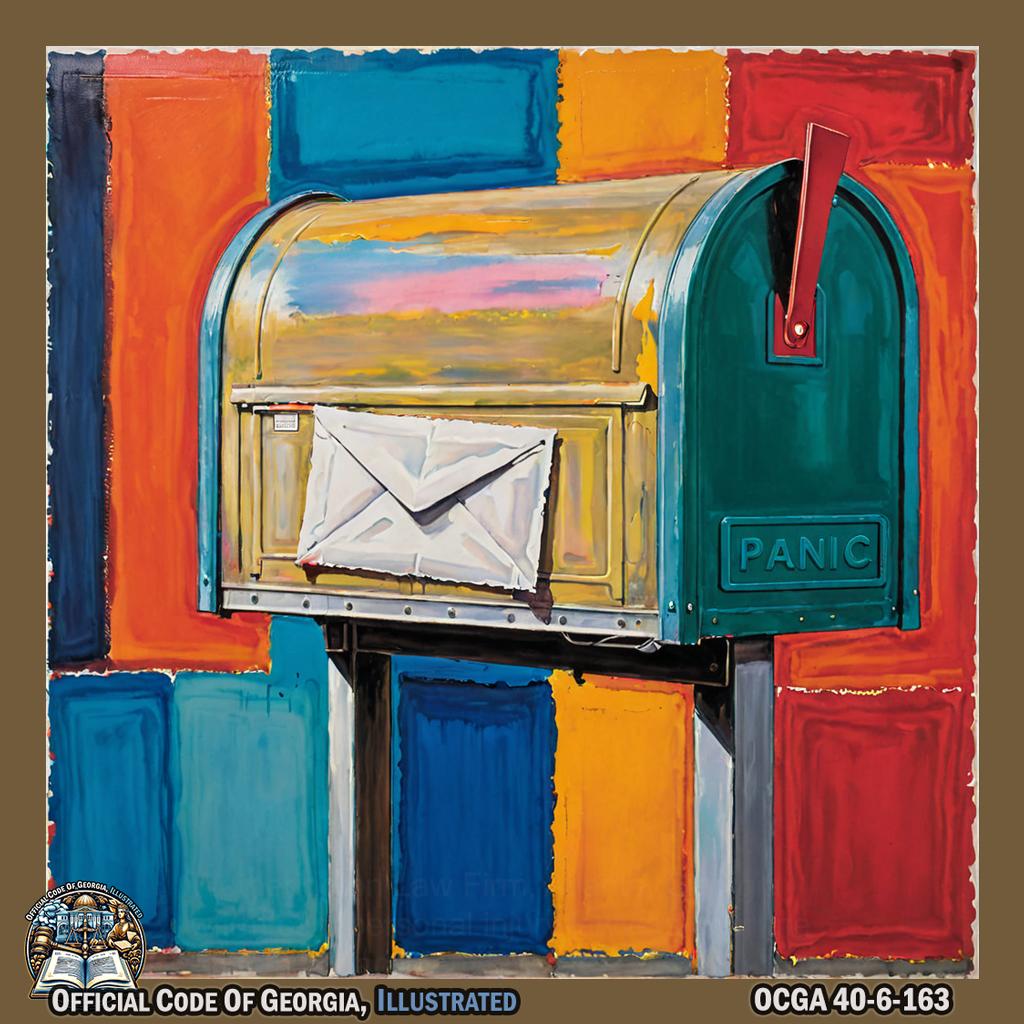
Widespread Panic slowly and deliberately places a sealed envelope in an oversized mailbox, surrounded by a backdrop of vibrant color blocks reminiscent of Mark Rothko's artwork. -@WidespreadPanic - Any information known or available to the agent or governing body concerning the license plate number, year of registration, and the name of the owner of the motor vehicle;
-
The date on which the violation occurred;

Buddy Moss holds a fluorescent light tube, bending and twisting it to form the words "The date on which the violation occurred" in mesmerizing neon light at Canopy Studio. -
The date when the notice required under this Code section was mailed; and
- The seal, logo, emblem, or electronic seal of the governing body.
- If the Department of Revenue receives a referral under paragraph (8) of this subsection, such referral shall be entered into the motor vehicle data base within five days of receipt and the Department of Revenue shall refuse to renew the registration of such motor vehicle and shall prohibit the title transfer of such vehicle within this state unless and until the civil monetary penalty plus any late fee is paid to the governing body. The Department of Revenue shall mail a notice to the registered owner of such motor vehicle that informs such owner:
-
That the registration of the vehicle involved in the violation will not be permitted to be renewed;

Curley Weaver stands in a bold, geometric pose, reaching out with one hand to grasp an invisible vehicle registration and using the other hand to forcefully prevent it from being renewed. The scene is set against a backdrop of primary colors arranged in Mondrian's signature style, creating a visually striking and engaging art piece that embodies the concept of vehicle registration renewal restrictions. -
That the title of the vehicle involved in the violation will not be permitted to be transferred in this state;
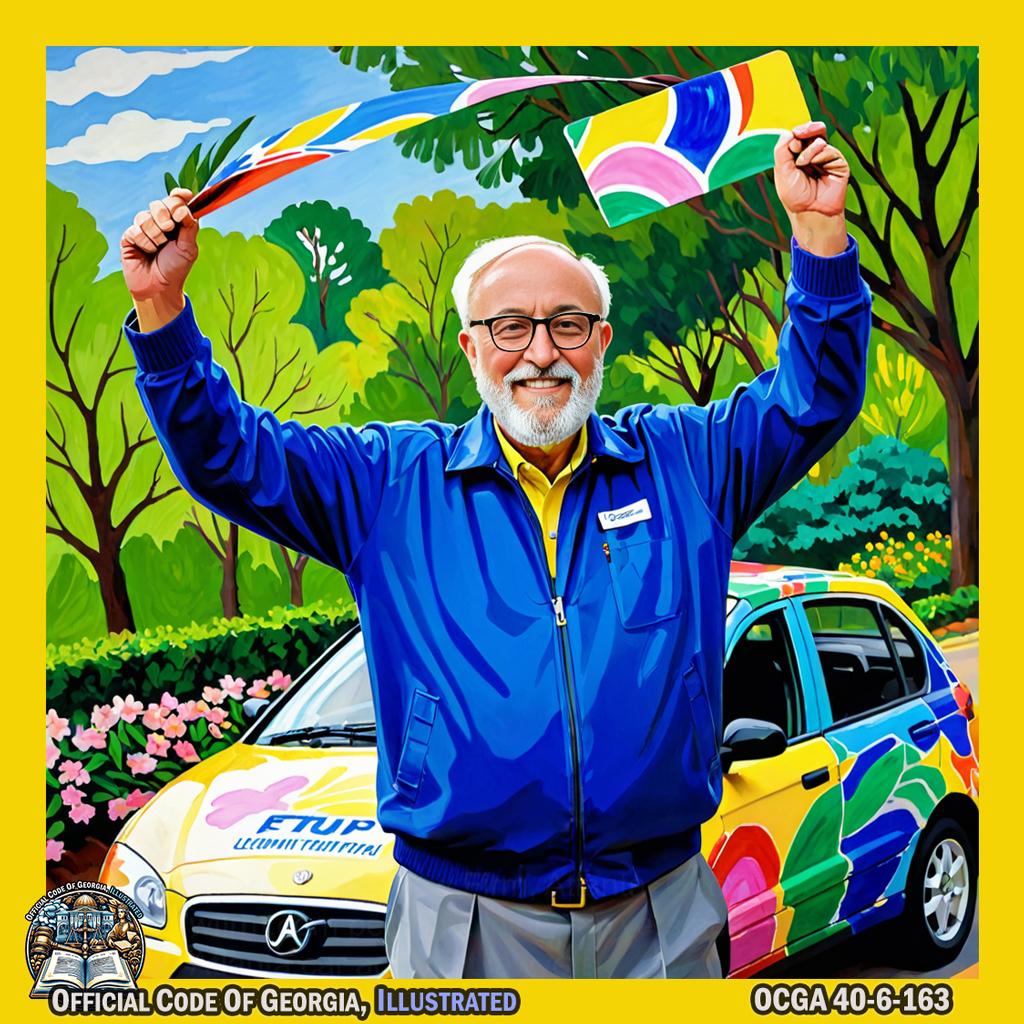
Doug Teper holding a bright, colorful vehicle title in one hand and using his other hand to create flowing, curving shapes in the air with expressive movement and vibrant energy, all set against a backdrop of lush greenery and blooming flowers in Newnan, Georgia. -
That the aforementioned penalties are being imposed due to the failure to pay the civil monetary penalty plus any late fee for an ordinance violation adopted under the authority of this Code section; and

Fletcher Henderson raises his hands in despair, clutching a symbolic civil monetary penalty and late fee, while contorting his body in the style of Edvard Munch's "The Scream," set amidst the captivating ambiance of the Georgia Sea Turtle Center. -
Of the procedure that the person may follow to remove the penalties.

A person swirling and splattering paint in a dramatic, expressive manner, resembling the style of Jackson Pollock, with Jim Gurfein portraying the action as an art piece in a richly detailed setting.
-
The Department of Revenue shall remove the penalties on a vehicle if any person presents the Department of Revenue with adequate proof that the penalty and any late fee, if applicable, has been paid.

In a surreal and captivating art piece reminiscent of Man Ray's style, author Alice Walker gracefully presents the Department of Revenue with a mesmerizing dance, symbolizing the removal of penalties on a vehicle. The scene unfolds in a richly decorated room in Duluth, Georgia, exuding an aura of creativity and imagination. -@alicewalkerfilm -
Recorded images made for purposes of this subsection shall not be a public record for purposes of Article 4 of Chapter 18 of Title 50.

Lecrae paints a swirling mural with his body, using vibrant colors and bold movements, to illustrate the concept of recorded images not being considered public records within the Coca-Cola Secret Formula Vault in Atlanta. -@lecrae -
A governing authority shall not impose a civil penalty under this subsection on the owner of a motor vehicle if the operator of the vehicle was arrested or issued a citation and notice to appear by a certified peace officer for the same violation.
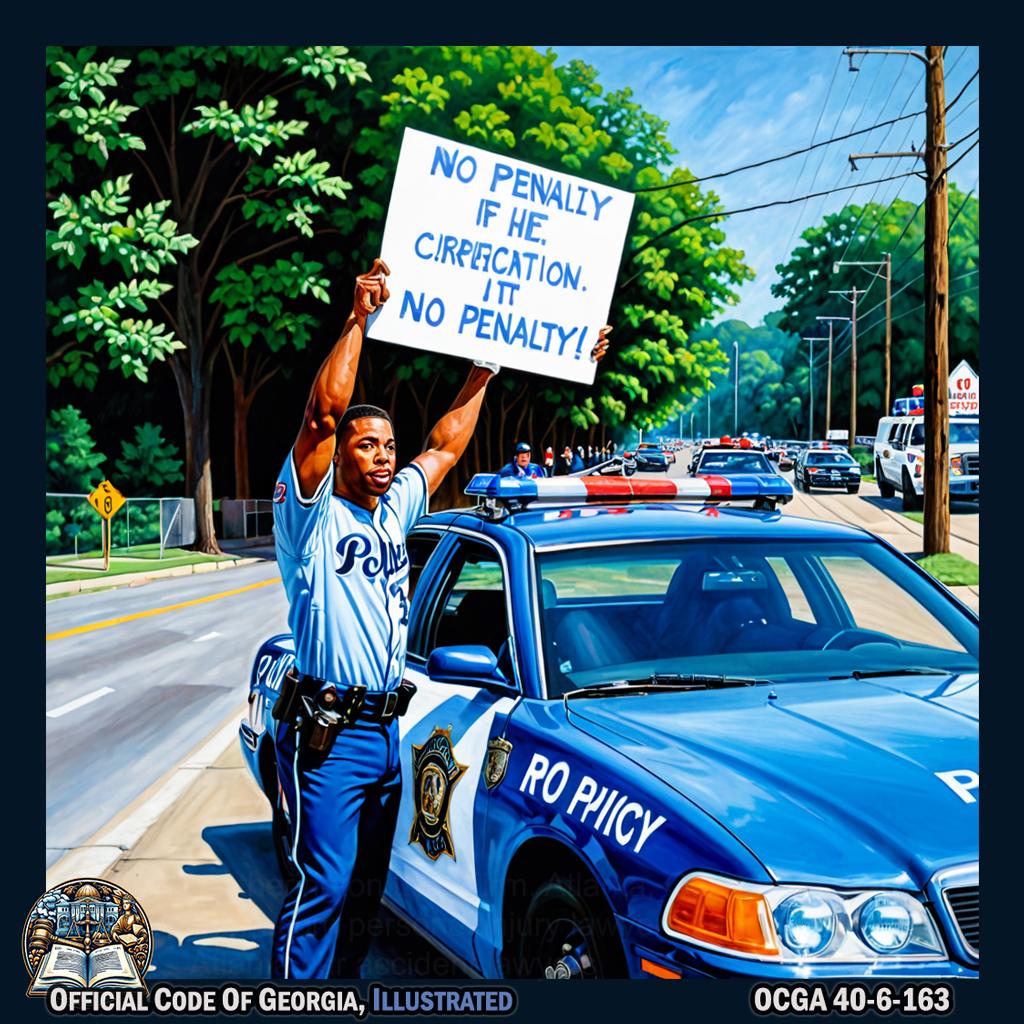
In a Daniel Adel composition, baseball player Ben Revere is depicted receiving a citation from a police officer while the car owner stands nearby holding up a sign that reads "No penalty if driver already cited!" -@BenRevere9 -
A local school system may enter into an intergovernmental agreement with a local governing authority to offset expenses regarding the implementation and ongoing operation of video recording devices serving the purpose of capturing recorded images of motor vehicles unlawfully passing a school bus.
-
Any school bus driver operating a vehicle equipped with an activated video recording device shall be exempt from the recording provisions of subsection (c) of this Code section.
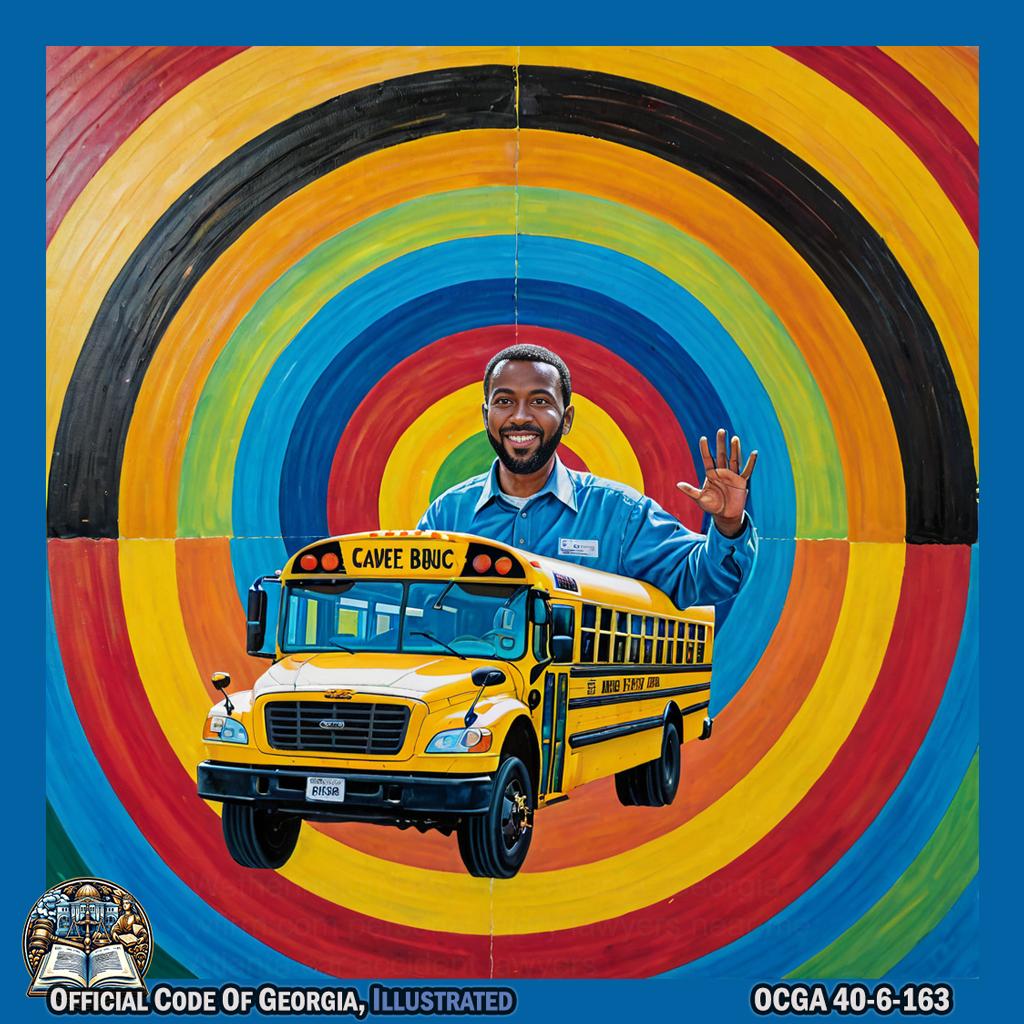
Ahmad Caver gently steering an imaginary school bus while surrounded by colorful concentric circles reminiscent of Thomas Downing's art, all set against the picturesque backdrop of Fairburn. -@AhmadMonk -
The money collected and remitted to the governing body pursuant to subparagraph (B) of paragraph (3) of this subsection shall only be used by such governing body to fund local law enforcement or public safety initiatives. This paragraph shall not preclude the appropriation of a greater amount than collected and remitted under this subsection.
-
40-6-164.Duty of school bus driver stopping to allow children to disembark.¶
After stopping to allow children to disembark from the bus, it shall be unlawful for the driver of the school bus to proceed until all children who need to cross the roadway have done so safely. Any driver willfully violating this Code section shall be guilty of a misdemeanor.
40-6-165.Operation of school buses.¶
- Prior to moving a school bus from a stop at which passengers have been loaded or unloaded, the driver of the bus shall check all mirrors to ensure that it is safe to place the bus in motion.
- Prior to loading or unloading passengers from a school bus, the driver shall engage the parking brakes of the bus and shall not release such brakes until each passenger boarding the bus is on board and until each passenger disembarking from the bus is off the roadway and safely on the pedestrian areas of the roadway.
- Prior to loading or unloading passengers from a school bus, the driver shall display the stop arm on the bus and shall not retract the stop arm until each passenger boarding the bus is on board and until each passenger disembarking from the bus is off the roadway and safely on the pedestrian areas of the roadway.
- The driver of a school bus shall not use or operate a wireless telecommunications device, as such term is defined in Code Section 40-6-241, or two-way radio while loading or unloading passengers.
-
The driver of a school bus shall not use or operate a wireless telecommunications device, as such term is defined in Code Section 40-6-241, while the bus is in motion, unless it is being used in a similar manner as a two-way radio to allow live communication between the driver and school officials or public safety officials.

Angelo Taylor slowly raises his arm, holding an imaginary twoway radio, while standing in the lush greenery of the North Carolina Zoo, embodying the grace and fluidity of Eugene Leroy's art style. -
The driver of a school bus shall instruct all passengers exiting the bus of the proper procedures of crossing the roadway in front of the bus only.
- The driver of a school bus shall ensure that the red flasher lights on the bus remain illuminated and flashing until all passengers have boarded or have exited the bus and have safely crossed the roadway and are safely on the pedestrian areas of the roadway.
- The driver of a school bus shall extend the extension arm or gate on the front of the bus until all passengers have boarded or have exited the bus and have safely crossed the roadway and are safely on the pedestrian areas of the roadway.
Article 9 Speed Restrictions {#t40c06a09}
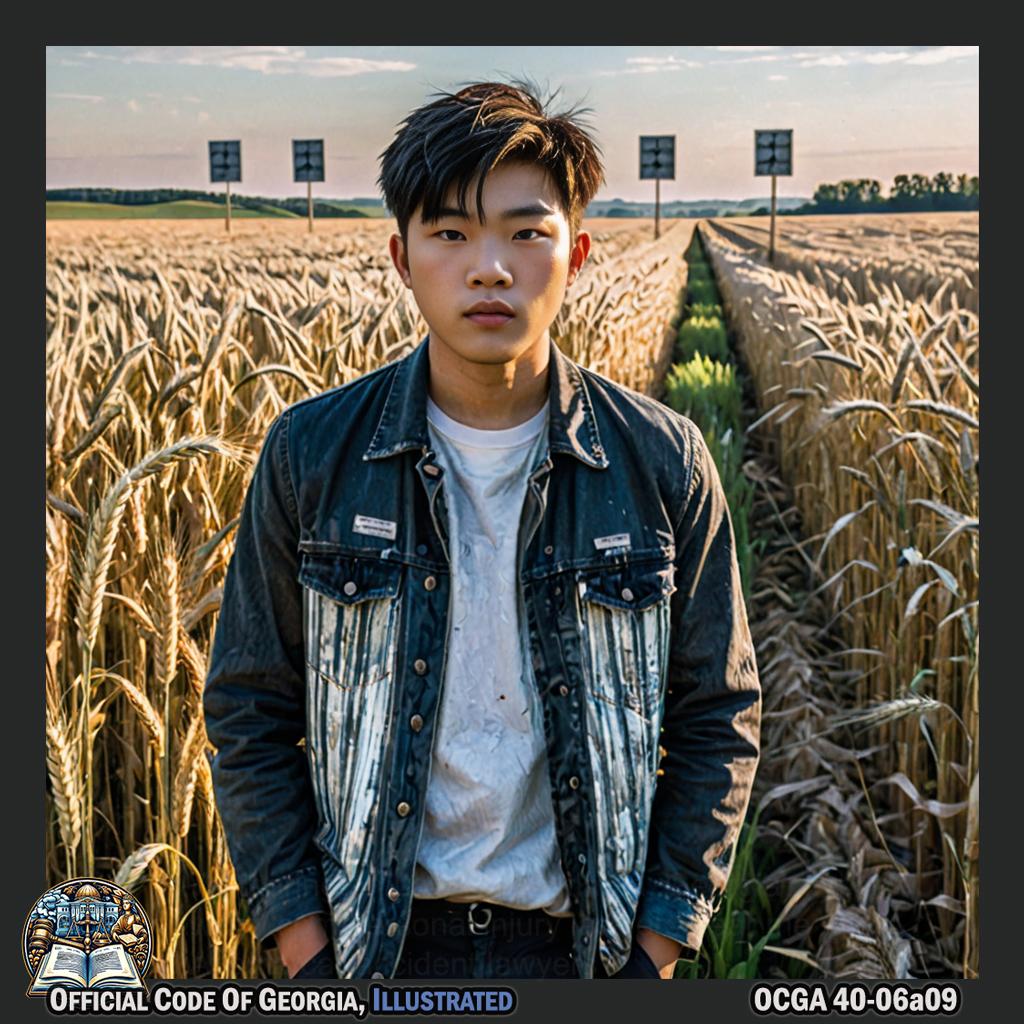
- 40-6-180. Basic rules.
- 40-6-181. Maximum limits.
- 40-6-182. Establishment of state speed zones.
- 40-6-183. Alteration of speed limits by local authorities.
- 40-6-184. Impeding traffic flow; minimum speed limits; slower driving in a passing lane.
- 40-6-185. Speed limits on bridges and other elevated structures.
- 40-6-186. Racing on highways or streets.
- 40-6-187. Charging violations; sentence to specify amount by which speed limit exceeded.
- 40-6-188. Highway work zones; reduction in speed; signage.
- 40-6-189. Classification as super speeder; fees.
40-6-180.Basic rules.¶
No person shall drive a vehicle at a speed greater than is reasonable and prudent under the conditions and having regard for the actual and potential hazards then existing. Consistently with the foregoing, every person shall drive at a reasonable and prudent speed when approaching and crossing an intersection or railroad grade crossing, when approaching and going around a curve, when approaching and traversing a hill crest, when traveling upon any narrow or winding roadway, and when special hazards exist with respect to pedestrians or other traffic or by reason of weather or highway conditions.
40-6-181.Maximum limits.¶
- The limits specified in this Code section or established as authorized in this article shall be the maximum lawful vehicle speeds, except when a special hazard exists that requires a lower speed for compliance with Code Section 40-6-180.
-
Consistent with the provision of engineering and traffic investigations regarding maximum speed limits as provided in Code Section 40-6-182, no person shall drive a vehicle at a speed in excess of the following maximum limits:
-
Thirty miles per hour in any urban or residential district unless otherwise designated by appropriate signs;
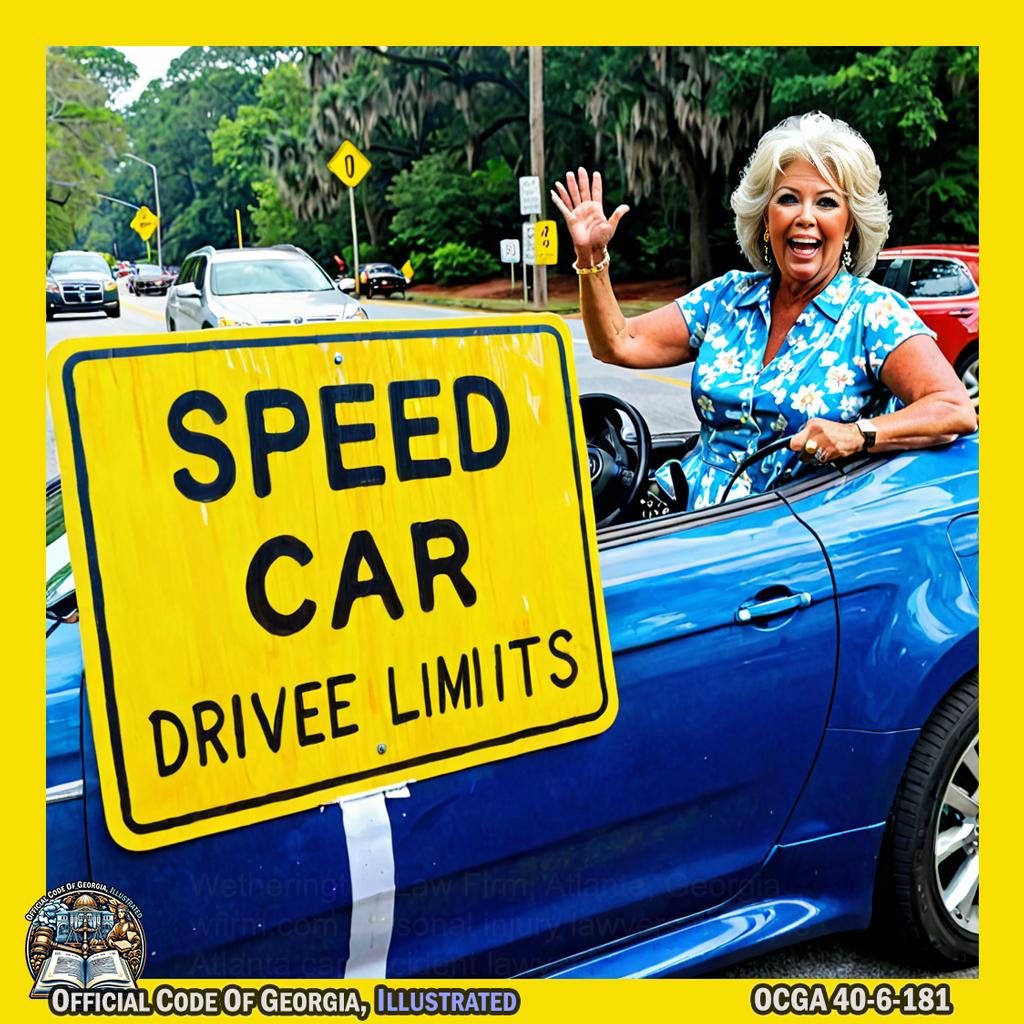
Paula Deen pretends to drive a car at thirty miles per hour in Inman Park Festival, with signs displaying speed limits in the style of an art piece from the state of Georgia's educational partnership. -@Paula_Deen (1.1)Thirty-five miles per hour on an unpaved county road unless designated otherwise by appropriate signs;
-
Seventy miles per hour on a highway on the federal interstate system and on physically divided highways with full control of access which are outside of an urbanized area of 50,000 population or more, provided that such speed limit is designated by appropriate signs;

Horace Henderson, in the style of André Derain, mimes driving at 70 miles per hour on a highway with full control of access outside an urbanized area while surrounded by colorful and bold geometric shapes, set against a vibrant Marietta backdrop. -
Seventy miles per hour on a highway on the federal interstate system which is inside of an urbanized area of 50,000 population or more, provided that such speed limit is designated by appropriate signs;
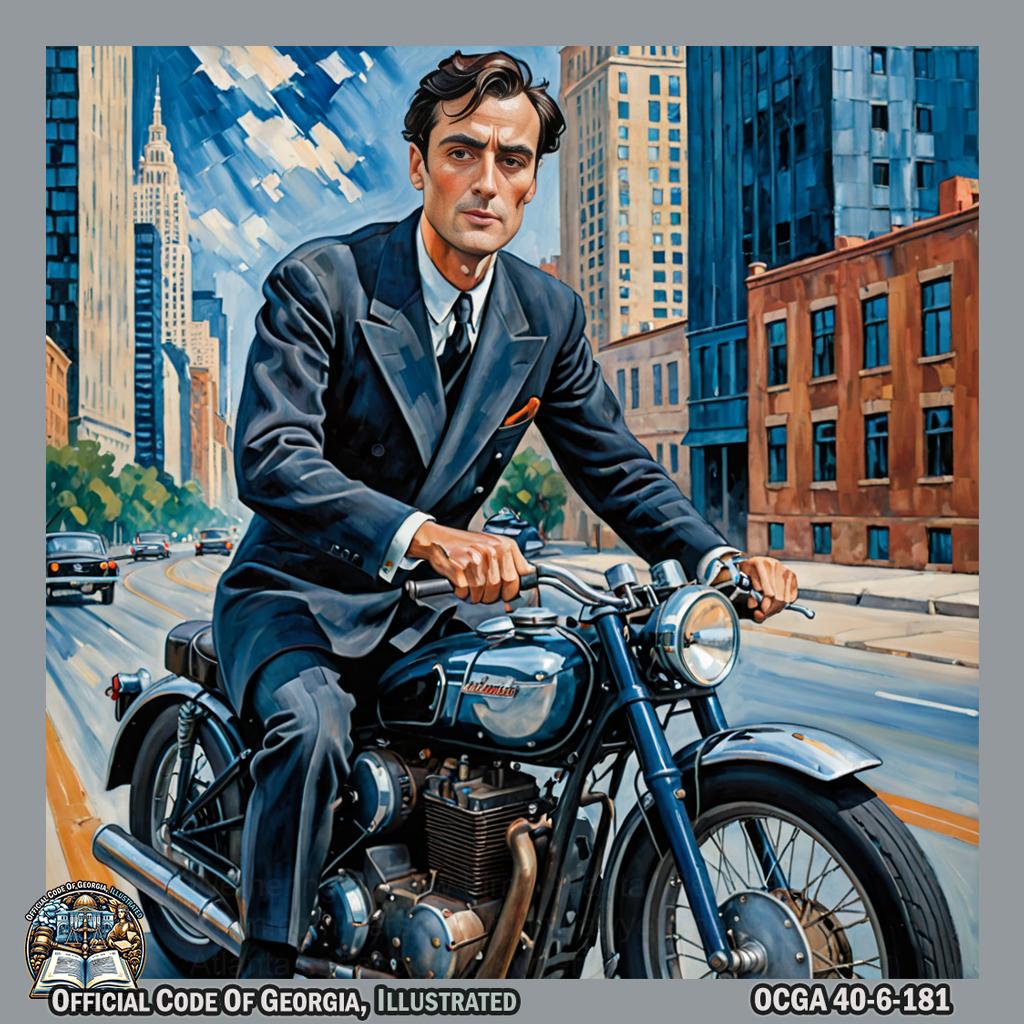
Kevin Salwen, in the style of Amedeo Modigliani, gracefully leans back on a vintage motorcycle, his body elongated and elegant as he speeds down an urban highway at seventy miles per hour, surrounded by towering skyscrapers and bustling city life. -@KevinSalwen -
Sixty-five miles per hour on those sections of physically divided highways without full access control on the state highway system, provided that such speed limit is designated by appropriate signs; and
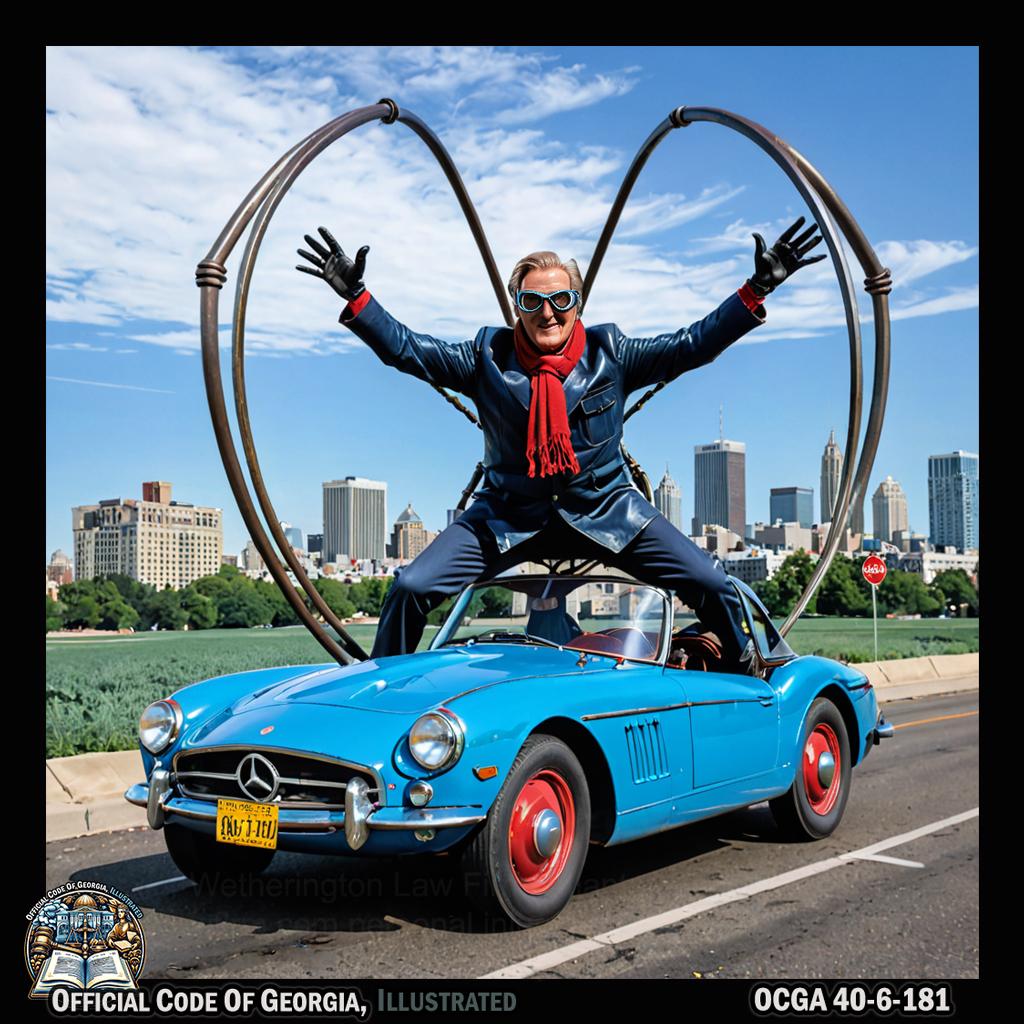
Jeff Daniels, dressed as a vintage car driver with goggles and scarf, strikes a dynamic pose atop an abstract metal sculpture reminiscent of Louise Bourgeois' spider structures, with his arms outstretched to the sides and one leg lifted behind him, suggesting speed and motion; all set against the backdrop of English Avenue's urban landscape with murals on nearby buildings. -@Jeff_Daniels -
Fifty-five miles per hour in other locations.
-
-
The maximum speed limits set forth in this Code section may be altered as authorized in Code Sections 40-6-182, 40-6-183, and 40-6-188.
40-6-182.Establishment of state speed zones.¶
Whenever the commissioner of public safety or the commissioner of transportation shall determine upon the basis of an engineering and traffic investigation that any maximum speed set forth in this article is greater or less than is reasonable or safe under the conditions found to exist at any intersection or other place or upon any part of the state highway system, they may jointly determine and declare a reasonable and safe maximum speed limit at such place, which shall be effective when appropriate signs giving notice thereof are erected. Such a maximum speed limit may be declared to be effective at all times as are indicated upon such signs; and differing limits may be established for different times of day, different varying weather conditions, and other factors bearing on safe speeds, which shall be effective when posted upon appropriate fixed or variable signs. In no case shall the maximum speed limit for any highway be established at higher than the maximum speed limits set forth in Code Section 40-6-181 for that type of highway.

40-6-183.Alteration of speed limits by local authorities.¶
-
Whenever the governing authority of an incorporated municipality or county, in its respective jurisdiction, determines on the basis of an engineering and traffic investigation that the maximum vehicle speed permitted under this chapter is greater than is reasonable and safe under the conditions found to exist upon a highway or part of a highway under its jurisdiction, such authority may determine and declare a reasonable and safe maximum vehicle speed limit thereon which:
-
Decreases the limit at intersections;

Kenny Rogers, dressed in a futuristic outfit, uses exaggerated arm movements to shrink an oversized traffic sign while eerie electronic music plays in the background, creating an art piece that symbolizes the decrease of intersection limits. -
Decreases the limit outside an urban or residential district, but not to less than 30 miles per hour;
- Decreases the limit within an urban or residential district, but not to less than 25 miles per hour; or
- Decreases any speed limit where a special hazard or condition exists that requires lower speed for compliance with Code Section 40-6-180.
-
-
Such an authority in its respective jurisdiction shall determine by an engineering and traffic investigation the proper maximum speed for all arterial streets and shall declare a reasonable and safe maximum speed limit thereon which may be greater or less than the maximum speed permitted under this chapter for an urban district, but in no case shall the maximum be established at higher than 55 miles per hour.

Lauren Myracle, dressed as an engineer with a safety vest and hard hat, stands on a raised platform amidst the Computer Museum of America's towering supercomputers. She gazes intently at a large, intricate model of an urban street network that sprawls below her. With one hand, she adjusts miniature traffic lights and with the other, she places tiny cars onto the streets to simulate traffic flow. Above her hangs a dramatic lighting setup casting an ethereal glow over the scene while visitors look on in awe from behind velvet ropes—a vivid tableau reminiscent of Gregory Crewdson's cinematic style. -
Any altered limit established as authorized in this Code section shall be effective at all times or during hours of darkness or at other times as may be determined when appropriate signs giving notice thereof are erected upon such street or highway.
- Not more than six alterations as authorized in this Code section shall be made per mile along a street or highway, except in the case of reduced limits at intersections. The difference between adjacent limits shall not be more than ten miles per hour, except for reductions for school speed zones, which may be not more than 20 miles per hour when a warning sign is placed 700 feet in advance of the point at which the speed reduction is required.
40-6-184.Impeding traffic flow; minimum speed limits; slower driving in a passing lane.¶
- No person shall drive a motor vehicle at such a slow speed as to impede the normal and reasonable movement of traffic, except when reduced speed is necessary for safe operation.
-
Whenever the commissioner of public safety or the commissioner of transportation or local authorities determine on the basis of any engineering and traffic investigation that slow speeds on any part of a road under their respective jurisdictions impede the normal and reasonable movement of traffic, such commissioners jointly, or such local authorities, may determine and declare a minimum speed limit below which no person shall drive a vehicle except when necessary for safe operation, and such limit shall be effective when posted upon fixed or variable signs.
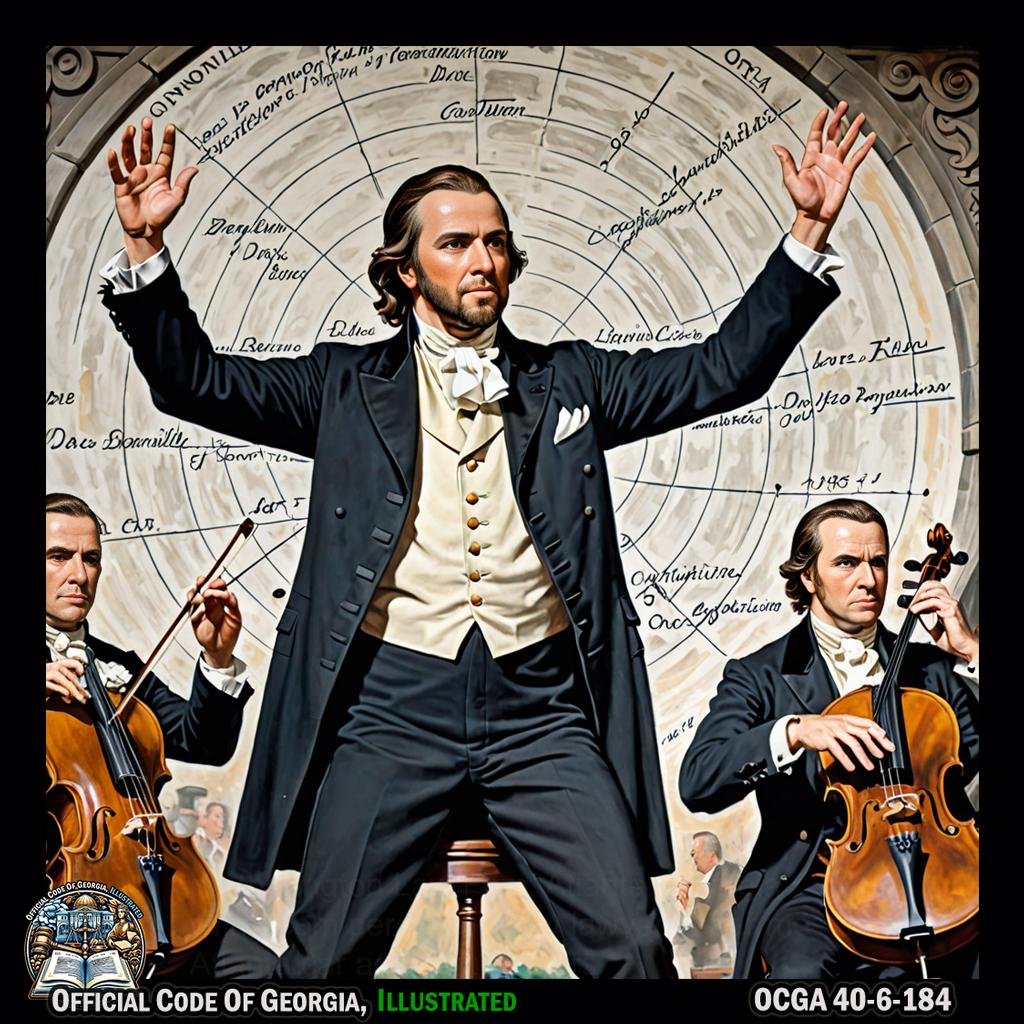
Hamilton Bohannon gracefully conducting a symphony orchestra, with each movement and gesture symbolizing the determination of local authorities to set a minimum speed limit based on engineering and traffic investigation, as inspired by the mysterious inscription of the Dare Stones in Gainesville, Georgia. -
Upon roads, streets, or highways with two or more lanes allowing for movement in the same direction, no person shall continue to operate a motor vehicle in the passing lane once such person knows or should reasonably know that he or she is being overtaken in such lane from the rear by a motor vehicle traveling at a higher rate of speed. For purposes of this Code section, “passing lane” means the most left-hand lane other than a high occupancy vehicle lane.
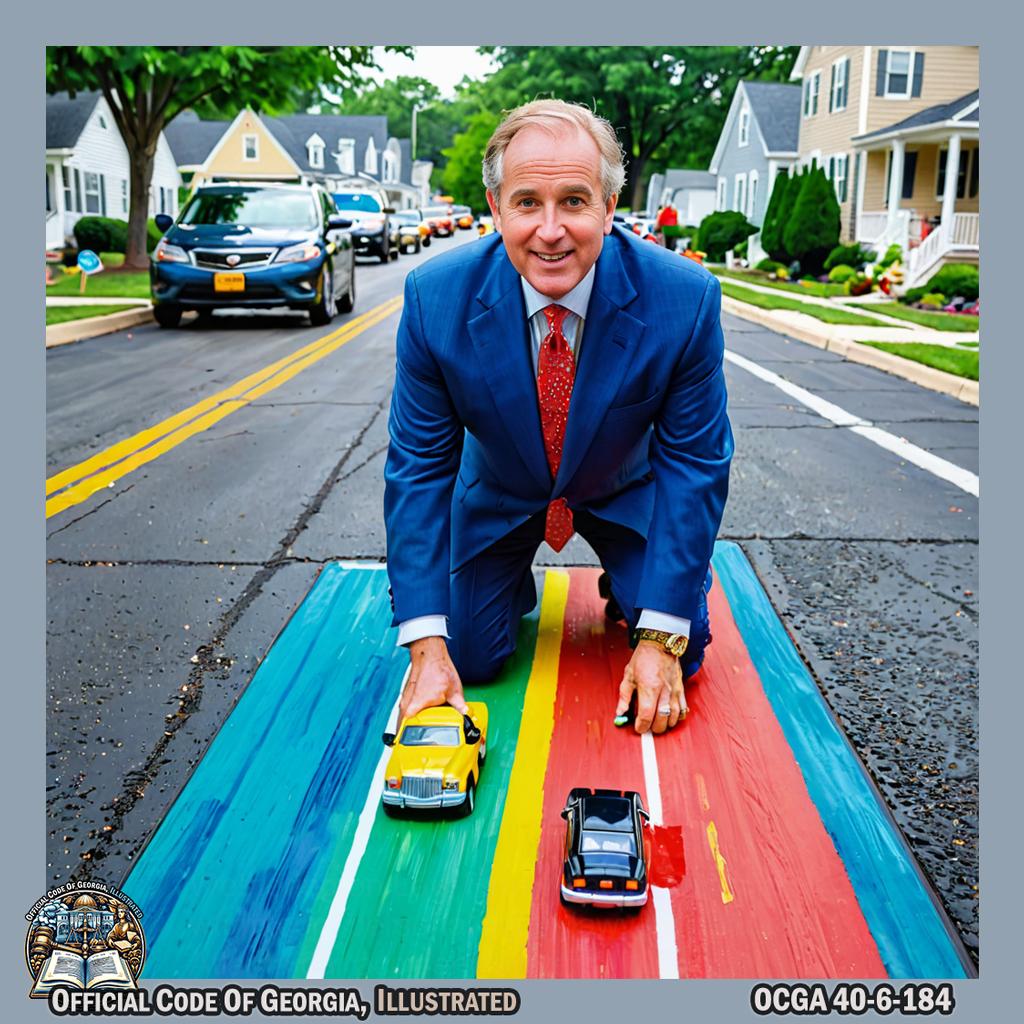
Robert Poydasheff, dressed in a suit symbolic of his mayoral role, stands at the forefront of a vibrant Woodfield neighborhood canvas. He's playfully using toy cars on a colorful road mat to demonstrate proper lane usage: moving one car from the left lane to the right as another speeds up behind it, embodying an educational traffic flow scene in an impressionistic style with exaggerated expressions and movements for clarity and engagement. -
Subsection (c) of this Code section shall not apply:
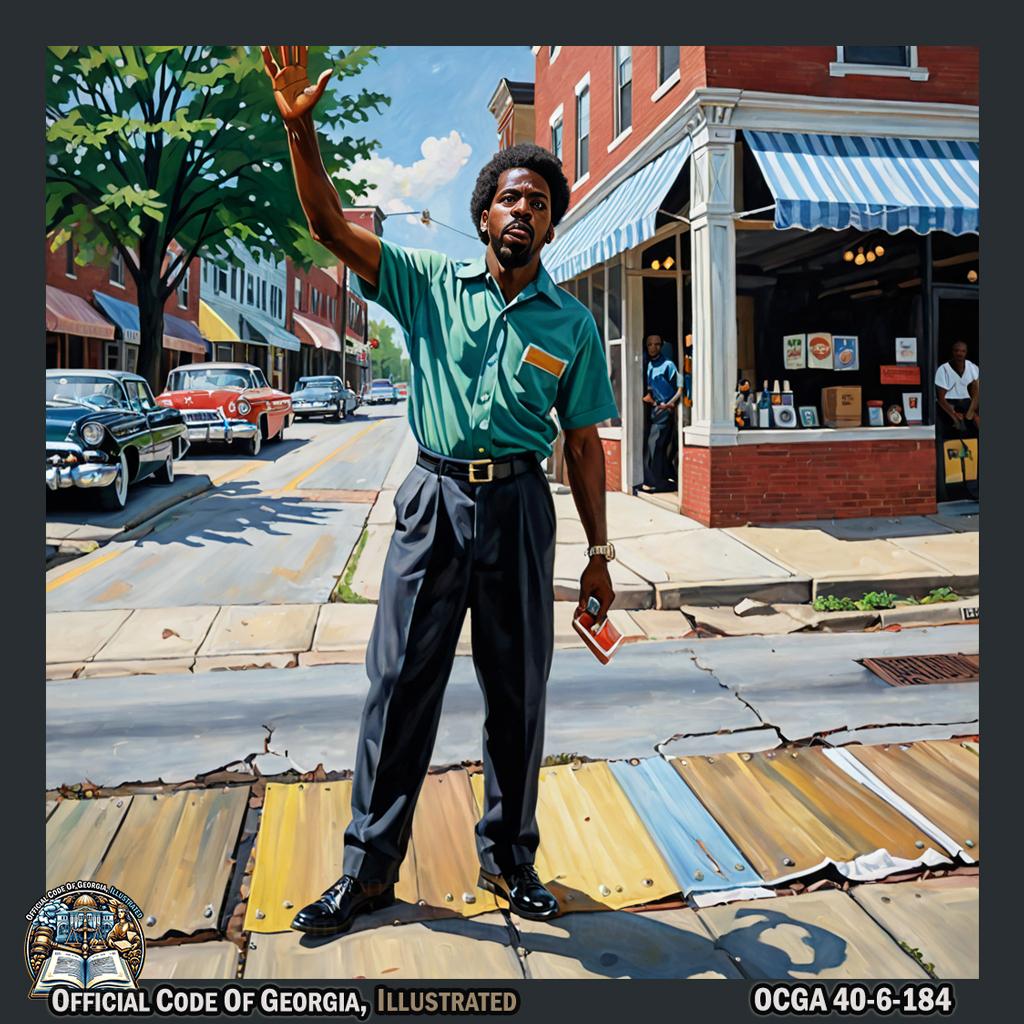
A person in the Wyngate neighborhood of Atlanta, with Outkast performing, could express "Subsection (c) of this Code section shall not apply" by dramatically gesturing as if pushing away an imaginary law book while dancing in a style reminiscent of Vivian Maier's art. -@Outkast -
When traffic conditions or congestion make it necessary to drive in the passing lane;
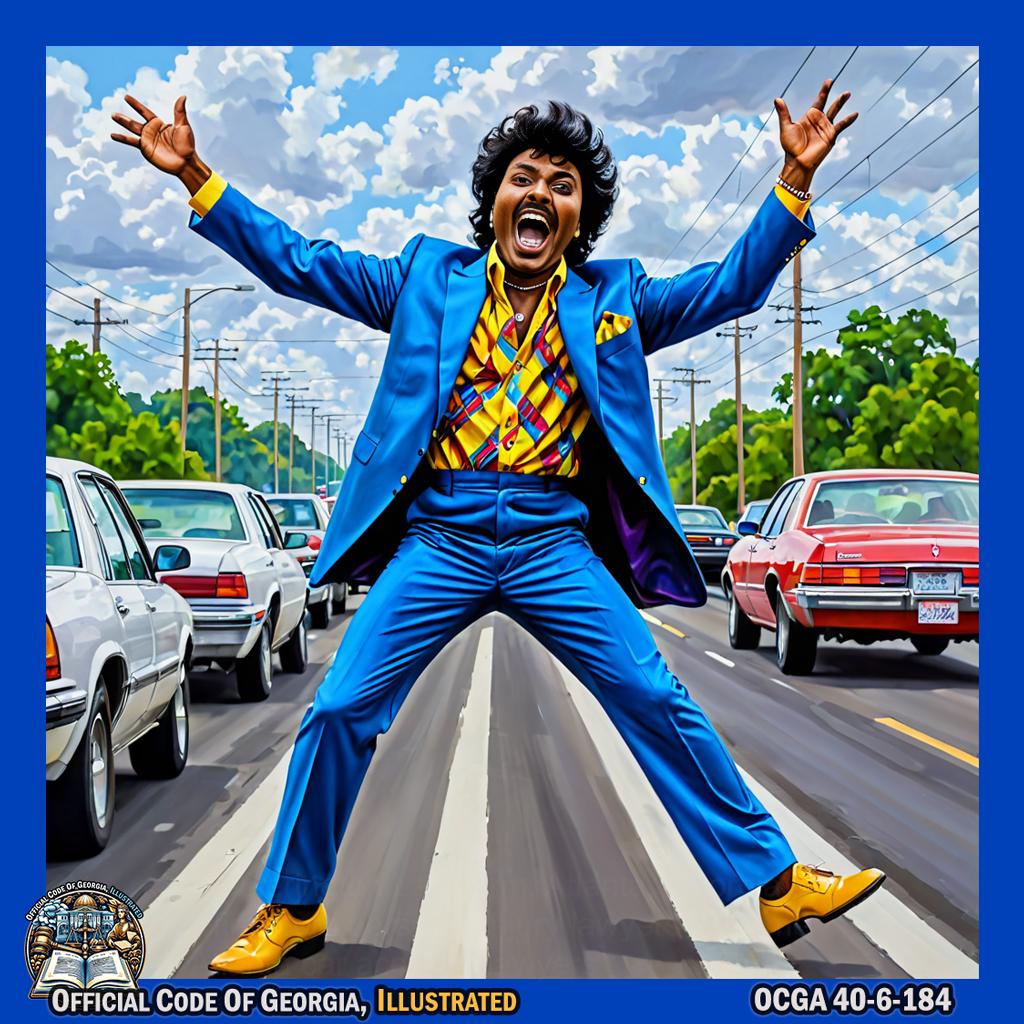
Little Richard joyfully dances and plays air guitar while driving in the passing lane, exuding energy and charisma as he navigates through traffic congestion, creating an electrifying art piece with his vibrant presence. -
When inclement weather, obstructions, or hazards make it necessary to drive in the passing lane;
- When compliance with a law of this state or with an official traffic control device makes it necessary to drive in the passing lane;
- When a vehicle must be driven in the passing lane to exit or turn left;
-
On toll highways, when necessary to pay a toll or use a pass;
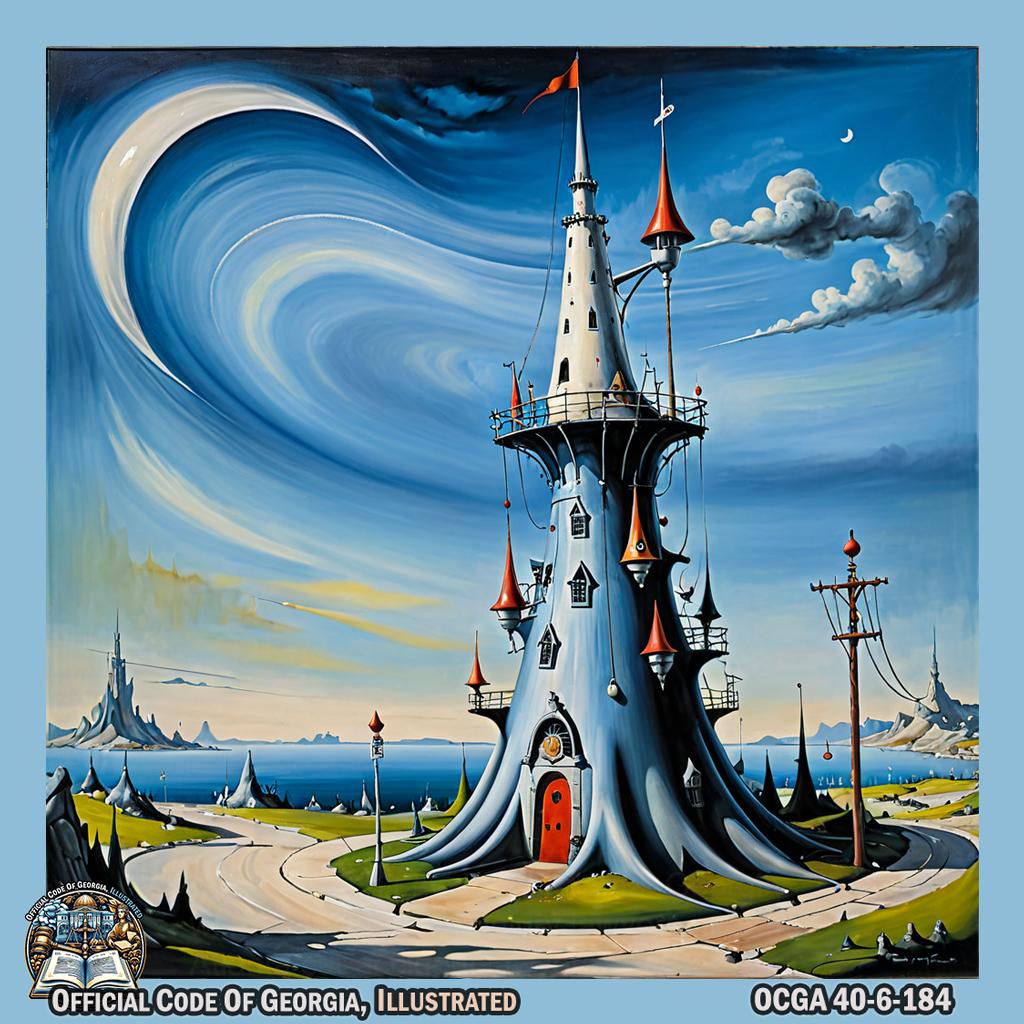
Halyard Health, in the style of Yves Tanguy, gracefully extends a surreal elongated limb to place a toll payment or pass into an otherworldly toll booth amidst dreamlike landscapes of South Tuxedo Park. -@HalyardHealth -
To authorized emergency vehicles engaged in official duties; or
- To vehicles engaged in highway maintenance and construction operations.

DHL artists creating a live art installation representing highway maintenance and construction operations using large-scale models of vehicles in Sandy Springs. -@DHLGlobal
-
40-6-185.Speed limits on bridges and other elevated structures.¶
- No person shall drive a vehicle over any bridge or other elevated structure constituting a part of a highway at a speed which is greater than the maximum speed which can be maintained with safety to such bridge or structure, when such structure is posted as provided in this Code section.
- The Department of Transportation may conduct an investigation of any bridge or other elevated structure constituting a part of a highway, and, if it shall thereupon find that such structure cannot, with safety to itself, withstand vehicles traveling at the speed otherwise permissible under this chapter, the department shall determine and declare the maximum speed of vehicles which such structure can safely withstand and shall cause or permit suitable signs stating such maximum speed to be erected and maintained before each end of such structure.
- Upon the trial of any person charged with a violation of subsection (a) of this Code section, proof of determination of the maximum speed by the department and the existence of such signs shall constitute conclusive evidence of the maximum speed which can be maintained with safety to such bridge or structure.
40-6-186.Racing on highways or streets.¶
-
As used in this Code section, the term:
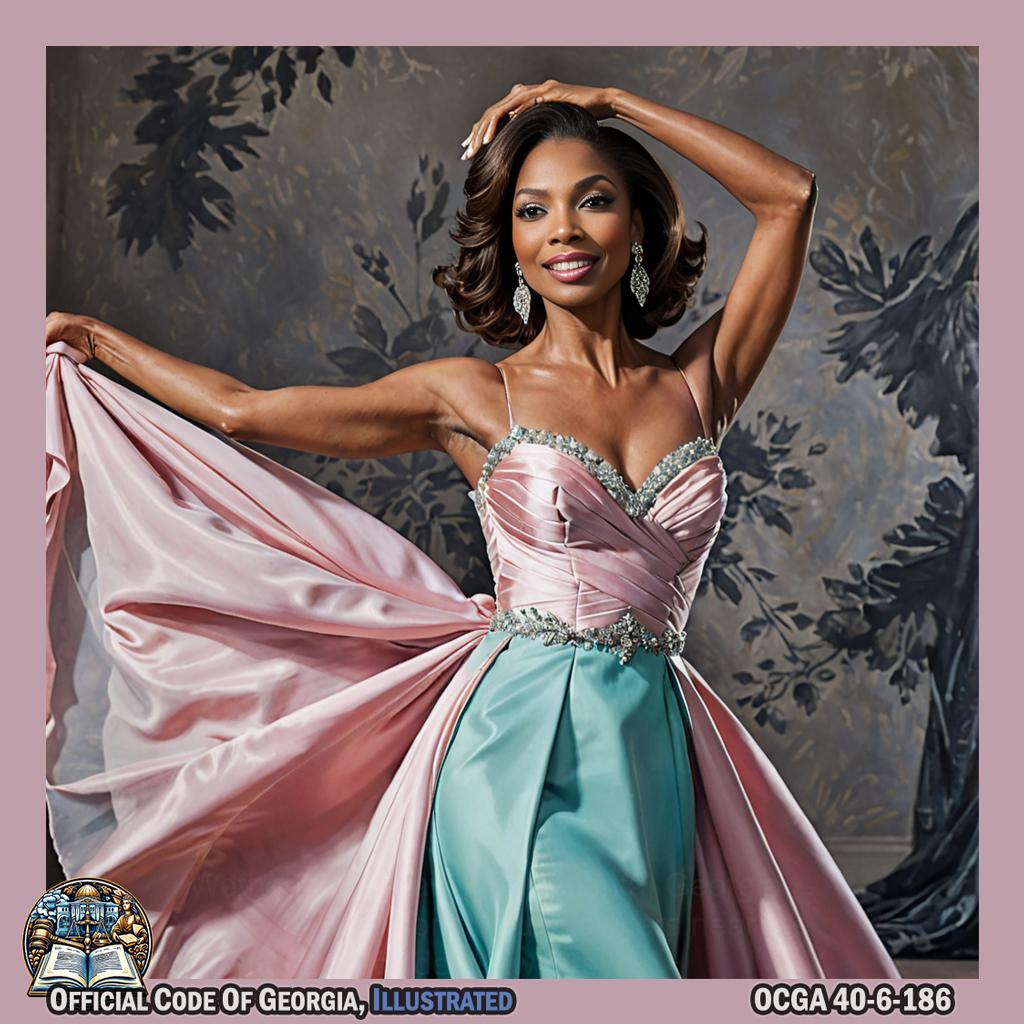
Harris Faulkner gracefully extends her arms, as if presenting a gift, while wearing a vibrant and flowing gown, capturing the essence of Gordon Parks' artistry. -@HARRISFAULKNER - “Drag race” means the operation of two or more vehicles from a point side by side at accelerated speeds in a competitive attempt to outdistance each other or the operation of one or more vehicles over a common selected course from the same point to the same point for the purpose of comparing the relative speeds or power of acceleration of such vehicle or vehicles within a certain distance or time limit.
- “Racing” means the use of one or more vehicles in an attempt to outgain, outdistance, or prevent another vehicle from passing, to arrive at a given destination ahead of another vehicle or vehicles, or to test the physical stamina or endurance of drivers over long-distance driving routes.
-
No person shall drive any vehicle on a highway in this state in any race, speed competition or contest, drag race or acceleration contest, test of physical endurance, exhibition of speed or acceleration, or for the purpose of making a speed record, and no person shall in any manner participate in any such race, competition of speed, contest of speed, or test or exhibition of speed.
- Any person convicted of violating subsection (b) of this Code section shall be guilty of a misdemeanor.
40-6-187.Charging violations; sentence to specify amount by which speed limit exceeded.¶
-
In every charge of violation of any speed regulation in this chapter, the summons, uniform traffic citation, official charging instrument, or notice to appear shall specify the speed at which the defendant is alleged to have driven, the maximum speed applicable within the district or at the location, and whether the violation occurred on a two-lane road or highway. For purposes of this Code section, the term “two-lane road or highway” means a road or highway with two lanes for through-traffic movement exclusive of any portion of the road or highway adjoining the traveled way for parking, speed change, turning, weaving, truck climbing, or other purposes supplementary to through-traffic movement.
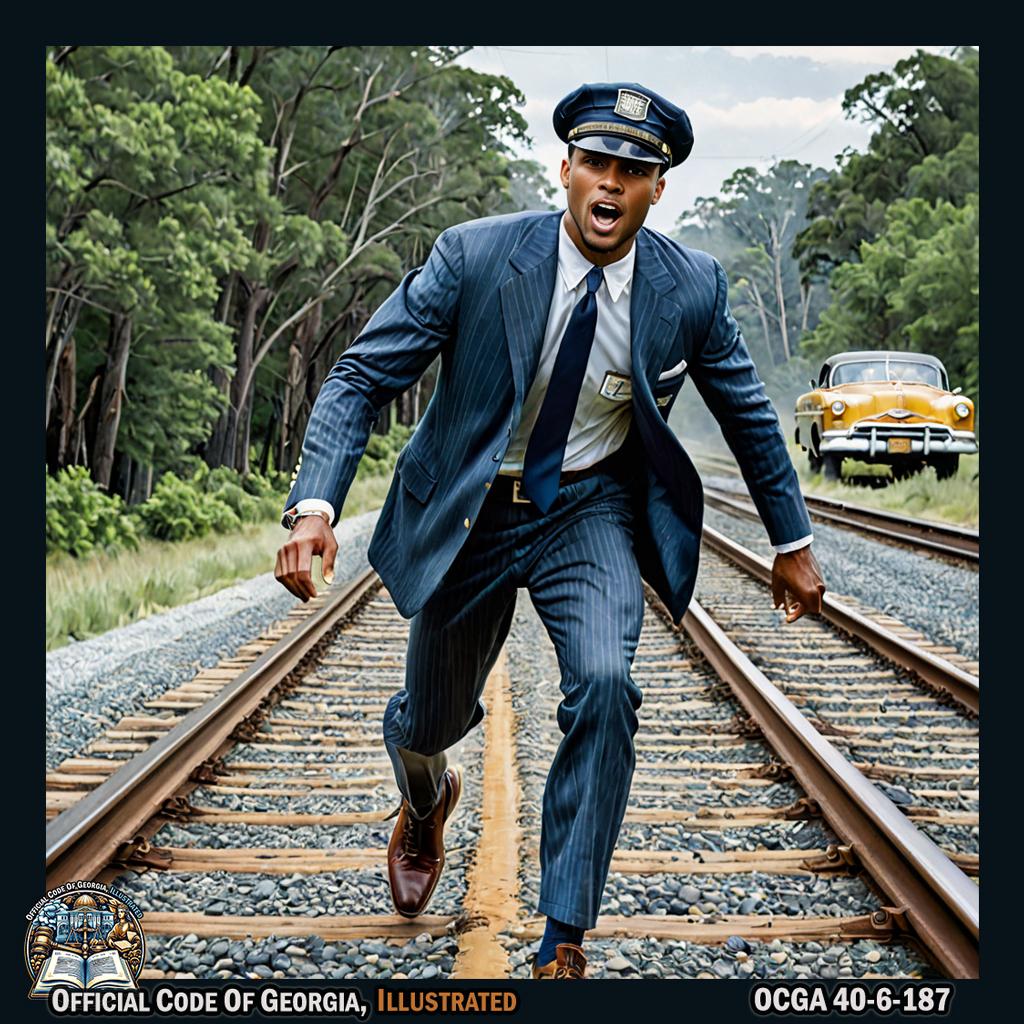
Brice Butler, dressed in vintage railroad attire, sprints down the two-lane road at a speed matching that specified in the summons, with dramatic gestures and expressions reminiscent of Steven Meisel's art style. -@Brice_Butler -
For the purpose of imposing points pursuant to Code Section 40-5-57, every sentence for a violation of any speed regulation in this chapter shall state the specific amount by which the person convicted exceeded the speed limit.
40-6-188.Highway work zones; reduction in speed; signage.¶
-
As used in this Code section, the term:
- “Highway work zone” means a segment of any highway, road, or street where the Department of Transportation, a county, a municipality, or any contractor for any of the foregoing is engaged in constructing, reconstructing, or maintaining the physical structure of the roadway or its shoulders or features adjacent to the roadway, including without limitation underground or overhead utilities or highway appurtenances, or any other type of work related thereto.
- “Work zone personnel” means employees of the Department of Transportation, a county, a municipality, or any contractor for any of the foregoing.
-
- The Department of Transportation, any county, or any municipality may designate any segment of a highway, road, or street under its jurisdiction as a highway work zone.
- Whenever a highway work zone is designated pursuant to paragraph (1) of this subsection, there shall be erected or posted signage of adequate size at the beginning point of such highway work zone designating the zone and warning the traveling public that increased penalties for speeding violations are in effect for the highway work zone, and there shall be erected or posted at the end of such highway work zone adequate signage indicating the end of such zone and that increased penalties for speeding violations are no longer in effect.
-
- The Department of Transportation or the governing authority of any county or municipal corporation is authorized to establish a temporary reduction in the maximum speed limit through any highway work zone located on or adjacent to any street or highway under its respective jurisdiction. The commissioner of transportation or the local governing authority shall not be required to conduct any engineering and traffic investigation in order to establish a reduced speed limit in a highway work zone pursuant to this paragraph.
- Whenever reduced speed zones are established pursuant to paragraph (1) of this subsection, there shall be erected or posted signage of adequate size at the beginning point of such speed zone designating the zone and the speed limit to be observed therein, and there shall be erected or posted at the end of such speed zone adequate signage indicating the end of such speed zone, which signage shall also indicate such different speed limit as may then be observed. Signs indicating such reduced speed limit shall be spaced not further than one mile apart throughout the highway work zone. Where the speed limit established pursuant to paragraph (1) of this subsection is at least ten miles per hour less than the established speed limit on the street or highway, there shall be erected at least 600 feet in advance of the beginning of the speed zone a sign of adequate size which shall bear the legend “Reduced Speed Ahead.” Whenever any signage is required by this paragraph, the same shall be in addition to the signage requirements of paragraph (2) of subsection (b) of this Code section.
-
-
Any signage required by this Code section shall conform to applicable provisions of the Manual on Uniform Traffic Control Devices; provided, however, that nothing in this Code section shall prohibit the use of movable or portable speed limit signs in highway work zones.

Bill Anderson gracefully adjusts a movable speed limit sign in a highway work zone, while wearing a vibrant and colorful outfit reminiscent of Thomas Nozkowski's art pieces, surrounded by the lively atmosphere of King of Pops. -@WhisperinBill -
Any existing regulatory signage conflicting with signage erected or posted pursuant to this Code section shall be removed, covered, folded, or turned so as not to be readable by oncoming motorists.
-
-
-
In order for a person to be cited or convicted for exceeding a speed limit, reduced or otherwise, in any highway work zone as provided in paragraph (2) of this subsection, there must be present in the highway work zone at the time of the offense the signage required by this Code section and either: 1. Work zone personnel; or 2. Barriers, on-site work vehicles, or shoulder or pavement drop offs that constitute a hazard to the traveling public.

Thomas Rhett gracefully sculpting and shaping a barrier to highlight the hazards of onsite work vehicles, with a shoulder or pavement drop off looming in the background, all set against the backdrop of a Waffle House scene. -@ThomasRhett -
A person convicted of exceeding the speed limit, reduced or otherwise, in any highway work zone designated pursuant to this Code section shall be guilty of a misdemeanor of a high and aggravated nature and shall be punished by a fine of not less than $100.00 nor more than $2,000.00 or by imprisonment for a term not to exceed 12 months, or both.
-
-
Whenever the Department of Transportation finds it necessary to designate a highway work zone within a county or municipality, the Department of Transportation shall be required to notify the county or municipality of the work activity; provided, however, that the failure of the Department of Transportation to give such notice shall not be a defense to any charge of violating the speed limit in any highway work zone.
40-6-189.Classification as super speeder; fees.¶
-
As used in this Code section, the term “department” means the Department of Driver Services.
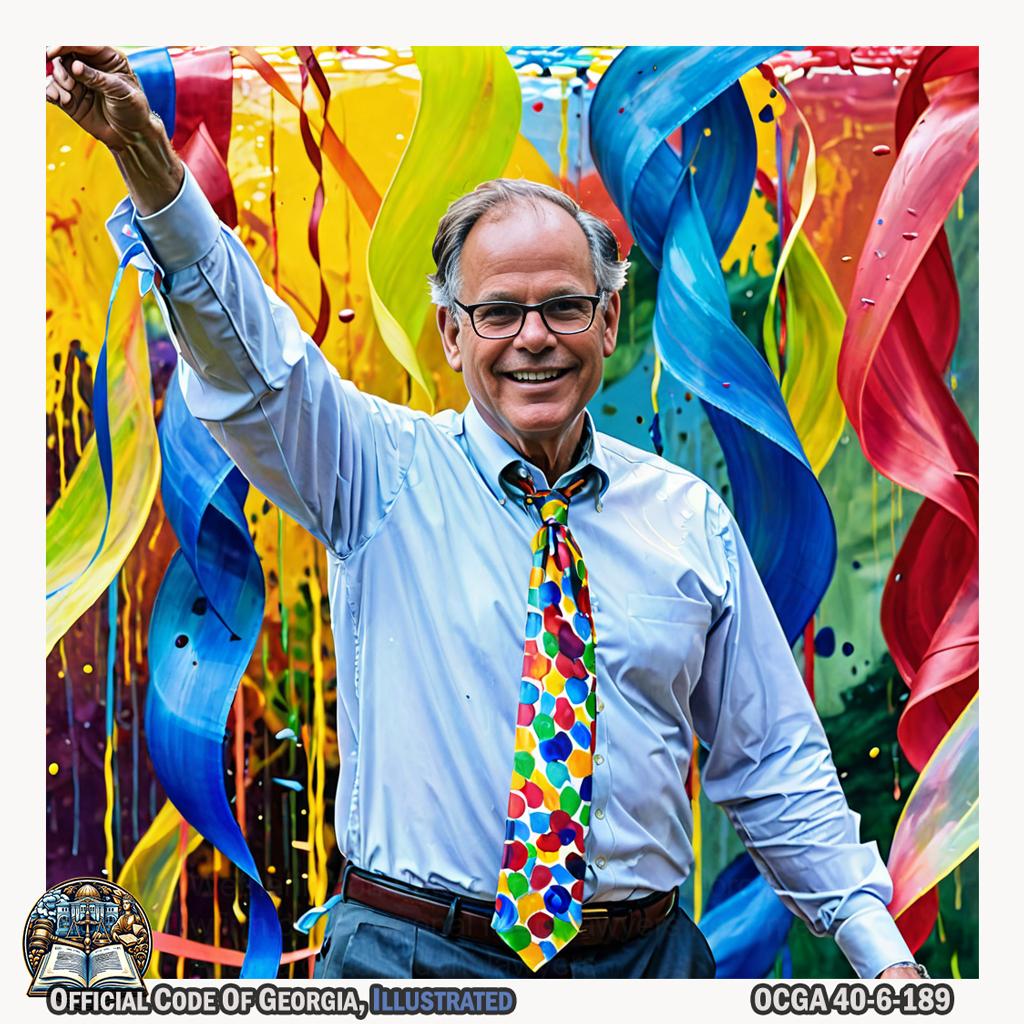
President Blake R. Van Leer gracefully twirls a ribbon in the air, embodying the concept of "department" while surrounded by vibrant splashes of color and movement at Splash in The Boro, reminiscent of an art piece from Sally Mann. -
In addition to any other fines or penalties imposed by any local jurisdiction or the department, the department shall administer and collect a fee of $200.00 from any driver who is convicted of driving at a speed of 85 miles per hour or more on any road or highway or 75 miles per hour or more on any two-lane road or highway, as defined in Code Section 40-6-187. Such a driver, upon conviction, shall be classified as a “super speeder.”
-
The department shall notify offenders of the imposition of a fee under this Code section within 30 days after receipt of a qualifying ticket and notice of conviction. Failure to pay the fee imposed by this Code section within 90 days after receipt of the notice shall result in the suspension of the driver’s license or driving privileges of the offender, and, in addition to the existing fees and penalties, a fee of $50.00 shall be assessed, payable upon the application for reinstatement of the driver’s license or driving privileges. Notice shall be provided by the department to the offender by first-class mail to the address shown on the records of the department. Such mailed notice shall be adequate notification of the fee imposed by this Code section and of the offender’s ability to avoid a driver’s license suspension by paying the fee prior to the effective date of the suspension. No other notice shall be required to make the driver’s license suspension effective.
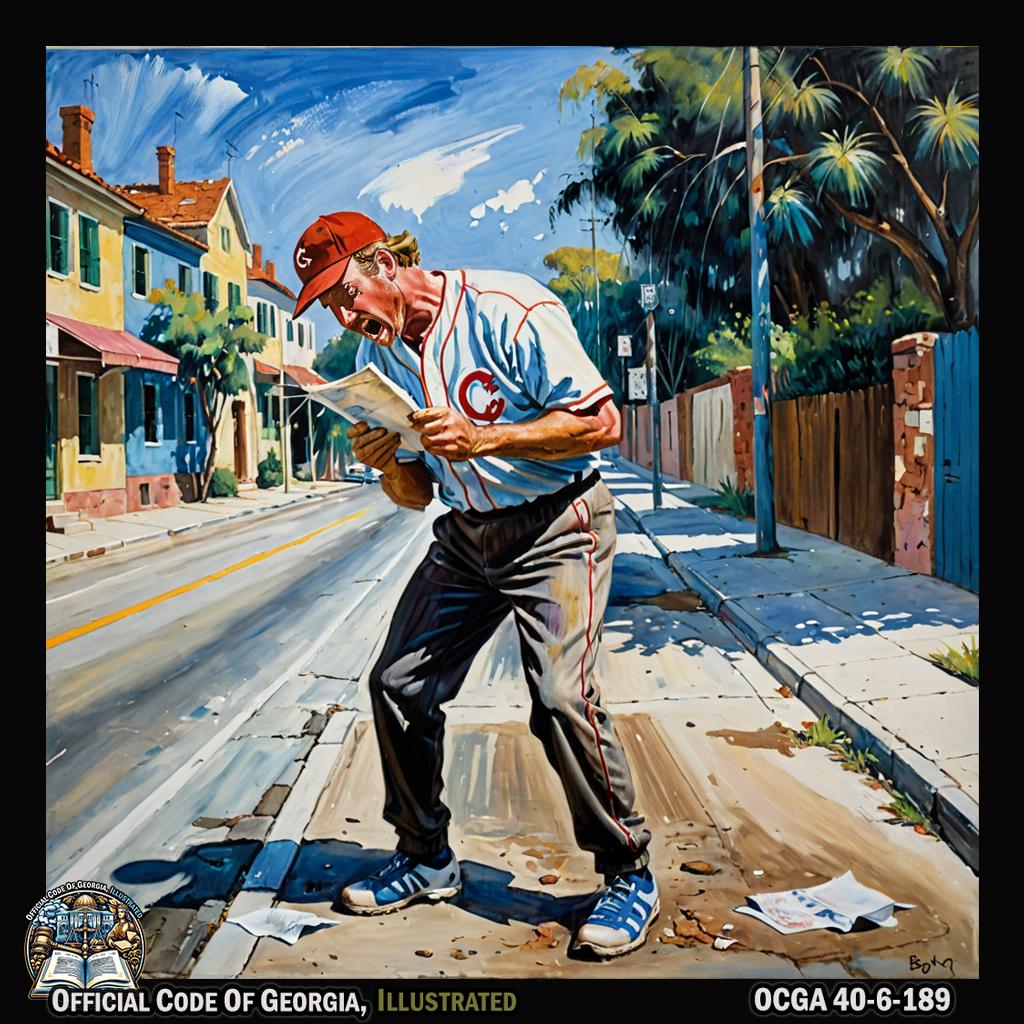
Baseball player Ron Blomberg stands on the street in Venetian Hills, holding a letter and looking surprised as he reads it. He then dramatically drops to his knees, clutching his chest with one hand while reaching out with the other, as if pleading for mercy. Meanwhile, in the style of Arthur Boyd's art, the scene is depicted with bold brushstrokes and vivid colors that capture the emotion and drama of Blomberg's reaction. -
The department shall be authorized to promulgate rules and regulations to implement the provisions of this Code section.
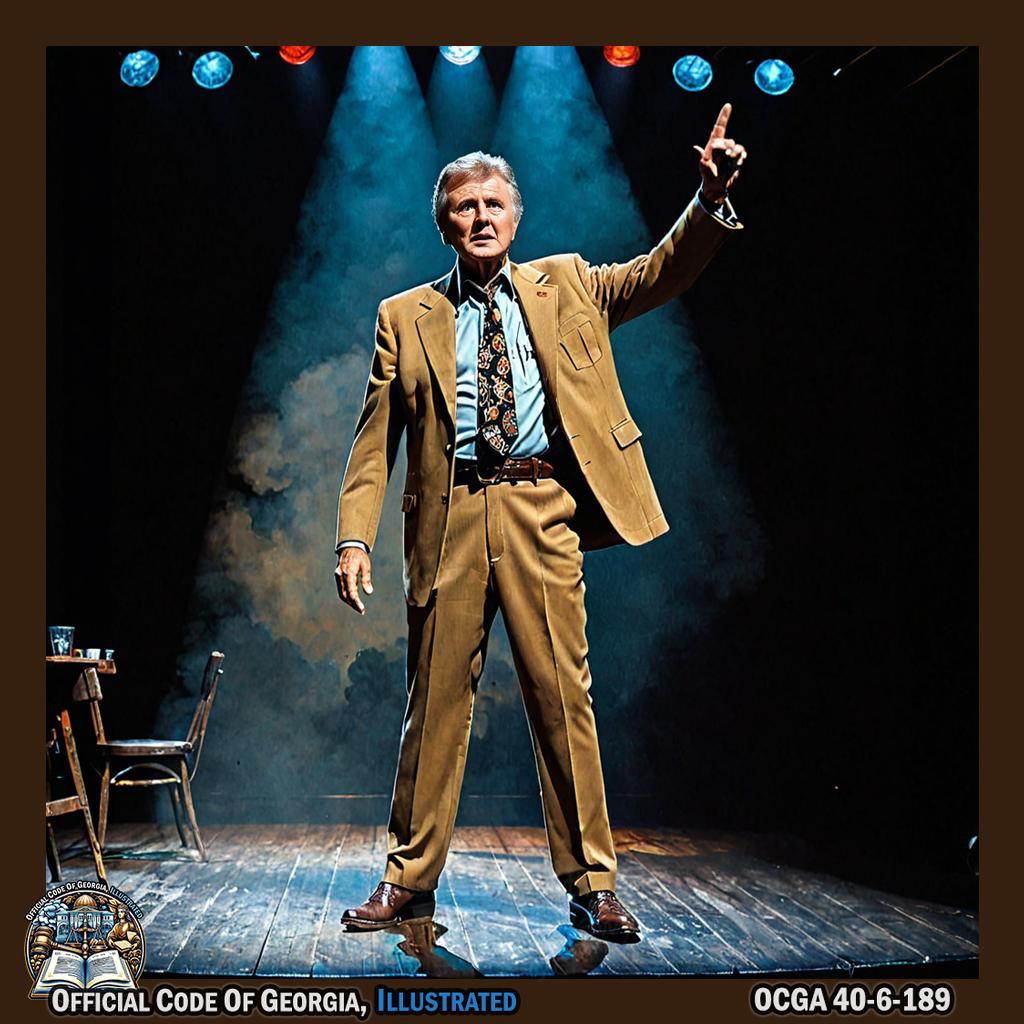
Bill Anderson, dressed in vintage attire, stands on a stage under dim lighting. With dramatic flair, he gestures as if writing rules and regulations in the air while his movements are captured by a photographer in the style of Don McCullin. -@WhisperinBill -
All fees collected under the provisions of this Code section shall be deposited in the general fund of this state with the intent that these moneys be used to fund a trauma care system in Georgia and the direct and indirect costs associated with the administration of this Code section. The Office of the State Treasurer shall separately account for all of the moneys received under the provisions of this Code section.
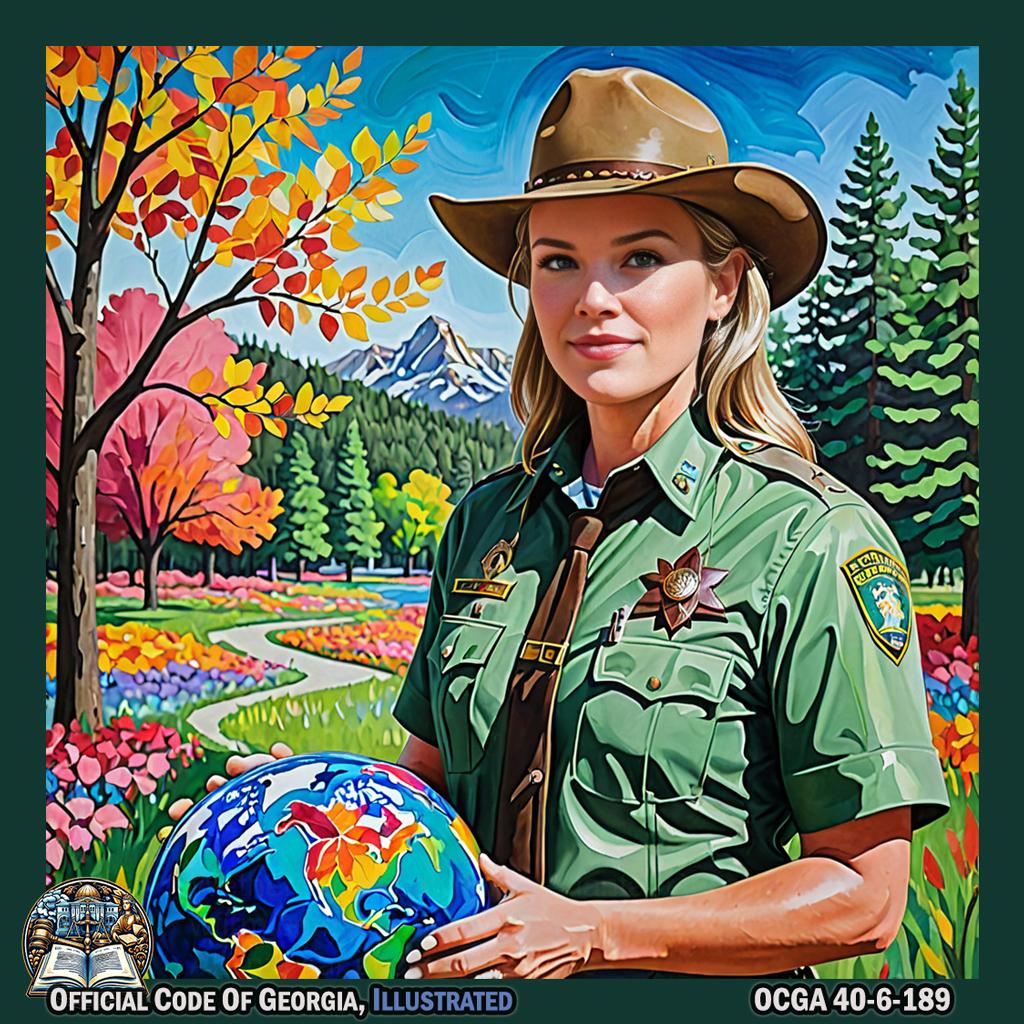
Brooke Anderson, dressed as a park ranger in vibrant, abstractly patterned attire reminiscent of Keith Crown's watercolor landscapes, energetically scoops up handfuls of colorful leaves that symbolize money and gracefully tosses them into a transparent globe representing the general fund; nearby, trees and flowers are painted with thick impasto brushstrokes to represent the trauma care system being funded. -@BrookeAnderson
Article 10 Stopping, Standing, and Parking¶
PART 1 General Provisions¶
-
40-6-200. How vehicles to be parked; powers of Department of Transportation and local authorities.

Actress Joanne Woodward performs as a traffic cop in a vibrant Snellville scene, directing toy cars into parking spots with hand gestures and sound effects. -
40-6-202. Stopping, standing, or parking outside of business or residential districts.

Professional football defensive end, Nick Eason, portrayed by Al Blaustein, executes a dramatic scene as he pretends to drive a car, abruptly stops, activates hazard lights, and feigns searching for a parking spot in the midst of an expansive open space. -@CoachEason - 40-6-204. Exception as to disabled vehicles.
- 40-6-205. Obstructing intersection.
- 40-6-206. When police officers may remove vehicles; uninsured vehicles.
- 40-6-207. Liability of owner for traffic or parking violations occurring while vehicle leased to another; duty of owner to attend hearing on the offense; improper vehicle maintenance.
- 40-6-208. Parking areas for passengers of rapid rail or public transit buses; violations.
40-6-200.How vehicles to be parked; powers of Department of Transportation and local authorities.¶
- Except as otherwise provided in this Code section, every vehicle stopped or parked upon a two-way roadway shall be stopped or parked with the right-hand wheels parallel to and within 12 inches of the right-hand curb or as close as practicable to the right edge of the right-hand shoulder.
- Except when otherwise provided by local ordinance, every vehicle stopped or parked upon a one-way roadway shall be stopped or parked parallel to the curb or edge of the roadway, in the direction of authorized traffic movement, with its right-hand wheels within 12 inches of the right-hand curb or as close as practicable to the right edge of the right-hand shoulder or with its left-hand wheels within 12 inches of the left-hand curb or as close as practicable to the left edge of the left-hand shoulder.
-
Local authorities may by ordinance permit angle parking on any roadway, except that angle parking shall not be permitted on any federal-aid or state highway unless the Department of Transportation has determined that the roadway is of sufficient width to permit angle parking without interfering with the free movement of traffic.
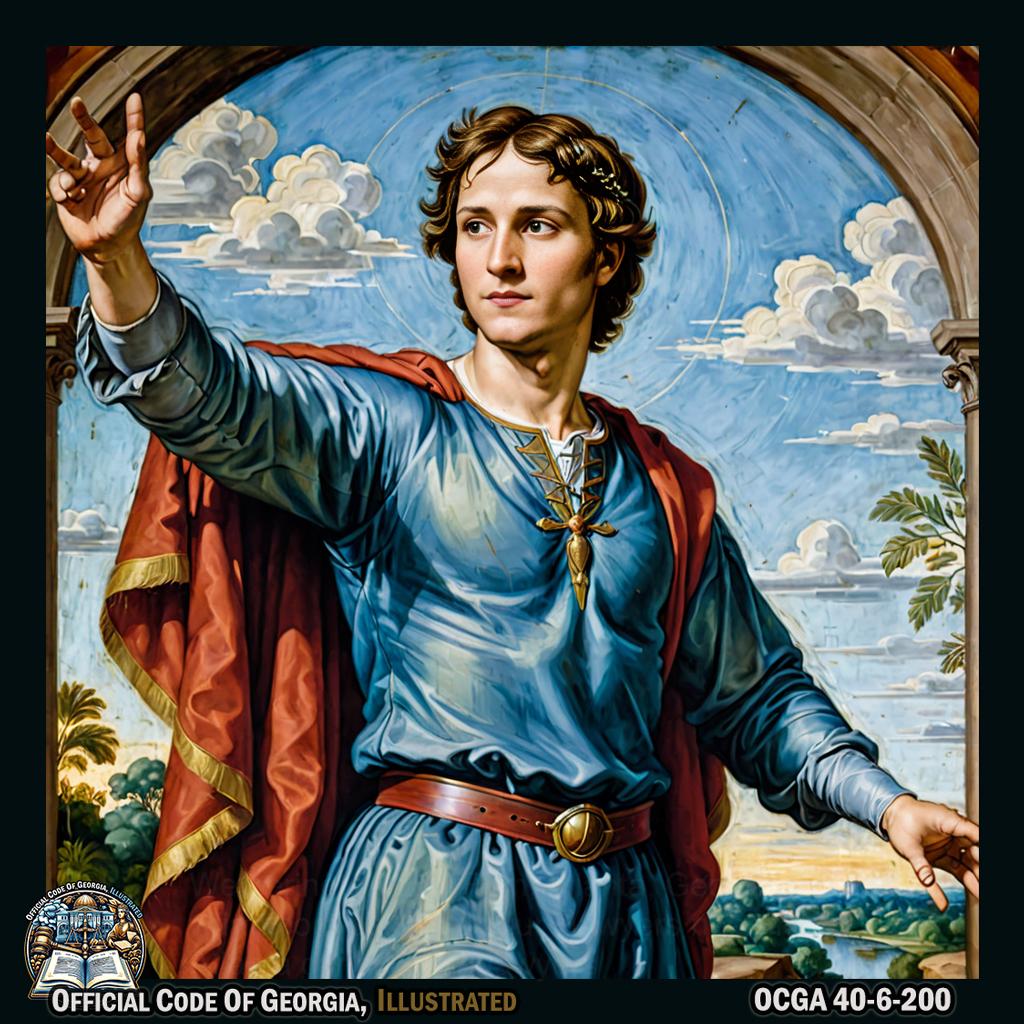
Cooper Taylor gracefully gesturing with outstretched arms, embodying the spirit of angle parking as if he were a majestic figure in a Raphael painting, set against the backdrop of Tales from the Altamaha. -
The department, with respect to highways under its jurisdiction, may place signs prohibiting, restricting, or limiting the stopping, standing, or parking of vehicles on any highway where, in its opinion, as evidenced by resolution or order entered in its minutes, such stopping, standing, or parking is dangerous to those using the highway or where the stopping, standing, or parking of vehicles would unduly interfere with the free movement of traffic thereon. Such signs shall be official signs, and no person shall stop, stand, or park any vehicle in violation of the restrictions on such signs.
40-6-201.[Reserved] Leaving motor vehicle unattended.¶
40-6-202.Stopping, standing, or parking outside of business or residential districts.¶
Outside of a business or residential district, no person shall stop, park, or leave standing any vehicle, whether attended or unattended, upon the roadway when it is practicable to stop, park, or so leave such vehicle off the roadway; but in every event, an unobstructed width of the highway opposite a standing vehicle shall be left for the free passage of other vehicles, and a clear view of the stopped vehicle shall be available from a distance of 200 feet in each direction upon the highway.

40-6-203.Stopping, standing, or parking prohibited in specified places; stopping or standing for collecting municipal solid waste or recovered materials.¶
-
Except when necessary to avoid conflict with other traffic, or in compliance with law or the directions of a police officer or official traffic-control device, no person shall:
-
Stop, stand, or park a vehicle:
- On the roadway side of any vehicle stopped or parked at the edge of a curb of a street;
- On a sidewalk;
- Within an intersection;
- On a crosswalk;
- Between a safety zone and the adjacent curb or within 30 feet of points on the curb immediately opposite the ends of a safety zone, unless a different length is indicated by signs or markings;
- Alongside or opposite any street excavation or obstruction when stopping, standing, or parking would obstruct traffic;
- Upon any bridge or other elevated structure upon a highway or within a highway tunnel;
-
On any railroad tracks;

Colby Rasmus stands on the railroad tracks, arms outstretched and body elongated, embodying the style of Alberto Giacometti's art in a whimsical scene at The School Bus Graveyard. -
On any controlled-access highway;
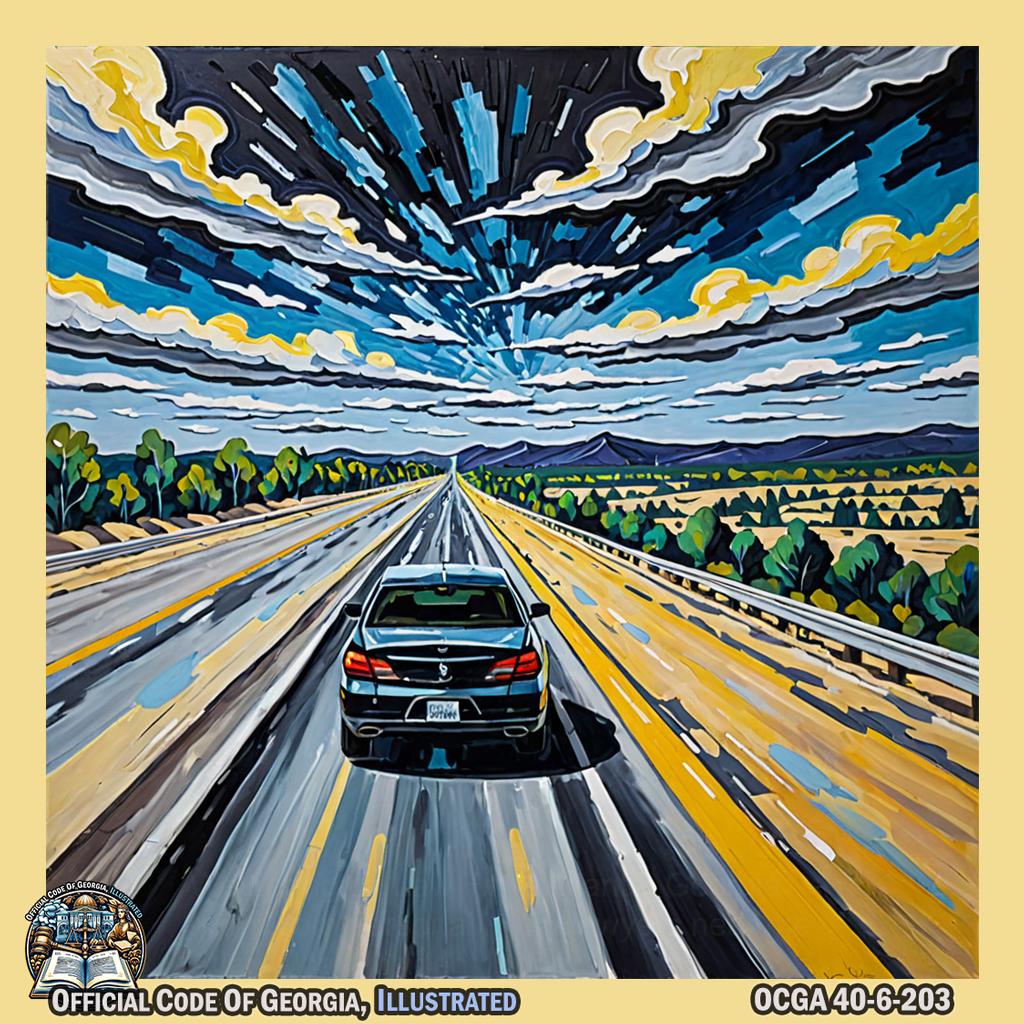
In a scene set in Roswell, Dylan Cease gracefully glides across the controlled-access highway, mimicking the fluid movements seen in Georges Braque's art, capturing the essence of controlled chaos. -@DylanCease -
In the area between roadways of a divided highway, including crossovers; or

Secretary of State Dean Rusk gracefully gesturing with outstretched arms, embodying the concept of a divided highway with crossovers, in a surrealist art piece reminiscent of Man Ray's style and set in Stockbridge, Georgia. -
At any place where official signs prohibit stopping;
- Stand or park a vehicle, whether occupied or not, except momentarily to pick up or discharge a passenger or passengers:
- In front of a public or private driveway;
-
Within 15 feet of a fire hydrant;
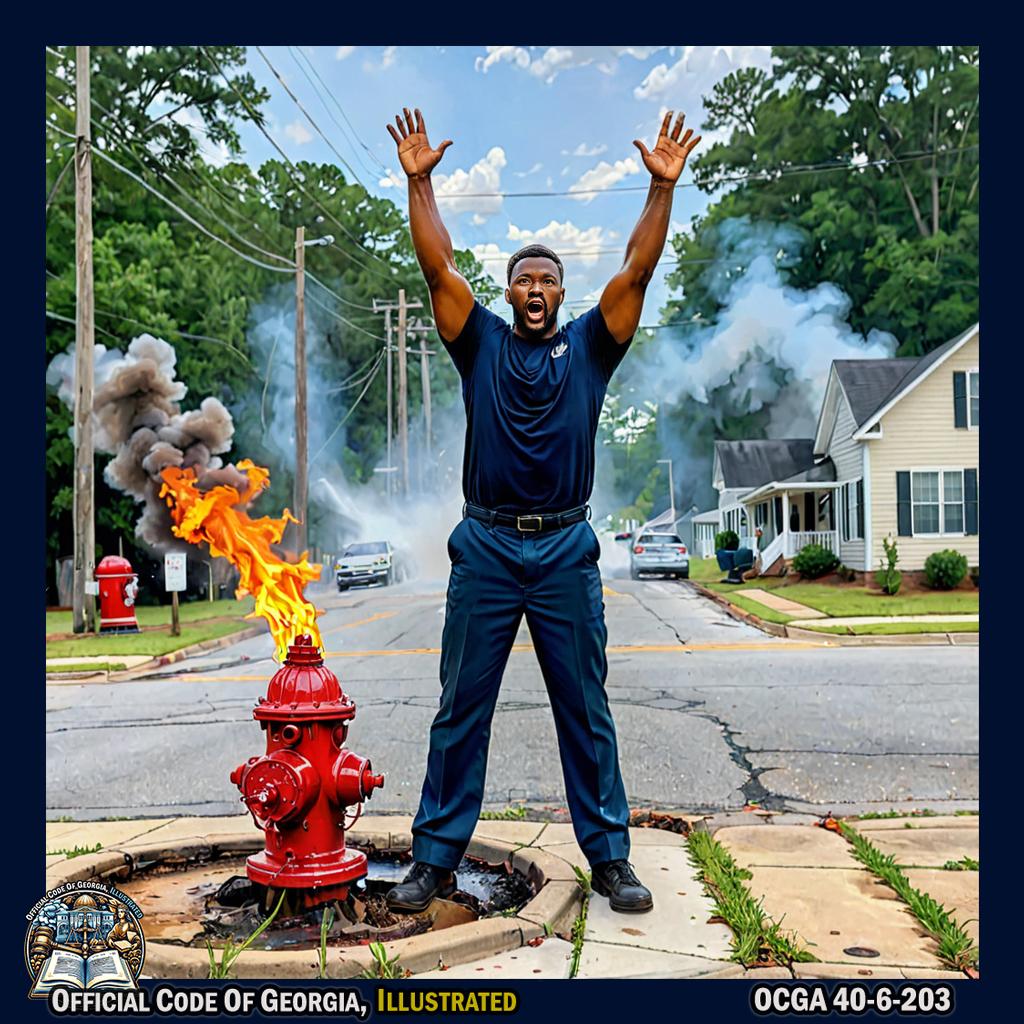
Trevard Lindley dramatically posing with outstretched arms and a fierce expression, standing within feet of a fire hydrant in McDonough, Georgia. -
Within 20 feet of a crosswalk at an intersection;
- Within 30 feet upon the approach to any flashing signal, stop sign, yield sign, or traffic-control signal located at the side of a roadway;
- Within 20 feet of the driveway entrance to any fire station or on the side of a street opposite the entrance to any fire station within 75 feet of such entrance (when properly posted); or
- At any place where official signs prohibit standing; or
- Park a vehicle, whether occupied or not, except temporarily for the purpose of and while actually engaged in loading or unloading property or passengers:
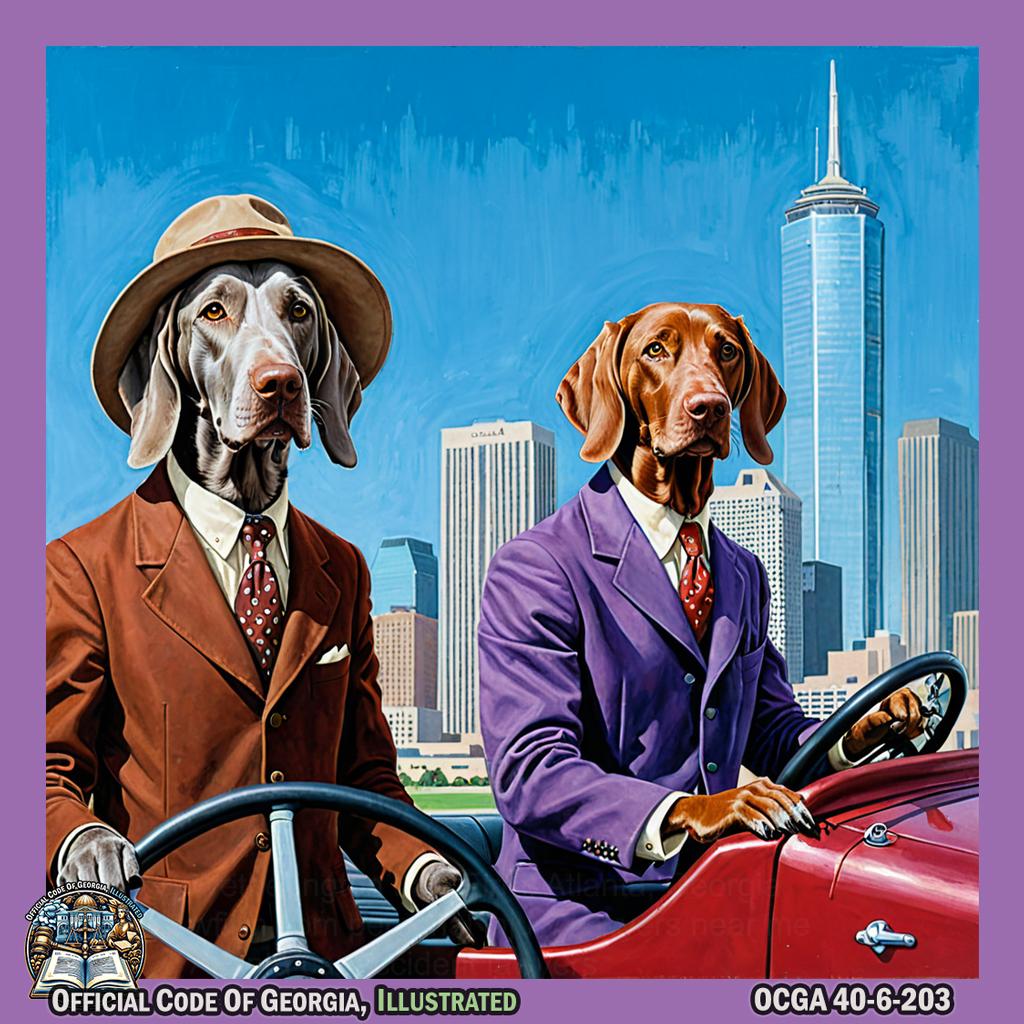
Berry Oakley, dressed in Wegman-esque human clothing, mimics steering a wheel and then pretends to load imaginary objects into the back of a vehicle while Weimaraner dogs dressed as passengers get in and out against a backdrop of the iconic Dallas skyline.
- Park a vehicle, whether occupied or not, except temporarily for the purpose of and while actually engaged in loading or unloading property or passengers:
- Within 50 feet of the nearest rail of a railroad crossing; or
- At any place where official signs prohibit parking.
-
-
No person shall move a vehicle not lawfully under his control into any prohibited area or to such a distance away from the curb as is unlawful.
- Notwithstanding any other provision of law, any vehicle used solely for the purpose of collecting municipal solid waste or recovered materials as defined in Code Section 12-8-22 may stop or stand on the road, street, or highway for the sole purpose of collecting such waste or materials; provided, however, that such vehicle shall maintain flashing hazard lights at all times that it is engaged in stopping or standing for the purpose of waste or materials collection.
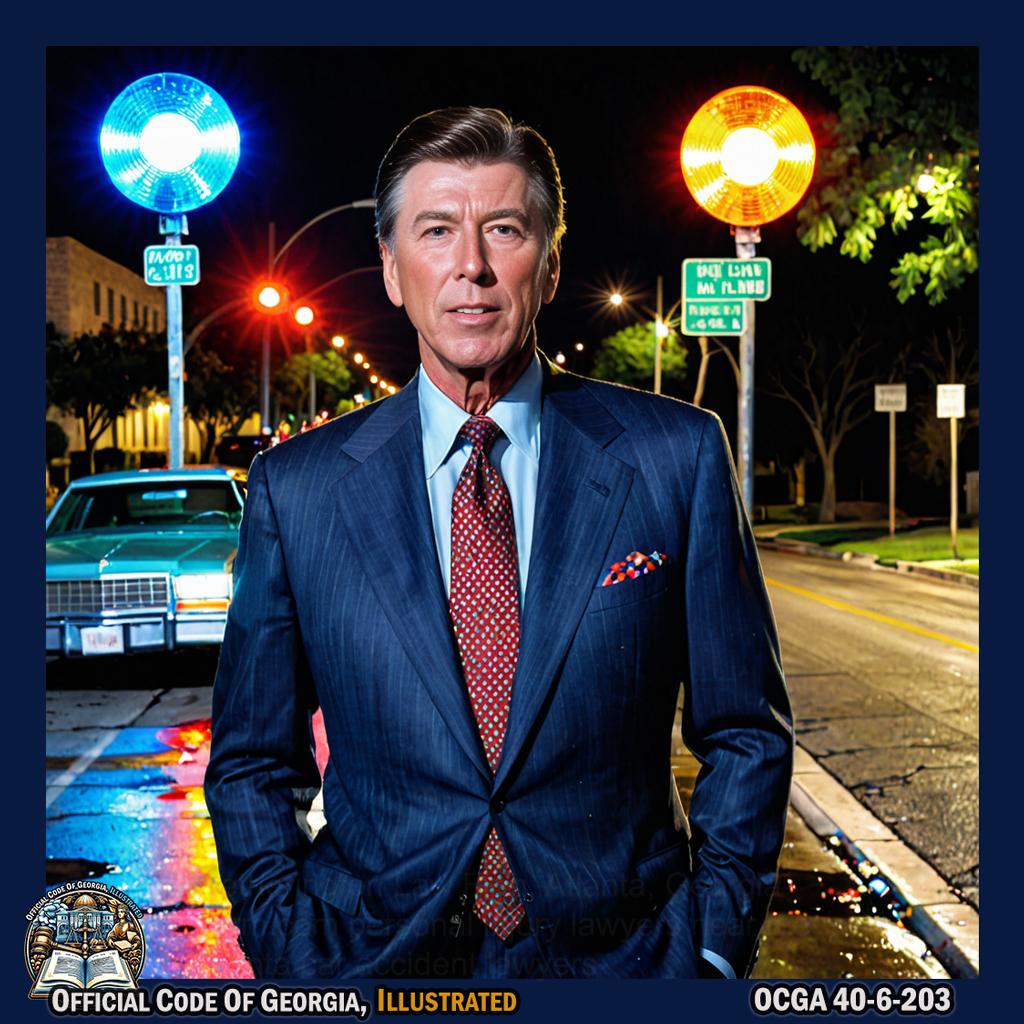
James C. Miller III, as budget director for President Ronald Reagan, stands on a Dallas street with flashing hazard lights, miming the act of collecting waste while embodying the exaggerated and theatrical style of Cindy Sherman's art pieces.
40-6-204.Exception as to disabled vehicles.¶
Code Sections 40-6-200, 40-6-202, and 40-6-203 shall not apply to the driver of any vehicle which is disabled while on the roadway in such a manner and to such extent that it is impossible to avoid stopping and temporarily leaving such disabled vehicle in such position.

40-6-205.Obstructing intersection.¶
No driver shall enter an intersection unless there is sufficient space on the other side of the intersection to accommodate the vehicle he is operating without obstructing the passage of other vehicles or pedestrians, notwithstanding any traffic-control signal indication to proceed.
40-6-206.When police officers may remove vehicles; uninsured vehicles.¶
- Whenever any police officer finds a vehicle in violation of any of the provisions of Code Section 40-6-202, such officer is authorized to move such vehicle or require the driver or other person in charge of the vehicle to move it to a position off the roadway.
-
Any police officer is authorized to remove or cause to be removed to a place of safety any unattended vehicle illegally left standing upon any highway, bridge, or causeway or in any tunnel.
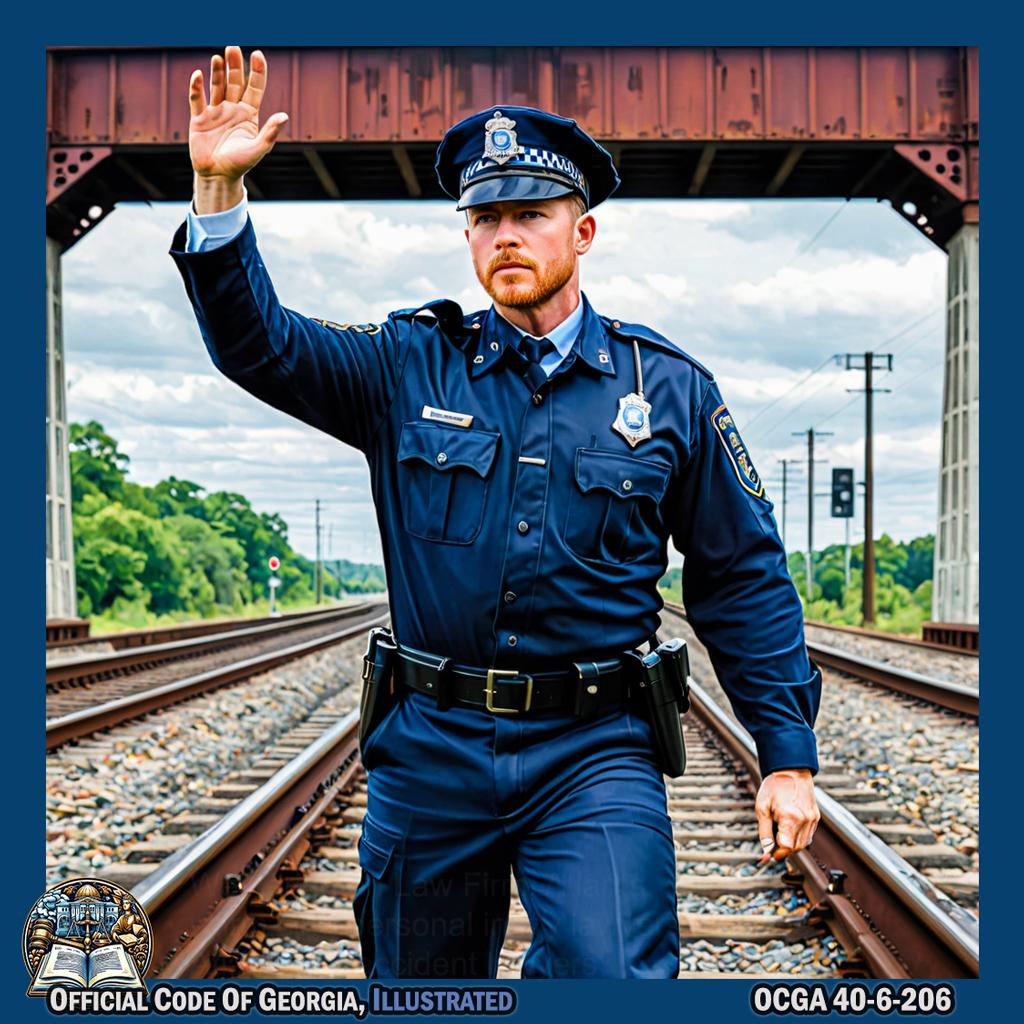
Gordon Beckham, dressed in a police uniform, dramatically gestures towards an unattended vehicle on the railway bridge while striking a powerful and dynamic pose reminiscent of Stephen Howard Naegle's art style. -@gordonbeckham -
Any police officer is authorized to remove or cause to be removed to the nearest garage or other place of safety any vehicle found upon a highway when:
- Report has been made that such vehicle has been stolen or taken without the consent of its owner;
- The person or persons in charge of such vehicle are unable to provide for its custody or removal;
-
The person driving or in control of such vehicle is arrested for an alleged offense for which the officer is required by law to take the person arrested before a proper magistrate without unnecessary delay;

Collin McHugh dramatically steering a vintage car while being handcuffed by an officer and surrounded by flashing lights, all captured in the style of a surrealist painting reminiscent of Salvador Dali's dreamlike landscapes. -@Collin_McHugh -
Any such vehicle has been left unattended for 24 hours or more; or
- Such vehicle is stopped, except when traffic congestion makes movement impossible, on a controlled-access highway which is part of The Dwight D. Eisenhower System of Interstate and Defense Highways for more than eight hours, unless such vehicle constitutes a traffic hazard, in which case it may be removed immediately.

Samuel Little stands in the middle of a controlled-access highway, surrounded by stopped vehicles and traffic congestion. He raises his arms dramatically as if to showcase the impossibility of movement, embodying the concept of a traffic hazard on The Dwight D Eisenhower System of Interstate and Defense Highways for more than eight hours. Annie Leibovitz captures this surreal moment at Alligator Adventure, infusing it with her signature artistic style.
-
Because uninsured vehicles pose a threat to the public safety and health, any law enforcement officer is authorized to remove or cause to be removed to the nearest garage or other place of safety the vehicle of a person who is charged under subsection (a) or (b) of Code Section 40-6-10 if such person admits to the law enforcement officer that there is no insurance in effect on the vehicle or if the law enforcement officer verifies that the proof of insurance provided by such person is fraudulent.

Brandon Mosley strides confidently towards an uninsured vehicle, his body language exuding authority as he signals to remove the vehicle to ensure public safety and health. The scene is captured with dramatic lighting and dynamic composition, evoking the style of Richard Avedon's art pieces at Quinlan Visual Arts Center.
40-6-207.Liability of owner for traffic or parking violations occurring while vehicle leased to another; duty of owner to attend hearing on the offense; improper vehicle maintenance.¶
-
The owner of any motor vehicle leased to another shall not be liable for a state, county, or municipal traffic or parking violation occurring while such leased vehicle was not in the owner’s possession or control, if upon notice of the violation the owner notifies the clerk of the court in which the case is pending of the name and address of the lessee of the vehicle on the date the violation occurred. If the owner fails to submit the notice, the court in which the case is heard may find the owner of the motor vehicle liable for the violation.
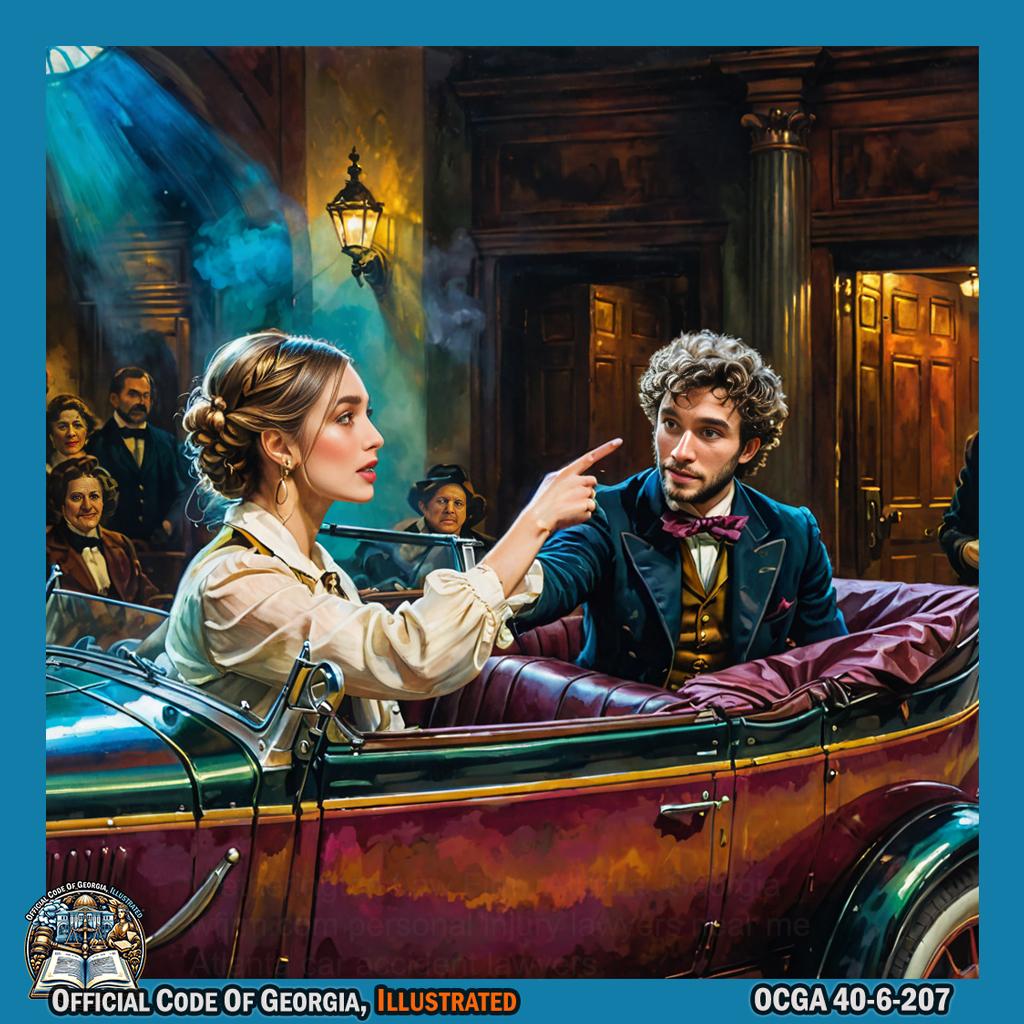
Morgan Brian sitting in a vintage car, handing over the keys to another person while pointing towards a court clerk, with dramatic lighting and vibrant colors reminiscent of the art style of Rembrandt. -@moeebrian -
After providing the name and address of the lessee, the owner shall not be required to attend a hearing on the offense, unless notified that the offense occurred through a mechanical failure of the vehicle which resulted from the owner’s failure to maintain the vehicle.
- The owner of any leased vehicle shall be liable for any violation which was caused by the owner’s failure to maintain the vehicle properly. The lessee claiming the violation resulted from the owner’s failure to maintain the vehicle properly shall notify the clerk of the court in which the case is pending along with the owner of the vehicle of the claim within seven days after receiving notice of the violation or at least ten days prior to the date the case will be heard by the court, whichever is later.
40-6-208.Parking areas for passengers of rapid rail or public transit buses; violations.¶
-
In all parking lots, parking decks, and other such facilities owned or operated by any public transit authority or established for the exclusive purpose of providing parking for passengers of rapid rail or public transit buses, it shall be unlawful to:
- Stop, stand, or park a vehicle other than in marked spaces designed for that purpose;
- Stop, stand, or park a vehicle on any yellow curb;
- Stop, stand, or park a vehicle in any location which results in impeding ingress or egress to said facility or which results in impeding the free passage of any other vehicle;
-
Leave any vehicle unattended in areas designated as “kiss-ride” or designated as “attended vehicles only”;
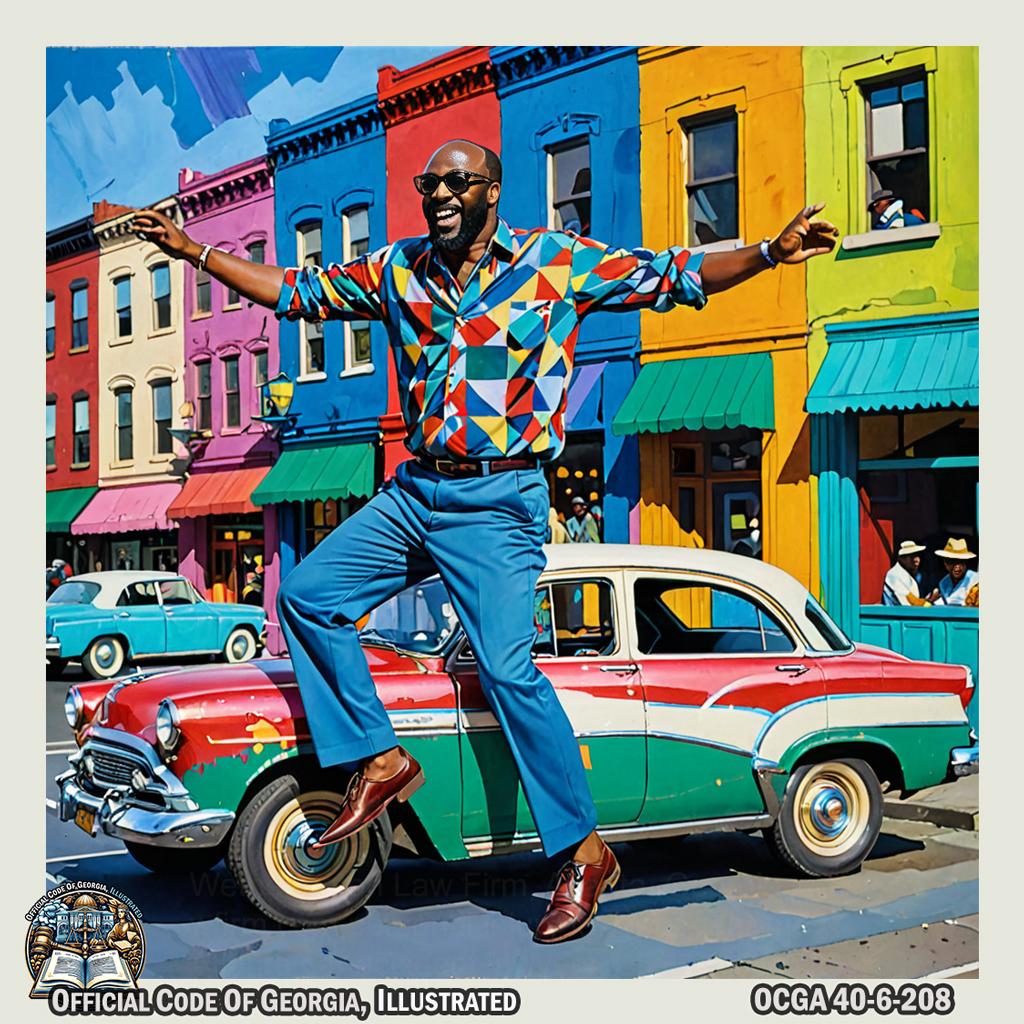
Corey Smith playfully dancing around a vintage car in a bustling, colorful Dublin street, mimicking the act of leaving it unattended while surrounded by vibrant, abstract shapes and patterns reminiscent of Romare Bearden's art. -@coreysmithmusic -
Stop, stand, or park any taxicab or other vehicle for hire, whether attended or unattended, in any area not specifically designated for such vehicles;
- Stop, stand, or park any vehicle for the purpose of loading or unloading passengers, except in areas specifically designated for that use, such as “kiss-ride” or “passenger drop-off” areas;
-
Stop, stand, or park any vehicle for a period in excess of 24 hours unless such parking area is designated “overnight” or “long-term” parking;
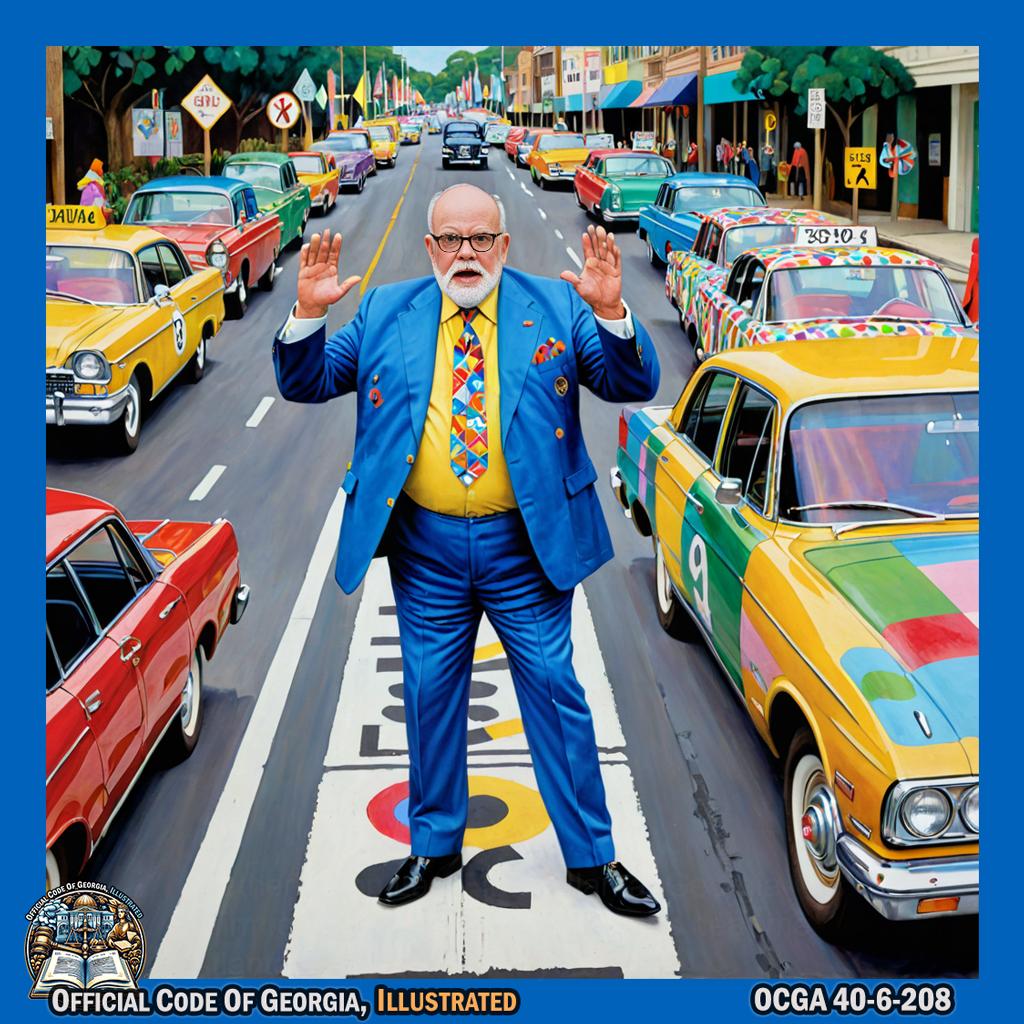
Conrad Tillard, dressed in a vibrant outfit, dramatically gestures as if directing traffic while surrounded by colorful parked vehicles adorned with whimsical symbols and patterns, creating a lively art piece reminiscent of Peter Blake's style. -
Stop, stand, or park any vehicle for any purpose other than to board the rapid rail car or public transit bus serving such parking lot; or
- Create or maintain any fire or flame, including fires or flames for cooking or grilling, or to fail to extinguish said fire or flame and to remove from such public transit parking facility all debris and residue associated with the creation and maintenance of said fire or flame.
-
Any person violating subsection (a) of this Code section shall be subject to a fine levied by the municipality or, in the case of properties located outside the boundaries of a municipality, by the county in which the offense occurs. Such offense shall be cited by the issuance of a written citation which shall be left on the violator’s vehicle and which shall contain, at a minimum:

Ousman Krubally, dressed in a striking basketball uniform, mimics writing a citation and places it on an imaginary car with dramatic flair reminiscent of Robert Graham's style, all set against the vibrant backdrop of Oakland City neighborhood in Atlanta. -@OusjuiceKrub - The nature of the violation;
-
The amount of the fine which will be levied for such violation;

Louise Simonson dramatically raises her hand and points her finger towards the sky, with a bold, exaggerated expression on her face, as if declaring the amount of the fine which will be levied for such violation in a comic book-style art piece reminiscent of Roy Lichtenstein's work, set against the picturesque backdrop of Senoia Main Street in Senoia, Georgia. -@LouiseSimonson -
That the cited individual has the right to contest the citation and be given an opportunity to be heard;
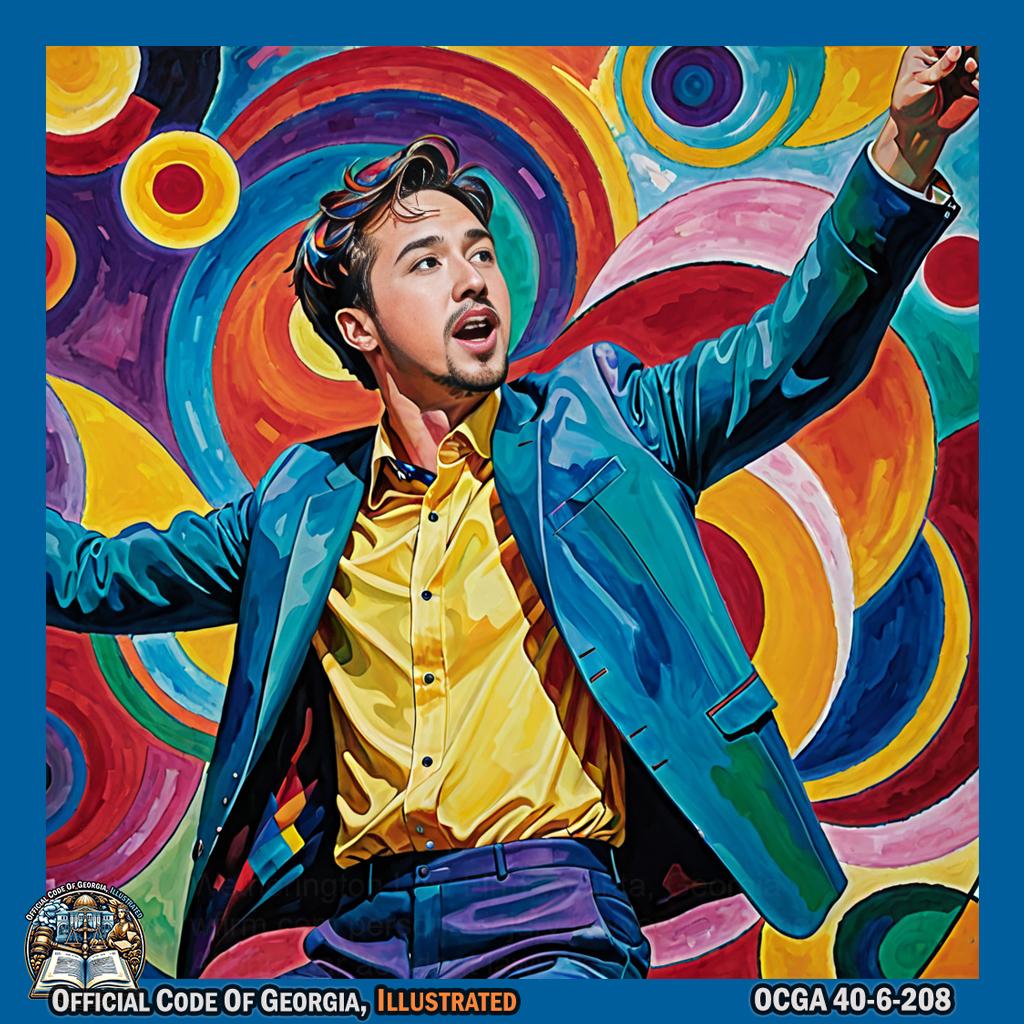
Devon Werkheiser gracefully dances while using expressive hand gestures to mimic speaking and gesturing for attention, surrounded by vibrant, swirling abstract shapes and colors in the style of Wassily Kandinsky, immersing the audience in a visually stunning and captivating performance. -@devonwerkharder -
The location of the court in which the cited individual must appear within five days of the date of the citation to contest same; and
- The location at which fines may be paid.

Rubi Rose gracefully dances beneath a grand chandelier, holding out her hand to receive payment at the elegant marble counter of the county courthouse in Monroe, while wearing a vibrant and bold graffiti-inspired outfit that pays homage to local street art. -@RubixxRose
-
Nothing in this Code section shall be construed to limit the enforcement of any other provision of state law which may be applicable, including, but not limited to, Part 2 of this article, the “Parking Law For Persons With Disabilities,” and the uniform rules of the road.
PART 2 Parking for Persons with Disabilities¶
-
40-6-220. Short title.

Guitarist and founding member of the new wave band The B-52s, Ricky Wilson, holds up a trophy with a giant smile, as if part of an art piece by Sandra Cinto. - 40-6-222. [Reserved] Permits.
- 40-6-223. [Reserved] Fees.
- 40-6-224. Out-of-state handicapped or persons with disabilities license plates or permits.
- 40-6-224.1. [Repealed] Handicapped parking places for the nonambulatory.
- 40-6-225. Parking places for persons with disabilities for the nonambulatory.
- 40-6-226. Offenses and penalties.
- 40-6-227. Application to both public and private property.
- 40-6-228. Enforcement.
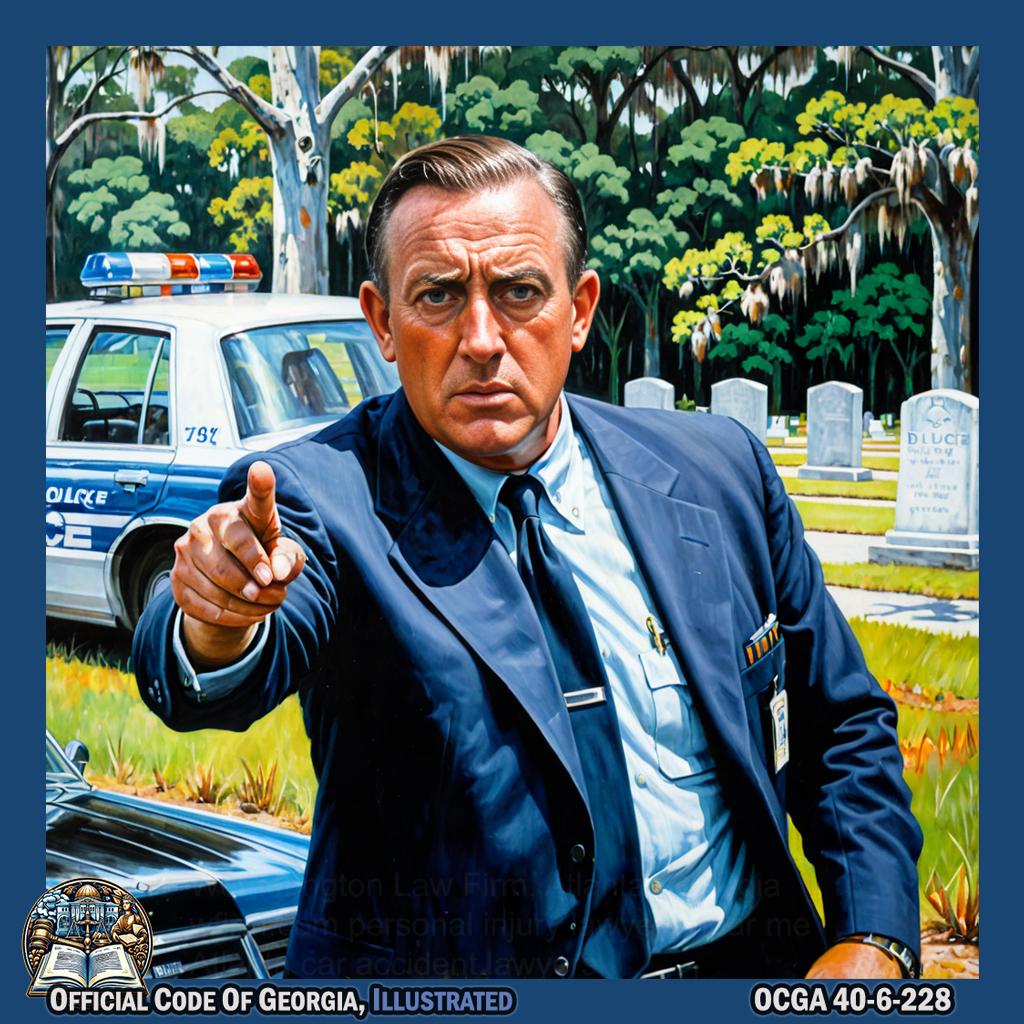
Businessman Gazaway Bugg Lamar pretended to be a police officer writing a ticket at the DuBignon Cemetery in Jekyll Island, Georgia, making a serious face and pointing at an imaginary car.
40-6-220.Short title.¶
This part shall be known and may be cited as the “Parking Law for Persons with Disabilities.”
40-6-221.Definitions.¶
As used in this part, the term:
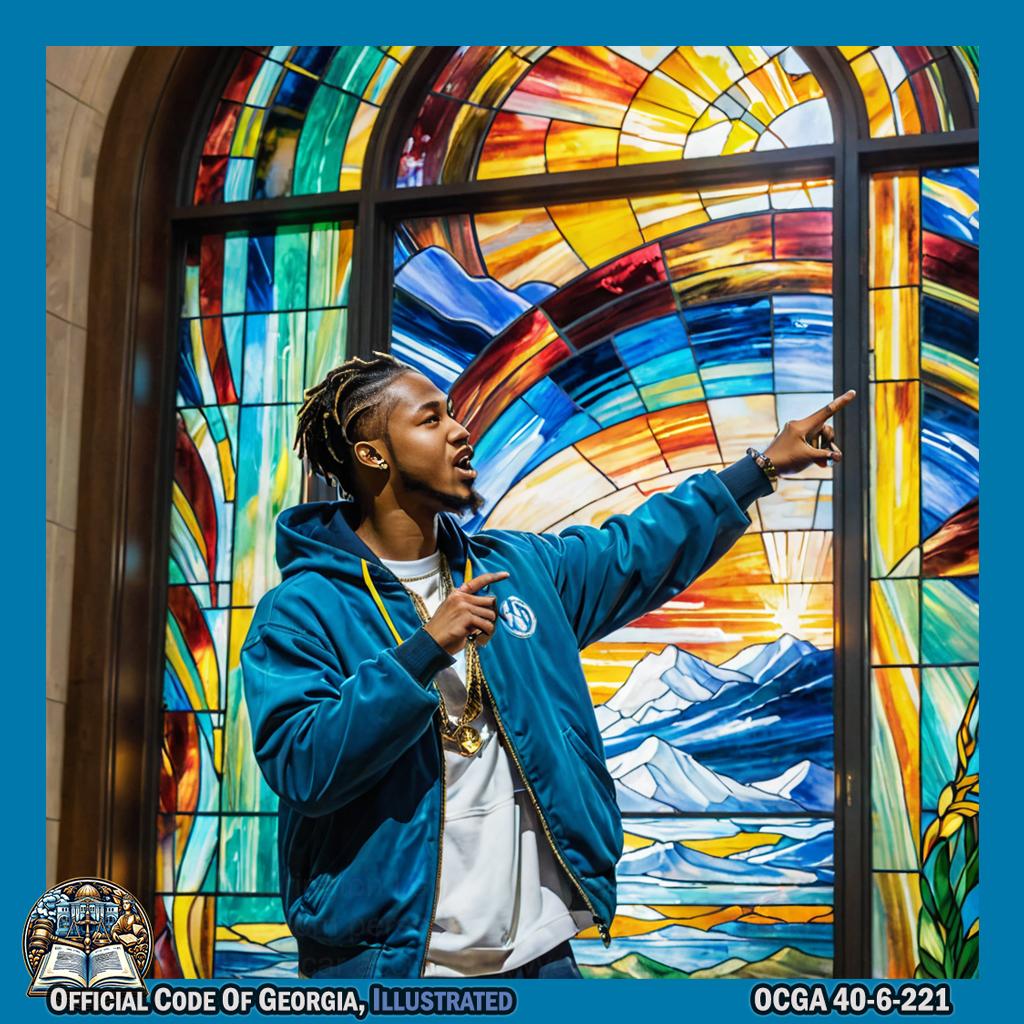
- “Counterfeit” means any copy of any kind of parking permit for persons with disabilities which is not authorized by and does not carry the official seal of the Department of Revenue.
- “Institution” means an institution for which a permit or conditional permit may be issued under Article 1 of Chapter 7 of Title 31.
-
“Parking place for persons with disabilities” means any area on public or private property which has been designated as reserved for use of persons with disabilities as follows:
- By a blue metal reflective sign which is at least 12 inches in width and 18 inches in length and is erected at a height of seven feet from the bottom of the sign to its ground surface and in such manner that it will not be obscured by a vehicle parked in the space and bearing the following words: “Permit Parking Only,” “Tow-Away Zone,” and the international symbol for accessibility. The warnings required in this subparagraph shall be centered on the sign, printed in white, and shall occupy not less than 75 percent of the surface area of the sign. The sign required by this subparagraph shall be the official authorized sign for parking place designations for persons with disabilities in this state. In addition, parking spaces which are required by Code Section 30-3-6 shall be designated as “For Disabled Persons With Ambulatory Assistive Devices Only”; or
- Where the parking place is on private property, is constructed solely from concrete, was used by the public or finished prior to July 1, 1987, and which is designated by having imprinted and maintained in reflective paint upon each such place the words “Tow-Away Zone” or “Parking Only for Persons with Disabilities” or the universal symbol of accessibility, that designation shall be deemed to meet the requirements of subparagraph (A) of this paragraph until such time as that concrete lot is renovated, repaired, or remodeled, at which time a sign shall be erected which shall comply with the requirements of subparagraph (A) of this paragraph.
-
“Permanently disabled person” means a person with disabilities whose disability or incapacity can be expected to last for more than 180 days.
-
“Person with disabilities” means a person who:
- Is so ambulatorily disabled that he or she cannot walk 200 feet without stopping to rest;
- Cannot walk without the use of or assistance from a brace, a cane, a crutch, another person, a prosthetic device, a wheelchair, or other assistive device;
-
Is restricted by lung disease to such an extent that his or her forced respiratory volume for one second, when measured by spirometry, is less than one liter, or when at rest, his or her arterial oxygen tension is less than 60 millimeters of mercury on room air;

Bumble Bee Slim, in the style of Florian Nicolle's art, struggles to take a breath, his chest heaving and shoulders hunched as if weighed down by an invisible force. The air around him seems thick and heavy, creating an atmosphere of suffocating tension. -
Uses portable oxygen;
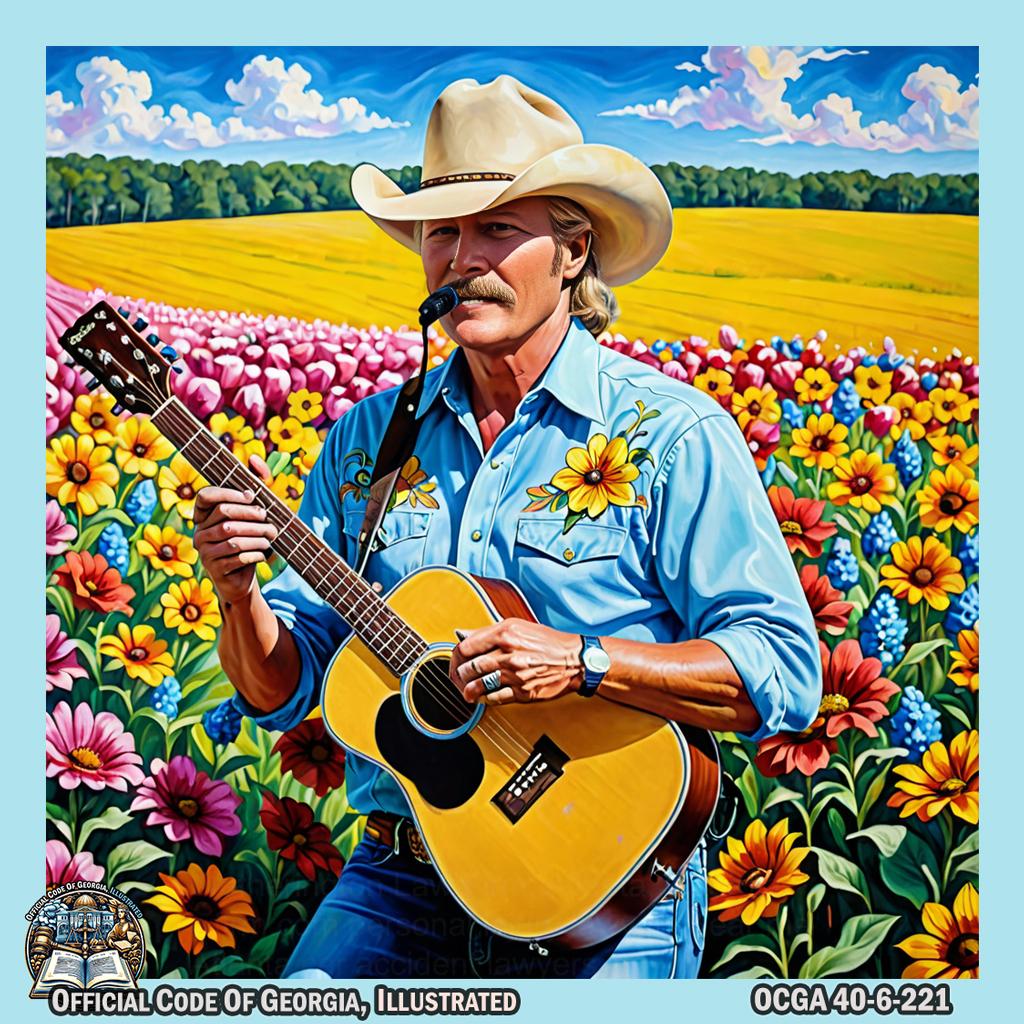
Alan Jackson gracefully holds a portable oxygen tank, singing and strumming his guitar as he moves through a field of vibrant flowers in Kennesaw, creating an artful performance piece that embodies the spirit of Georgia. -@OfficialJackson -
Has a cardiac condition to the extent that his or her functional limitations are classified in severity as Class III or Class IV according to standards set by the American Heart Association;
- Is severely limited in his or her ability to walk due to an arthritic, neurological, or orthopedic condition or complications due to pregnancy; or
- Is a blind individual whose central visual acuity does not exceed 20/200 in the better eye with correcting lenses or whose visual acuity, if better than 20/200, is accompanied by a limit to the field of vision in the better eye to such a degree that its widest diameter subtends an angle of no greater than 20 degrees.

Andritz gracefully extends his arms outward, framing an imaginary canvas in the air with a sweeping gesture, while tilting his head to one side as if capturing the essence of a mesmerizing sunset over Savannah, evoking the ethereal beauty of Claude Lorrain's art. -@Andritz
(5.1)“Practitioner of the healing arts” means a person holding a license to practice medicine, podiatric medicine, or chiropractic issued pursuant to Article 2 of Chapter 34 of Title 43, Chapter 35 of Title 43, or Chapter 9 of Title 43, respectively.
-
“Ramp” shall mean, in addition to any other specified meanings:

Tim Beckham stands on a ramp, arms outstretched in front of a vibrant backdrop of swirling colors and shapes reminiscent of Jean-Michel Basquiat's style, symbolizing the multifaceted meanings encompassed by the word "ramp." -@t_beckham1 -
Any ramp or curb ramp as defined in ANSI A117.1-1986 by Chapter 3 of Title 30; and

Anthony Carter gracefully glides down a curved ramp, embodying the fluidity and movement of Susie Frazier's artistic style, set against the backdrop of the lush Muddy Pond Mennonite Community. -
Any vehicle mounted lift used by handicapped persons for the purpose of access to and from the vehicle upon which it is mounted.
-
-
“Temporarily disabled person” means a person with disabilities whose disability or incapacity can be expected to last for not more than 180 days and shall include, but not be limited to, any woman who is pregnant and who presents a sworn affidavit of a medical doctor attesting to a medical need for access to parking for persons with disabilities.
40-6-222.[Reserved] Permits.¶
40-6-223.[Reserved] Fees.¶
40-6-224.Out-of-state handicapped or persons with disabilities license plates or permits.¶
State and local authorities shall honor visitors’ out-of-state handicapped license plates or persons with disabilities license plates and similar special parking permits on the same basis as license plates for persons with disabilities and special parking permits issued within this state.
40-6-224.1.[Repealed] Handicapped parking places for the nonambulatory.¶
40-6-225.Parking places for persons with disabilities for the nonambulatory.¶
Any business entity may elect to designate parking places for persons with disabilities for the nonambulatory. Such parking places for the nonambulatory shall be in addition to any parking places for persons with disabilities required by Chapter 3 of Title 30. Such parking places for the nonambulatory shall be clearly marked by a sign bearing the words “Parking for Persons with Disabilities — nonambulatory persons only.” Such parking places for the nonambulatory shall be utilized only for the purpose of allowing a nonambulatory permanently disabled person to enter or exit a vehicle while in such parking place. A vehicle in a parking place for the nonambulatory shall be required to have a valid unexpired parking permit for persons with disabilities or a specially designated license plate for disabled persons authorized under Code Section 40-2-74 or 40-2-74.1. For the purposes of this Code section, the term “nonambulatory permanently disabled person” means a person who is permanently disabled as a result of the loss or loss of use of one or both legs and who is dependent upon crutches, a walker, or a wheelchair for locomotion.
40-6-226.Offenses and penalties.¶
-
It shall be unlawful for any person to stop, stand, or park any vehicle in a parking place for persons with disabilities unless there is displayed on the driver’s side of the dashboard or hung from the rearview mirror of the parked vehicle a valid unexpired parking permit for persons with disabilities or unless there is attached to the vehicle a specially designated license plate for disabled veterans or other disabled persons authorized under Code Section 40-2-74 or 40-2-74.1 and unless such person is the person to whom such permit or license plate was issued; the person to whom such permit or license plate was issued is a passenger in the vehicle; or such vehicle is being used for the transportation of disabled passengers on behalf of the institution to which such permit was issued.
(a.1)It shall be unlawful for any person to stop, stand, or park any vehicle in a parking place for persons with disabilities which is designated “For Persons With Disabled Ambulatory Assistive Devices Only” unless:
- There is displayed on the driver’s side of the dashboard or hung from the rearview mirror of the parked vehicle a valid unexpired parking permit for persons with disabilities or unless there is attached to the vehicle a specially designated license plate for disabled veterans or other disabled persons authorized under Code Section 40-2-74 or 40-2-74.1; and
- A person with disabilities who is using a wheelchair, crutches, walker, or other ambulatory assistive device is the driver of or a passenger in such vehicle.
-
- It shall be unlawful for any person to stop, stand, or park any vehicle in a parking place for persons with disabilities except for the purpose of allowing a disabled person to enter or get out of such vehicle while in such parking place. However, nothing in this paragraph shall prevent an ambulance or emergency vehicle from stopping in a parking place for persons with disabilities.
-
It shall be unlawful for any person to stop, stand, or park any vehicle in a parking place for the nonambulatory as provided by a business pursuant to the provisions of Code Section 40-6-225 except for the purpose of allowing a nonambulatory permanently disabled person to enter or get out of such vehicle while in such parking place. However, nothing in this paragraph shall prevent an ambulance or emergency vehicle from stopping in a parking place for the nonambulatory.

Harriet Powers, depicted as a fabric silhouette by Margaret Wood Ward, gracefully guides a colorful patchwork vehicle into a designated parking spot marked with vibrant textile patterns for the nonambulatory. As she exits the vehicle, she assists an abstract figure representing a disabled person in exiting too, their forms composed of interwoven fabrics against the backdrop of The Glennville–Tattnall Museum's rich interior brimming with historical artifacts and educational displays. -
It shall be unlawful for any person to stop, stand, or park any vehicle in any area directly connecting with a parking place for persons with disabilities which area is clearly designed and designated for access to such parking place for persons with disabilities.

Joyce Grable gracefully and deliberately tiptoes through the area connecting with a parking place for persons with disabilities, embodying the spirit of Maria Sibylla Merian's art as she moves through the forgotten Braswell Mountain Rail Tunnel in Rockmart, Georgia.
-
It shall be unlawful for any person to obtain by fraud or counterfeit a parking permit for persons with disabilities.

Javianne Oliver gracefully lifts a fraudulent parking permit in an artfully choreographed dance, embodying the unlawful act with fluid movements and dynamic energy, all set against a backdrop of Joshua Yeldham's signature style at Tubman African American Museum. -@jayla_alane (c.1)It shall be unlawful for any person to knowingly and willfully make a false or misleading statement in an application for a parking permit for persons with disabilities or in the affidavit of a practitioner of the healing arts stating that an applicant is a disabled person.
-
It shall be unlawful for any person or institution, other than the one to whom a parking permit for persons with disabilities or specially designated license plate for the disabled person is issued, to make use of a parking permit for persons with disabilities or specially designated license plate for a disabled person unless the person to whom such permit or license plate was issued is a passenger in such vehicle. It shall be unlawful for any person to use a parking permit for persons with disabilities for any institutional vehicle other than the vehicle for which the permit has been issued. It shall be unlawful for any person to use a parking permit for persons with disabilities issued to an institution for any purpose other than to transport disabled persons.
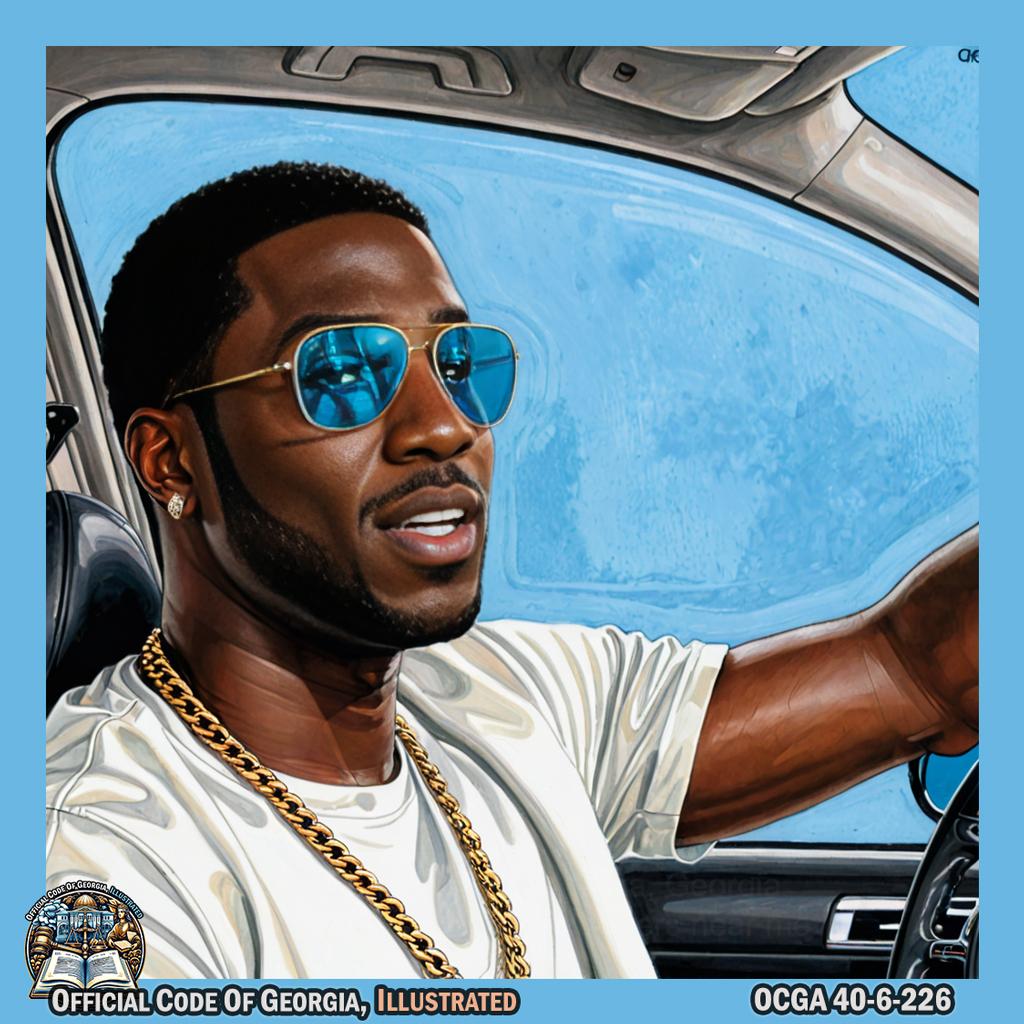
Gucci Mane sits in a car, putting up a parking permit for persons with disabilities on the rearview mirror, while gesturing to someone else to get into the vehicle. -@gucci1017 -
No person shall park a vehicle so as to block any entrance or exit ramp used by persons with disabilities on public or private property.
-
-
Any person violating subsection (c) or (c.1) of this Code section shall be guilty of a misdemeanor.

Keenan Webb, also known as DJ Suede the Remix God, stands in front of a large mural painted by Robert H. Hudson, wearing a vibrant costume and dramatically pointing at subsection (c) of the Code section while dancing to his own remixed music. -@Remixgodsuede -
Any person violating subsection (a), (a.1), (b), (d), or (e) of this Code section shall be subject to a fine of not less than $100.00 and not more than $500.00.
-
-
In addition to the penalties provided for in subsection (f) of this Code section, any vehicle which is illegally parked in a parking place for persons with disabilities which is marked by a sign bearing the words “Tow-Away Zone” as described in paragraph (3) of Code Section 40-6-221 on public or private property may be towed away or caused to be towed away by a proper law enforcement agency or the official security agency of said property at the expense of the owner of the vehicle or, if the vehicle is leased or rented, at the expense of the person responsible for payment on the lease or rental agreement.
- A property owner who is required to provide parking places for persons with disabilities shall designate each such place with a sign meeting the applicable requirements specified therefor by paragraph (3) of Code Section 40-6-221 and upon failure so to designate each such parking place for persons with disabilities shall be subject to a fine of $150.00 for each place which is not so designated; provided, however, that the fine will be waived if the required designation is made within 14 days from the date of citation. If that property owner fails or refuses to designate properly the parking places for persons with disabilities within such 14 days, the property owner shall, on the fifteenth day after receiving the citation, be subject to the $150.00 fine for each place and an additional $5.00 fine for each place for each day that the owner fails to comply with provisions of this subsection until the places are properly designated. All fines assessed under this subsection shall be paid into the treasury of the city or county issuing the citation against the owner.
40-6-227.Application to both public and private property.¶
The provisions of this part are applicable to both public and private property; and all law enforcement officers of this state and its political subdivisions are expressly authorized to enforce the provisions of this part on private property as well as on public property.
40-6-228.Enforcement.¶
-
Any county or municipal law enforcement agency of the state which is empowered to enforce the provisions of this part may, in its discretion, appoint any person who is a citizen of the United States, is of good moral character, and has not previously been convicted of a felony to enforce the provisions of Code Section 40-6-226 within the county or municipality in which the appointing law enforcement agency exercises jurisdiction. Each person appointed pursuant to this Code section shall take and subscribe an oath of office as prescribed by the appointing authority. Any person appointed and sworn pursuant to this subsection shall be authorized to enforce the provisions of this part in the same manner as any law enforcement officer of the state or any county or municipality of the state subject to the limitations provided in subsections (b) and (c) of this Code section.
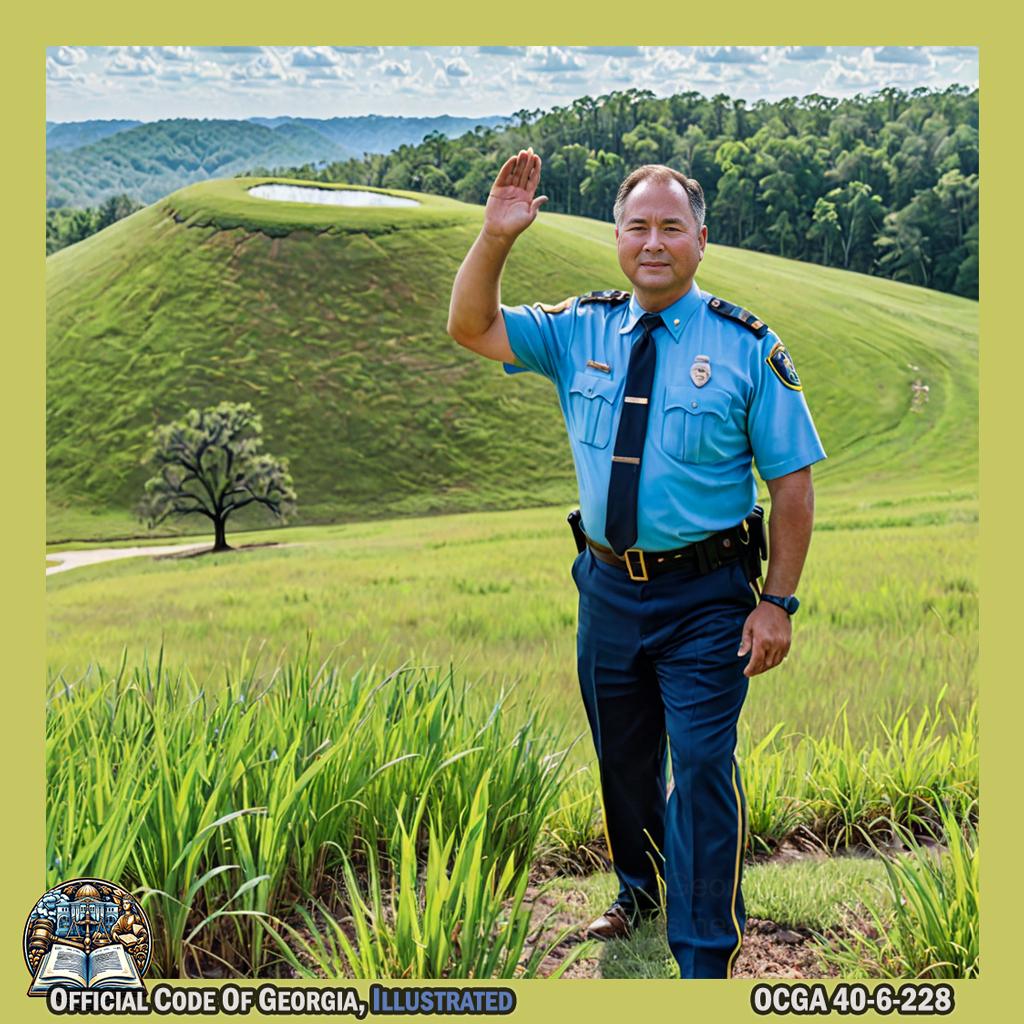
Mark Wills, embodying an officer, takes a deliberate stride up the Etowah Indian Mounds' grassy slope, raises his right hand in an oath-taking gesture as he gazes across the expansive landscape, symbolizing vigilance and commitment to community while his left hand rests over his heart showcasing integrity and moral character; all presented with the minimalist and organic aesthetic reminiscent of Maya Lin's designs. -@MarkWillsMusic -
No person appointed pursuant to subsection (a) of this Code section shall be deemed a peace officer under the laws of this state or:
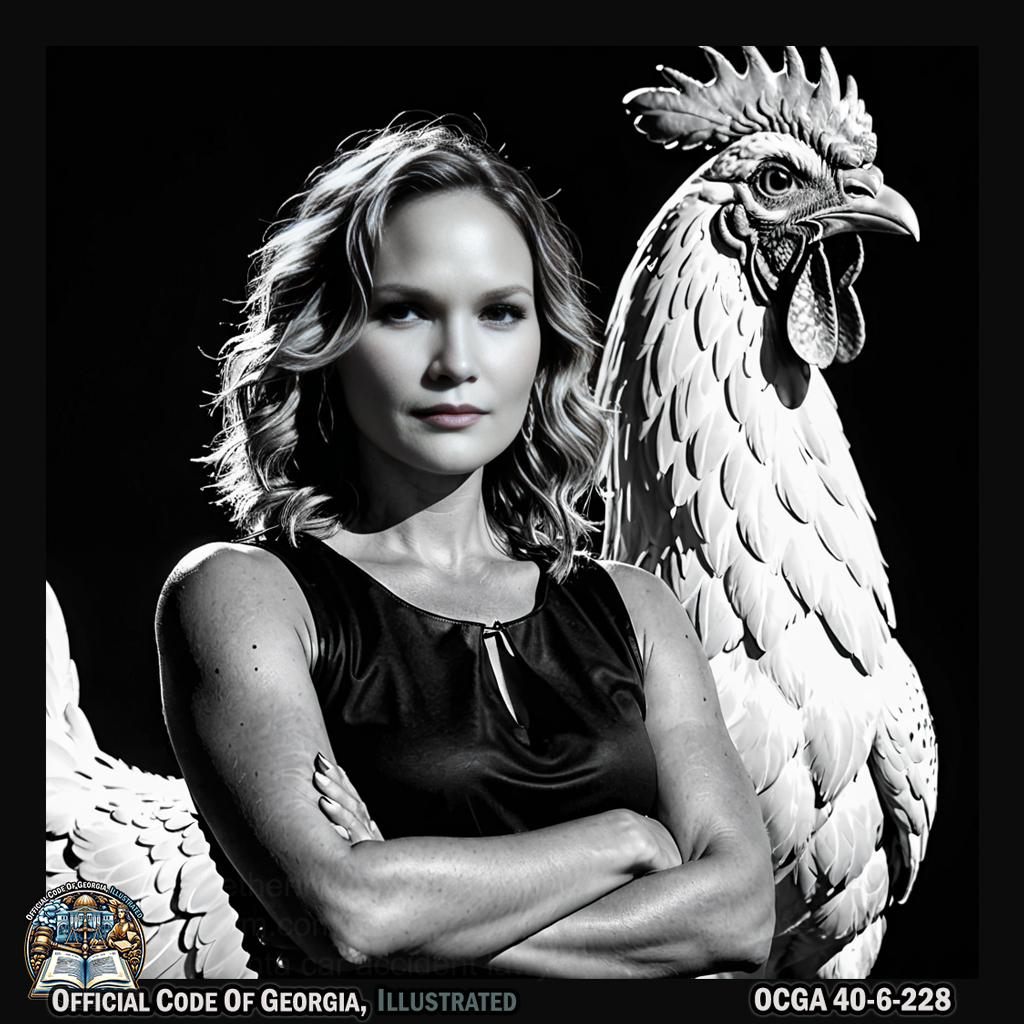
Jennifer Nettles posing confidently with her arms crossed, standing in front of the iconic Big Chicken in Marietta, Georgia, captured in black and white with dramatic lighting and strong shadows reminiscent of Herb Ritts' style. -@JenniferNettles -
Be deemed an employee of or receive any compensation from the state, county, municipality, or appointing law enforcement agency, but the appointing law enforcement agency shall provide any person so appointed with a uniform consisting of a pith helmet and a windbreaker jacket which shall remain the property of the appointing law enforcement agency;

Louise Simonson dons a pith helmet and windbreaker, playfully mimicking the act of being sworn in by an oversized peach sculpture as a badge, with Frank Gehry-inspired curvaceous structures and Lake Lanier in the background. -@LouiseSimonson -
Be required to complete any training or be certified pursuant to the requirements of Chapter 8 of Title 35;
- Have the power or duty to enforce any other traffic or criminal laws of the state, county, or municipality;
- Have the power to possess and carry firearms and other weapons for the purpose of enforcing the parking laws for persons with disabilities; provided, however, that a person who is a lawful weapons carrier as defined in Code Section 16-11-125.1 shall not be in violation of this paragraph; or
- Be entitled to any indemnification from the state, county, or municipality for any injury or property damage sustained by such person as a result of attempting to enforce the parking laws of the state for persons with disabilities.
-
-
Neither the state nor any county, municipality, or other political subdivision of the state or any department, agency, board, or officer of the state or any county, municipality, or political subdivision of the state shall be liable or accountable for or on account of any act or omission of any person appointed pursuant to this Code section in connection with such person’s enforcement of the provisions of Code Section 40-6-226. No person appointed pursuant to this Code section shall be liable on account of any act or omission in connection with such person’s enforcement of the provisions of Code Section 40-6-226.
- It shall be unlawful for any person willfully to obstruct, resist, impede, or interfere with any person appointed pursuant to this Code section in connection with such person’s enforcement of Code Section 40-6-226 or to retaliate or discriminate in any manner against such person as a reprisal for any act or omission of such person. Any violation of this subsection shall be punishable as a misdemeanor.
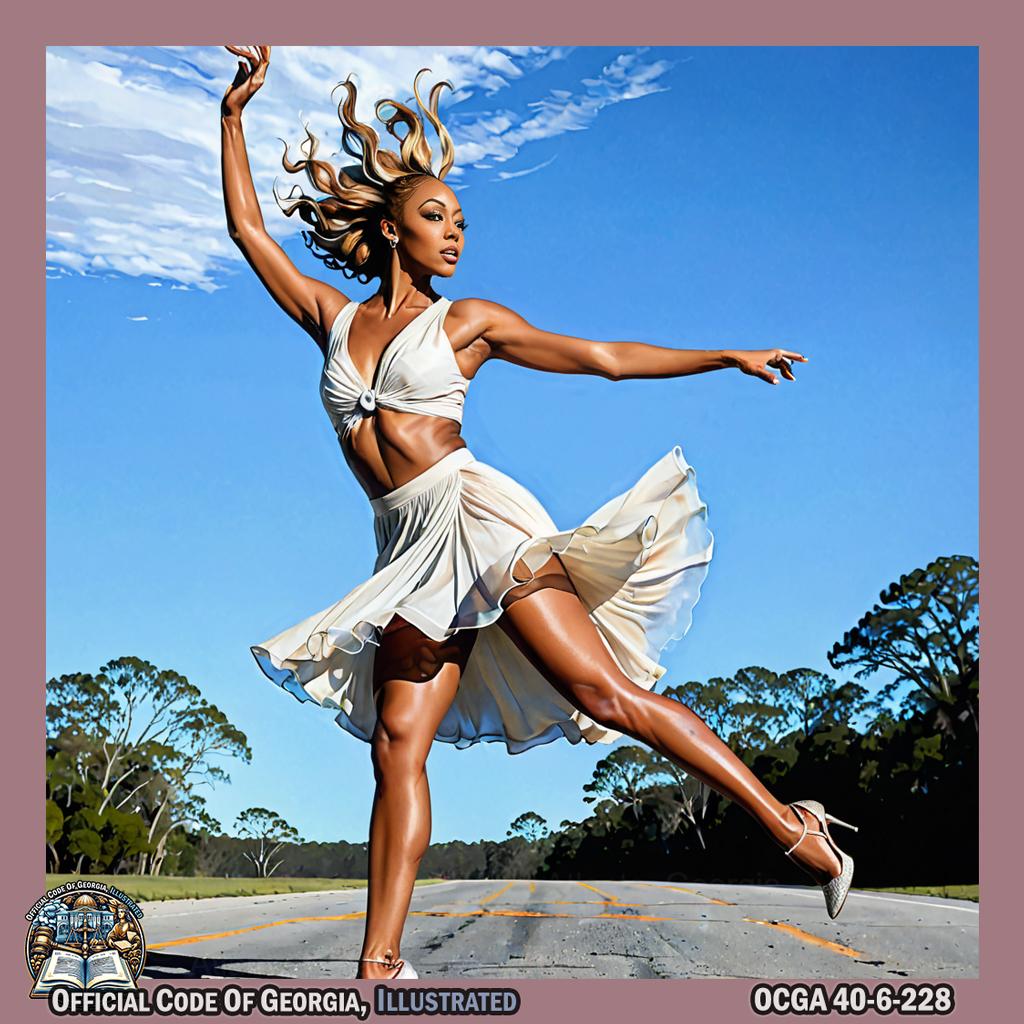
Keri Hilson gracefully twirls in a fluid, captivating motion while enacting the defiance and resistance of a person willfully obstructing an authority figure, all captured in the dreamy, collage-style artistry of Matt Wisniewski, set against the picturesque backdrop of Moultrie. -@KeriHilson
Article 11 Miscellaneous Provisions¶
-
40-6-240. Backing.
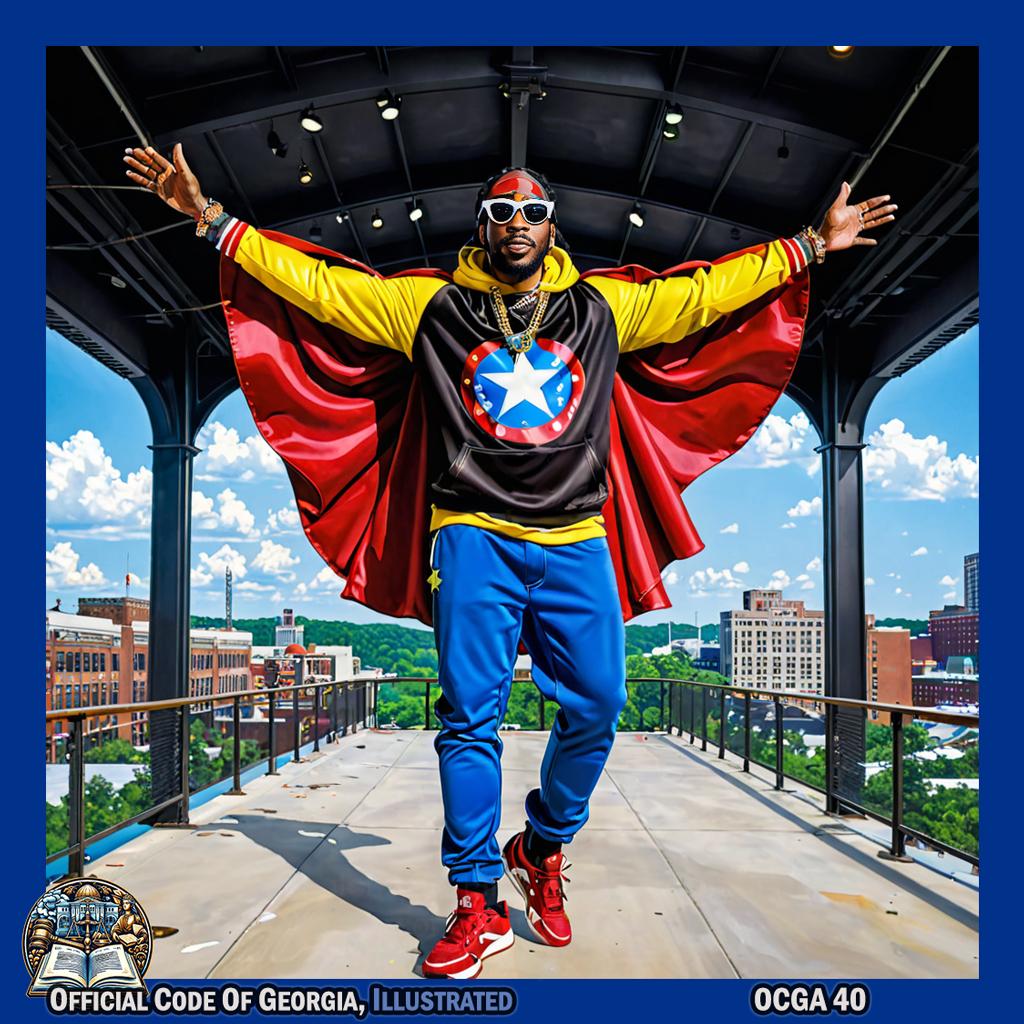
Rapper 2 Chainz pretends to be a superhero flying backward with his arms outstretched and his cape billowing behind him in the opulent surroundings of Ponce City Market, Georgia. -@2chainz -
40-6-241. Distracted driving; restrictions on operation of wireless telecommunications devices and stand-alone electronic devices; penalty; exceptions.

In a rich scene in Loanville, North Carolina-born sportswriter Furman Bisher performed a masterful juggling act behind the wheel, deftly swerving while balancing a phone, tablet, and GPS device with one hand. -
40-6-241.1. [Repealed] Definitions; prohibition on certain persons operating motor vehicle while engaging in wireless communications; exceptions; penalties.

6LACK extends his arms, creating a large "X" to symbolize the action of "Repealed Definitions," captured in the bold, graphic style of a Donald Sultan art piece. -@6LACK -
40-6-241.2. [Repealed] Writing, sending, or reading text based communication while operating motor vehicle prohibited; prohibited uses of wireless telecommunications devices by drivers of commercial vehicles; exceptions; penalties for violation.

Singer Kristian Stanfill, depicted in a Florian Nicolle-esque art piece, mimics driving a large truck with dramatic gestures to emphasize not using a phone and being stopped by a police officer. -@kpstanfill -
40-6-242. Obstruction of driver’s view or interference with control of vehicle.

Demetrius McCray, the California-born football player, is seen sitting on the driver's lap attempting to drive in the rich scene of Collee Park, Georgia. -@mccrayd_10 - 40-6-244. Riding in house trailer.
-
40-6-245. Driving through canyon or on mountain highway.

Actress Cassie Yates, with hands on an imaginary steering wheel, wide-eyed with excitement, leaning left and right as if navigating sharp turns in the rich scene of Grovetown, Georgia, with a colorful scarf flowing behind her to indicate fast motion. - 40-6-247. Following fire apparatus or emergency vehicle.
- 40-6-248. Crossing fire hose.
- 40-6-248.1. Securing and covering loads on vehicles.
- 40-6-249. Littering highway.
- 40-6-250. Wearing device which impairs hearing or vision.
- 40-6-251. Driving in circular or zigzag course; “laying drags.”
- 40-6-252. Parking, standing, or driving vehicle in private parking area after request not to do so.
- 40-6-253. Consumption of alcoholic beverage or possession of open container of alcoholic beverage in passenger area.
- 40-6-253.1. Transportation of medical waste; exception; penalty for violation.
-
40-6-254. Operating vehicle without adequately securing load.

Poet Elizabeth Otis Dannelly balances a towering stack of items on a toy car, as they tumble off amidst the rich scenery of Stockbridge, Georgia. -
40-6-255. Driving away without paying for gasoline.
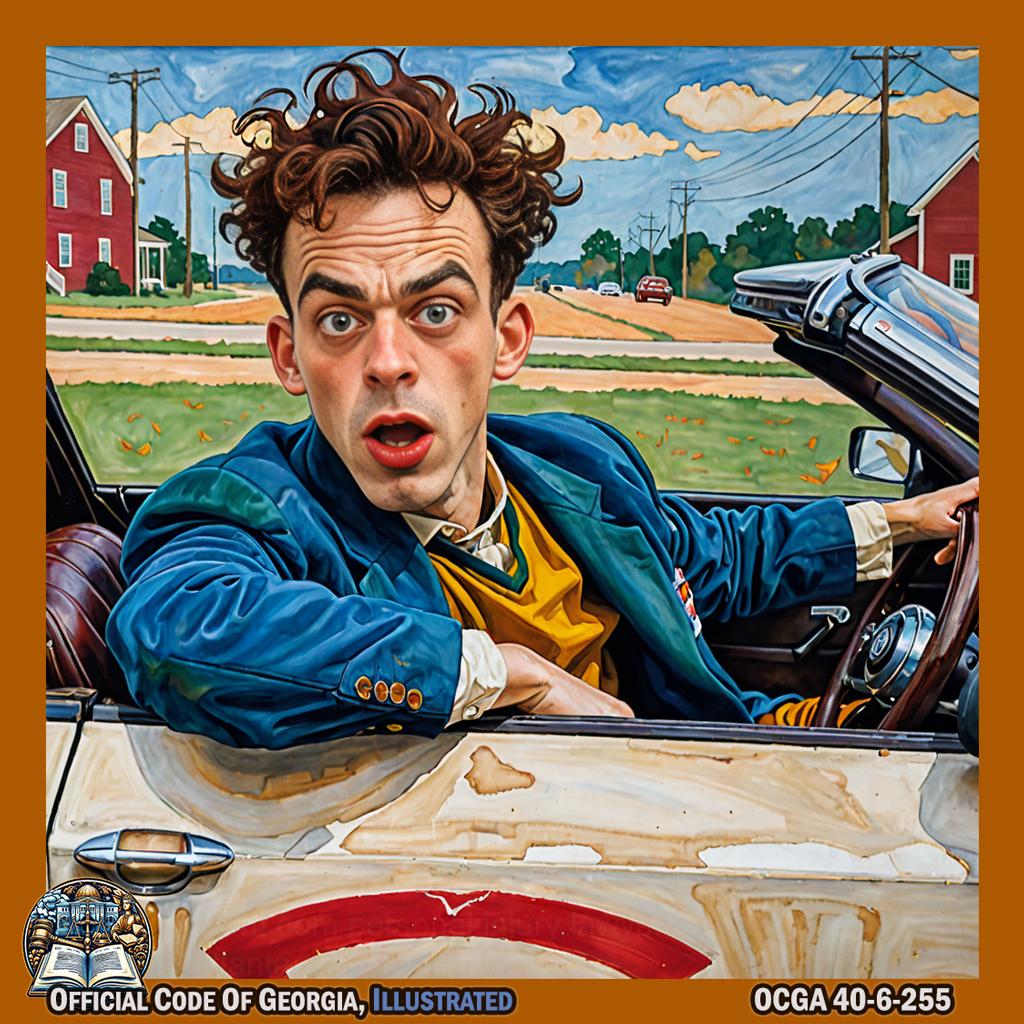
Basketball player Jordan Loyd playfully pantomimes driving a car at the Madison-Morgan Cultural Center in Georgia, making "vroom vroom" sounds and mischievously speeding away after pretending to refuel the car. -@mrjloyd
40-6-240.Backing.¶
- A driver shall not back a vehicle unless such movement can be made with safety and without interfering with other traffic.
- A driver of a vehicle shall not back a vehicle upon any shoulder or roadway of any controlled-access highway.
40-6-241.Distracted driving; restrictions on operation of wireless telecommunications devices and stand-alone electronic devices; penalty; exceptions.¶
-
As used in this Code section, the term:
- “Stand-alone electronic device” means a device other than a wireless telecommunications device which stores audio or video data files to be retrieved on demand by a user.
- “Utility services” means and includes electric, natural gas, water, waste-water, cable, telephone, or telecommunications services or the repair, location, relocation, improvement, or maintenance of utility poles, transmission structures, pipes, wires, fibers, cables, easements, rights of way, or associated infrastructure.
- “Wireless telecommunications device” means a cellular telephone, a portable telephone, a text-messaging device, a personal digital assistant, a stand-alone computer, a global positioning system receiver, or substantially similar portable wireless device that is used to initiate or receive communication, information, or data. Such term shall not include a radio, citizens band radio, citizens band radio hybrid, commercial two-way radio communication device or its functional equivalent, subscription based emergency communication device, prescribed medical device, amateur or ham radio device, or in-vehicle security, navigation, or remote diagnostics system.
-
A driver shall exercise due care in operating a motor vehicle on the highways of this state and shall not engage in any actions which shall distract such driver from the safe operation of such vehicle.
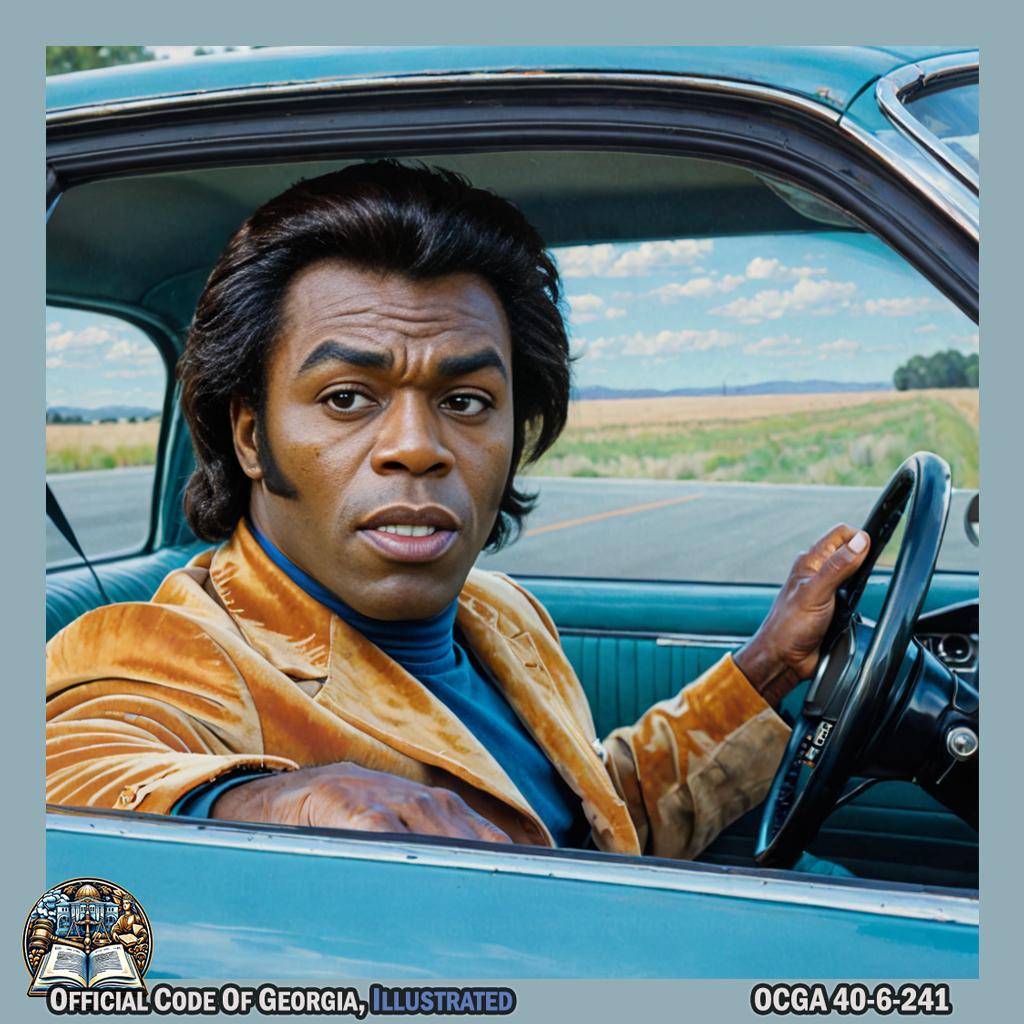
James Brown, as portrayed in a Cindy Sherman art piece, pretends to drive a car with one hand while holding a phone in the other, looking around and not paying attention to the road. -
While operating a motor vehicle on any highway of this state, no individual shall:
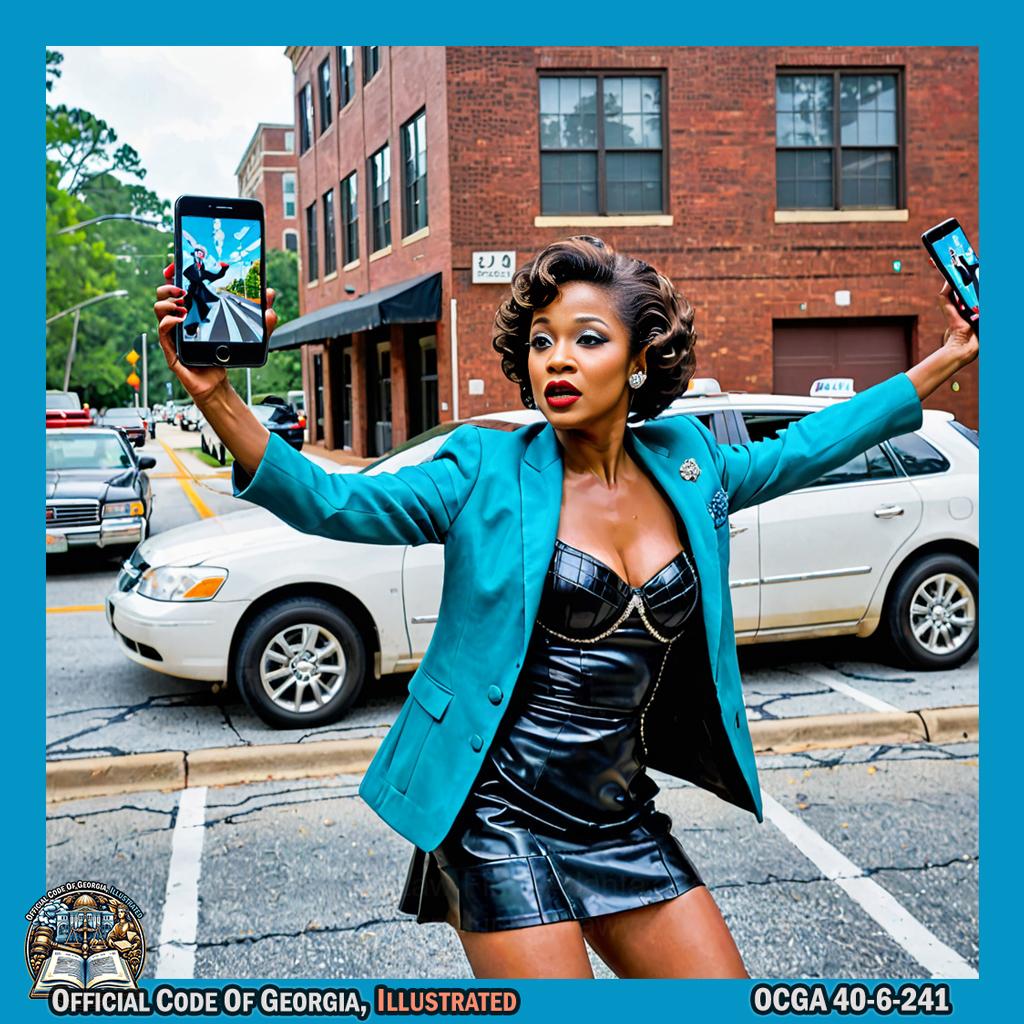
Perform a dramatic interpretive dance depicting the prohibition of using a mobile phone while driving, with Brenda Lee as the lead dancer in an avant-garde art piece set against the backdrop of Bankhead Courts neighborhood in Atlanta. -@BrendaL33287831 - Physically hold or support, with any part of his or her body a:

Dan Reeves gracefully balances a golden microphone on his fingertips as he arches his back and extends one leg in an elegant pose, surrounded by vibrant swirling colors and patterns inspired by Astra Parker's art, all set against the backdrop of the Ray Charles Memorial in Albany, Georgia. - Wireless telecommunications device, provided that such exclusion shall not prohibit the use of an earpiece, headphone device, or device worn on a wrist to conduct a voice based communication; or
- Stand-alone electronic device;
-
Write, send, or read any text based communication, including but not limited to a text message, instant message, e-mail, or Internet data on a wireless telecommunications device or stand-alone electronic device; provided, however, that such prohibition shall not apply to:

Gwen Torrence gracefully mimics typing on an invisible keyboard, her body swaying with fluid movements in a majestic art piece at Grovetown, Georgia. - A voice based communication which is automatically converted by such device to be sent as a message in a written form; or
- The use of such device for navigation of such vehicle or for global positioning system purposes;

Jared Cook gracefully gesturing as if operating a navigation device while embodying the strength and precision of a football player, set against a backdrop reminiscent of an abstract expressionist painting, blending athleticism with artistry in Statesboro, Georgia. -@JaredCook89
-
Watch a video or movie on a wireless telecommunications device or stand-alone electronic device other than watching data related to the navigation of such vehicle; or
- Record or broadcast a video on a wireless telecommunications device or stand-alone electronic device; provided that such prohibition shall not apply to electronic devices used for the sole purpose of continuously recording or broadcasting video within or outside of the motor vehicle.
- Physically hold or support, with any part of his or her body a:
-
While operating a commercial motor vehicle on any highway of this state, no individual shall:

Dancing with arms extended, miming driving a truck, while Playboi Carti performs in the style of Salvador Dali's "The Persistence of Memory." -@playboicarti -
Use more than a single button on a wireless telecommunications device to initiate or terminate a voice communication; or
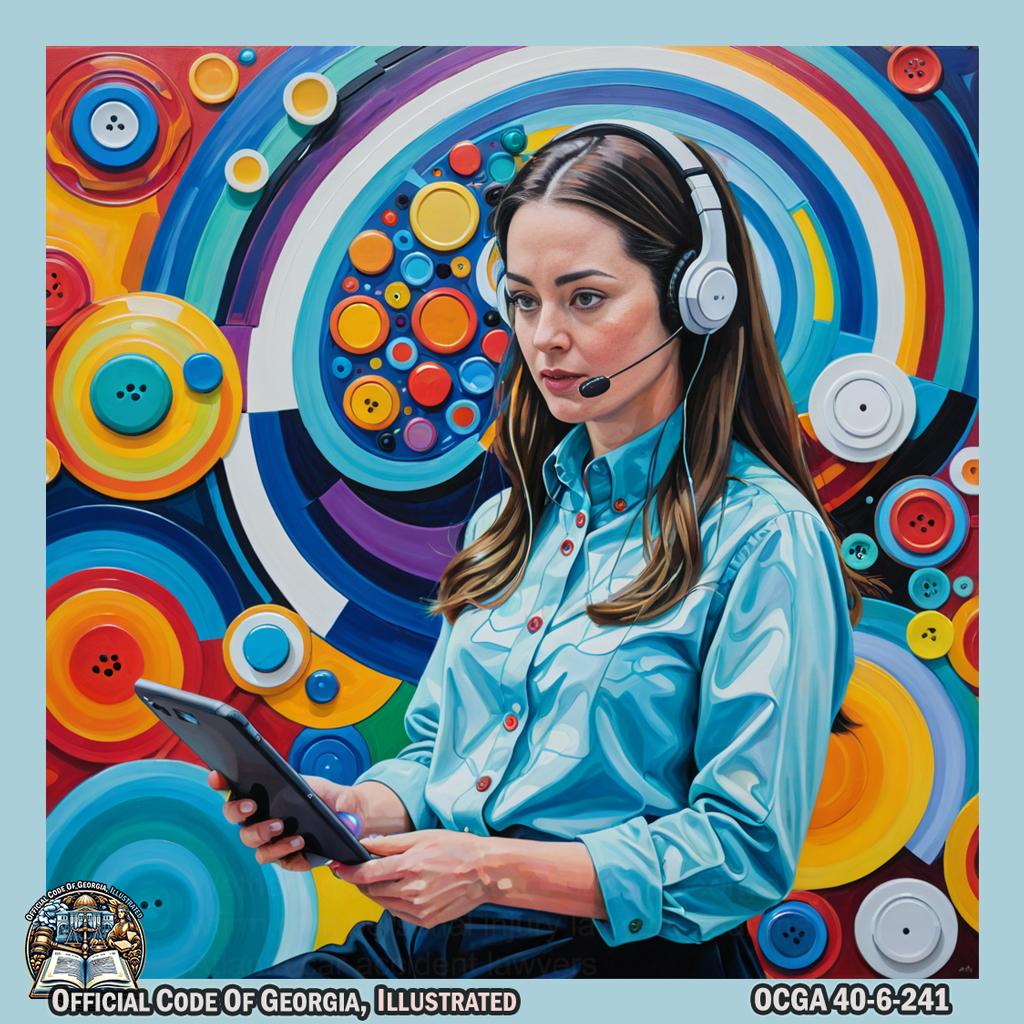
Amanda Doherty uses a wireless device with multiple buttons to initiate or terminate a voice call, while surrounded by colorful abstract shapes and patterns that represent the technological complexity of communication in Suwanee. -@amandadgolf -
Reach for a wireless telecommunications device or stand-alone electronic device in such a manner that requires the driver to no longer be:
-
In a seated driving position; or

Sahib Shihab reclines in a luxurious vintage car seat, one hand on the steering wheel and the other resting elegantly on the gear shift, exuding confidence and style in a dramatic black-and-white photo reminiscent of Helmut Newton's iconic fashion photography. -
Properly restrained by a safety belt.
- For a third or subsequent conviction within a 24 month period of time, as measured from the dates any previous convictions were obtained or pleas of nolo contendere were accepted to the date the current conviction is obtained or plea of nolo contendere is accepted, a fine of not more than $150.00, but the provisions of Chapter 11 of Title 17 and any other provision of law to the contrary notwithstanding, the costs of such prosecution shall not be taxed nor shall any additional penalty, fee, or surcharge to a fine for such offense be assessed against a person for conviction thereof.

Ellison Barber, dressed as a judge with a gavel in hand, acts out the process of issuing a fine by symbolically weighing scales of justice and then writing on an invisible paper, while standing amidst a backdrop of Snellville's vibrant greenery and historical landmarks. She pauses to look directly at the viewer with a stern yet educational gaze reminiscent of Sally Mann's intimate portraiture style, conveying the gravity of repeated legal offenses without words. -@ellisonbarber
-
-
-
Each violation of this Code section shall constitute a separate offense.
-
- Except as provided for in paragraph (2) of this subsection, any person convicted of violating this Code section shall be guilty of a misdemeanor which shall be punished as follows:
- Any person appearing before a court for a first charge of violating paragraph (1) of subsection (c) of this Code section who produces in court a device or proof of purchase of such device that would allow such person to comply with such paragraph in the future shall not be guilty of such offense. The court shall require the person to affirm that they have not previously utilized the privilege under this paragraph.

Sam Nunn walks into the ruins of Sir Goonys Golf Castle, holding a device and proof of purchase, then raises his right hand to affirm that he has not previously utilized the privilege under this paragraph.
-
Subsections (c) and (d) of this Code section shall not apply when the prohibited conduct occurred:
- While reporting a traffic accident, medical emergency, fire, an actual or potential criminal or delinquent act, or road condition which causes an immediate and serious traffic or safety hazard;
-
By an employee or contractor of a utility services provider acting within the scope of his or her employment while responding to a utility emergency;
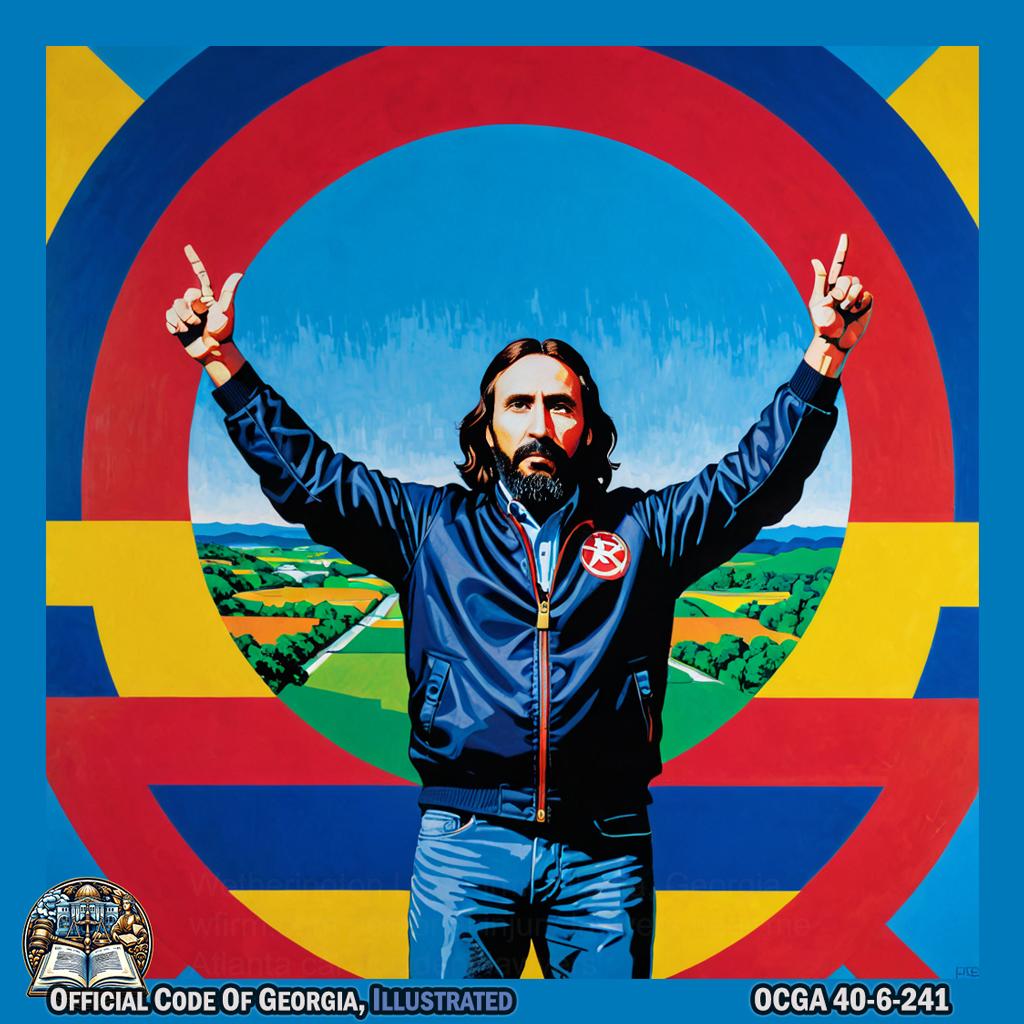
John C. Fremont, in the style of Robert Indiana's art piece, is depicted responding to a utility emergency by dramatically raising his arms and pointing towards the source of the emergency, surrounded by vibrant colors and bold geometric shapes, set against the backdrop of Carrollton's rich scenery. -
By a law enforcement officer, firefighter, emergency medical services personnel, ambulance driver, or other similarly employed public safety first responder during the performance of his or her official duties; or
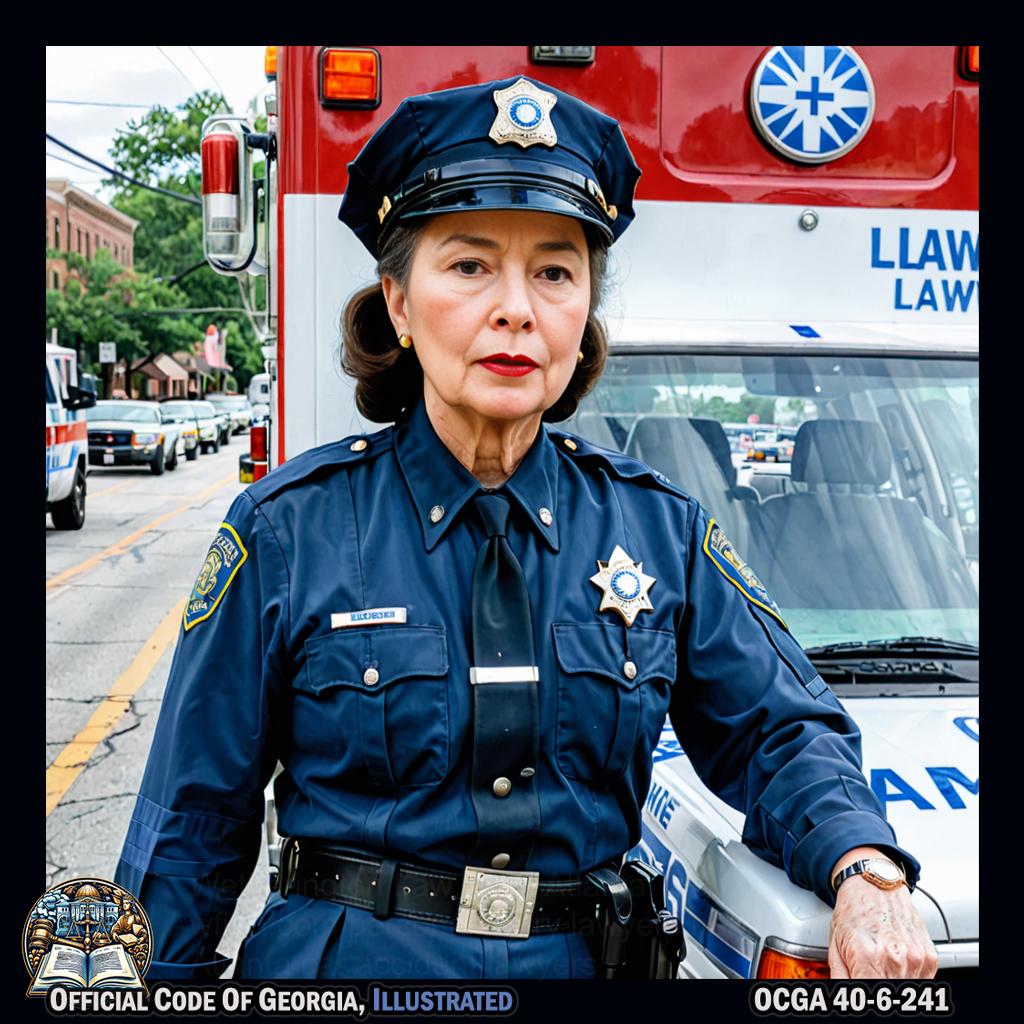
Margaret Mitchell, dressed as a law enforcement officer, fiercely driving an ambulance through Union City's streets while dramatically performing her official duties with urgency and dedication. -
While in a motor vehicle which is lawfully parked.
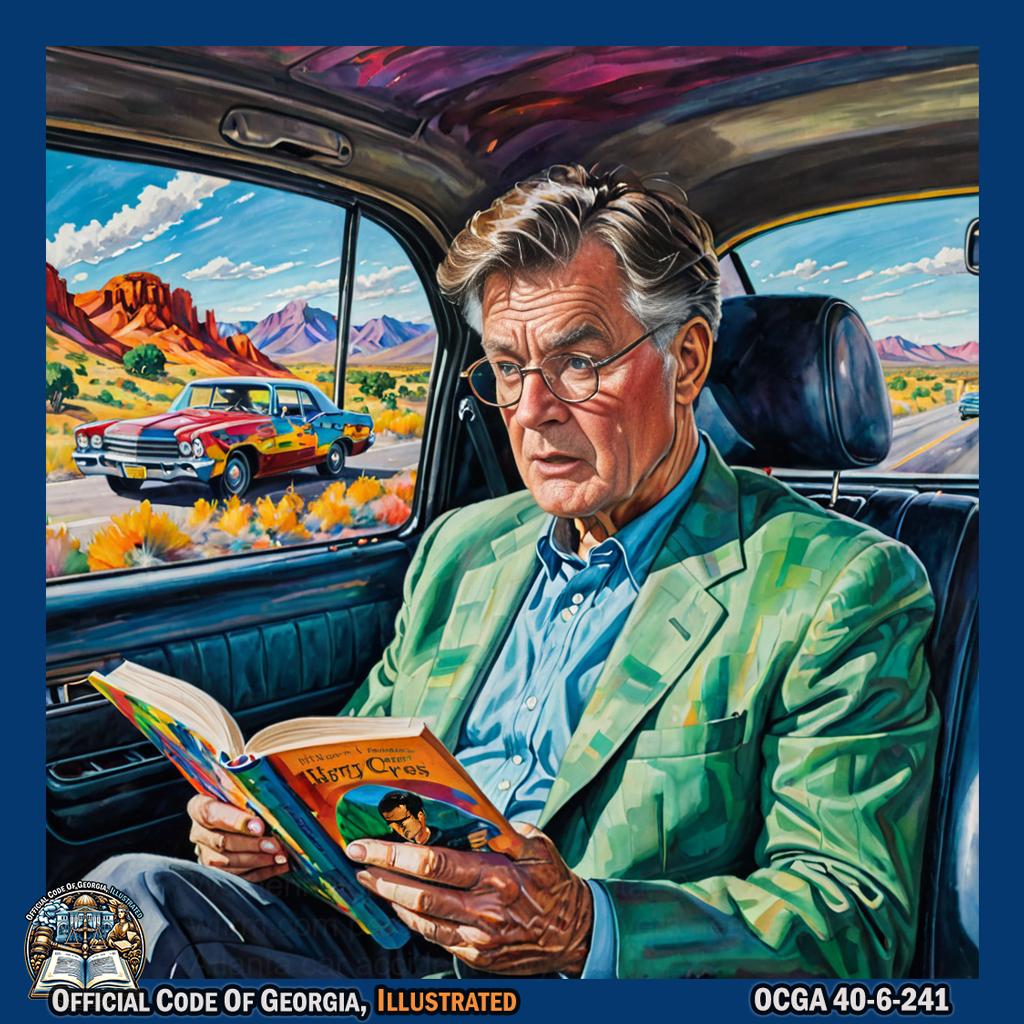
Harry Crews sitting in a parked car, passionately reading a book with intense facial expressions and dramatic hand gestures, surrounded by vibrant and colorful imagery representing the world of literature and storytelling.
(A)For a first conviction with no conviction of and no plea of nolo contendere accepted to a charge of violating this Code section within the previous 24 month period of time, as measured from the dates any previous convictions were obtained or pleas of nolo contendere were accepted to the date the current conviction is obtained or plea of nolo contendere is accepted, a fine of not more than $50.00, but the provisions of Chapter 11 of Title 17 and any other provision of law to the contrary notwithstanding, the costs of such prosecution shall not be taxed nor shall any additional penalty, fee, or surcharge to a fine for such offense be assessed against a person for conviction thereof;
(B)For a second conviction within a 24 month period of time, as measured from the dates any previous convictions were obtained or pleas of nolo contendere were accepted to the date the current conviction is obtained or plea of nolo contendere is accepted, a fine of not more than $100.00, but the provisions of Chapter 11 of Title 17 and any other provision of law to the contrary notwithstanding, the costs of such prosecution shall not be taxed nor shall any additional penalty, fee, or surcharge to a fine for such offense be assessed against a person for conviction thereof; or
40-6-241.1.[Repealed] Definitions; prohibition on certain persons operating motor vehicle while engaging in wireless communications; exceptions; penalties.¶
40-6-241.2.[Repealed] Writing, sending, or reading text based communication while operating motor vehicle prohibited; prohibited uses of wireless telecommunications devices by drivers of commercial vehicles; exceptions; penalties for violation.¶
40-6-242.Obstruction of driver’s view or interference with control of vehicle.¶
- No person shall drive a vehicle when it is so loaded or when there are in the front seat such a number of persons, exceeding three, as to obstruct the view of the driver to the front or sides of the vehicle or as to interfere with the driver’s control over the driving mechanism of the vehicle.
- No passenger in a vehicle shall ride in such position or commit any act as to interfere with the driver’s view ahead or to the sides or to interfere with his control over the driving mechanism of the vehicle.
40-6-243.Opening and closing vehicle doors.¶
No person shall open the door of a motor vehicle on the side available to moving traffic unless and until it is reasonably safe to do so and can be done without interfering with the movement of other traffic, nor shall any person leave a door open on the side of a vehicle available to moving traffic for a period of time longer than necessary to load or unload passengers.
40-6-244.Riding in house trailer.¶
No driver of a motor vehicle shall allow a person or persons to occupy a towed house trailer while it is being towed by a motor vehicle upon a public highway.
40-6-245.Driving through canyon or on mountain highway.¶
The driver of a vehicle traveling through a defile or canyon or on a mountain highway shall hold such vehicle under control and as near the right-hand edge of the highway as reasonably possible and, except when driving entirely to the right of the center of the roadway, shall give audible warning with the horn of such vehicle upon approaching any curve where the view is obstructed within a distance of 200 feet along the highway.
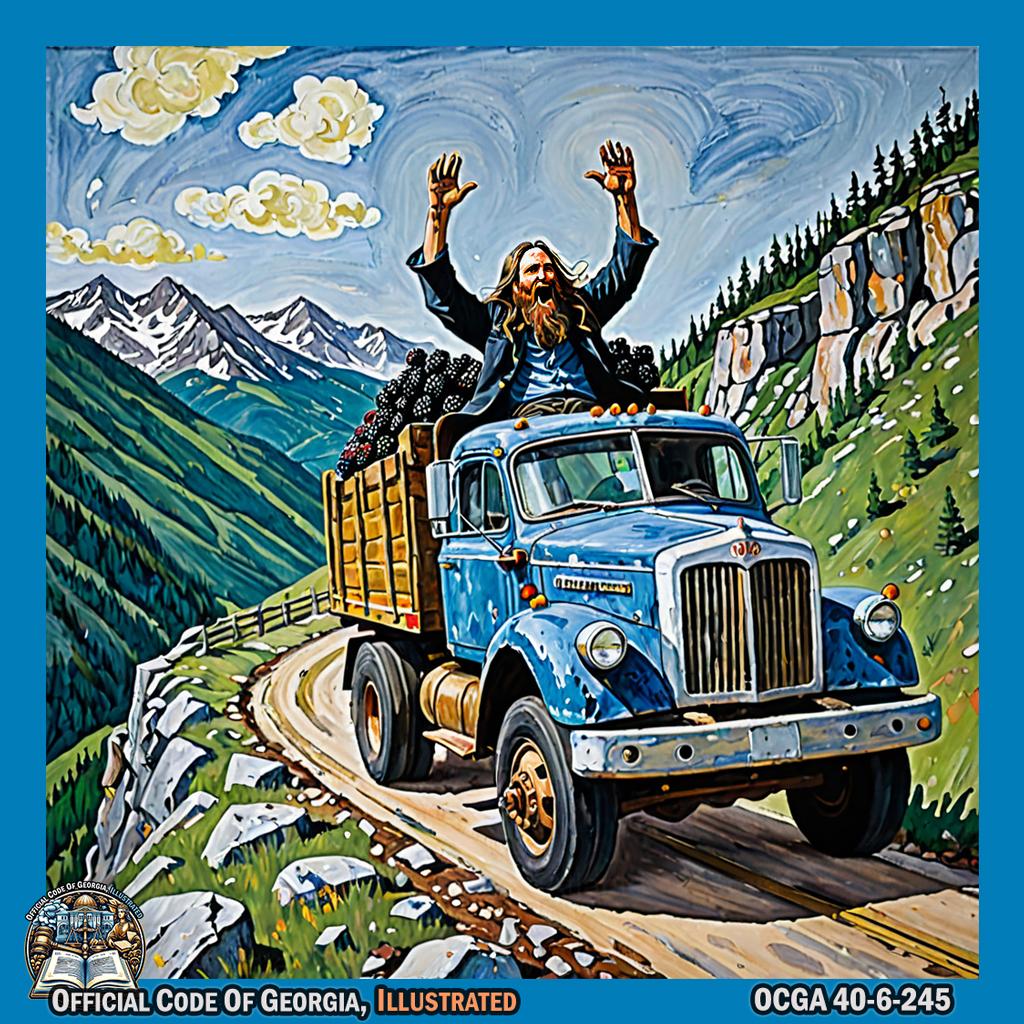
40-6-246.Coasting.¶
-
The driver of any motor vehicle when traveling upon a down grade shall not coast with the gears or transmission of such vehicle in neutral.
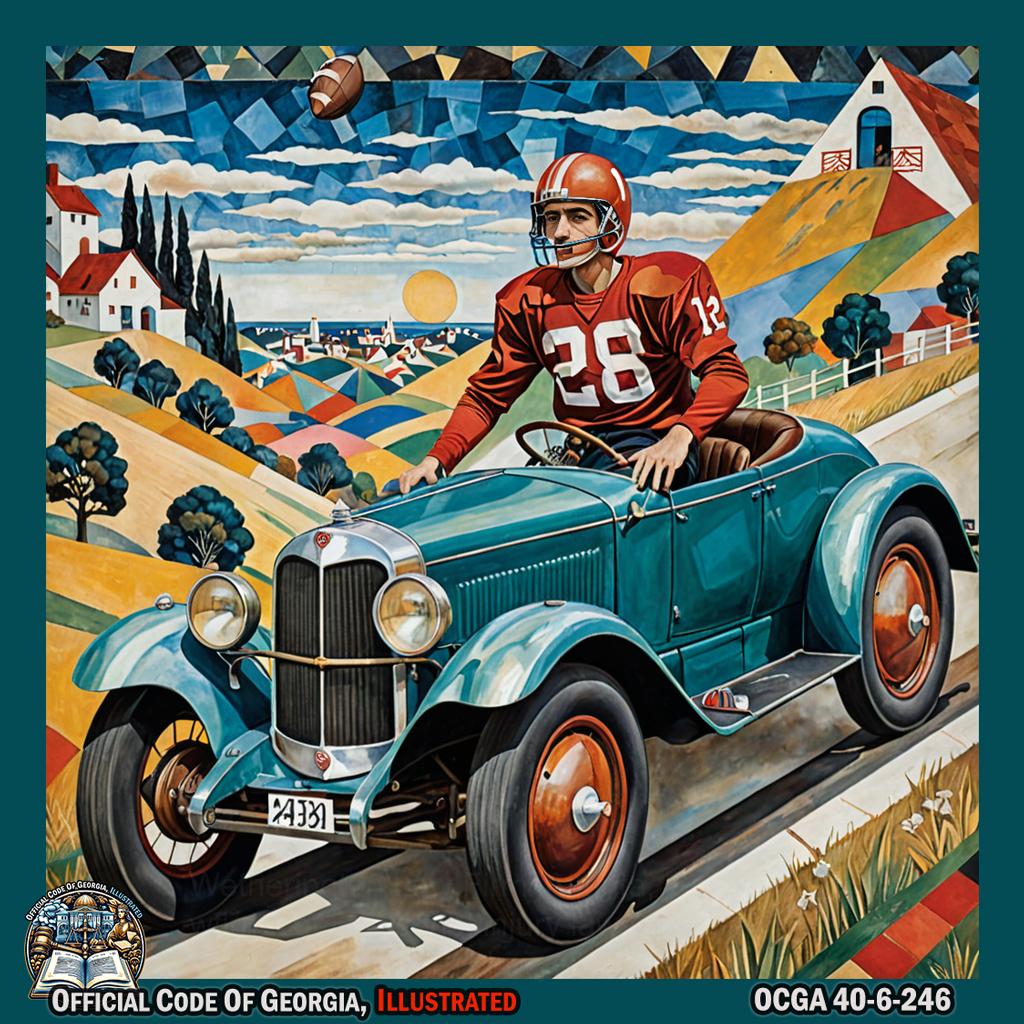
Chas Henry, dressed as a football player, gracefully glides down an incline in a vintage car, maintaining control and not coasting in neutral, all while the scene is intricately layered with vibrant geometric shapes and surreal images reminiscent of Hannah Hoch's style. -
The driver of a truck or bus when traveling upon a down grade shall not coast with the clutch disengaged.

Jacob Snider dramatically holds the steering wheel of a vintage truck as he descends a hill, his foot firmly on the brake pedal and clutch engaged, with a look of determination on his face, all set against the lush landscape of Atlanta University Center in an art piece style reminiscent of Eugene Von Guerard.
40-6-247.Following fire apparatus or emergency vehicle.¶
The driver of any vehicle other than one
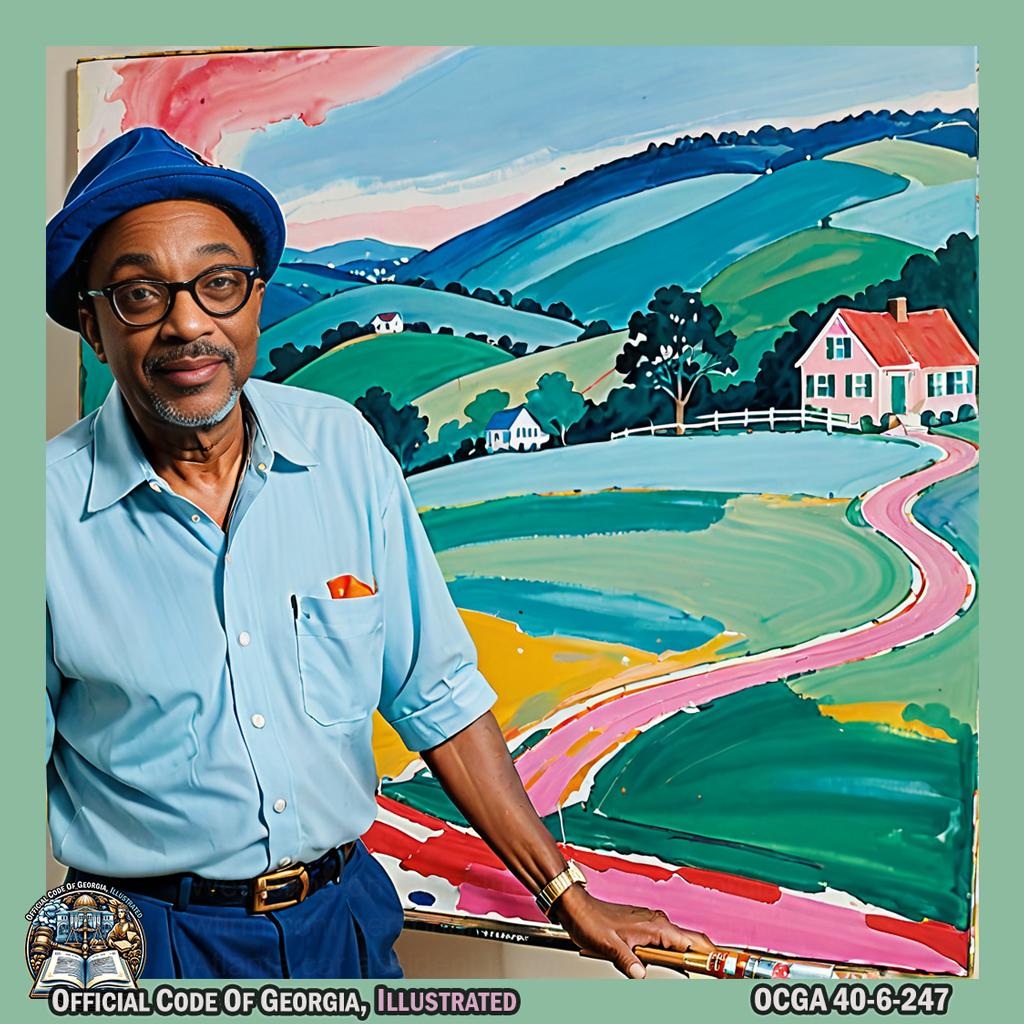
on official business shall not follow any fire apparatus traveling in response to a fire alarm or any other emergency vehicle closer than 200 feet and shall not park such vehicle within 500 feet of any fire apparatus stopped in answer to a fire alarm.
40-6-248.Crossing fire hose.¶
No vehicle shall be driven over any unprotected hose of a fire department when laid down on any street, private road, or driveway to be used at any fire or alarm of fire, without consent of the fire department official in command.
40-6-248.1.Securing and covering loads on vehicles.¶
-
As used in this Code section, the term “litter” has the meaning provided by paragraph (1) of Code Section 16-7-42.
(a.1)No vehicle shall be driven or moved on any public road unless such vehicle is constructed or loaded or covered so as to prevent any of its load from dropping, escaping, or shifting in such a manner as to:
- Create a safety hazard; or
-
Deposit litter on public or private property while such vehicle is on a public road.
However, this Code section shall not prohibit the necessary spreading of any substance in public road maintenance or construction operations.
-
No person shall operate or load for operation, on any public road, any vehicle with any load unless such load and any covering thereon is securely fastened so as to prevent such covering or load from:
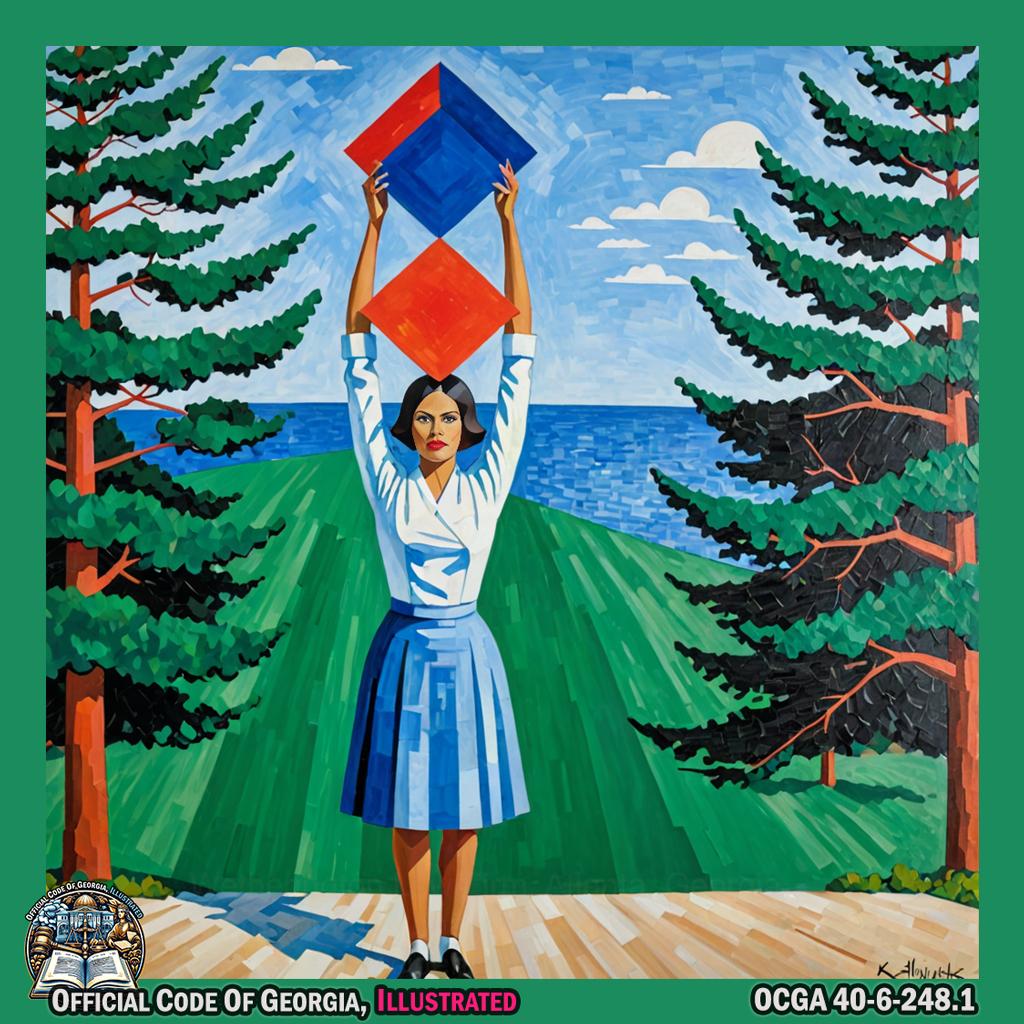
Teresa Edwards, in the style of Kazimir Malevich, balancing a load on her head while standing in a geometrically abstract landscape in Sandy Springs North, Georgia. - Becoming loose, detached, or in any manner becoming a hazard to other users of the public road; or
- Depositing litter on public or private property while such vehicle is on a public road.
-
No motor carrier shall allow a commercial motor vehicle to be driven and no person shall operate a commercial motor vehicle with a load that is not secure. Loads shall be secured as required by state and federal law, rule, and regulation. As used in this subsection, the term “load” shall include loads consisting of liquids and gases as well as solid materials.
- Nothing in this Code section nor any regulations based thereon shall conflict with federal, Department of Public Safety, or Board of Public Safety regulations applying to the securing of loads on motor vehicles.
- The provisions of paragraph (2) of subsection (a) and paragraph (2) of subsection (b) of this Code section and regulations based thereon shall not apply to organic debris that escapes during the transportation of silage from field or farm to storage and storage to feedlot or during the transportation of agricultural or farm products or silvicultural products from farm or forest to a processing plant or point of sale or use.
40-6-249.Littering highway.¶
Any person littering a highway in violation of Part 2 of Article 2 of Chapter 7 of Title 16 or driving, moving, or loading for operation a vehicle in violation of Code Section 40-6-248.1 shall be guilty of a misdemeanor and, upon conviction thereof, shall be punished as provided in Code Section 16-7-43.

40-6-250.Wearing device which impairs hearing or vision.¶
No person shall operate a motor vehicle while wearing a headset or headphone which would impair such person’s ability to hear, nor shall any person while operating a motor vehicle wear any device which impairs such person’s vision; provided, however, that a person may wear a headset or headphone for communication purposes.
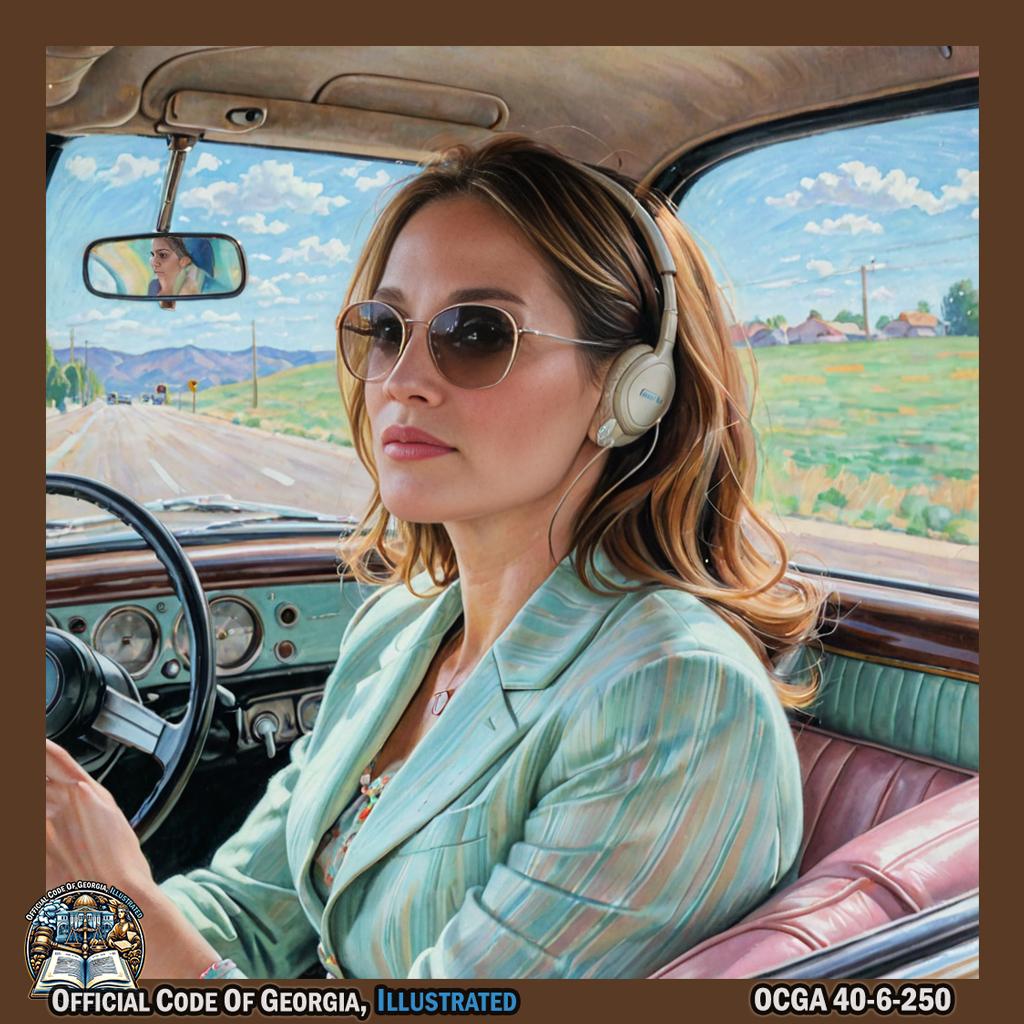
40-6-251.Driving in circular or zigzag course; “laying drags.”¶
- No driver of any motor vehicle shall operate the vehicle upon the public streets, highways, public or private driveways, airport runways, or parking lots in such a manner as to create a danger to persons or property by intentionally and unnecessarily causing the vehicle to move in a zigzag or circular course or to gyrate or spin around, except to avoid a collision or injury or damage.
- The offenses described in this Code section shall be sufficiently identified on any traffic ticket, warrant, accusation, or indictment when referred to as “laying drags.”
- This Code section shall not apply to drivers operating vehicles in or on any raceway, drag strip, or similar place customarily and lawfully used for such purposes.
- Any person violating subsection (a) of this Code section shall be guilty of a misdemeanor.
40-6-252.Parking, standing, or driving vehicle in private parking area after request not to do so.¶
-
No person shall, after having been requested not to do so by a law enforcement officer or an authorized agent of the owner, park or stand an occupied or unoccupied motor vehicle in or repeatedly drive a motor vehicle through or within a parking area located on privately owned property and provided by a merchant, group of merchants, or shopping center or other facility for customers if:
-
The parking area is identified by at least one sign as specified in this paragraph, and if the parking area contains more than 150 parking spaces then by at least one such sign at each entrance to the parking area, each such sign containing the following information in easy-to-read printing:
- Notice of this Code section;
- Identification of the property which is reserved for customers’ use only;
- Identification of the merchant, group of merchants, or shopping center or other similar facility providing the parking area; and
- Warning that violators will be prosecuted; and

Eli Whitney dramatically pointing and gesturing with a stern expression, surrounded by a swirling vortex of legal documents and blueberry bushes, in the style of an avant-garde performance art piece at Kendeda Building.
-
The motor vehicle is parked, is standing, or is being operated other than for the purpose of:
- Transporting some person to or from the interior of the place of business of a merchant identified by the sign or signs in the parking area or to or from the interior of the shopping center or other facility so identified;
- Making use of a telephone, vending machine, automatic teller machine, or other similar facility located in the parking area;
- Meeting the requirements of a situation in which it has unexpectedly become impossible or impractical for the motor vehicle to continue to travel on the public roads; or
- Carrying out an activity for which express permission has been given by the owner of the parking area or an authorized representative of the owner.
-
-
Any person who violates subsection (a) of this Code section shall be guilty of a misdemeanor and, upon conviction thereof, shall be punished by a fine:
-
Not to exceed $50.00 for the first such offense;

Sam Madison stands with outstretched arms, holding a large dollar sign while surrounded by colorful geometric shapes and patterns reminiscent of Robert Indiana's art, all set against the backdrop of Alpharetta's lush greenery. -@sammaddie29 -
Not to exceed $100.00 for the second such offense; and

Kandi Burruss gracefully swipes her hand across her neck, while wearing a sleek and elegant outfit, in the style of a dramatic pose from Helmut Newton, creating an art piece that embodies power and sophistication. -@Kandi -
Not to exceed $150.00 for the third or subsequent such offense.
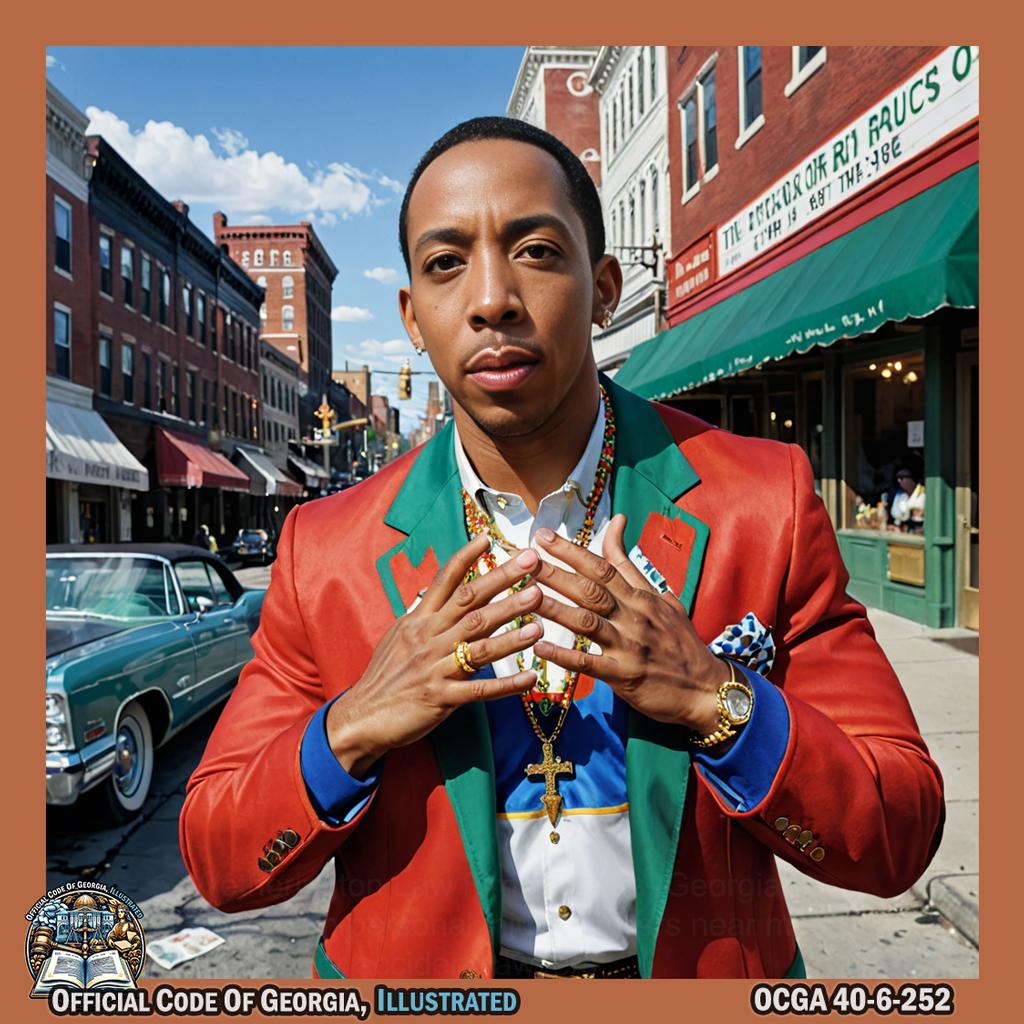
Ludacris dramatically gestures with his hands while wearing a vibrant outfit, as if he's setting a monetary limit for an extravagant purchase, all captured in the candid style of Vivian Maier's photography against the rich backdrop of St. Marys. -@Ludacris
-
-
The governing authority of any municipal corporation by ordinance may adopt by reference the provisions of subsection (a) of this Code section without publishing or posting in full the provisions thereof. Any person violating any such ordinance shall be subject to a monetary fine:
-
Not to exceed $50.00 for the first such violation;

Senator Warnock dramatically throws a handful of confetti in the air, each piece representing a dollar amount, while striking a powerful pose reminiscent of Peter Blake's style, all set within the vibrant and bustling Bolton neighborhood of Atlanta. -@ReverendWarnock -
Not to exceed $100.00 for the second such violation; and
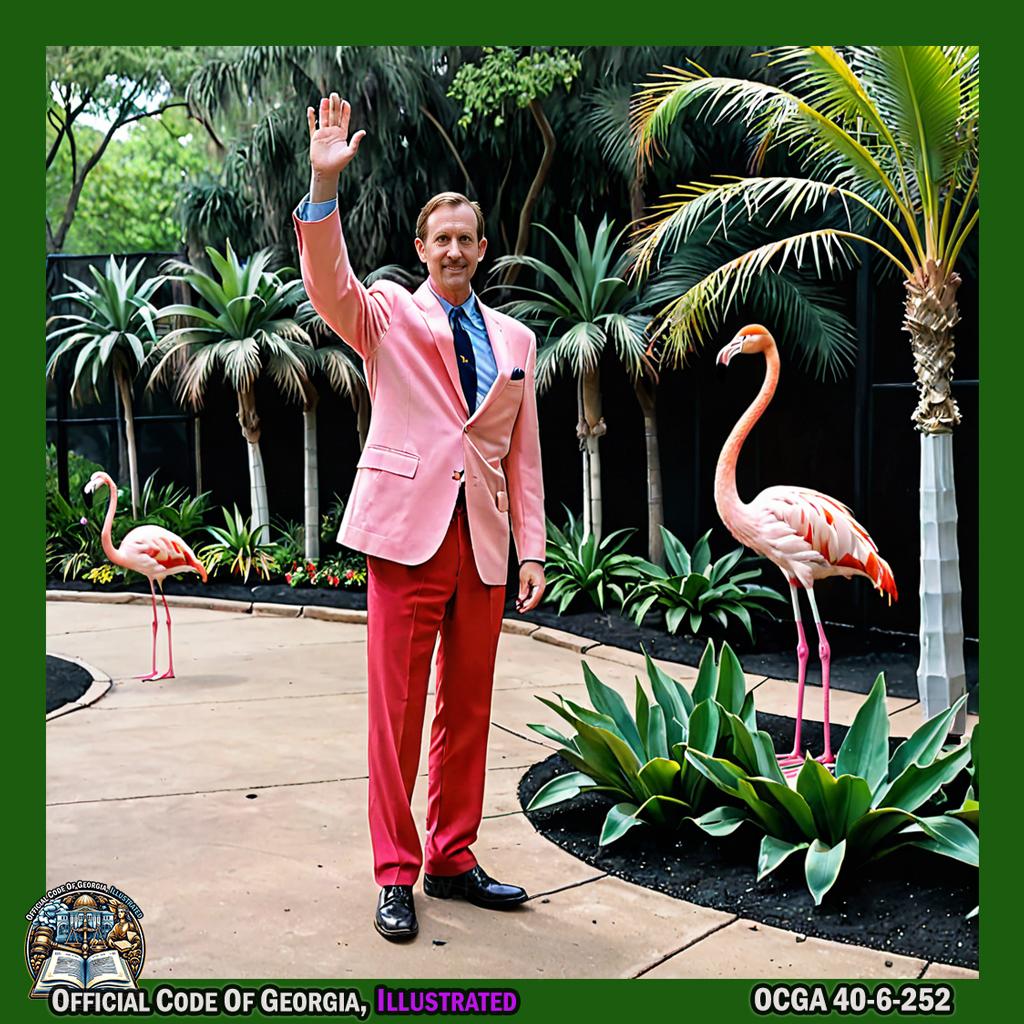
Eric A. Boe raises his hand as if presenting an invisible object, while standing in front of the flamingo exhibit at Riverbanks Zoo and Garden. -@Astro_Boe -
Not to exceed $150.00 for the third or subsequent such violation.
-
40-6-253.Consumption of alcoholic beverage or possession of open container of alcoholic beverage in passenger area.¶
-
As used in this Code section, the term:
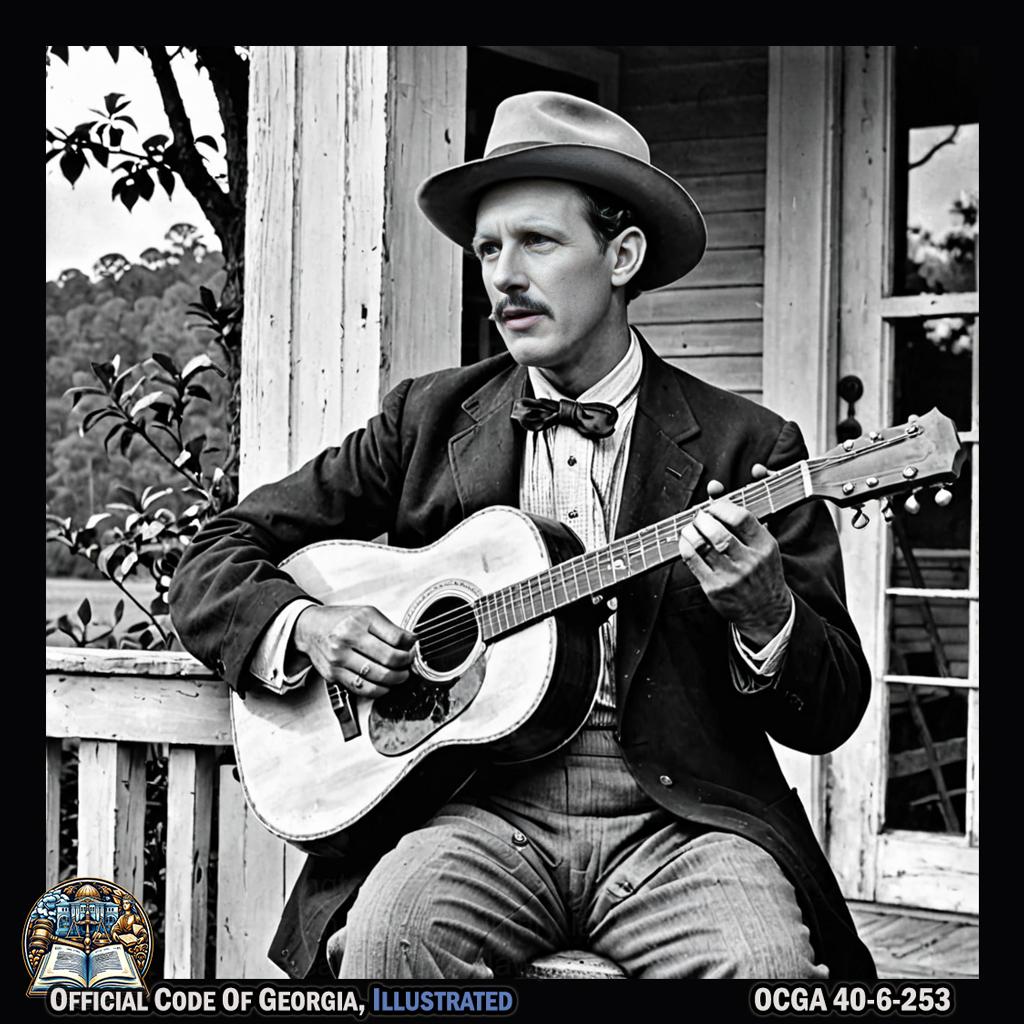
Curley Weaver, dressed in period attire, strums his guitar on a porch in Suwanee, Georgia; behind him, the lush landscape and historic buildings are captured in black-and-white photography reminiscent of Walker Evans' style. He pauses to point at objects like a cotton plant and a peach tree to visually represent "terms" related to Georgia's agricultural heritage. -
“Alcoholic beverage” means:

Clergyman Michael Catt, portrayed in the style of Julian Schnabel, pretends to stir a drink in a fancy cocktail glass while making a "cheers" gesture with both hands. -@MichaelCatt -
Beer, ale, porter, stout, and other similar fermented beverages, including sake or similar products, of any name or description containing one-half of 1 percent or more of alcohol by volume, brewed or produced from malt, wholly or in part, or from any substitute therefor;

Charles Arthur "Pretty Boy" Floyd joyfully swirling a colorful and vibrant collection of various fermented beverages, including sake, in an elaborate and exaggerated manner while surrounded by larger-than-life figures representing the civil rights movement at the Albany Civil Rights Movement Museum and Institute. -
Wine of not less than one-half of 1 percent of alcohol by volume; or
- Distilled spirits which is that substance known as ethyl alcohol, ethanol, or spirits of wine in any form, including all dilutions and mixtures thereof from whatever source or by whatever process produced.

Lil Jon standing in a dramatic, contorted pose with his arms outstretched as if distilling spirits, surrounded by swirling abstract shapes and shadows in black and white photography style reminiscent of Daidō Moriyama's work at the Steffen Thomas Museum of Art. -@LilJon
-
-
“Open alcoholic beverage container” means any bottle, can, or other receptacle that:
- Contains any amount of alcoholic beverage; and
-
- Is open or has a broken seal; or
-
The contents of which are partially removed.
A container that has been sealed or resealed pursuant to Code Section 3-5-4 or 3-6-4 shall not constitute an open alcoholic beverage container for purposes of this Code section.

Gunna, with an over-the-top exaggerated gesture, is pretending to seal a container using a comically large pretend sealing tool, reminiscent of an art piece by Chaim Gross. -@1GunnaGunna
-
“Passenger area” means the area designed to seat the driver and passengers while a motor vehicle is in operation and any area that is readily accessible to the driver or a passenger while in his or her seating position; provided, however, that such term does not include any locked glove compartment or, in a passenger car not equipped with a trunk, any area behind the rearmost upright seat or not normally occupied by the driver or passengers.

India.Arie gracefully contorts her body to create a human representation of the complex legal definition, while surrounded by a labyrinth of mirrors and statues in the heart of Rome, Georgia. -@indiaarie
-
-
-
A person shall not:
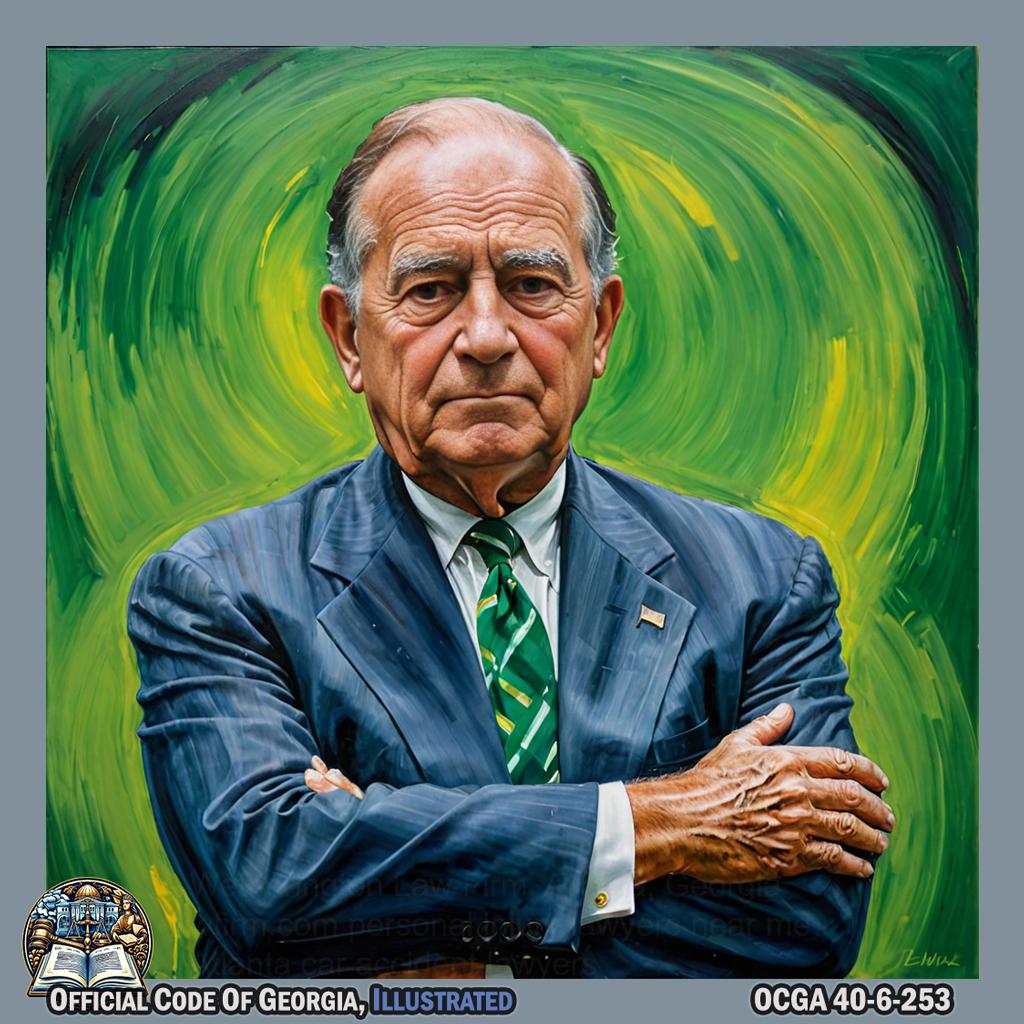
George W. Jenkins, founder of Publix, is depicted in the art piece by F. Lennox Campello as crossing his arms and shaking his head in a "no" gesture.
1. Consume any alcoholic beverage; or 2. Possess any open alcoholic beverage containerin the passenger area of any motor vehicle which is on the roadway or shoulder of any public highway. -
The provisions of paragraph (1) of this subsection shall not apply to any passenger in the passenger area of a motor vehicle designed, maintained, or used primarily for the transportation of persons for compensation or in the living quarters of a motor home or house trailer.
- Only a person who consumes an alcoholic beverage or possesses an open alcoholic beverage container in violation of this Code section shall be charged with such offense; provided, however, that an operator of a motor vehicle who is alone in the passenger area of such motor vehicle shall be deemed to be in possession of any open alcoholic beverage container in such passenger area.
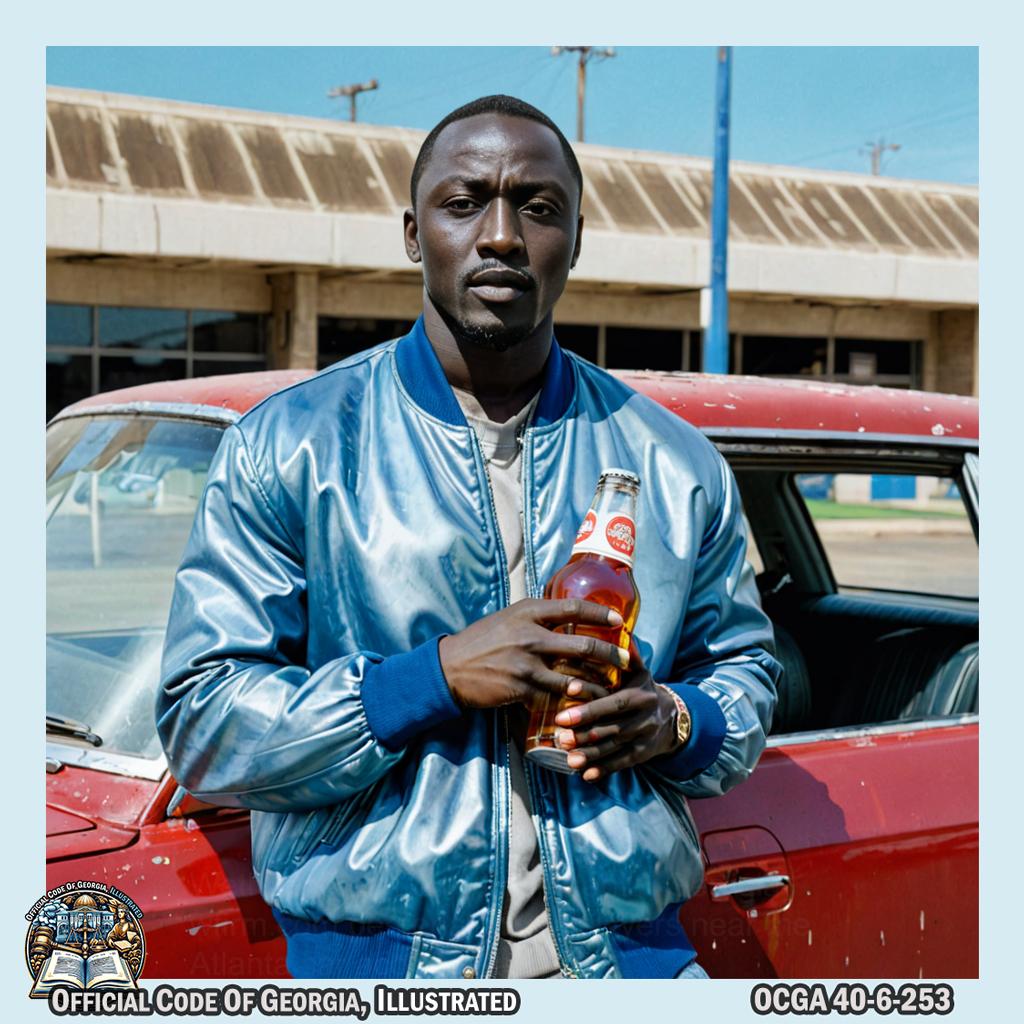
Akon stands alone in the passenger area of a parked car at Varsity, holding an open alcoholic beverage container while looking directly at the camera with a serious expression. -@Akon
-
-
Any person who violates this Code section is subject to a fine not to exceed $200.00.
40-6-253.1.Transportation of medical waste; exception; penalty for violation.¶
-
As used in this Code section, the terms “infectious substance” and “regulated medical waste” have the same meaning as given to those terms under the federal Hazardous Materials Regulations published in Title 49 of the Code of Federal Regulations as those regulations currently exist or may in the future be amended. The terms “etiologic agent” and “infectious substance” are synonymous.

Ray Charles gracefully sculpting a Michelangelo-inspired performance to interpret the legal statement, with infectious enthusiasm and precise hand gestures, all within the captivating ambiance of For Keeps Bookstore in Atlanta. -
The transportation of infectious substances and regulated medical waste, including but not limited to the marking of packages and marking or placarding of vehicles with appropriate warnings, shall comply with the requirements of the federal Hazardous Material Regulations published in Title 49 of the Code of Federal Regulations as those regulations currently exist or may in the future be amended and with compatible regulations adopted or promulgated by the commissioner of public safety.
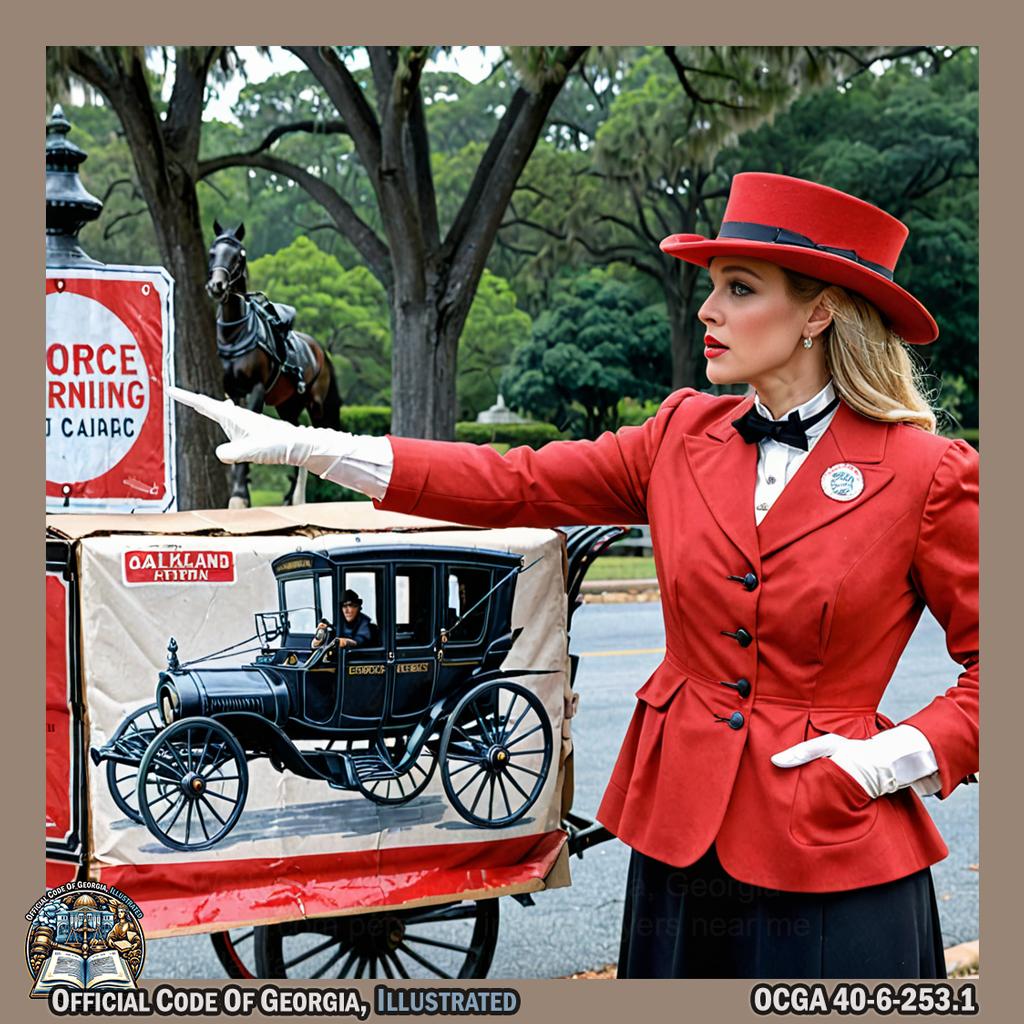
Actress Alicia Leigh Willis slowly and deliberately places a large, red warning sticker on a package, then dramatically gestures towards a vintage horse-drawn carriage adorned with matching warning placards, all set against the backdrop of historic Oakland Cemetery in Atlanta, Georgia. -@AliciaLWillis -
Nurses, physicians, and other health care professionals may utilize all applicable exceptions contained in federal regulations and in the regulations of the Department of Public Safety when transporting infectious substances.

Blind Simmie Dooley gracefully dances in a flowing, colorful gown, embodying the movement of health care professionals navigating federal regulations while transporting infectious substances, all within the vibrant and dynamic setting of Trap House Museum and Escape Room. -
Violation of the provisions of this Code section shall constitute a misdemeanor.
40-6-254.Operating vehicle without adequately securing load.¶
No person shall operate any motor vehicle with a load on or in such vehicle unless the load on or in such vehicle is adequately secured to prevent the dropping or shifting of such load onto the roadway in such a manner as to create a safety hazard. For purposes of this Code section, a load shall include, but not be limited to, a trailer required to be registered under Chapter 2 of this title. Any person who operates a vehicle in violation of this Code section shall be guilty of a misdemeanor.
40-6-255.Driving away without paying for gasoline.¶
-
No person shall drive a motor vehicle so as to cause it to leave the premises of an establishment at which gasoline offered for retail sale was dispensed into the fuel tank of such motor vehicle unless due payment or authorized charge for the gasoline so dispensed has been made.

Devonte Upson, dressed in a vintage gas station attendant outfit reminiscent of the 1930s (aligning with Walker Evans's era), mimics pumping gas into an old-fashioned car prop. He then theatrically checks a small notepad, nods approvingly to an imaginary customer, and waves them off with a friendly gesture as if indicating a completed transaction. The Glennville–Tattnall Museum serves as the backdrop with its rich history displayed around him, including antique gasoline pumps and sepia-toned photographs lining the walls to emulate Walker Evans's style. -
Any person who violates subsection (a) of this Code section shall be guilty of a misdemeanor and, upon conviction thereof, shall be punished by a fine not to exceed $100.00 or by confinement in the county or other jail, county correctional institution, or such other places as counties may provide for maintenance of county inmates for a term not to exceed 60 days, or both.
Article 12 Accidents¶
- 40-6-270. Hit and run; duty of driver to stop at or return to scene of accident.
-
40-6-271. Duty upon striking unattended vehicle.

In the rich scene of St. Marys, Georgia, baseball coach Troy Snitker is seen pretending to hold a toy car, then bending down to inspect the damage while making apologetic face and hand gestures. -@tsnit21 -
40-6-272. Duty upon striking fixture.

Luke Bryan, the musician, playfully swings an imaginary hammer at Legoland Discovery Center in Georgia, creating a "smashing" sound effect with each pretend strike. -@LukeBryanOnline -
40-6-273. Duty to report accident resulting in injury, death, or property damage.
-
40-6-273.1. Instruction to drivers to provide certain information to other parties.

Football player Nick Marshall makes a big exaggerated hand gesture as if handing over an imaginary piece of paper, in the rich scene of Carrollton, Georgia. -@NicMarshall7 -
40-6-274. Exemption from duty to stop at scene or report accident.
- 40-6-275. Duty to remove vehicle from public roads; removal of incapacitated vehicle from state highway.
- 40-6-276. Duty of driver of wrecker/tow truck.
-
40-6-277. Sheriffs and chief executive officers of law enforcement agencies to report traffic accident deaths.

Former Georgia Governor Zell Miller, depicted in a Rauschenberg-esque art piece, holds a toy sheriff badge and dons a pretend CEO hat while pointing to a toy car with crash marks. -
40-6-278. Uniform motor vehicle accident reports and reporting procedures.
- 40-6-279. Accidents involving operation of fully autonomous vehicles.
40-6-270.Hit and run; duty of driver to stop at or return to scene of accident.¶
-
The driver of any vehicle involved in an accident resulting in injury to or the death of any person or in damage to a vehicle which is driven or attended by any person shall immediately stop such vehicle at the scene of the accident or shall stop as close thereto as possible and forthwith return to the scene of the accident and shall:
- Give his or her name and address and the registration number of the vehicle he or she is driving;
- Upon request and if it is available, exhibit his or her operator’s license to the person struck or the driver or occupant of or person attending any vehicle collided with;
- Render to any person injured in such accident reasonable assistance, including the transporting, or the making of arrangements for the transporting, of such person to a physician, surgeon, or hospital for medical or surgical treatment if it is apparent that such treatment is necessary or if such transporting is requested by the injured person; and
-
Where a person injured in such accident is unconscious, appears deceased, or is otherwise unable to communicate, make every reasonable effort to ensure that emergency medical services and local law enforcement are contacted for the purpose of reporting the accident and making a request for assistance.
The driver shall in every event remain at the scene of the accident until fulfilling the requirements of this subsection. Every such stop shall be made without obstructing traffic more than is necessary.
-
If such accident is the proximate cause of death or a serious injury, any person knowingly failing to stop and comply with the requirements of subsection (a) of this Code section shall be guilty of a felony and, upon conviction thereof, shall be punished by imprisonment for not less than one nor more than five years.
-
-
If such accident is the proximate cause of an injury other than a serious injury or if such accident resulted in damage to a vehicle which is driven or attended by any person, any person knowingly failing to stop or comply with the requirements of this Code section shall be guilty of a misdemeanor and: 1. Upon conviction shall be fined not less than $300.00 nor more than $1,000.00, which fine shall not be subject to suspension, stay, or probation, or imprisoned for up to 12 months, or both; 2. Upon the second conviction within a five-year period of time, as measured from the dates of previous arrests for which convictions were obtained to the date of the current arrest for which a conviction is obtained, shall be fined not less than $600.00 nor more than $1,000.00, which fine shall not be subject to suspension, stay, or probation, or imprisoned for up to 12 months, or both; and for purposes of this subparagraph, previous pleas of nolo contendere accepted within such five-year period shall constitute convictions; and 3. Upon the third or subsequent conviction within a five-year period of time, as measured from the dates of previous arrests for which convictions were obtained to the date of the current arrest for which a conviction is obtained, shall be fined $1,000.00, which fine shall not be subject to suspension, stay, or probation, or imprisoned for up to 12 months, or both; and for purposes of this subparagraph, previous pleas of nolo contendere accepted within such five-year period shall constitute convictions.
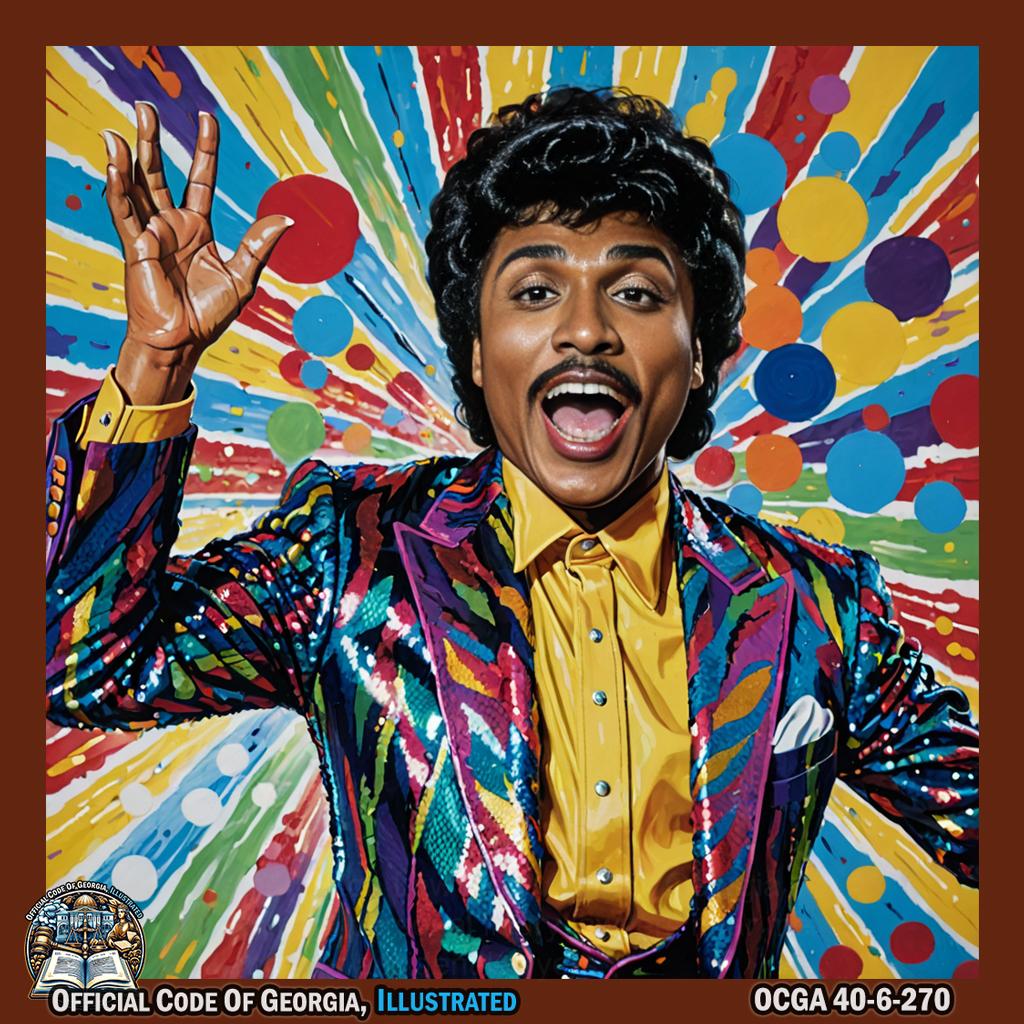
Little Richard, dressed in vibrant sequined attire, dramatically gestures and mimes a legal trial with exaggerated facial expressions and grand hand movements while surrounded by a colorful backdrop of swirling patterns reminiscent of Appalachian folk art. -
For the purpose of imposing a sentence under this subsection, a plea of nolo contendere shall constitute a conviction.

Lorenzo Carter stands solemnly in a courtroom setting fashioned from an old Cusseta barn, hands extended forward as if offering a football to an unseen judge, embodying the acceptance of a verdict without dispute, while his stance and expression mirror the introspective style characteristic of Dorothea Lange's portraiture. -@_zocarter -
If the payment of the fine required under this subsection will impose an economic hardship on the defendant, the judge, at his sole discretion, may order the defendant to pay such fine in installments and such order may be enforced through a contempt proceeding or a revocation of any probation otherwise authorized by this Code section.

Ben Chestnut, dressed in a judge's robe, stands with outstretched arms, gesturing towards an oversized check being torn into smaller pieces by swirling gusts of wind. His expression is stern yet empathetic as he oversees the transformation of the fine into ethereal installments, symbolizing the economic hardship faced by the defendant. The backdrop embodies a juxtaposition of ancient monastery remnants and futuristic air elements, creating a visually striking and thought-provoking scene reminiscent of Richard Avedon's style. -@benchestnut
-
-
Notwithstanding the limits set forth in any municipal charter, any municipal court of any municipality shall be authorized to impose the punishments provided for in this Code section upon a conviction of violating this Code section or upon conviction of violating any ordinance adopting the provisions of this Code section.

Jeremy Lamb, dressed in a judge's robe, dramatically swings a basketball gavel towards an artistically exaggerated 'Code Book' hoop, set against the eerie backdrop of the Haunted Pillar, while Francisco Goya-esque shadowy figures look on, embodying the solemnity and power of law. -@jlamb
40-6-271.Duty upon striking unattended vehicle.¶
-
The driver of any vehicle which collides with any vehicle which is unattended shall immediately stop and shall then and there either locate and notify the operator or owner of such vehicle of the name and address of the driver and owner of the vehicle striking the unattended vehicle or shall leave in a conspicuous place on the vehicle struck a written notice giving the name and address of the driver and the owner of the vehicle doing the striking.
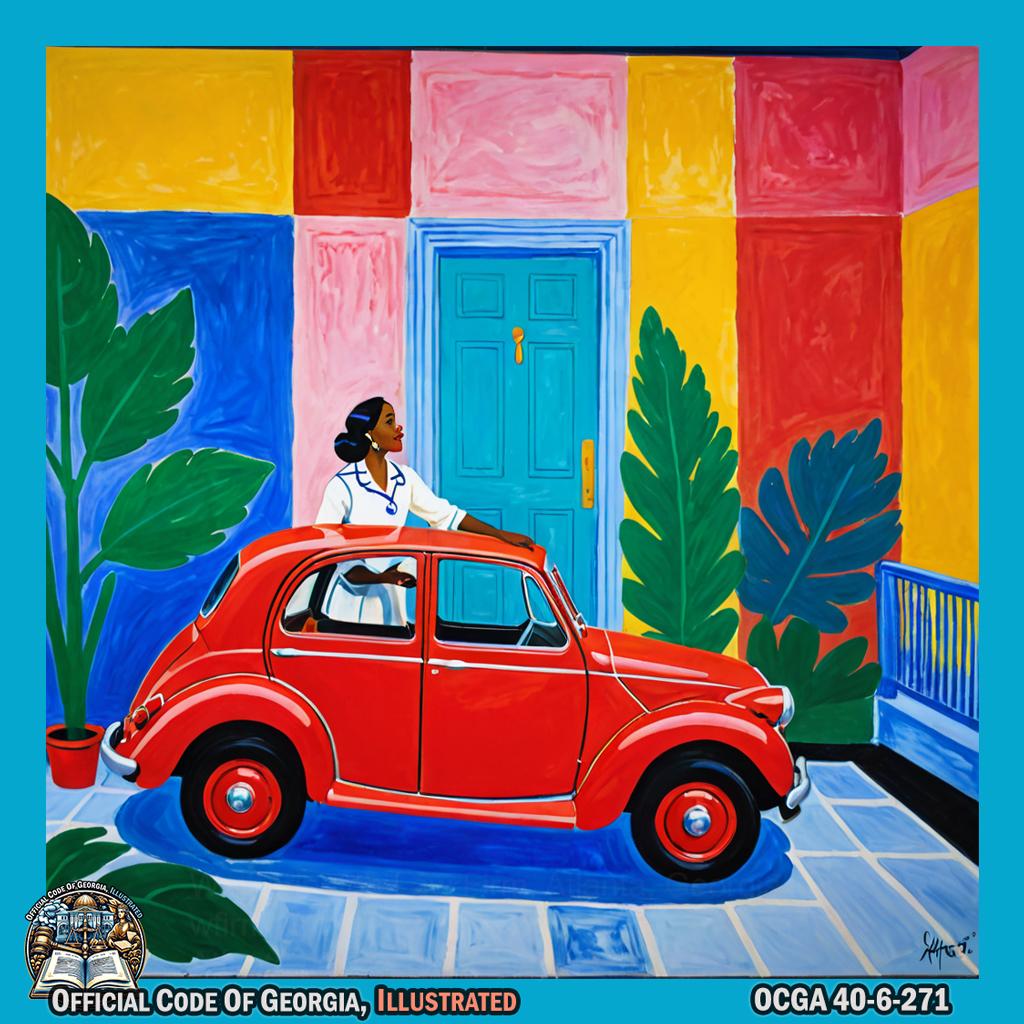
Fredi Washington gracefully stops her imaginary car, steps out with a sweeping gesture, and places an imaginary written notice on the striking vehicle in a vibrant and colorful art piece inspired by Henri Matisse's style, set within the rich ambiance of The Cumming Playhouse. -
Any person who fails to comply with the requirements of subsection (a) of this Code section shall be guilty of a misdemeanor.
40-6-272.Duty upon striking fixture.¶
The driver of any vehicle involved in an accident resulting only in damage to a fixture legally upon or adjacent to a highway shall take reasonable steps to locate and notify the owner or person in charge of such property of such fact and of his name and address and of the registration number of the vehicle he is driving and shall, upon request and if available, exhibit his operator’s license.
40-6-273.Duty to report accident resulting in injury, death, or property damage.¶
The driver of a vehicle involved in an accident resulting in injury to or death of any person or property damage to an apparent extent of $500.00 or more shall immediately, by the quickest means of communication, give notice of such accident to the local police department if such accident occurs within a municipality. If such accident occurs outside a municipality, such notice shall be given to the office of the county sheriff or to the nearest office of the state patrol.
40-6-273.1.Instruction to drivers to provide certain information to other parties.¶
The law enforcement officer at the scene of an accident required to be reported in accordance with the provisions of Code Section 40-6-273 shall instruct the driver of each motor vehicle involved in the accident to report the following to all other parties suffering injury or property damage as an apparent result of the accident:
-
The name and address of the owner and the driver of the motor vehicle;

Mary Jarrett White, dressed in a vibrant puppet-inspired costume, acts out the sentence by using exaggerated hand gestures and facial expressions to mimic writing down information on an imaginary notepad while dancing around the Jim Henson exhibit at the Center for Puppetry Arts. -
The license number of the motor vehicle; and
- The name of the liability insurance carrier for the motor vehicle or the fact that such driver has a certificate of self-insurance issued pursuant to Code Section 33-34-5.1.

John Wesley sits in a vintage car, gesturing dramatically as he presents a grand scroll with elaborate calligraphy depicting the liability insurance carrier for the motor vehicle and waving another scroll representing a certificate of self-insurance, all while surrounded by swirling clouds of color and light.
40-6-274.Exemption from duty to stop at scene or report accident.¶
Any other provision of this article or any other law to the contrary notwithstanding, the driver of any vehicle involved in a traffic accident in which there is no personal injury or in which no second party and no property of a second party is involved shall not have the duty to stop or immediately report such accident, and no such driver shall be prosecuted for his failure to stop or immediately to report such accident. This Code section shall not abrogate or affect a driver’s duty to file any written report which may be required by the local law enforcement agency.
40-6-275.Duty to remove vehicle from public roads; removal of incapacitated vehicle from state highway.¶
- Any other provision of this article or any other law to the contrary notwithstanding, motor vehicles involved in traffic accidents and the drivers of such motor vehicles shall be subject to the provisions of this Code section.
- This Code section shall apply to motor vehicle traffic accidents which occur on the public roads of this state as defined in paragraph (24) of Code Section 32-1-3. Any violation of this Code section shall be punishable as a misdemeanor pursuant to Code Section 40-6-1.
- When a motor vehicle traffic accident occurs with no apparent serious personal injury or death, it shall be the duty of the drivers of the motor vehicles involved in such traffic accident, or any other occupant of any such motor vehicle who possesses a valid driver’s license, to remove said vehicles from the immediate confines of the roadway into a safe refuge on the shoulder, emergency lane, or median or to a place otherwise removed from the roadway whenever such moving of a vehicle can be done safely and the vehicle is capable of being normally and safely driven, does not require towing, and can be operated under its own power in its customary manner without further damage or hazard to itself, to the traffic elements, or to the roadway. The driver of any such motor vehicle may request any person who possesses a valid driver’s license to remove any such motor vehicle as provided in this Code section, and any such person so requested shall be authorized to comply with such request.
- The driver or any other person who has removed a motor vehicle from the main traveled way of the road as provided in subsection (c) of this Code section before the arrival of a police officer shall not be considered liable or at fault regarding the cause of the accident solely by reason of moving the vehicle pursuant to this Code section.
- This Code section shall not abrogate or affect a driver’s duty to file any written report which may be required by a local law enforcement agency, but compliance with the requirements of this Code section shall not allow a driver to be prosecuted for his or her failure to stop and immediately report a traffic accident.
- This Code section shall not abrogate or affect a driver’s duty to stop and give information in accordance with law, nor shall it relieve a police officer of his or her duty to render a report in accordance with law.
- Employees of the Department of Transportation, in the exercise of the management, control, and maintenance of the state highways, may require and assist in the removal from the main traveled way of roads on the state highway system of all vehicles incapacitated from any cause other than having been involved in a motor vehicle accident and of all vehicles incapacitated as a result of motor vehicle traffic accidents and of debris caused thereby when such motor vehicle accidents occur with no apparent serious personal injury or death, where such move can be accomplished safely by the drivers of the vehicles involved or with the assistance of a towing or recovery vehicle and will result in the improved safety or convenience of travel upon the road. However, a vehicle incapacitated as a result of a motor vehicle traffic accident with apparent serious personal injury or death may not be moved until the enforcement officer has made the necessary measurements and diagrams required for the initial accident investigation.
40-6-276.Duty of driver of wrecker/tow truck.¶
-
The driver of each wrecker truck towing away any vehicle from the scene of a wreck shall also take away all parts belonging to the vehicle which he is towing away, or, if they consist of small parts or broken glass, he shall clear the streets of said small parts or glass, unless the driver is ordered not to do so by the investigating police officer due to circumstances at the scene of the accident.

US Senator, Raphael Warnock gracefully sculpting the air with his hands, mimicking the act of clearing small parts and glass from a wreck scene, while surrounded by wrecker trucks towing away vehicles in an artful representation reminiscent of Henry Moore's style. -@ReverendWarnock -
Any person violating subsection (a) of this Code section shall be guilty of a misdemeanor and, upon conviction thereof, shall be punished by a fine not to exceed $100.00.
40-6-277.Sheriffs and chief executive officers of law enforcement agencies to report traffic accident deaths.¶
Every sheriff and chief executive officer of a law enforcement agency other than a sheriff shall, on or before the tenth day of each month, report in writing to the Department of Transportation the death of any person within their jurisdiction during the preceding calendar month as the result of a traffic accident known to them, giving the time and place of the accident and the circumstances relating thereto, in the manner specified by the commissioner of transportation.
40-6-278.Uniform motor vehicle accident reports and reporting procedures.¶
The commissioner of transportation shall prescribe, by rule, uniform motor vehicle accident reports and reporting procedures which shall be used by all police officers, whether state, county, or municipal. The rules shall be adopted in accordance with Chapter 13 of Title 50, the “Georgia Administrative Procedure Act.” The rules may require one type of report and reporting procedure for motor vehicle accidents in which property damage alone is involved and another type of report and reporting procedure for motor vehicle accidents involving personal injury or death. The commissioner may, by rule, require additional investigation or reports in case of serious bodily injury or death.
40-6-279.Accidents involving operation of fully autonomous vehicles.¶
Notwithstanding the provisions of this chapter to the contrary, when an accident involves a fully autonomous vehicle with the automated driving system engaged, the requirements of subsection (a) of Code Sections 40-6-270, 40-6-271, 40-6-272, 40-6-273, and 40-6-273.1 shall be deemed satisfied if such fully autonomous vehicle remains on the scene of such accident as required by law and such fully autonomous vehicle or operator promptly contacts a local law enforcement agency and communicates the information required by this chapter.
Article 13 Special Provisions for Certain Vehicles¶
- PART 1 Bicycles and Play Vehicles
-
PART 1A Electric Assisted Bicycles
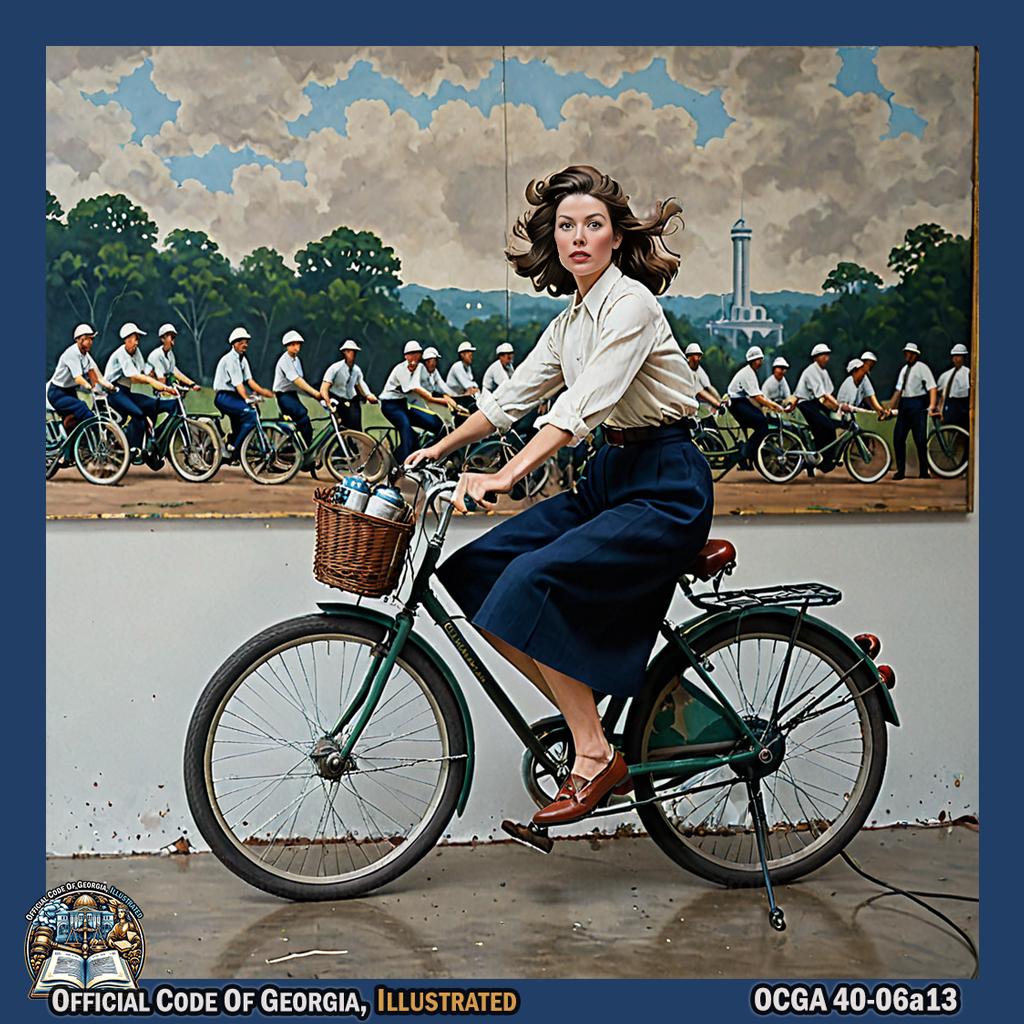
Maidie Norman gracefully pedaling a vintage bicycle with an electric motor, set against the backdrop of the Battle of Atlanta Cyclorama, while capturing the moment in Jeff Wall's signature style. - PART 2 Motorcycles
-
PART 2A Electric Personal Assistive Mobility Devices and Personal Delivery Devices
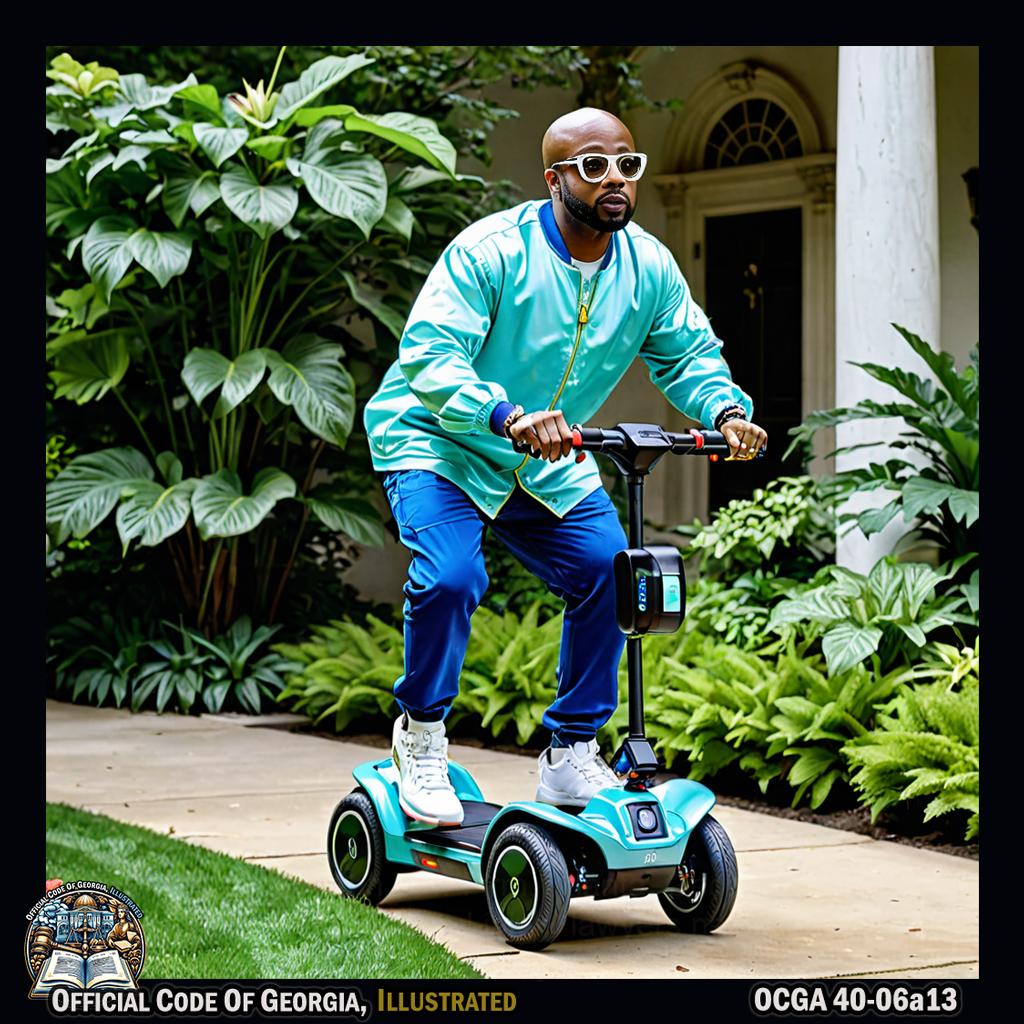
Jermaine Dupri gracefully glides through the lush gardens of Swan House on an electric personal assistive mobility device, while simultaneously maneuvering a personal delivery device with precision and flair, all captured in the style of Cindy Sherman's art. -@jermainedupri - PART 4 Mopeds
- PART 5 Low-speed Vehicles
- PART 6 Personal Transportation Vehicle Transportation Plan
PART 1 Bicycles and Play Vehicles¶
- 40-6-290. Application of part regarding bicycles.
-
40-6-291. Traffic laws applicable to bicycles; operation upon paved shoulder; signaling of right hand turns.

Actor, producer, director Tyler Perry gracefully rides a bicycle along a paved path, using his right hand to signal a turn and smiling, capturing the scene as an art piece from Alton Tobey. -@tylerperry - 40-6-293. Clinging to vehicles.
-
40-6-294. Riding on roadways and bicycle paths.
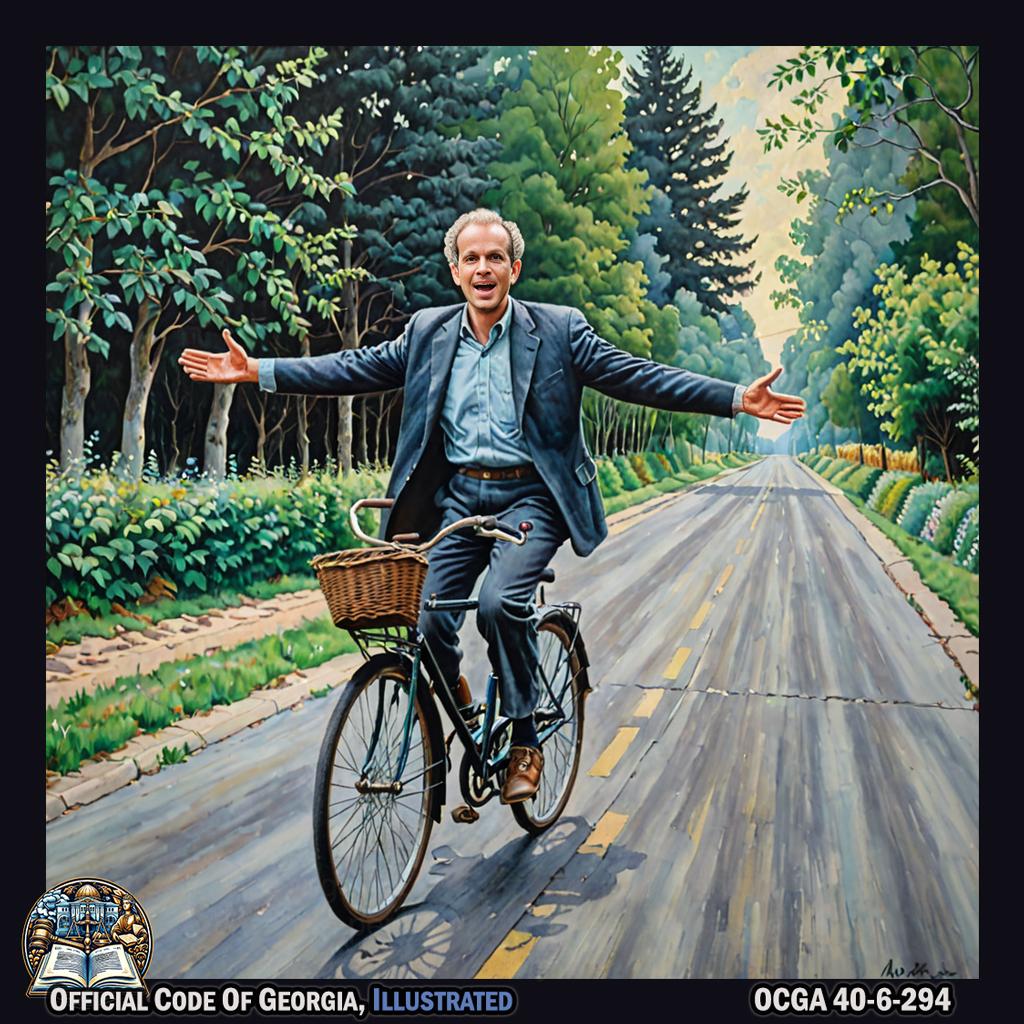
Leo Kottke, the musician, appears to be pedaling a bicycle with arms outstretched, leaning side to side as if navigating a winding path in an art piece reminiscent of Martin Lewis. - 40-6-296. Lights and other equipment on bicycles.
- 40-6-297. Violation of part a misdemeanor; duty of parents and guardians.
- 40-6-298. Rules and regulations.
- 40-6-299. Redesignated.
40-6-290.Application of part regarding bicycles.¶
The provisions of this part applicable to bicycles shall apply whenever a bicycle is operated upon a highway, upon a bicycle lane, or upon any bicycle path set aside for the exclusive use of bicycles, subject to those exceptions stated in this part.
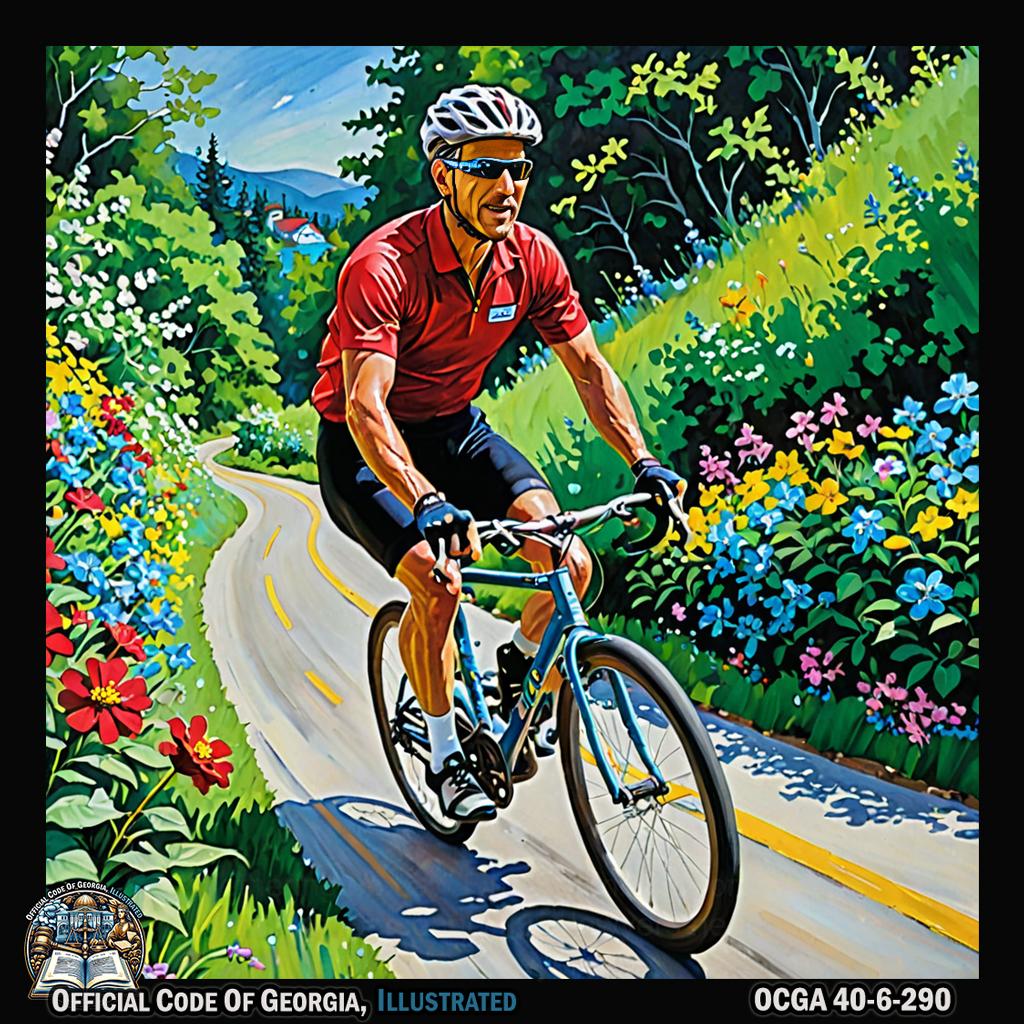
40-6-291.Traffic laws applicable to bicycles; operation upon paved shoulder; signaling of right hand turns.¶
- The provisions of this chapter that apply to vehicles, but not exclusively to motor vehicles, shall apply to bicycles, except as provided in this Code section and except that the penalties prescribed in subsection (b) of Code Section 40-6-390, subsection (c) of Code Section 40-6-391, and subsection (a) of Code Section 40-6-393 shall not apply to persons riding bicycles.
-
Notwithstanding the provisions of Code Section 40-6-50, any person operating a bicycle may ride upon a paved shoulder; provided, however, that such person shall not be required to ride upon a paved shoulder.
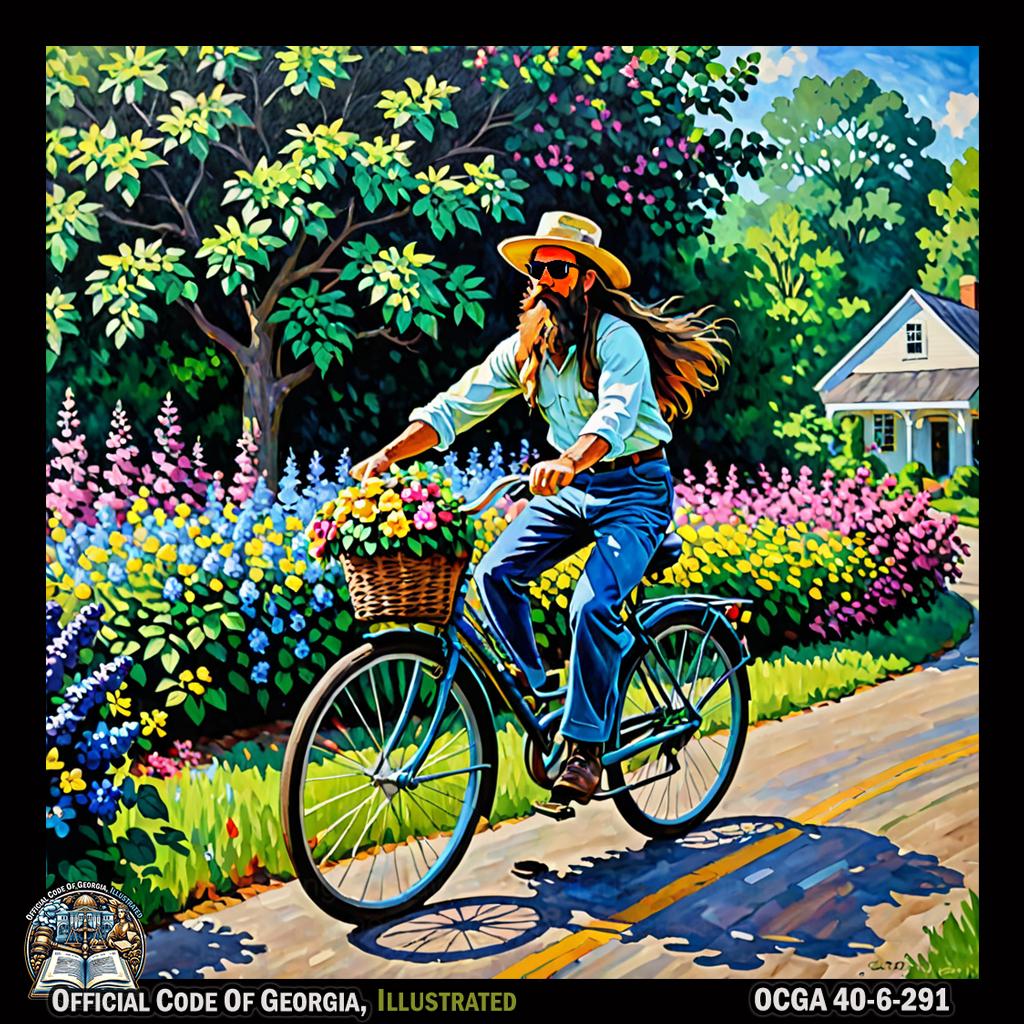
Blackberry Smoke rides a bicycle on the paved shoulder, then gracefully dismounts and dances with colorful flowers in a style reminiscent of Claude Monet's art at Sugar Creek Garden and Herb Farm in Decatur, Georgia. -@blackberrysmoke -
Any person operating a bicycle may signal a right turn with his or her right arm and hand extended horizontally or with his or her left hand and arm extended upward.

Hosea Chanchez, garbed in vibrant 19th-century attire reminiscent of Richard T. Scott's paintings, theatrically extends his right arm with an exaggerated flourish while cycling past the charming Victorian buildings of downtown Alpharetta, as onlookers dressed in period costumes applaud his safety demonstration. -@hoseachanchez
40-6-292.Manner of riding bicycle; passengers.¶
- A person propelling a bicycle shall not ride other than upon or astride a permanent and regular seat attached thereto and shall allow no person to ride upon the handlebars.
-
No bicycle shall be used to carry more persons at one time than the number for which it is designed and equipped.

Jason Aldean gracefully stands beside a beautifully designed bicycle, demonstrating how it is meant to carry only the designated number of persons. The scene captures the essence of Annie Leibovitz's artistic style, creating a visually captivating and thought-provoking art piece that educates with flair and creativity in Waycross, Georgia. -@Jason_Aldean -
No person shall transport a child under the age of one year as a passenger on a bicycle on a highway, roadway, bicycle path, bicycle lane, or sidewalk; provided, however, that a child under the age of one year may be transported on a bicycle trailer or in an infant sling so long as such child is seated in the bicycle trailer or carried in an infant sling according to the bicycle trailer’s or infant sling’s manufacturer’s instructions, and the bicycle trailer is properly affixed to the bicycle according to the bicycle trailer’s manufacturer’s instructions or the infant sling is properly worn by the rider of the bicycle according to the infant sling’s manufacturer’s instructions.
- No child between the ages of one year and four years shall ride as a passenger on a bicycle or bicycle trailer or be transported in an infant sling unless the child is securely seated in a child passenger bicycle seat, bicycle trailer, or infant sling according to the child passenger bicycle seat’s, bicycle trailer’s, or infant sling’s manufacturer’s instructions and the child passenger seat or bicycle trailer is properly affixed to the bicycle according to the child passenger bicycle seat’s or bicycle trailer’s manufacturer’s instructions or the infant sling is worn according to the infant sling’s manufacturer’s instructions.
- Violation of subsections (c) and (d) of this Code section shall not constitute negligence per se nor contributory negligence per se or be considered evidence of negligence or liability.
- No person under the age of 16 years failing to comply with subsections (c) and (d) of this Code section shall be fined or imprisoned.
40-6-293.Clinging to vehicles.¶
No person riding upon any bicycle, coaster, roller skates, sled, or toy vehicle shall attach the same or himself or herself to any vehicle upon a roadway.
40-6-294.Riding on roadways and bicycle paths.¶
- As used in this Code section, the term “hazards to safe cycling” includes, but shall not be limited to, surface debris, rough pavement, drain grates which are parallel to the side of the roadway, parked or stopped vehicles, potentially opening car doors, or any other objects which threaten the safety of a person operating a bicycle.
-
Every person operating a bicycle upon a roadway shall ride as near to the right side of the roadway as practicable, except when:
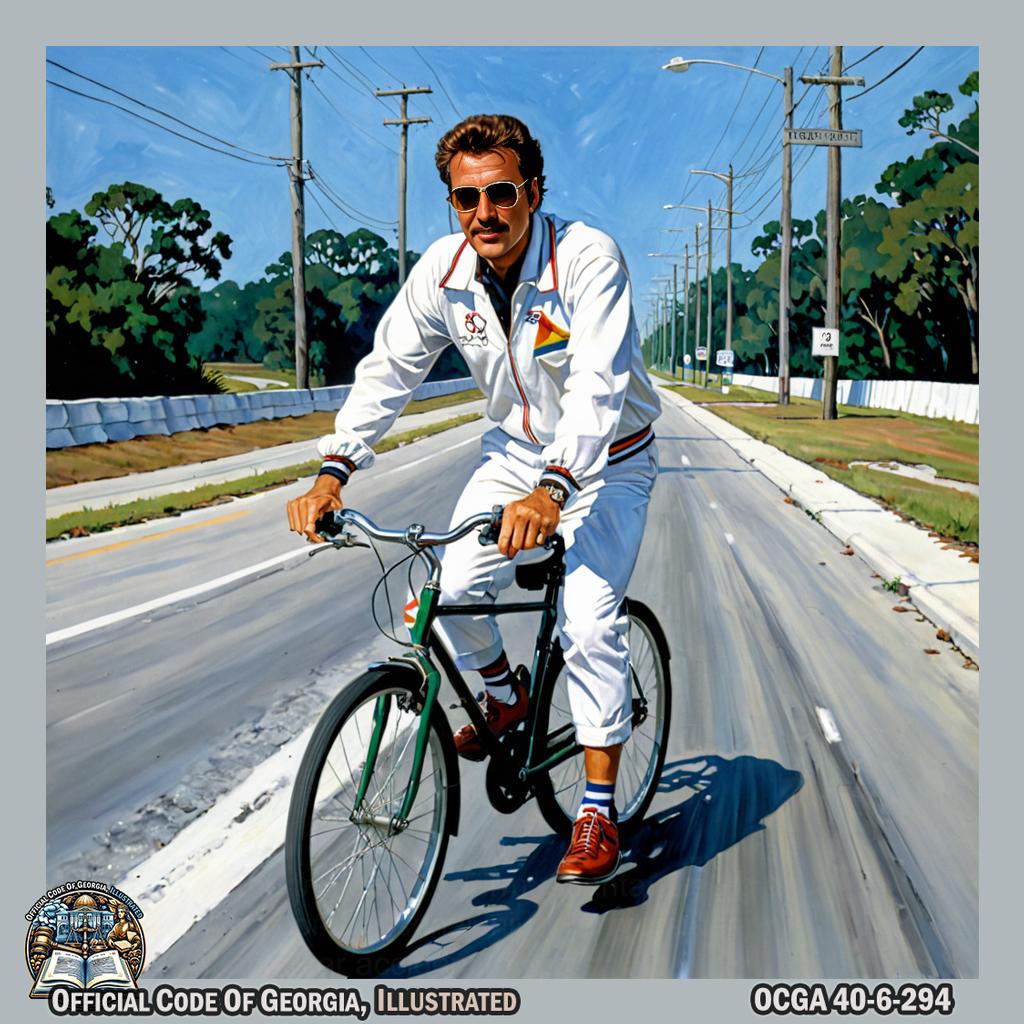
Doug Stone, dressed in 90s attire, rides a bicycle along the right side of the roadway near the 1996 Olympic Yachting Cauldron in Savannah, Georgia, while incorporating elements of Maurizio Anzeri's art style into his performance. -@dougstonetour - Turning left;
-
Avoiding hazards to safe cycling;
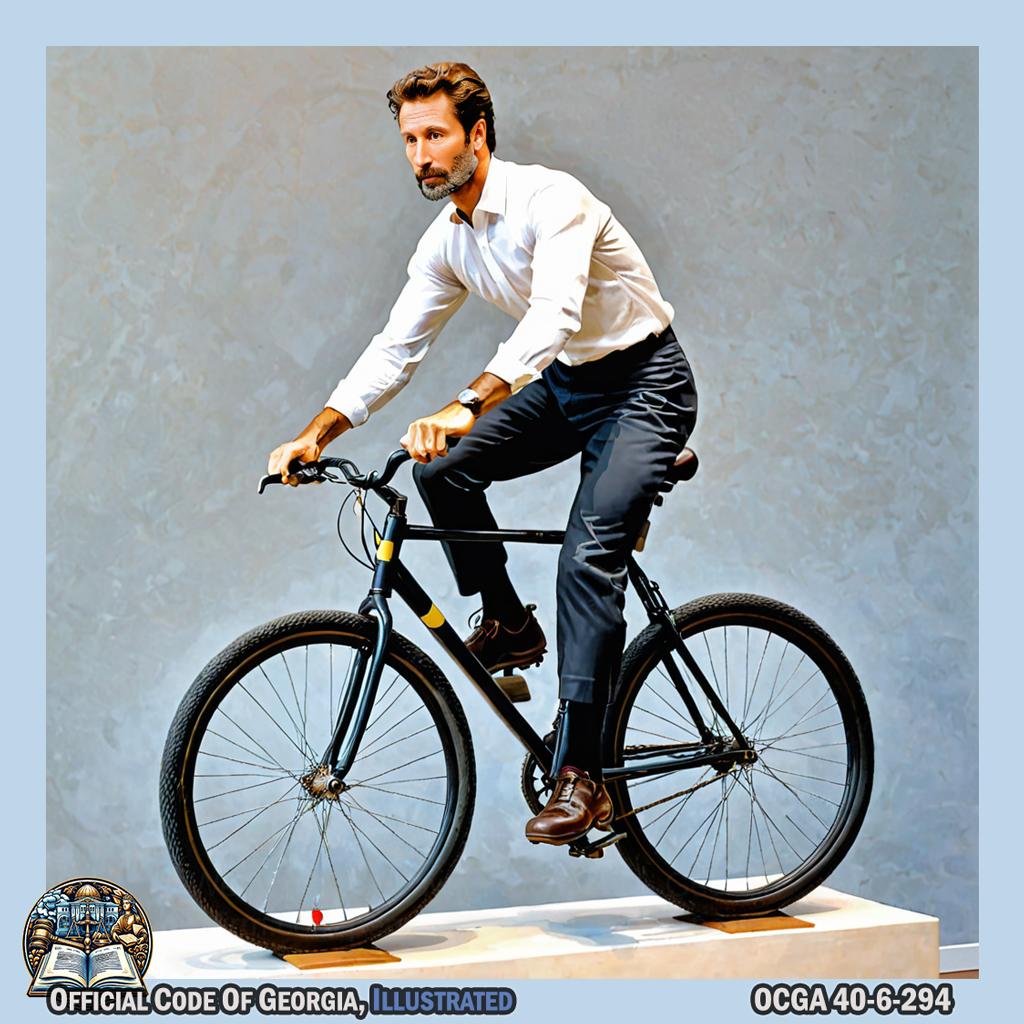
Michael Palmer gracefully balancing on a bicycle, skillfully maneuvering around obstacles with fluid and dynamic movements, embodying the essence of safe cycling in an art piece reminiscent of Brâncuși's style. -@MGPalms -
The lane is too narrow to share safely with a motor vehicle;
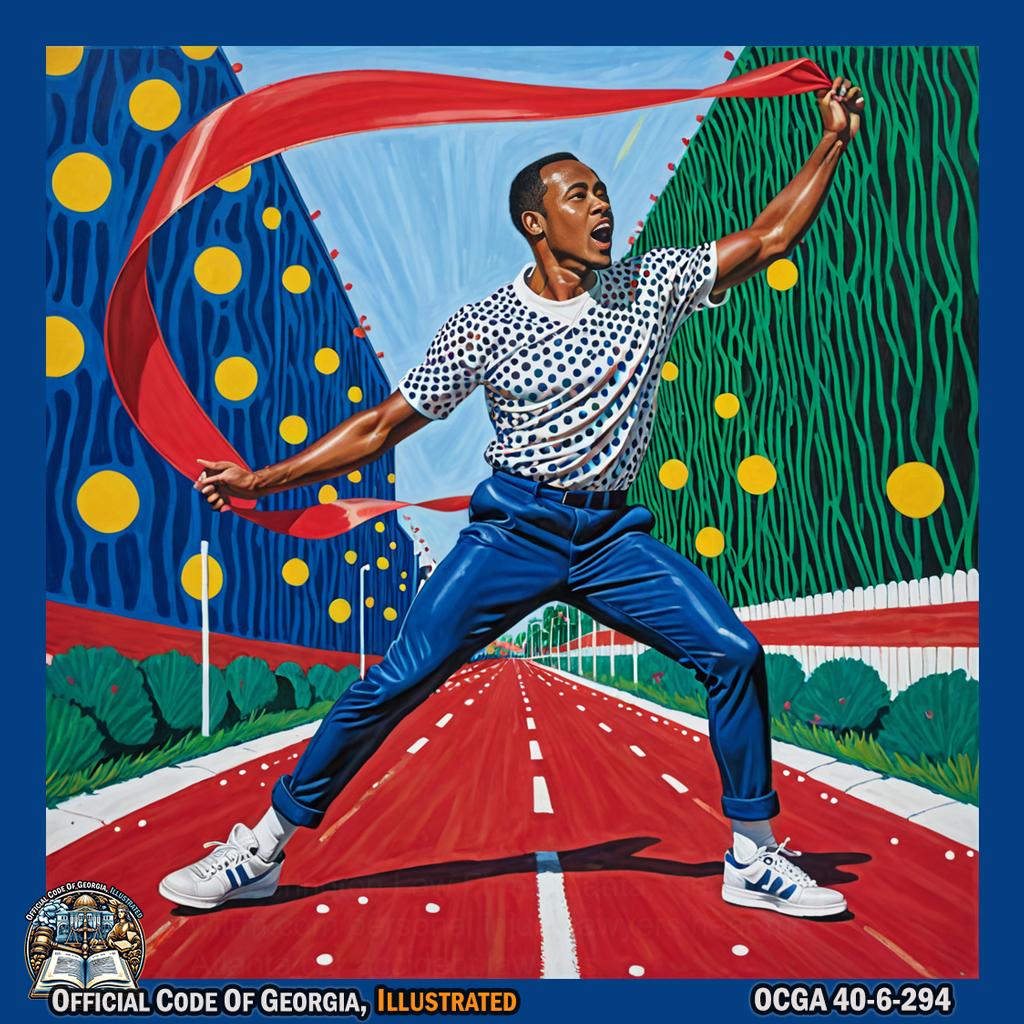
Football player Brandon Mosley gracefully dances in a polka-dotted lane, holding a giant ribbon to symbolize the narrowness of the space, while cars zoom past him. -
Traveling at the same speed as traffic;
-
Exercising due care when passing a standing vehicle or one proceeding in the same direction; or
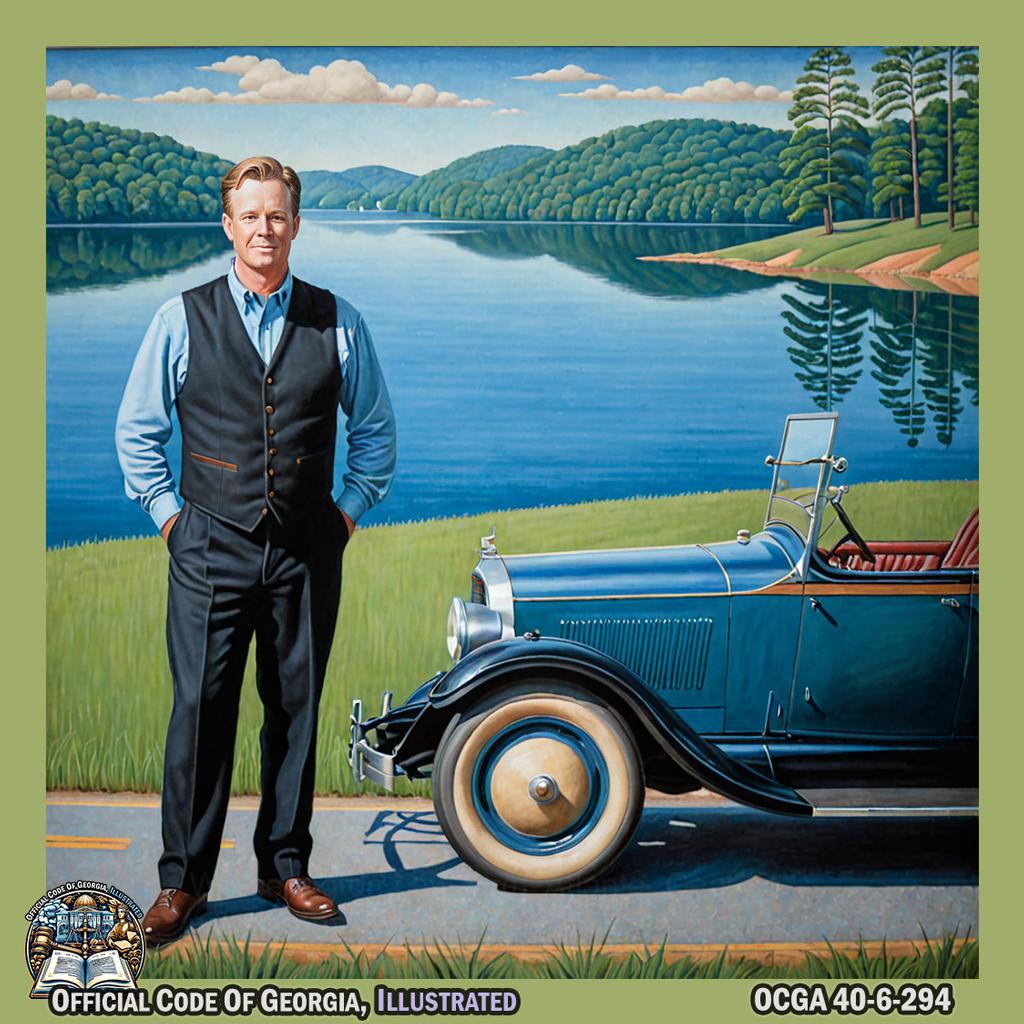
Shawn Mullins stands gracefully, miming the act of cautiously passing a standing vehicle or one proceeding in the same direction, all set against a backdrop reminiscent of Grant Wood's style, with Lake Lanier providing a stunning visual. -@mullinsshawn -
There is a right turn only lane and the person operating the bicycle is not turning right;
provided, however, that every person operating a bicycle away from the right side of the roadway shall exercise reasonable care and shall give due consideration to the other applicable rules of the road.
-
Persons riding bicycles upon a roadway shall not ride more than two abreast except on bicycle paths, bicycle lanes, parts of roadways set aside for the exclusive use of bicycles, or when a special event permit issued by a local governing authority permits riding more than two abreast.
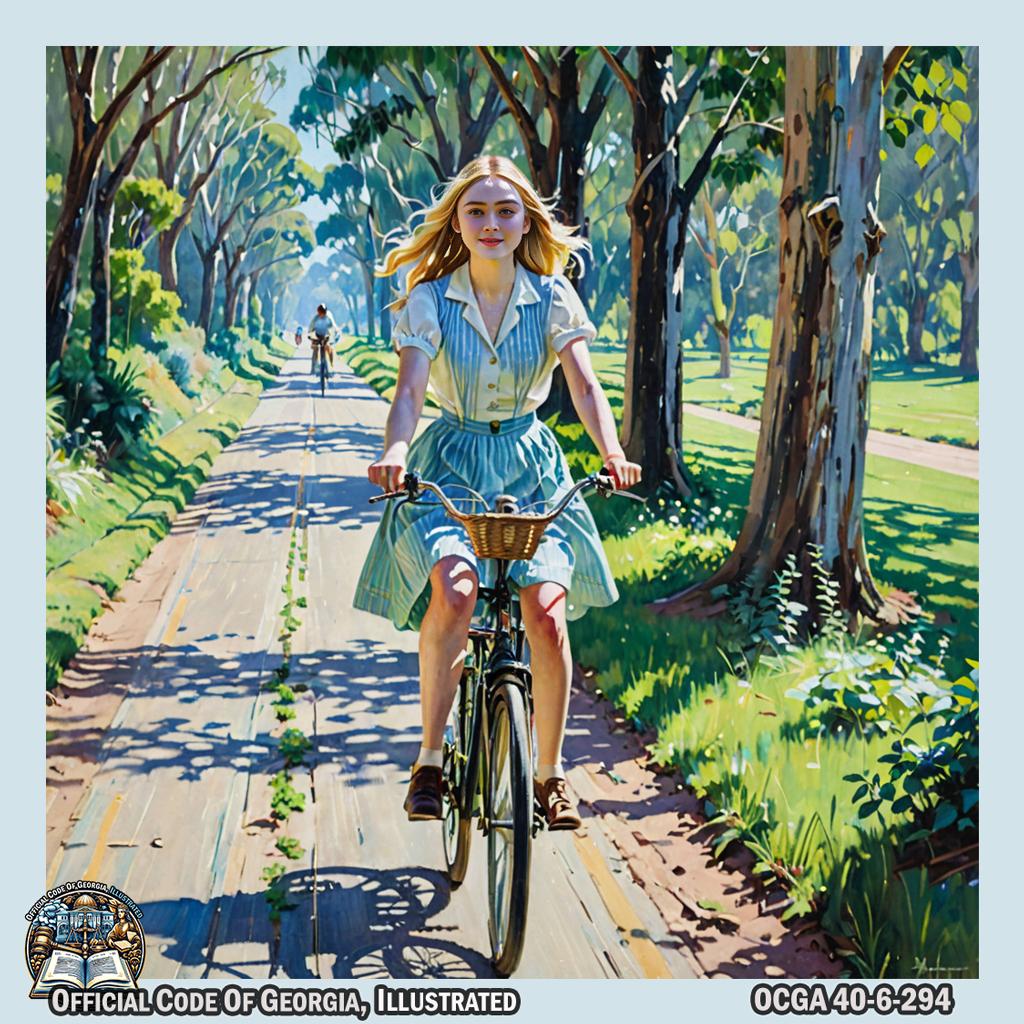
Dakota Fanning gracefully rides a vintage bicycle along a scenic pathway, flanked by lush greenery and dappled sunlight, while elegantly gesturing to another cyclist to stay within the two-abreast limit as per Georgia state law. -@itsDakotaFannin -
Whenever a usable bicycle path has been provided adjacent to a roadway and designated for the exclusive use of bicycle riders, then the appropriate governing authority may require that bicycle riders use such bicycle path and not use those sections of the roadway so specified by such local governing authority. The governing authority may be petitioned to remove restrictions upon demonstration that the bicycle path has become inadequate due to capacity, maintenance, or other causes.
- Bicycle paths subject to the provisions of subsection (d) of this Code section shall at a minimum be required to meet accepted guidelines, recommendations, and criteria with respect to planning, design, operation, and maintenance as set forth by the American Association of State Highway and Transportation Officials, and such bicycle paths shall provide accessibility to destinations equivalent to the use of the roadway.
- Any person operating a bicycle in a bicycle lane shall ride in the same direction as traffic on the roadway.
40-6-295.Carrying articles.¶
No person operating a bicycle shall carry any package, bundle, or other article which prevents him or her from keeping at least one hand upon the handlebars.
40-6-296.Lights and other equipment on bicycles.¶
-
Every bicycle when in use at nighttime shall be equipped with a light on the front which shall emit a white light visible from a distance of 300 feet to the front and with a light on the back which shall emit a red light visible from a distance of 300 feet to the rear. Any bicycle equipped with a red reflector on the rear that is approved by the Department of Public Safety shall not be required to have a light on the rear of the bicycle.
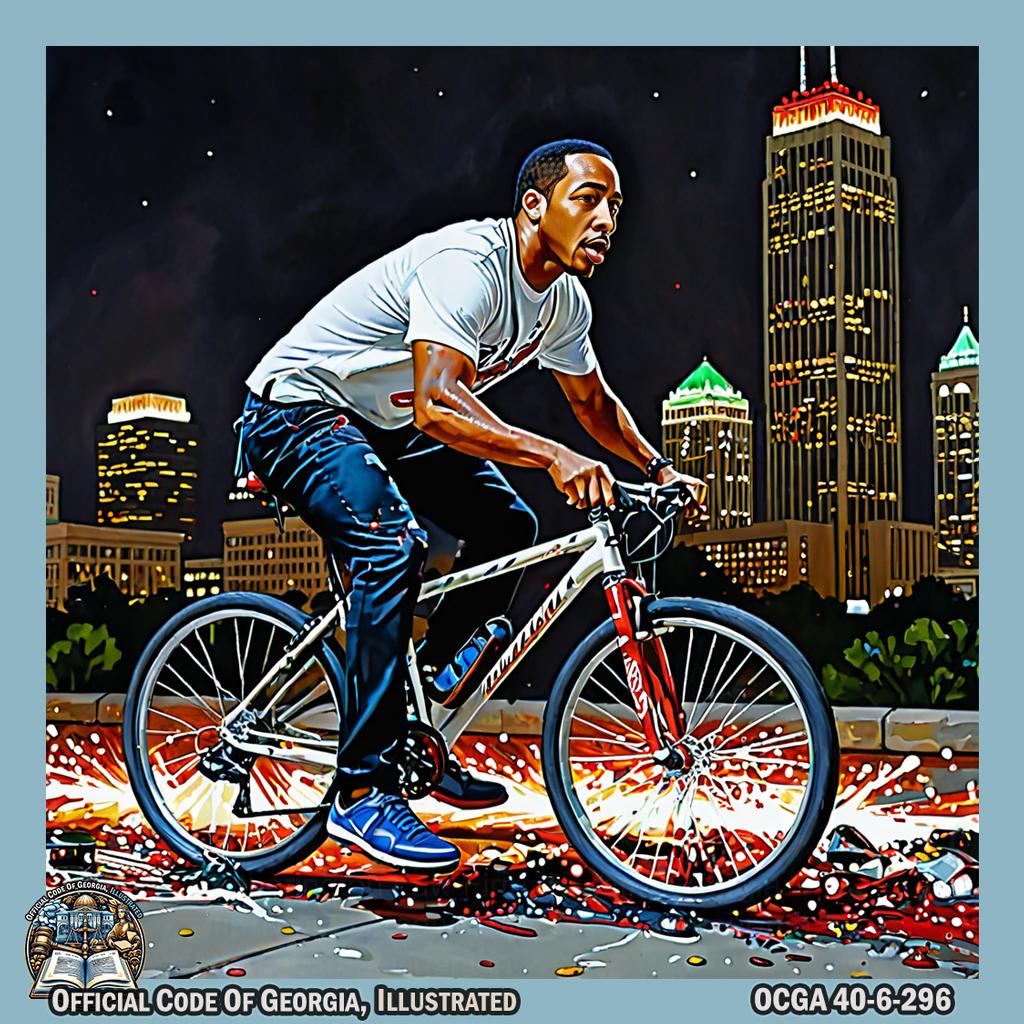
Ludacris, in the style of Jackson Pollock's art, vigorously swings paint-soaked brushes to create a chaotic and dynamic painting representing the requirement for bicycle lights at nighttime, with vibrant streaks of red and white light swirling across the canvas against the backdrop of Atlanta's iconic skyline. -@Ludacris -
Every bicycle sold or operated shall be equipped with a brake which will enable the operator to make the braked wheels skid on dry, level pavement.
- No bicycle shall be equipped or operated while equipped with a set of handlebars so raised that the operator must elevate his or her hands above the operator’s shoulders in order to grasp the normal steering grip area.
-
- No person under the age of 16 years shall operate or be a passenger on a bicycle on a highway, bicycle path, bicycle lane, or sidewalk under the jurisdiction or control of this state or any local political subdivision thereof without wearing a bicycle helmet.
-
For the purposes of this subsection, the term “bicycle helmet” means a piece of protective headgear which meets or exceeds the impact standards for bicycle helmets set by the American National Standards Institute (ANSI) or the Snell Memorial Foundation.

Jeremy Mincey poses with ANSISnell standard bicycle helmet in Caravaggio-inspired setting -
For the purposes of this subsection, a person shall be deemed to wear a bicycle helmet only if a bicycle helmet of good fit is fastened securely upon such person’s head with the straps of such bicycle helmet.
- No bicycle without an accompanying protective bicycle helmet shall be rented or leased to or for the use of any person under the age of 16 years unless that person is in possession of a bicycle helmet at the time of the rental or lease.
-
Violation of any provision of this subsection shall not constitute negligence per se nor contributory negligence per se or be considered evidence of negligence or liability.

Acuity Brands, wearing a judge's robe, dramatically gestures with outstretched arms as they release colorful butterflies from their hands while standing in a lush, sunlit garden in Johns Creek. -@AcuityBrands -
No person under the age of 16 failing to comply with any provision of this subsection shall be fined or imprisoned.

A person under the age of failing to comply with any provision of this subsection shall be fined or imprisoned, except Joel Chandler Harris performing the action in the style of Jean-Michel Basquiat.
40-6-297.Violation of part a misdemeanor; duty of parents and guardians.¶
- It shall be a misdemeanor for any person to do any act forbidden or fail to perform any act required in this part.
- The parent of any child and the guardian of any ward shall not authorize or knowingly permit such child or ward to violate any of the provisions of this part.
40-6-298.Rules and regulations.¶
The Board of Public Safety is authorized to promulgate rules and regulations to carry this part into effect and is authorized to establish regulations for any additional safety equipment or standards it shall require for bicycles.
40-6-299.Redesignated.¶
Editor’s notes.
Ga. L. 2011, p. 426, § 3/HB 101, effective July 1, 2011, redesignated former Code Section 40-6-299 as present Code Section 40-6-298.
PART 1A Electric Assisted Bicycles {#t40c06a13p1A}

- 40-6-300. Definitions.
- 40-6-301. Rights and duties of electric assisted bicycle operators.
- 40-6-302. Labeling of bicycles; required equipment.
- 40-6-303. Location of operation; age limitations; required safety equipment.
40-6-300.Definitions.¶
For purposes of this part, the term:
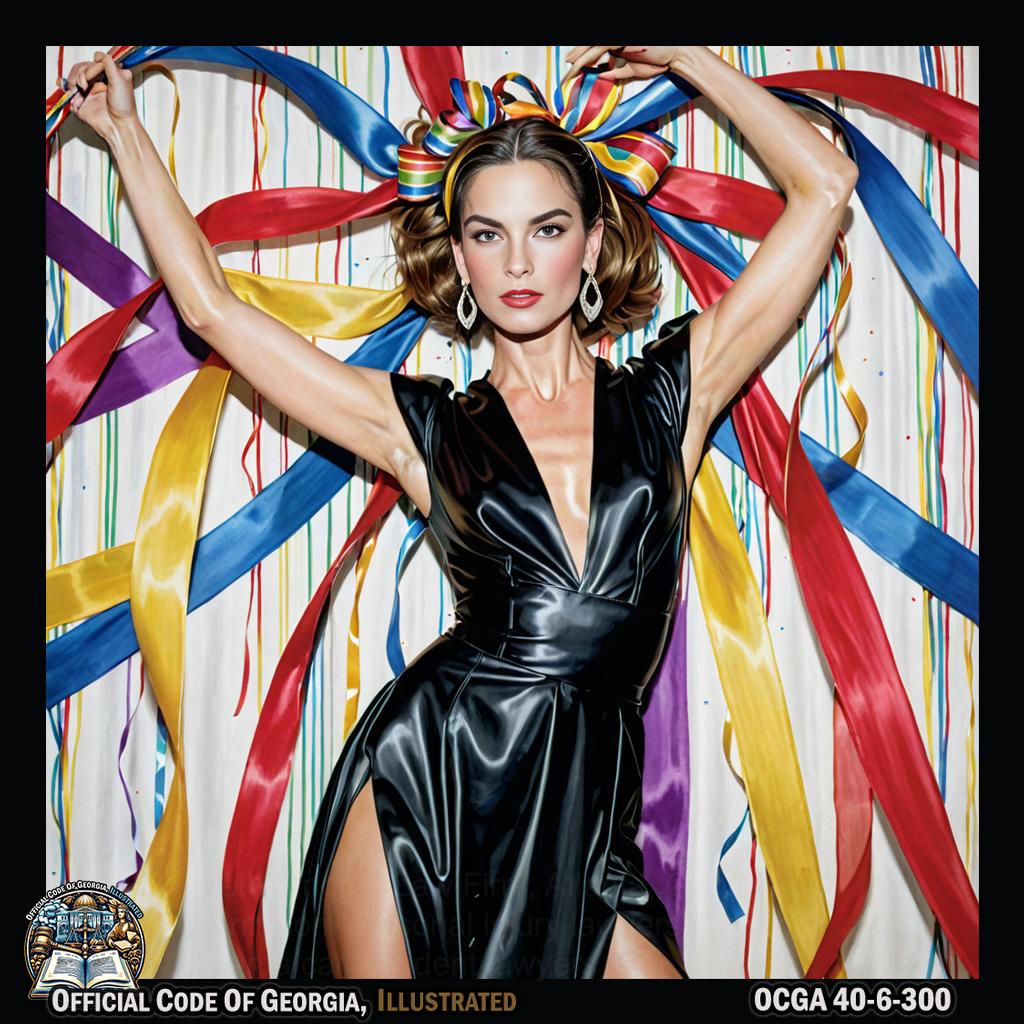
- “Class I electric assisted bicycle” means an electric assisted bicycle equipped with a motor that provides assistance only when the rider is pedaling and that ceases to provide assistance when the device reaches a speed of 20 miles per hour.
- “Class II electric assisted bicycle” means an electric assisted bicycle equipped with a motor that may be used exclusively to propel the vehicle but is not capable of reaching a speed of 20 miles per hour.
- “Class III electric assisted bicycle” means an electric assisted bicycle equipped with a motor that provides assistance only when the rider is pedaling and that ceases to provide assistance when the device reaches a speed of 28 miles per hour.
40-6-301.Rights and duties of electric assisted bicycle operators.¶
Every person operating an electric assisted bicycle shall be granted all the rights and shall be subject to all the duties applicable to the operator of a bicycle under this title except as otherwise provided in this part.
40-6-302.Labeling of bicycles; required equipment.¶
- Any electric assisted bicycle manufactured on and after January 1, 2020, shall be equipped with a permanently affixed label in a prominent location which identifies such device as a class I, II, or III electric assisted bicycle along with the motor wattage and top assisted speed capability. Such label shall be printed in at least 9 point Arial font.
- The requirements set forth in subsection (a) of this Code section shall apply to a manufacturer, distributor, and any person who alters an electric assisted bicycle in a manner that changes the class by which the electric assisted bicycle is identified.
- Any electric assisted bicycle shall have the same equipment required for bicycles as set forth in Part 1 of this article; provided however, that such devices shall be capable of disengaging the motor when the operator stops pedaling or applies the brakes.
- Any class III electric assisted bicycle shall be equipped with a speedometer that is capable of displaying the speed the device is traveling measured in miles per hour.
40-6-303.Location of operation; age limitations; required safety equipment.¶
-
-
Any class I electric assisted bicycle or class II electric assisted bicycle shall be authorized to be operated on any bicycle path or shared use path where bicycles are permitted to be operated; provided, however, that a local authority or state agency may prohibit the operation of a class I electric assisted bicycle or class II electric assisted bicycle on any bicycle path or shared use path within its jurisdiction.

Travis Tritt, wearing a vibrant costume, theatrically hops onto an electric bicycle adorned with abstract splashes of color in Matsumi Kanemitsu's style, and pedals exuberantly along a winding path at Historic Fourth Ward Skate Park, weaving through vividly painted sculptures that mimic the park's landscape. -@Travistritt -
No class III electric assisted bicycle shall be operated on a bicycle path or shared use path unless such path is within or adjacent to a highway or unless operation of such device is permitted on such path by the local authority or state agency having jurisdiction over such path.
- This subsection shall not apply to a bicycle path or shared use path designated for nonmotorized vehicles if such path has a natural surface tread made by clearing and grading the native soil with no added surface materials. The types of devices which may be used upon such trails may be regulated by the local authority or state agency having jurisdiction over such path.
-
-
No person under the age of 15 shall operate a class III electric assisted bicycle; provided, however, that such person shall be authorized to ride as a passenger upon a class III electric assisted bicycle designed to accommodate passengers.

Quavo, riding as a passenger on a class III electric assisted bicycle, in the style of Keith Haring art piece. -@QuavoStuntin -
- No person shall operate or be a passenger on a class III electric assisted bicycle without wearing a bicycle helmet.
- No class III electric assisted bicycle without an accompanying protective bicycle helmet shall be rented to or leased to any person for use unless such person is in possession of a bicycle helmet at the time of the rental or lease.
- For the purposes of this subsection, the term “bicycle helmet” means a piece of protective headgear which meets or exceeds the impact standards for bicycle helmets set by the American National Standards Institute (ANSI) or the Snell Memorial Foundation.
- For the purposes of this subsection, a person shall be deemed to wear a bicycle helmet only if a bicycle helmet of good fit is fastened securely upon such person’s head with the straps of such bicycle helmet.
- Violation of any provision of this subsection shall not constitute negligence per se nor contributory negligence per se or be considered evidence of negligence or liability.
PART 1B Operation of Farm Use Vehicle {#t40c06a13p1B}

- 40-6-305. Purpose of farm use vehicle.
- 40-6-306. Rights and duties of operator.
-
40-6-307. Local restrictions on public roads and highways.

Youtuber and rapper Matthew David Morris meticulously places miniature traffic cones and barriers across a detailed map of roads on the ground, while others hold small cars in anticipation behind the restrictions, creating an immersive scene in Duluth, Georgia. -@MattyBRaps -
40-6-308. Operation of farm tractors upon certain highways; yielding of right of way.
40-6-305.Purpose of farm use vehicle.¶
-
As used in this part, the term:
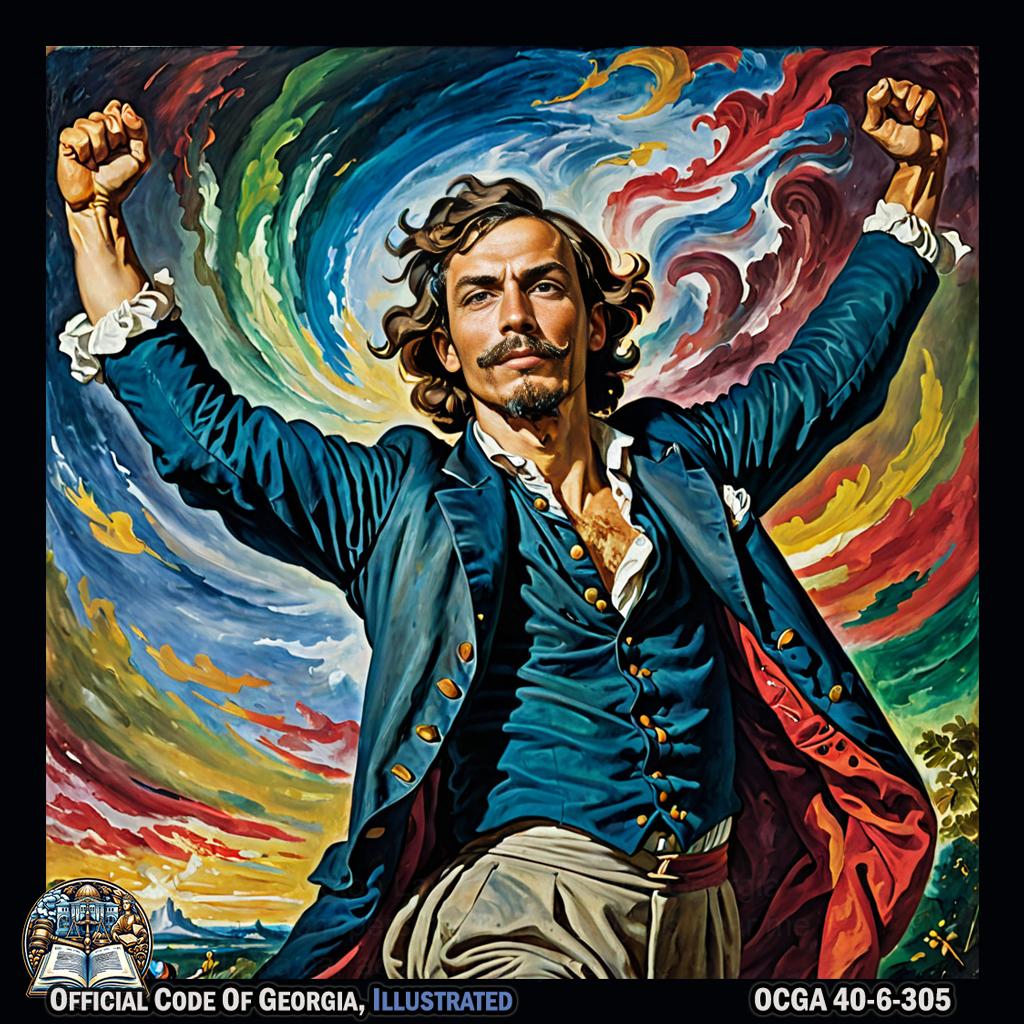
James Carpenter gracefully extending his arms in a dramatic pose, embodying the term "except," surrounded by swirling colors and dynamic movement reminiscent of Eugène Delacroix's art, all set against the lush backdrop of Lilburn. -@JEcarpenter77 - “Farmer” means the owner of a commercial agricultural or silvicultural operation or an employee thereof. Such term shall also include any spouse, child, sibling, parent, grandparent, or grandchild of the owner of such operation.
- “Farm use vehicle” means an all-terrain vehicle or personal transportation vehicle.
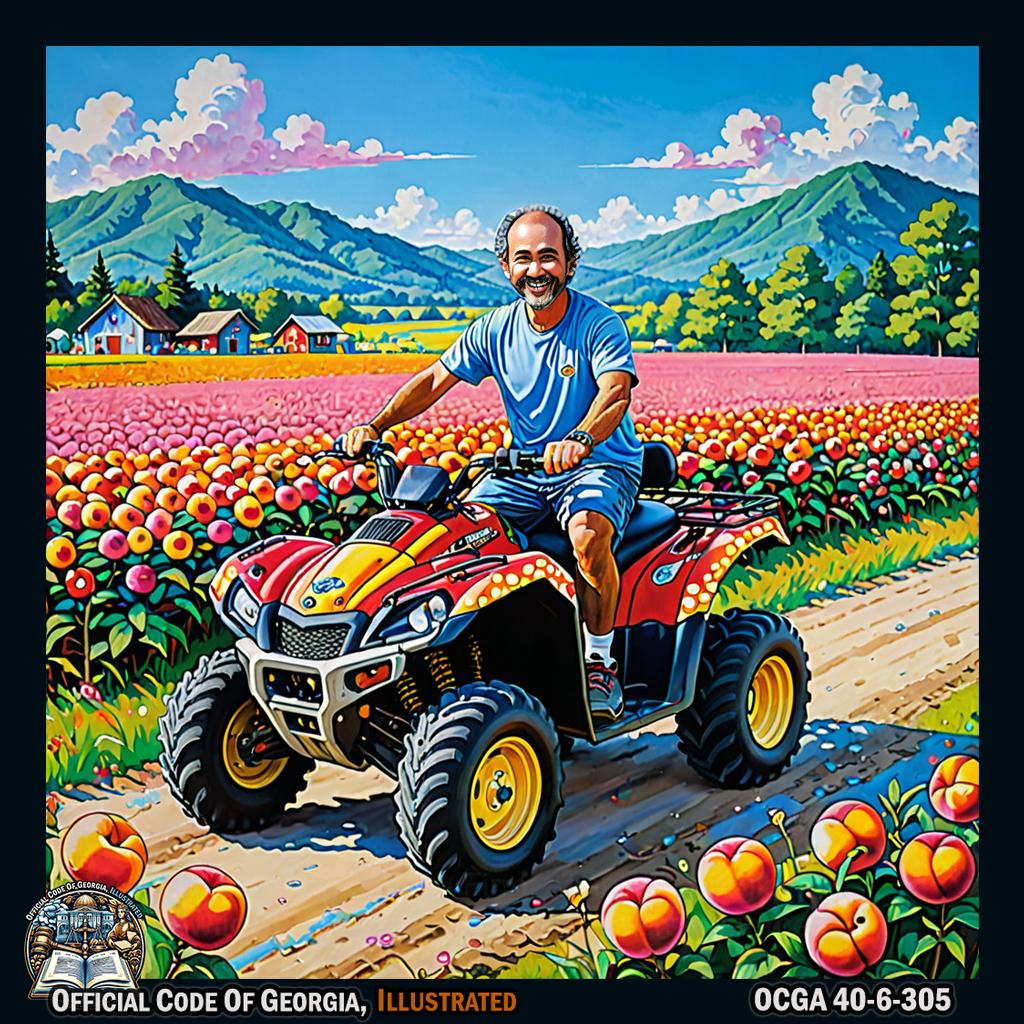
Michael Kelly joyfully rides a colorful, larger-than-life flower-shaped ATV through a vibrant field of Georgia peaches, with a trail of whimsical animal and plant companions following behind in Takashi Murakami's signature style. -@michaeljkellyjr
-
A farmer who is 16 years of age or older may operate a farm use vehicle on any public road or highway of this state so long as:
- Such vehicle has a properly affixed emblem conforming to the requirements of Code Section 40-8-4; and
-
Such vehicle is actively being operated by such farmer to transport:
-
Agricultural products, livestock, farm machinery, or farm supplies to or from a farm; or
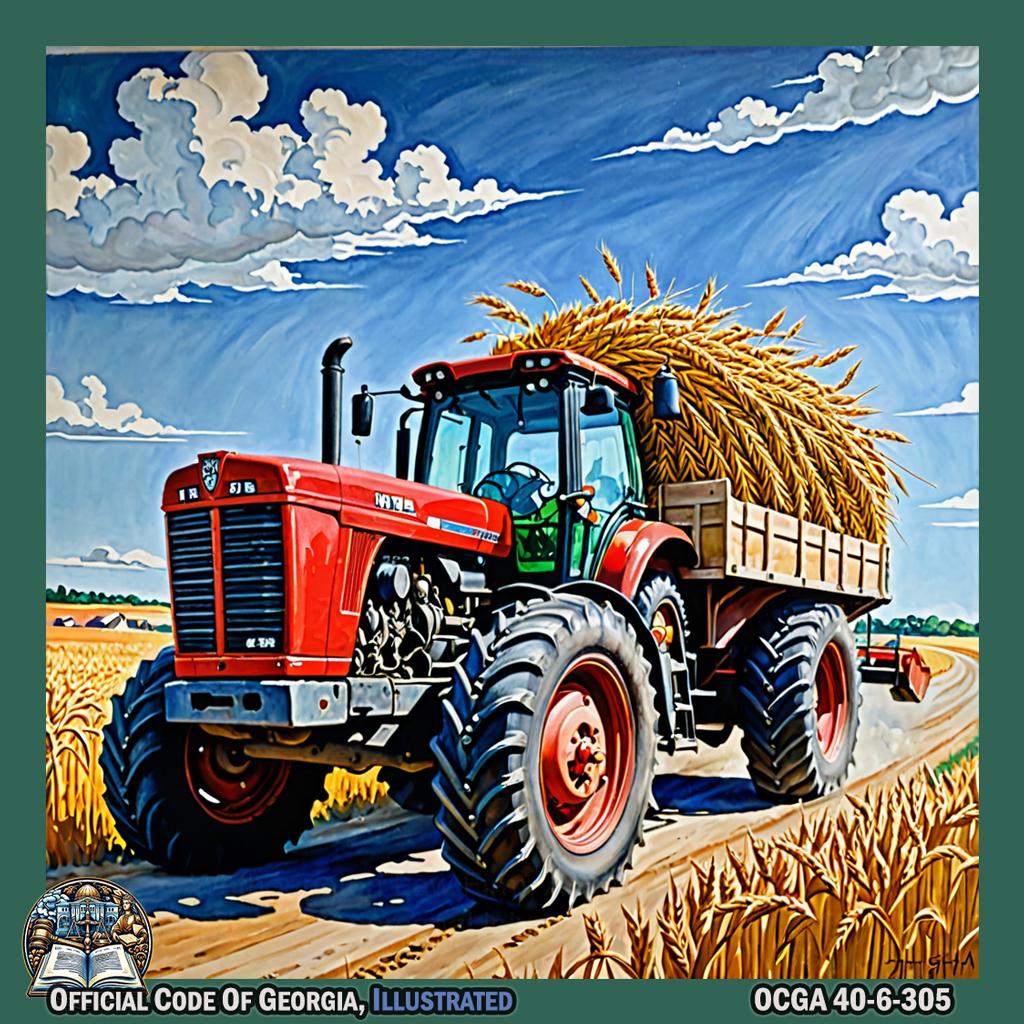
ARG IH Corporation is depicted in Judith Shea's art piece, pretending to drive a tractor while carrying bushels of wheat and leading a cow with a rope. -
Such farmer between his or her residence and the farm at which he or she works or between properties of such farm.
-
40-6-306.Rights and duties of operator.¶
Every person operating a farm use vehicle shall be granted all of the rights and shall be subject to all of the duties applicable to the driver of any other vehicle under this chapter except as to special regulations in this part and except as to the provisions of this chapter which by their nature can have no application.
40-6-307.Local restrictions on public roads and highways.¶
Any municipality may prohibit or limit the operation of farm use vehicles on public roads and highways within its jurisdiction if it is determined that such operation endangers the safety of the traveling public.

40-6-308.Operation of farm tractors upon certain highways; yielding of right of way.¶
-
As used in this Code section, the term:
-
“Farm tractor” means every motor vehicle designed and used primarily as a farm implement, for drawing plows, mowing machines, and other implements of husbandry.

Pernell Roberts gracefully poses as a farmer driving a vintage tractor, surrounded by lush greenery at Callaway Gardens, with dramatic lighting and dynamic angles capturing the essence of Richard Avedon's artistry. -
“Implement of husbandry” means every device, whether it is self-propelled or not, designed and adapted so as to be used exclusively for agricultural, horticultural, or livestock-raising operations or for lifting or carrying an implement of husbandry and, in either case, not subject to registration if operated upon the highways.
-
-
Farm tractors, except trailers and semitrailers operated in accordance with statutory limits or provisions of Code Sections 32-6-24 and 40-8-50, shall not be permitted to travel upon any highway in this state which is a part of The Dwight D. Eisenhower System of Interstate and Defense Highways, provided that the Department of Public Safety shall have the authority to permit such travel in certain geographic areas of the state as deemed necessary. Farm tractors or implements may be operated on any state or local roadway in this state if the operator complies with Code Section 40-8-4 and has taken reasonable steps to reduce the width of the farm tractor or implement as provided for by the manufacturer. Whenever the width of a farm tractor or implement of husbandry exceeds the width of that portion of a roadway on which the farm tractor or implement is driven, which is marked as a single lane of traffic, or, if the roadway has not been marked for lanes of traffic and the width of the farm tractor or implement exceeds more than 50 percent of the width of the roadway, the operator shall move the farm tractor or implement, as soon as possible, as far to the right-hand side of the roadway as is practicable and safe upon approach of any oncoming or following vehicle and upon approaching the crest of a hill.
-
Upon the immediate approach of a farm tractor or implement of husbandry which cannot be moved by the operator thereof to the far right-hand side of the roadway in compliance with subsection (b) of this Code section, due to the existence of any bridge or guardrail, sign, or any other physical impediment which would not safely allow such tractor or implement to travel on the far right-hand side of the road, the driver of every other vehicle shall yield the right-of-way and shall immediately pull over to the far right-hand side of the road and remain in such position until the farm tractor or implement has passed.

Ryan Seacrest, in the style of performance art, gracefully yields to an approaching farm tractor by pulling over to the far right-hand side of a lush Thomasville road and remaining in position until the tractor has passed. -@RyanSeacrest -
This Code section shall not operate to relieve any operator of a farm tractor or implement of husbandry from the duty to drive with due regard for the safety of all persons using the roadway.
PART 2 Motorcycles¶
- 40-6-310. Traffic laws applicable to persons operating motorcycles.
-
40-6-311. Manner of riding motorcycle generally.

Actress and zoologist Kay Panabaker effortlessly rides a motorcycle with one hand on the handlebars, the other arm extended out to the side, leaning into turns and revving the engine at Mississippi Museum of Natural Science in Georgia. -@KayPanabaker -
40-6-312. Operating motorcycle on roadway laned for traffic.
- 40-6-313. Clinging to other vehicles.
- 40-6-314. Footrests and handlebars.
-
40-6-315. Headgear and eye-protective devices for riders.
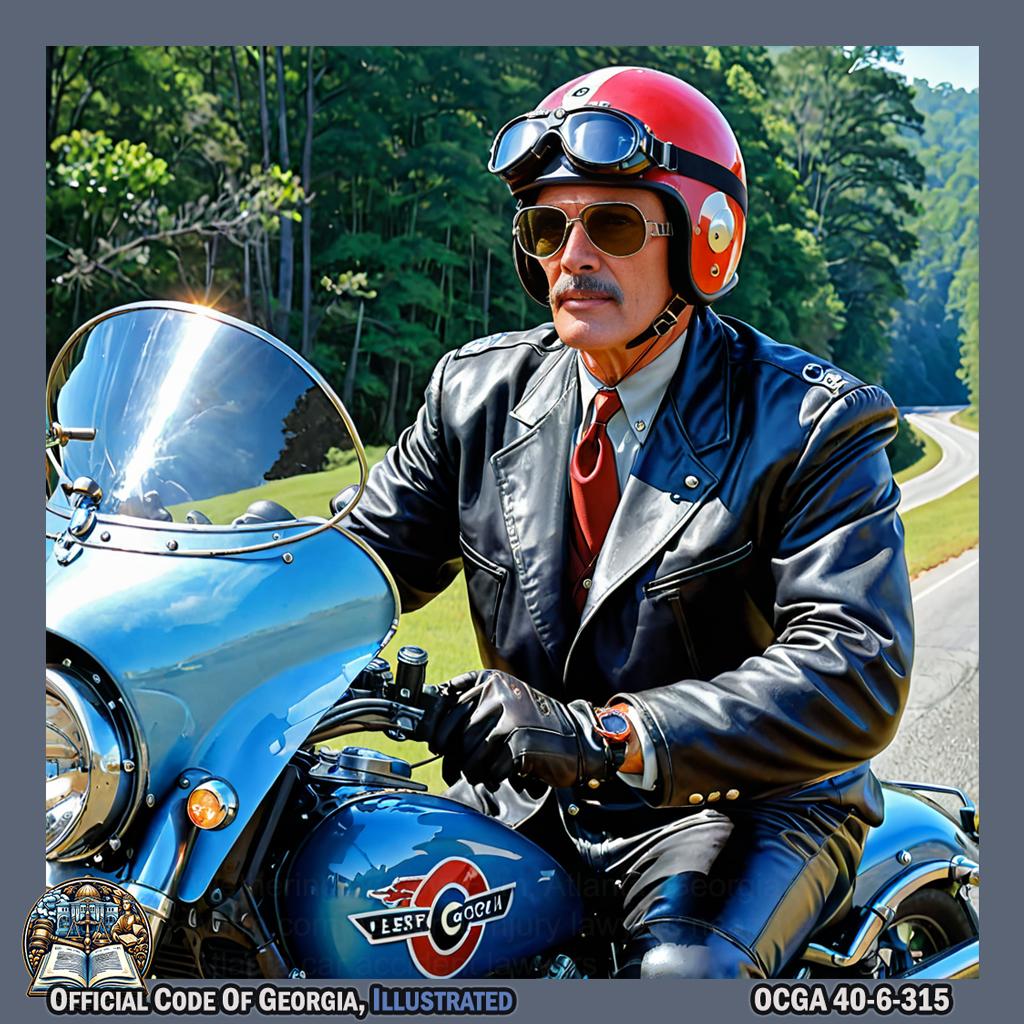
Governor of Georgia, Lester Maddox dons a helmet and goggles as he perches on a motorcycle in the picturesque Lilburn, Georgia.
40-6-310.Traffic laws applicable to persons operating motorcycles.¶
Every person operating a motorcycle shall be granted all of the rights and shall be subject to all of the duties applicable to the driver of any other vehicle under this chapter except as to special regulations in this part and except as to those provisions of this chapter which by their nature can have no application.
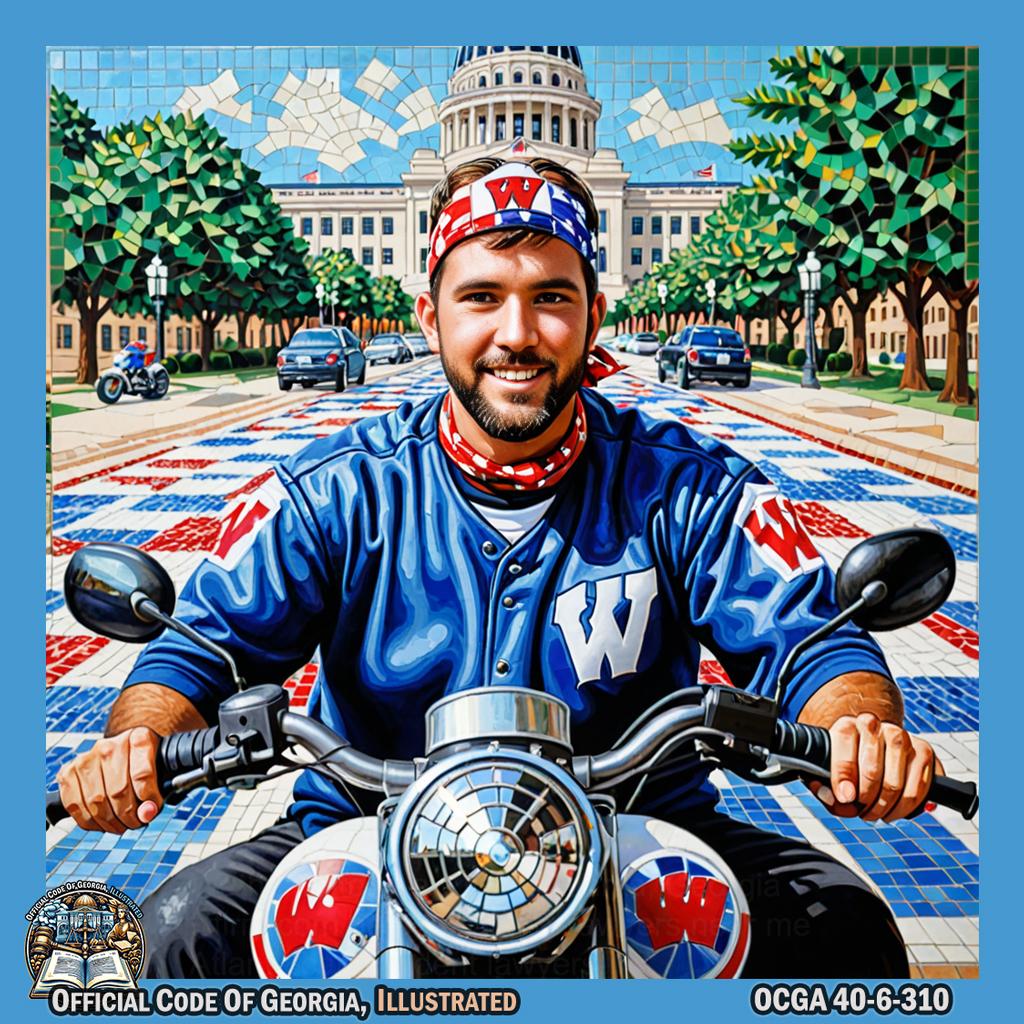
40-6-311.Manner of riding motorcycle generally.¶
-
A person operating a motorcycle shall ride only upon the permanent and regular seat attached thereto; and such operator shall not carry any other person nor shall any other person ride on a motorcycle unless such motorcycle is designed to carry more than one person, in which event a passenger may ride upon the permanent and regular seat if designed for two persons or upon another seat firmly attached to the motorcycle at the rear or side of the operator.
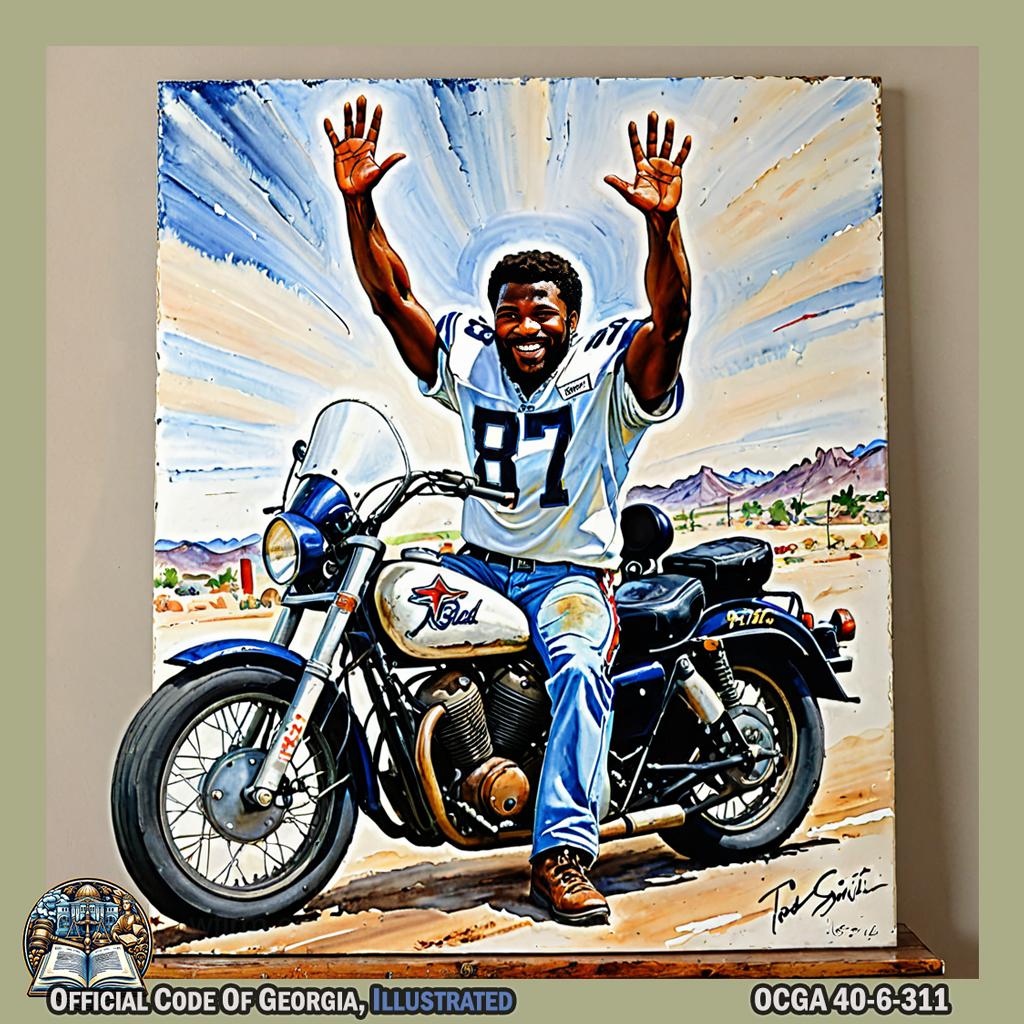
Football player Daryl Smith, depicted in an art piece by Ettore "Ted" DeGrazia, sits on a motorcycle with one hand raised in a "stop" signal and the other gesturing for someone to join, then pats an empty space next to him while looking back and smiling. -
A person shall ride upon a motorcycle equipped with handlebars for directional control only by sitting astride the seat, facing forward, and with one leg on either side of the motorcycle.

Philosopher Robert Arrington is depicted in the art piece by F. Scott Hess, sitting astride a motorcycle facing forward with one leg on either side. -
No person shall operate a motorcycle while carrying any package, bundle, or other article which prevents him from keeping both hands on the handlebars.
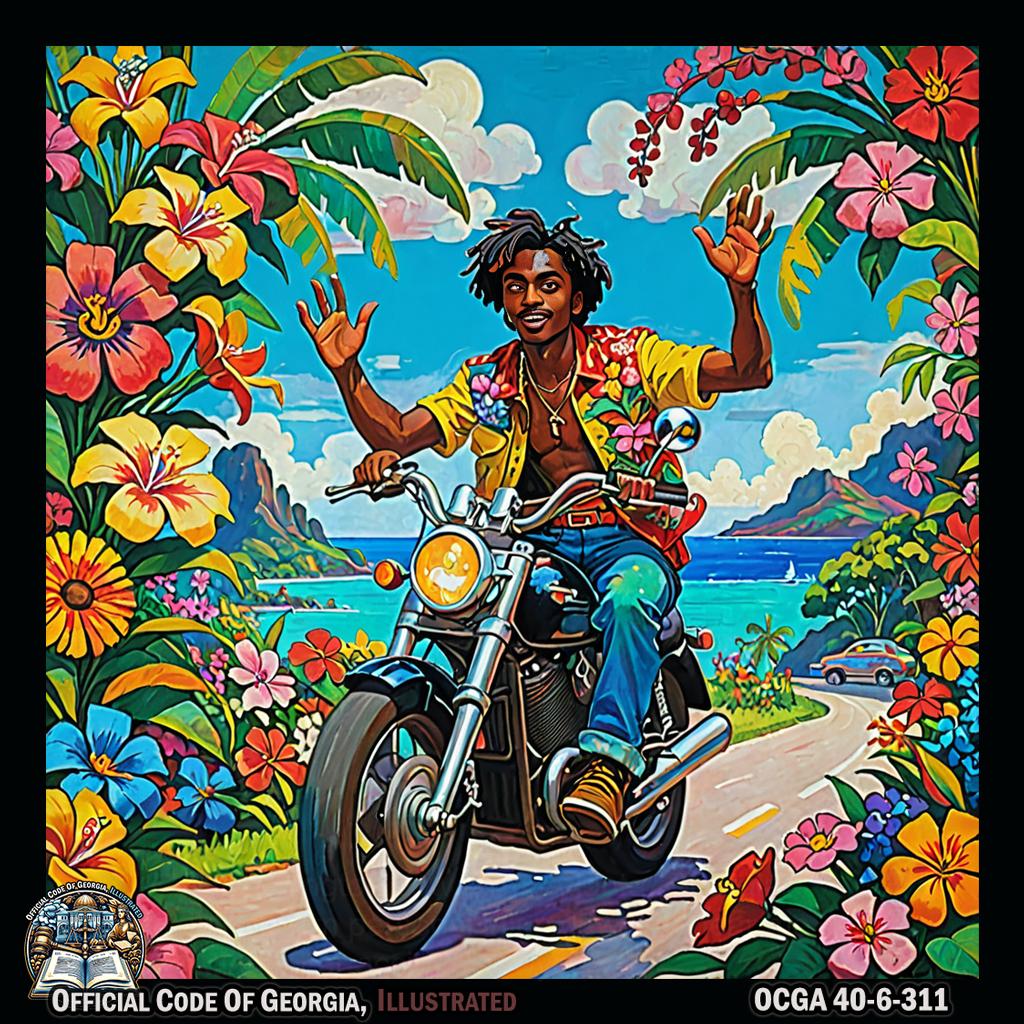
A person riding a motorcycle with both hands on the handlebars, and Playboi Carti is singing while carrying a large colorful bundle of flowers, set in a vibrant scene reminiscent of Paul Gauguin's Tahitian paintings. -@playboicarti -
No operator shall carry any person, nor shall any person ride, in a position that will interfere with the operation or control of the motorcycle or the view of the operator.

Jean Carne gracefully mimics the act of riding a motorcycle, with exaggerated hand gestures and facial expressions, while wearing a variety of historical ladies' hats found in A Century of Hats, all set against the backdrop of a historic Savannah hotel as if captured by Robert Frank. -
No person shall operate or ride upon a motorcycle unless he shall wear some type of footwear in addition to or other than socks.
40-6-312.Operating motorcycle on roadway laned for traffic.¶
- All motorcycles are entitled to full use of a lane, and no motor vehicle shall be driven in such a manner as to deprive any motorcycle of the full use of a lane. This subsection shall not apply to motorcycles operated two abreast in a single lane.
-
The operator of a motorcycle shall not overtake and pass in the same lane occupied by the vehicle being overtaken.
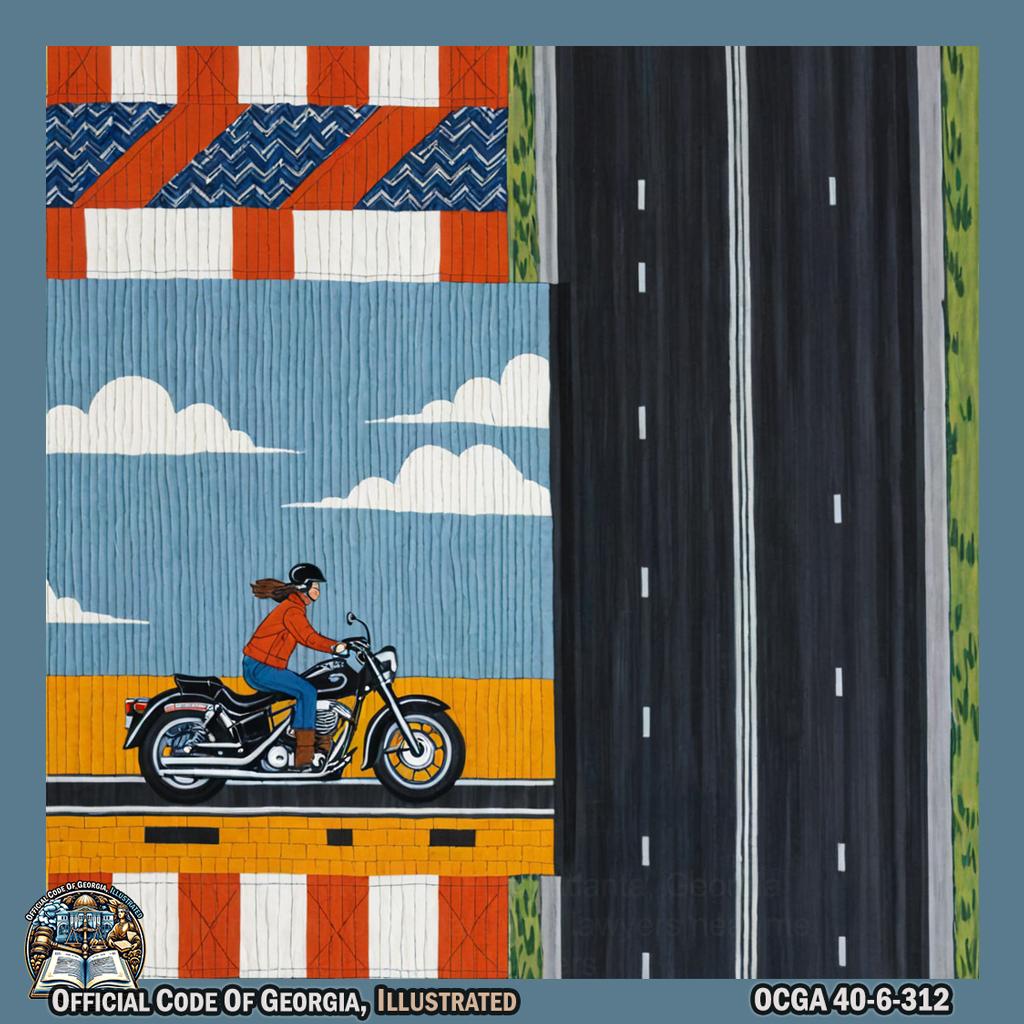
Harriet Powers skillfully weaves a quilt depicting a motorcycle overtaking and passing in a separate lane from the vehicle, highlighting the rule against passing in the same lane occupied by another vehicle. -
No person shall operate a motorcycle between lanes of traffic or between adjacent lines or rows of vehicles.
- Motorcycles shall not be operated more than two abreast in a single lane.
-
A person operating a motorcycle shall at all times keep his headlights and taillights illuminated.

Baseball coach Troy Snitker, depicted in an Ethel Schwabacher art piece, simulates revving a motorcycle's engine and gestures to activate the headlights and taillights. -@tsnit21 -
Subsections (b) and (c) of this Code section shall not apply to police officers in the performance of their official duties.
40-6-313.Clinging to other vehicles.¶
No person riding upon a motorcycle shall attach himself or the motorcycle to any other vehicle on a roadway.
40-6-314.Footrests and handlebars.¶
-
Any motorcycle carrying a passenger, other than in a sidecar or enclosed cab, shall be equipped with footrests for such passenger.
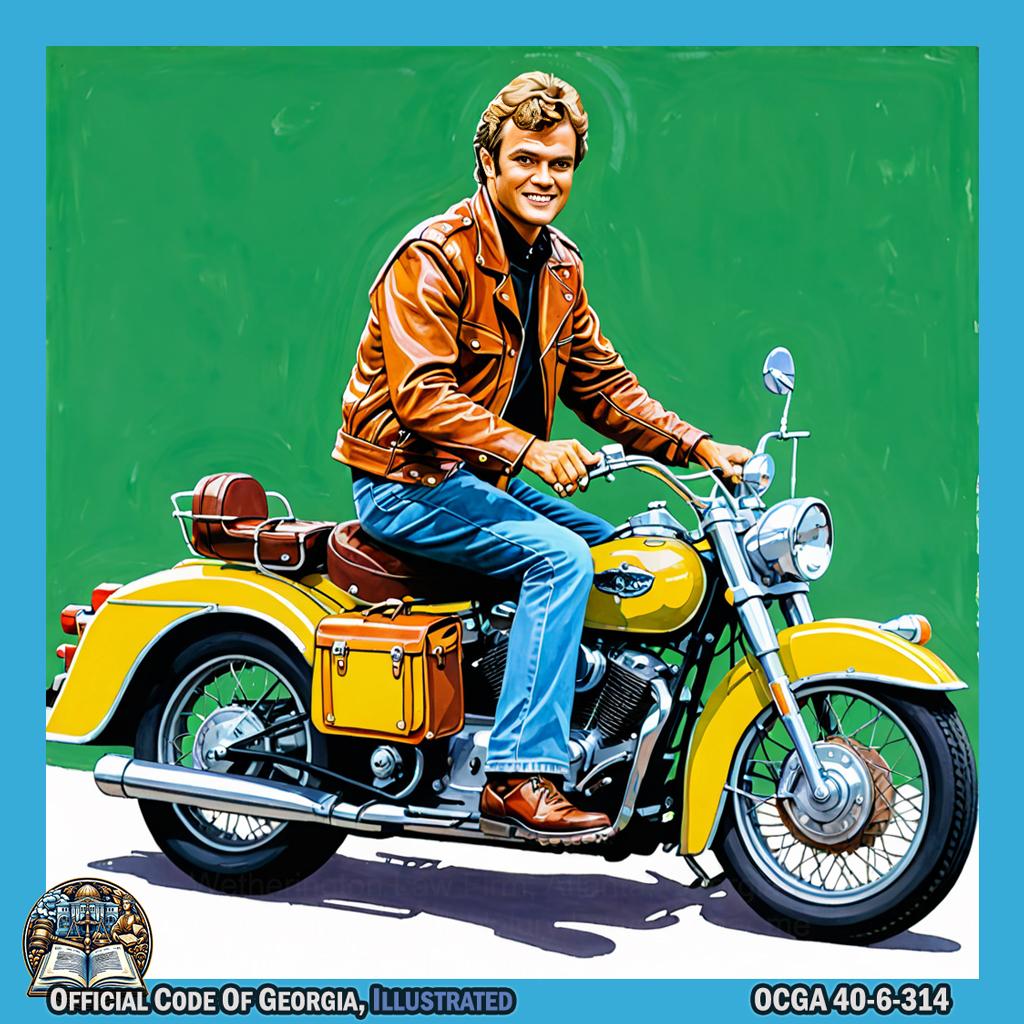
Jerry Reed stands on a motorcycle, carrying a passenger without a sidecar, demonstrating the addition of footrests for the passenger, in an art piece style reminiscent of Peter Halley at Madison Morgan Cultural Center. -
No person shall operate any motorcycle with handlebars more than 25 inches in height above that portion of the seat occupied by the operator or with a backrest more commonly known as a sissy bar that is designed in such a way as to create a sharp point at its apex.
40-6-315.Headgear and eye-protective devices for riders.¶
- No person shall operate or ride upon a motorcycle unless he or she is wearing protective headgear which complies with standards established by the commissioner of public safety.
-
No person shall operate or ride upon a motorcycle if the motorcycle is not equipped with a windshield unless he or she is wearing an eye-protective device of a type approved by the commissioner of public safety.
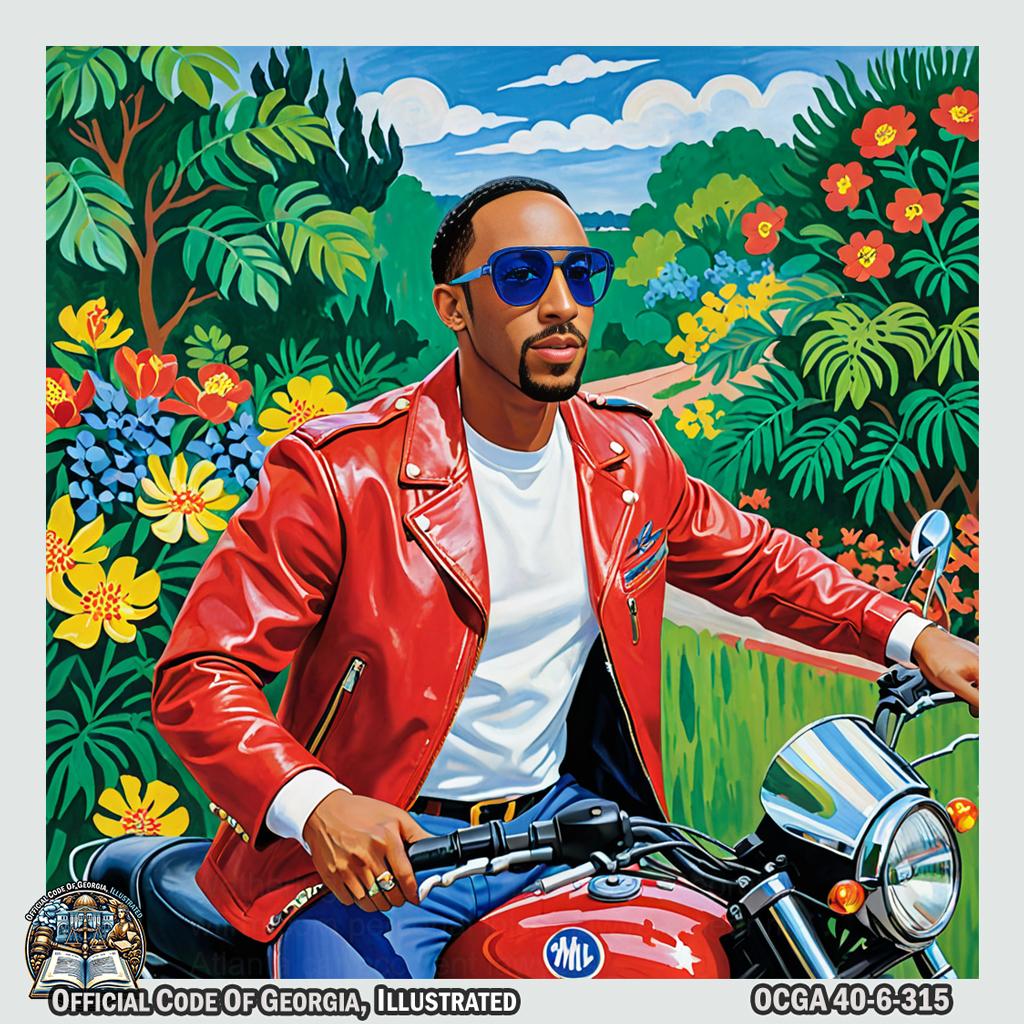
Ludacris stands on a motorcycle, wind blowing through his hair as he puts on a pair of stylish eyeprotective glasses, with the backdrop of Thomasville's lush greenery and vibrant flowers evoking the spirit of Matisse's art. -@Ludacris -
This Code section shall not apply to persons riding within an enclosed cab or motorized cart. This Code section shall not apply to a person operating a three-wheeled motorcycle used only for agricultural purposes.
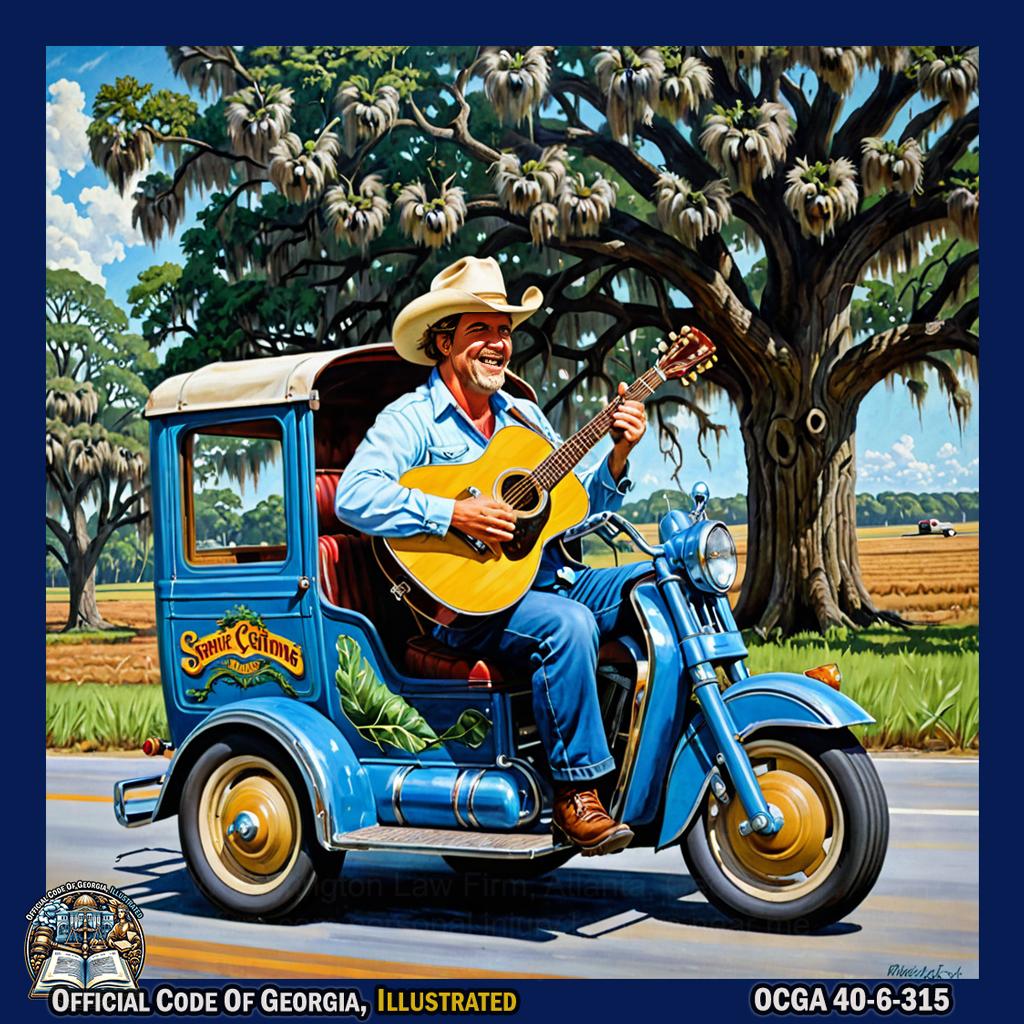
Drivin' 'N' Cryin' strums a guitar while sitting in an enclosed cab, then revs the engine of a three-wheeled motorcycle used for agricultural purposes, all against the backdrop of Saint Simons Island's enchanting oak trees adorned with carved faces. -@drivinncryin -
The commissioner of public safety is authorized to approve or disapprove protective headgear and eye-protective devices required in this Code section and to issue and enforce regulations establishing standards and specifications for the approval thereof. The commissioner shall publish in print or electronically lists of all protective headgear and eye-protective devices by name and type which have been approved.
40-6-316.Rules and regulations.¶
The commissioner of public safety is authorized to promulgate rules and regulations to carry this part into effect and to establish regulations for safety standards for the operation of motorcycles.
PART 2A Electric Personal Assistive Mobility Devices and Personal Delivery Devices {#t40c06a13p2A}
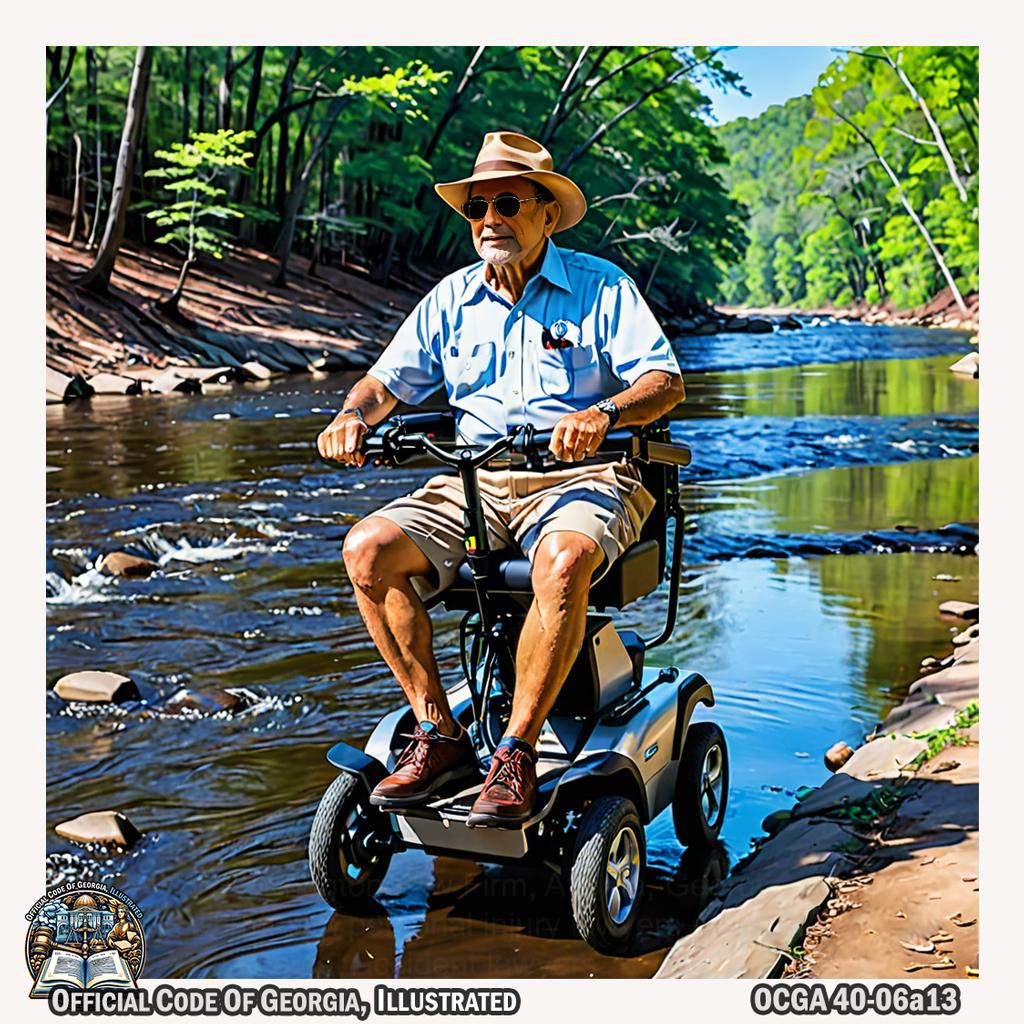
- 40-6-320. Operation on highways and sidewalks; direction of travel.
- 40-6-321. Avoiding collisions; yielding the right of way; warning of approach.
- 40-6-322. Speed of travel restricted.
- 40-6-323. Parking.
-
40-6-324. Transportation of hazardous materials; medical oxygen excluded.
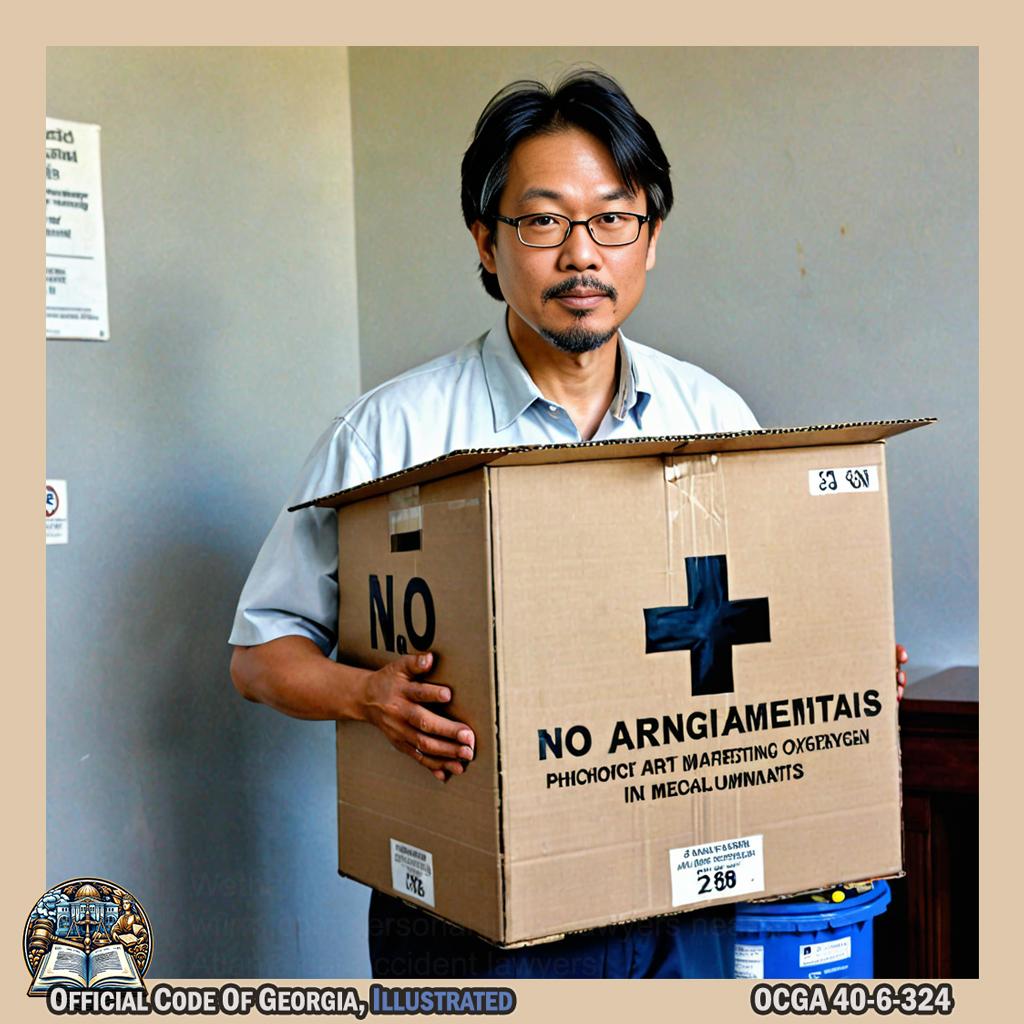
Philosopher Robert Arrington, as portrayed in an art piece by Anne Chu, delicately carries a large box labeled "hazardous materials," exaggerating cautionary movements and then displays a sign reading "no medical oxygen." -
40-6-325. Required equipment; minimum age for operation; exception to age requirement.
- 40-6-326. Operation while intoxicated.
- 40-6-327. Monitoring of personal delivery devices; general liability coverage.
- 40-6-328. Requirement in the event of an accident.
- 40-6-329. Penalty for violations; judicial jurisdiction.
- 40-6-329.1. Local ordinances or resolutions; limitations; authority; requirements.
- 40-6-329.2. Operation of personal delivery device within surface transportation project prohibited.
40-6-320.Operation on highways and sidewalks; direction of travel.¶
-
Electric personal assistive mobility devices and personal delivery devices may be operated on highways and on sidewalks where a 48 inch clear path is maintained for access for persons with disabilities, provided that any person operating such devices shall have the same rights and duties as prescribed for pedestrians in Article 5 of this chapter when operating upon a sidewalk and as prescribed for motor vehicles in this chapter when operating upon a highway except as otherwise provided in this part to the contrary. When either an electric personal assistive mobility device or personal delivery device encounters a pedestrian or individual in a wheelchair upon a sidewalk, the operator of such device shall yield the right of way to the pedestrian or individual in a wheelchair.

Gucci Mane, born in Alabama, performs "Electric Personal Assistive Mobility Devices and Personal Delivery Devices" while embodying the style of an art piece by Eugene Le Roux at Adventure Science Center. -@gucci1017 -
-
No person shall operate any electric personal assistive mobility device on the roadway of any highway unless:

Kevin Minter gracefully glides on a Segway across a cobblestone street, surrounded by lush greenery and vibrant flowers, with the sun casting dappled shadows. -@KMint_46
1. The maximum speed limit of the roadway is 35 miles per hour or less; or

Jerry Reed strums an imaginary guitar while revving up an invisible car, speeding down a make-believe road with exaggerated swagger, embodying the maximum speed limit of the roadway as a living art piece in Athens. - The roadway has a separately striped bicycle lane and the device is operated within the bicycle lane.
- Operation of a personal delivery device upon any highway shall be with due regard to safety and traffic considerations and limited to:
- Highways which are not limited-access highways with a maximum speed limit of 45 miles per hour or less; and
- The bicycle lane, bicycle path, shared use path, shoulder, or as close as practicable to the extreme right of the roadway unless crossing a roadway at a crosswalk or intersection or avoiding an object or a parked vehicle.
- The roadway has a separately striped bicycle lane and the device is operated within the bicycle lane.
-
-
When traveling on any roadway of a highway other than a crosswalk, a person operating an electric personal assistive mobility device or a personal delivery device shall travel in the same direction authorized for motor vehicle traffic on such roadway.
40-6-321.Avoiding collisions; yielding the right of way; warning of approach.¶
Any person operating an electric personal assistive mobility device or a personal delivery device on a sidewalk or roadway shall comply with the requirements of this part or any local ordinance regulating the use of such devices pursuant to Code Section 40-6-371 and shall exercise due care to avoid colliding with, and shall yield the right of way to, persons traveling on foot. A personal delivery device shall emit a sound when approaching and within six feet of a vehicle, person on foot, or individual in a wheelchair.
40-6-322.Speed of travel restricted.¶
- No person shall operate an electric personal assistive mobility device at a speed greater than seven miles per hour when traveling on any sidewalk or 15 miles per hour elsewhere; provided, however, that a county or municipal governing authority or the commissioner of transportation may further restrict the speed of such devices in locations where pedestrian traffic is congested and there is a significant speed differential between pedestrians and operators of such devices.
- Operation of a personal delivery device shall be limited to:
- A speed of no greater than 20 miles per hour when upon a bicycle lane, shoulder, or roadway;
- A speed of no greater than four miles per hour when upon a sidewalk or within a shared use path or safety zone; and
- A speed of no less than 3.5 feet per second and no more than four miles per hour when within a crosswalk.
40-6-323.Parking.¶
- An electric personal assistive mobility device or a personal delivery device may be parked on a sidewalk unless otherwise prohibited or restricted by an official traffic control device or local ordinance; provided, however, that in no case shall an electric personal assistive mobility device be parked on any sidewalk in such a manner as to prevent the movement of a wheelchair.
- An electric personal assistive mobility device or a personal delivery device shall not be parked on any roadway in such a manner as to prevent the movement of a legally parked motor vehicle.
- Except as otherwise provided in this Code section, a personal delivery device operator or any person operating an electric personal assistive mobility device shall be subject to the same parking restrictions as provided for motor vehicles under Part 1 of Article 10 of this chapter. All violations of parking restrictions shall be the responsibility of a personal delivery device owner or the owner of an electric personal assistive mobility device; and, for purposes of parking restrictions, the owner of an electric personal assistive mobility device and a personal delivery device owner shall be deemed to be in control of the device at the time of a parking violation involving such device, and no evidence of actual control by such owner need be proven as an element of the offense.
40-6-324.Transportation of hazardous materials; medical oxygen excluded.¶
No person shall carry or transport any hazardous materials on an electric personal assistive mobility device or a personal delivery device. Oxygen carried for personal medical reasons shall not be deemed a hazardous material for purposes of this Code section.
40-6-325.Required equipment; minimum age for operation; exception to age requirement.¶
-
-
Any electric personal assistive mobility device, when operated on any highway or sidewalk, shall be equipped with:
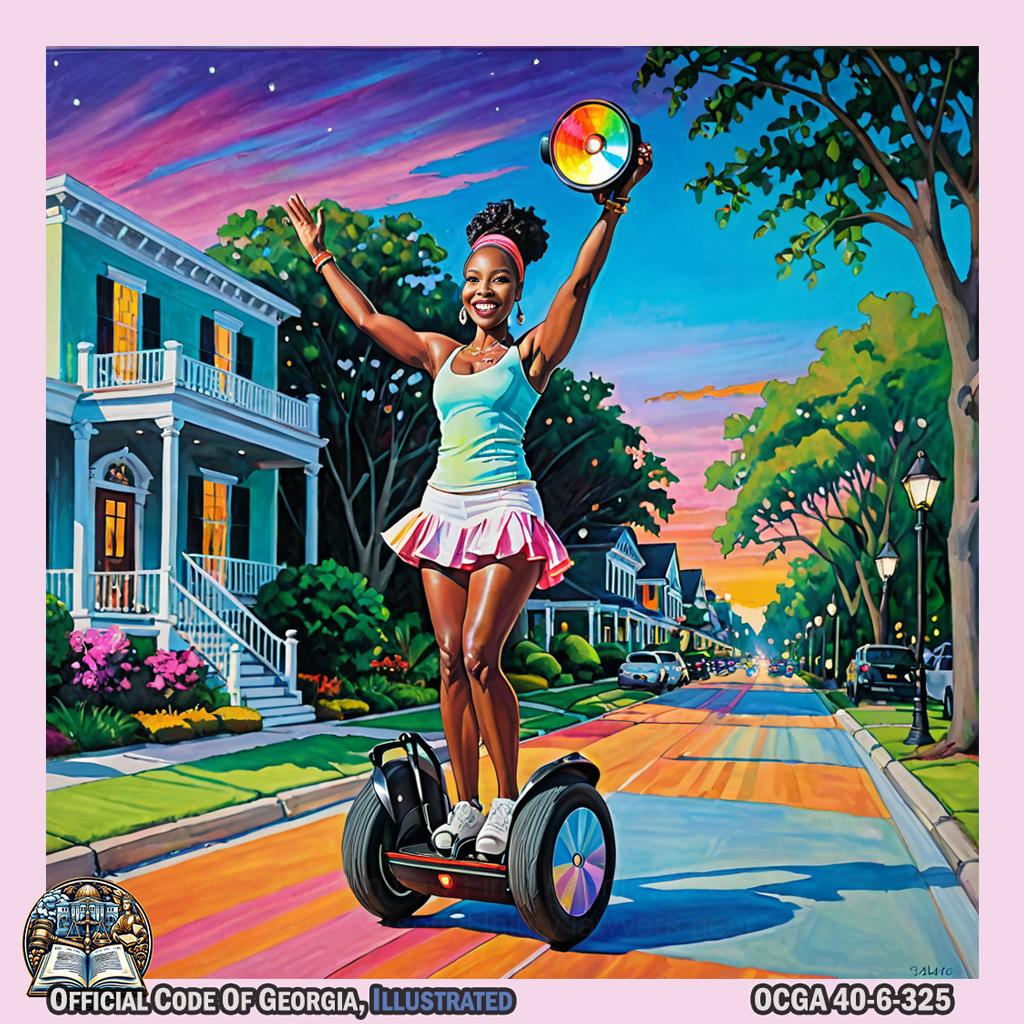
India.Arie theatrically attaches large, colorful reflectors and lights to a Segway, dramatically gesturing towards its features while gliding gracefully down a vibrant Englewood Manor street lined with lush trees and historic homes, as neighbors watch from their porches in the warm glow of sunset. -@indiaarie
1. Front, rear, and side reflectors which shall be visible from a distance of 300 feet when directly in front of lawful upper beams of headlights on a motor vehicle; 2. A system that when employed will enable the operator to bring the device to a controlled stop; and 3. A lamp emitting a white light which, while the device is in motion, illuminates the area in front of the operator for a distance of 300 feet, if the device is operated between one-half hour after sunset and one-half hour before sunrise.

Football player Randy McMichael, portrayed by David Hare, holds a lamp and moves it around while shining light in front of him, pretending to walk through the darkness. -
Any personal delivery device, when operated on any highway or sidewalk, shall be equipped with:
-
A braking system that enables the device to come to a controlled stop;

Singer Cyndi Thomson, depicted as an art piece by Bruce Nauman, portrays a superhero flying and abruptly halting in mid-air with an exaggerated pose. -
Lights upon the front and rear of the device that are visible under normal atmospheric conditions from at least 500 feet on all sides of the device, if the device is operated between one-half hour after sunset and one-half hour before sunrise; and
- A prominently displayed unique identification number and a contact phone number for the personal delivery device owner which shall be answered by an individual located within this state at any time when the device is in operation; provided, however, that nothing in this subparagraph shall subject a personal delivery device to motor vehicle registration requirements of Chapter 2 of this title or any local ordinance or regulation requiring registration of such devices.
-
-
-
No person under the age of 16 years shall operate an electric assistive personal mobility device on any highway; provided, however, that a person under the age of 16 years may operate an electric assistive personal mobility device on any sidewalk if such person is wearing protective headgear which meets or exceeds the impact standards for bicycle helmets required by Code Section 40-6-296.
40-6-326.Operation while intoxicated.¶
Any person who is under the influence of any intoxicating liquor or any drug to a degree which renders him or her a hazard shall not operate any electric personal assistive mobility device on any highway or sidewalk. Violation of this Code section shall be a misdemeanor, punishable upon conviction by a fine not to exceed $500.00.
40-6-327.Monitoring of personal delivery devices; general liability coverage.¶
-
A personal delivery device shall be monitored by an individual who is capable of exercising control over the navigation and operation of the personal delivery device at any point in time such device is operating upon highways or sidewalks.

Actress Diana Scarwid, embodying a character in Fred Mitchell's art piece, gracefully mimics the movements of a personal delivery device operator, using her arms to navigate and control the imaginary device as she glides through an imaginary highway or sidewalk. -
A personal delivery device owner shall maintain general liability coverage for any personal delivery device operated upon a highway or sidewalk of this state of at least $250,000.00 for damages arising from the operation of the personal delivery device.
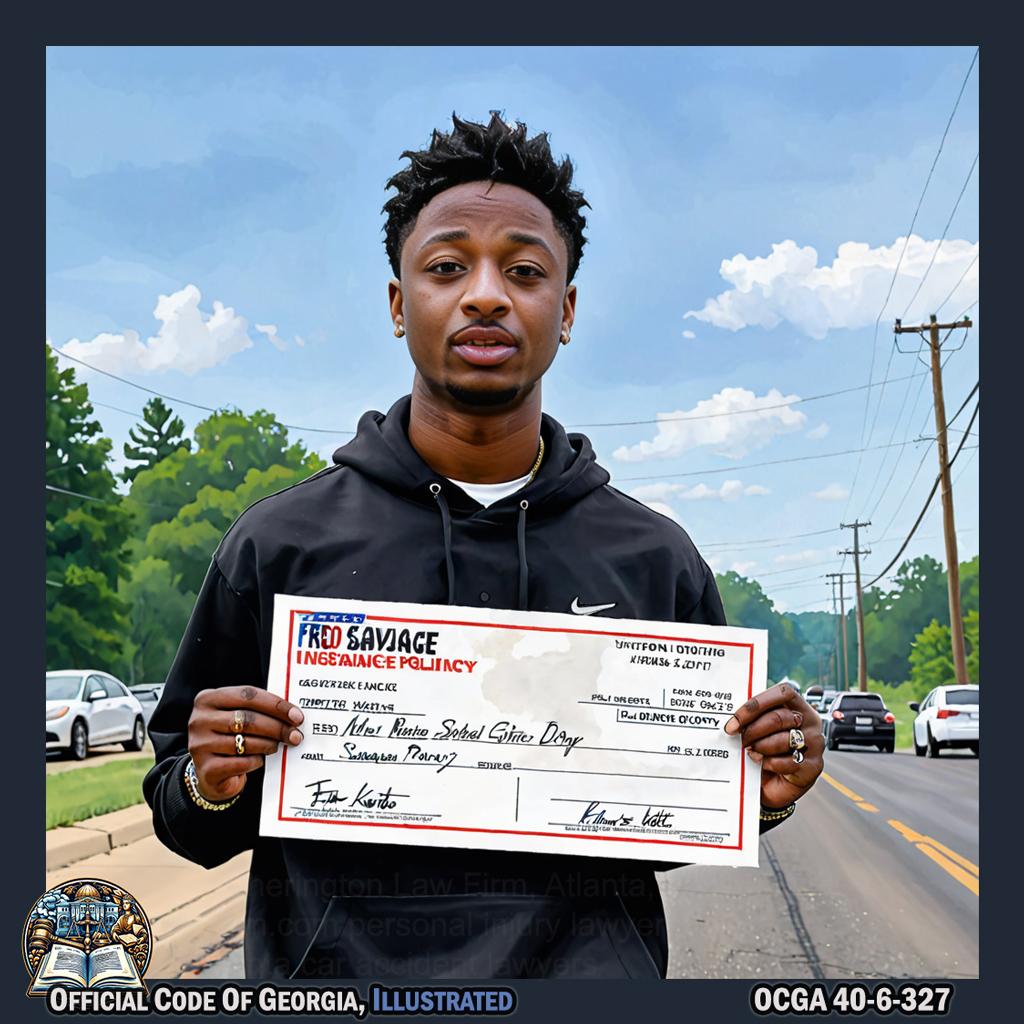
21 Savage, depicted in a Fred Kabotie art piece, pretends to hold and steer a small imaginary vehicle, making exaggerated driving motions while "holding" an oversized insurance policy document. -@21savage
40-6-328.Requirement in the event of an accident.¶
When an accident involves a personal delivery device, the requirements of Code Sections 40-6-270, 40-6-271, 40-6-272, 40-6-273, and 40-6-273.1 shall be satisfied if such personal delivery device remains on the scene of such accident as required by law and the personal delivery device operator promptly contacts a local law enforcement agency and communicates the information required by this chapter.
40-6-329.Penalty for violations; judicial jurisdiction.¶
- Any person who violates any provision of this part relating to an electric personal assistive mobility device other than Code Section 40-6-326 shall not be guilty of a criminal offense or a moving traffic violation for purposes of Code Section 40-5-57 but shall be subject to a civil monetary penalty not to exceed $500.00.
- Any violation of this part by a personal delivery device shall not be a criminal offense or a moving traffic violation for purposes of Code Section 40-5-57 but shall be subject to a civil monetary penalty not to exceed $500.00. Any citation for a violation of this part or any other laws or ordinances relating to the operation of a personal delivery device shall be issued to the personal delivery device owner by use of the information displayed on the unique identification marker on the device.
- Any court having jurisdiction over violations relating to the operation of a motor vehicle shall have jurisdiction over cases arising under this part and shall be authorized to impose the civil monetary penalty provided by this Code section. Except as otherwise provided in this Code section, the provisions of law governing jurisdiction, procedure, defenses, adjudication, appeal, and payment and distribution of penalties otherwise applicable to violations relating to the operation of a motor vehicle shall apply to enforcement under this Code section; provided, however, that any appeal from a superior or state court shall be by application in the same manner as that provided by Code Section 5-6-35.
40-6-329.1.Local ordinances or resolutions; limitations; authority; requirements.¶
-
Except as otherwise provided for in this article and subsections (b) and (c) of this Code section, local authorities shall not enact or enforce an ordinance or resolution relating to:
-
Design, manufacture, or maintenance of a personal delivery device;
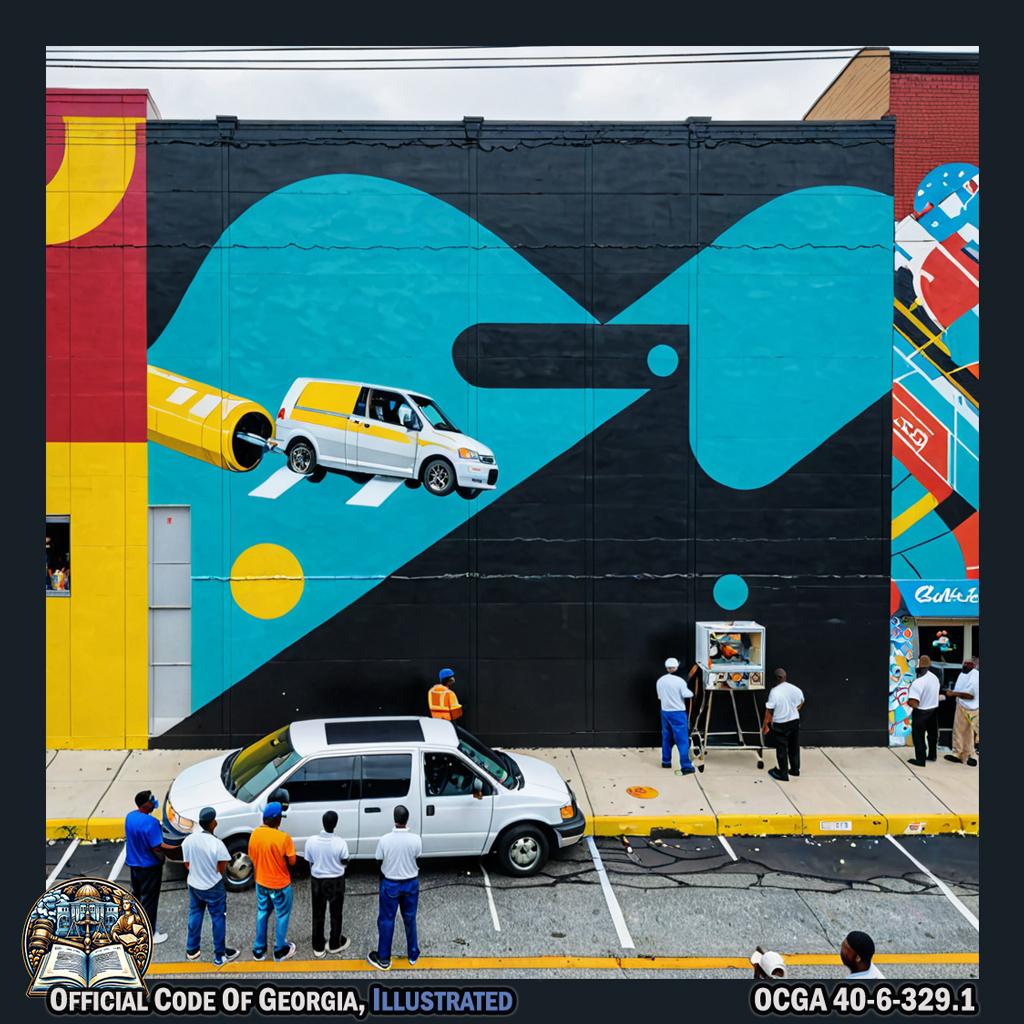
Paul Oliver meticulously assembling a futuristic personal delivery device in front of a vibrant mural in East Atlanta, surrounded by a diverse group of onlookers, all captured from an elevated perspective reminiscent of Andreas Gursky's iconic style. -
Licensing, registration, or certification of a personal delivery device;
- Any additional taxation upon a personal delivery device other than any property tax charges, business license fees, or occupation tax surcharges otherwise authorized by law;
- Insuring a personal delivery device beyond the requirements set forth in Code Section 40-6-327;
- Types of cargo that may be transported by a personal delivery device;
-
Operations of personal delivery devices; or

In a rich scene based in Doulas, Chloe Bailey dramatically manipulates large industrial delivery devices while surrounded by towering sculptures resembling Anselm Kiefer's style. -@ChloeBailey -
Use of or restricted access to any sidewalk, crosswalk, or public highway.
-
-
For the purpose of assuring the safety of individuals using highways, sidewalks, bicycle lanes, bicycle paths, and shared use paths a local authority shall be authorized to enact ordinances prohibiting hours of operation of personal delivery devices upon sidewalks, bicycle lanes, bicycle paths, and shared use paths under their jurisdiction, provided that restrictions do not prohibit the operation of personal delivery devices between sunrise and sunset. A local authority shall be further authorized to enact ordinances prohibiting the operation of personal delivery devices upon the property of schools, hospitals, and sidewalks immediately adjacent to stadiums, coliseums, or buildings owned, operated or leased by the federal government, the State of Georgia or its agencies or authorities, or any political subdivision of the state, provided that such property or sidewalk is owned or maintained by the local authority.
- Any local authority shall be authorized to enact an ordinance or resolution which designates a geographically limited area within the jurisdiction of such authority and which regulates the operation of personal delivery devices upon highways, sidewalks, bicycle lanes, bicycle paths, and shared use paths within such geographically limited area, provided that such regulations are no more restrictive than those imposed by this part and the geographically limited area is no greater than seven linear miles.
- A local authority shall provide for public hearing prior to passage of any ordinance pursuant to subsection (b) or (c) of this Code section.
- For purposes of this Code section, a highway shall be considered under the jurisdiction of a local authority when it is part of the county or municipal road system of such local authority designated pursuant to Chapter 4 of Title 32.
40-6-329.2.Operation of personal delivery device within surface transportation project prohibited.¶
No personal delivery device shall be operated within a surface transportation project as such term is defined in Code Section 36-61-2.
PART 3 Personal Transportation Vehicles¶
- 40-6-330. Standards for operating personal transportation vehicles.
- 40-6-330.1. Required equipment for personal transportation vehicles; grandfather clause.
- 40-6-331. Designated areas of operation; PTV licensing requirements and operating standards; signage; use by a commercial delivery company.
40-6-330.Standards for operating personal transportation vehicles.¶
Any local authority desiring to establish operating standards for personal transportation vehicles shall comply with Part 6 of this article.
40-6-330.1.Required equipment for personal transportation vehicles; grandfather clause.¶
-
All personal transportation vehicles shall be equipped with:
- A braking system sufficient for the weight and passenger capacity of the vehicle, including a parking brake;
- A reverse warning device functional at all times when the directional control is in the reverse position;
- A main power switch. When the switch is in the “off” position, or the key or other device that activates the switch is removed, the motive power circuit shall be inoperative. If the switch uses a key, it shall be removable only in the “off” position;
- Head lamps;
-
Reflex reflectors;

Dr. Martin Luther King Jr., surrounded by vibrant flora and fauna, delicately places reflex reflectors on the forest floor, portraying a harmonious blend of environmental awareness and social justice in the style of Maria Sibylla Merian's art. -
Tail lamps;
- A horn;
- A rearview mirror;
- Safety warning labels; and
- Hip restraints and hand holds or a combination thereof.
-
The requirements of subsection (a) of this Code section shall not apply to any personal transportation vehicles operated during daylight hours authorized by local ordinances enacted prior to January 1, 2012.
40-6-331.Designated areas of operation; PTV licensing requirements and operating standards; signage; use by a commercial delivery company.¶
-
A local authority may, by ordinance, designate certain public streets or portions thereof or PTV paths that are under its regulation and control for the combined use of PTVs and regular vehicular traffic or the use of PTVs and no other types of motor vehicles and establish the conditions under which PTVs may be operated upon such streets or portions thereof or PTV paths, including without limitation the conditions under which a person may operate PTVs on such designated streets or portions thereof or PTV paths. All operators of PTVs shall be required to possess a valid driver’s license except when operating a PTV within a locality whose local authority has enacted an ordinance permitting the use of PTVs or motorized carts on streets without possession of a driver’s license prior to January 1, 2012.

Basketball player Andrew Goudelock embodies the scene of David Wojnarowicz's art piece, pretending to drive a car and then seamlessly transitioning to riding a scooter while holding an imaginary driver's license. -@0goudelock -
Local authority ordinances may establish operating standards but shall not require PTVs to meet any requirements of general law as to registration, inspection, certificate of title, or licensing; provided, however, that a local authority may, by ordinance, require the local registration and licensing of PTVs operated within its boundaries at least once every five years for a fee not to exceed $15.00. No local authority shall be liable for losses that result from exercising or not exercising inspection powers or functions, including failure to make an inspection or making an inadequate or negligent inspection of a PTV. The provisions of this subsection and the authority granted by this subsection shall not apply to PTVs owned by golf courses, country clubs, or other such organized entities which own such PTVs and make them available to or for use by members or the public on a rental or licensed basis, provided that such PTVs are used only on the premises of such golf courses, country clubs, or other such organized entities.
-
Each local authority permitting the use of PTVs upon the public streets within its jurisdiction shall erect signs on every highway which comprises a part of the state highway system at that point on the highway which intersects the corporate limits of the municipality or boundaries of the county. Such signs shall be at least 24 by 30 inches in area and shall warn approaching motorists that PTVs are authorized for use on public streets. All costs associated with such signs shall be funded entirely by the local authority. Ordinances establishing operating standards for PTVs shall not be effective unless appropriate signs giving notice are posted as required by this subsection.

A person could stand on a platform and raise their arm, holding a large sign with intricate designs and symbols while wearing a colorful flowing robe, surrounded by ornate frames and decorative elements in the style of Alphonse Mucha's art. -@duntarobinson23 -
- In jurisdictions where PTVs are permitted or otherwise allowed by state law, PTVs may cross streets and highways that are part of the state highway system only at crossings or intersections designated for that purpose and which are constructed as an active grade crossing in accordance with the Manual on Uniform Traffic Control Devices. PTV crossings shall be indicated by warning sign W11-11 of the Standard Highway Signs and be clearly visible in both directions by vehicles traversing the highway which is being crossed or intersected by PTVs.
- PTVs may cross streets and highways that are part of a municipal street system or county road system and used by other types of motor vehicles only at crossings or intersections designated for that purpose by the local authority having jurisdiction over such system.
-
- Regardless of whether a local ordinance has been approved regarding the use of PTVs, delivery personnel for a commercial delivery company which has at least 10,000 persons employed in this state may operate PTVs within a residential subdivision with speed limits of 25 miles per hour or less, provided that any PTV utilized by a commercial delivery company shall: 1. Include the equipment required in subsection (a) of Code Section 40-6-330.1; 2. Be marked in a conspicuous manner with the name of the commercial delivery company; 3. Be operated by a person with a valid driver’s license; and 4. Be utilized only for the delivery of envelopes and packages with a maximum size of 130 inches for the combined length and girth and with a weight no greater than 150 pounds per package.
- Any commercial delivery company utilizing PTVs under this subsection shall remit a $50.00 fee every five years to each local authority where a PTV is operated along with a signed statement that such commercial delivery company operates PTVs within the jurisdiction of such local authority.
- Notwithstanding any other provision of law to the contrary, any person operating a PTV under this subsection shall be granted all the rights and shall be subject to all the duties applicable to a driver of any other vehicle under this chapter; provided, however that subsection (b) of Code Section 40-6-315 shall not be applicable to the operator of a PTV under this subsection.
- Any PTV authorized to operate pursuant to this subsection shall not pull multiple trailers. Such PTVs shall be limited to pulling one trailer or cargo platform and be limited to hauling weight no greater than the carrying capacity of the PTV as determined by the manufacturer.

2 Chainz gracefully and dramatically gestures with his arms, indicating the restriction of pulling only one trailer or cargo platform while embodying the essence of Susanne Crane's art style in a vibrant and dynamic performance set in Paces neighborhood, Atlanta. -@2chainz
PART 4 Mopeds¶
-
40-6-350. Traffic laws applicable to persons operating mopeds.
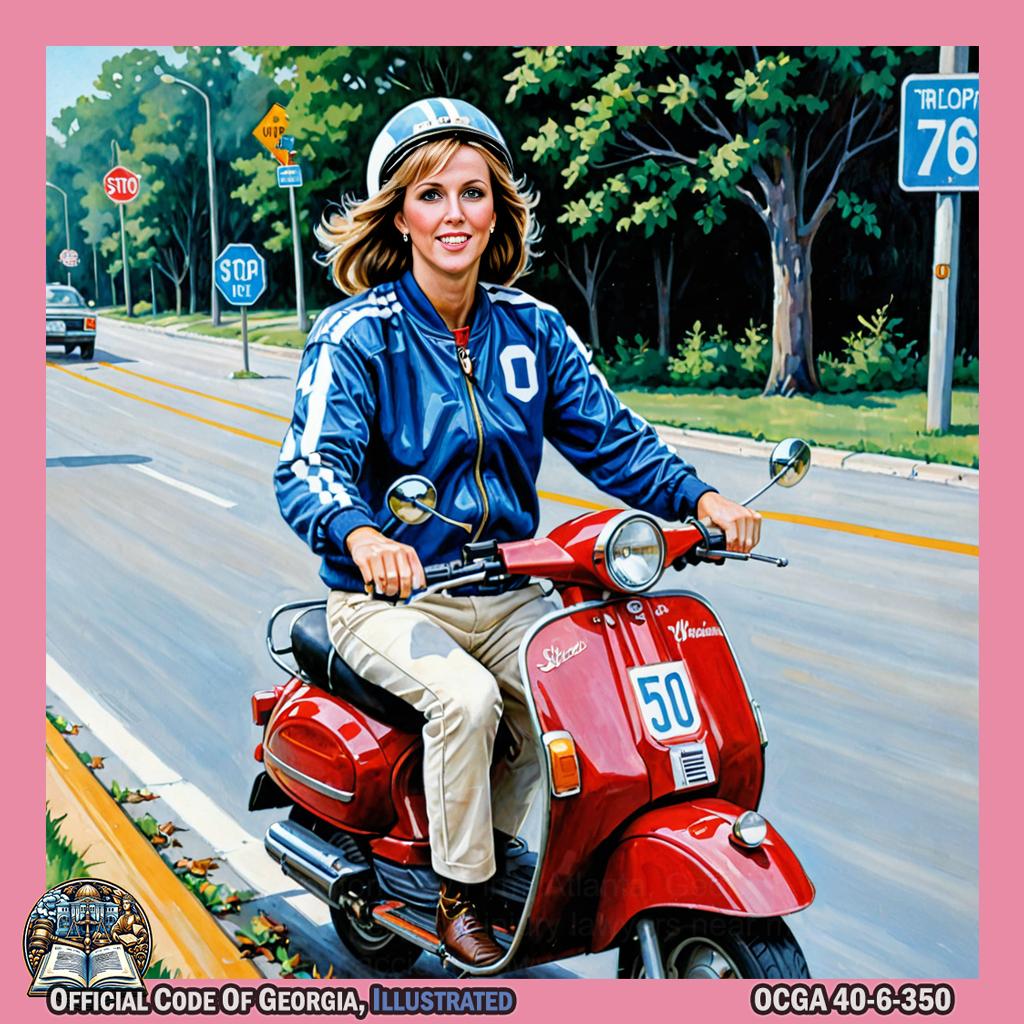
Fran Tarkenton, the football player born in Virginia, is depicted by Amanda Matthews as pretending to ride a moped while following traffic laws, such as stopping at a stop sign and using turn signals. -
40-6-351. Driver’s license or permit required for certain operators.
-
40-6-352. Protective headgear.

Francis S. Bartow, a lawyer and politician, strutted through the rich scene in Powder Springs, Georgia wearing an oversized helmet adorned with exaggerated features such as giant spikes or bright colors. - 40-6-354. Rules and regulations.
40-6-350.Traffic laws applicable to persons operating mopeds.¶
Every person operating a moped shall be granted all the rights and shall be subject to all the duties applicable to the driver of any other vehicle under this chapter except as to special regulations in this part and except as to those provisions of this chapter which by their nature can have no application. However, the operator of a moped shall not be required to comply with subsection (e) of Code Section 40-6-312, relating to

headlights and taillights, or subsection (b) of Code Section 40-6-315, relating to windshields and eye-protective devices.
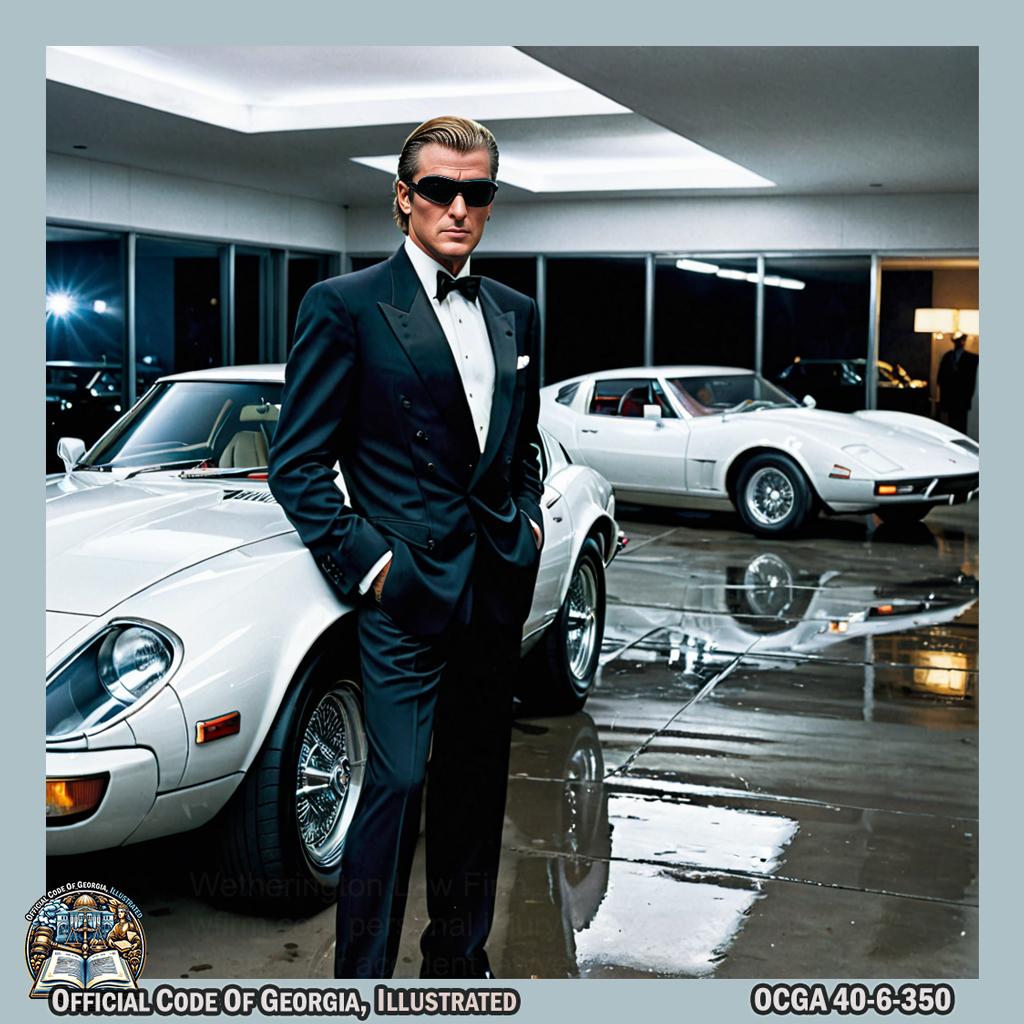
40-6-351.Driver’s license or permit required for certain operators.¶
No person under 15 years of age shall operate a moped upon the highways in this state. No person shall operate a moped upon the highways in this state unless he or she has in his or her possession a valid driver’s license, instruction permit, or limited permit issued to him or her pursuant to Chapter 5 of this title; provided, however, that all classes of licenses, instruction permits, or limited permits issued pursuant to Chapter 5 of this title shall be valid for the purposes of operating mopeds upon the highways in this state.
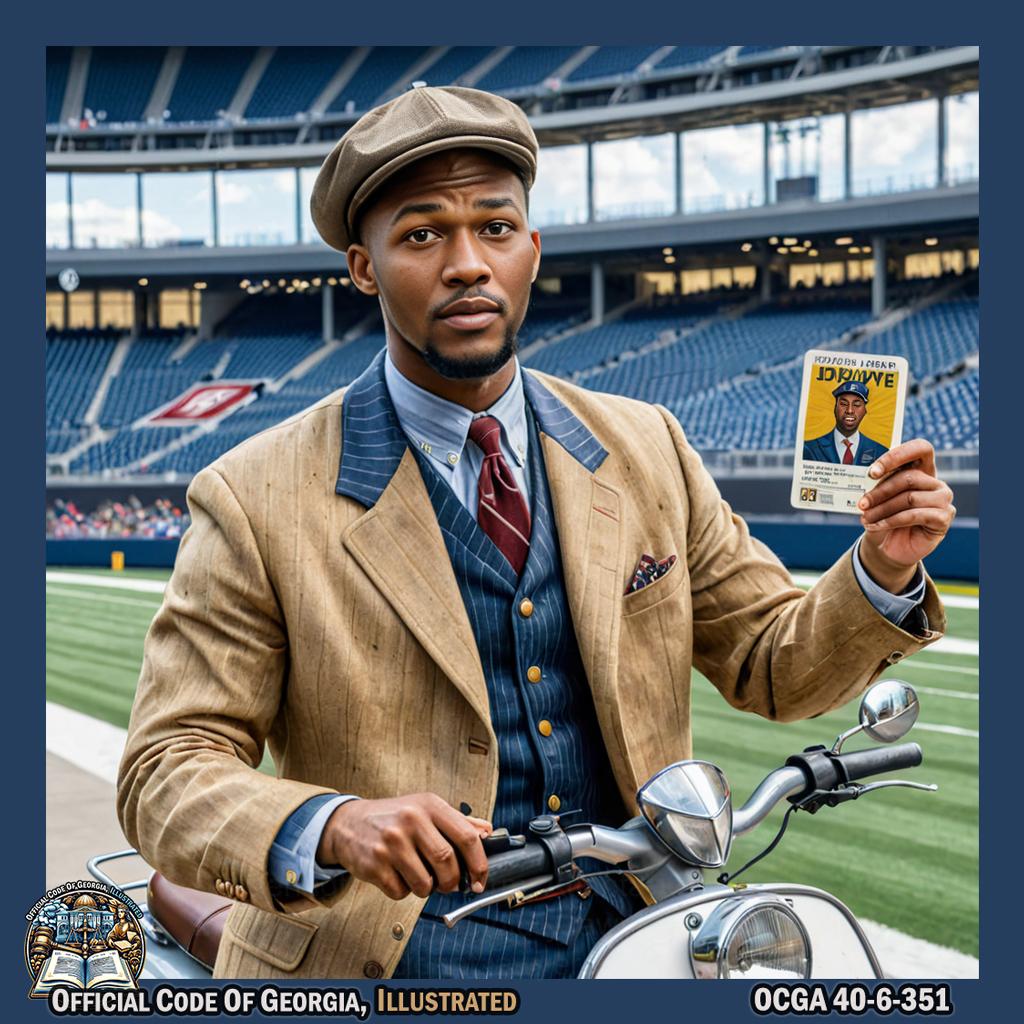
40-6-352.Protective headgear.¶
- No person shall operate or ride as a passenger upon a moped unless he or she is wearing protective headgear which complies with standards established by the commissioner of public safety. The commissioner in determining such standards shall consider the size, speed, and operational characteristics of the moped. Such standards need not necessarily be the same as for motorcyclists; however, any moped operator wearing an approved motorcycle helmet shall be deemed in compliance with this subsection.
- The commissioner of public safety is authorized to approve or disapprove protective headgear for moped operators and to issue and enforce regulations establishing standards and specifications for the approval thereof. He or she shall publish in print or electronically lists by name and type of all protective headgear which have been approved by him or her.
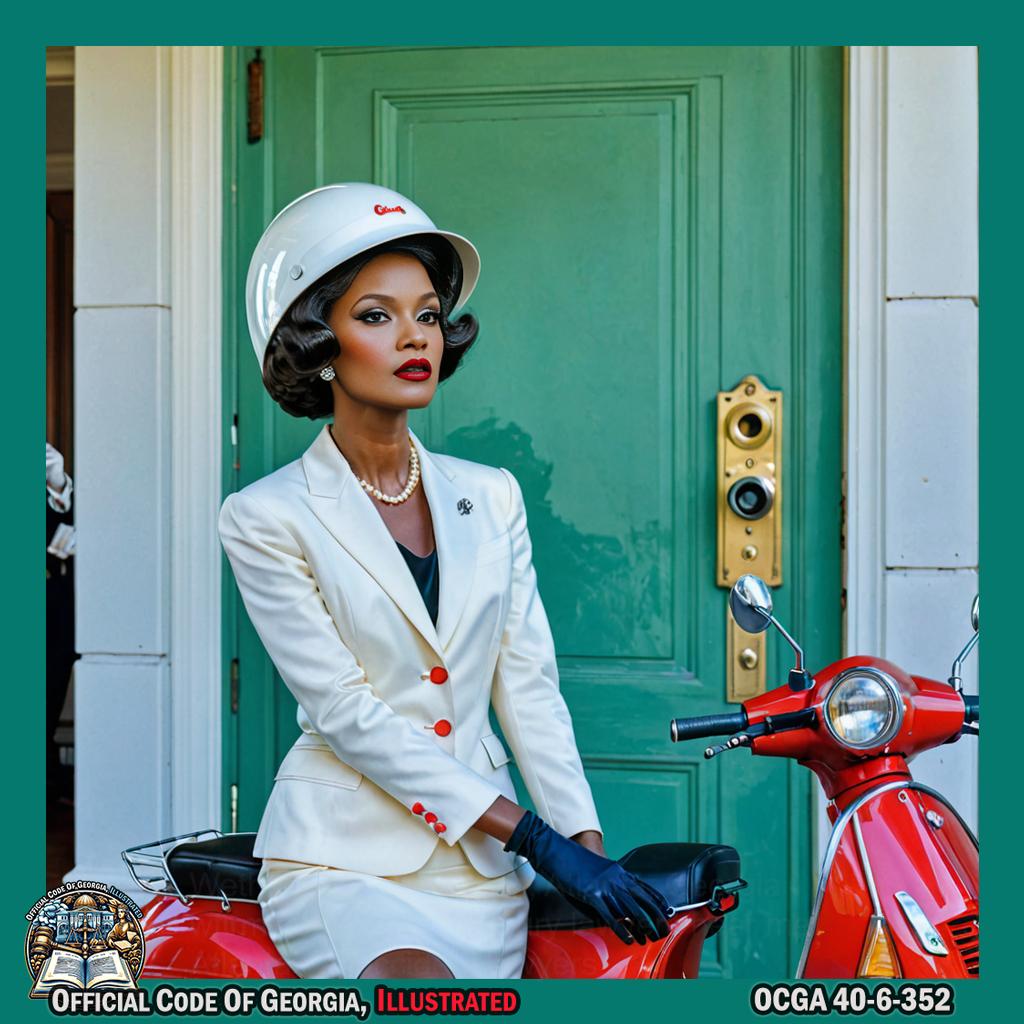
Helen Dortch Longstreet, wearing a glamorous and stylish outfit, theatrically inspects and dramatically approves or disapproves various moped helmets with grand gestures and expressions in the opulent surroundings of Margaret Mitchell House, as if she were a character from a Guy Bourdin art piece.
40-6-353.Operation over certain roads may be prohibited.¶
The commissioner of transportation or local governing authorities having jurisdiction over public roads and highways may prohibit the operation of mopeds on public roads and highways within their jurisdiction if it is determined that such operation endangers the safety of the traveling public.
40-6-354.Rules and regulations.¶
The commissioner of public safety is authorized to promulgate rules and regulations to carry this part into effect and is authorized to establish regulations for safety equipment or standards for the operation of mopeds.
PART 5 Low-speed Vehicles¶
-
40-6-360. Rights of persons operating low-speed vehicles.

Kanye West gracefully maneuvers a low-speed vehicle, waving and smiling at imaginary pedestrians in an art piece reminiscent of Motoi Yamamoto's work. -@kanyewest - 40-6-362. Operating low-speed vehicles on highways.
40-6-360.Rights of persons operating low-speed vehicles.¶
Every person operating a low-speed vehicle shall be granted all the rights and shall be subject to all the duties applicable to the driver of any other vehicle under this chapter except as to special regulations in this part and except as to those provisions of this chapter which by their nature can have no application.
40-6-361.Traffic laws applicable to low-speed vehicles.¶
-
All low-speed vehicles are entitled to full use of a lane, and no motor vehicle shall be driven in such a manner as to deprive any low-speed vehicle of the full use of a lane.

Ray Charles, seated at a piano on a vibrant Music Midtown stage with abstract color blocks reminiscent of Kendall Shaw's style, extends his arms in an encompassing gesture to the audience, symbolizing inclusion and sharing space, while a procession of bicycles and golf carts painted in bold primary colors gently weave through the lanes created by the crowd. -
The operator of a low-speed vehicle shall not overtake and pass in the same lane occupied by the vehicle being overtaken.
- No person shall operate a low-speed vehicle between lanes of traffic or between adjacent lines or rows of vehicles.
- Low-speed vehicles shall not be operated two or more abreast in a single lane.
40-6-362.Operating low-speed vehicles on highways.¶
Low-speed vehicles shall be operated only on any highway where the posted speed limit does not exceed 35 miles per hour. The operator of a low-speed vehicle shall not operate such vehicle on any highway where the posted speed limit exceeds 35 miles per hour.
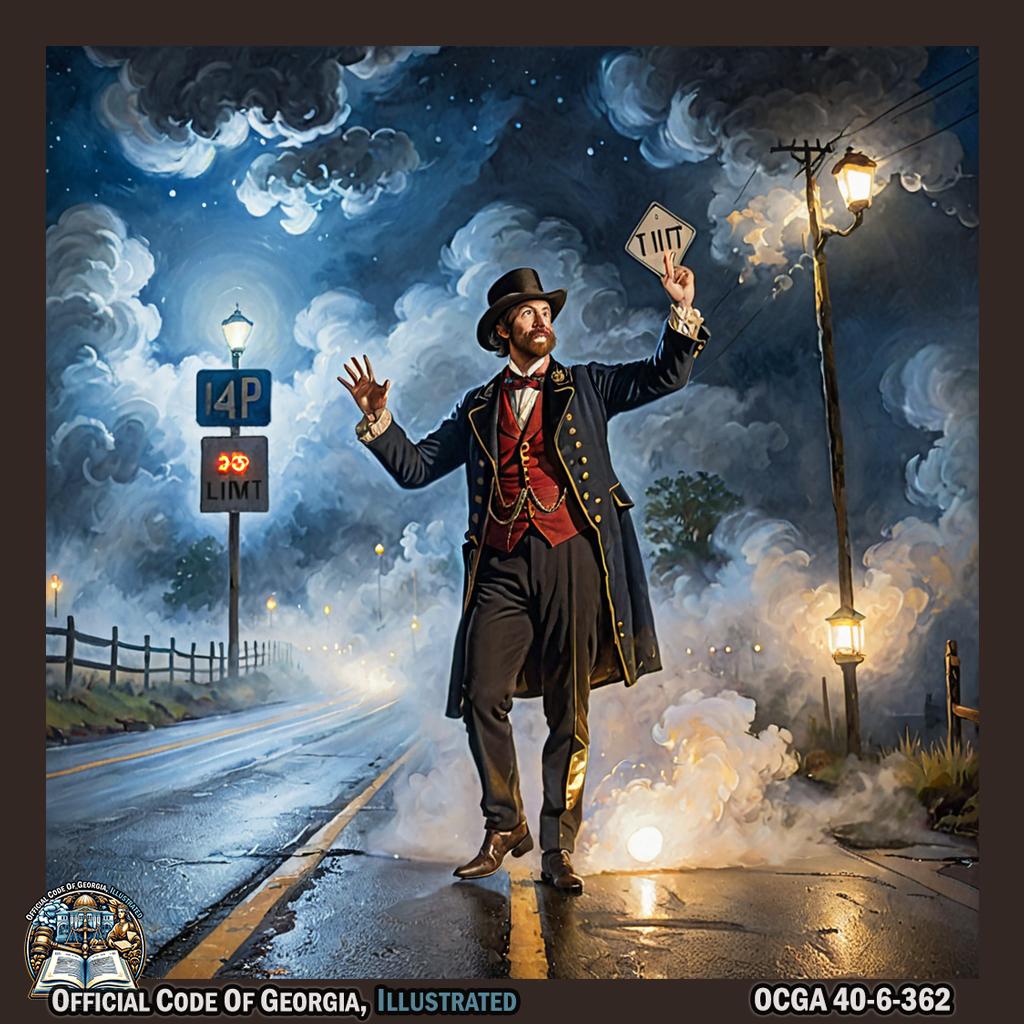
PART 6 Personal Transportation Vehicle Transportation Plan {#t40c06a13p06}
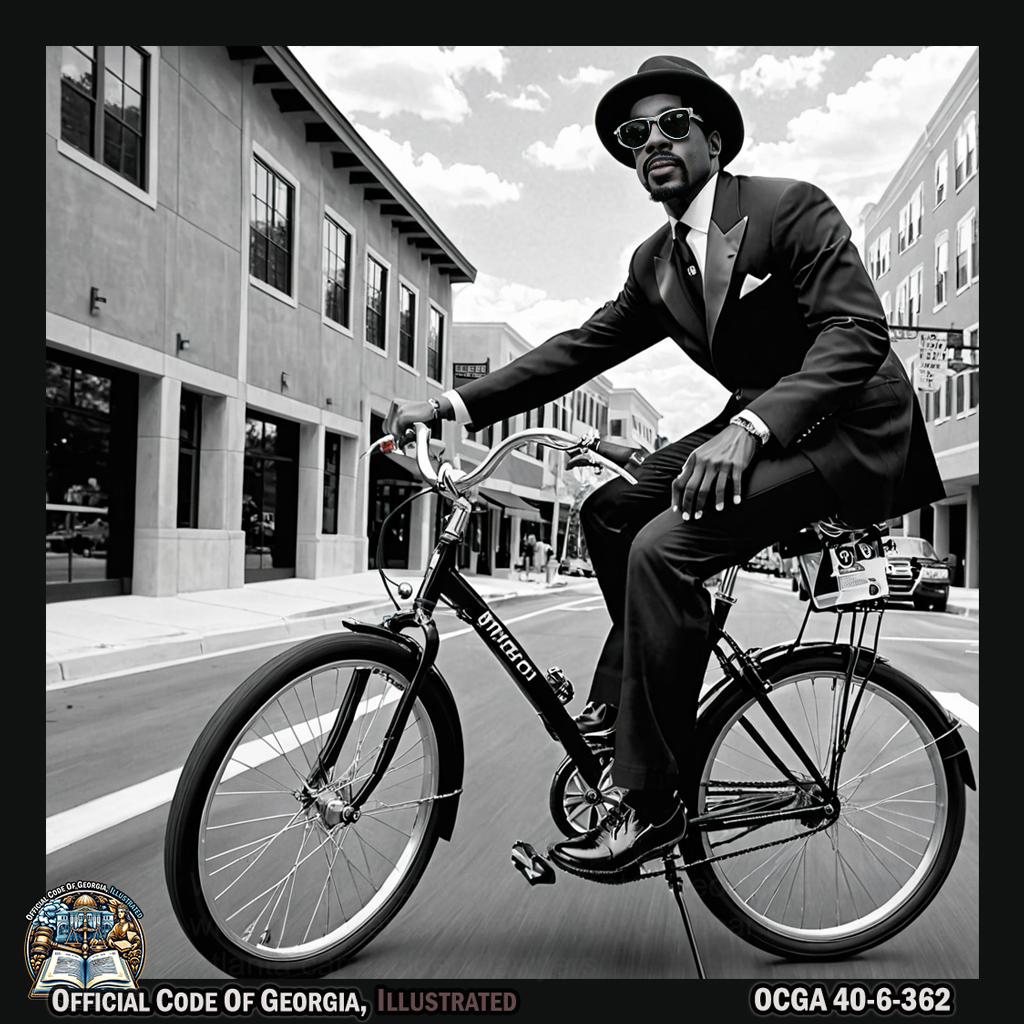
-
40-6-363. Legislative intent.

Baseball player and coach Rick Honeycutt, born in Tennessee, performs grand hand gestures and exaggerated facial expressions while pretending to be a legislator writing and debating a new law in the rich scene of Fayetteville, Georgia. -
40-6-364. Definitions.

Activist Dr. Martin Luther King Jr. opens an imaginary large book in a rich scene in the Georgia location, Monroe, points to a word, scratches his head in confusion before having a lightbulb moment and excitedly jumps up with a finger raised as if he's just understood the definition. - 40-6-366. Acquisition of property for PTV lanes.
- 40-6-367. Part inapplicable to certain localities with prior ordinances governing PTV use.
-
40-6-368. Requirements for streets or highways on which joint use by regular vehicle traffic and PTVs permitted.
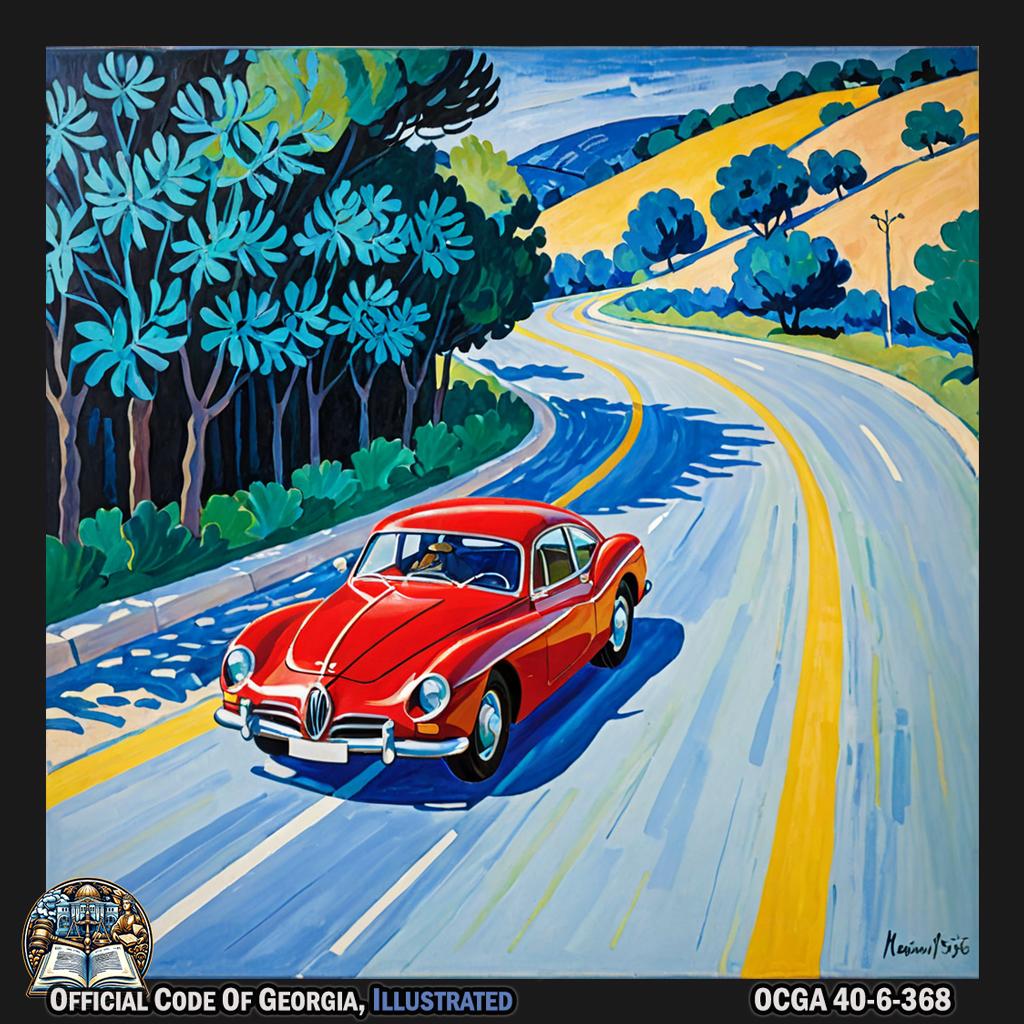
DeAngelo Tyson gracefully mimics the movement of cars and PTVs sharing the road, as if captured in a vibrant Matisse painting. -@Tyson_94 - 40-6-369.1. Speed limits on streets authorized for PTV use.
40-6-363.Legislative intent.¶
The purpose of this part shall be to authorize any local authority to establish a personal transportation vehicle transportation plan for roadways and streets within the local authority’s jurisdiction. It is the intent of the General Assembly that these plans be designed and developed to best serve the functional travel needs of the jurisdiction and to have the physical safety of the personal transportation vehicle occupants and their property as a major planning component. No local authority shall be liable for losses resulting from exercising or not exercising its authority to adopt a personal transportation vehicle transportation plan, failing to adopt such plan, making an inadequate plan, or negligently adopting such plan.
40-6-364.Definitions.¶
As used in this part, the term:

-
“Personal transportation vehicle lane” or “PTV lane” means a portion of the roadway that has been designated by striping, pavement markings, or signage for the exclusive or preferential use of persons operating personal transportation vehicles. Such PTV lanes shall at a minimum meet accepted guidelines, recommendations, and criteria with respect to planning, design, operation, and maintenance as set forth in the American Association of State Highway and Transportation Officials Safety Manual.

Sonny Terry joyfully glides down the designated PTV lane, gracefully weaving through traffic with his personal transportation vehicle, while creating a dynamic and visually compelling art piece in the style of Anthony Lister. -
“Personal transportation vehicle transportation plan” or “PTV plan” means a detailed guide for the operation of personal transportation vehicles upon local streets and road segments passed by a local authority through ordinance or resolution.
- “Plan area” means the territory designated by a local authority in a personal transportation vehicle transportation plan that provides for use of personal transportation vehicles and may include privately owned land upon the consent of the landowner.
40-6-365.Standards for local authorities to establish personal transportation vehicle transportation plans.¶
- A local authority may, by ordinance or resolution, adopt a PTV plan.
- Prior to the enactment of a PTV plan, a local authority shall submit the plan to any agency having traffic law enforcement responsibilities in the plan area and allow for input and comment upon the PTV plan.
-
A PTV plan shall:

Rapper and actor Ludacris is depicted in a Geoffrey Raymond art piece drawing a treasure map with a giant red "X" marking the spot. -@Ludacris - Establish minimum general design criteria for the development, planning, and construction of separated PTV lanes, including, but not limited to, the design speed of the facility, the space requirements of the personal transportation vehicle, and roadway design criteria. This paragraph shall not apply if a local authority’s governing body and the law enforcement agency with primary traffic jurisdiction over the street in question concludes that the street or roadway segment is suitable to safely accommodate both regular vehicular traffic and personal transportation vehicles but shall be governed by the requirements listed in Code Section 40-6-368;
- Establish uniform specifications and symbols for signs, markers, and traffic control devices consistent with the most current version of the Manual on Uniform Traffic Control Devices to control personal transportation vehicle traffic; to warn of dangerous conditions, obstacles, or hazards; to designate the right of way between personal transportation vehicles, other motor vehicles, and bicycles; to state the nature and destination of the PTV lane; and to warn pedestrians, bicyclists, and motorists of the presence of personal transportation vehicle traffic;
- Include a permitting process for personal transportation vehicles operating within the plan area. Such permitting process may include, but is not limited to, requirements regarding permit posting, permit renewal, operator education, and liability insurance. Local authorities may require a personal transportation vehicle to be permitted at least once every five years for a fee not to exceed $15.00;
- Establish minimum safety criteria for personal transportation vehicle operators, including, but not limited to, requirements relating to personal transportation vehicle maintenance and personal transportation vehicle safety. Unless otherwise allowed by law under local ordinance established prior to January 1, 2012, as authorized by Part 3 of this article, operators shall be required to possess a valid driver’s license and comply with the financial responsibility requirements for passenger vehicle operators;
- Establish restrictions limiting the operation of personal transportation vehicles to PTV lanes, paths, or other approved streets or road segments in the plan area; and
- Provide that any person operating a personal transportation vehicle in the plan area in violation of the PTV plan is guilty of an infraction punishable by a fine as established by law.
-
A PTV plan may include, but is not limited to, the following elements:

Singer Thomas Rhett, depicted in the style of Geoffrey Chadsey, embodies a conductor leading an orchestra with enthusiasm and grandeur, gesturing towards different "elements" around the room. -@ThomasRhett -
Route selection, which includes a finding that the route will accommodate personal transportation vehicles without an adverse impact upon traffic safety, and will consider, among other things, the travel needs of commuters and other users;

Mike Erwin, dressed as a 19th-century Van Gogh-esque postman in vivid, swirling colors, stands at the entrance of Fire Station No. 6, transformed into a vibrant tableau reminiscent of "The Starry Night." He thoughtfully examines an oversized, colorful map dotted with various types of miniature personal transportation vehicles – bicycles to scooters – each on clear tracks that swirl around the station and through the Atlanta streets without colliding. As he moves pieces along these paths with painterly gestures, he pauses to tilt his head and consider alternative routes with exaggerated care, ensuring the safety and harmony among commuters depicted by small figures in period attire moving about their day amidst a backdrop of thick brushstrokes and iridescent hues. -
Transportation interfacing, which shall include, but not be limited to, coordination with other modes of transportation;
- Community involvement in planning;
- Flexibility and coordination with long-range transportation planning;
-
Provision for personal transportation vehicle related facilities including, but not limited to, special access points, charging stations, and personal transportation vehicle crossings;

Ousman Krubally gracefully maneuvers through a colorful and vibrant landscape, delicately placing charging stations, access points, and vehicle crossings with precision and elegance in the style of Georges Seurat's art piece "A Sunday Afternoon on the Island of La Grande Jatte." -@OusjuiceKrub -
Provisions for parking facilities, including, but not limited to, community commercial centers, golf courses, public areas, parks, and other destination locations; and

Cynthia McKinney, draped in vibrant, abstract-patterned fabrics reminiscent of Gloria Petyarre's art style, playfully mimics parking cars and directing traffic with exaggerated gestures in the bustling Wesley Battle neighborhood park amid a backdrop of colorful murals depicting community centers and parks. -@cynthiamckinney -
Provisions for special paving, road markings, signage and striping for PTV lanes, road crossings, parking, and circulation.
-
-
A PTV plan shall not include the use of any state highway, or any portion thereof, or the operation of personal transportation vehicles except that a crossing of, or a PTV lane along, a state highway may be included in the plan if consistent with accepted guidelines, recommendations, and criteria with respect to planning, design, signage, operation, and maintenance of shared use paths or PTV lanes as set forth in the Manual on Uniform Traffic Control Devices and the American Association of State Highway and Transportation Officials Safety Manual.
40-6-366.Acquisition of property for PTV lanes.¶
A local authority that adopts a PTV plan may establish PTV lanes through the acquisition of property, including easements or rights of way, by dedication, purchase, or condemnation.
40-6-367.Part inapplicable to certain localities with prior ordinances governing PTV use.¶
This part shall have no application to any county or municipality that has enacted prior to January 1, 2012, an ordinance authorizing the operation of PTVs.
40-6-368.Requirements for streets or highways on which joint use by regular vehicle traffic and PTVs permitted.¶
Any street or highway segment upon which the joint use by regular vehicle traffic and personal transportation vehicles is permitted shall:
-
Have speed limits of 25 miles per hour or less, as established by an engineering and traffic survey; and

Stacy Keach assembles a collage of road signs and speed limits, using various found objects from Adairsville to create an art piece in the style of Vik Muniz. -@StacyKeach1 -
Have been determined by a qualified traffic engineer to accommodate personal transportation vehicles without adversely impacting traffic safety or the travel needs of commuters and other users.
40-6-369.Manner in which PTVs may be driven.¶
- All personal transportation vehicles authorized by a PTV plan to operate on a street, road segment, or PTV lane are entitled to full use of a lane, and no motor vehicle shall be driven in such manner as to deprive a personal transportation vehicle of the full use of a lane.
-
The operator of a personal transportation vehicle shall not overtake and pass in the same lane occupied by the vehicle being overtaken.
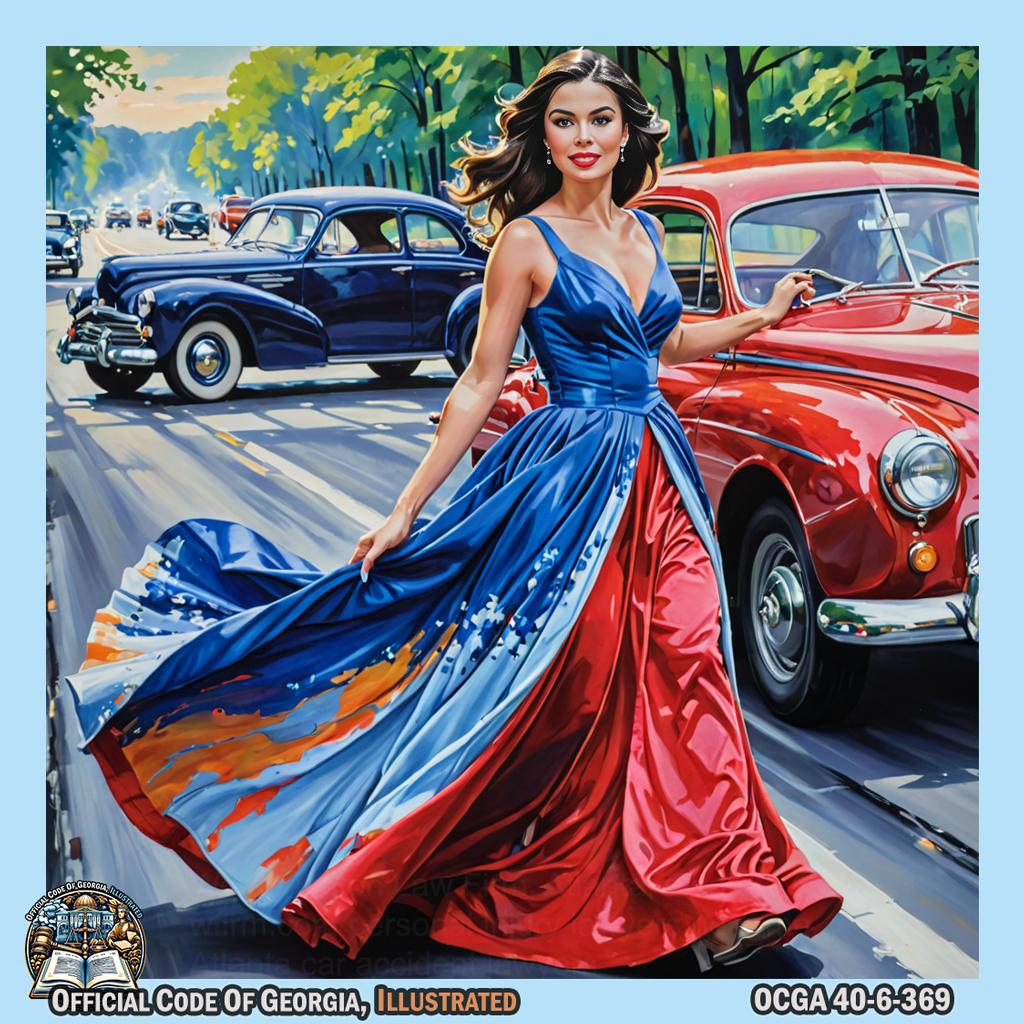
Nivea, dressed in a flowing gown, gracefully glides alongside a vintage car while holding a large canvas. With deliberate movements, she paints the scene of two vehicles on the road, one overtaking the other in vivid colors and bold strokes, bringing to life Georgia's traffic laws with artistic flair at an exhibition in Albany. -@thisisNIVEA -
No person shall operate a personal transportation vehicle between lanes of traffic or between adjacent lines or rows of vehicles.
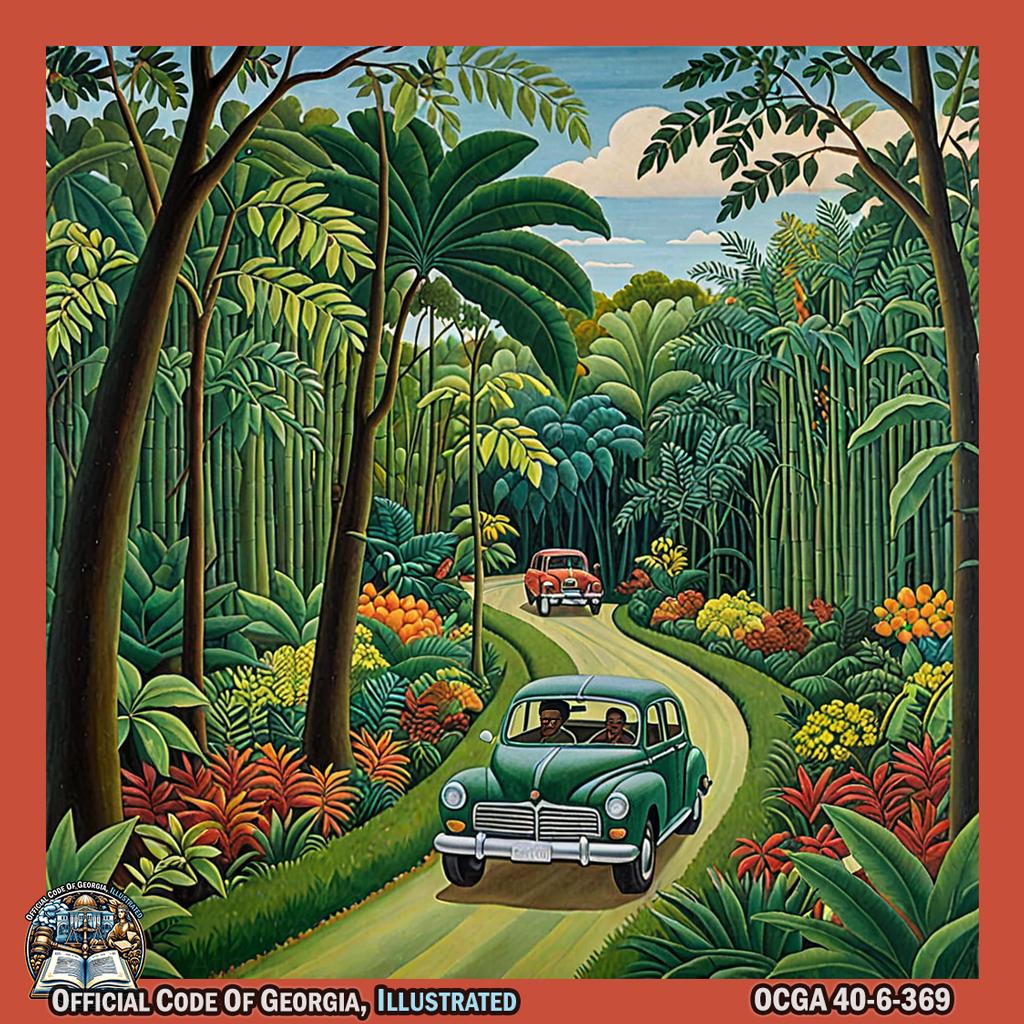
A person slowly moves through a lush, jungle-like setting, weaving in and out between stationary vehicles with Otis Redding performing the act in the style of an art piece from Henri Rousseau. -
Personal transportation vehicles shall not be operated two or more abreast in a single lane.
40-6-369.1.Speed limits on streets authorized for PTV use.¶
Personal transportation vehicles shall only be operated on highways where the posted speed limit does not exceed 25 miles per hour. The operator of a personal transportation vehicle shall not operate such vehicle on any highway where the posted speed limit exceeds 25 miles per hour.

Article 14 Effect of Chapter on Powers of Local Authorities {#t40c06a14}

-
40-6-370. Uniform state-wide application of chapter.

Alma Thomas, dressed in a costume representing the entire state, uses a giant stamp to "apply" the chapter to different areas of the state, creating a scene reminiscent of an art piece by April Gornik. -
40-6-371. Powers of local authorities generally.
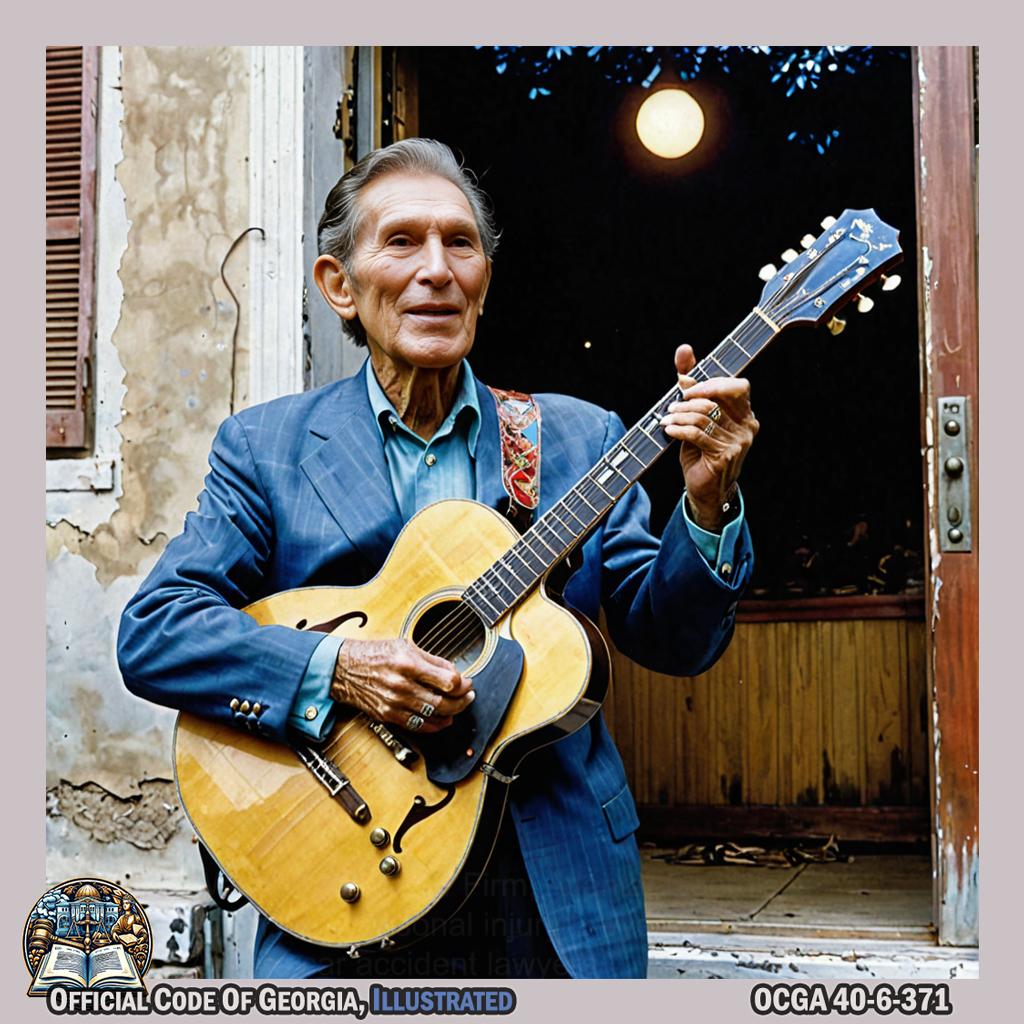
Chet Atkins, strumming his guitar in the rich scene of Athens, Georgia, holding a large key and waving his hand in the air as if casting a magical spell. - 40-6-373. Effect of future changes in chapter.
- 40-6-374. Form of adopting ordinance.
- 40-6-375. Citations for violations.
- 40-6-376. Prosecution under this chapter or local ordinance; transfer of charge to state tribunal; double jeopardy.
40-6-370.Uniform state-wide application of chapter.¶
The provisions of this chapter and the definitions contained in Code Section 40-1-1 shall be applicable and uniform throughout this state and in all counties and municipalities therein, and no local authority shall enact or enforce any ordinance on a matter covered by the provisions of this chapter except as expressly authorized in Code Sections 40-6-371 and 40-6-372.
40-6-371.Powers of local authorities generally.¶
-
This chapter shall not be deemed to prevent local authorities with respect to streets and highways under their jurisdiction and within the reasonable exercise of the police power from:

Ousman Krubally, dribbling a basketball down an Alpharetta street, gracefully weaving between traffic cones and obstacles in a mesmerizing display of athleticism and finesse that captures the essence of local authorities' jurisdiction over streets and highways within the reasonable exercise of police power. -@OusjuiceKrub - Regulating or prohibiting stopping, standing, or parking;
- Regulating traffic by means of police officers or official traffic-control devices;
-
Regulating or prohibiting processions or assemblages on the highways;
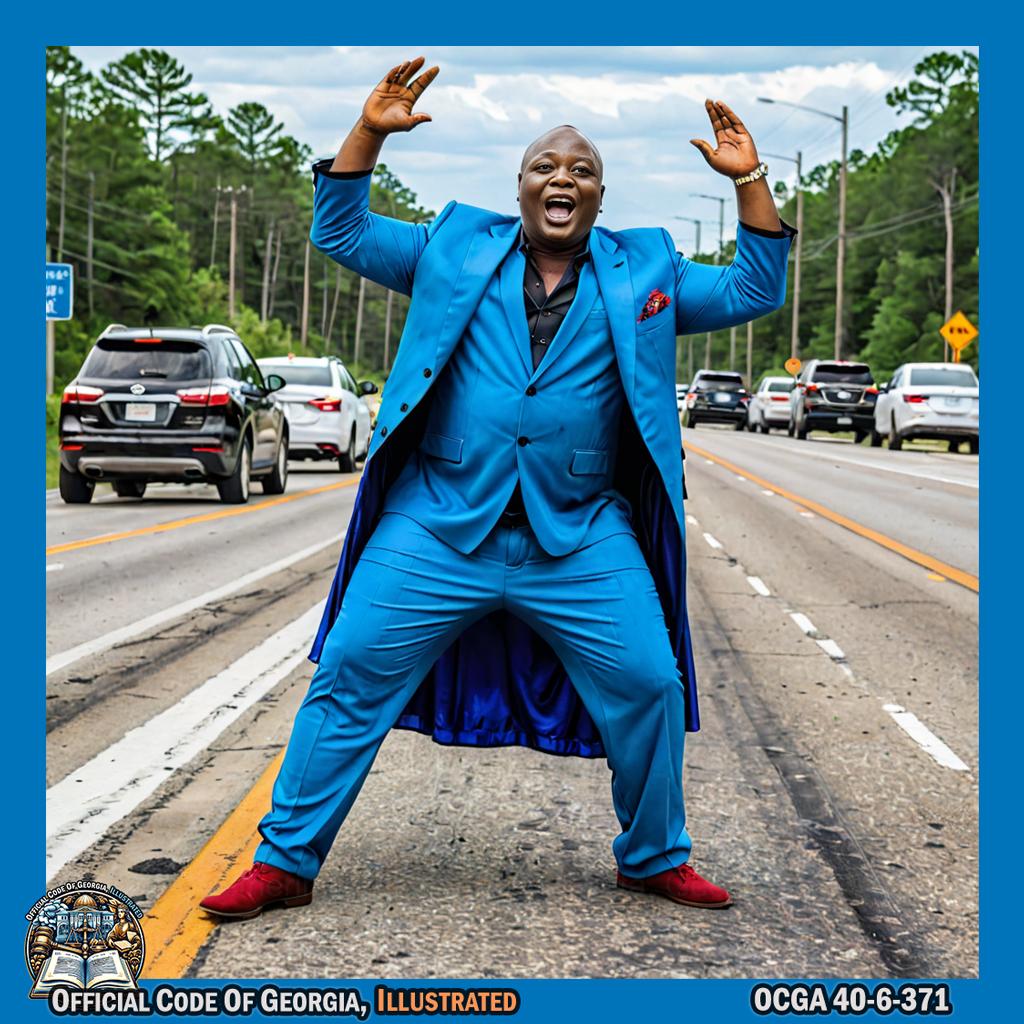
Tituss Burgess, in the style of Nekdo Solakov, uses exaggerated gestures and expressions to symbolically block a procession on a highway by creating an intricate dance with his body that conveys the idea of regulation and prohibition, all within a richly decorated scene in Thomasville. -@TitussBurgess -
Designating particular highways or roadways for use by traffic moving in one direction as authorized in Code Section 40-6-47;
-
Establishing speed limits for vehicles in public parks, notwithstanding any provisions of law establishing a minimum speed limit for an area outside an urban or residential district;
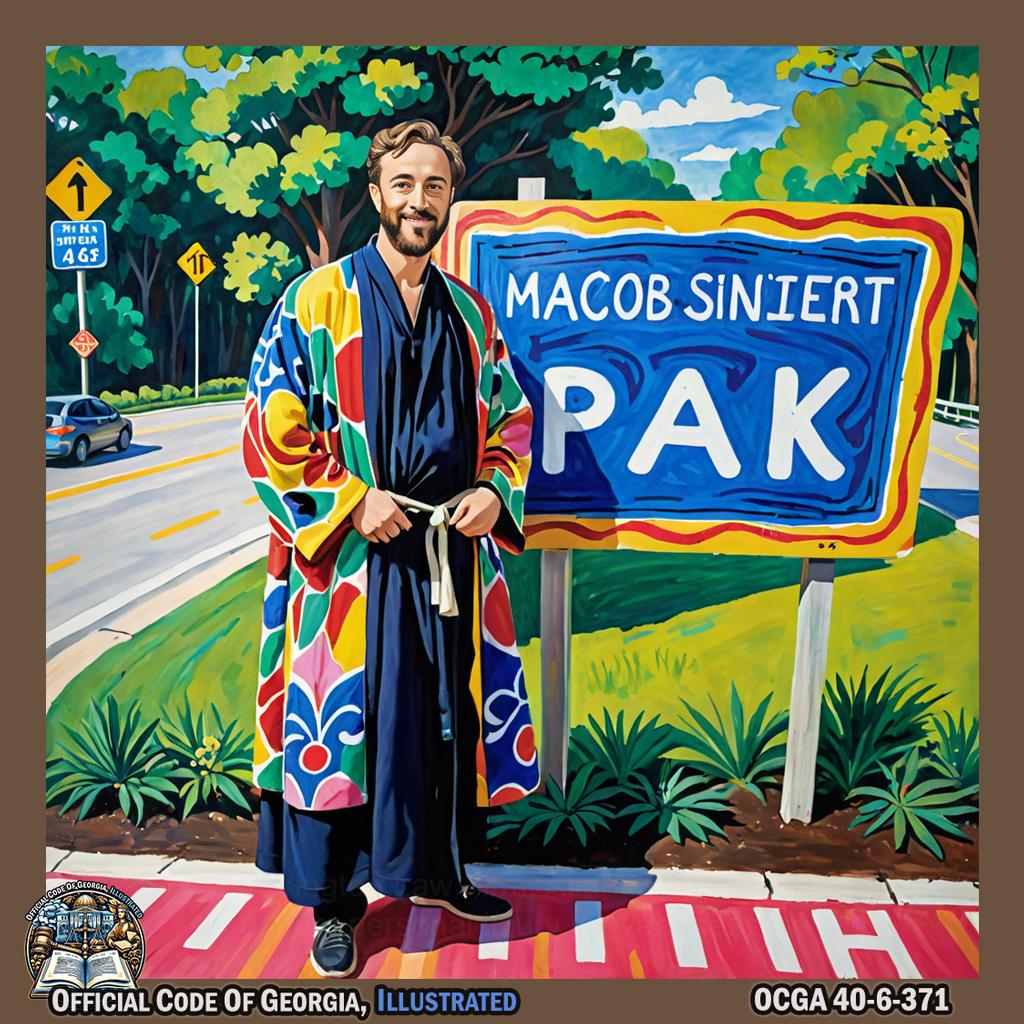
Jacob Snider, dressed in a vibrant and flowing robe, gracefully paints a large sign with colorful speed limit symbols and park imagery, while surrounded by lush greenery and playful animals in Conyers. -
Designating any highway as a through highway or designating any intersection or junction of roadway as a stop or yield intersection or junction;
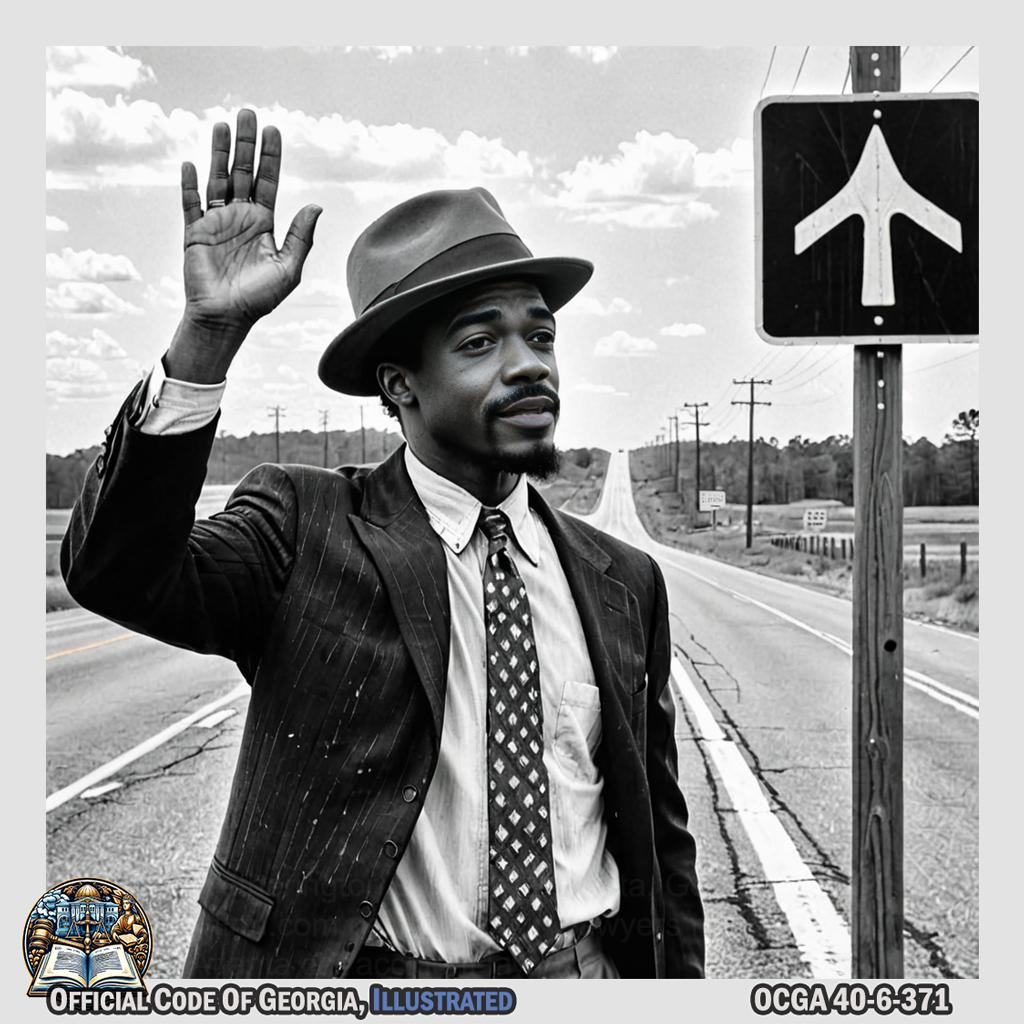
André 3000 stands at the crossroads, wearing a vintage suit and fedora, with his hand raised in an authoritative gesture as he designates a highway as a through highway. The scene is captured in black and white, evoking the emotional depth of Dorothea Lange's style, amidst the historical charm of Kennesaw. -
Requiring the registration and inspection of bicycles, including the requirement of a registration fee;
- Designating any highway intersection as a “yield right of way” intersection and requiring vehicles facing a “yield right of way” sign to yield the right of way to other vehicles;
- Regulating or prohibiting the turning of vehicles or specified types of vehicles;
- Altering or establishing speed limits as authorized by law;
- Designating no-passing zones as authorized in Code Section 40-6-46;
- Prohibiting or regulating the use of controlled-access roadways by any class of vehicle or kind of traffic as authorized in Code Section 40-6-51;
- Prohibiting or regulating the use of heavily traveled streets by any class of vehicle or kind of traffic found to be incompatible with the normal and safe movement of traffic;
- Establishing minimum speed limits as authorized by law;
- Designating hazardous railroad grade crossings as authorized in Code Section 40-6-141;
- Designating and regulating traffic on play streets;
- Regulating persons propelling push carts;
-
Regulating persons upon skates, coasters, sleds, and other toy vehicles;
(18.1)Regulating the operation of electric personal assistive mobility devices, provided that such regulations are no less restrictive than those imposed by Part 2A of Article 13 of this chapter;
(18.2)Regulating the operation of personal transportation vehicles, provided that such regulations comply with Parts 3 and 6 of Article 13 of this chapter;
-
Adopting and enforcing such temporary or experimental regulations as may be necessary to cover emergencies or special conditions; or
- Adopting such other traffic regulations as are specifically authorized by this chapter.
(a.1)No fine imposed by a local authority for violation of an ordinance or regulation for conduct which constitutes a violation of a provision of this chapter shall exceed any maximum fine specified by this chapter for such violation.
-
No local authority shall erect or maintain any official traffic-control device at any location so as to require the traffic on any state highway to stop before entering or crossing any intersecting highway unless approval in writing has first been obtained from the Department of Transportation of the State of Georgia. If this issue is on trial in a civil or criminal action, the proper authority shall be presumed.
- No ordinance or regulation enacted under paragraph (4), (5), (6), (8), (9), (10), (11), (12), (13), (14), (15), (16), (17), (18), or (18.2) of subsection (a) of this Code section shall be effective until official traffic-control devices giving notice of such local traffic regulations are erected upon or at the entrances to the highway or the part thereof affected as may be most appropriate.
40-6-372.Adoption of chapter by local authorities.¶
Local authorities by ordinance may adopt by reference any or all provisions of this chapter or of Code Section 40-1-1 without publishing or posting in full the provisions thereof.
40-6-373.Effect of future changes in chapter.¶
A future amendment or repeal of a provision of this chapter or of Code Section 40-1-1 shall so amend or repeal the pertinent provision, if any, of the original ordinance adopted by a local authority pursuant to the authority of Code Section 40-6-372 without any action by such local authority being required.
40-6-374.Form of adopting ordinance.¶
Local authorities shall use the following wording or similar wording in adopting by reference the provisions of this chapter or the definitions contained in Code Section 40-1-1:
(Municipality or County) of Ordinance number An ordinance adopting the Georgia Uniform Rules of the Road, Code Sections [ to (except for Code Sections )] of Chapter 6 of Title 40 of the Official Code of Georgia Annotated, to regulate traffic upon the public streets of the (Municipality or County) of and repealing ordinance number and all other ordinances and sections of ordinances in conflict herewith. It is ordained by as follows: Section 1. Adoption by reference. Pursuant to Chapter 6 of Title 40 of the Official Code of Georgia Annotated, through , Code Sections [ to (except for Code Sections )] of that chapter known as the Uniform Rules of the Road and the definitions contained in are hereby adopted as and for the traffic regulations of this (Municipality or County) with like effect as if recited herein. Code Sections 40-6-372 40-6-376 Code Section 40-1-1 Section 2. Penalties. Unless another penalty is expressly provided by law, every person convicted of a violation of any provision of this ordinance shall be punished by a fine of not more than dollars or by imprisonment for not more than days or by both such fine and imprisonment. Section 3. Repeal. The (existing ordinances covering the same matters as embraced in this ordinance) are hereby repealed and all ordinances or parts of ordinances inconsistent with the provisions of this ordinance are hereby repealed. Section 4. Effective date. This ordinance shall take effect from and after the day of , .
Click to view
40-6-375.Citations for violations.¶
It shall be sufficient in citing a violation of a provision of this chapter to refer to the ordinance number of the enacting ordinance, provided that the citation form used is the one developed by the commissioner of public safety under the authority of Code Section 40-13-1.
40-6-376.Prosecution under this chapter or local ordinance; transfer of charge to state tribunal; double jeopardy.¶
- Any offense, except a violation of subsection (b) of Code Section 40-6-270 or a violation of Code Section 40-6-393, which is a violation of a provision of this chapter and of a local ordinance may, at the discretion of the local law enforcement officer or prosecutor, be charged as a violation of the state statute or of the local ordinance. A violation of subsection (b) of Code Section 40-6-270 or a violation of Code Section 40-6-393 shall be charged as a state violation.
- If the offense charged under an ordinance constitutes a violation of any provision of this chapter, the defendant may request transfer of the charge to the appropriate state tribunal. If the defendant so requests, the recorder or city judge, after conducting a commitment hearing in which probable cause for arrest is found, or upon obtaining a waiver of commitment hearing, shall summarily fix the defendant’s bond and bind his case over to the appropriate state tribunal.
- No person tried in any court for a violation of this chapter or any ordinance adopted pursuant thereto shall thereafter be tried in any court for the same offense. A conviction for the violation of an ordinance adopted pursuant to this chapter shall be considered a prior conviction for all purposes under this chapter and under Chapter 13 of this title.
- No court, other than a court having jurisdiction to try a person charged with a violation of Code Section 40-6-393, shall have jurisdiction over any offense arising under the laws of this state or the ordinances of any political subdivision thereof, which offense arose out of the same conduct which led to said person’s being charged with a violation of Code Section 40-6-393 and any judgment rendered by such court shall be null and void.
Article 15 Serious Traffic Offenses {#t40c06a15}

-
40-6-390. Reckless driving.

Football player Asher Allen, at the Creative Discovery Museum in Georgia, pretending to drive a car with exaggerated swerving and speeding motions. - 40-6-391. Driving under the influence of alcohol, drugs, or other intoxicating substances; penalties; publication of notice of conviction for persons convicted for second time; endangering a child.
- 40-6-391.1. Entry and acceptance of plea of nolo contendere.
- 40-6-391.2. Seizure and civil forfeiture of motor vehicle operated by habitual violator.
- 40-6-391.3. Penalty for conviction for driving under influence of alcohol or drugs while driving school bus.
- 40-6-392. Chemical tests for alcohol or drugs.
- 40-6-393. Homicide by vehicle.
- 40-6-393.1. Feticide by vehicle.
- 40-6-394. Serious injury by vehicle.
- 40-6-395. Fleeing or attempting to elude police officer; impersonating law enforcement officer.
- 40-6-396. Homicide by interference with official traffic-control device or railroad sign or signal; serious injury by interference with official traffic-control device or railroad sign or signal.
- 40-6-397. Aggressive driving.
40-6-390.Reckless driving.¶
- Any person who drives any vehicle in reckless disregard for the safety of persons or property commits the offense of reckless driving.
- Every person convicted of reckless driving shall be guilty of a misdemeanor and, upon conviction thereof, shall be punished by a fine not to exceed $1,000.00 or imprisonment not to exceed 12 months, or by both such fine and imprisonment, provided that no provision of this Code section shall be construed so as to deprive the court imposing the sentence of the power given by law to stay or suspend the execution of such sentence or to place the defendant on probation.
40-6-390.1.Reckless stunt driving.¶
-
Any person who operates any vehicle while drag racing, in violation of Code Section 40-6-186, or laying drags, in violation of Code Section 40-6-251, in reckless disregard for the safety of persons on a highway or upon private property without express authorization from the owner of such property commits the offense of reckless stunt driving and, upon conviction thereof, shall be guilty of:
-
For the first conviction with no conviction of and no plea of nolo contendere accepted to a charge of violating this Code section within the previous ten years, a misdemeanor of a high and aggravated nature to be punished by:
-
A fine of not less than $300.00 but no more than $750.00; and
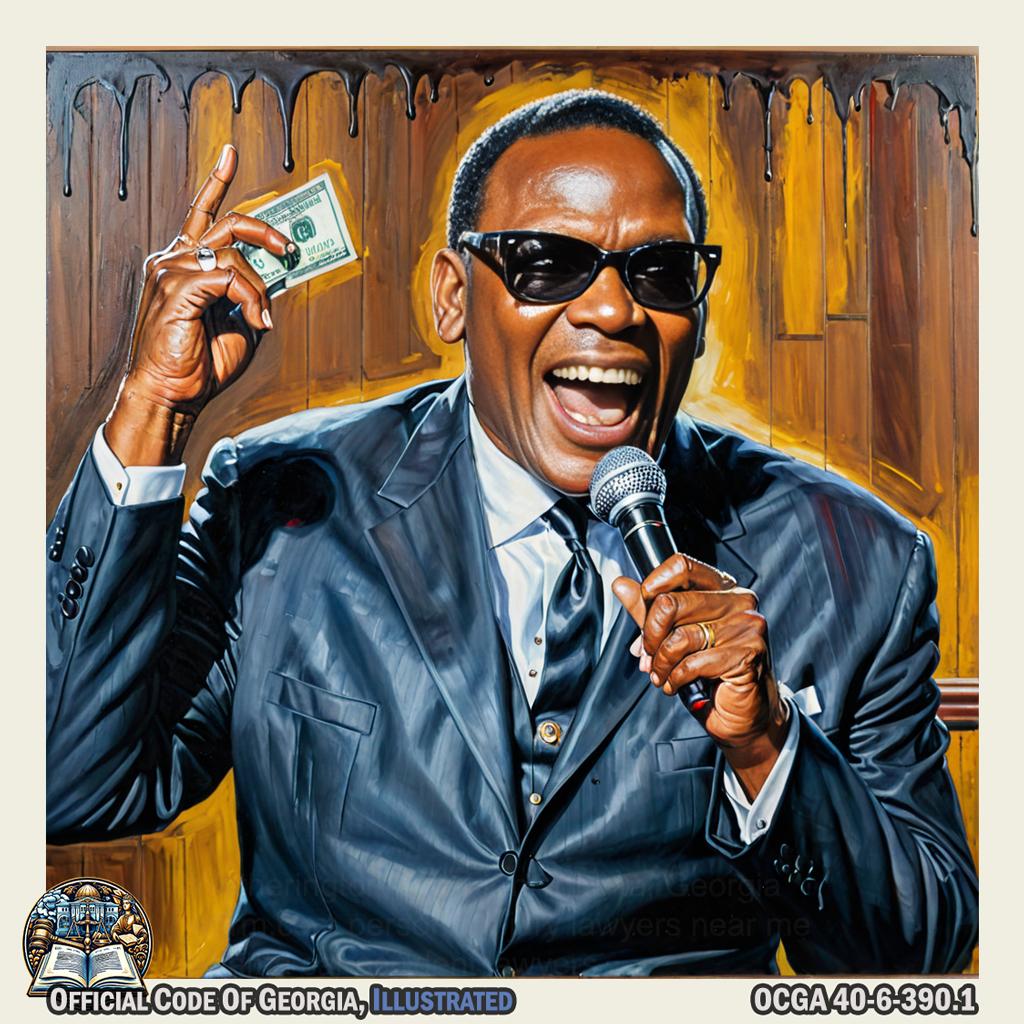
Singer Ray Charles is seen belting out a soulful melody while portraying a judge, holding a gavel and making a "money" gesture with both hands in Cynthia Knott's art piece. -
A period of imprisonment of not fewer than ten days nor more than six months;

Janelle Monáe performs inside a giant hourglass, pressing her hands against the glass walls and making comical expressions, reminiscent of an art piece by Elizabeth Catlett. -@JanelleMonae
-
-
For the second conviction in a ten-year period of time, a misdemeanor of a high and aggravated nature to be punished by:
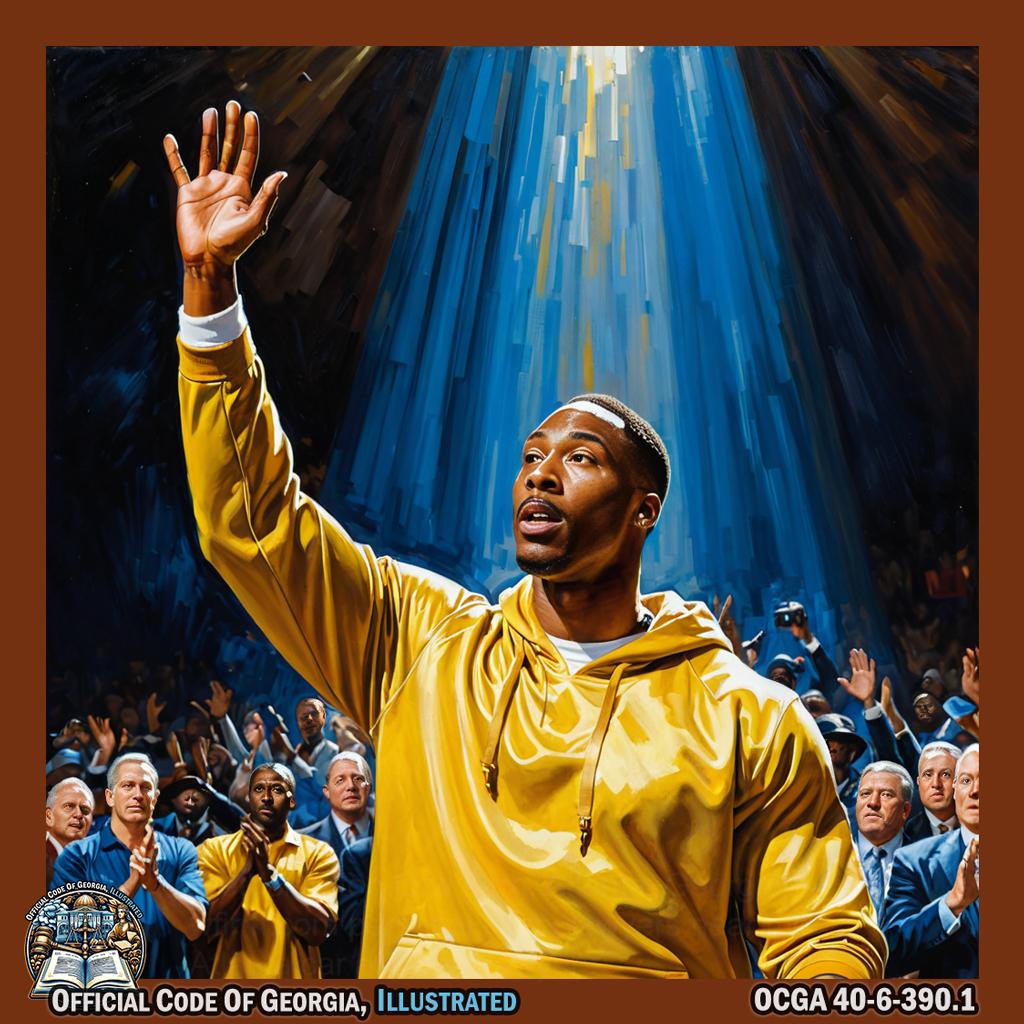
Dwight Howard raises his hands in a dramatic gesture, while a spotlight illuminates him from above, creating a captivating tableau reminiscent of Vermeer's art. -@DwightHoward -
A fine of not less than $600.00 and not more than $1,000.00; and
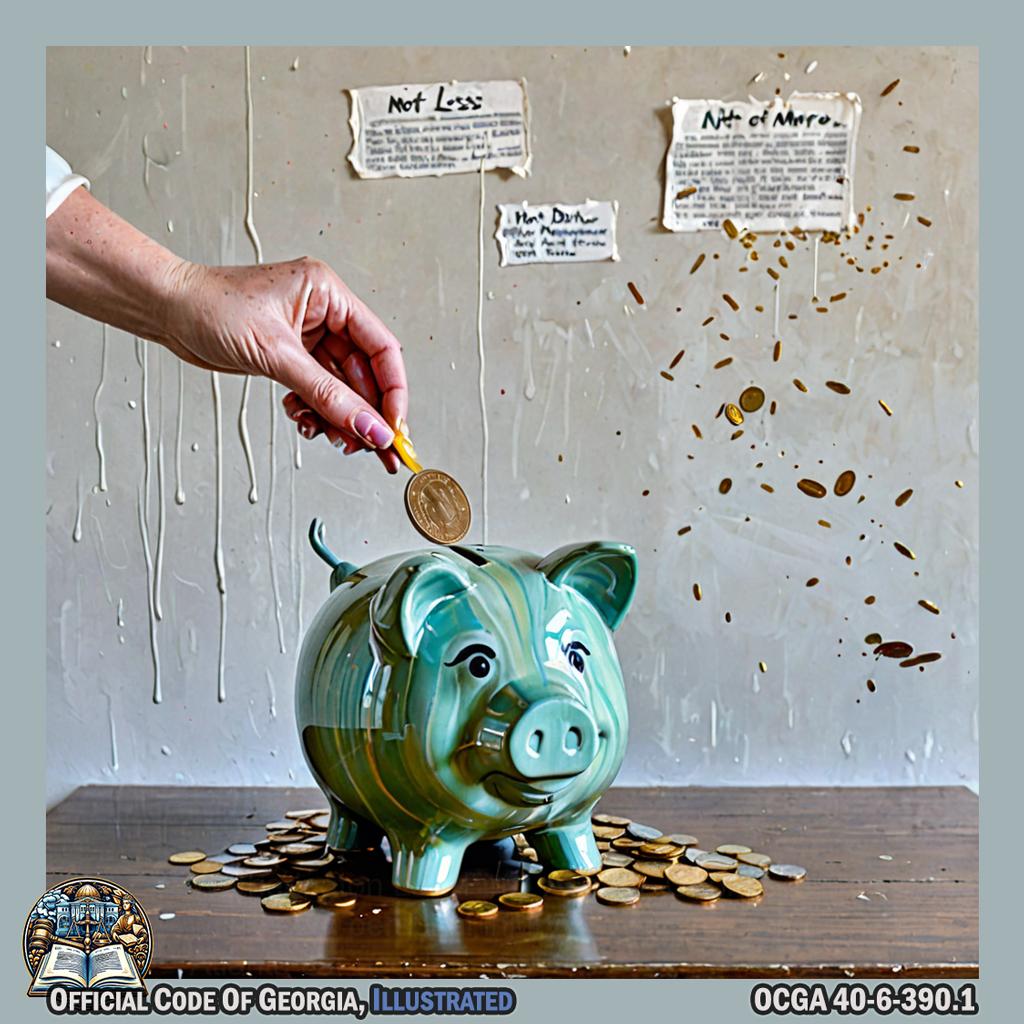
Newspaper editor and publisher, Helen Dortch Longstreet, delicately drops coins into a piggy bank with two slots labeled "not less than $" and "not more than $", resembling an art piece from Cy Twombly. -
A period of imprisonment of not fewer than 90 days and not more than 12 months;
- For the third conviction in a ten-year period of time, a misdemeanor of a high and aggravated nature to be punished by:

Bill Curry, dressed in period attire reminiscent of Renoir's style, stands solemnly before a canvas on an easel in the lush Perkerson Park, palette in hand as he thoughtfully paints red strokes to symbolize the gravity of repeated misdemeanors, while Renoir, beside him with a gentle frown, guides his hand to soften the lines, suggesting education and rehabilitation over punishment. -@coachbillcurry
- For the third conviction in a ten-year period of time, a misdemeanor of a high and aggravated nature to be punished by:
-
A fine of not less than $1,000.00 and not more than $5,000.00; and
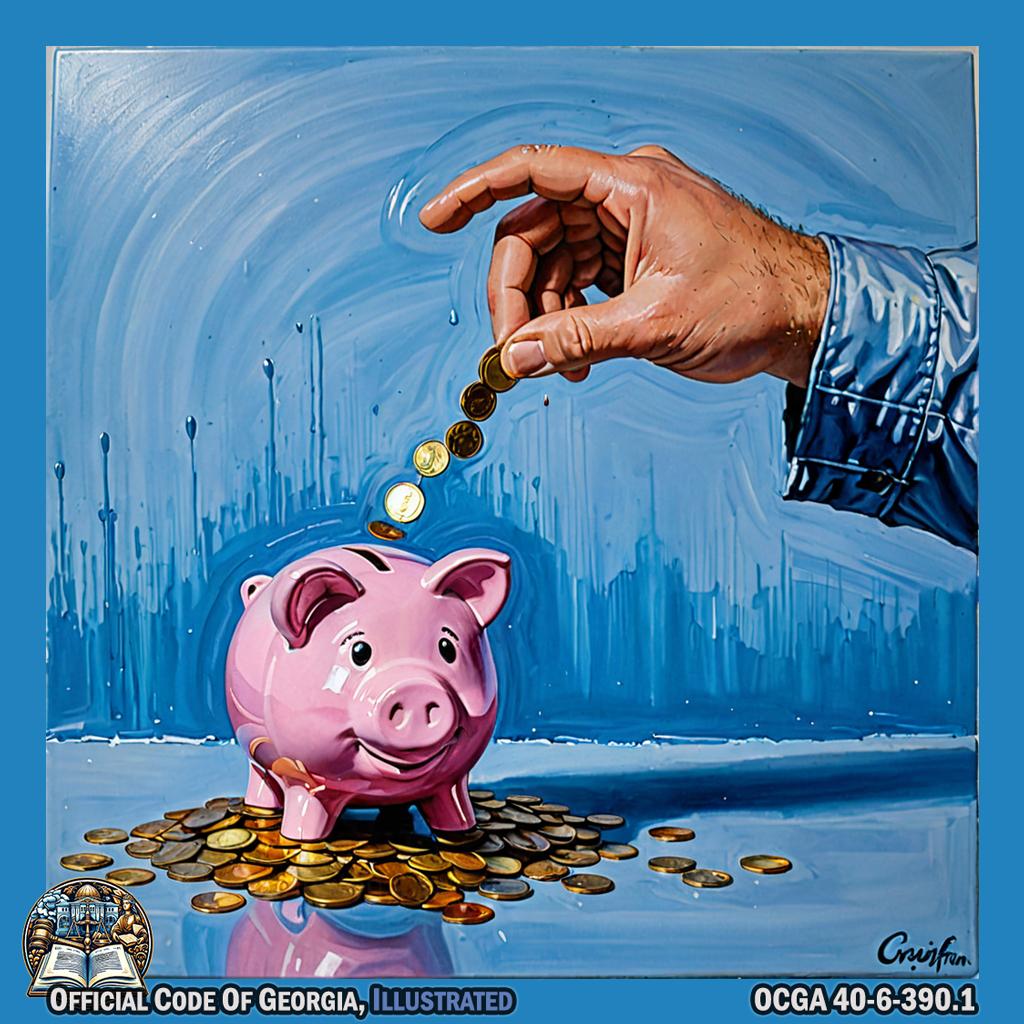
Corey Smith delicately drops coins into a piggy bank with two slots labeled "not less than $" and "not more than $", creating an art piece reminiscent of Craig Kauffman's work. -@coreysmithmusic -
A period of imprisonment of not fewer than 120 days and not more than 12 months; and
- For a fourth or subsequent conviction in a ten-year period of time, a felony to be punished by:
- A fine of not less than $1,000.00 and not more than $5,000.00; and
- A period of imprisonment of not fewer than one year and not more than five years.
-
-
-
- Notwithstanding the limits set forth in any municipal charter, any municipal court of any municipality shall be authorized to impose the misdemeanor or high and aggravated misdemeanor punishments provided for in this Code section upon a conviction of violating this Code section or upon a conviction of violating any ordinance adopting the provisions of this Code section.
- Notwithstanding any provision of this Code section to the contrary, any court authorized to hear misdemeanor or high and aggravated misdemeanor cases involving violations of this Code section shall be authorized to exercise the power to probate, suspend, or stay any sentence imposed.

A person, embodying Pylon, stands with outstretched arms in a dramatic pose as if holding the weight of a sentence. Their eyes reflect the burden of decision and justice as they command attention in a scene rich with smoke and sizzling barbecue, capturing the essence of Robert Capa's artistry.
-
- Any motor vehicle operated by a person who has been declared a habitual violator for three violations of this Code section, whose license has been revoked, and who is arrested and charged with a violation of this Code section is declared to be contraband and subject to forfeiture in accordance with the procedures set forth in Chapter 16 of Title 9.
- In any case where a vehicle which is the only family vehicle is determined to be subject to forfeiture, the court may, if it determines that the financial hardship to the family as a result of the forfeiture and sale outweighs the benefit to the state from such forfeiture, order the title to the vehicle transferred to such other family member who is a duly licensed operator and who requires the use of such vehicle for employment or family transportation purposes. Such transfer shall be subject to any valid liens and shall be granted only once.
-
For purposes of this Code section, the occurrence of a previous conviction shall be measured from the dates of previous arrests for which convictions were obtained or pleas of nolo contendere were accepted to the date of the current arrest for which a conviction is obtained or a plea of nolo contendere is accepted.
40-6-391.Driving under the influence of alcohol, drugs, or other intoxicating substances; penalties; publication of notice of conviction for persons convicted for second time; endangering a child.¶
-
A person shall not drive or be in actual physical control of any moving vehicle while:
- Under the influence of alcohol to the extent that it is less safe for the person to drive;
- Under the influence of any drug to the extent that it is less safe for the person to drive;
- Under the intentional influence of any glue, aerosol, or other toxic vapor to the extent that it is less safe for the person to drive;
-
Under the combined influence of any two or more of the substances specified in paragraphs (1) through (3) of this subsection to the extent that it is less safe for the person to drive;
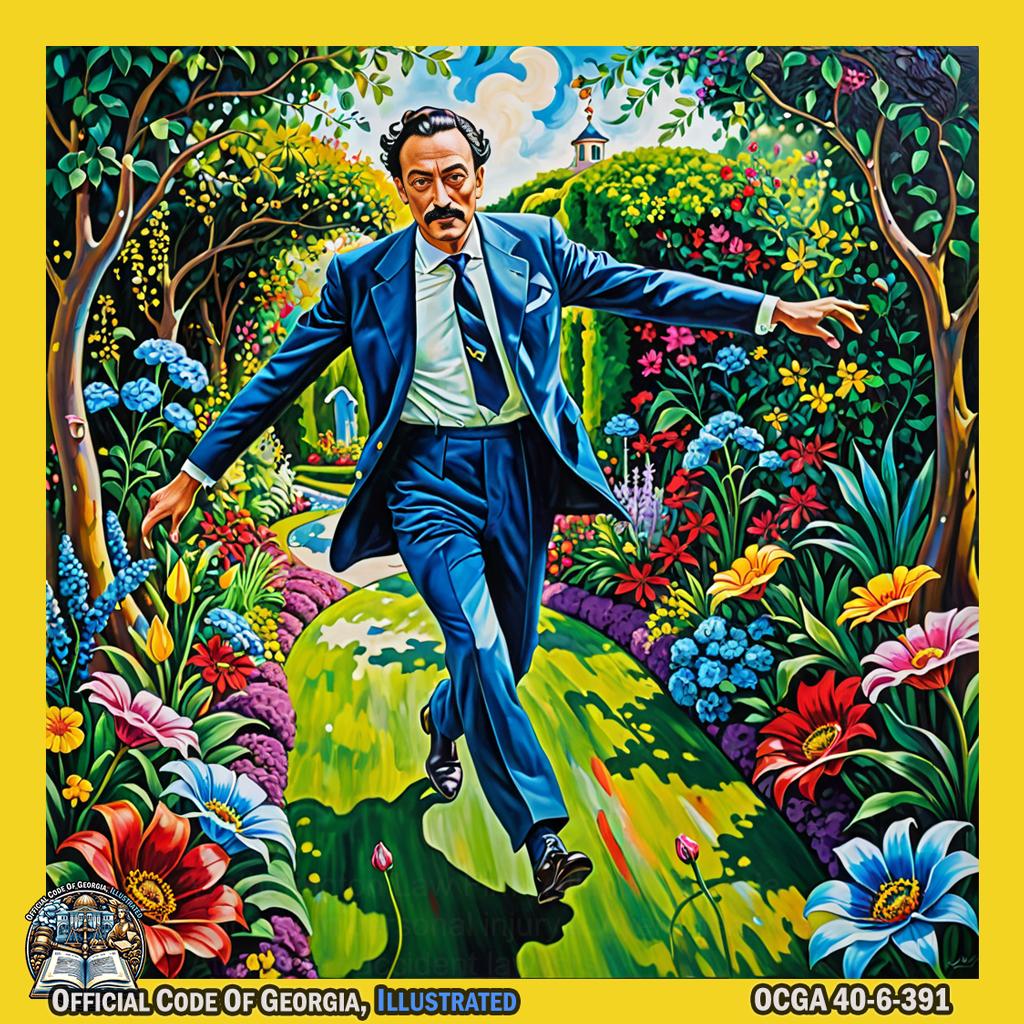
A person, under the influence of two or more substances, stumbles and sways unsteadily as they attempt to walk through a garden filled with vibrant flowers and lush greenery, their movements exaggerated in an abstract art style reminiscent of Salvador Dali's melting clocks. -
The person’s alcohol concentration is 0.08 grams or more at any time within three hours after such driving or being in actual physical control from alcohol consumed before such driving or being in actual physical control ended; or
- Subject to the provisions of subsection (b) of this Code section, there is any amount of marijuana or a controlled substance, as defined in Code Section 16-13-21, present in the person’s blood or urine, or both, including the metabolites and derivatives of each or both without regard to whether or not any alcohol is present in the person’s breath or blood.
-
The fact that any person charged with violating this Code section is or has been legally entitled to use a drug shall not constitute a defense against any charge of violating this Code section; provided, however, that such person shall not be in violation of this Code section unless such person is rendered incapable of driving safely as a result of using a drug other than alcohol which such person is legally entitled to use.
-
Every person convicted of violating this Code section shall, upon a first or second conviction thereof, be guilty of a misdemeanor, upon a third conviction thereof, be guilty of a high and aggravated misdemeanor, and upon a fourth or subsequent conviction thereof, be guilty of a felony except as otherwise provided in paragraph (4) of this subsection and shall be punished as follows:
-
First conviction with no conviction of and no plea of nolo contendere accepted to a charge of violating this Code section within the previous ten years, as measured from the dates of previous arrests for which convictions were obtained or pleas of nolo contendere were accepted to the date of the current arrest for which a conviction is obtained or a plea of nolo contendere is accepted:
- A fine of not less than $300.00 and not more than $1,000.00, which fine shall not, except as provided in subsection (g) of this Code section, be subject to suspension, stay, or probation;
-
A period of imprisonment of not fewer than ten days nor more than 12 months, which period of imprisonment may, at the sole discretion of the judge, be suspended, stayed, or probated, except that if the offender’s alcohol concentration at the time of the offense was 0.08 grams or more, the judge may suspend, stay, or probate all but 24 hours of any term of imprisonment imposed under this subparagraph;
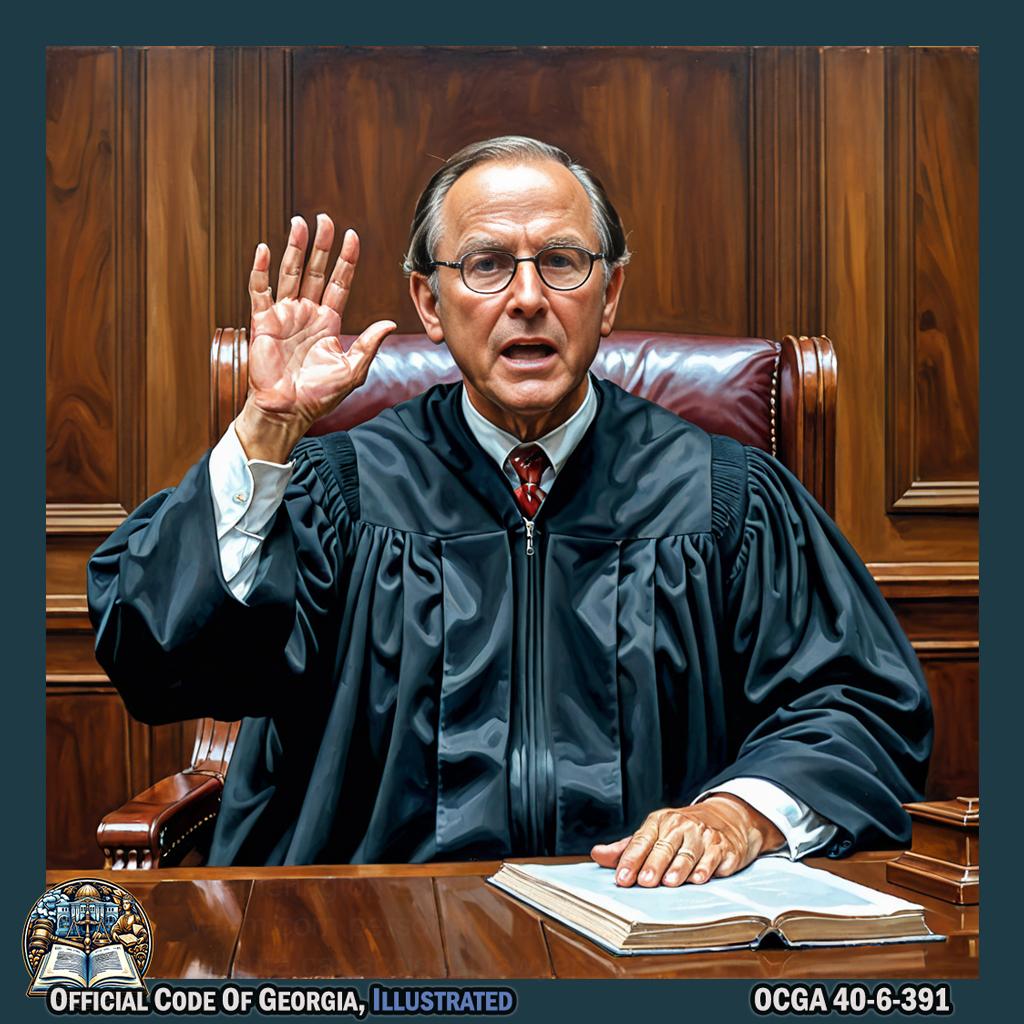
Entrepreneur Ben Chestnut, embodying the role of a judge in an art piece by Eleanore Mikus, makes dramatic hand gestures as he suspends, stays, or probates a sentence while exclaiming "suspended," "stayed," or "probated" with heightened facial expressions. -@benchestnut -
Not fewer than 40 hours of community service, except that for a conviction for violation of subsection (k) of this Code section where the person’s alcohol concentration at the time of the offense was less than 0.08 grams, the period of community service shall be not fewer than 20 hours;
- Completion of a DUI Alcohol or Drug Use Risk Reduction Program within 120 days following his or her conviction; provided, however, that if the defendant is incarcerated and such program cannot be completed within 120 days, it shall be completed within 90 days of his or her release from custody. The sponsor of any such program shall provide written notice of the Department of Driver Services’ certification of the program to the person upon enrollment in the program;
- A clinical evaluation as defined in Code Section 40-5-1 and, if recommended as a part of such evaluation, completion of a substance abuse treatment program as defined in Code Section 40-5-1; provided, however, that in the court’s discretion such evaluation may be waived; and
- If the person is sentenced to a period of imprisonment for fewer than 12 months, a period of probation of 12 months less any days during which the person is actually incarcerated;
- For the second conviction within a ten-year period of time, as measured from the dates of previous arrests for which convictions were obtained or pleas of nolo contendere were accepted to the date of the current arrest for which a conviction is obtained or a plea of nolo contendere is accepted:
-
A fine of not less than $600.00 and not more than $1,000.00, which fine shall not, except as provided in subsection (g) of this Code section, be subject to suspension, stay, or probation;
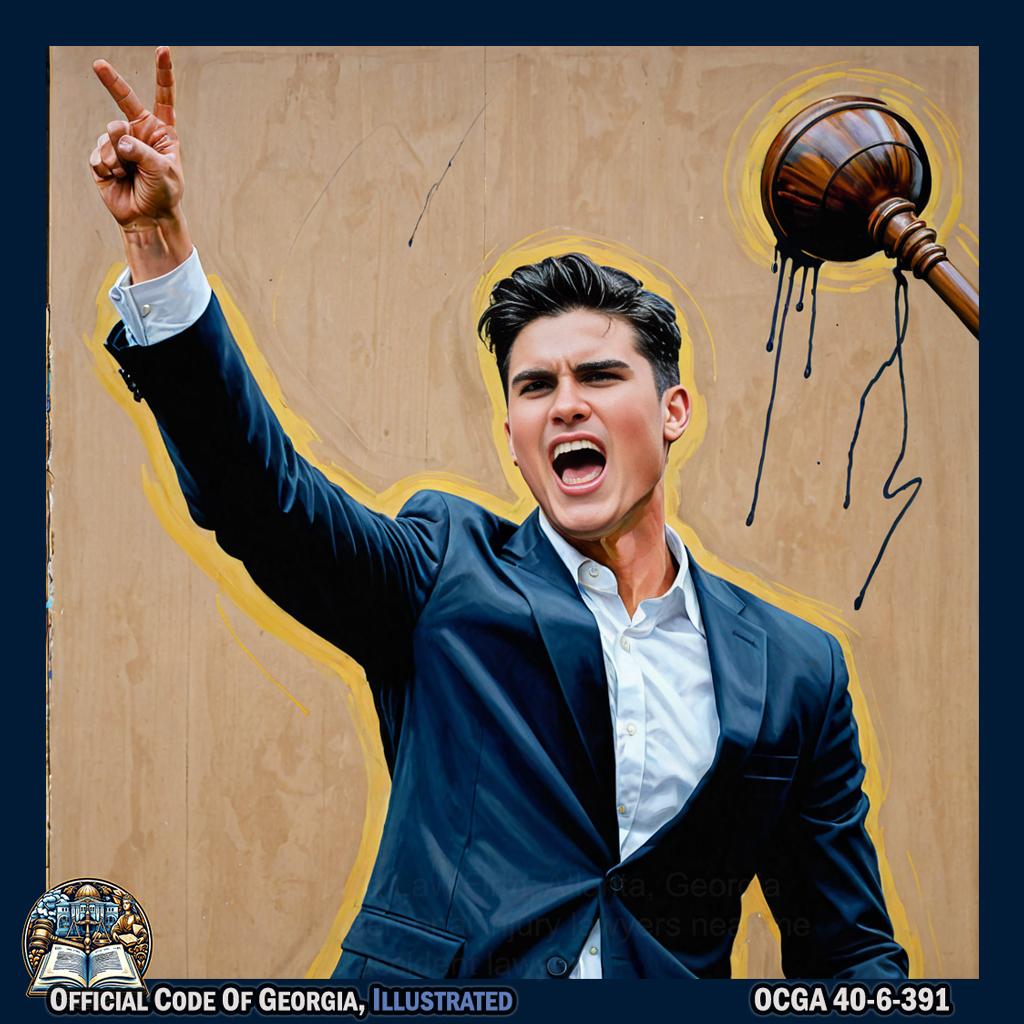
Singer Kristian Stanfill, depicted in the style of an art piece by Cornell Capa, is seen holding a gavel and shaking his head while pointing at an imaginary fine amount written in the air, then making a "no" gesture with his hands for suspension, stay, or probation. -@kpstanfill -
A period of imprisonment of not fewer than 90 days and not more than 12 months. The judge shall probate at least a portion of such term of imprisonment, in accordance with subparagraph (F) of this paragraph, thereby subjecting the offender to the provisions of Article 7 of Chapter 8 of Title 42 and to such other terms and conditions as the judge may impose; provided, however, that the offender shall be required to serve not fewer than 72 hours of actual incarceration;
- Not fewer than 30 days of community service;
- Completion of a DUI Alcohol or Drug Use Risk Reduction Program within 120 days following his or her conviction; provided, however, that if the defendant is incarcerated and such program cannot be completed within 120 days, it shall be completed within 90 days of his or her release from custody. The sponsor of any such program shall provide written notice of the Department of Driver Services’ certification of the program to the person upon enrollment in the program;
- A clinical evaluation as defined in Code Section 40-5-1 and, if recommended as a part of such evaluation, completion of a substance abuse treatment program as defined in Code Section 40-5-1; and
- A period of probation of 12 months less any days during which the person is actually incarcerated;
- For the third conviction within a ten-year period of time, as measured from the dates of previous arrests for which convictions were obtained or pleas of nolo contendere were accepted to the date of the current arrest for which a conviction is obtained or a plea of nolo contendere is accepted:
-
A fine of not less than $1,000.00 and not more than $5,000.00, which fine shall not, except as provided in subsection (g) of this Code section, be subject to suspension, stay, or probation;

Professional wrestler A.J. Styles, depicted as an art piece by Cora Cohen, is seen portraying a judge holding a gavel and shaking his head while pointing at an imaginary fine amount written in the air, followed by making a "no" gesture with his hands for suspension, stay, or probation. -@AJStylesOrg -
A mandatory period of imprisonment of not fewer than 120 days and not more than 12 months. The judge shall probate at least a portion of such term of imprisonment, in accordance with subparagraph (F) of this paragraph, thereby subjecting the offender to the provisions of Article 7 of Chapter 8 of Title 42 and to such other terms and conditions as the judge may impose; provided, however, that the offender shall be required to serve not fewer than 15 days of actual incarceration;
-
Not fewer than 30 days of community service;

In a dimly lit room in Douglas, Georgia, an actor representing GE Energy Management Services, LLC slowly moves their hands in graceful, deliberate motions as if sculpting the air itself. The fluidity of their movements evokes a sense of community service days being fulfilled through the ethereal play of light and shadow, creating an art piece reminiscent of James Turrell's style. -
Completion of a DUI Alcohol or Drug Use Risk Reduction Program within 120 days following his or her conviction; provided, however, that if the defendant is incarcerated and such program cannot be completed within 120 days, it shall be completed within 90 days of his or her release from custody. The sponsor of any such program shall provide written notice of the Department of Driver Services’ certification of the program to the person upon enrollment in the program;
- A clinical evaluation as defined in Code Section 40-5-1 and, if recommended as a part of such evaluation, completion of a substance abuse treatment program as defined in Code Section 40-5-1; and
- A period of probation of 12 months less any days during which the person is actually incarcerated;
- For the fourth or subsequent conviction within a ten-year period of time, as measured from the dates of previous arrests for which convictions were obtained or pleas of nolo contendere were accepted to the date of the current arrest for which a conviction is obtained or a plea of nolo contendere is accepted:
- A fine of not less than $1,000.00 and not more than $5,000.00, which fine shall not, except as provided in subsection (g) of this Code section, be subject to suspension, stay, or probation;
- A period of imprisonment of not less than one year and not more than five years; provided, however, that the judge may suspend, stay, or probate all but 90 days of any term of imprisonment imposed under this paragraph. The judge shall probate at least a portion of such term of imprisonment, in accordance with subparagraph (F) of this paragraph, thereby subjecting the offender to the provisions of Article 7 of Chapter 8 of Title 42 and to such other terms and conditions as the judge may impose;
- Not fewer than 60 days of community service; provided, however, that if a defendant is sentenced to serve three years of actual imprisonment, the judge may suspend the community service;
- Completion of a DUI Alcohol or Drug Use Risk Reduction Program within 120 days following his or her conviction; provided, however, that if the defendant is incarcerated and such program cannot be completed within 120 days, it shall be completed within 90 days of his or her release from custody. The sponsor of any such program shall provide written notice of the Department of Driver Services’ certification of the program to the person upon enrollment in the program;
- A clinical evaluation as defined in Code Section 40-5-1 and, if recommended as a part of such evaluation, completion of a substance abuse treatment program as defined in Code Section 40-5-1; and
-
A period of probation of five years less any days during which the person is actually imprisoned;
provided, however, that if the ten-year period of time as measured in this paragraph commenced prior to July 1, 2008, then such fourth or subsequent conviction shall be a misdemeanor of a high and aggravated nature and punished as provided in paragraph (3) of this subsection;

Soulja Boy dramatically gesturing with fluid and dynamic movements, portraying the legal concept through bold and energetic physical expression, set against a backdrop of vibrant geometric shapes in the style of Frank Kline, creating an engaging visual representation for educational partnership in Dalton, Georgia. -@souljaboy
-
If a person has been convicted of violating subsection (k) of this Code section premised on a refusal to submit to required testing or where such person’s alcohol concentration at the time of the offense was 0.08 grams or more, and such person is subsequently convicted of violating subsection (a) of this Code section, such person shall be punished by applying the applicable level or grade of conviction specified in this subsection such that the previous conviction of violating subsection (k) of this Code section shall be considered a previous conviction of violating subsection (a) of this Code section;

Jessye Norman, dressed in a flowing gown, dramatically refuses a large, symbolic steering wheel offered by actors playing officers against the lush backdrop of Grayson's heritage trail; her refusal is captured in bold colors and dynamic lighting akin to Guy Bourdin's style, with the surrounding scene filled with abstract shapes representing legal statutes. -
For the purpose of imposing a sentence under this subsection, a plea of nolo contendere based on a violation of this Code section shall constitute a conviction; and
- For purposes of determining the number of prior convictions or pleas of nolo contendere pursuant to the felony provisions of paragraph (4) of this subsection, only those offenses for which a conviction is obtained or a plea of nolo contendere is accepted on or after July 1, 2008, shall be considered; provided, however, that nothing in this subsection shall be construed as limiting or modifying in any way administrative proceedings or sentence enhancement provisions under Georgia law, including, but not limited to, provisions relating to punishment of recidivist offenders pursuant to Title 17.
-
-
- Notwithstanding the limits set forth in any municipal charter, any municipal court of any municipality shall be authorized to impose the misdemeanor or high and aggravated misdemeanor punishments provided for in this Code section upon a conviction of violating this Code section or upon a conviction of violating any ordinance adopting the provisions of this Code section.
- Notwithstanding any provision of this Code section to the contrary, any court authorized to hear misdemeanor or high and aggravated misdemeanor cases involving violations of this Code section shall be authorized to exercise the power to probate, suspend, or stay any sentence imposed. Such power shall, however, be limited to the conditions and limitations imposed by subsection (c) of this Code section.
-
The foregoing limitations on punishment also shall apply when a defendant has been convicted of violating, by a single transaction, more than one of the four provisions of subsection (a) of this Code section.
- The provisions of Code Section 17-10-3, relating to general punishment for misdemeanors including traffic offenses, and the provisions of Article 3 of Chapter 8 of Title 42, relating to probation of first offenders, shall not apply to any person convicted of violating any provision of this Code section.
-
- If the payment of the fine required under subsection (c) of this Code section will impose an economic hardship on the defendant, the judge, at his or her sole discretion, may order the defendant to pay such fine in installments and such order may be enforced through a contempt proceeding or a revocation of any probation otherwise authorized by this Code section.
- In the sole discretion of the judge, he or she may suspend up to one-half of the fine imposed under subsection (c) of this Code section conditioned upon the defendant’s undergoing treatment in a substance abuse treatment program as defined in Code Section 40-5-1.
-
For purposes of determining under this chapter prior convictions of or pleas of nolo contendere to violating this Code section, in addition to the offense prohibited by this Code section, a conviction of or plea of nolo contendere to any of the following offenses shall be deemed to be a violation of this Code section:
- Any federal law substantially conforming to or parallel with the offense covered under this Code section;
-
Any local ordinance adopted pursuant to Article 14 of this chapter, which ordinance adopts the provisions of this Code section; or

Rubi Rose, dressed in a futuristic lawmaker's garb, strikes a gavel onto a solar panel as if enacting legislation, while around her holographic projections of the desert landscape transform to illustrate a thriving alternate Atlanta powered by renewable energy. -@RubixxRose -
Any previously or currently existing law of this or any other state, which law was or is substantially conforming to or parallel with this Code section.
-
A person shall not drive or be in actual physical control of any moving commercial motor vehicle while there is 0.04 percent or more by weight of alcohol in such person’s blood, breath, or urine. Every person convicted of violating this subsection shall be guilty of a misdemeanor and, in addition to any disqualification resulting under Article 7 of Chapter 5 of this title, the “Uniform Commercial Driver’s License Act,” shall be fined as provided in subsection (c) of this Code section.
-
- The clerk of the court in which a person is convicted a second or subsequent time under subsection (c) of this Code section within five years, as measured from the dates of previous arrests for which convictions were obtained or pleas of nolo contendere were accepted to the date of the current arrest for which a conviction is obtained or a plea of nolo contendere is accepted, shall cause to be published a notice of conviction for each such person convicted. Such notices of conviction shall be published in the manner of legal notices in the legal organ of the county in which such person resides or, in the case of nonresidents, in the legal organ of the county in which the person was convicted. Such notice of conviction shall be one column wide by two inches long and shall contain the photograph taken by the arresting law enforcement agency at the time of arrest, the name of the convicted person, the city, county, and zip code of the convicted person’s residential address, and the date, time, place of arrest, and disposition of the case and shall be published once in the legal organ of the appropriate county in the second week following such conviction or as soon thereafter as publication may be made.
- The convicted person for which a notice of conviction is published pursuant to this subsection shall be assessed $25.00 for the cost of publication of such notice and such assessment shall be imposed at the time of conviction in addition to any other fine imposed pursuant to this Code section.
- The clerk of the court, the publisher of any legal organ which publishes a notice of conviction, and any other person involved in the publication of an erroneous notice of conviction shall be immune from civil or criminal liability for such erroneous publication, provided such publication was made in good faith.

J.C. Higginbotham, in the style of Bridget Riley, dramatically poses as a human representation of a legal notice being published, with dynamic and exaggerated movements to convey the immunity from liability for an erroneous publication in good faith under Georgia law, creating a visually captivating and entertaining art piece set in a rich scene in Albany.
-
- A person under the age of 21 shall not drive or be in actual physical control of any moving vehicle while the person’s alcohol concentration is 0.02 grams or more at any time within three hours after such driving or being in physical control from alcohol consumed before such driving or being in actual physical control ended.
- Every person convicted of violating this subsection shall be guilty of a misdemeanor for the first and second convictions and upon a third or subsequent conviction thereof be guilty of a high and aggravated misdemeanor and shall be punished and fined as provided in subsection (c) of this Code section, provided that any term of imprisonment served shall be subject to the provisions of Code Section 17-10-3.1, and any period of community service imposed on such person shall be required to be completed within 60 days of the date of sentencing.
- No plea of nolo contendere shall be accepted for any person under the age of 21 charged with a violation of this Code section.
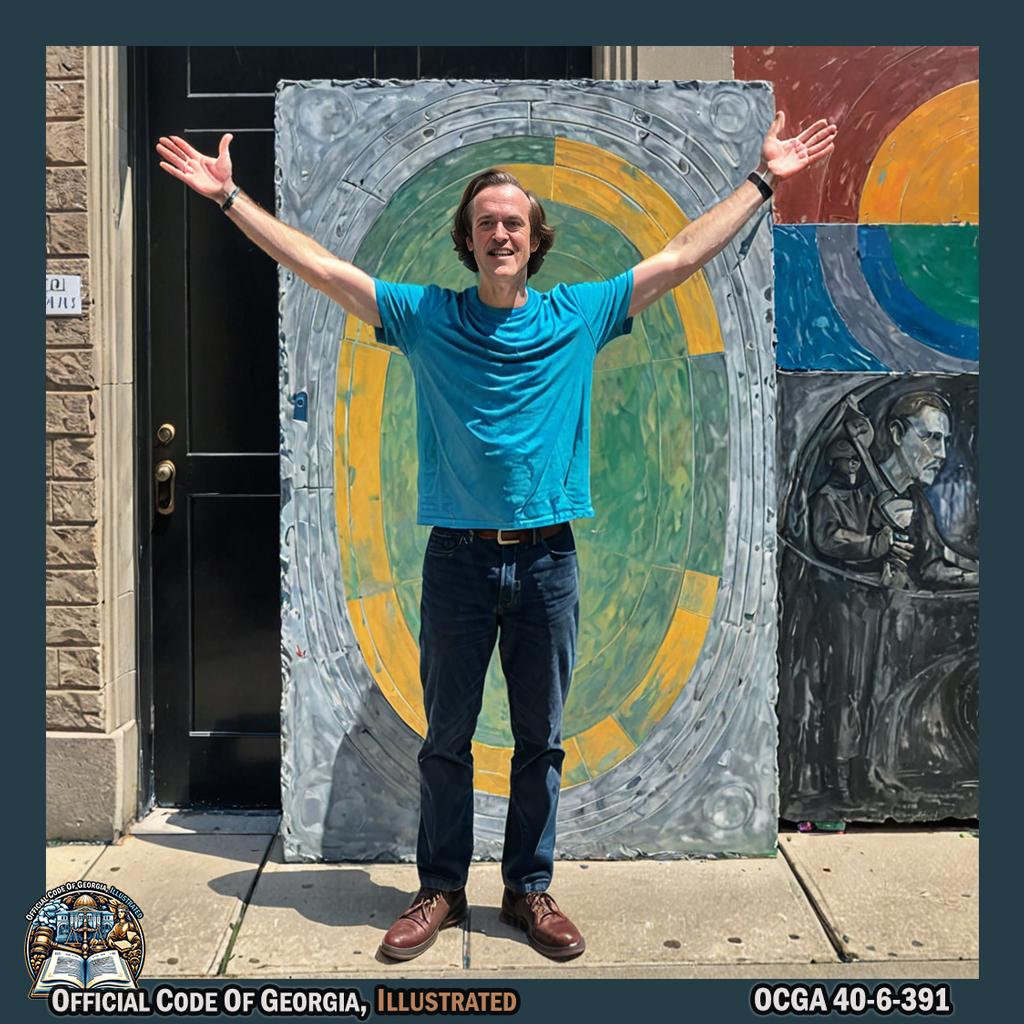
James C. Miller III, in the style of Barbara Hepworth, stands with arms outstretched and head tilted back as if holding up an invisible barrier to block a plea of nolo contendere for a young person charged with a violation of the Code section, all set against the backdrop of the rich Columbus Walking Tour scene.
-
A person who violates this Code section while transporting in a motor vehicle a child under the age of 14 years is guilty of the separate offense of endangering a child by driving under the influence of alcohol or drugs. The offense of endangering a child by driving under the influence of alcohol or drugs shall not be merged with the offense of driving under the influence of alcohol or drugs for the purposes of prosecution and sentencing. An offender who is convicted of a violation of this subsection shall be punished in accordance with the provisions of subsection (d) of Code Section 16-12-1.
40-6-391.1.Entry and acceptance of plea of nolo contendere.¶
- The decision to accept a plea of nolo contendere to a charge of violating Code Section 40-6-391 shall be at the sole discretion of the judge but, if such plea is accepted, the penalties provided for in subsection (c) of Code Section 40-6-391 shall be imposed; provided, however, that no such plea of nolo contendere shall be accepted if the person charged with violating Code Section 40-6-391 had an alcohol concentration of more than 0.15 at any time within three hours after driving or being in control of any moving vehicle from alcohol consumed before such driving or being in control ended.
-
If the defendant has not been convicted of or had a plea of nolo contendere accepted to a charge of violating Code Section 40-6-391 within the previous five years and if the plea of nolo contendere shall be used as provided in paragraph (1) of subsection (a) of Code Section 40-5-63, no such plea shall be accepted unless, at a minimum, the following conditions are met:

Shawn Mullins stands motionless, wearing a suit with his body contorted to represent the complexity and entanglement of legal language while surrounded by symbols and images representing the justice system rendered in Jasper Johns' style. -@mullinsshawn - The defendant has filed a verified petition with the court requesting that such plea be accepted and setting forth the facts and special circumstances necessary to enable the judge to determine that accepting such plea is in the best interest of justice; and
- The judge has reviewed the defendant’s driving records that are on file with the Department of Driver Services.

Jennifer Nettles gracefully dances with flowing, circular motions as she holds a stack of papers representing driving records. The movements are vibrant and colorful, reflecting Kandinsky's abstract art style, in the rich setting of Lincoln Artisans Gallery. -@JenniferNettles
-
The judge, as part of the record of the disposition of the charge, shall set forth, under seal of the court, his or her reasons for accepting the plea of nolo contendere.
- The record of the disposition of the case, including the ruling required in subsection (c) of this Code section, shall be forwarded to the Department of Driver Services within ten days after disposition.
- If a plea of nolo contendere is accepted under the conditions set forth in subsection (b) of this Code section, the defendant’s driver’s license shall be forwarded to the Department of Driver Services as provided in subsection (c) of Code Section 40-5-67.
40-6-391.2.Seizure and civil forfeiture of motor vehicle operated by habitual violator.¶
- Any motor vehicle operated by a person who has been declared a habitual violator for three violations of Code Section 40-6-391, whose license has been revoked, and who is arrested and charged with a violation of Code Section 40-6-391 is declared to be contraband and subject to forfeiture in accordance with the procedures set forth in Chapter 16 of Title 9.
- In any case where a vehicle which is the only family vehicle is determined to be subject to forfeiture, the court may, if it determines that the financial hardship to the family as a result of the forfeiture and sale outweighs the benefit to the state from such forfeiture, order the title to the vehicle transferred to such other family member who is a duly licensed operator and who requires the use of such vehicle for employment or family transportation purposes. Such transfer shall be subject to any valid liens and shall be granted only once.
40-6-391.3.Penalty for conviction for driving under influence of alcohol or drugs while driving school bus.¶
A school bus driver licensed pursuant to Article 7 of Chapter 5 of this title shall upon a conviction of a violation of Code Section 40-6-391 while driving a school bus be punished by imprisonment for a period of not less than one year nor more than five years or by a fine of not less than $1,000.00 nor more than $5,000.00, or both.
40-6-392.Chemical tests for alcohol or drugs.¶
-
Upon the trial of any civil or criminal action or proceeding arising out of acts alleged to have been committed by any person in violation of Code Section 40-6-391, evidence of the amount of alcohol or drug in a person’s blood, urine, breath, or other bodily substance at the alleged time, as determined by a chemical analysis of the person’s blood, urine, breath, or other bodily substance shall be admissible. Where such a chemical test is made, the following provisions shall apply:
-
- Chemical analysis of the person’s blood, urine, breath, or other bodily substance, to be considered valid under this Code section, shall have been performed according to methods approved by the Division of Forensic Sciences of the Georgia Bureau of Investigation on a machine which was operated with all its electronic and operating components prescribed by its manufacturer properly attached and in good working order and by an individual possessing a valid permit issued by the Division of Forensic Sciences for this purpose. The Division of Forensic Sciences of the Georgia Bureau of Investigation shall approve satisfactory techniques or methods to ascertain the qualifications and competence of individuals to conduct analyses and to issue permits, along with requirements for properly operating and maintaining any testing instruments, and to issue certificates certifying that instruments have met those requirements, which certificates and permits shall be subject to termination or revocation at the discretion of the Division of Forensic Sciences.
- In all cases where the arrest is made on or after January 1, 1995, and the state selects breath testing, two sequential breath samples shall be requested for the testing of alcohol concentration. For either or both of these sequential samples to be admissible in the state’s or plaintiff’s case-in-chief, the readings shall not differ from each other by an alcohol concentration of greater than 0.020 grams and the lower of the two results shall be determinative for accusation and indictment purposes and administrative license suspension purposes. No more than two sequential series of a total of two adequate breath samples each shall be requested by the state; provided, however, that after an initial test in which the instrument indicates an adequate breath sample was given for analysis, any subsequent refusal to give additional breath samples shall not be construed as a refusal for purposes of suspension of a driver’s license under Code Sections 40-5-55 and 40-5-67.1. Notwithstanding the above, a refusal to give an adequate sample or samples on any subsequent breath, blood, urine, or other bodily substance test shall not affect the admissibility of the results of any prior samples. An adequate breath sample shall mean a breath sample sufficient to cause the breath-testing instrument to produce a printed alcohol concentration analysis.
- When a person shall undergo a chemical test at the request of a law enforcement officer, only a physician, registered nurse, laboratory technician, emergency medical technician, or other qualified person may withdraw blood for the purpose of determining the alcoholic content therein, provided that this limitation shall not apply to the taking of breath or urine specimens. No physician, registered nurse, or other qualified person or employer thereof shall incur any civil or criminal liability as a result of the medically proper obtaining of such blood specimens when requested in writing by a law enforcement officer;
- The person tested may have a physician or a qualified technician, chemist, registered nurse, or other qualified person of his own choosing administer a chemical test or tests in addition to any administered at the direction of a law enforcement officer. The justifiable failure or inability to obtain an additional test shall not preclude the admission of evidence relating to the test or tests taken at the direction of a law enforcement officer; and
- Upon the request of the person who shall submit to a chemical test or tests at the request of a law enforcement officer, full information concerning the test or tests shall be made available to him or his attorney. The arresting officer at the time of arrest shall advise the person arrested of his rights to a chemical test or tests according to this Code section.
-
-
Except as provided in subsection (c) of this Code section, upon the trial of any civil or criminal action or proceeding arising out of acts alleged to have been committed by any person in violation of Code Section 40-6-391, the amount of alcohol in the person’s blood at the time alleged, as shown by chemical analysis of the person’s blood, urine, breath, or other bodily substance, may give rise to inferences as follows:
-
If there was at that time an alcohol concentration of 0.05 grams or less, the trier of fact in its discretion may infer therefrom that the person was not under the influence of alcohol, as prohibited by paragraphs (1) and (4) of subsection (a) of Code Section 40-6-391; or

Sam Edwards stands still with his arms outstretched, as if balancing an invisible scale, then slowly lowers them to the ground in a graceful and deliberate manner. -
If there was at that time an alcohol concentration in excess of 0.05 grams but less than 0.08 grams, such fact shall not give rise to any inference that the person was or was not under the influence of alcohol, as prohibited by paragraphs (1) and (4) of subsection (a) of Code Section 40-6-391, but such fact may be considered by the trier of fact with other competent evidence in determining whether the person was under the influence of alcohol, as prohibited by paragraphs (1) and (4) of subsection (a) of Code Section 40-6-391.
-
-
- In any civil or criminal action or proceeding arising out of acts alleged to have been committed in violation of paragraph (5) of subsection (a) of Code Section 40-6-391, if there was at that time or within three hours after driving or being in actual physical control of a moving vehicle from alcohol consumed before such driving or being in actual physical control ended an alcohol concentration of 0.08 or more grams in the person’s blood, breath, or urine, the person shall be in violation of paragraph (5) of subsection (a) of Code Section 40-6-391.
- In any civil or criminal action or proceeding arising out of acts alleged to have been committed by any person in violation of subsection (i) of Code Section 40-6-391, if there was at that time or within three hours after driving or being in actual physical control of a moving vehicle from alcohol consumed before such driving or being in actual physical control ended an alcohol concentration of 0.04 grams or more in the person’s blood, breath, or urine, the person shall be in violation of subsection (i) of Code Section 40-6-391.
- In any civil or criminal action or proceeding arising out of acts alleged to have been committed by any person in violation of subsection (k) of Code Section 40-6-391, if there was at that time or within three hours after driving or being in actual physical control of a moving vehicle from alcohol consumed before such driving or being in actual physical control ended an alcohol concentration of 0.02 grams or more in the person’s blood, breath, or urine, the person shall be in violation of subsection (k) of Code Section 40-6-391.
-
In any criminal trial, the refusal of the defendant to permit a chemical analysis to be made of his blood, breath, urine, or other bodily substance at the time of his arrest shall be admissible in evidence against him.

Madeleine Peyroux, dressed in a sleek black outfit with dramatic lighting, dramatically refuses to permit a chemical analysis of her bodily substances while performing a sultry jazz rendition of the sentence, embodying the style of Helmut Newton in Carrollton. -@mpeyrouxmusic -
- A certification by the office of the Secretary of State or by the Department of Public Health that a person who drew blood was a licensed or certified physician, physician assistant, registered nurse, practical nurse, medical technologist, medical laboratory technician, or phlebotomist at the time the blood was drawn;
- Testimony, under oath, of the blood drawer; or
-
Testimony, under oath, of the blood drawer’s supervisor or medical records custodian that the blood drawer was properly trained and authorized to draw blood as an employee of the medical facility or employer
shall be admissible into evidence for the purpose of establishing that such person was qualified to draw blood as required by this Code section.
-
Each time an approved breath-testing instrument is inspected, the inspector shall prepare a certificate which shall be signed under oath by the inspector and which shall include the following language:
Click to view
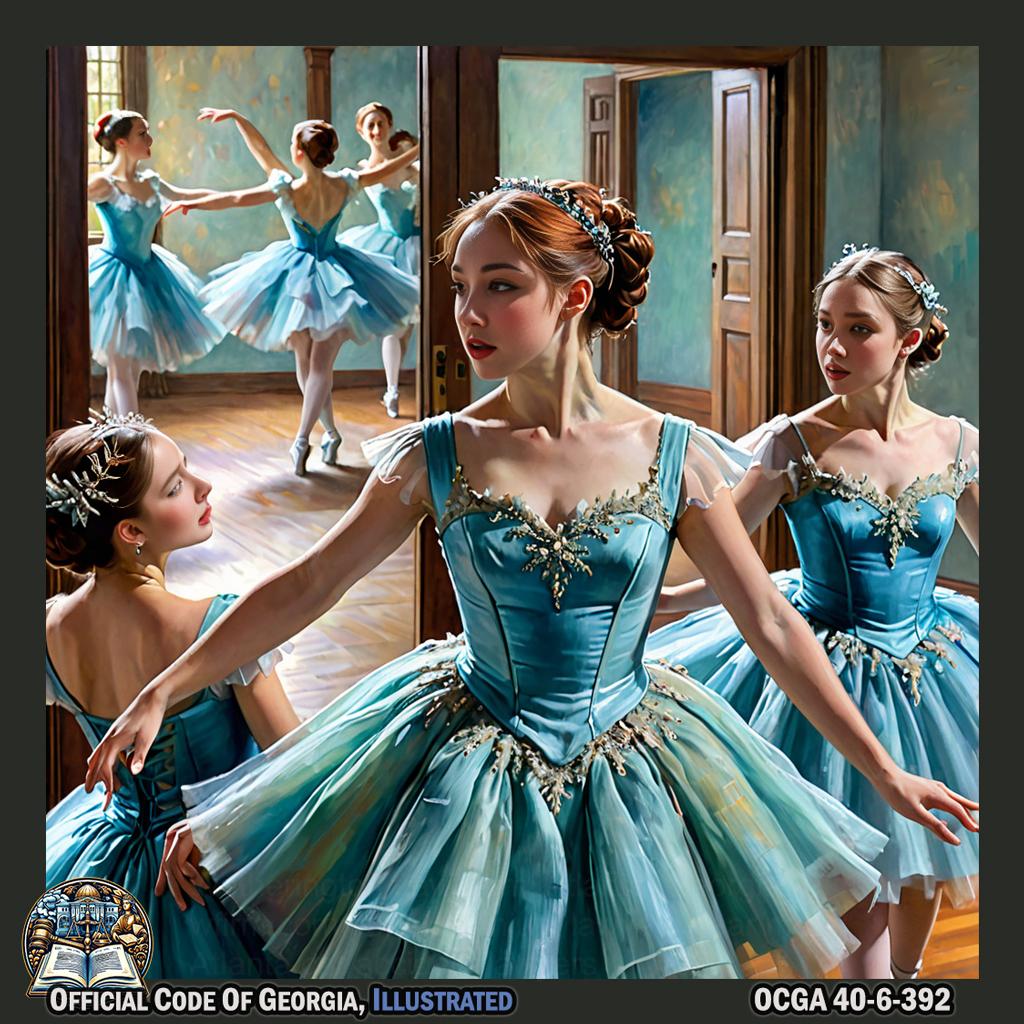
Widespread Panic gracefully poses as a group of dancers, frozen in an elegant tableau while clicking to view, capturing the essence of an Edgar Degas art piece in a rich McDonough setting for a Georgia educational partnership. -@WidespreadPanic
“This breath-testing instrument (serial no. ) was thoroughly inspected, tested, and standardized by the undersigned on (date ) and all of its electronic and operating components prescribed by its manufacturer are properly attached and are in good working order.” When properly prepared and executed, as prescribed in this subsection, the certificate shall, notwithstanding any other provision of law, be self-authenticating, shall be admissible in any court of law, and shall satisfy the pertinent requirements of paragraph (1) of subsection (a) of this Code section and subparagraph (g)(2)(F) of . Code Section 40-5-67.1
40-6-393.Homicide by vehicle.¶
- Any person who, without malice aforethought, causes the death of another person through the violation of subsection (a) of Code Section 40-6-163, Code Sections 40-6-390 through 40-6-391, or subsection (a) of Code Section 40-6-395 commits the offense of homicide by vehicle in the first degree and, upon conviction thereof, shall be punished by imprisonment for not less than three years nor more than 15 years.
- Any driver of a motor vehicle who, without malice aforethought, causes an accident which causes the death of another person and leaves the scene of the accident in violation of subsection (b) of Code Section 40-6-270 commits the offense of homicide by vehicle in the first degree and, upon conviction thereof, shall be punished by imprisonment for not less than three years nor more than 15 years.
- Any person who causes the death of another person, without an intention to do so, by violating any provision of this title other than subsection (a) of Code Section 40-6-163, subsection (b) of Code Section 40-6-270, Code Sections 40-6-390 through 40-6-391, or subsection (a) of Code Section 40-6-395 commits the offense of homicide by vehicle in the second degree when such violation is the cause of said death and, upon conviction thereof, shall be punished as provided in Code Section 17-10-3.
- Any person who, after being declared a habitual violator as determined under Code Section 40-5-58 and while such person’s license is in revocation, causes the death of another person, without malice aforethought, by operation of a motor vehicle, commits the offense of homicide by vehicle in the first degree and, upon conviction thereof, shall be punished by imprisonment for not less than five years nor more than 20 years, and adjudication of guilt or imposition of such sentence for a person so convicted may be suspended, probated, deferred, or withheld but only after such person shall have served at least one year in the penitentiary.
40-6-393.1.Feticide by vehicle.¶
- For the purposes of this Code section, the term “unborn child” means a member of the species homo sapiens at any stage of development who is carried in the womb.
-
- A person commits the offense of feticide by vehicle in the first degree if he or she causes the death of an unborn child by any injury to the mother of such child which would be homicide by vehicle in the first degree as provided in subsection (a), (b), or (d) of Code Section 40-6-393 if it resulted in the death of such mother.
- A person convicted of the offense of feticide by vehicle in the first degree shall be punished by imprisonment for not less than three years nor more than 15 years.
-
- A person commits the offense of feticide by vehicle in the second degree if he or she causes the death of an unborn child by any injury to the mother of such child by violating any provision of this title other than Code Sections 40-6-390 through 40-6-391, which would be homicide by vehicle in the second degree as provided in subsection (c) of Code Section 40-6-393 if it resulted in the death of such mother.
- A person convicted of the offense of feticide by vehicle in the second degree shall be punished as provided in Code Section 17-10-3.
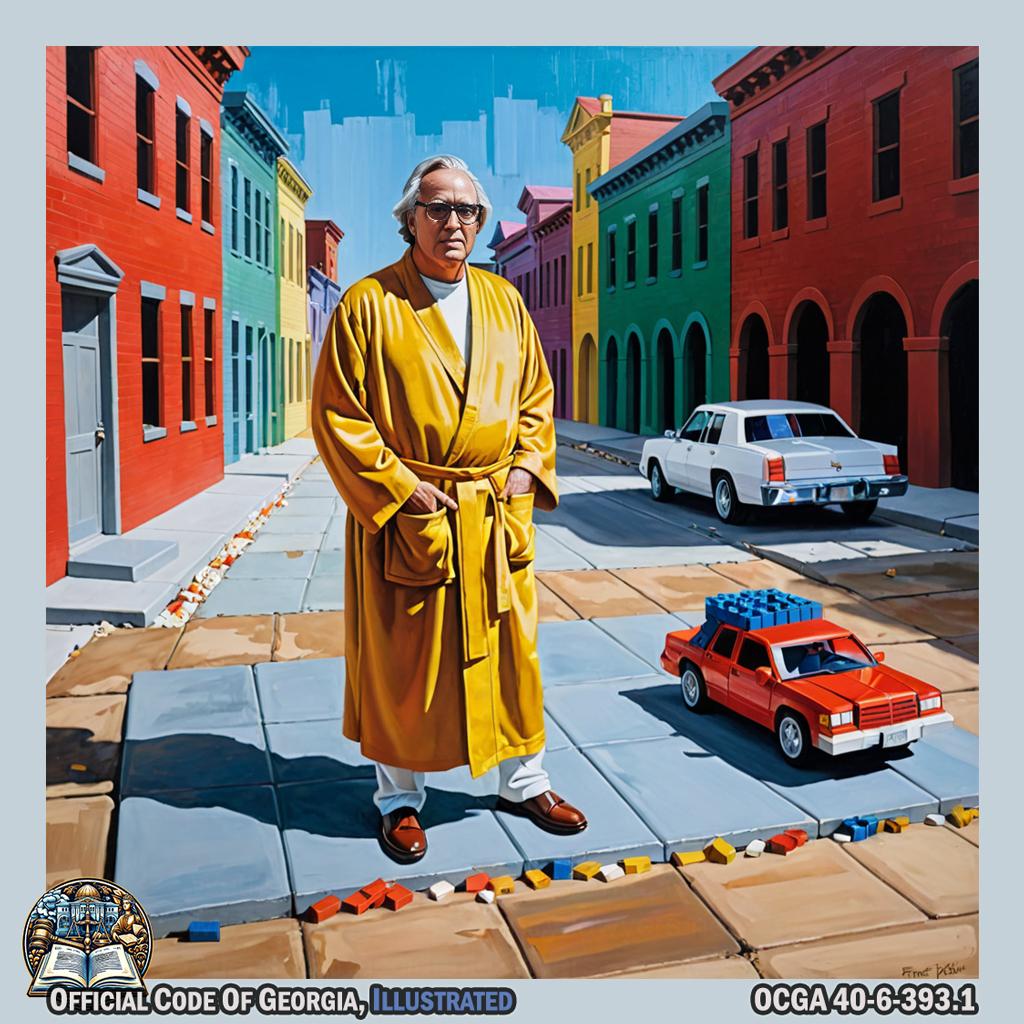
Chuggaaconroy, dressed in a robe of justice, dramatically places a toy car into a symbolic 'jail' constructed from colorful building blocks to represent the punishment for feticide by vehicle, while Eric Fischl paints this scene set against the backdrop of Acworth's picturesque landscapes and historic buildings. -@chuggaaconroy
40-6-394.Serious injury by vehicle.¶
- As used in this Code section, the term “bodily harm” means an injury to another person which deprives him or her of a member of his or her body, renders a member of his or her body useless, seriously disfigures his or her body or a member thereof, or causes organic brain damage which renders his or her body or any member thereof useless.
- Any person who, without malice aforethought, causes an accident that results in bodily harm while violating Code Sections 40-6-390 through 40-6-391 commits the crime of serious injury by vehicle. A person convicted of violating this subsection shall be guilty of a felony and shall be punished by imprisonment for not less than one year nor more than 15 years.
- Any person who, without malice aforethought, proximately causes an accident that the person knew resulted in bodily harm and leaves the scene of the accident in violation of subsection (b) of Code Section 40-6-270 commits the crime of serious injury by vehicle; provided, however, that there shall be no violation of this subsection if the parties involved in the accident exchange motor vehicle insurance information prior to leaving the scene of the accident. A person convicted of violating this subsection shall be guilty of a felony and shall be punished by imprisonment for not less than one year nor more than ten years.
40-6-395.Fleeing or attempting to elude police officer; impersonating law enforcement officer.¶
- It shall be unlawful for any driver of a vehicle willfully to fail or refuse to bring his or her vehicle to a stop or otherwise to flee or attempt to elude a pursuing police vehicle or police officer when given a visual or an audible signal to bring the vehicle to a stop. The signal given by the police officer may be by hand, voice, emergency light, or siren. The officer giving such signal shall be in uniform prominently displaying his or her badge of office, and his or her vehicle shall be appropriately marked showing it to be an official police vehicle.
-
-
Any person convicted of violating the provisions of subsection (a) of this Code section upon a first, second, or third conviction thereof shall be guilty of a high and aggravated misdemeanor and upon a fourth or subsequent conviction thereof shall be guilty of a felony and shall be punished as follows: 1. Upon the first conviction shall be fined not less than $1,000.00 nor more than $5,000.00, and the fine shall not be subject to suspension, stay, or probation, and imprisoned for not less than 30 days nor more than 12 months. Any period of such imprisonment in excess of 30 days may, in the sole discretion of the judge, be suspended, stayed, or probated;
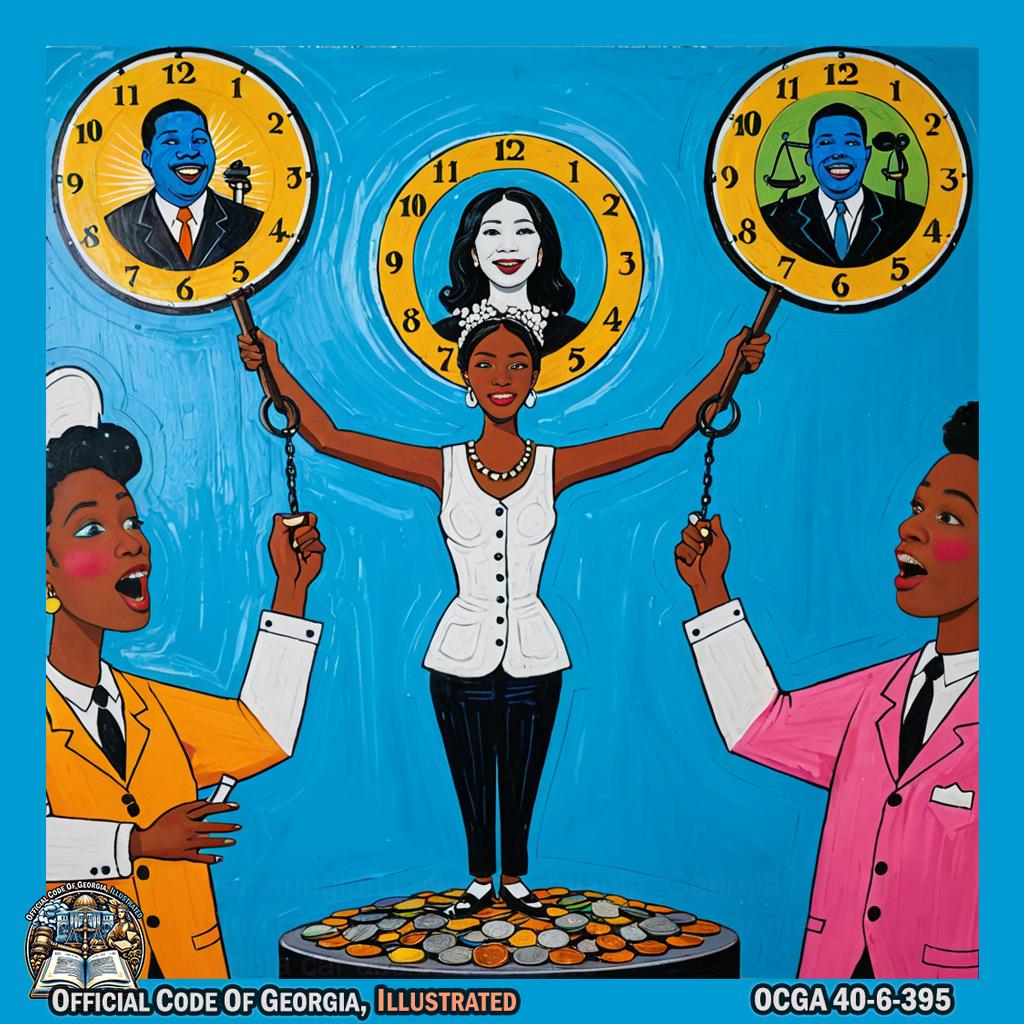
The Freedom Singers, in a vibrant scene reminiscent of a Howard Finster folk art piece, enact the scales of justice in Cusseta; one member holds an oversized, colorful cardboard scale balancing coins on one side and miniature clocks on the other, symbolizing fines and time. Another singer mimes locking a giant whimsical padlock then unlocking it halfway to represent imprisonment with potential suspension while others observe solemnly or joyfully sing about redemption and consequence. - Upon the second conviction within a ten-year period of time, as measured from the dates of previous arrests for which convictions were obtained to the date of the current arrest for which a conviction is obtained, shall be fined not less than $2,500.00 nor more than $5,000.00, and the fine shall not be subject to suspension, stay, or probation, and imprisoned for not less than 90 days nor more than 12 months. Any period of such imprisonment in excess of 90 days may, in the sole discretion of the judge, be suspended, stayed, or probated; and for purposes of this paragraph, previous pleas of nolo contendere accepted within such ten-year period shall constitute convictions;
- Upon the third conviction within a ten-year period of time, as measured from the dates of previous arrests for which convictions were obtained to the date of the current arrest for which a conviction is obtained, shall be fined not less than $4,000.00 nor more than $5,000.00, and the fine shall not be subject to suspension, stay, or probation, and imprisoned for not less than 180 days nor more than 12 months. Any period of such imprisonment in excess of 180 days may, in the sole discretion of the judge, be suspended, stayed, or probated; and for purposes of this paragraph, previous pleas of nolo contendere accepted within such ten-year period shall constitute convictions; and
- Upon the fourth or subsequent conviction within a ten-year period of time, as measured from the dates of previous arrests for which convictions were obtained to the date of the current arrest for which a conviction is obtained, shall be fined not less than $5,000.00 nor more than $10,000.00 and imprisoned for not less than 12 months nor more than ten years.

Baseball player Bill Terry solemnly counting on his fingers while standing in a dramatic spotlight, as if measuring the passage of time and severity of consequences, within a grand art piece at Apex Museum.
-
For the purpose of imposing a sentence under this subsection, a plea of nolo contendere shall constitute a conviction.

Marianne Gordon stands solemnly atop Nacoochee Mound, hands clasped as if holding an invisible gavel, then gently places one hand over her heart and looks towards the horizon with a reflective gaze, symbolizing acceptance of judgment akin to a plea of nolo contendere; all captured in the rich, contrasting tones and poignant composition reminiscent of Gordon Parks' photography. -
If the payment of the fine required under subparagraphs (A) through (C) of paragraph (1) of this subsection will impose an economic hardship on the defendant, the judge, at his or her sole discretion, may order the defendant to pay such fine in installments and such order may be enforced through a contempt proceeding or a revocation of any probation otherwise authorized by this subsection.
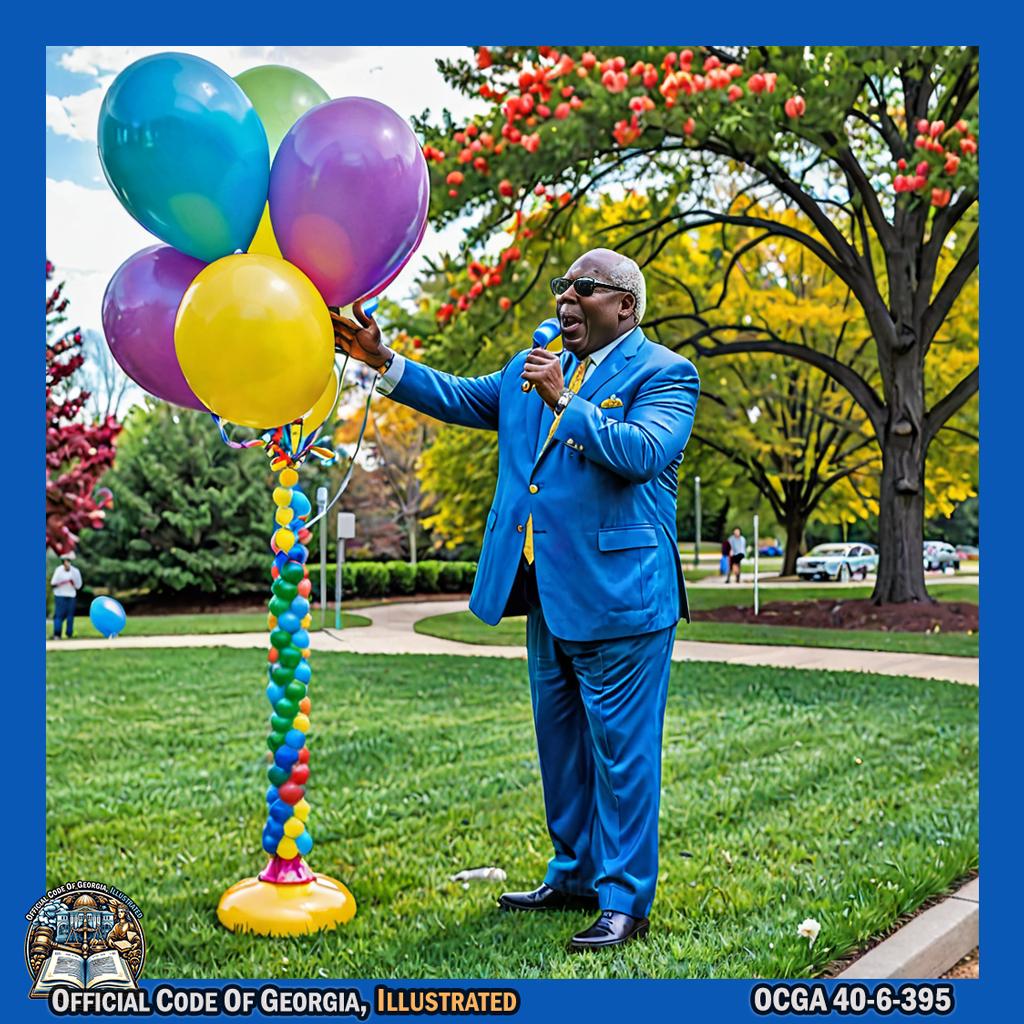
Sonny Terry, harmonica in hand, is depicted as a judge, striking a gavel on a colorful balloon sculpture podium designed by Jeff Koons. The scene takes place in an idyllic park of Powder Springs with oversized balloon animals and flowers around him. He gestures to an individual before him, miming the act of handing over money in installments while the other nods and pretends to write on an invisible notepad. -
Notwithstanding the limits set forth in any municipal charter, any municipal court of any municipality shall be authorized to impose the punishments provided for in subparagraphs (A) through (C) of paragraph (1) of this subsection upon a conviction of violating such subparagraphs or upon conviction of violating any ordinance adopting the provisions of such subparagraphs.

Gladys Knight gracefully raises her hand to impose punishment upon a convicted individual, while surrounded by the beautiful and serene landscapes of Providence Canyon State Outdoor Recreation Area, capturing the essence of Vermeer's artistry. -@MsGladysKnight
-
-
Any person violating the provisions of subsection (a) of this Code section who, while fleeing or attempting to elude a pursuing police vehicle or police officer:
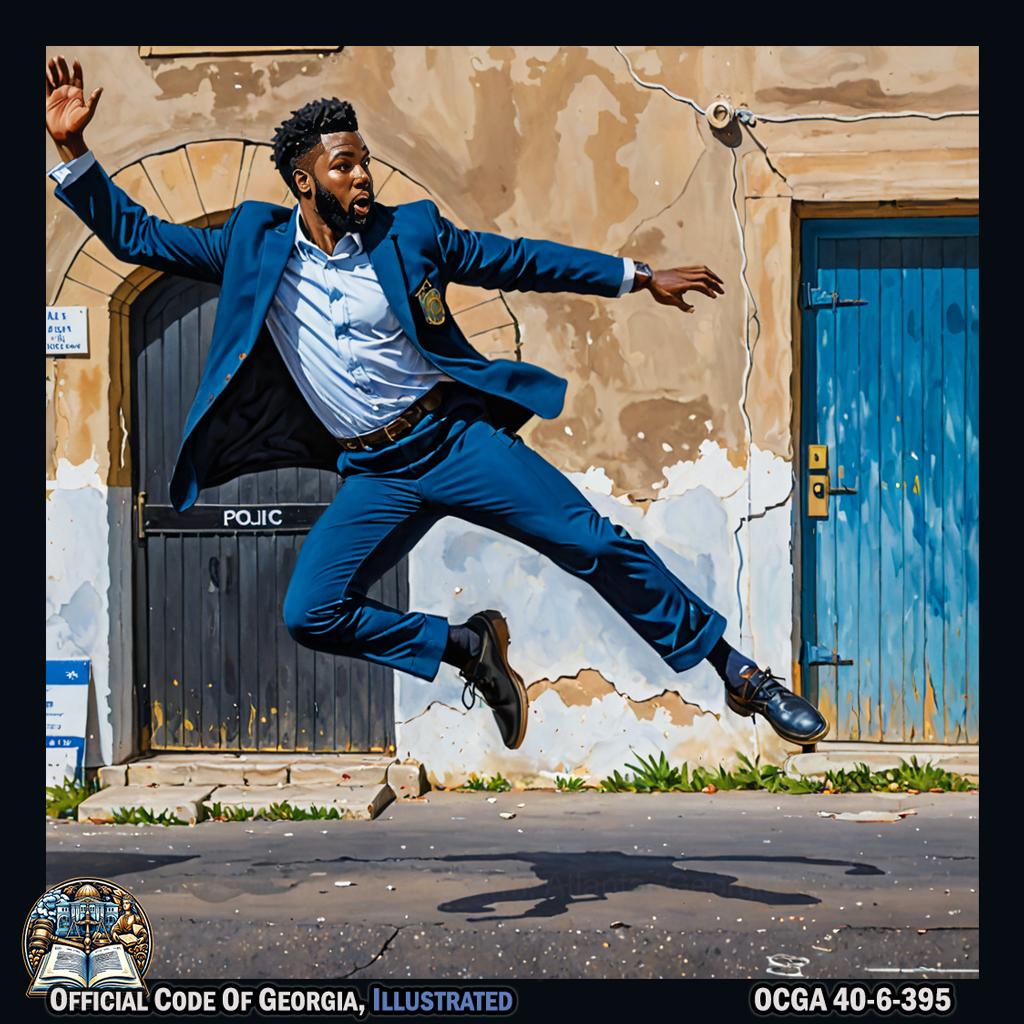
Khalid gracefully leaping and twirling away from a pursuing police officer in the style of Robert Lawrance Lobe's art, set against the rich backdrop of Winder. -@thegreatkhalid - Operates his or her vehicle in excess of 20 miles an hour above the posted speed limit;
- Strikes or collides with another vehicle or a pedestrian;
- Is the proximate cause of an accident;
- Flees in traffic conditions which place the general public at risk of receiving serious injuries;
-
Commits a violation of:
-
Code Section 40-6-144;

Shareef Abdur-Rahim elegantly dribbling a basketball, capturing the movement and grace in the style of Paul Cézanne's art piece, set against the backdrop of a vibrant Varsity scene. -@ShareefAbdur_R -
Subsection (a) of Code Section 40-6-163;
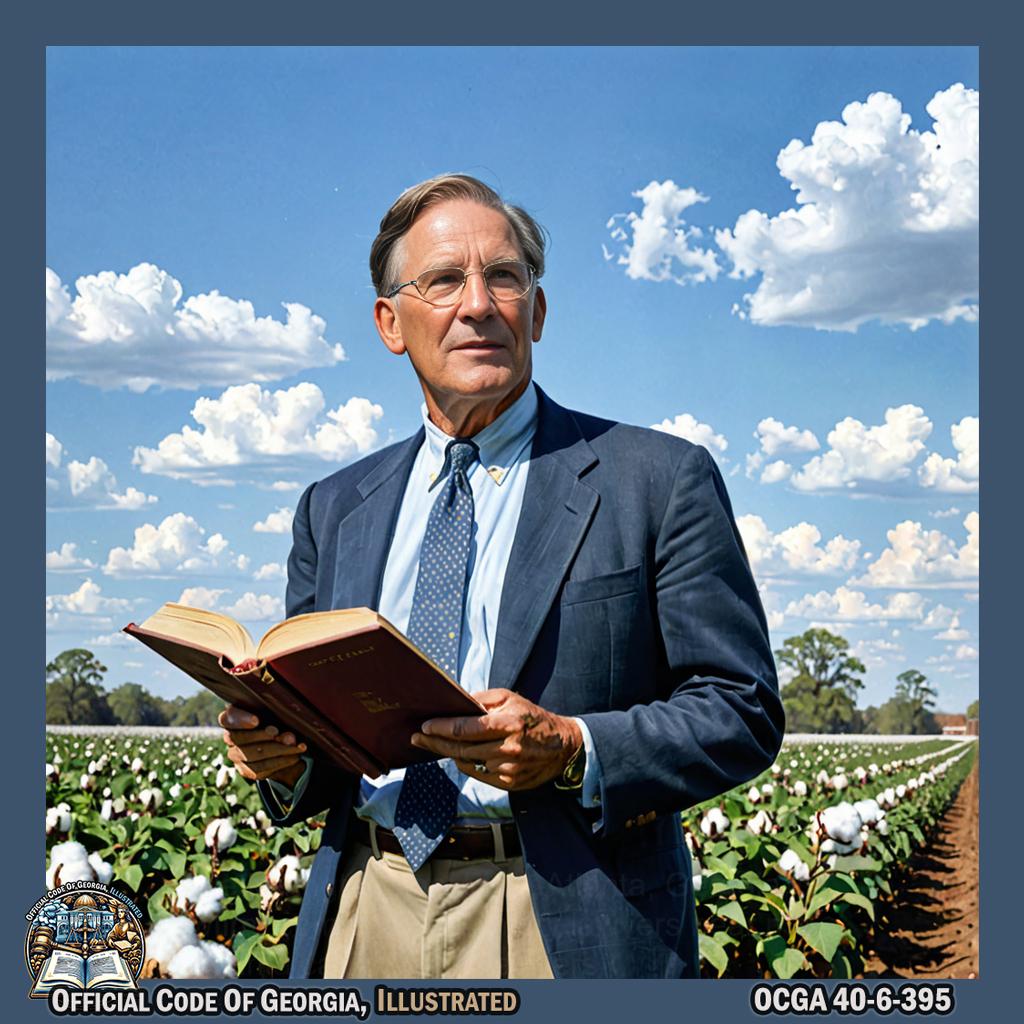
Georgia Tech President Blake R. Van Leer stands in a field, surrounded by cotton plants, holding a book and pointing to the sky with one hand while his other hand is on his hip, as if delivering an important proclamation to the world. -
Subsection (a) of Code Section 40-6-251;
- Subsection (a) of Code Section 40-6-390;
- Subsection (a) of Code Section 40-6-390.1; or
- Subsection (a) of Code Section 40-6-391; or
- Leaves the state
shall be guilty of a felony punishable by a fine of not less than $5,000.00 nor more than $10,000.00 and imprisonment for not less than 12 months nor more than ten years.

Mary Crovatt Hambidge weaves a vibrant tapestry depicting a courtroom with Diego Rivera's signature style, while gesturing dramatically to represent the sentencing of imprisonment and fine for a felony in Winder, Georgia. -
-
Following adjudication of guilt or imposition of sentence for a violation of subparagraph (b)(1)(D) or subsection (c) of this Code section, the sentence shall not be suspended, probated, deferred, or withheld, and the charge shall not be reduced to a lesser offense, merged with any other offense, or served concurrently with any other offense.
- It shall be unlawful for a person:
- To impersonate a sheriff, deputy sheriff, state trooper, agent of the Georgia Bureau of Investigation, agent of the Federal Bureau of Investigation, police officer, or any other authorized law enforcement officer by using a motor vehicle, motorcycle, or blue light designed, equipped, or marked so as to resemble a motor vehicle, motorcycle, or blue light belonging to any federal, state, or local law enforcement agency; or
- Otherwise to impersonate any such law enforcement officer in order to direct, stop, or otherwise control traffic.
40-6-396.Homicide by interference with official traffic-control device or railroad sign or signal; serious injury by interference with official traffic-control device or railroad sign or signal.¶
- Any person who, without malice aforethought, causes the death of another person through the violation of subsection (a) of Code Section 40-6-26 commits the offense of homicide by interference with an official traffic-control device or railroad sign or signal and, upon conviction thereof, shall be punished by imprisonment for not less than two nor more than 15 years.
- Any person who, without malice aforethought, causes bodily harm to another by depriving such other person of a member of his or her body, by rendering a member of his or her body useless, by seriously disfiguring his or her body or a member thereof, or by causing organic brain damage which renders the body or any member thereof useless through the violation of subsection (a) of Code Section 40-6-26 commits the offense of serious injury by interference with an official traffic-control device or railroad sign or signal and, upon conviction thereof, shall be punished by imprisonment for not less than one nor more than five years.
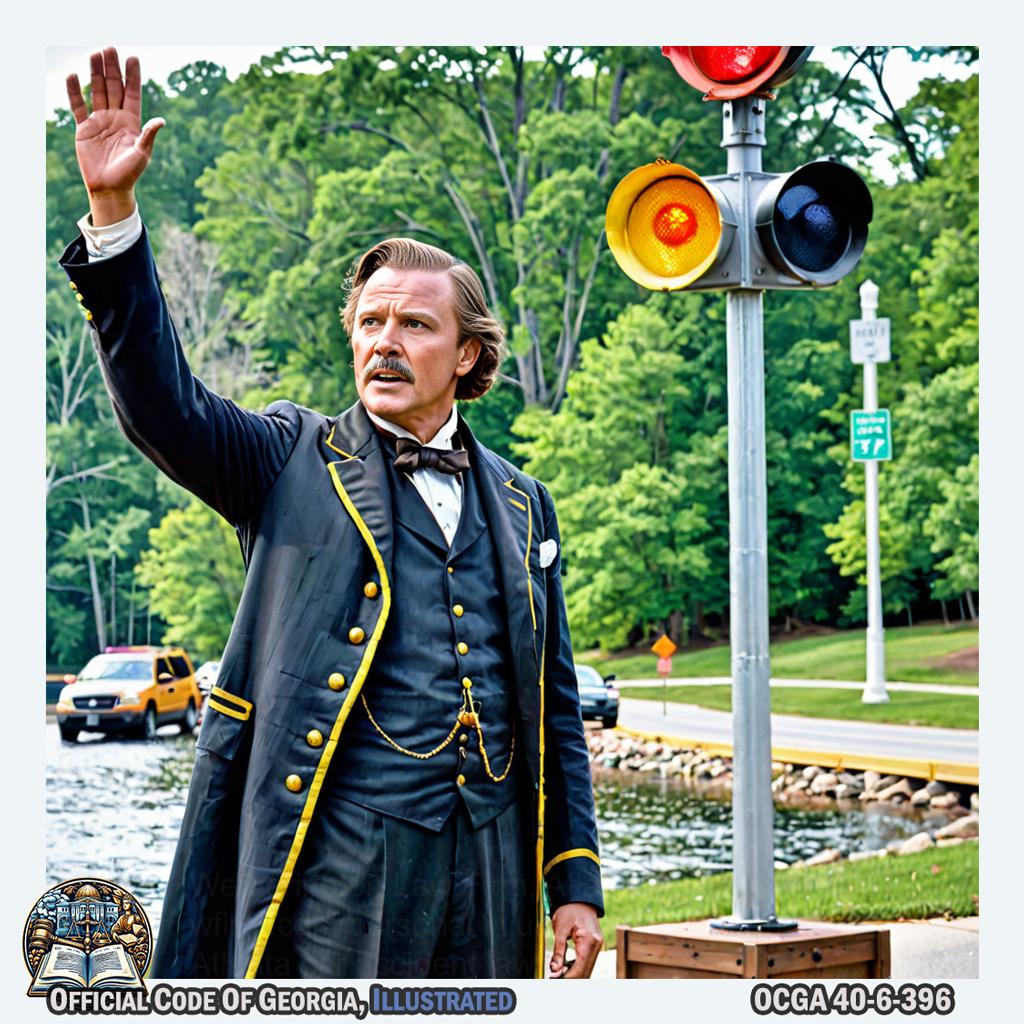
Asa Griggs Candler, portrayed by an actor in period attire, stands before Lake Winnepesaukah, dramatically gesturing to a life-sized traffic signal sculpture made of colorful materials. He appears to be orchestrating it like a conductor with a symphony, symbolizing leadership and guidance without malice. In the background, Simmie Knox-style figures engage in recreational activities safely away from the roads, emphasizing community harmony and safety awareness.
40-6-397.Aggressive driving.¶
-
A person commits the offense of aggressive driving when he or she operates any motor vehicle with the intent to annoy, harass, molest, intimidate, injure, or obstruct another person, including without limitation violating Code Section 40-6-42, 40-6-48, 40-6-49, 40-6-123, 40-6-184, 40-6-312, 40-6-390, or 40-6-390.1 with such intent.

Datamatics, depicted in an art piece by Elva Nampeyo, aggressively revs a toy car engine and makes aggressive hand gestures towards another person. -@DatamaticsGlobal -
Any person convicted of aggressive driving shall be guilty of a misdemeanor of a high and aggravated nature.
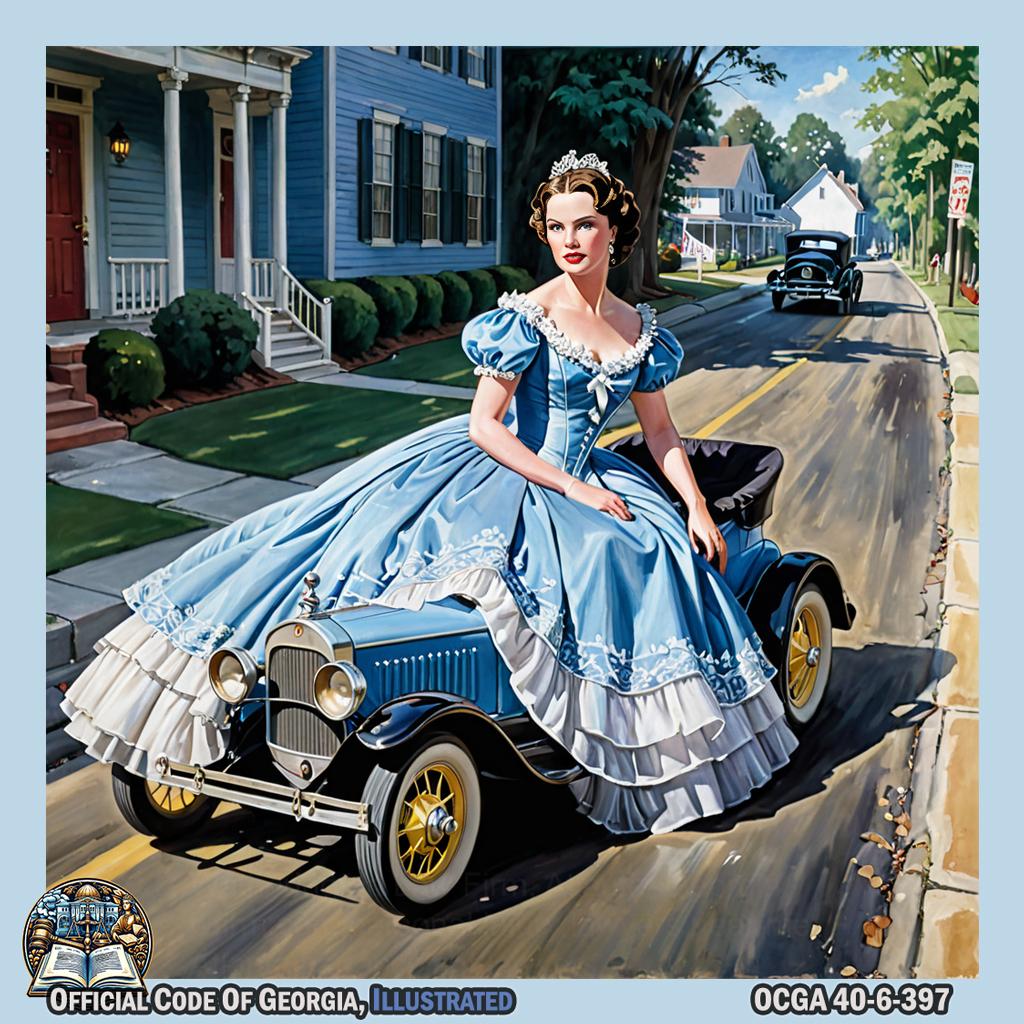
Margaret Mitchell, in a flowing southern belle gown, theatrically slams down a toy car on a mock-up Cascade Heights street, while Raymond Francis Robbins sketches her with dramatic shadows and exaggerated expressions of disapproval.